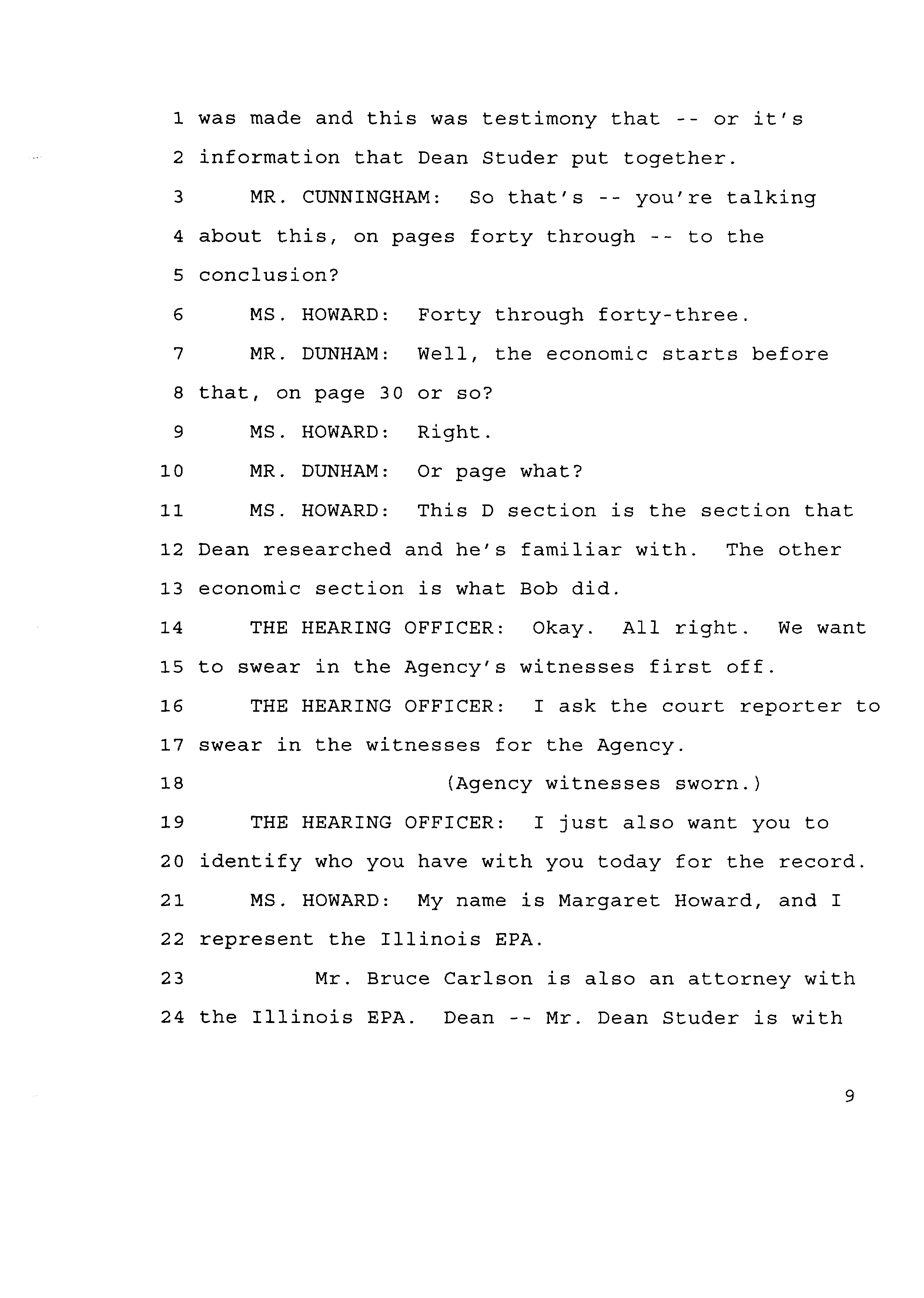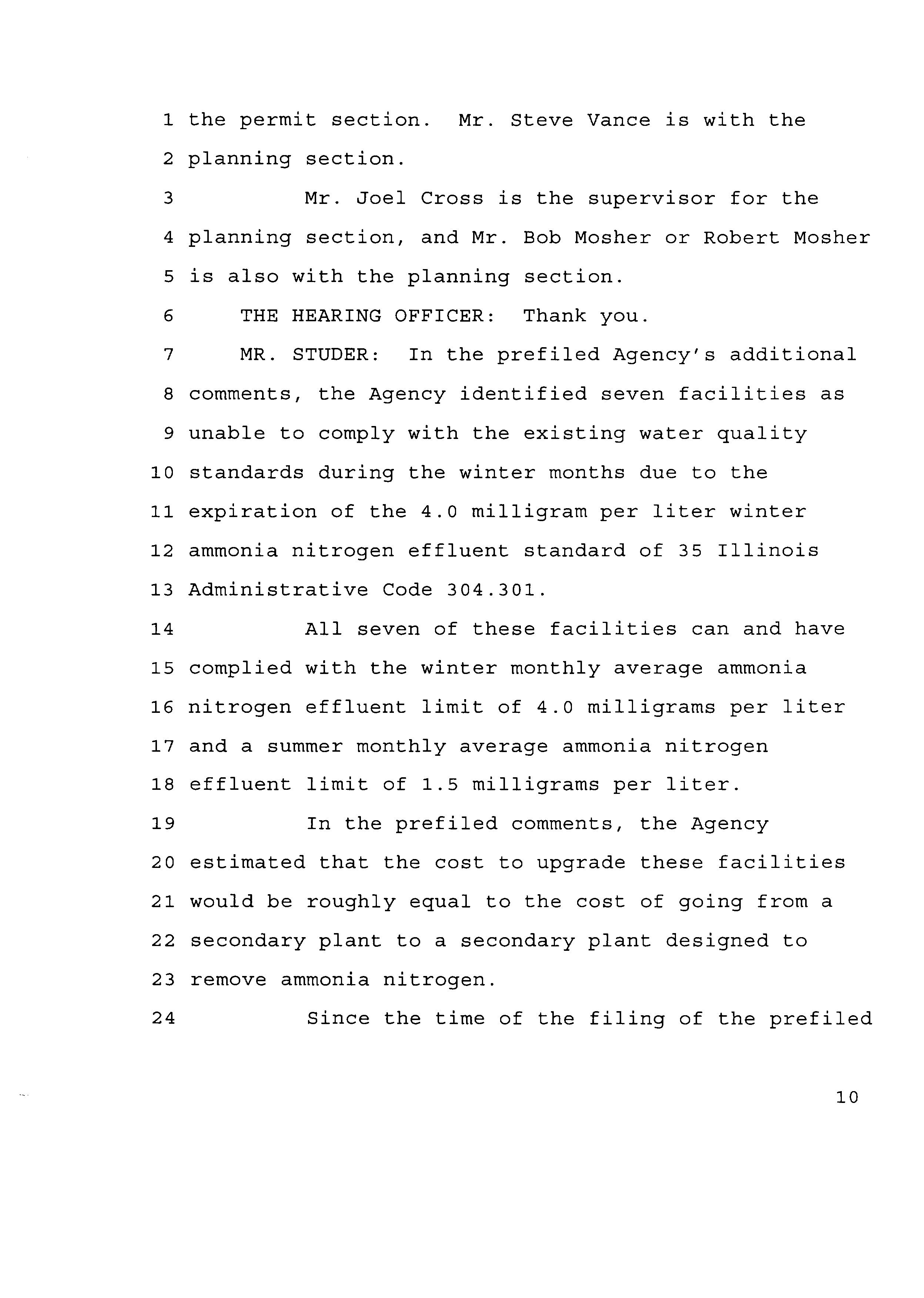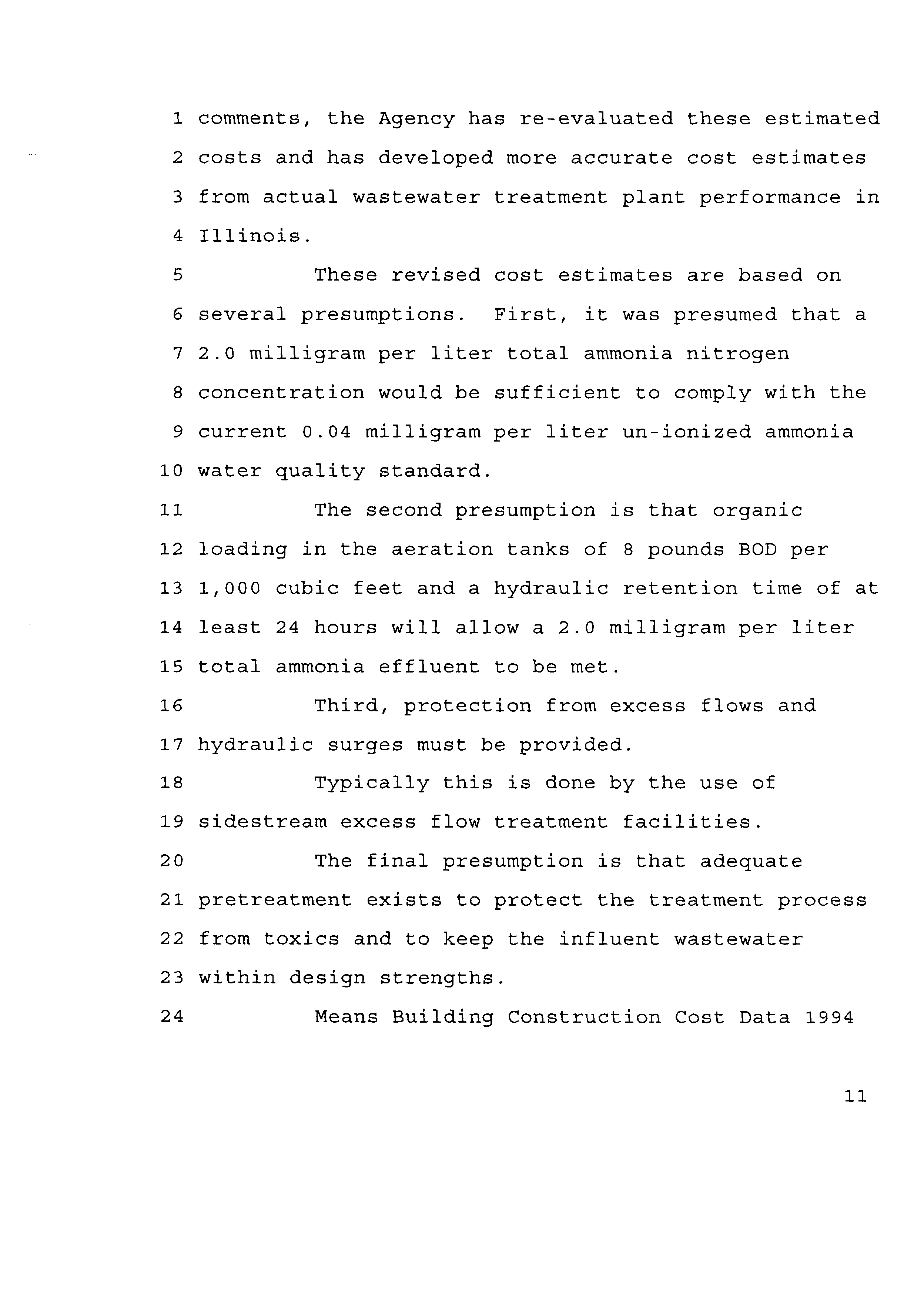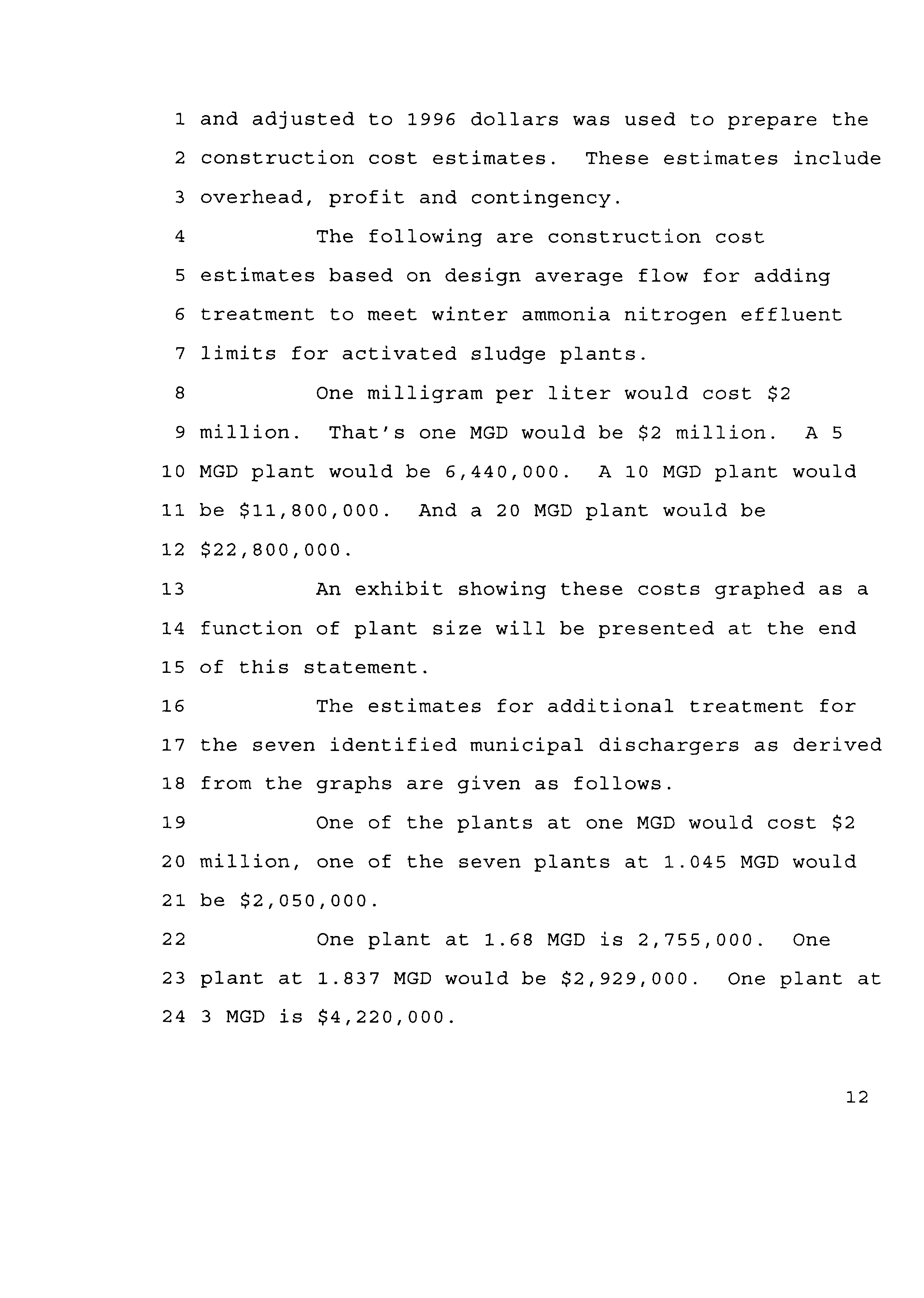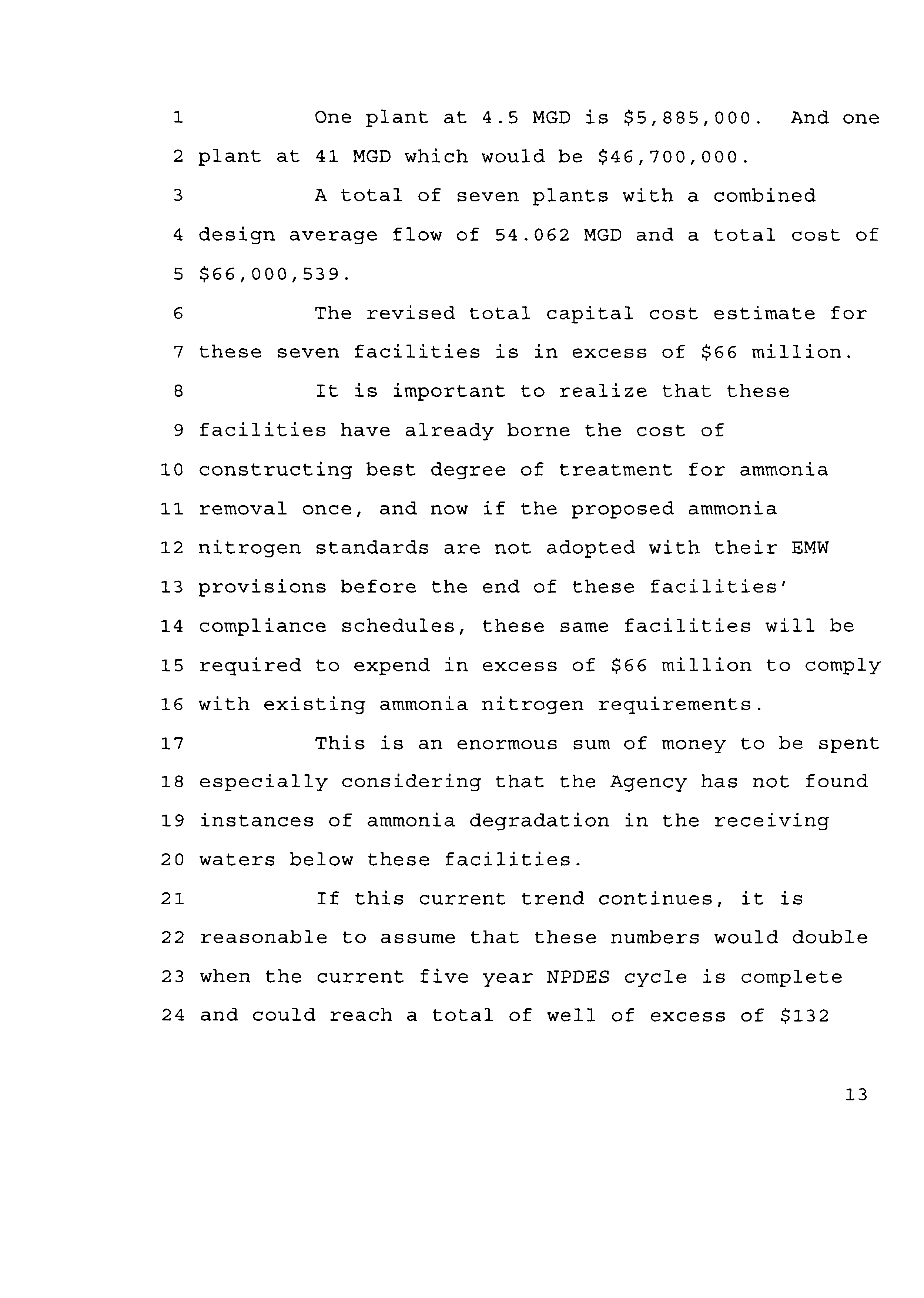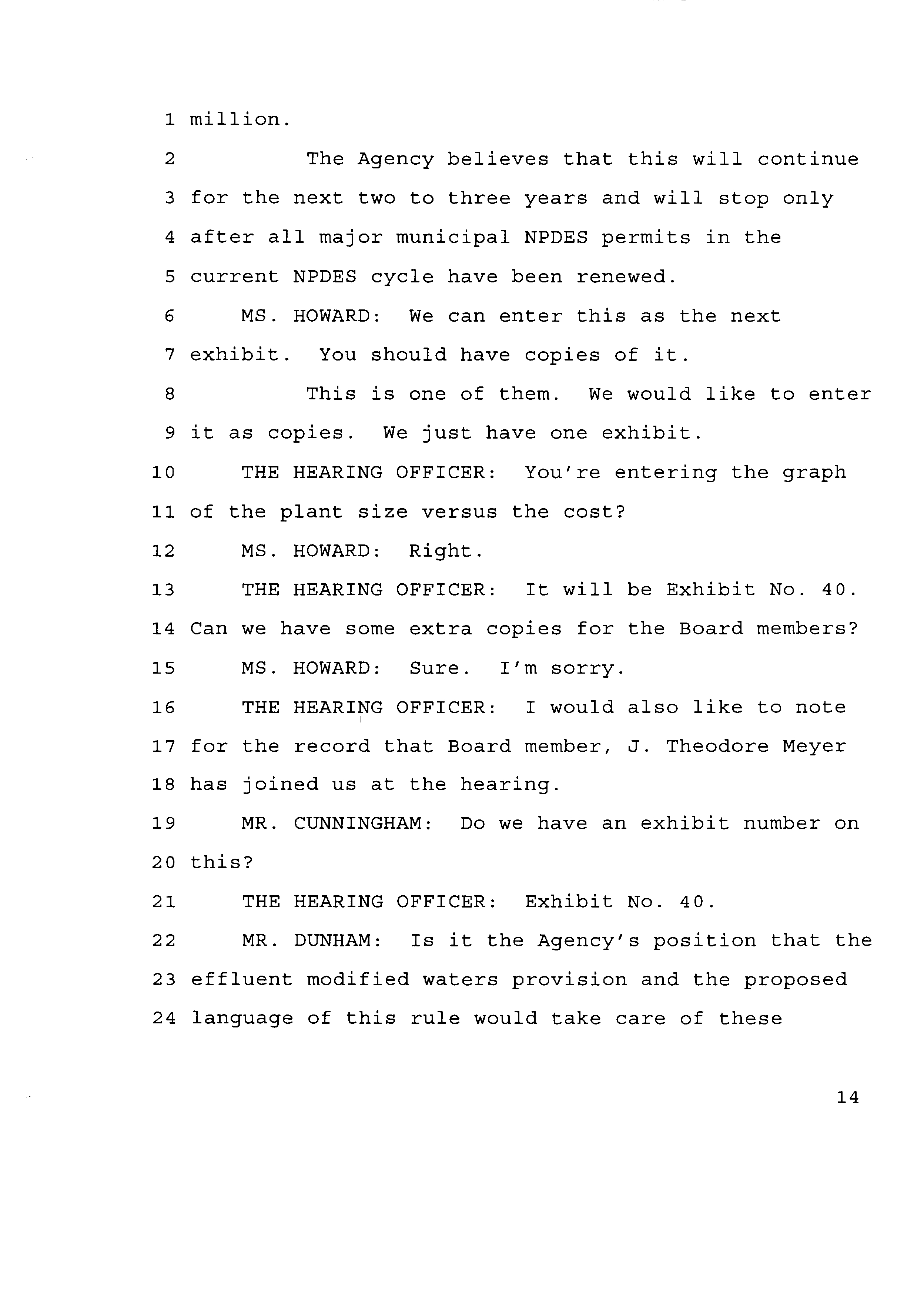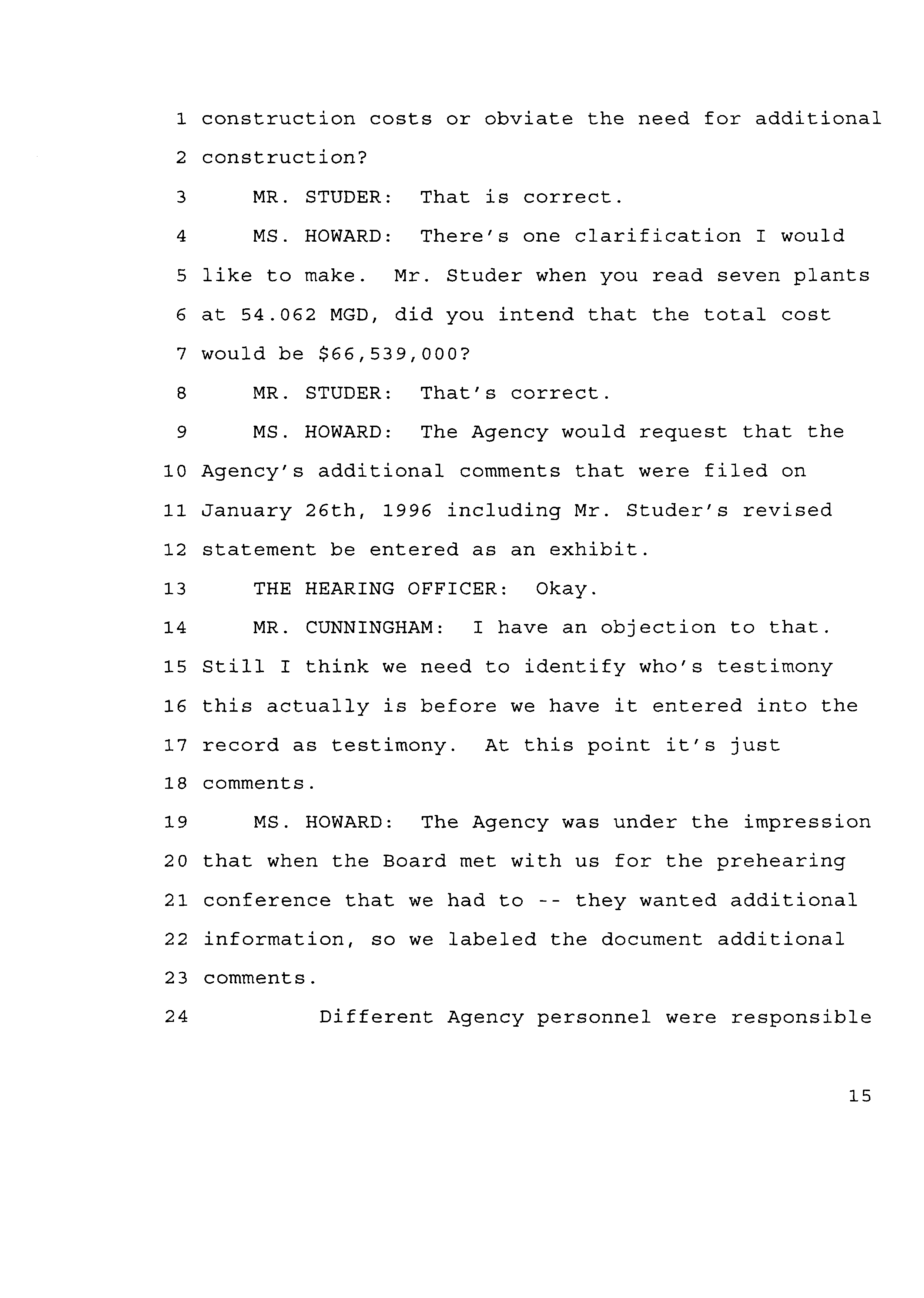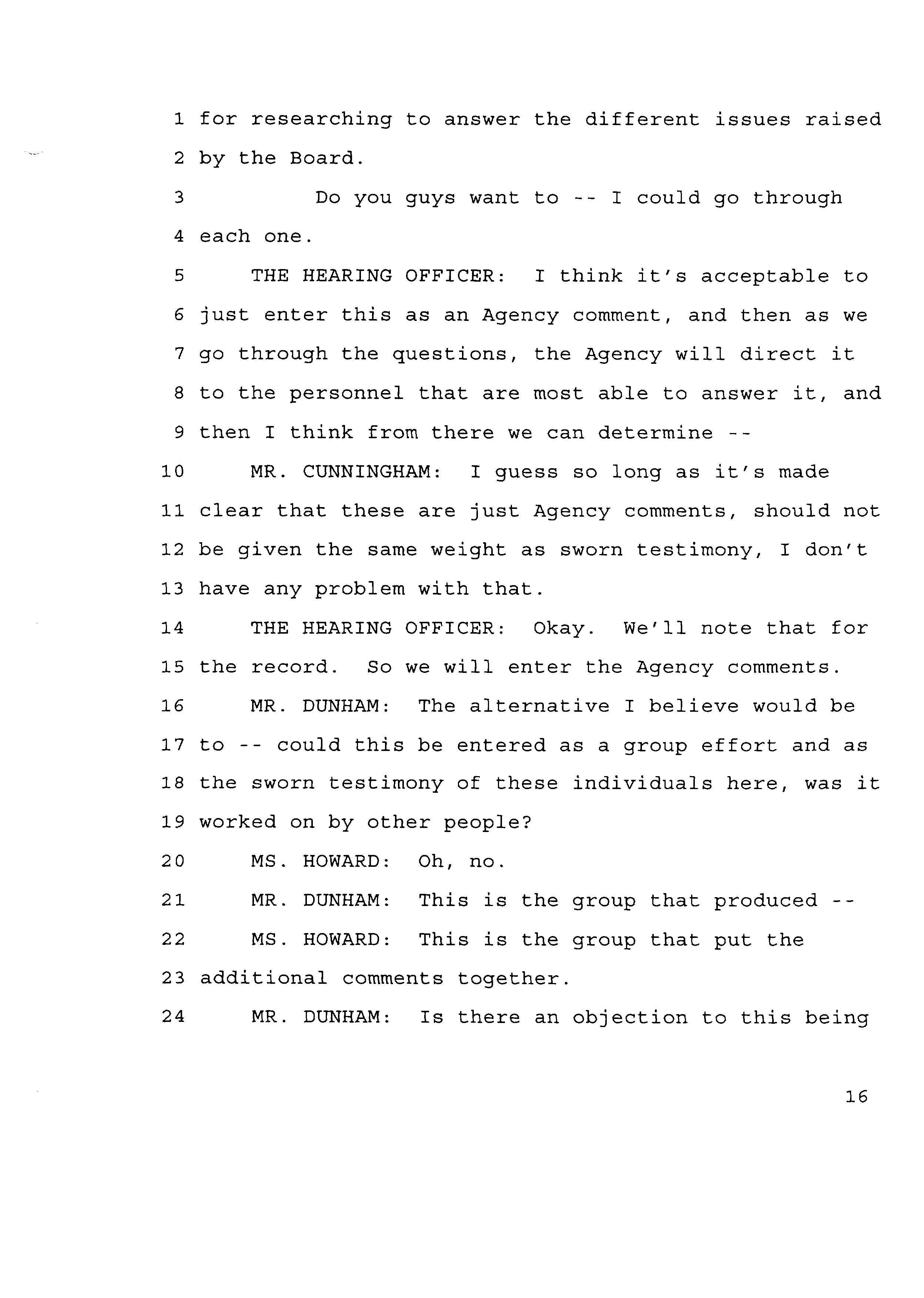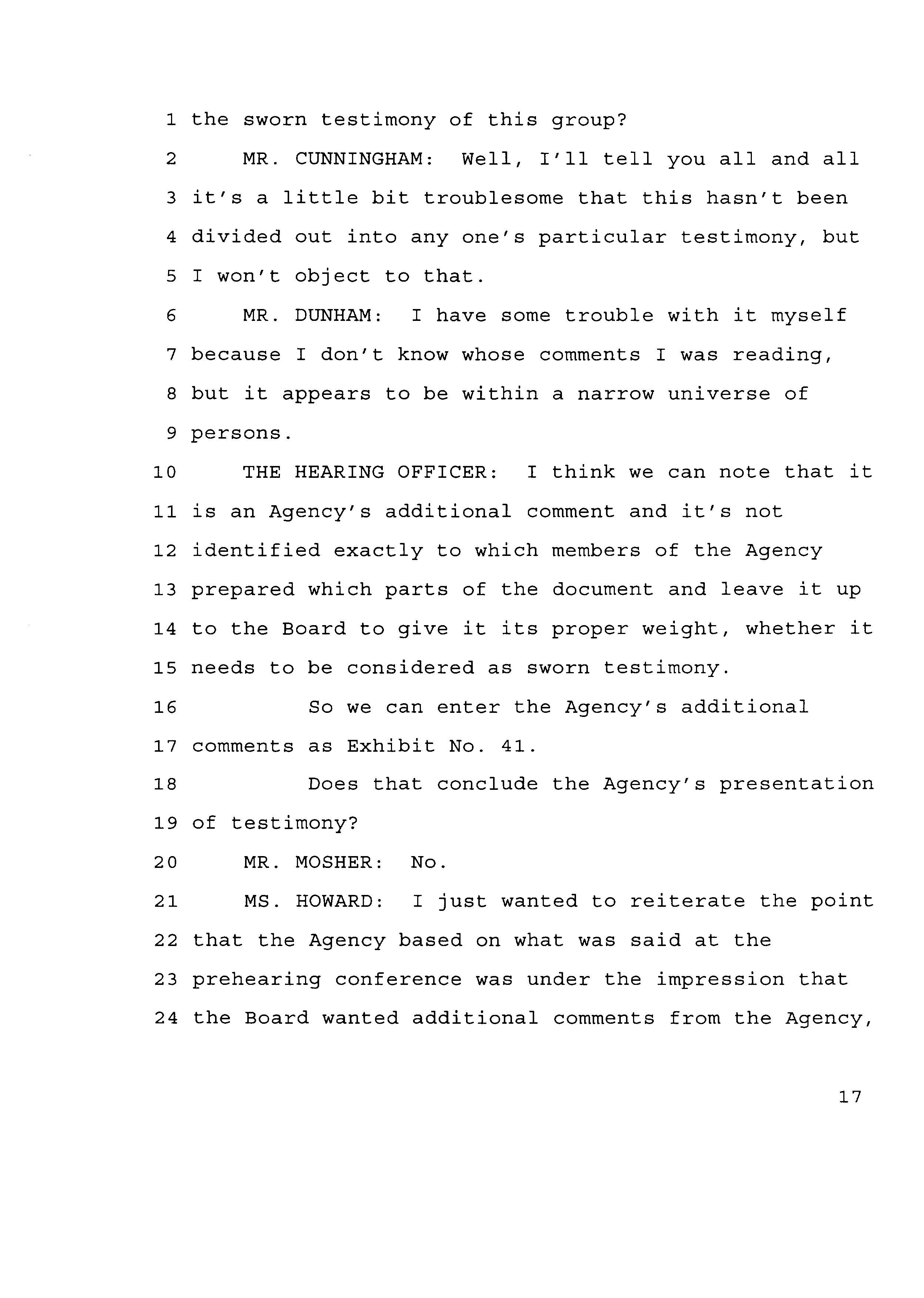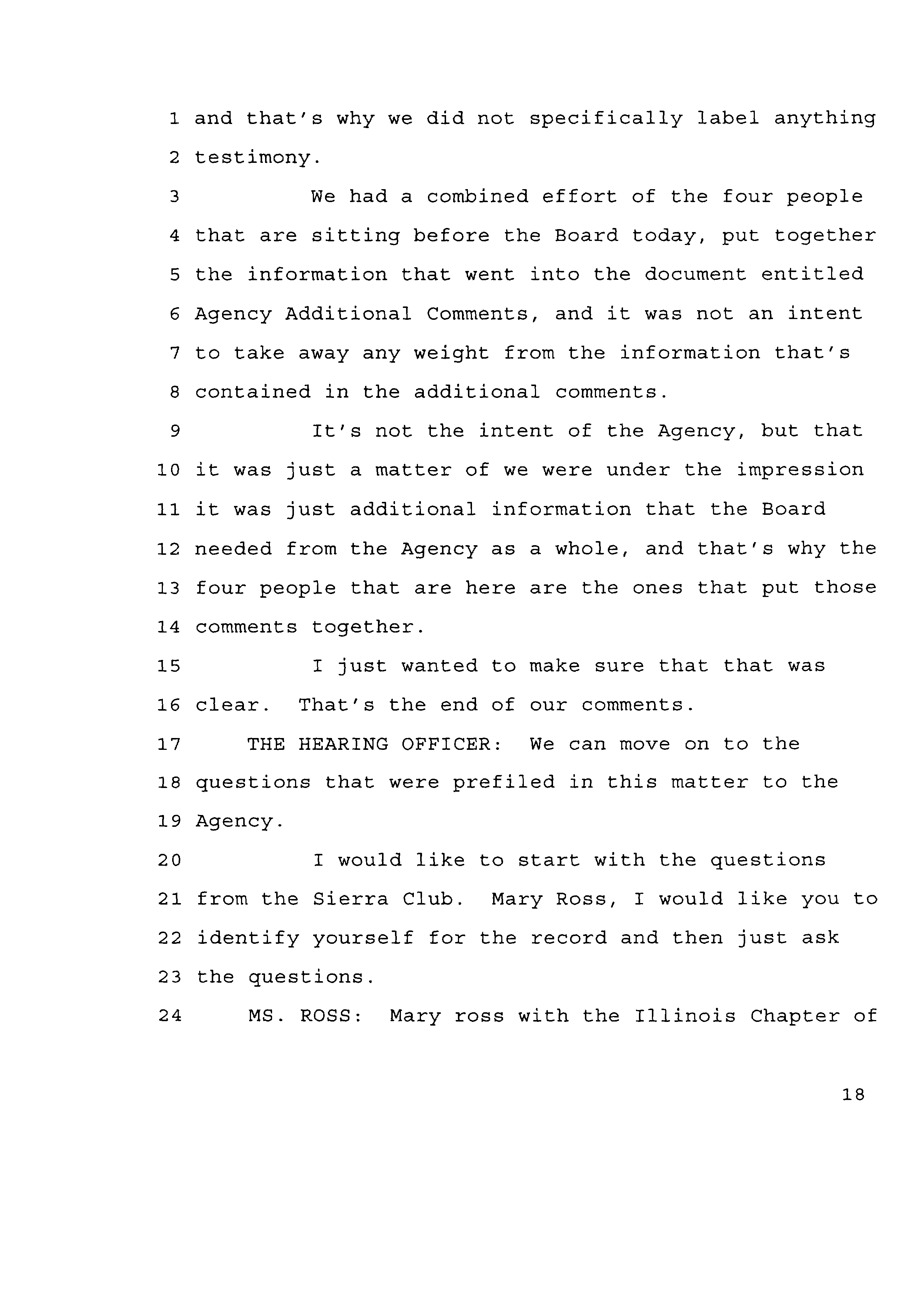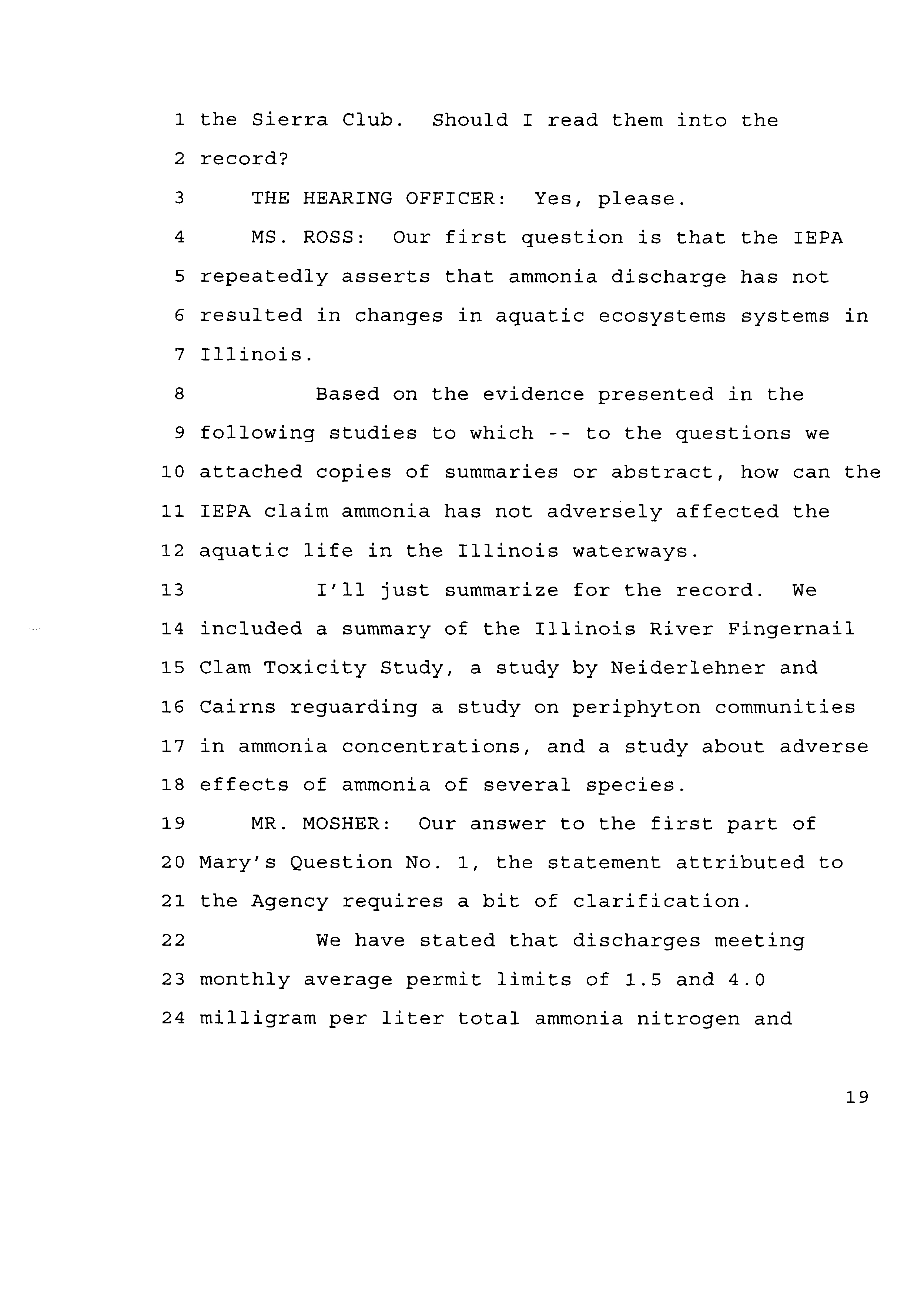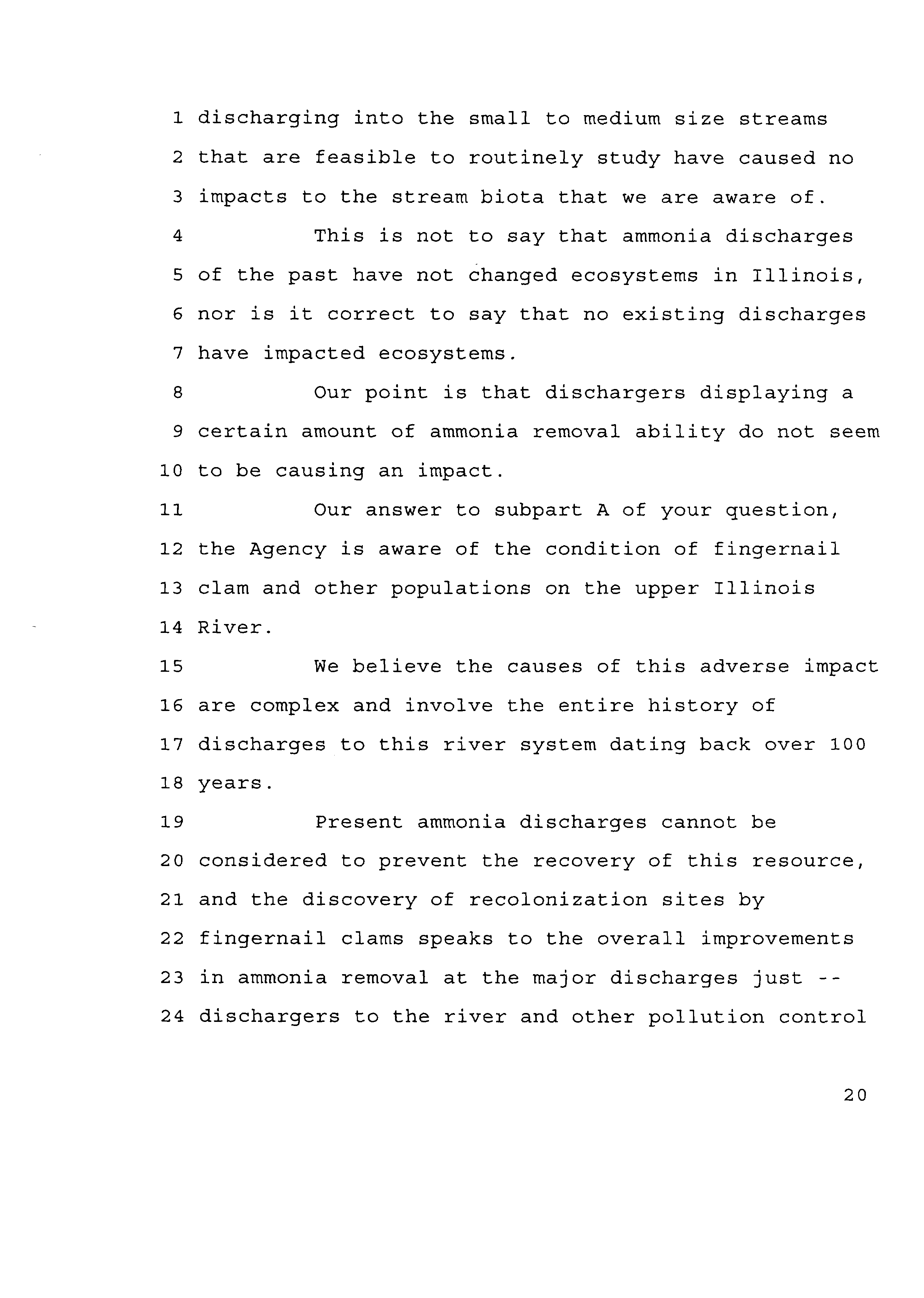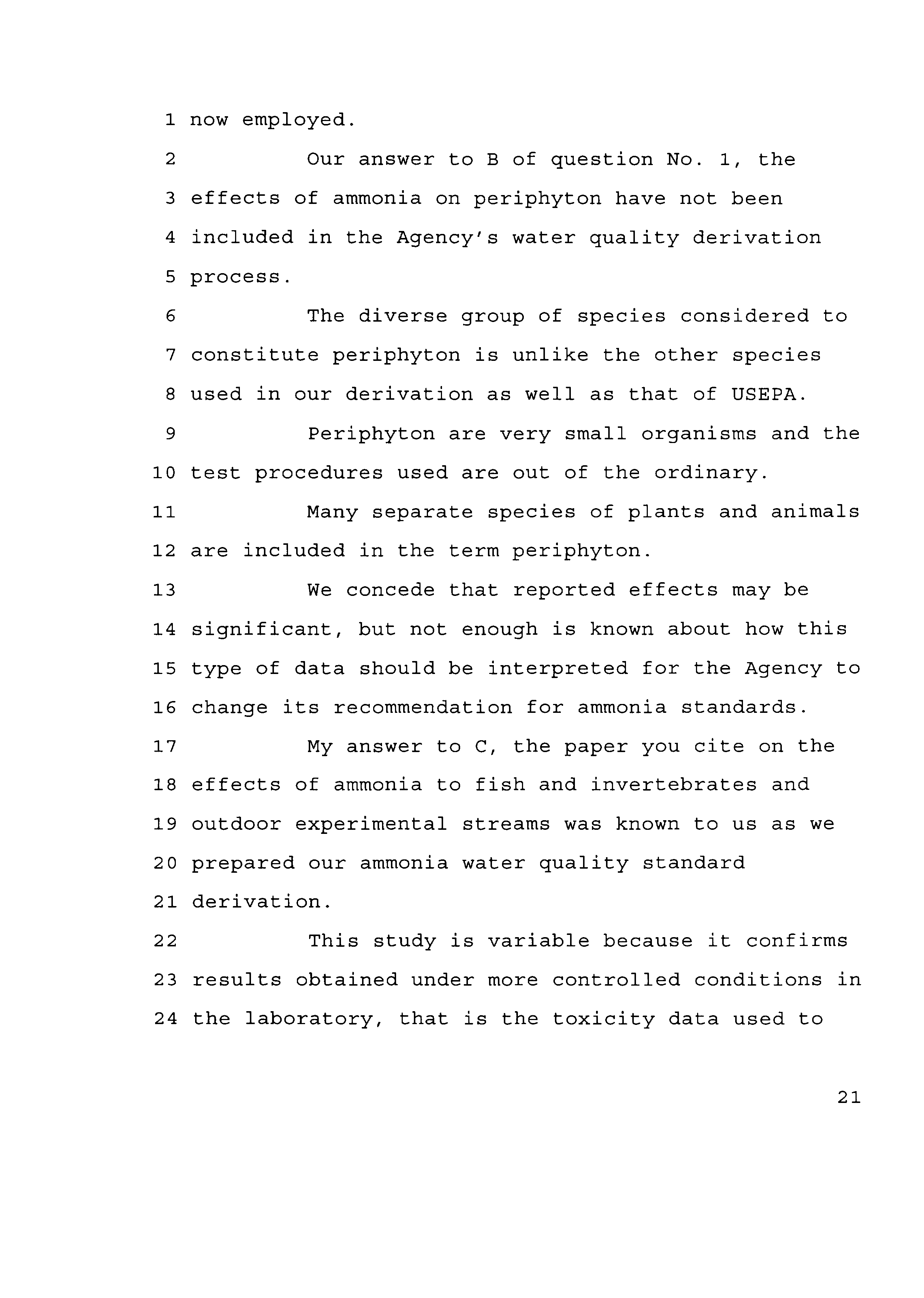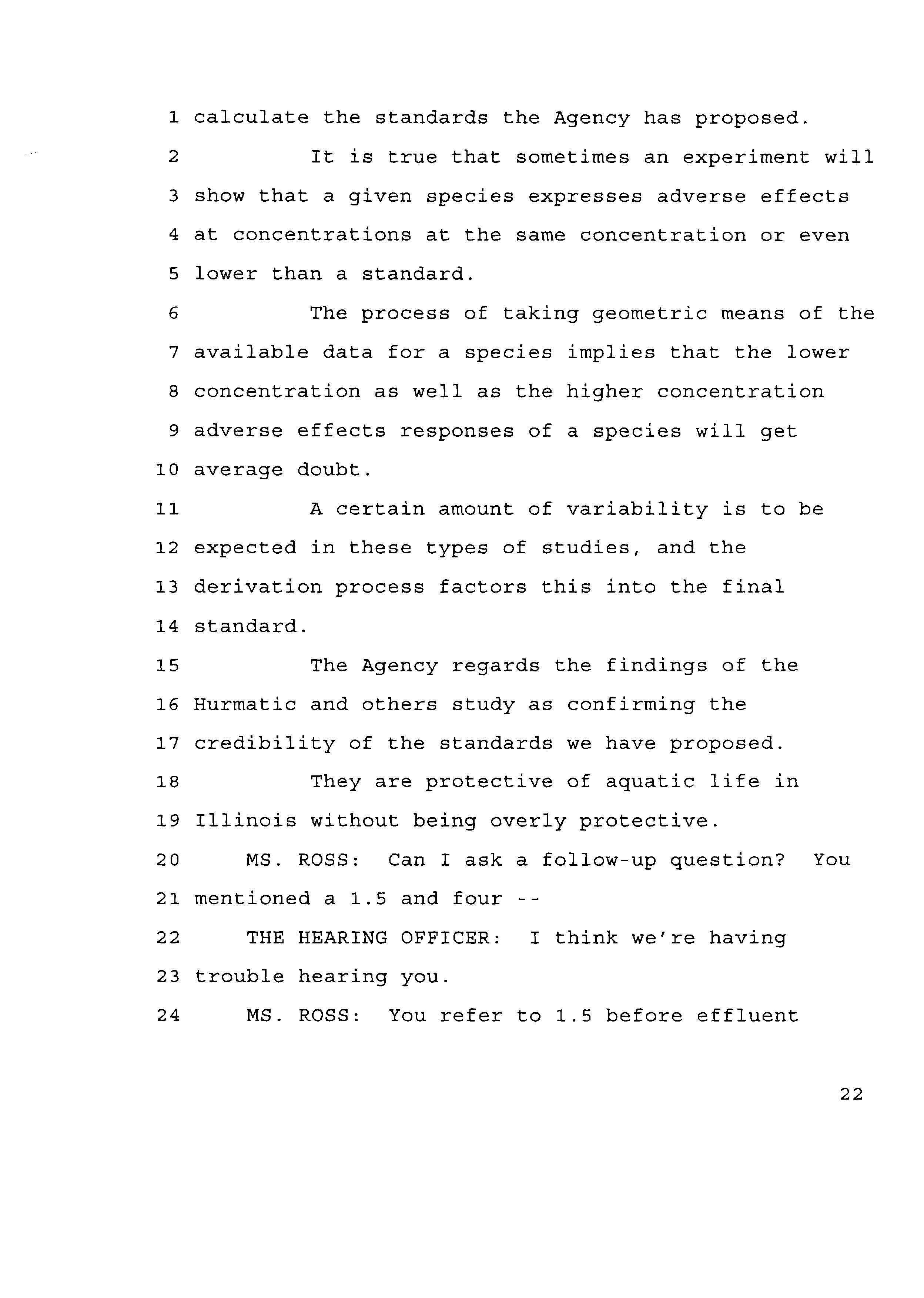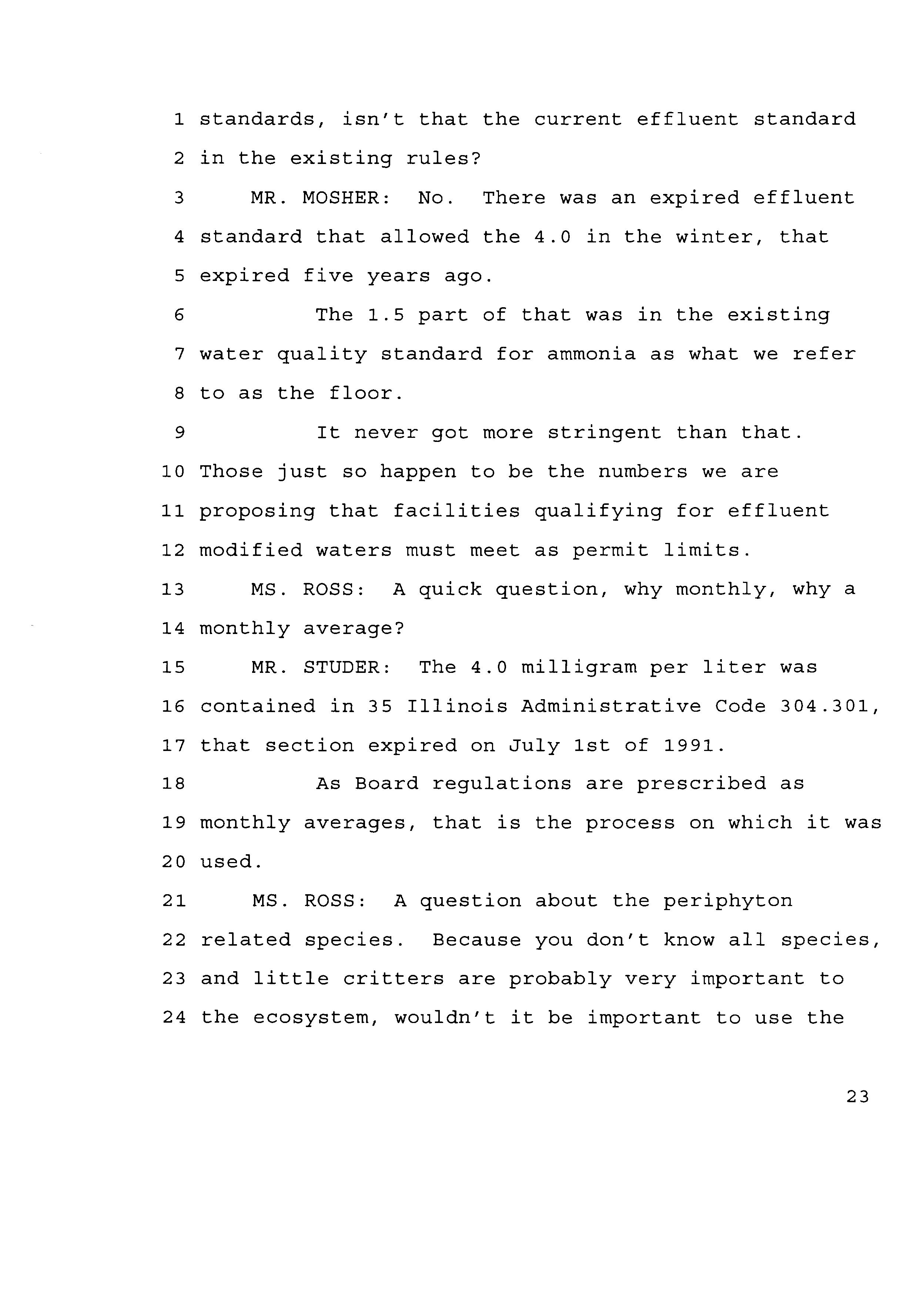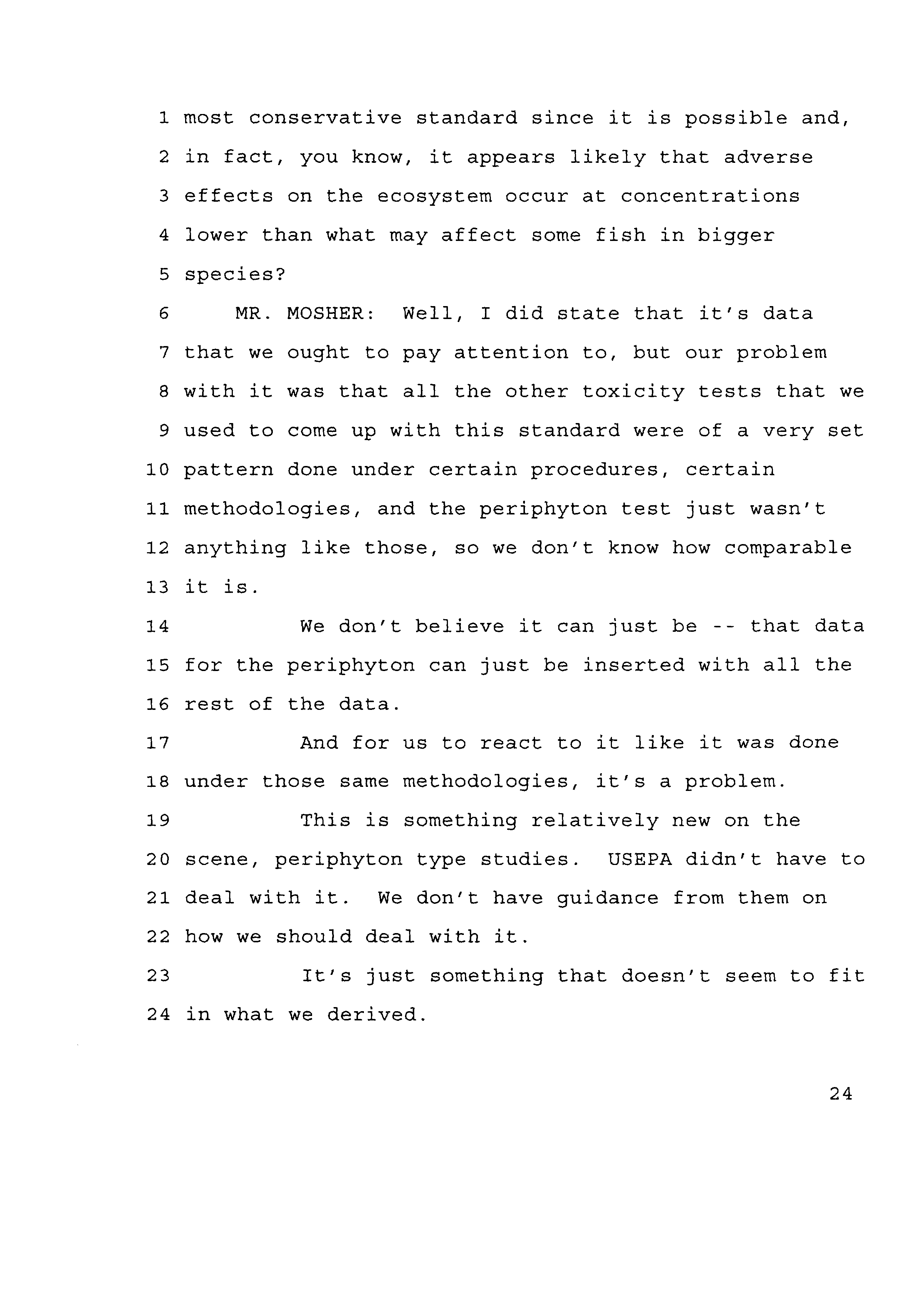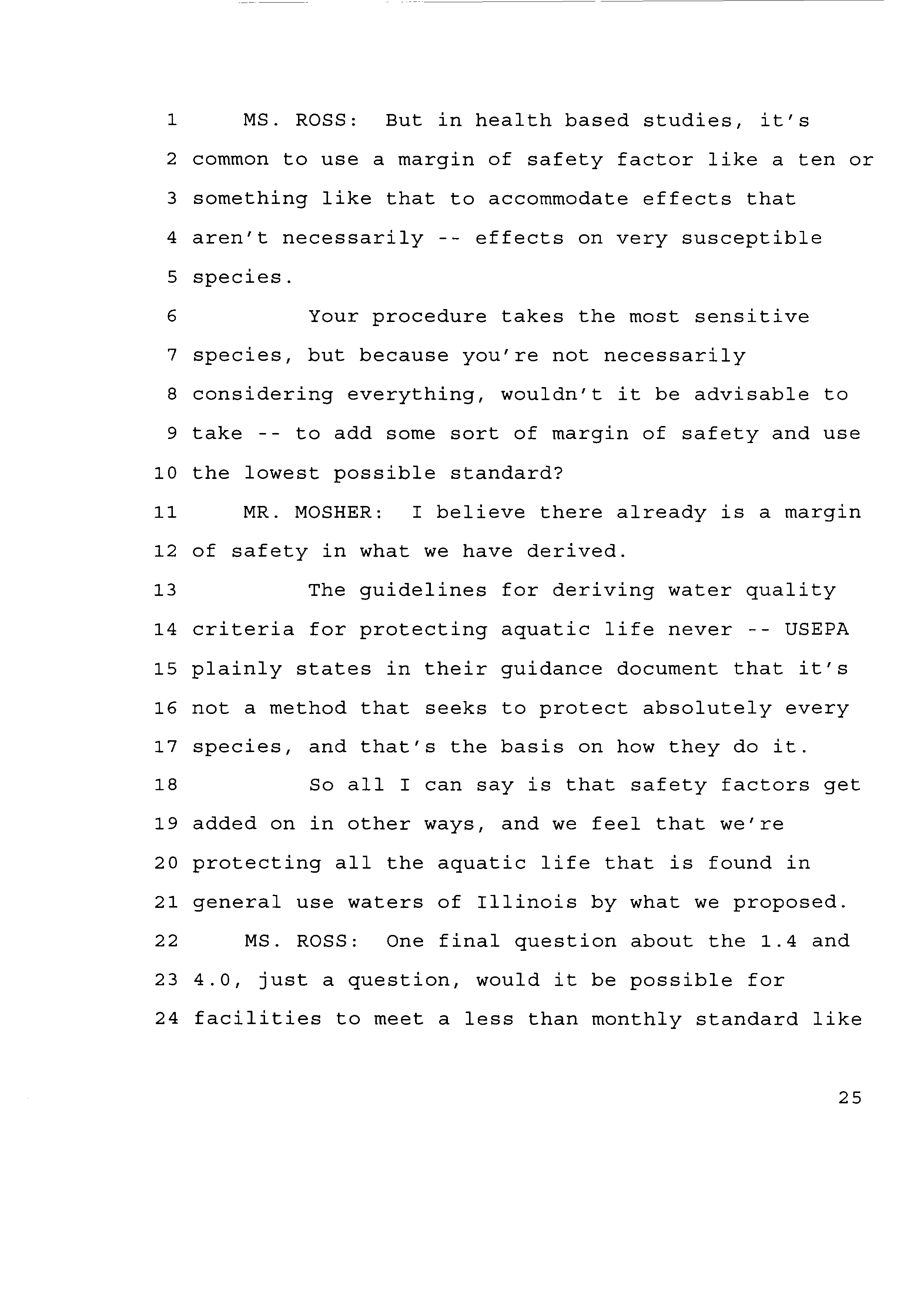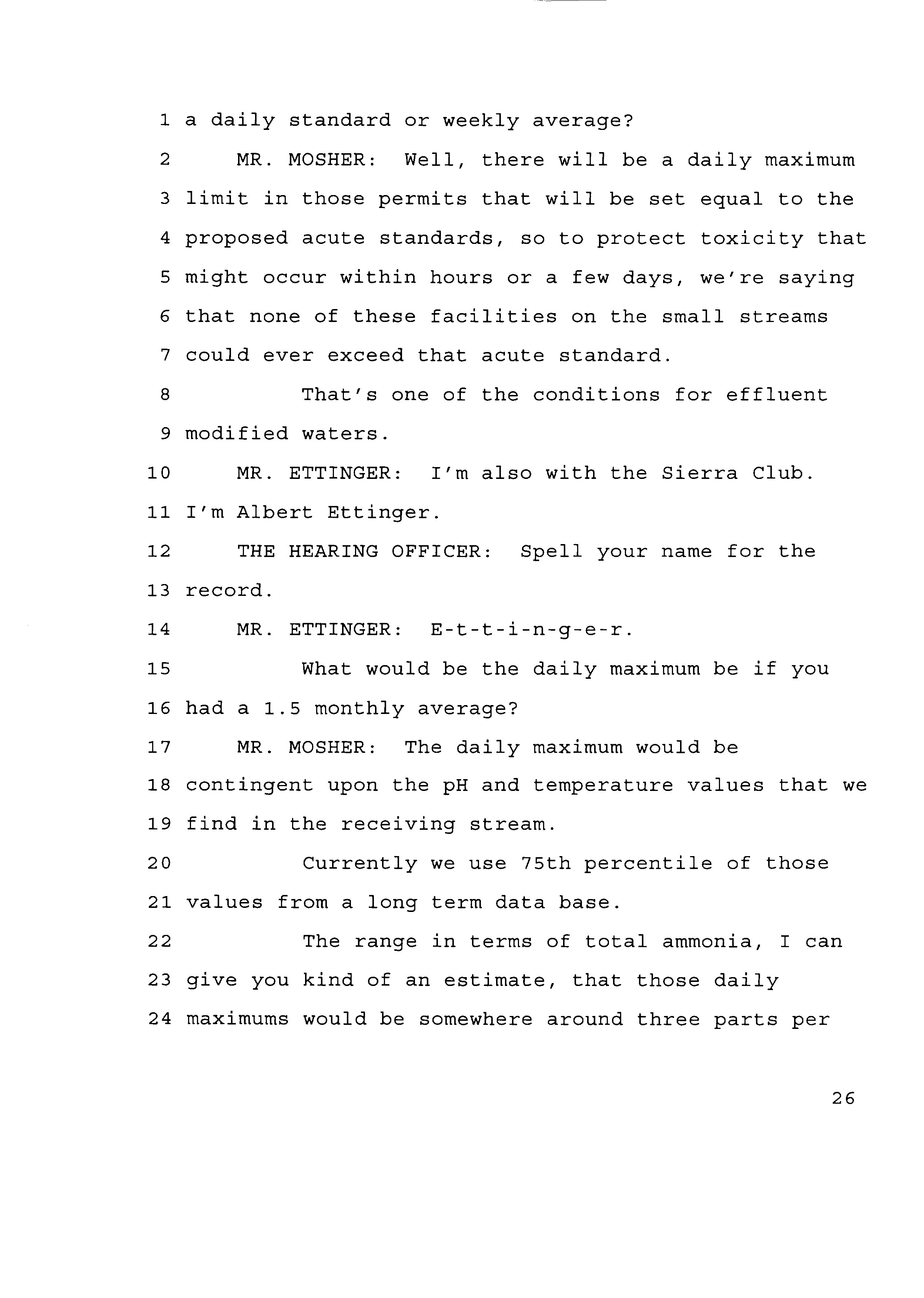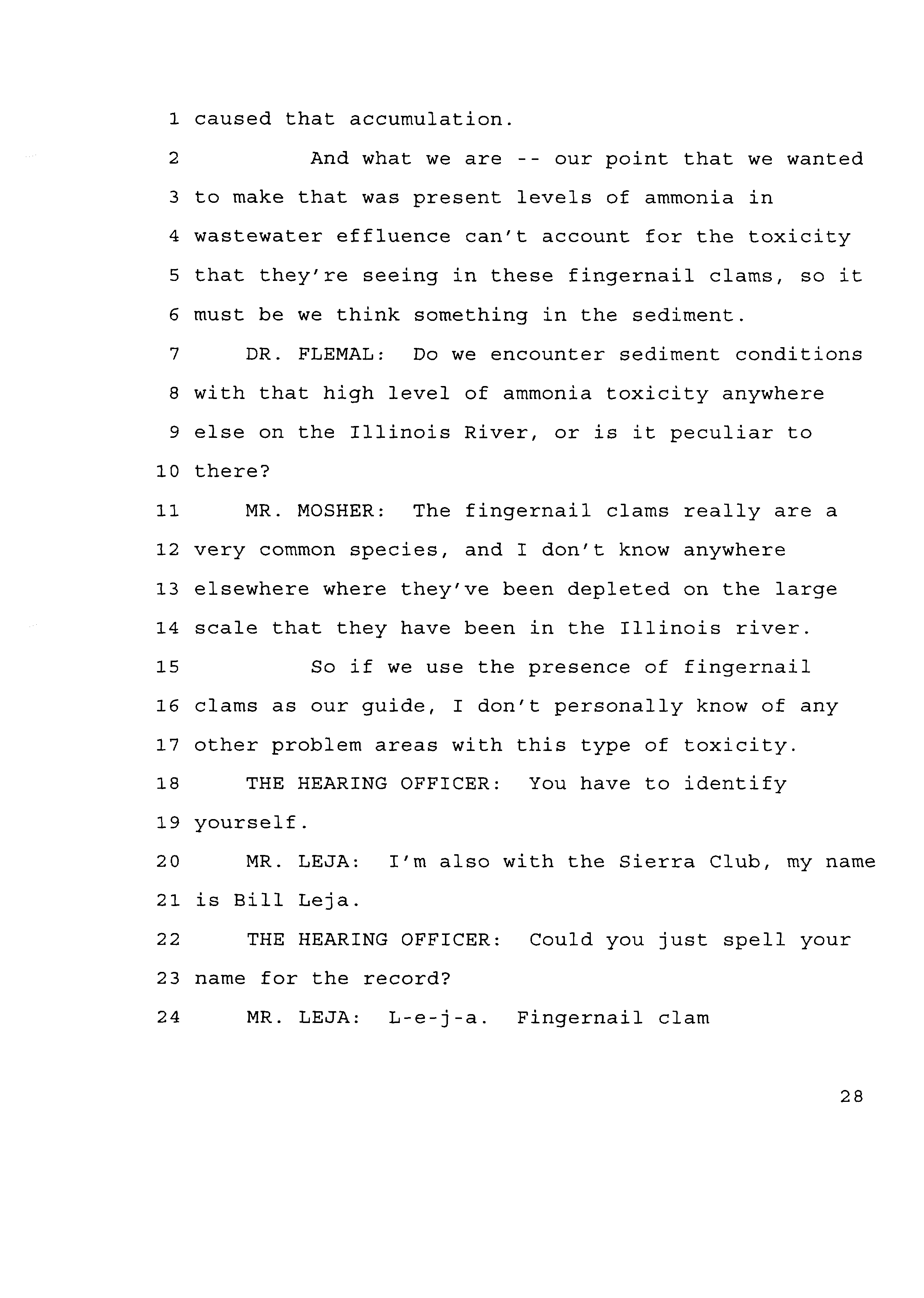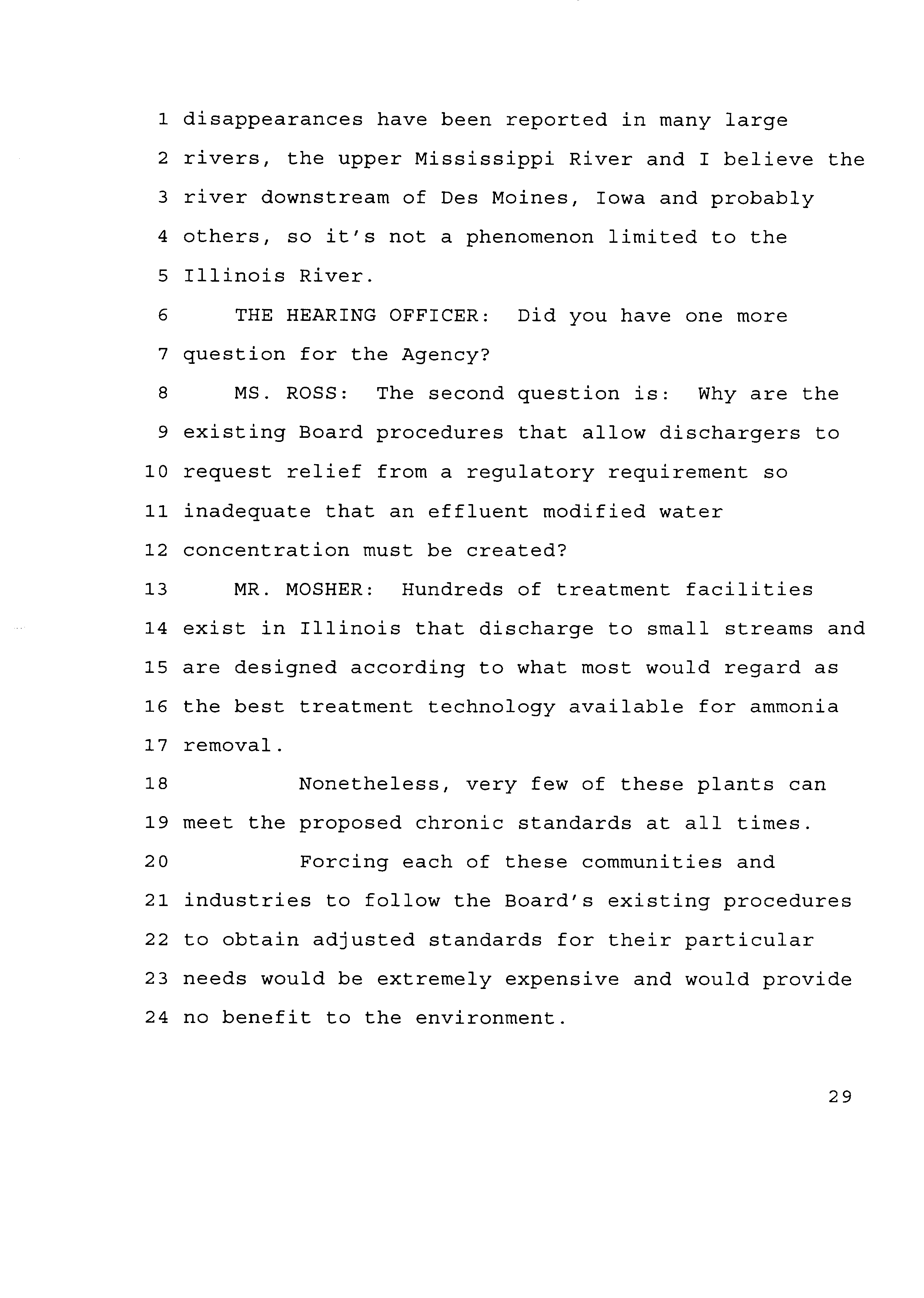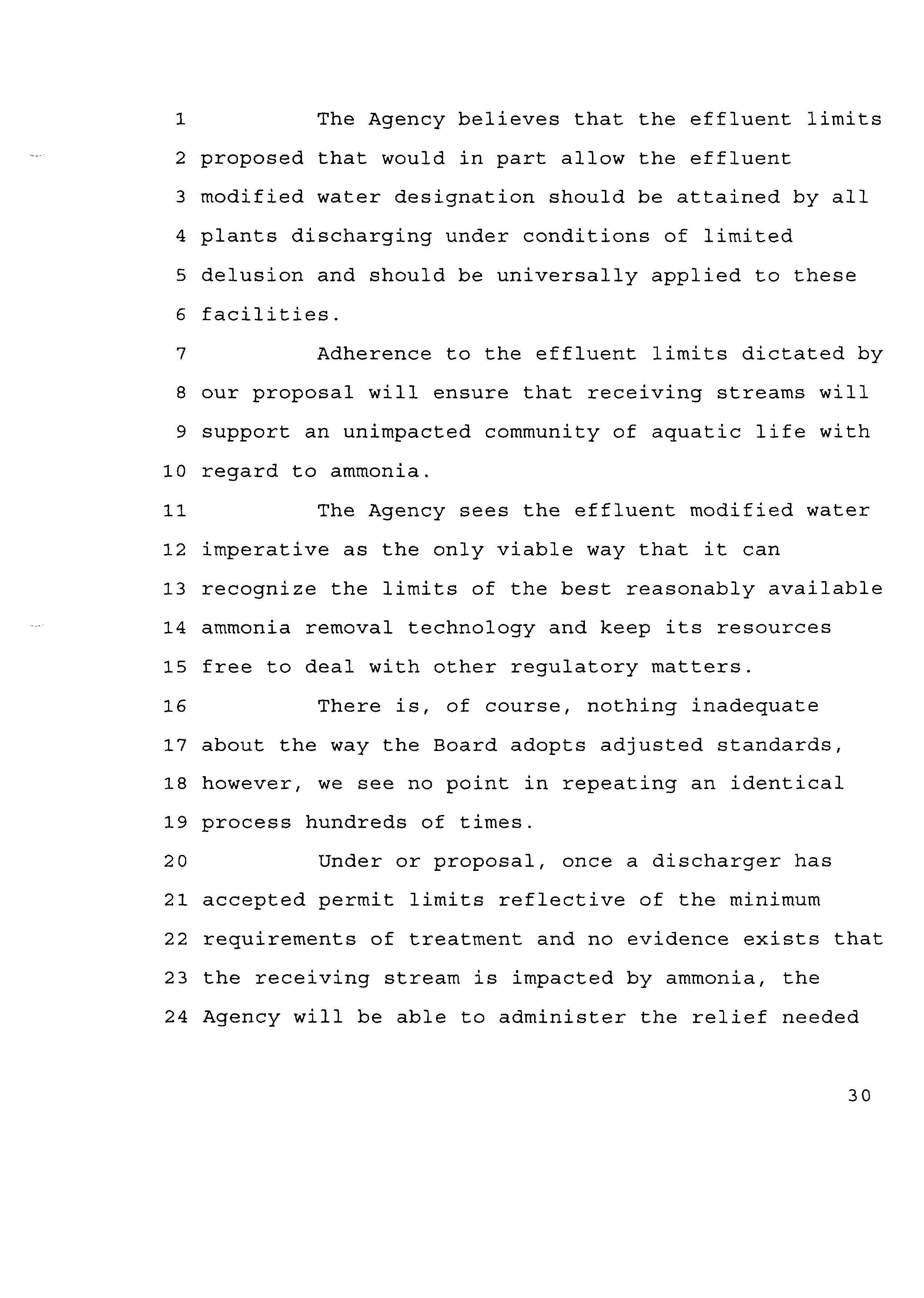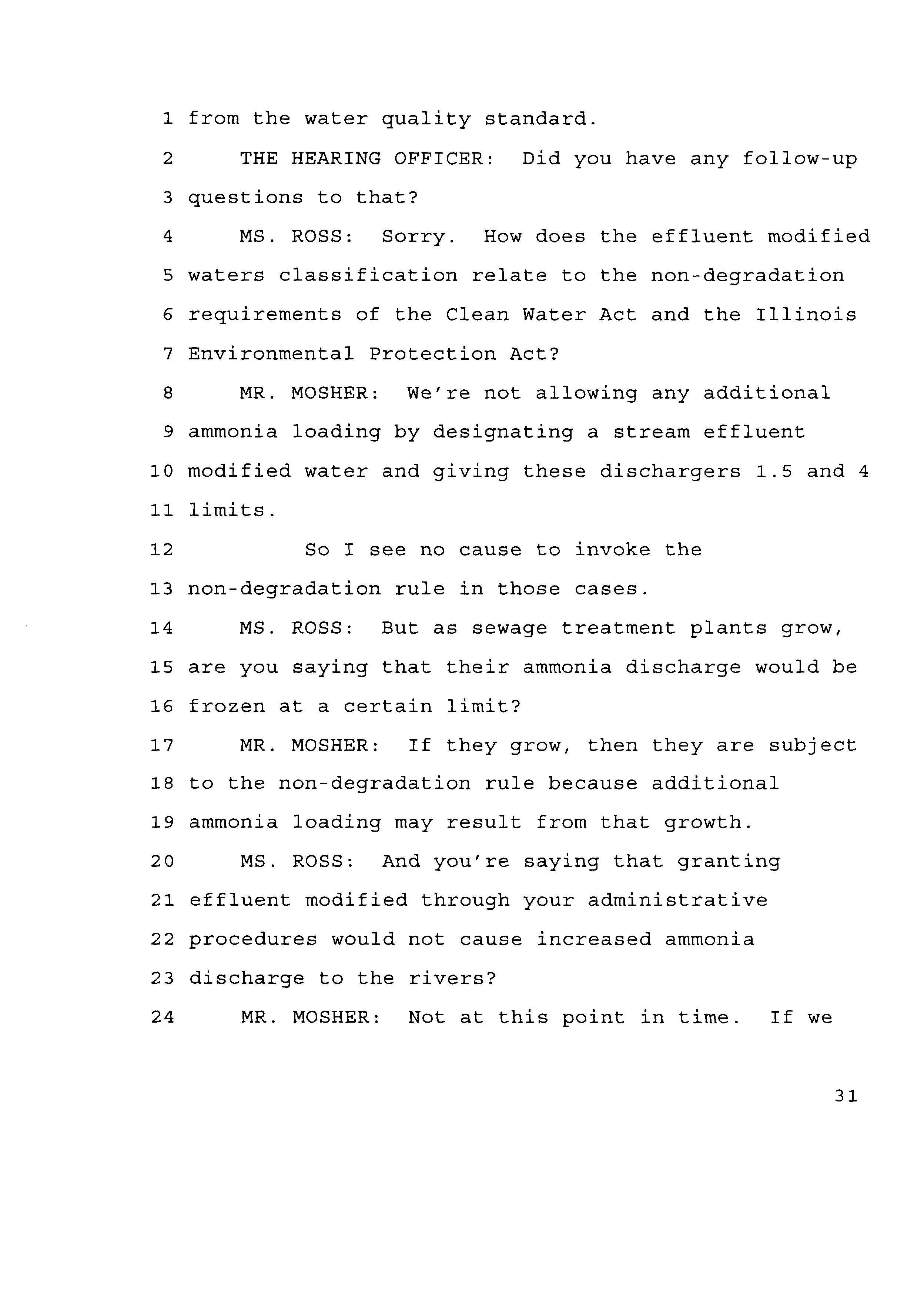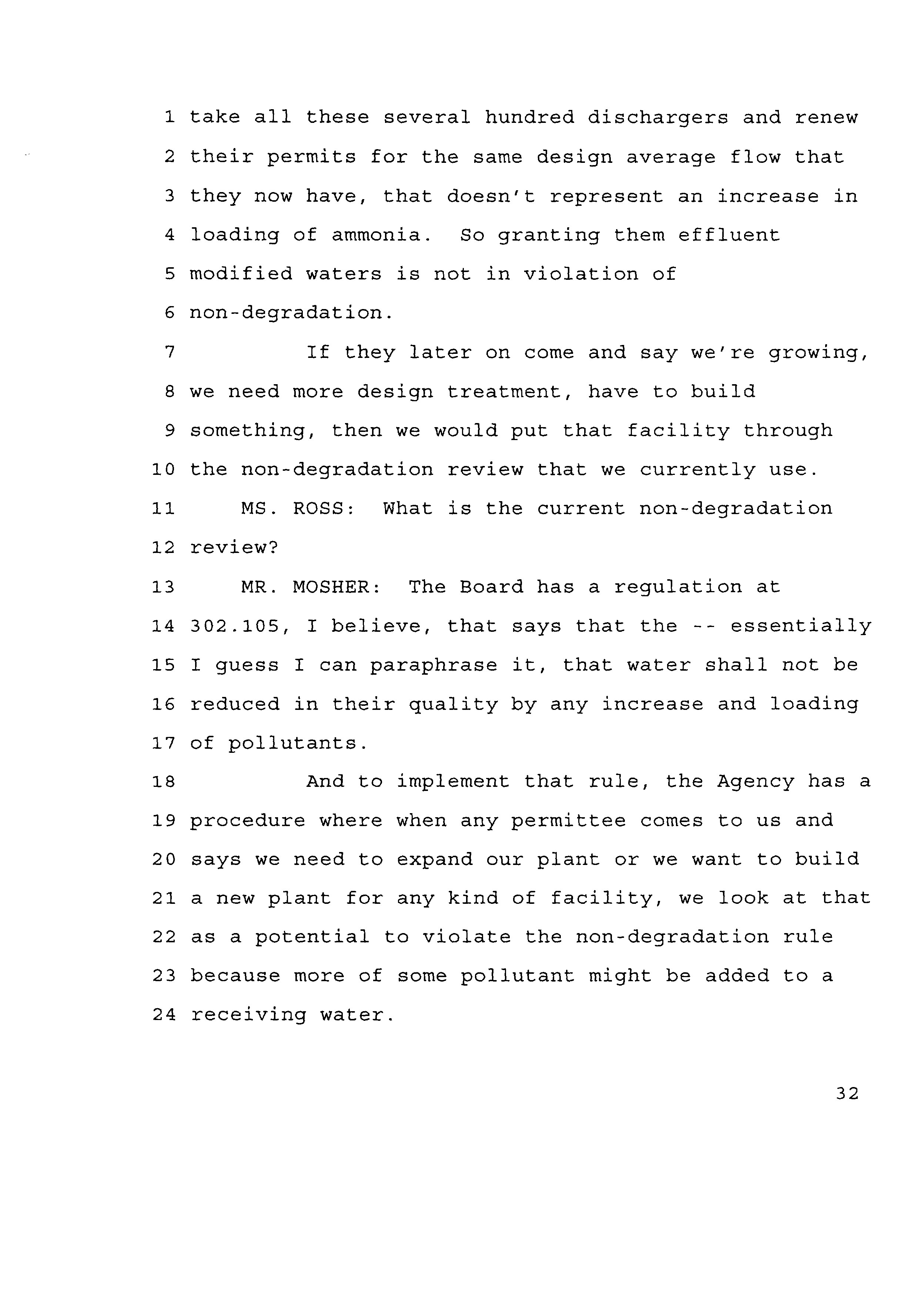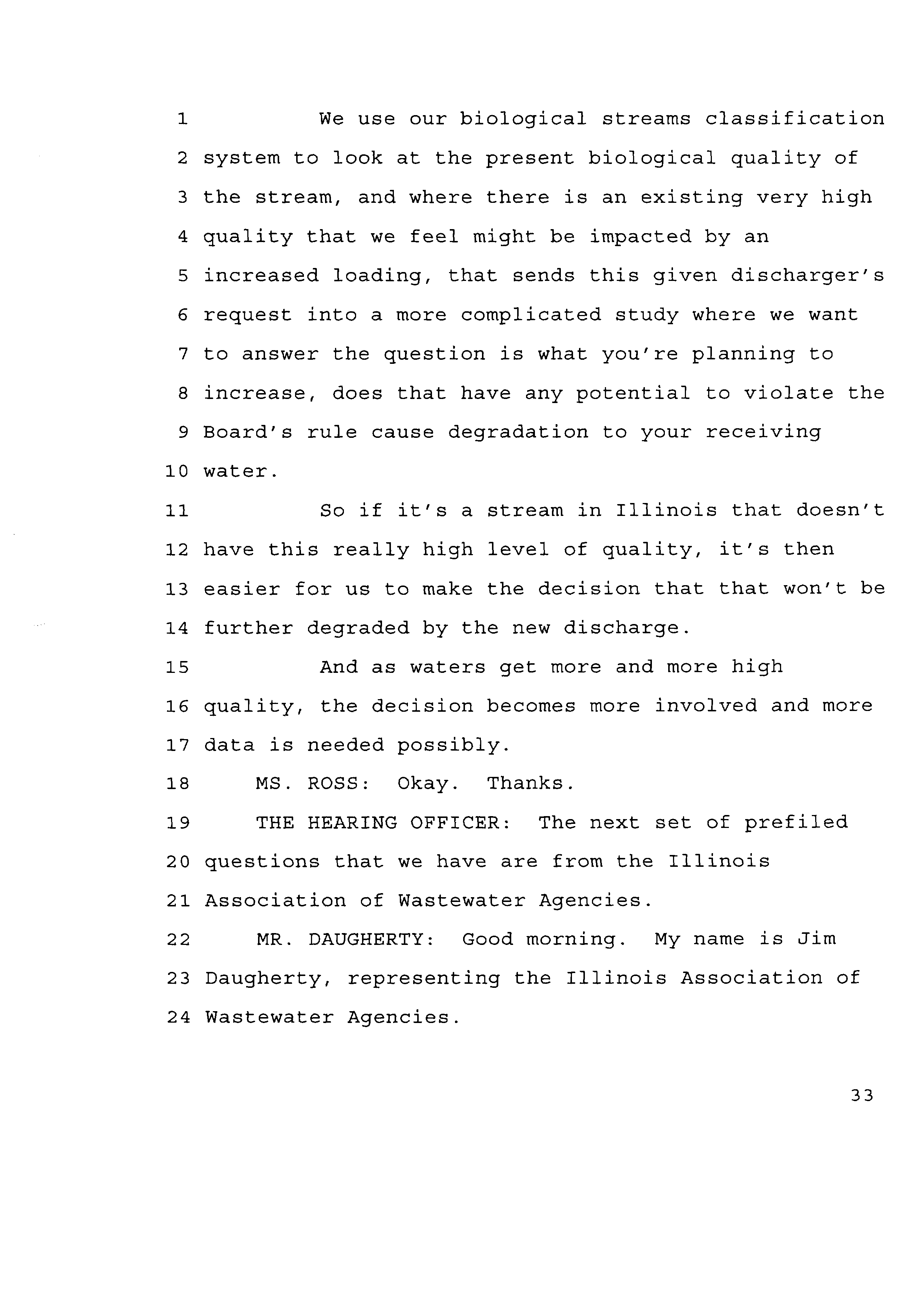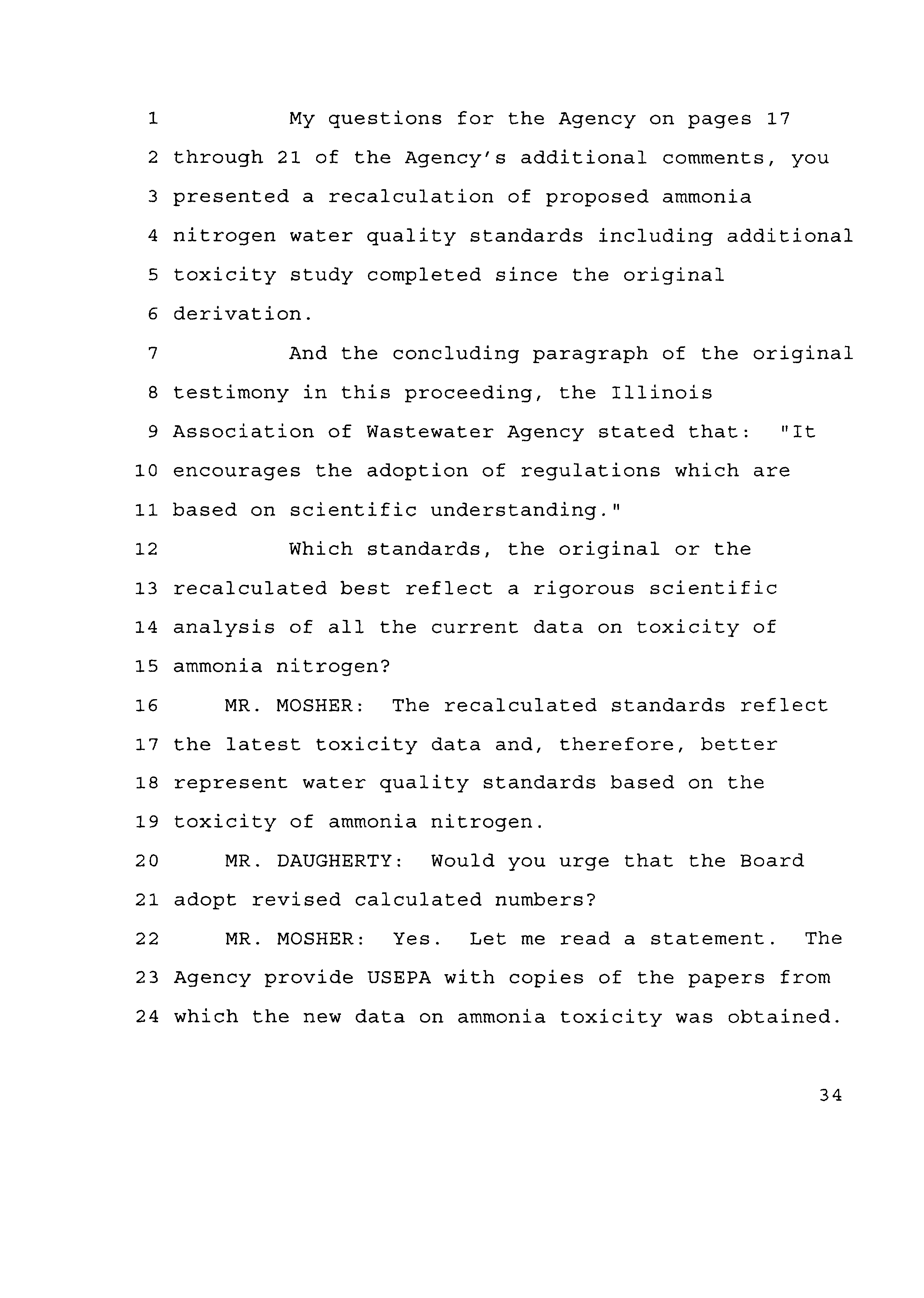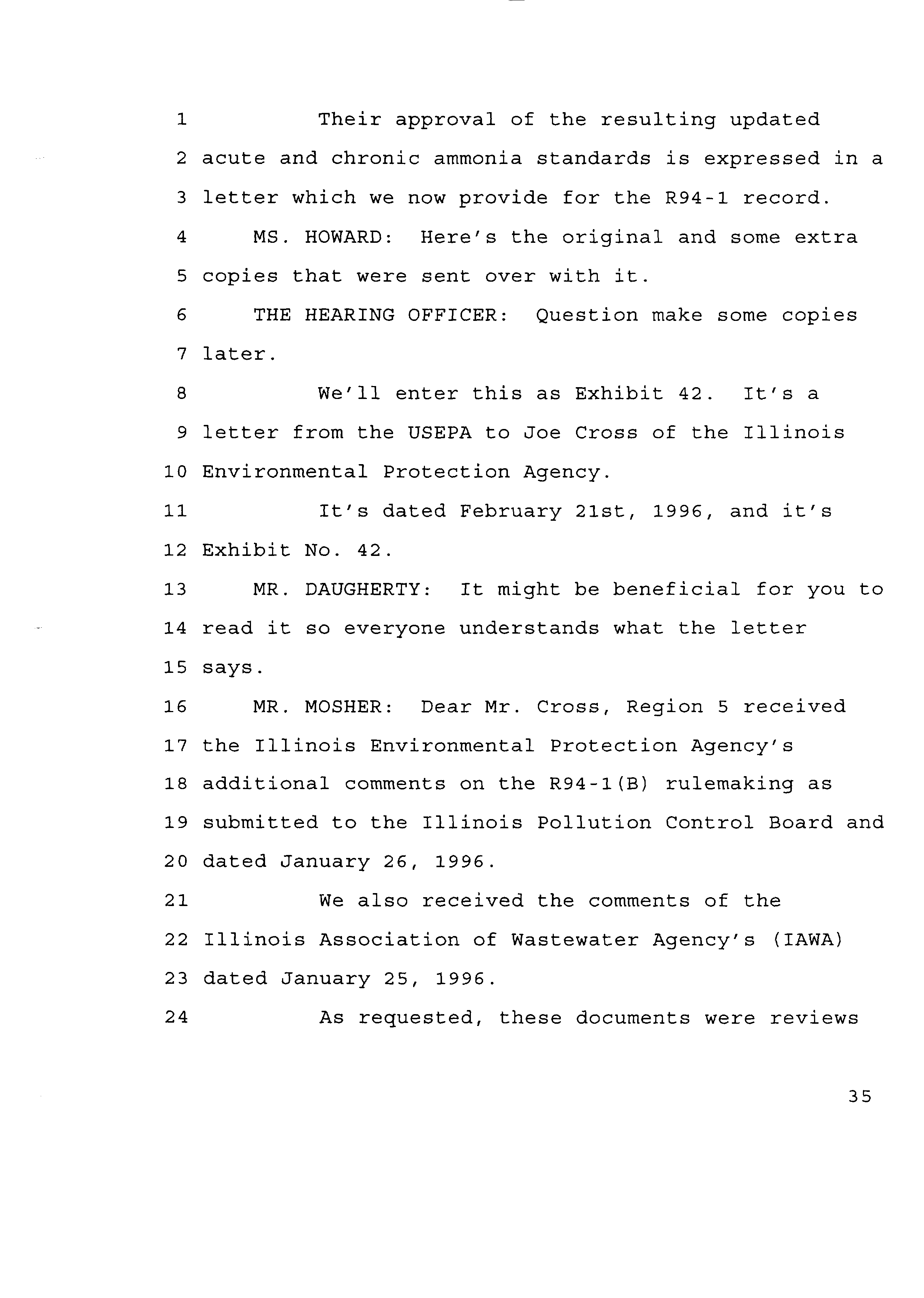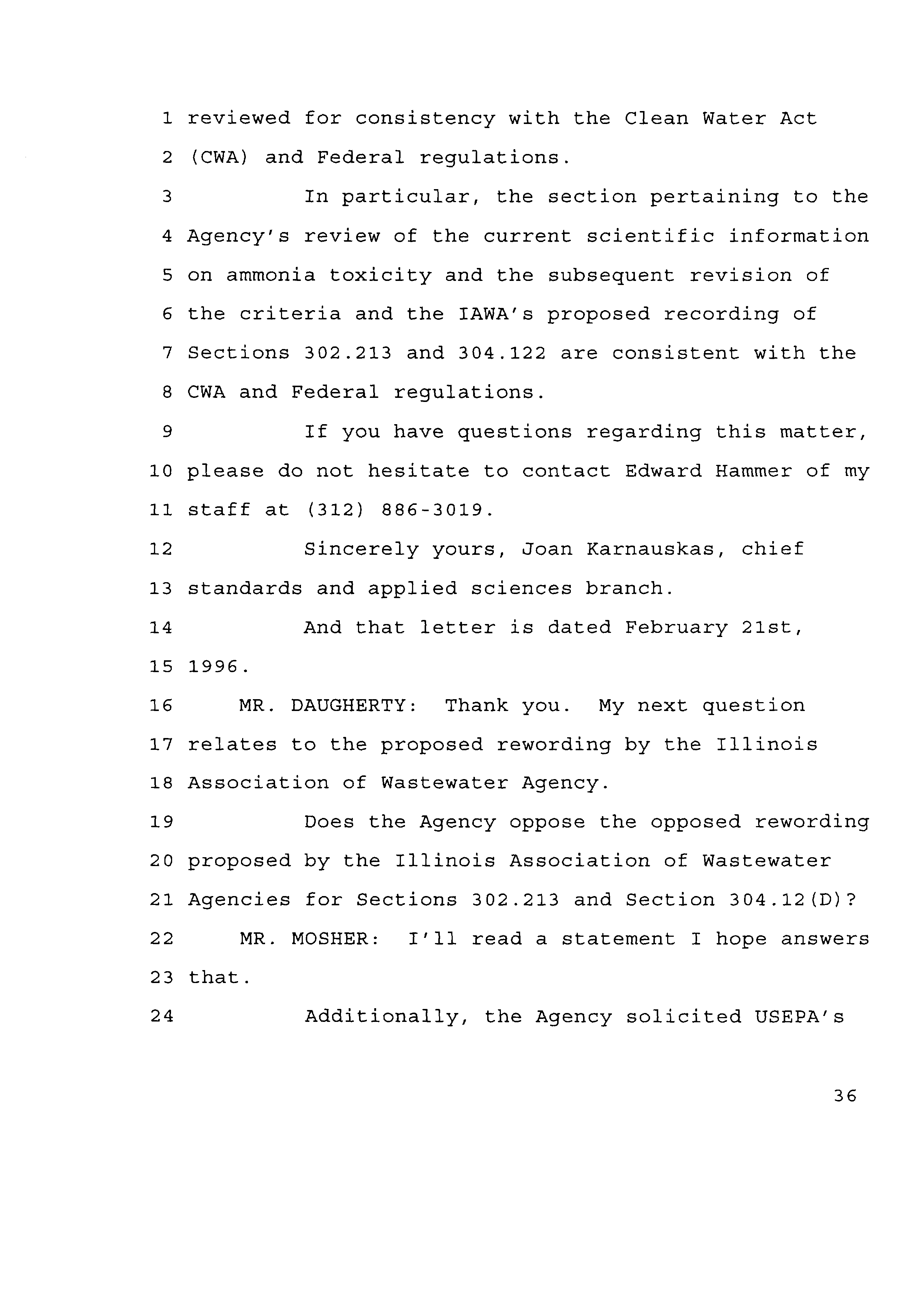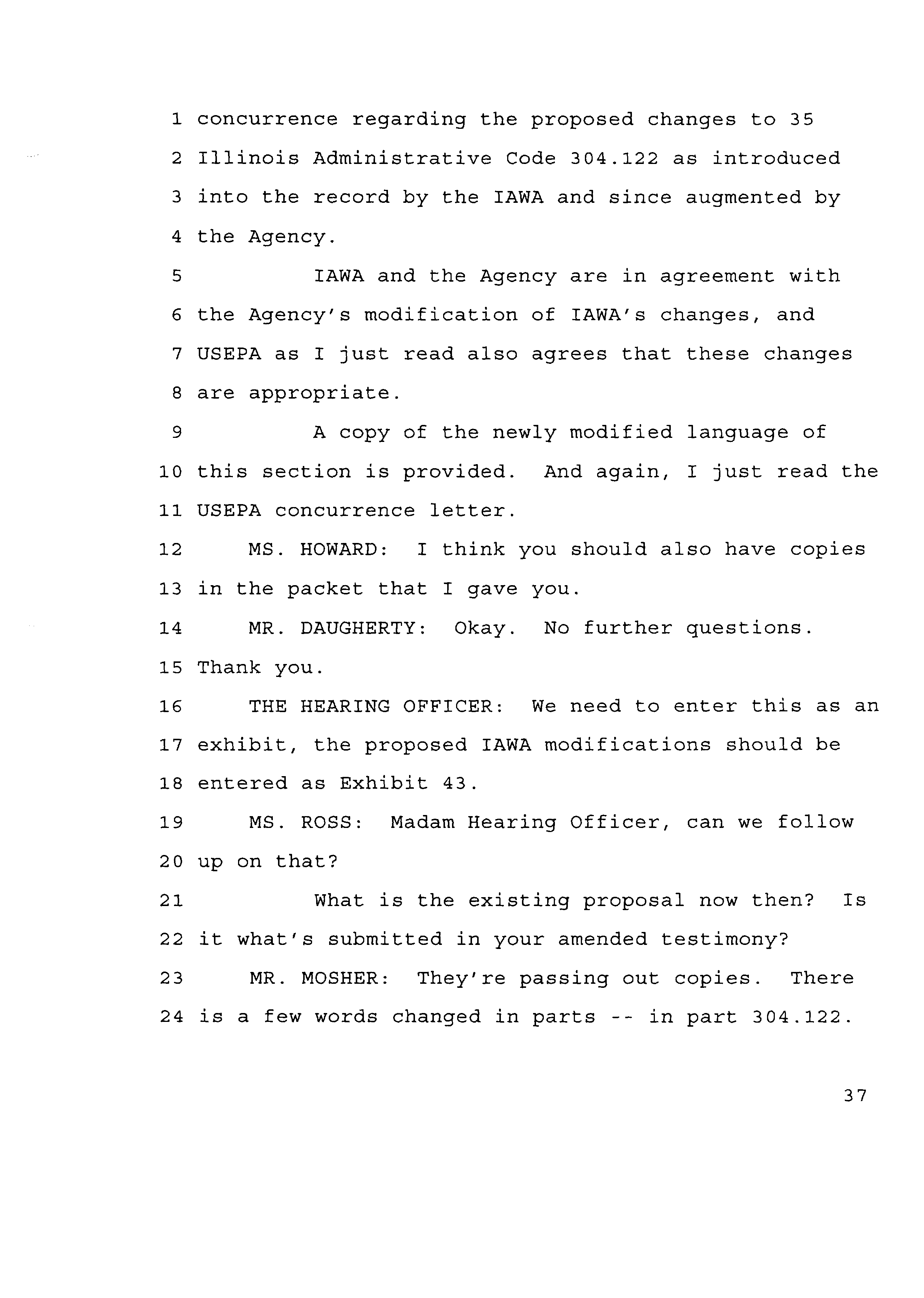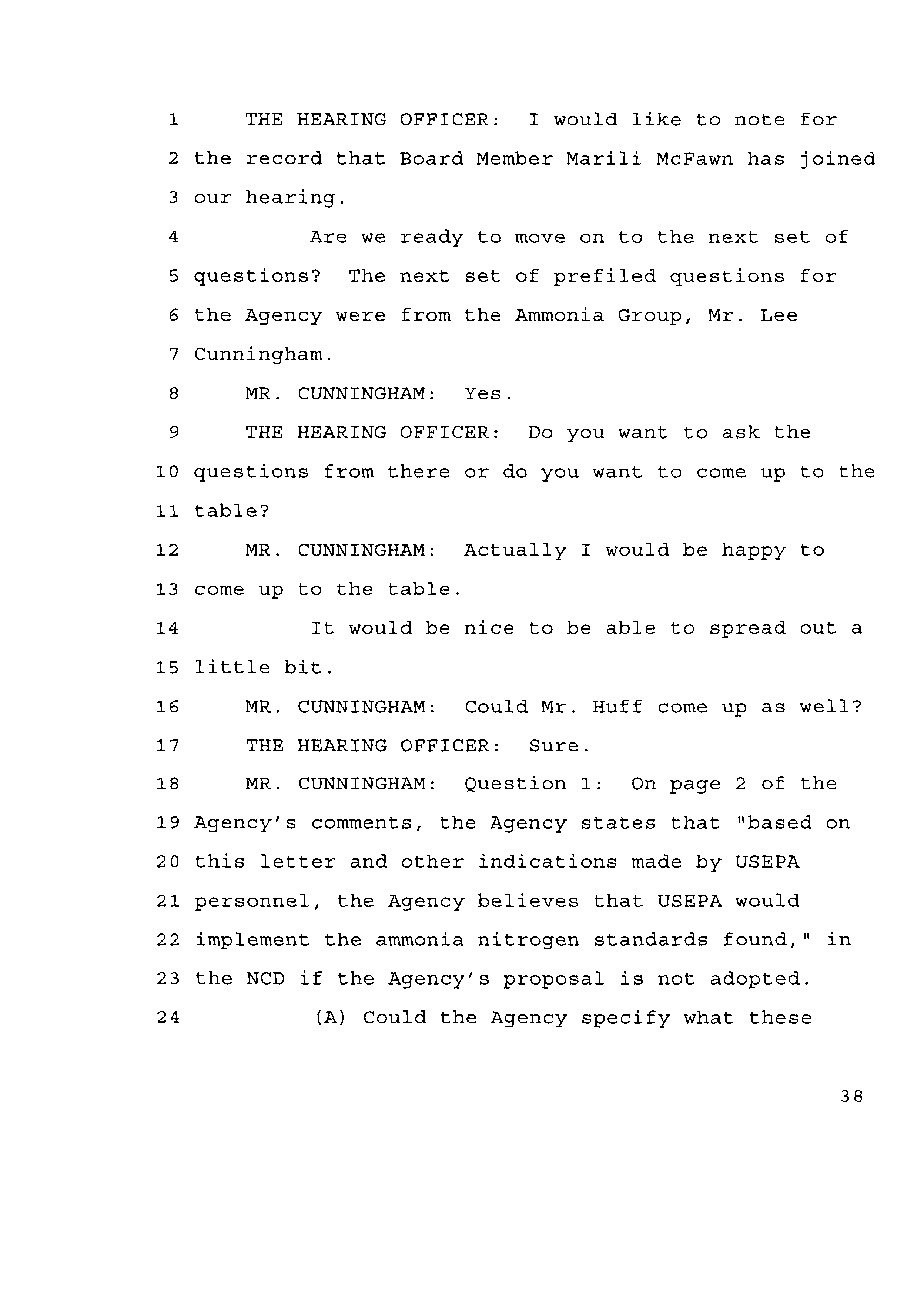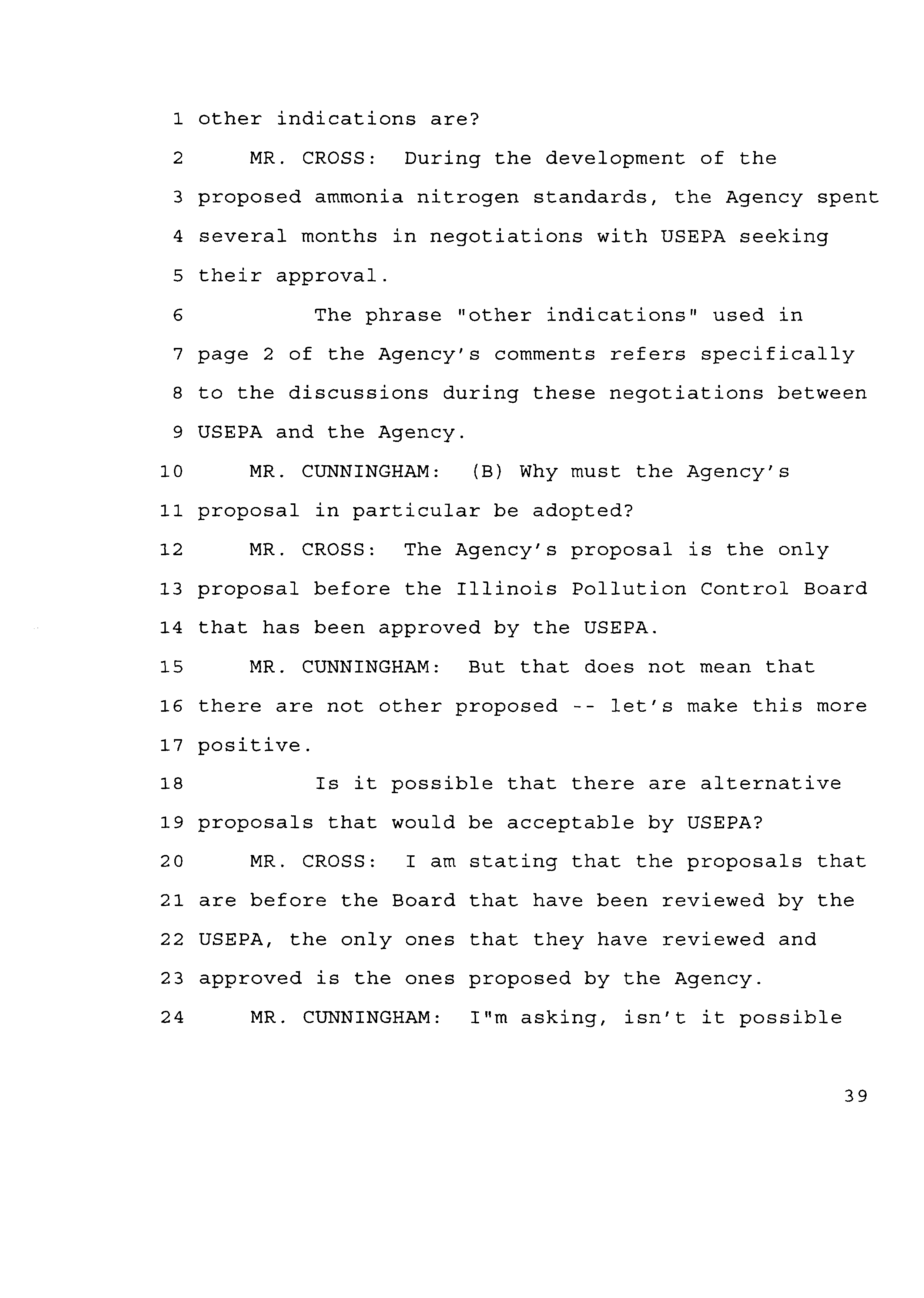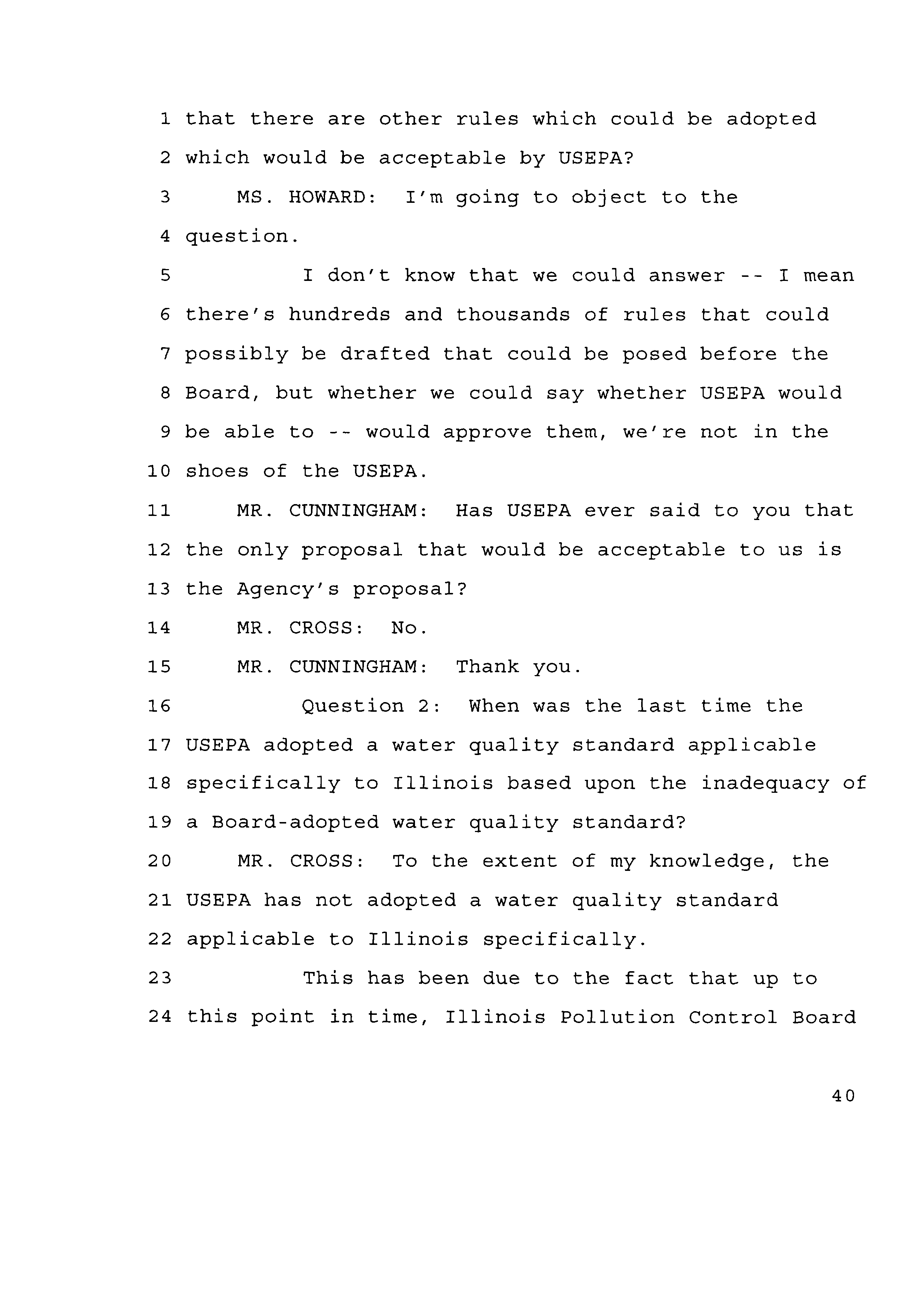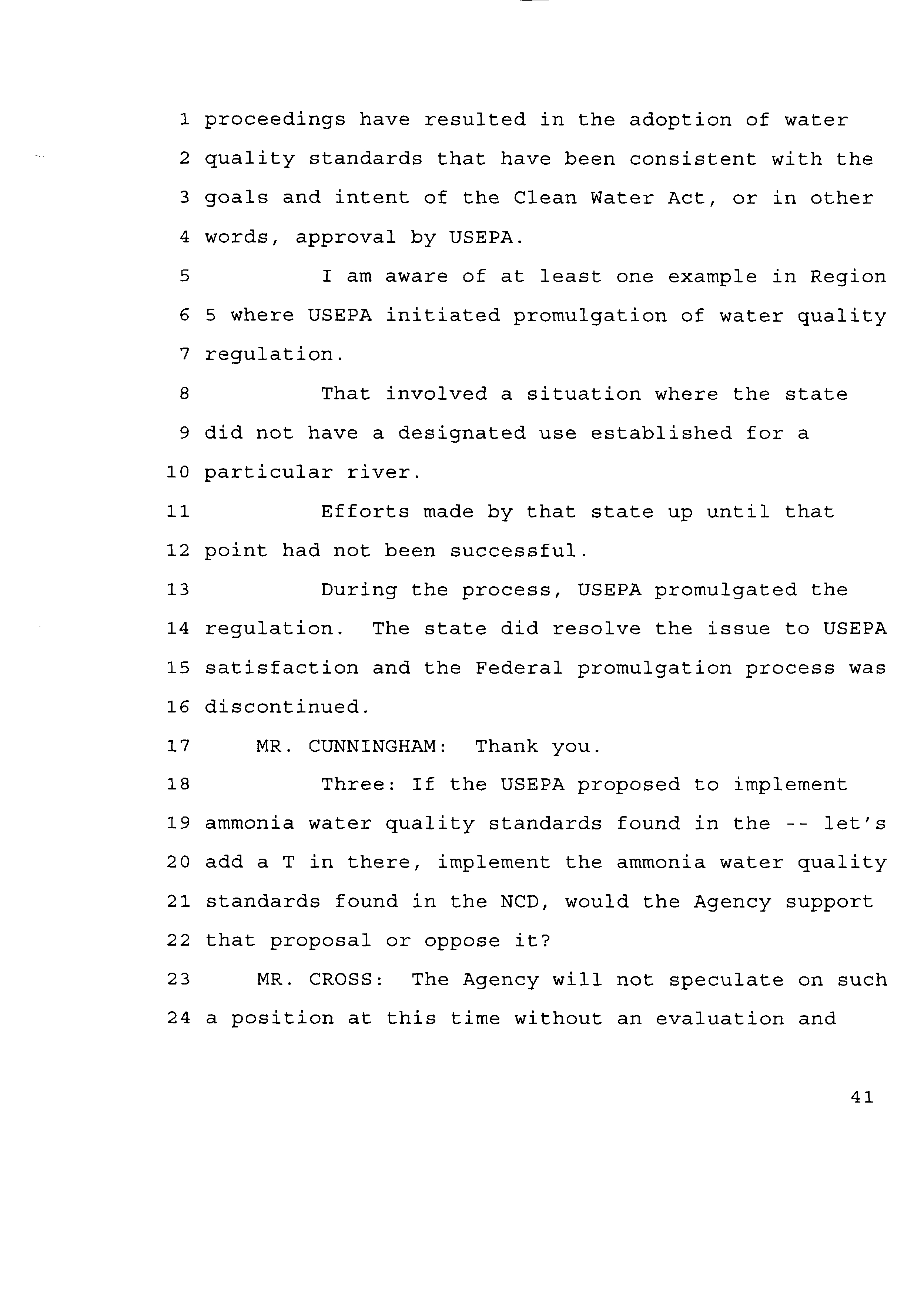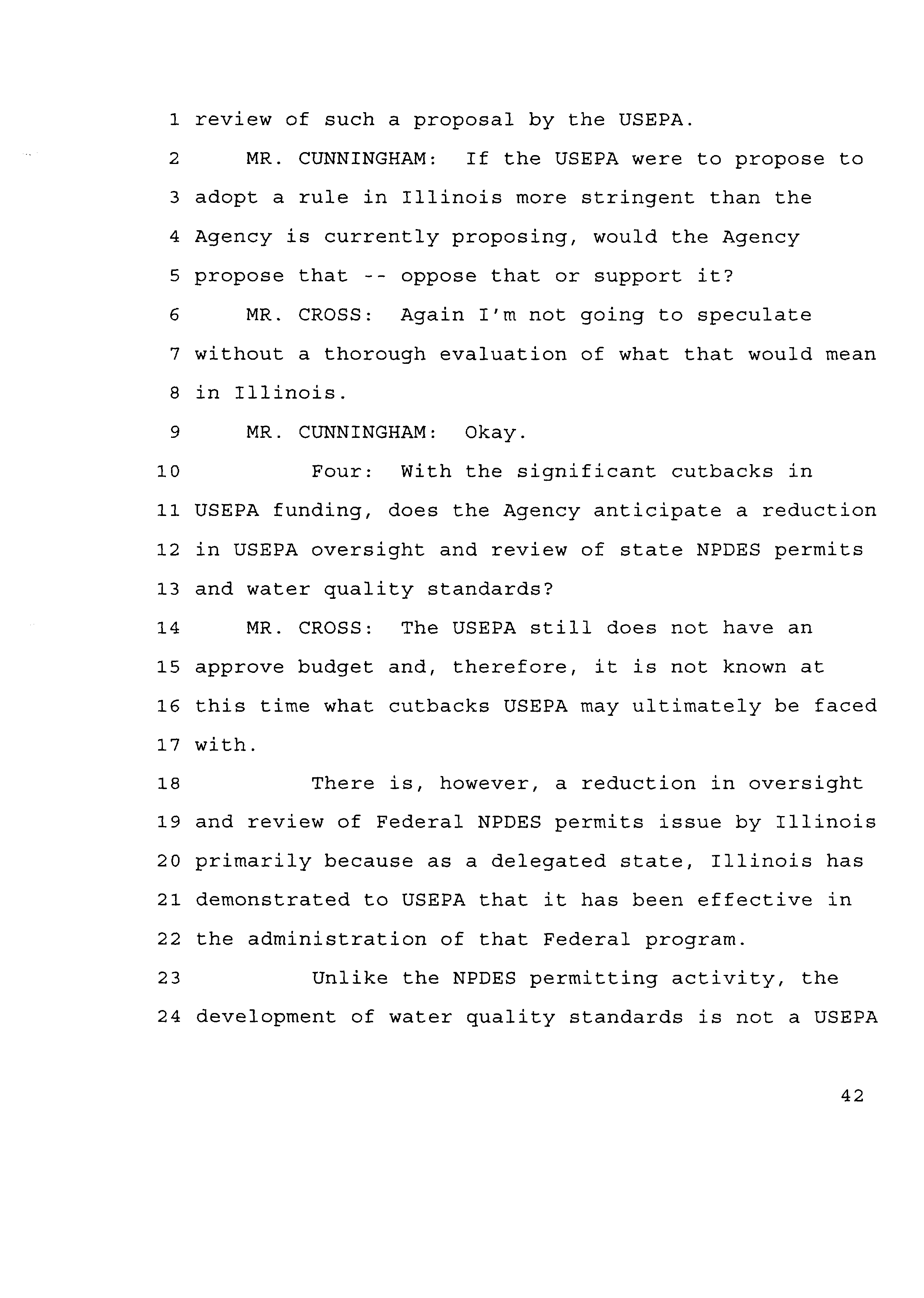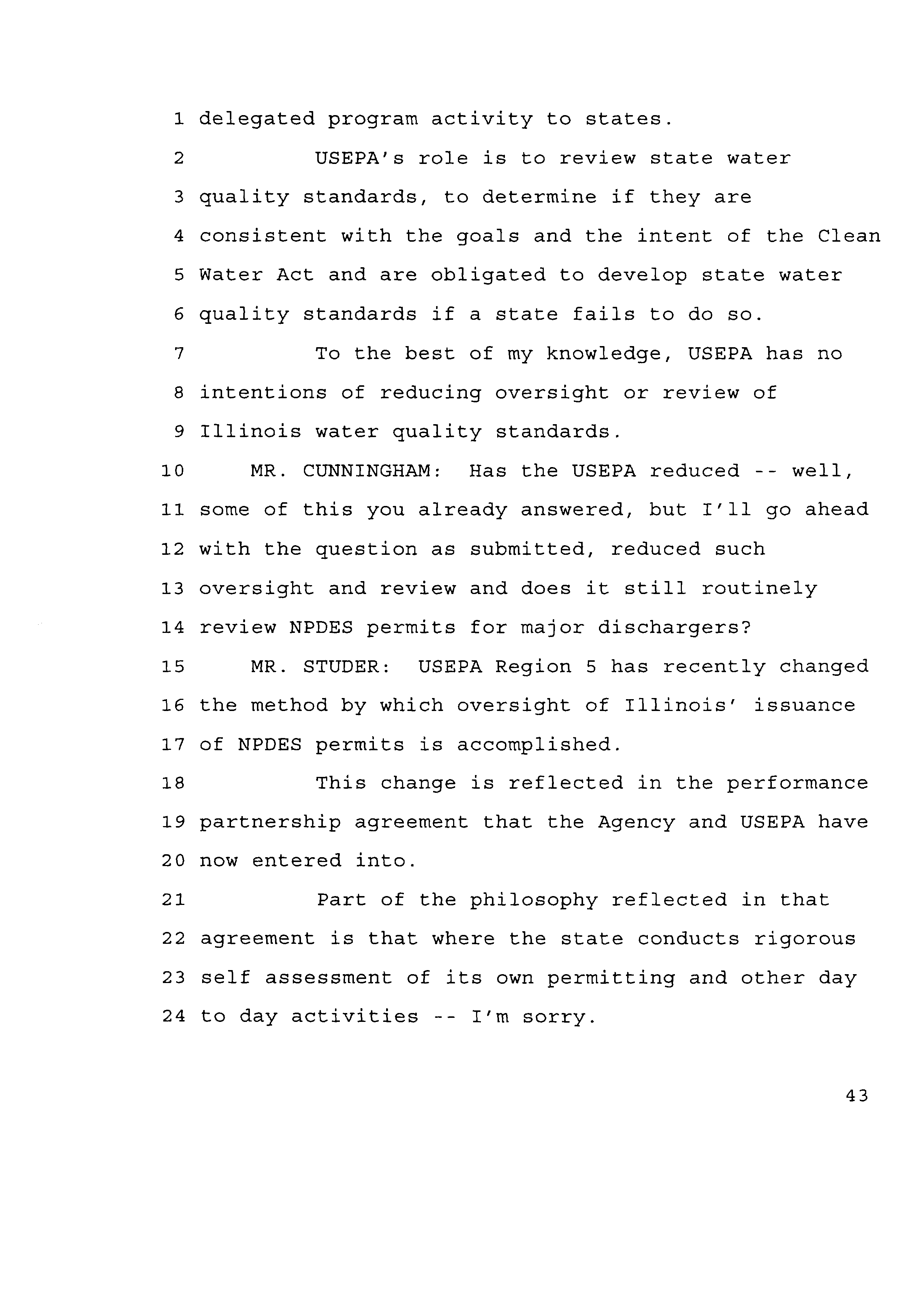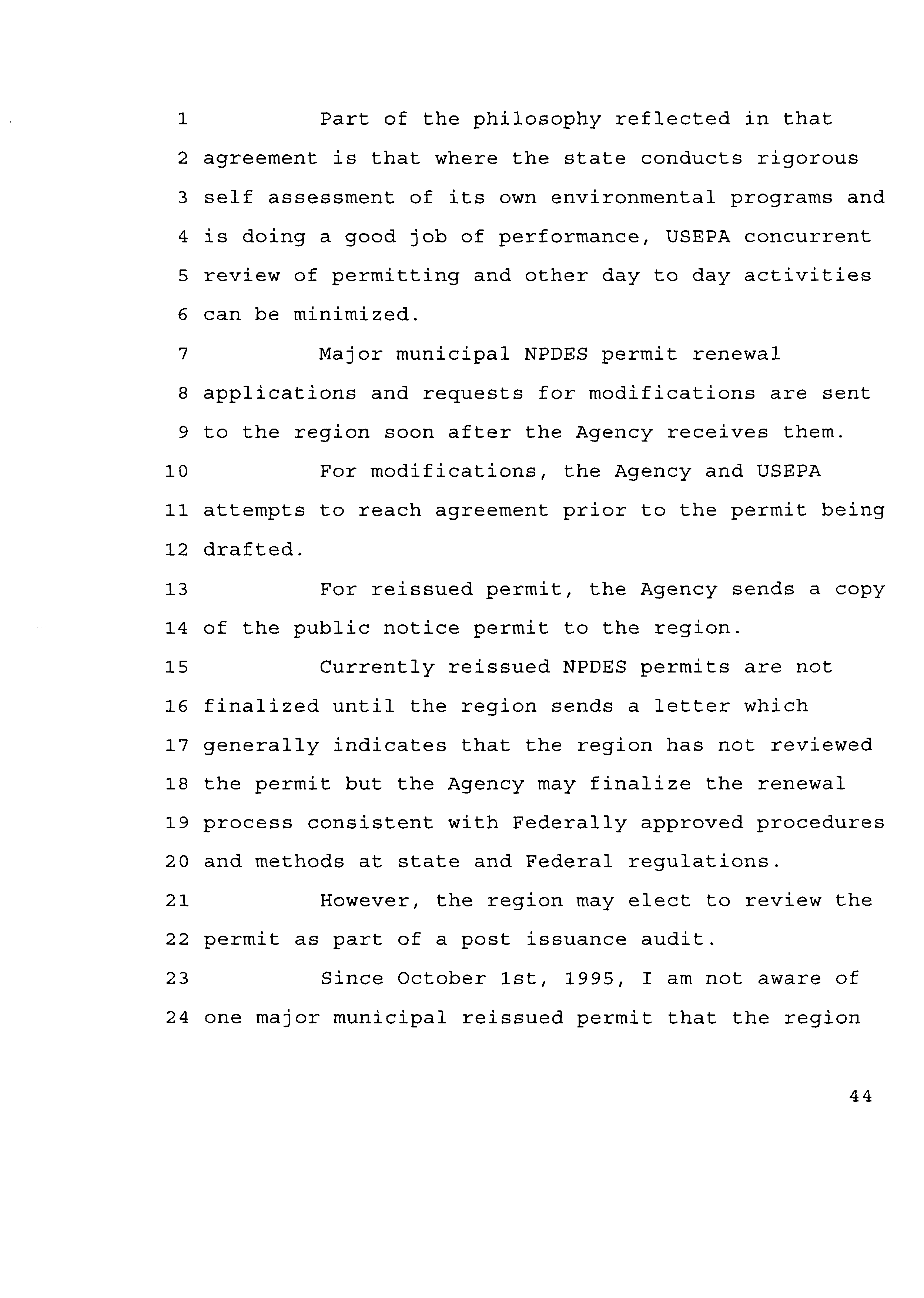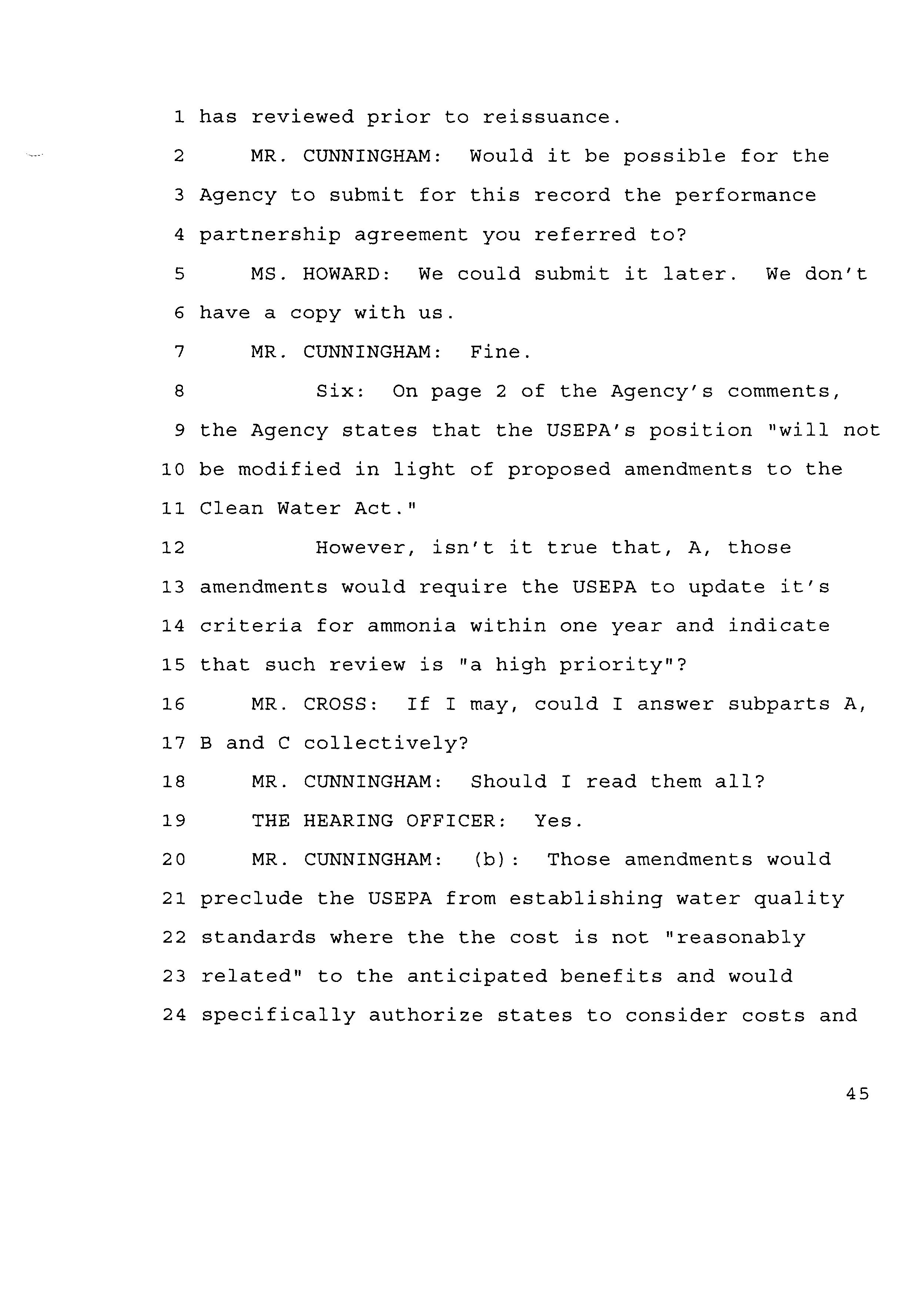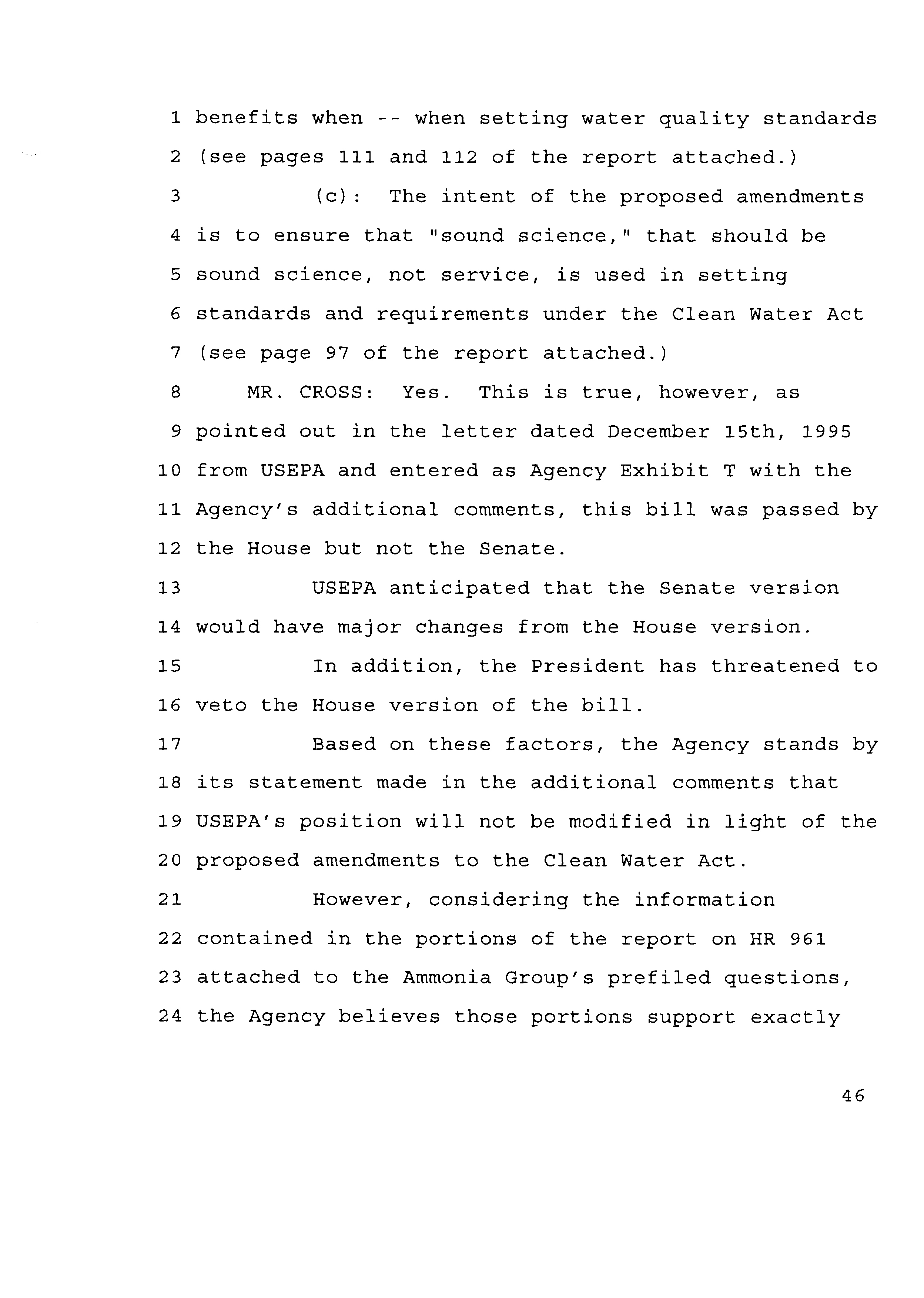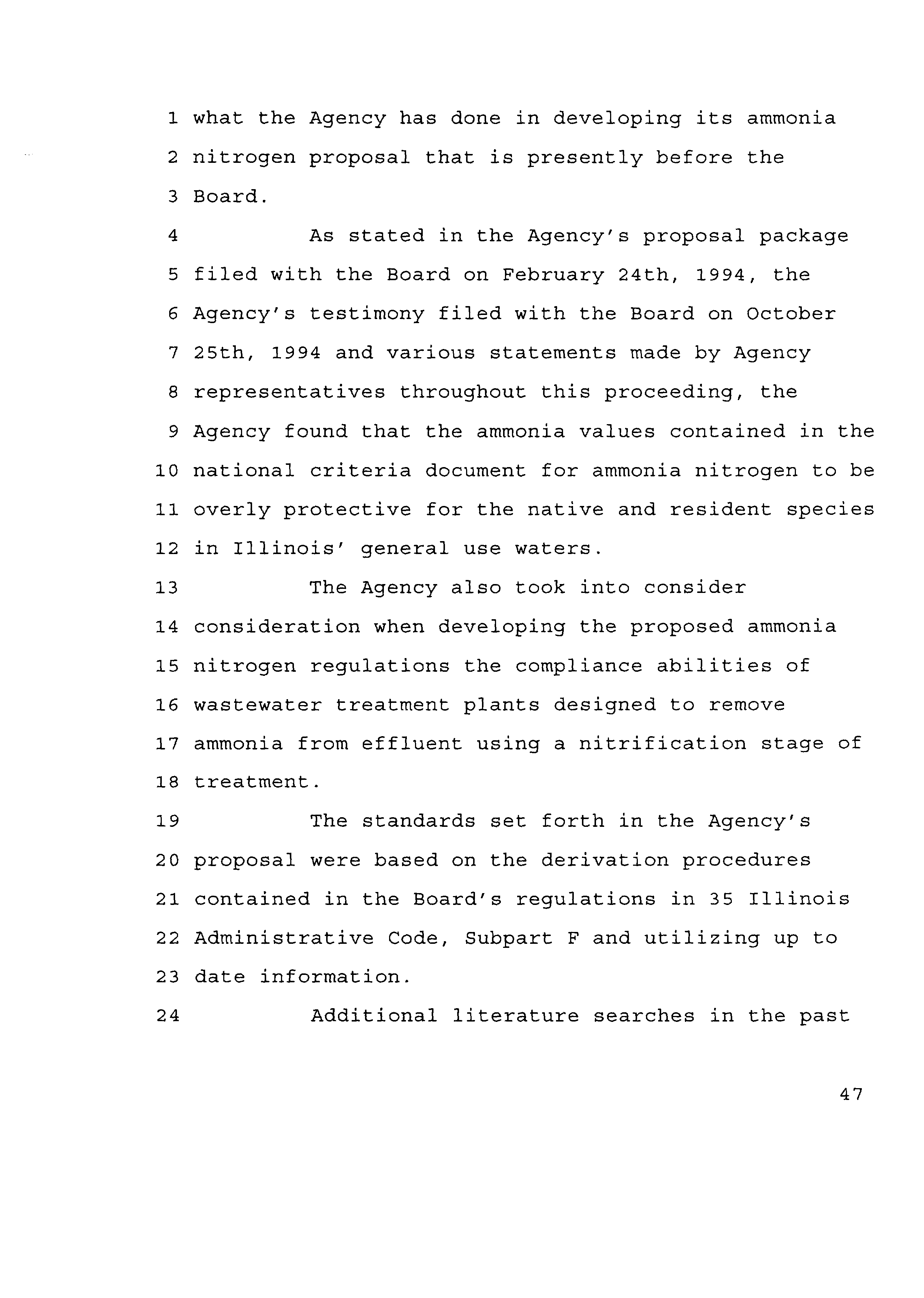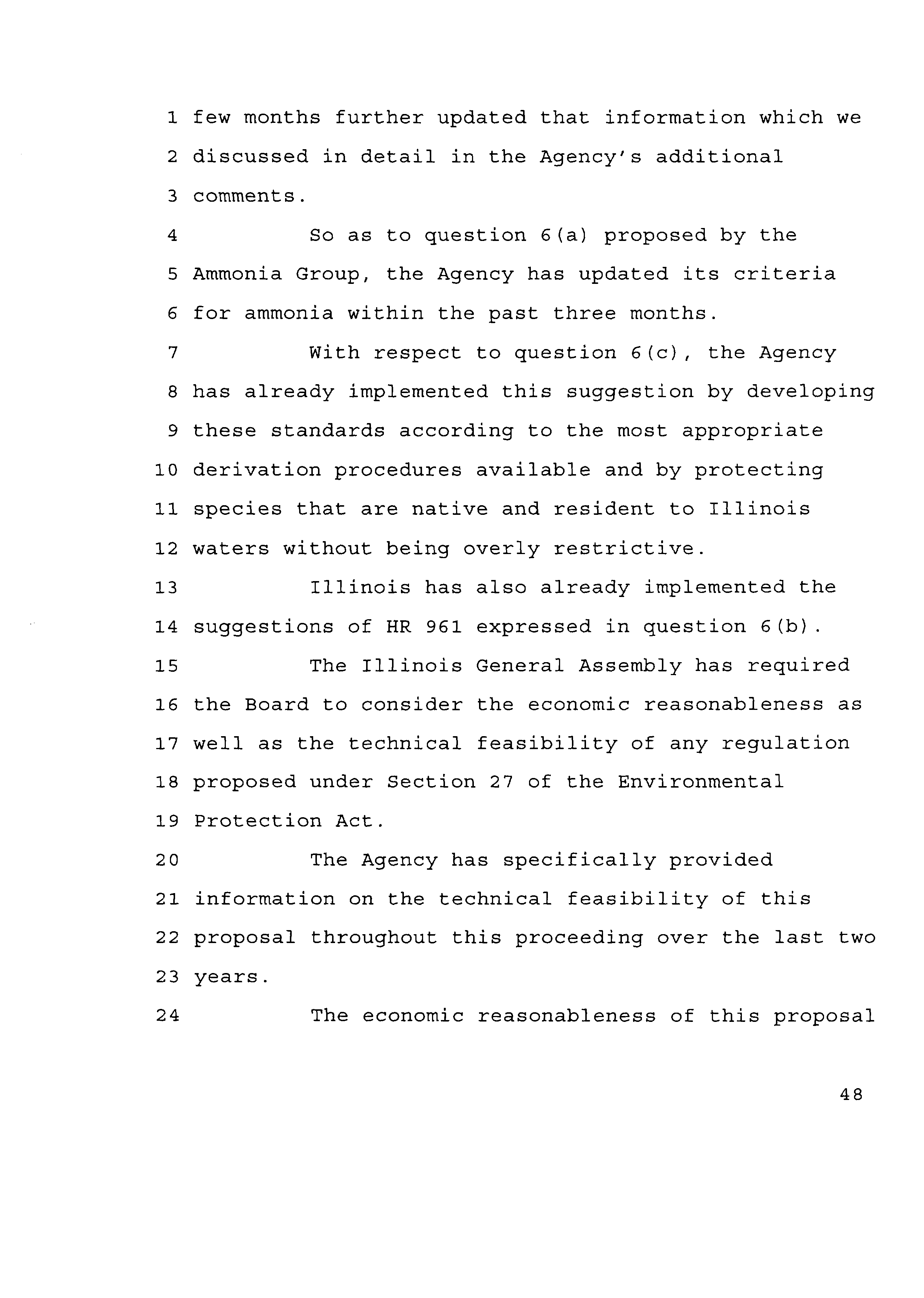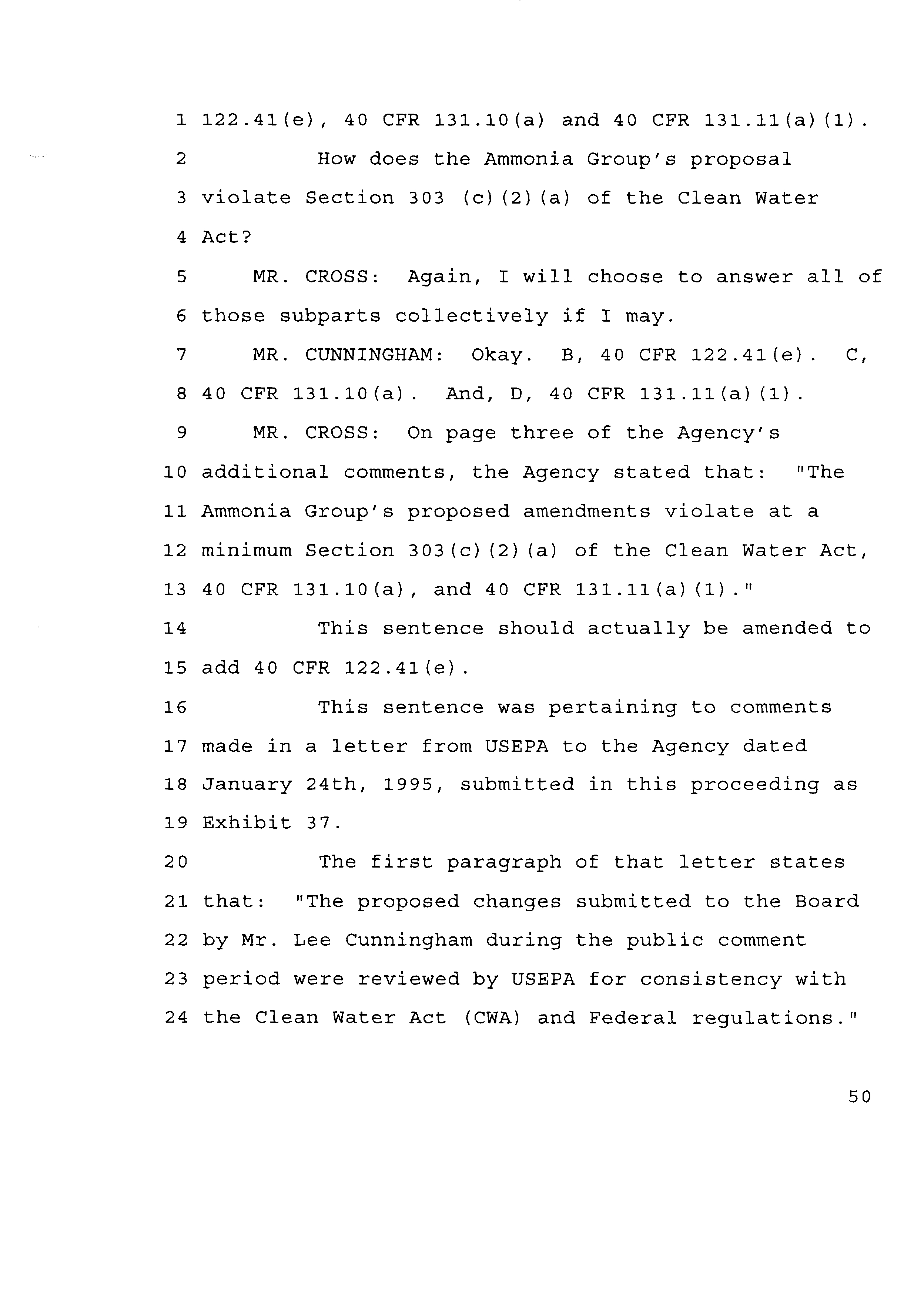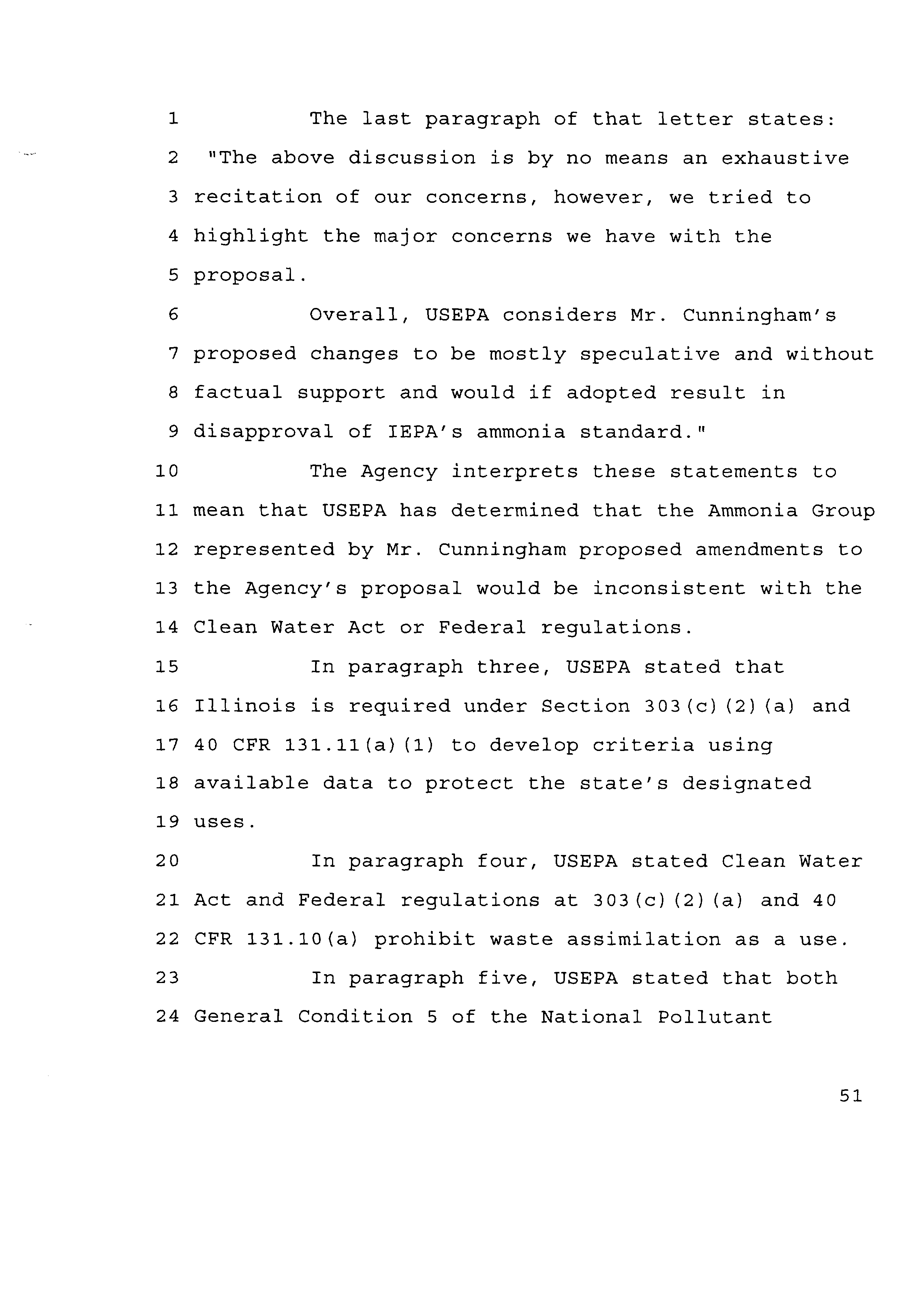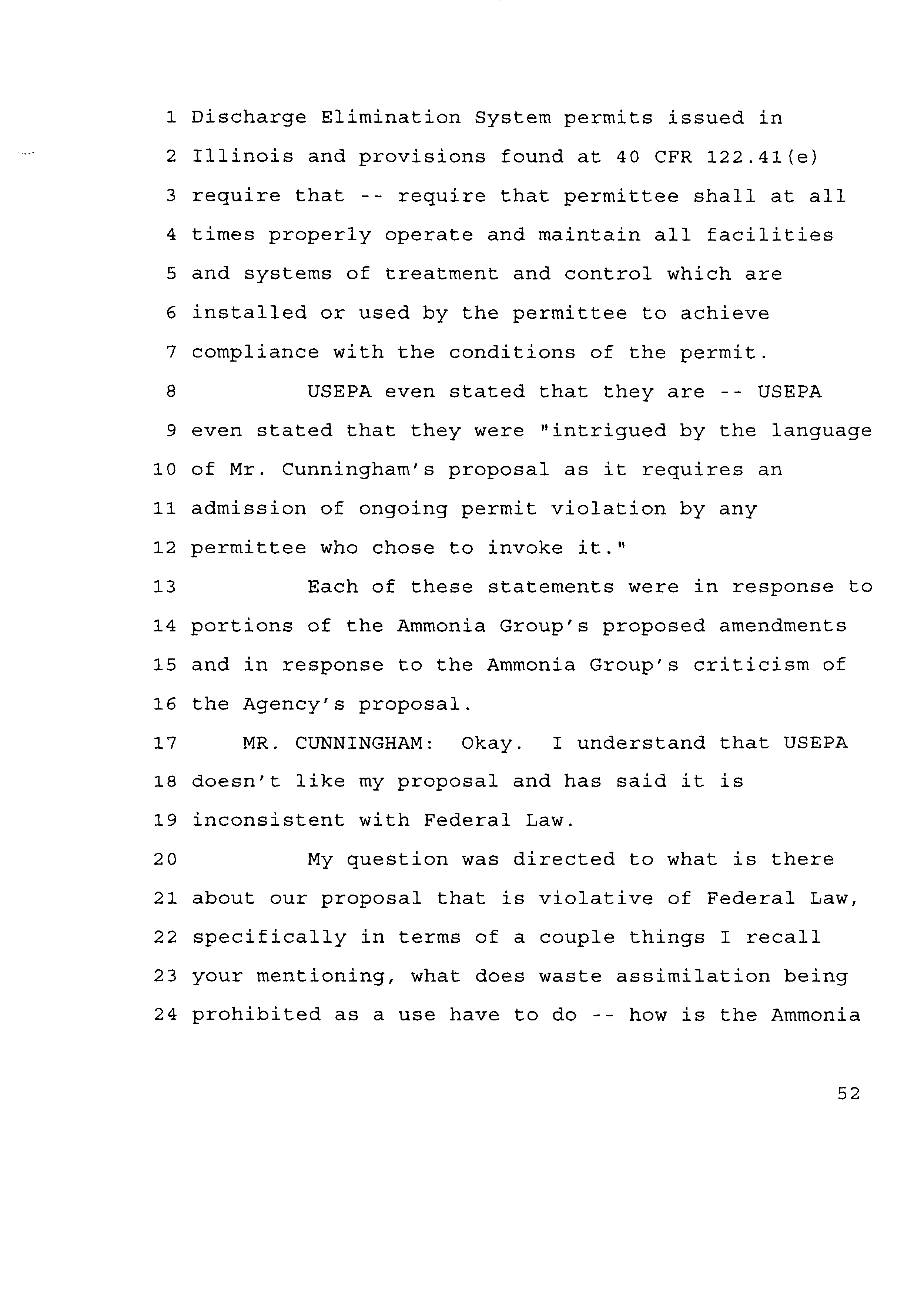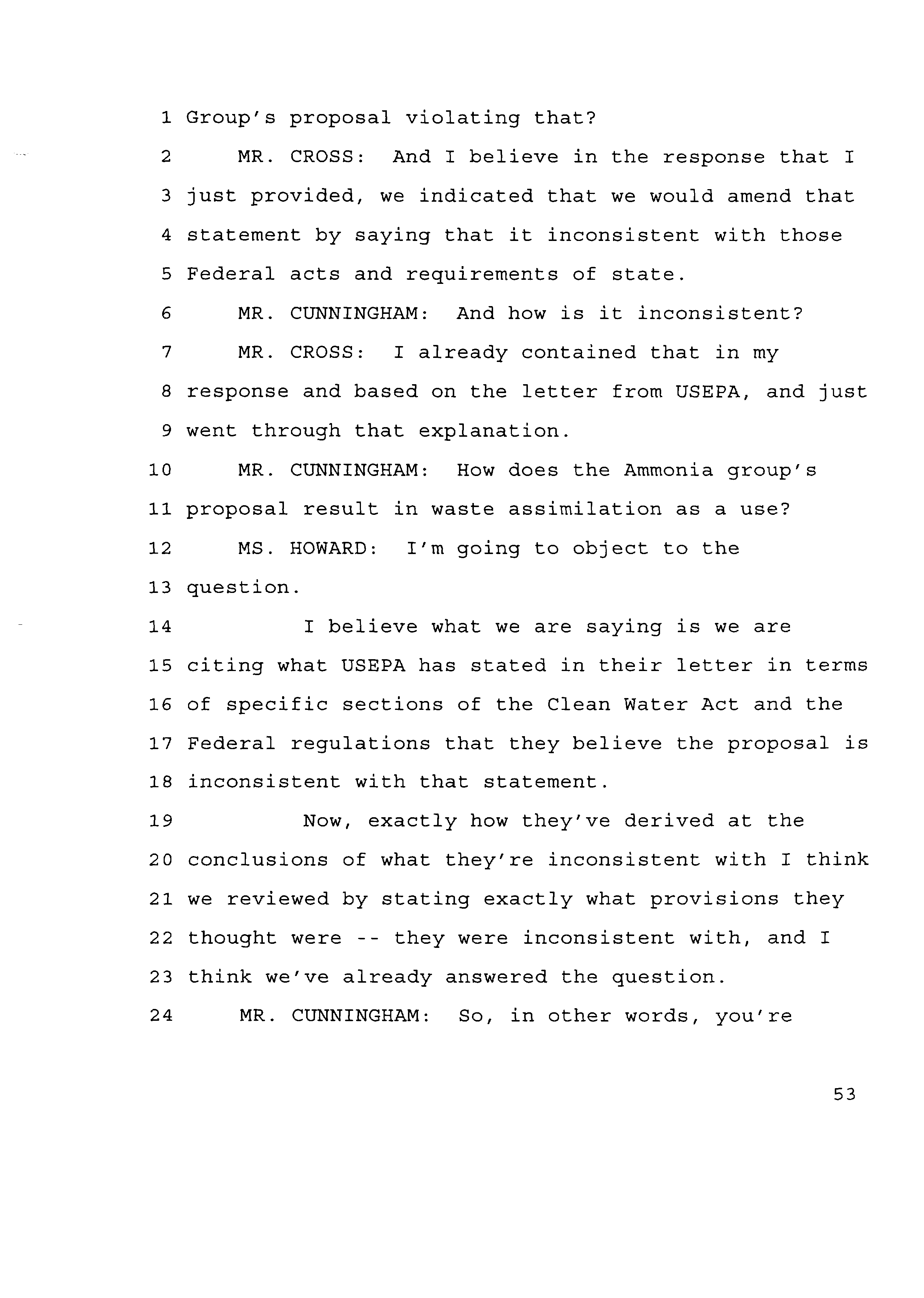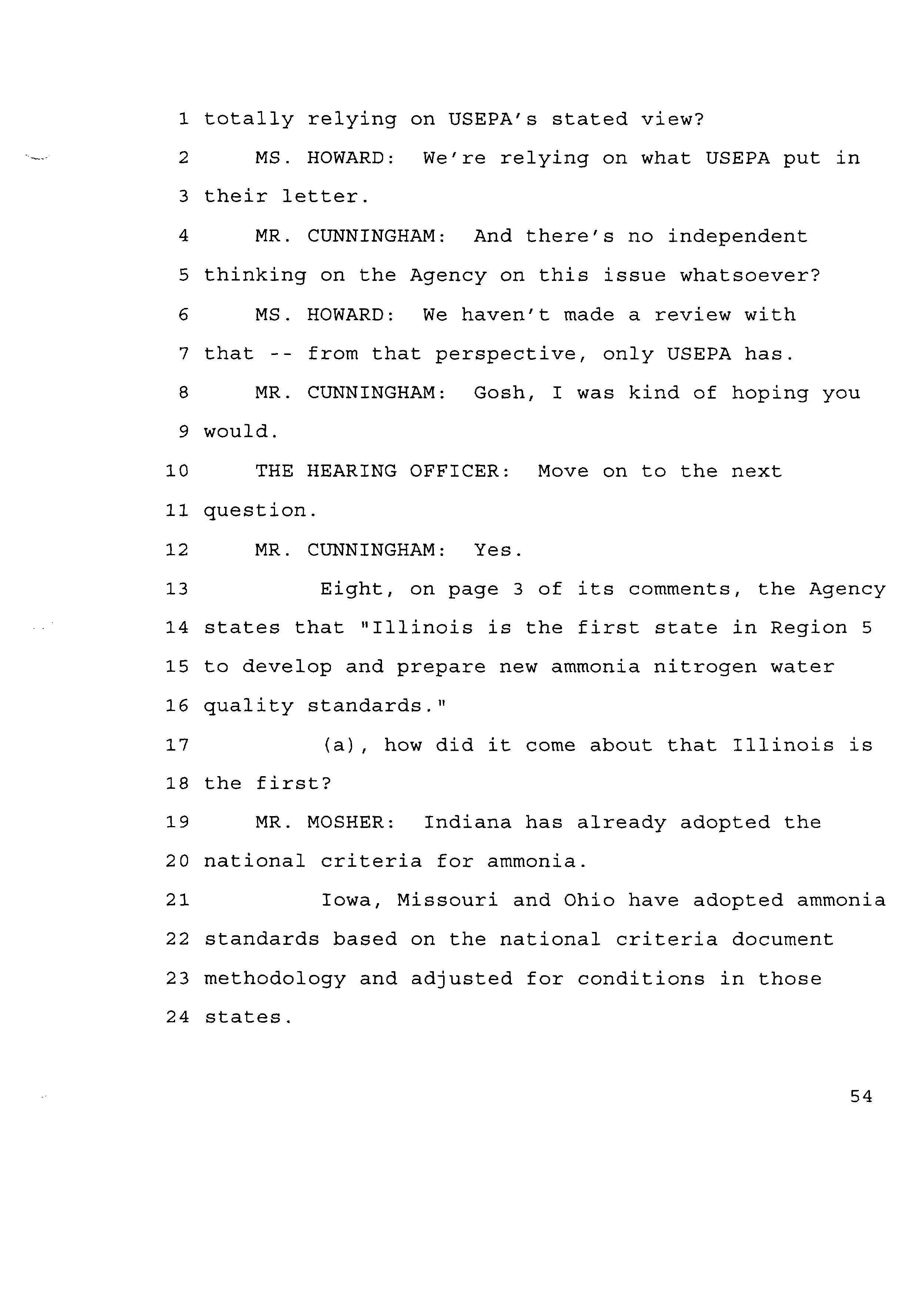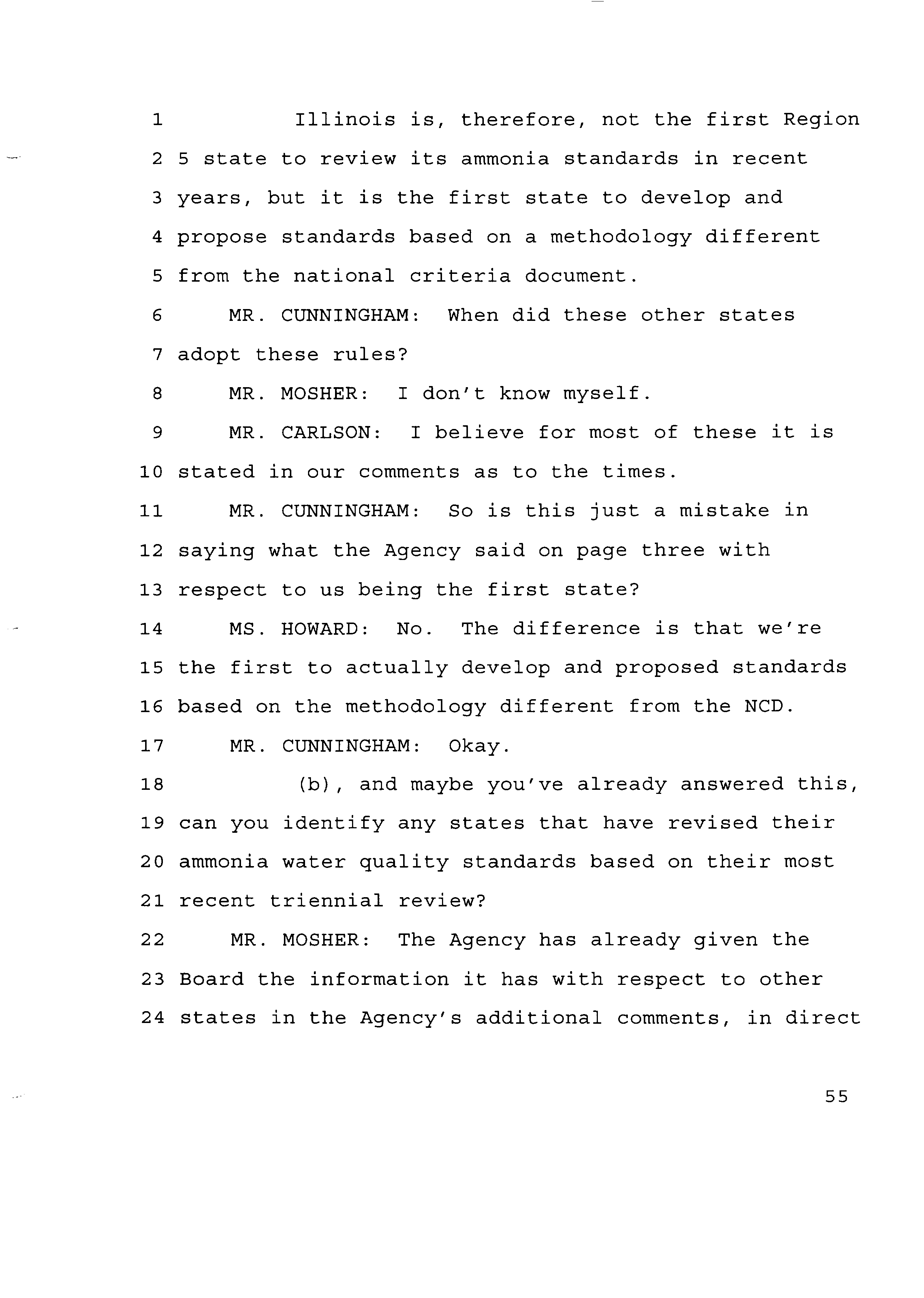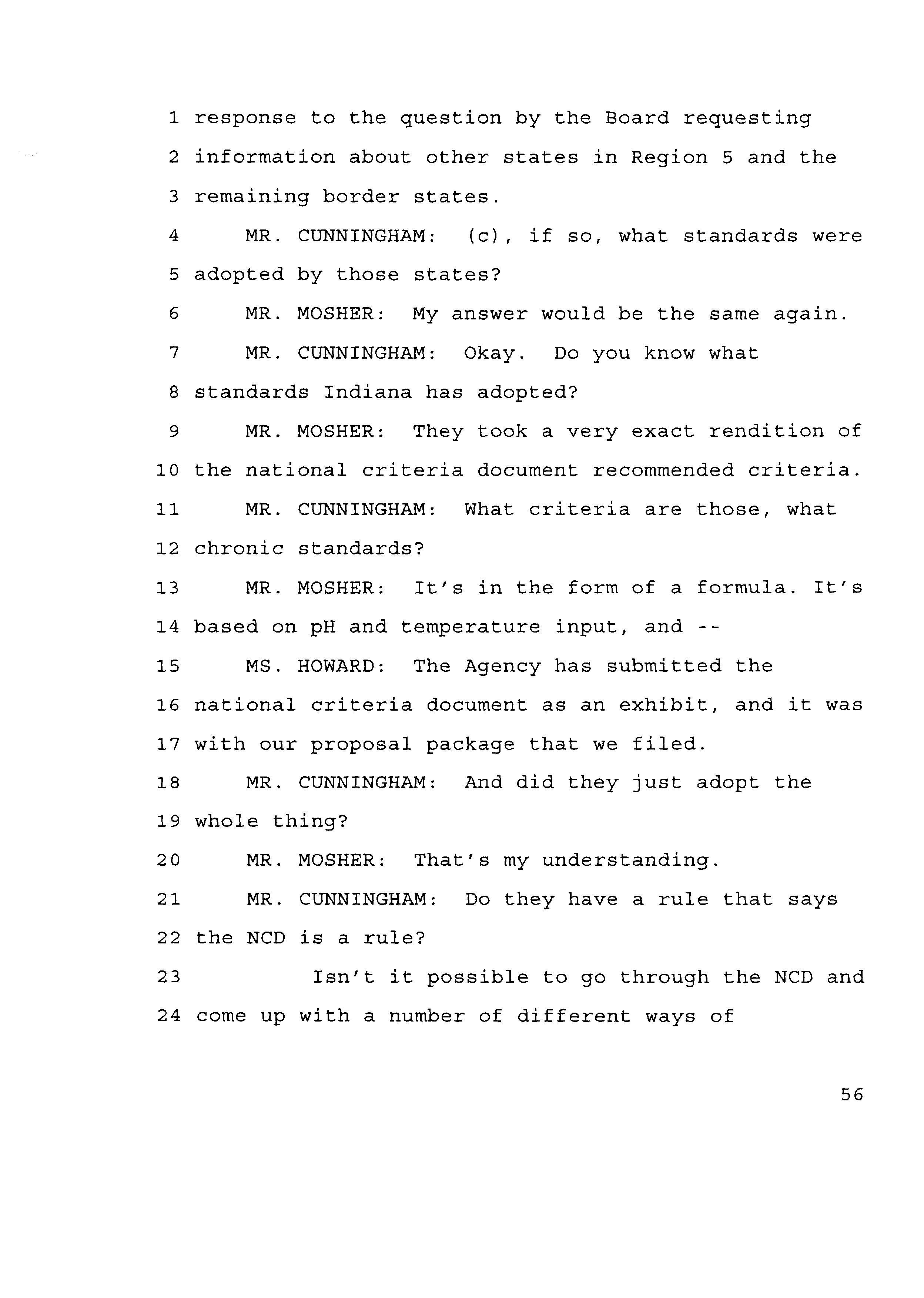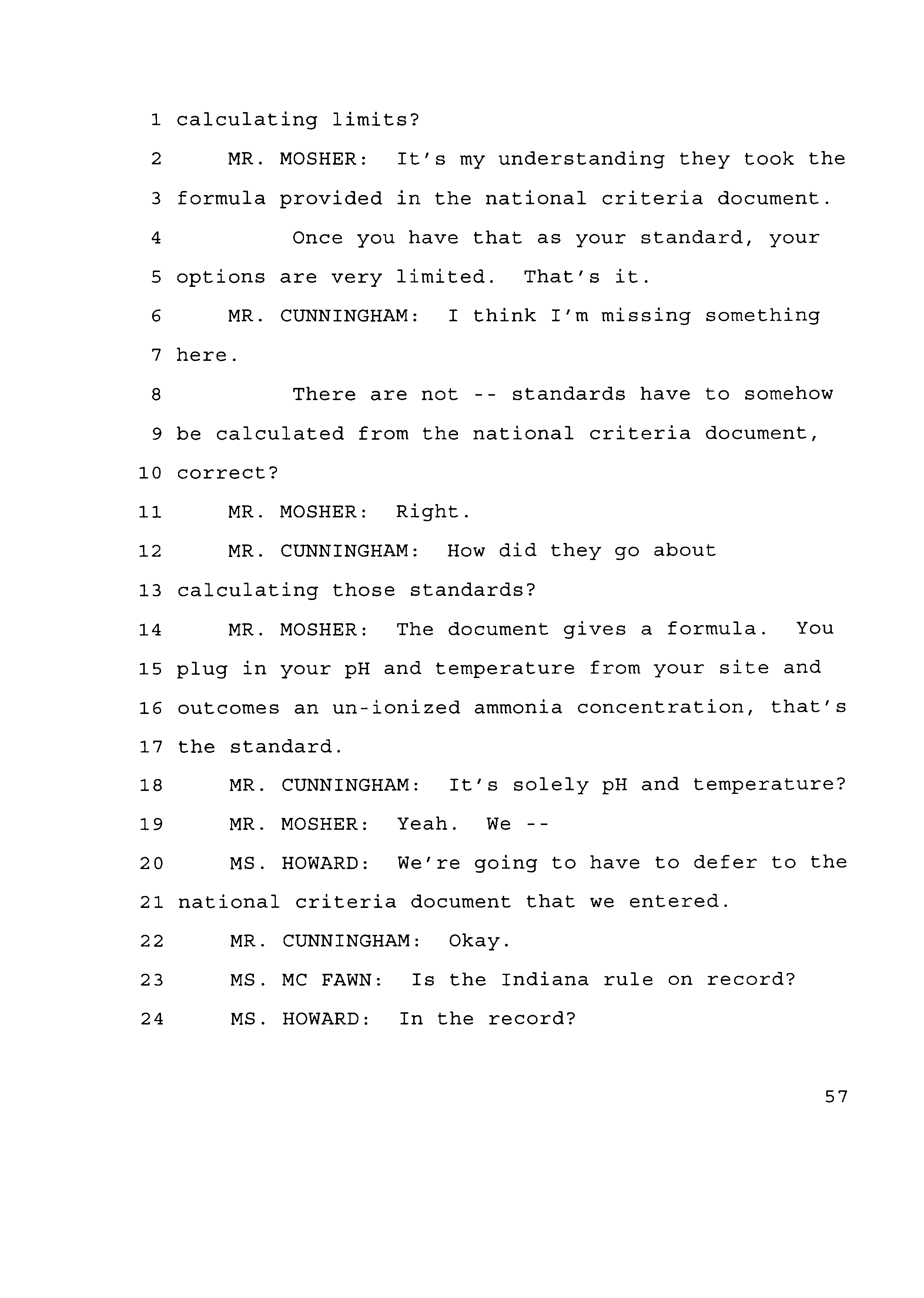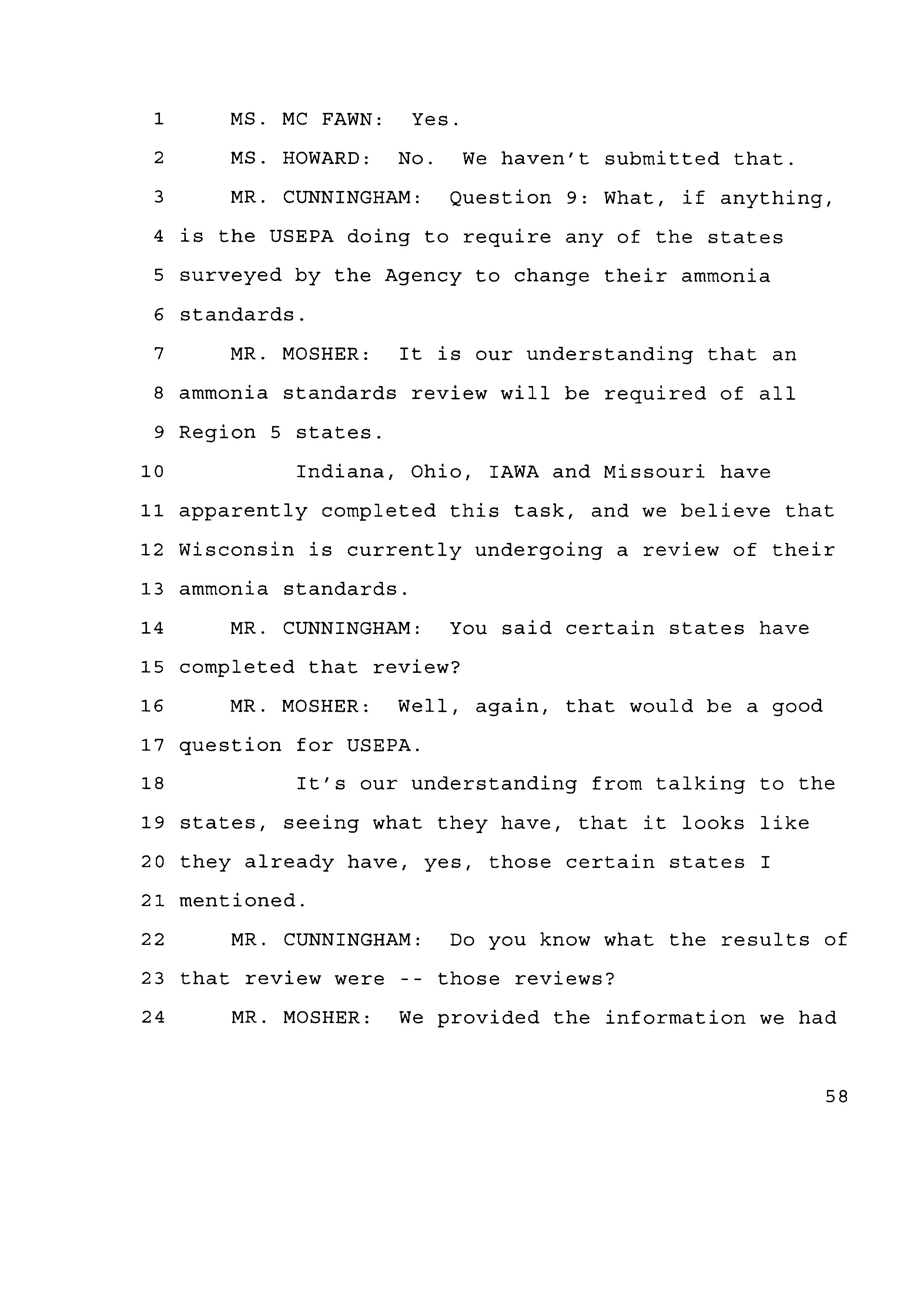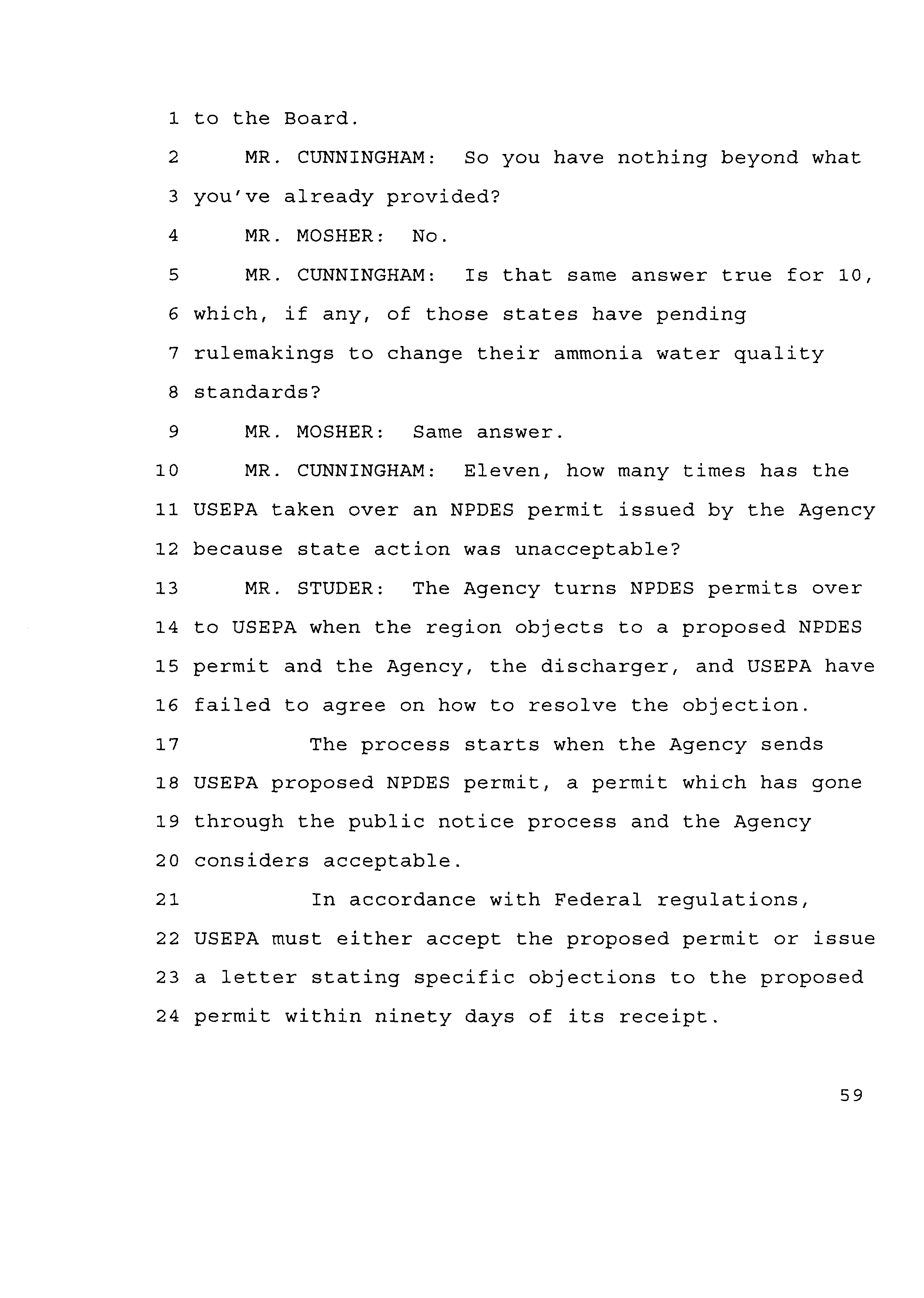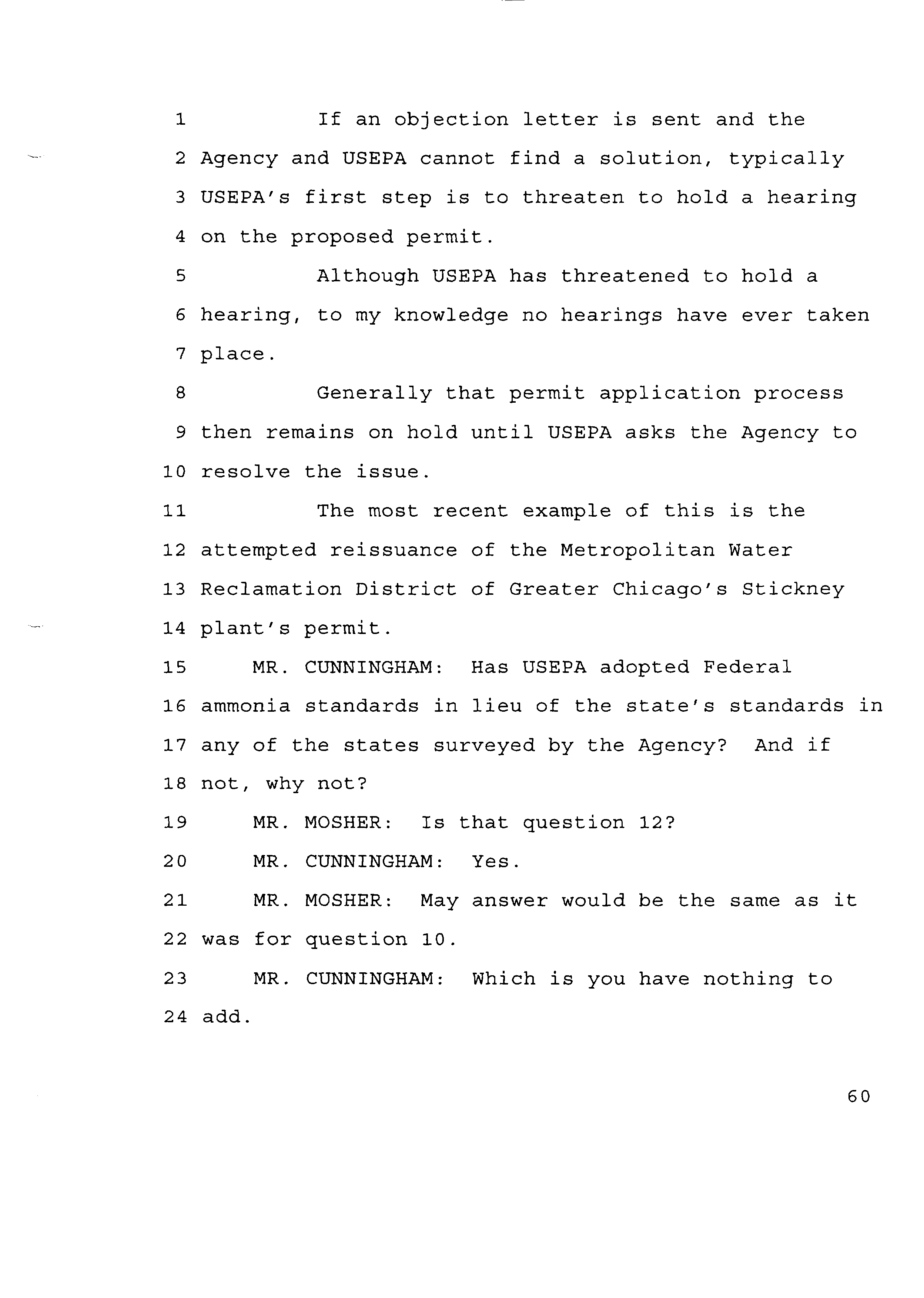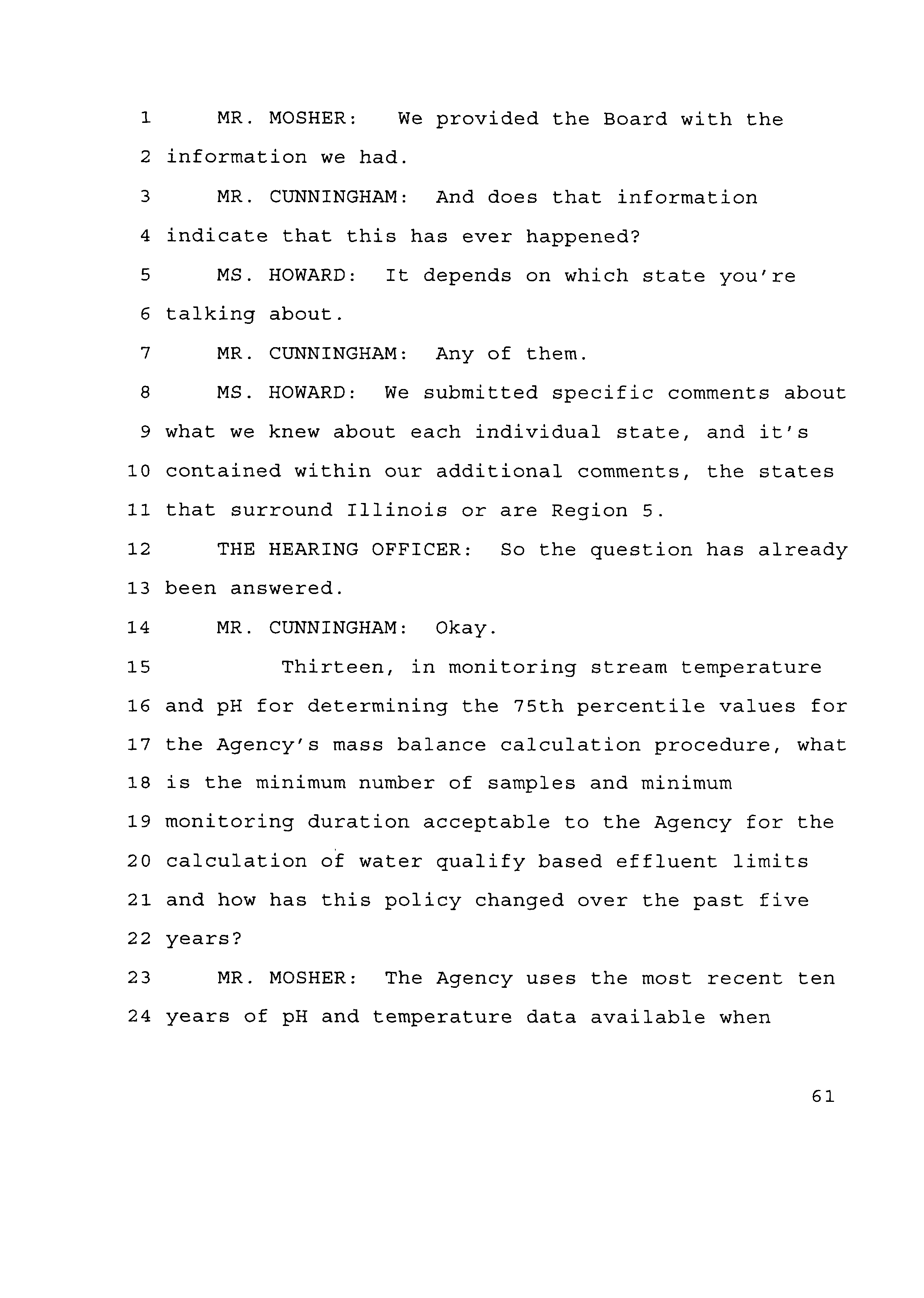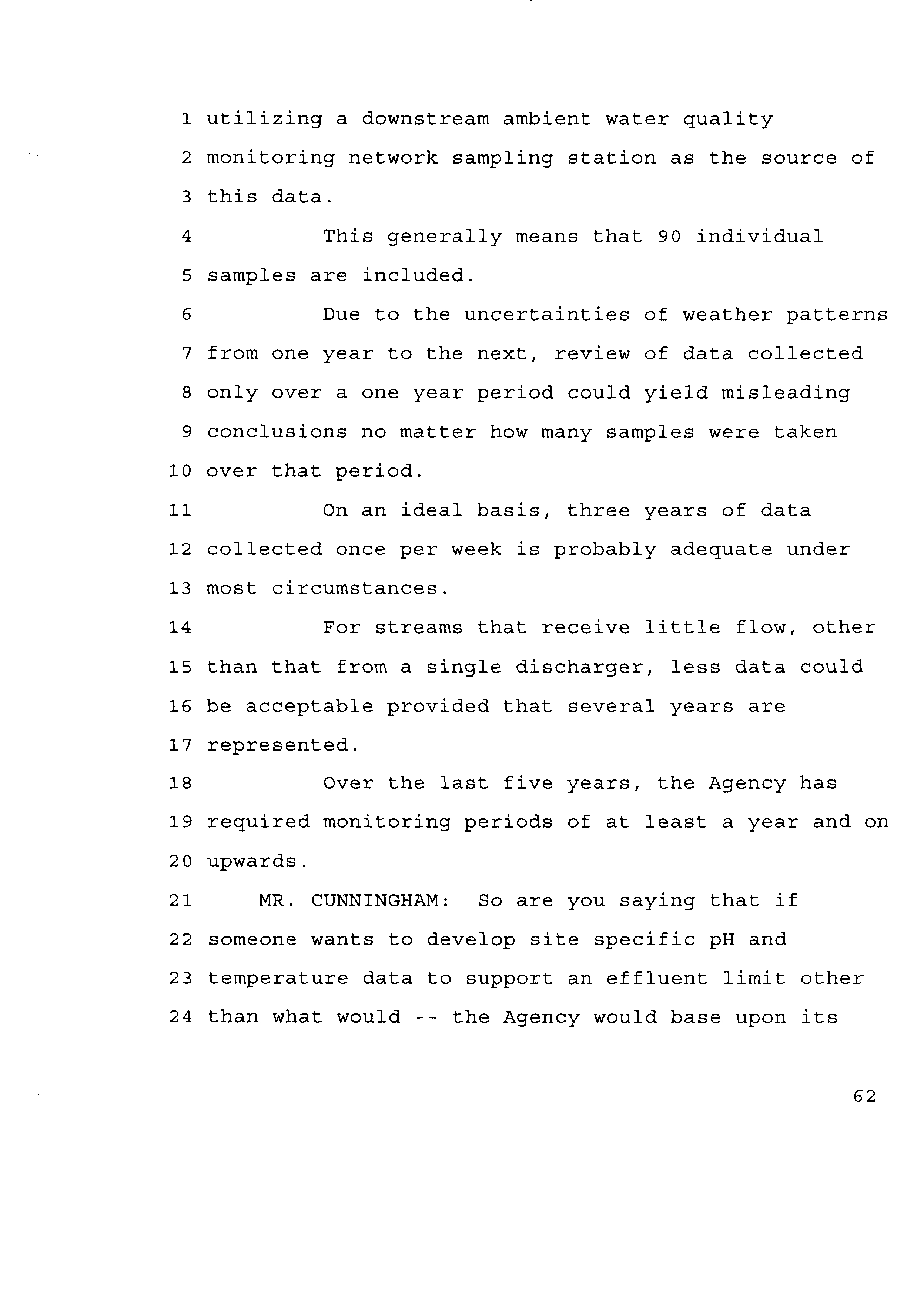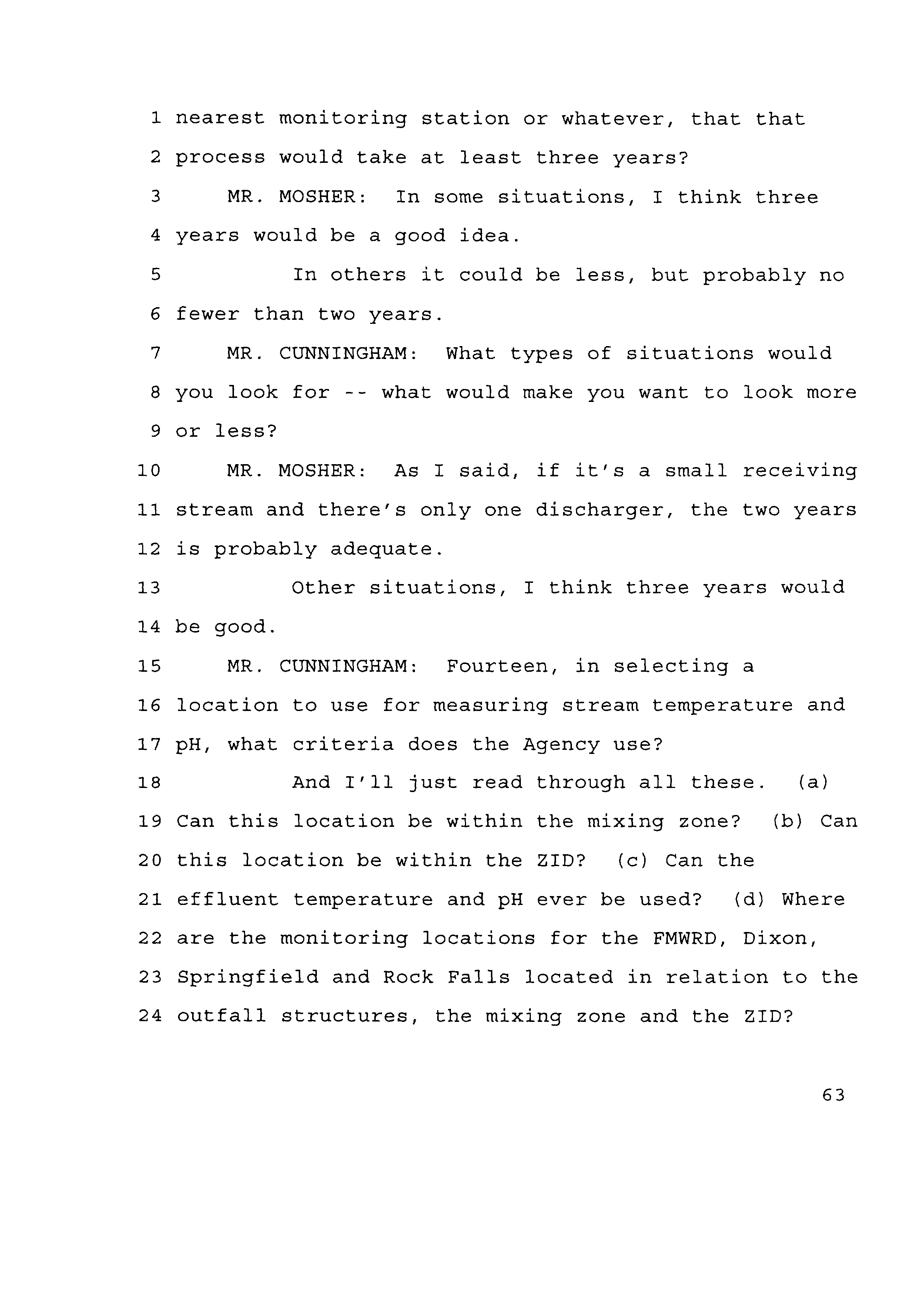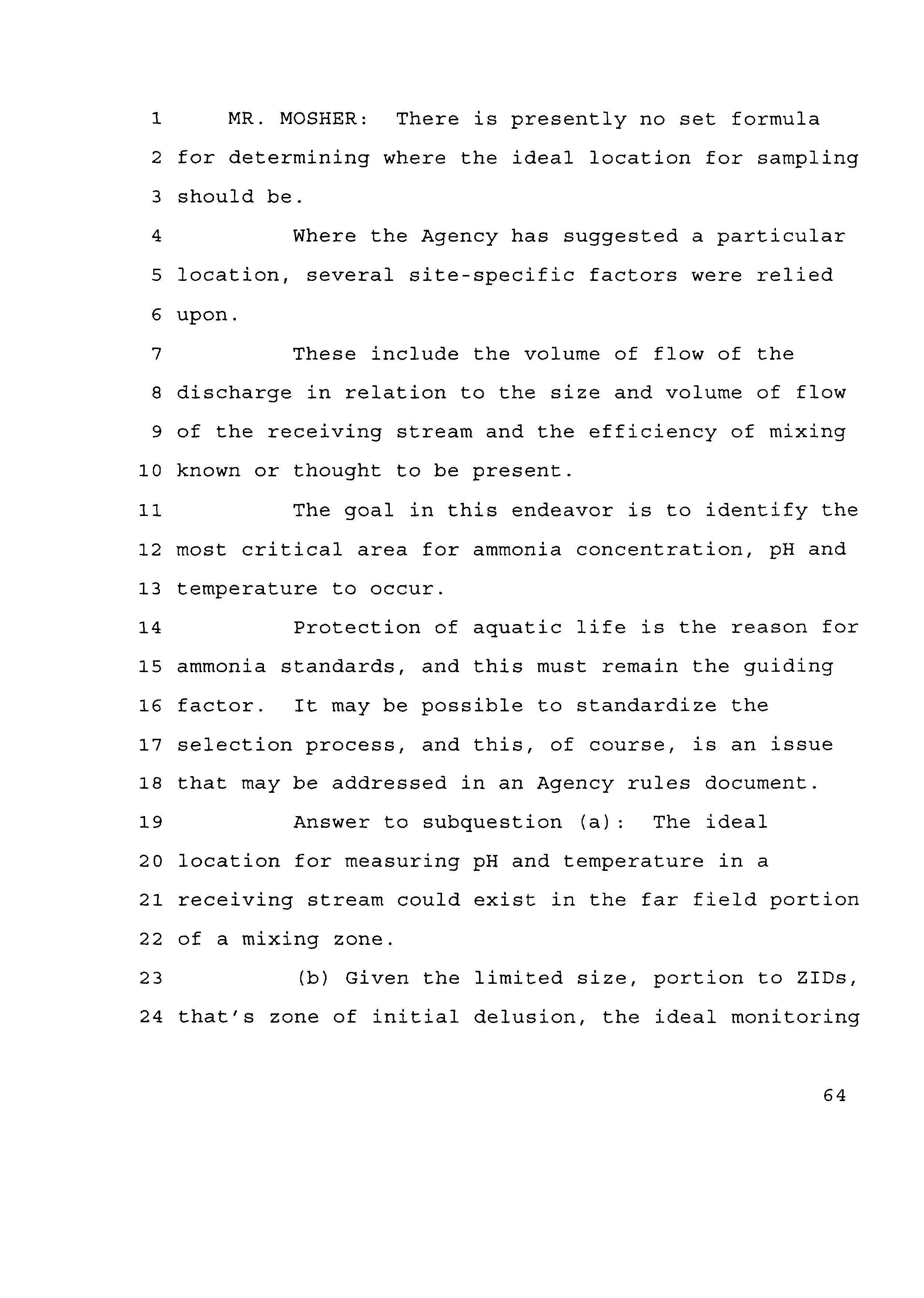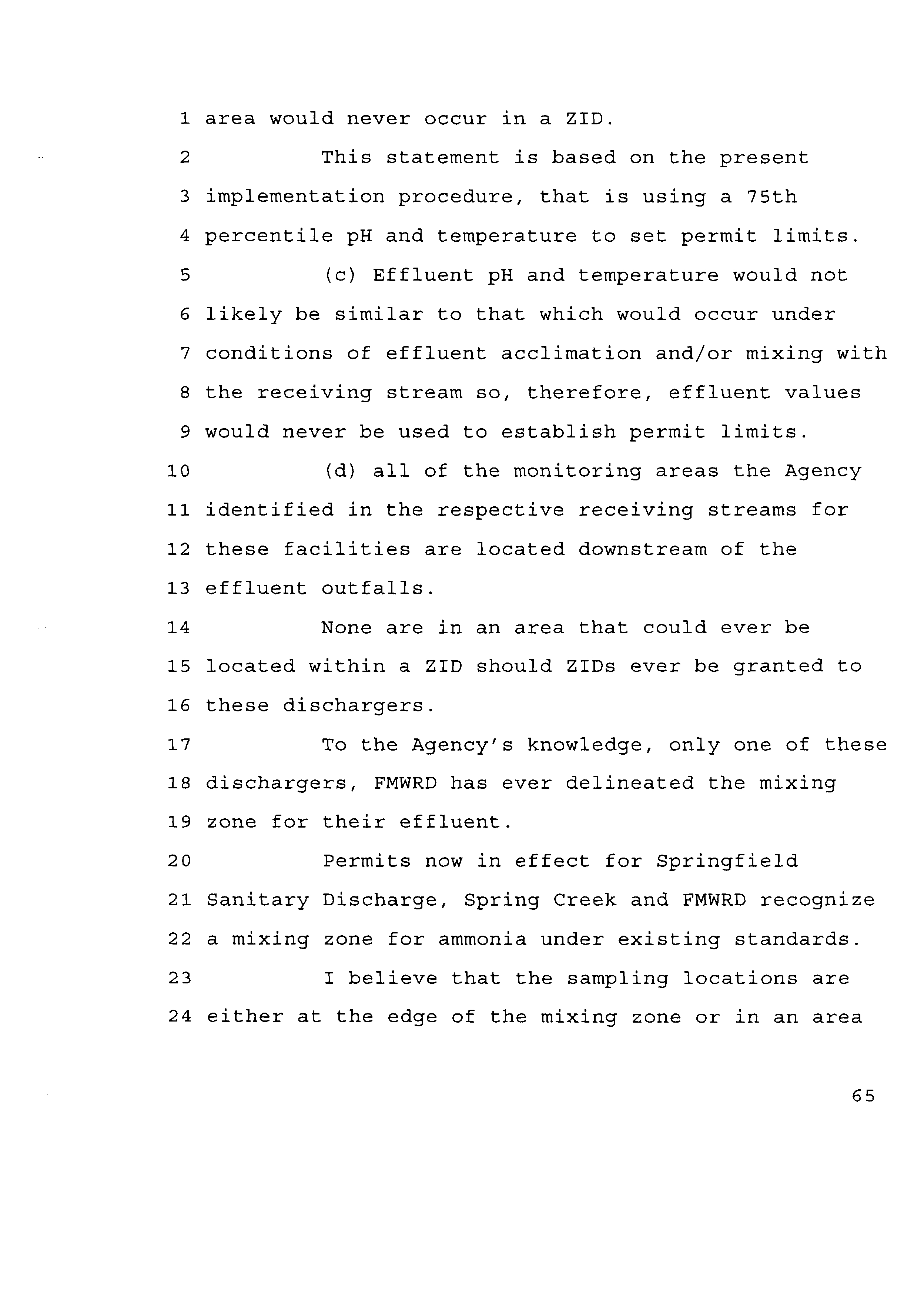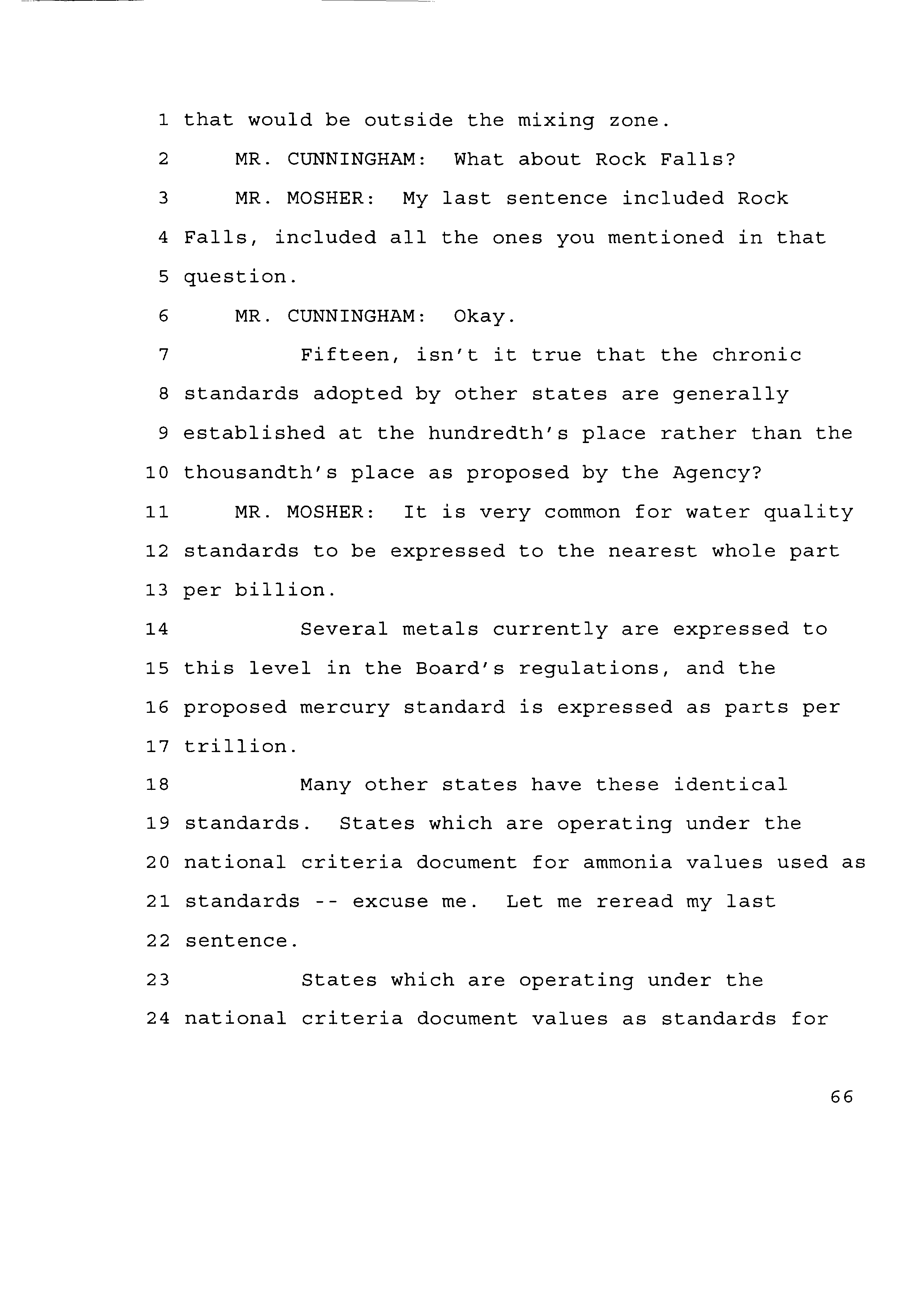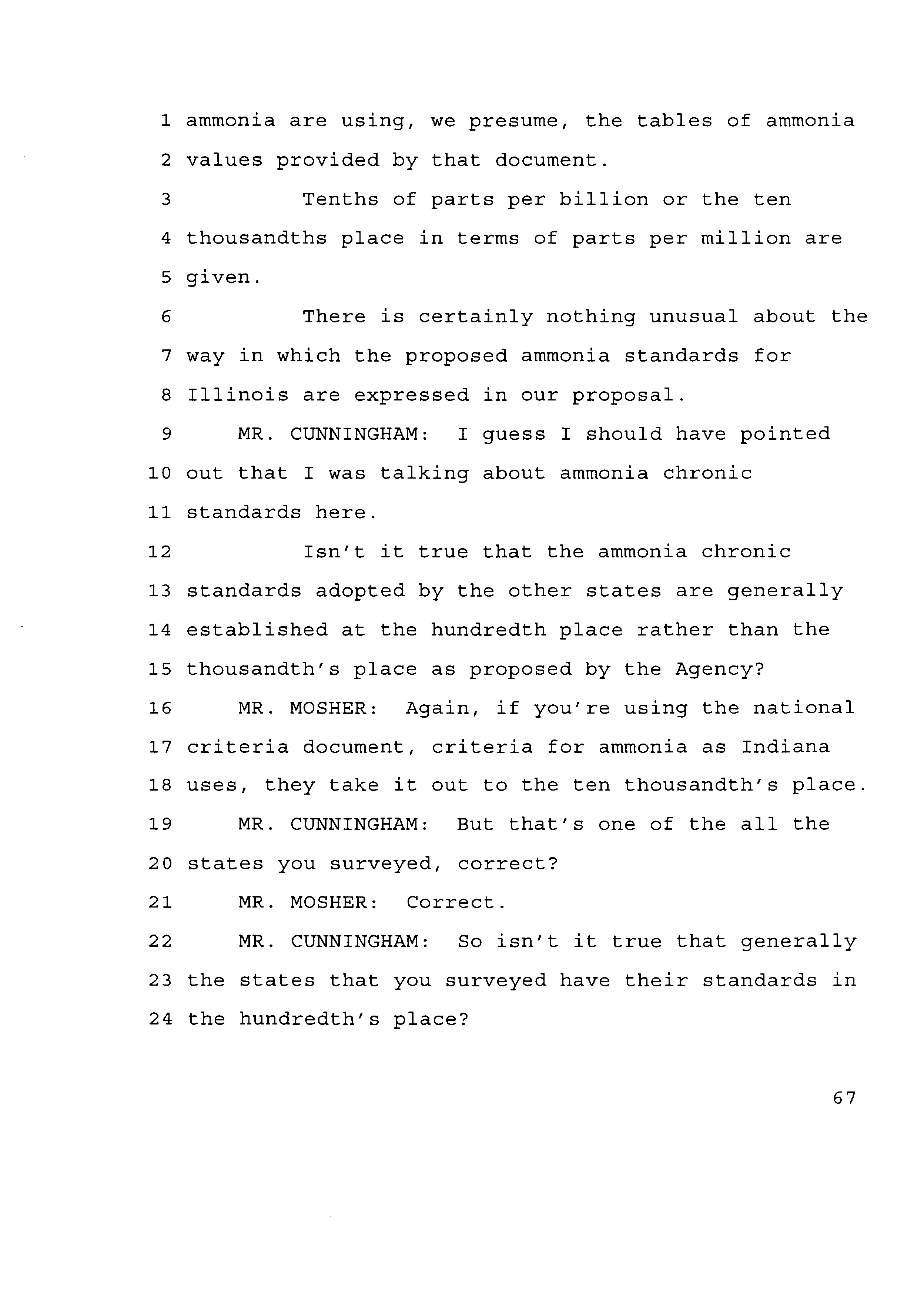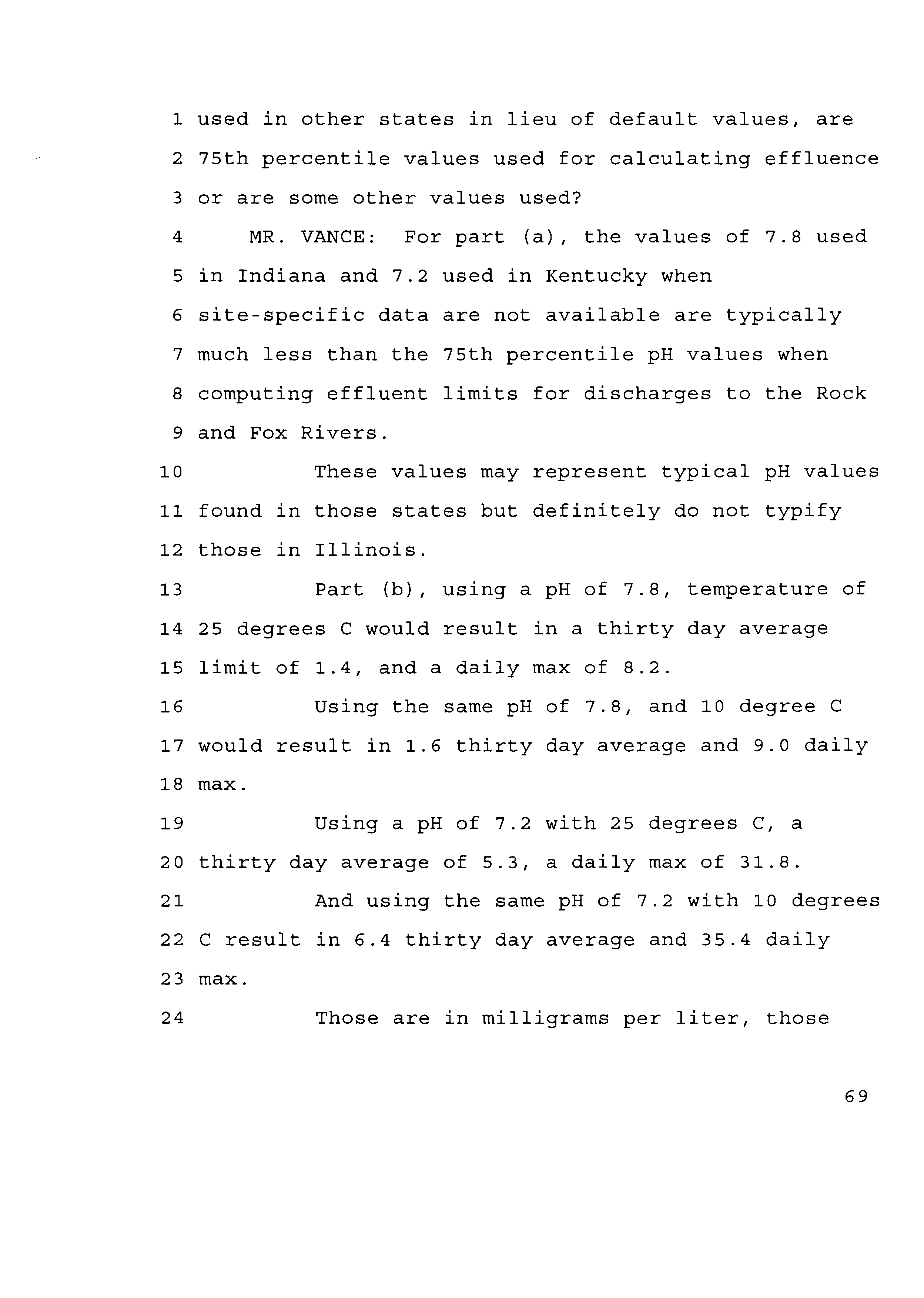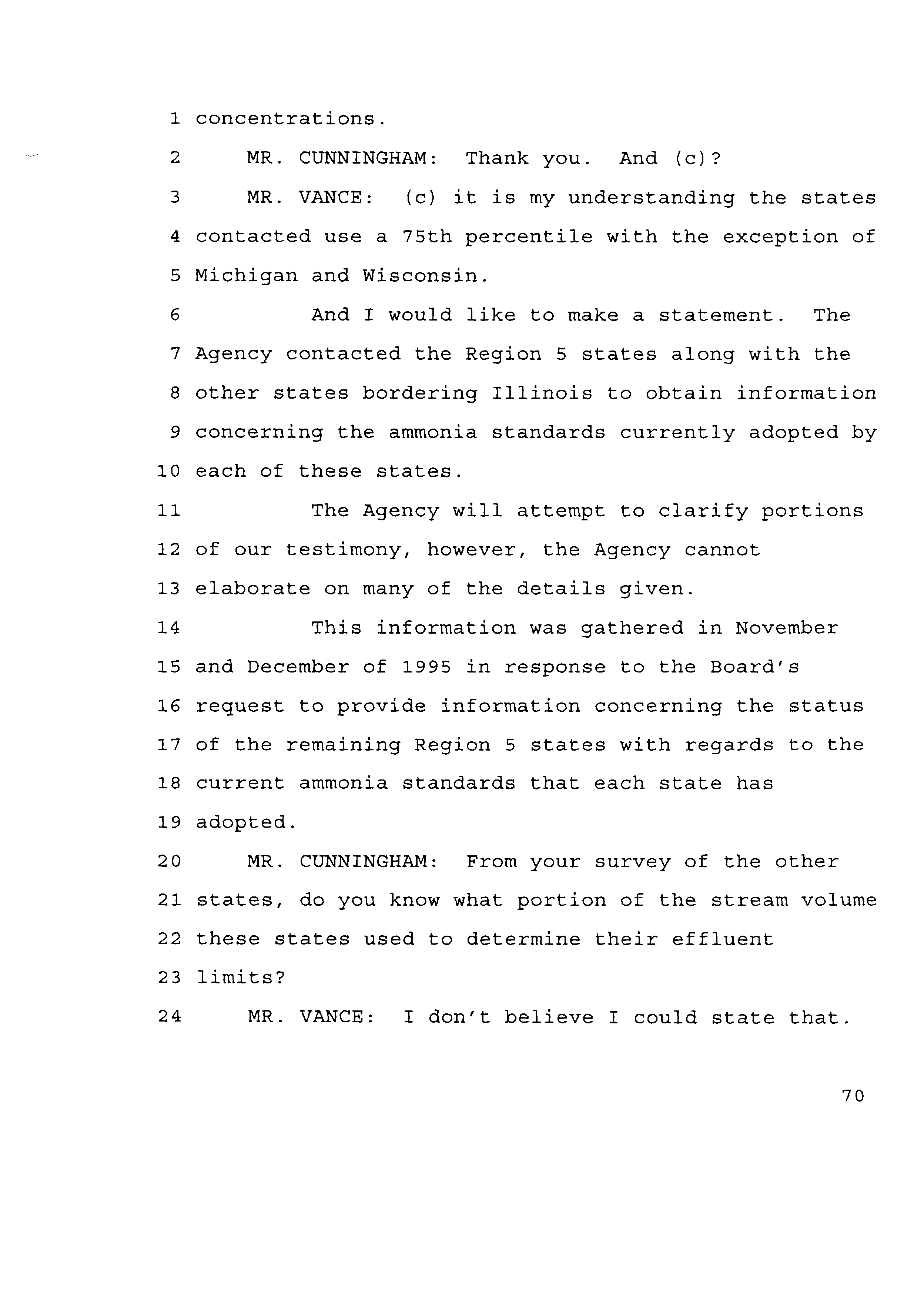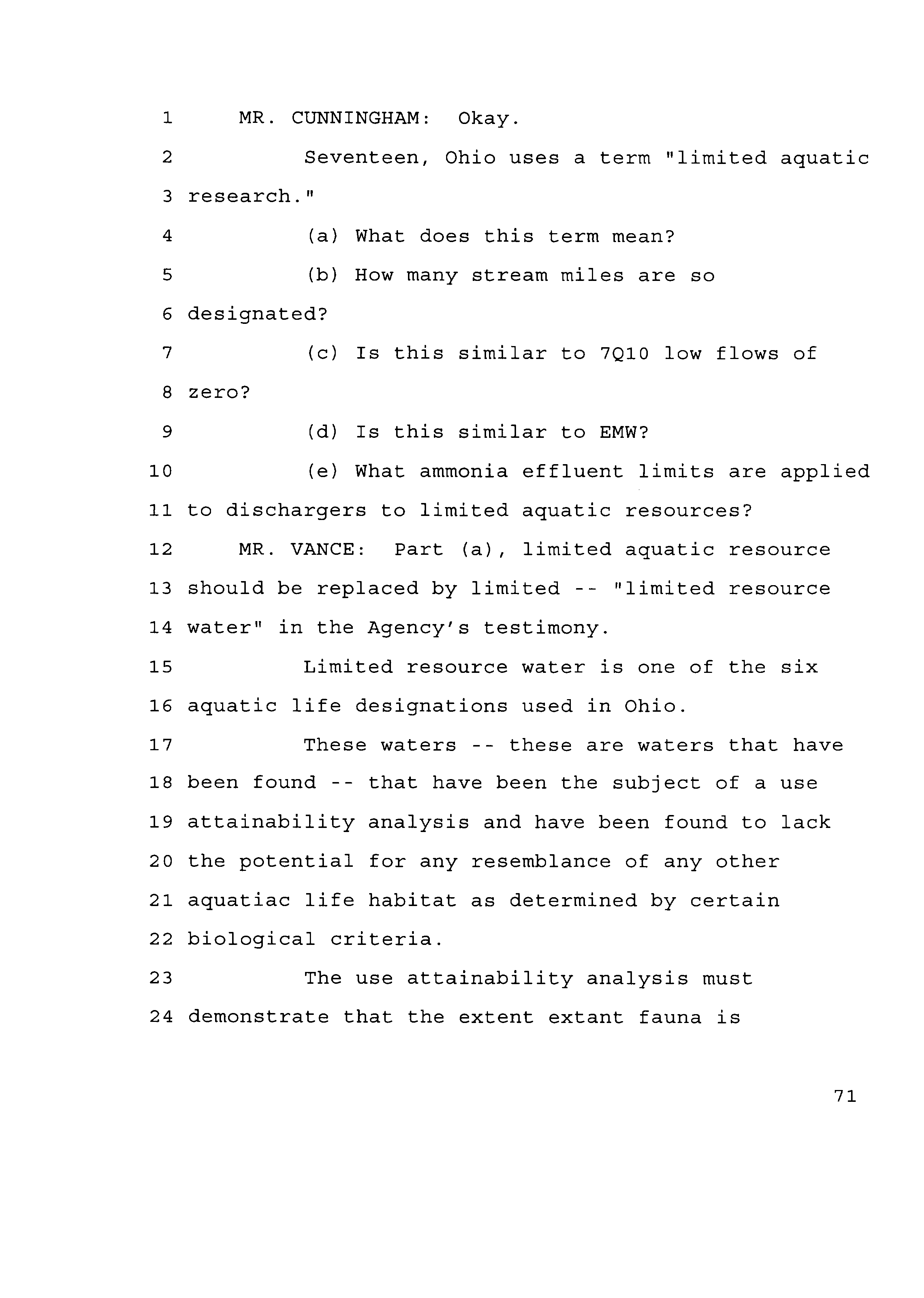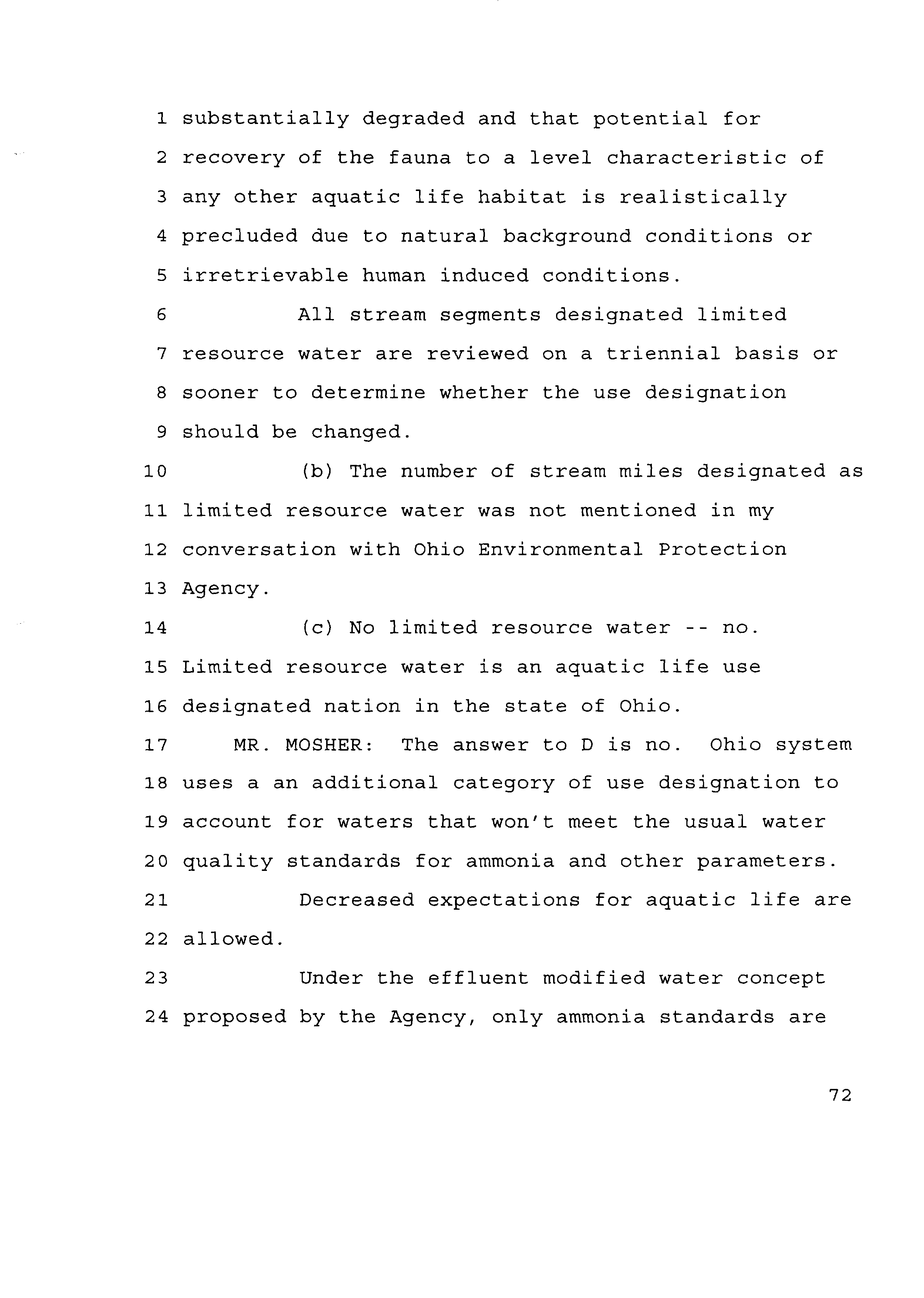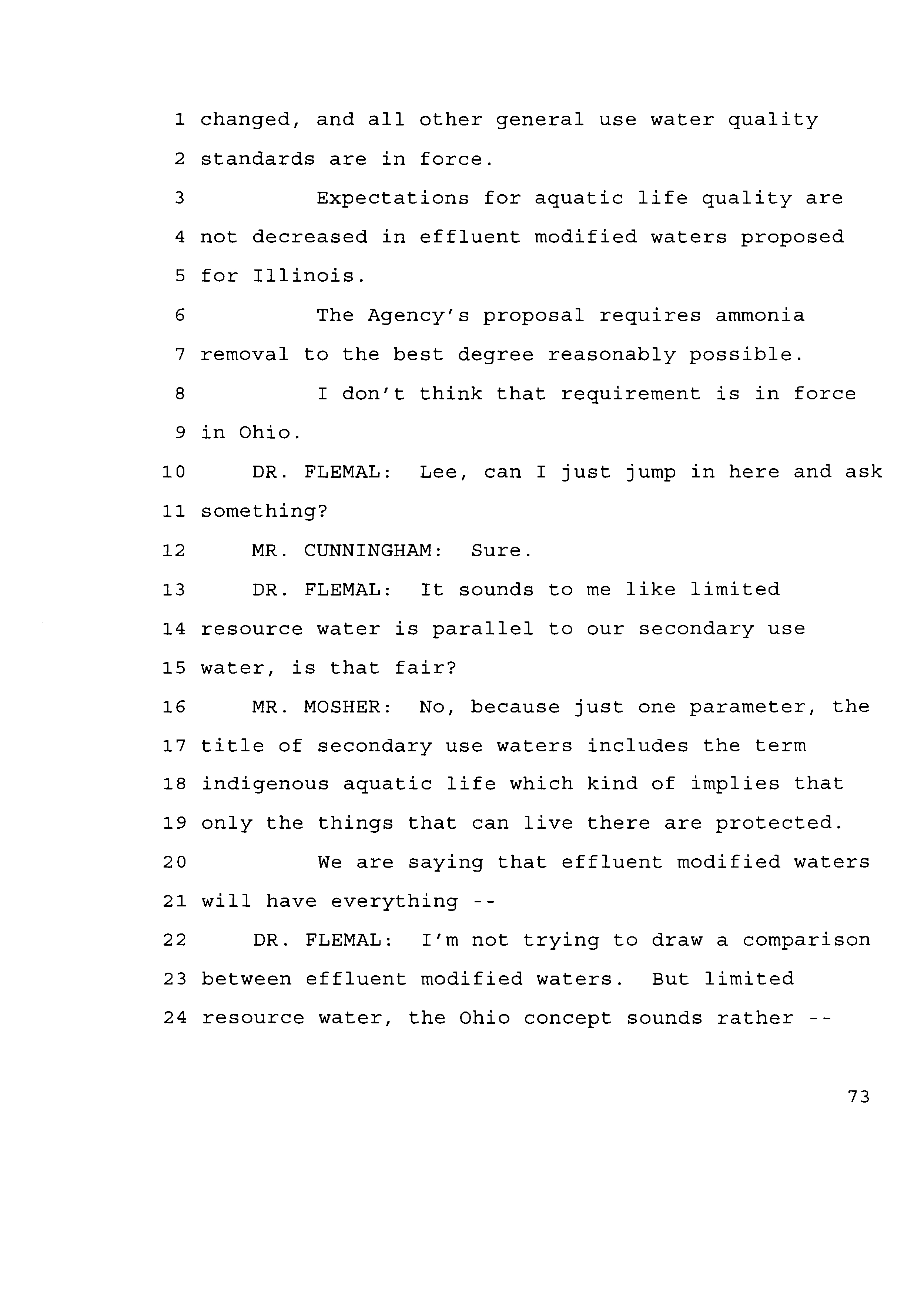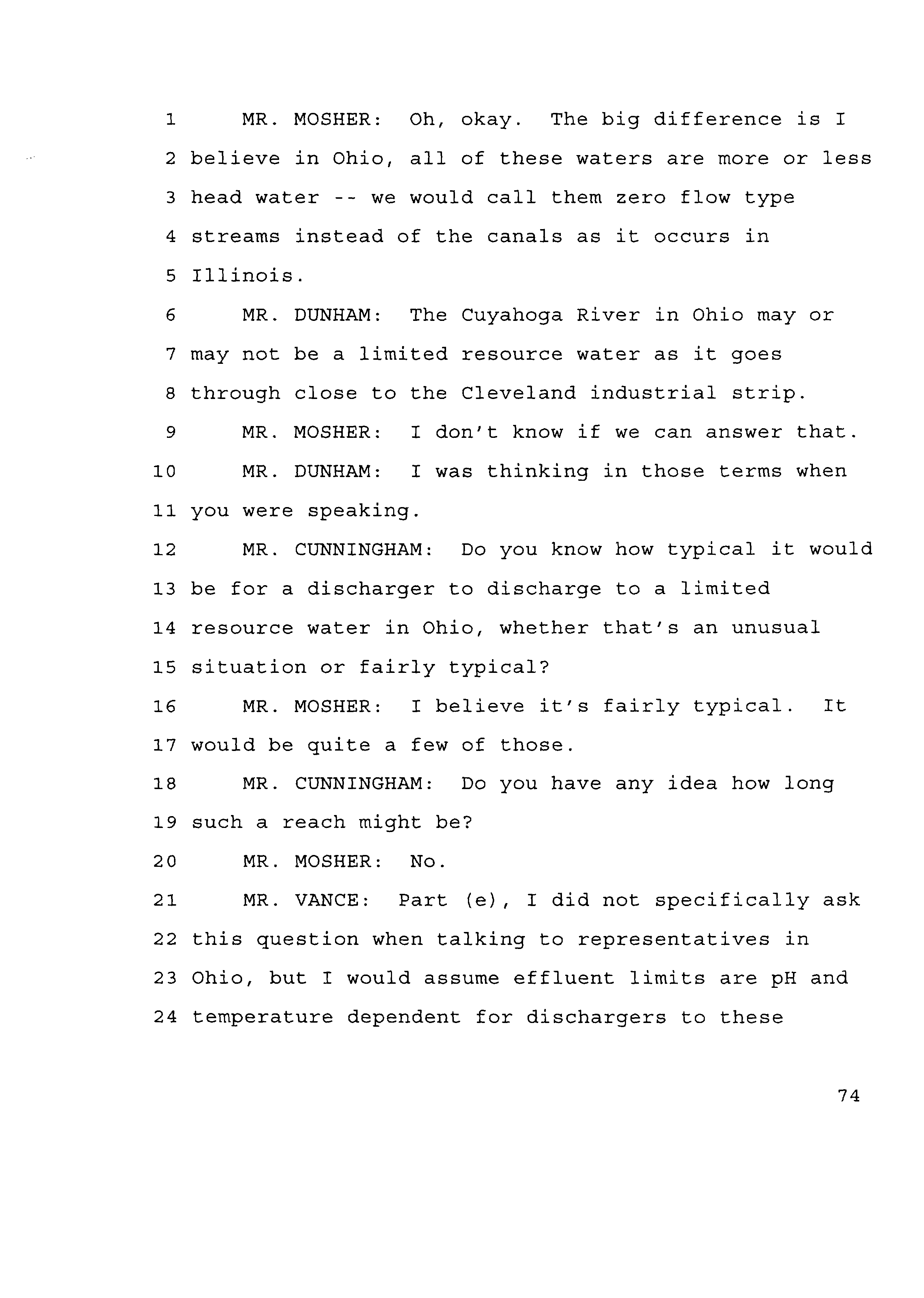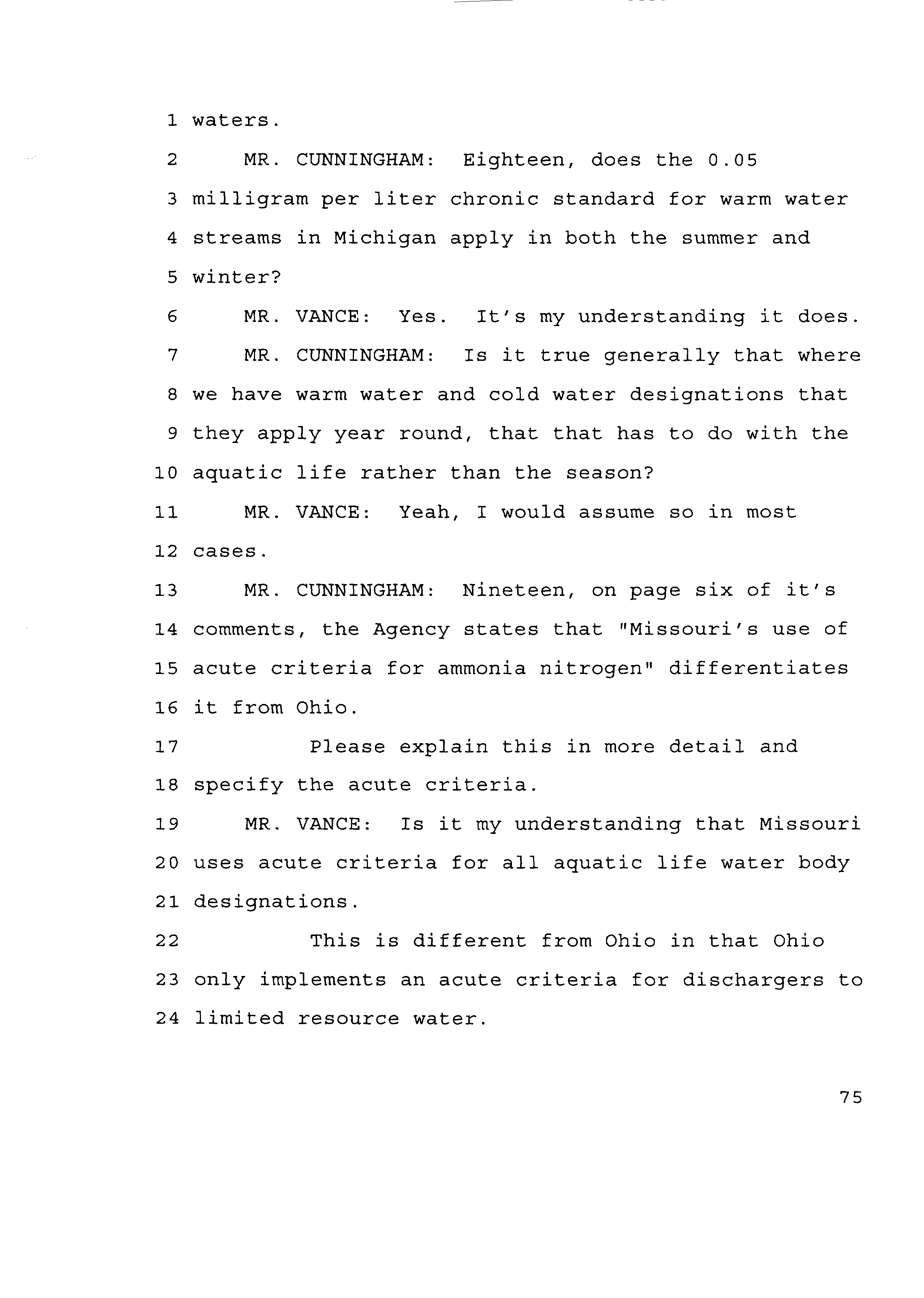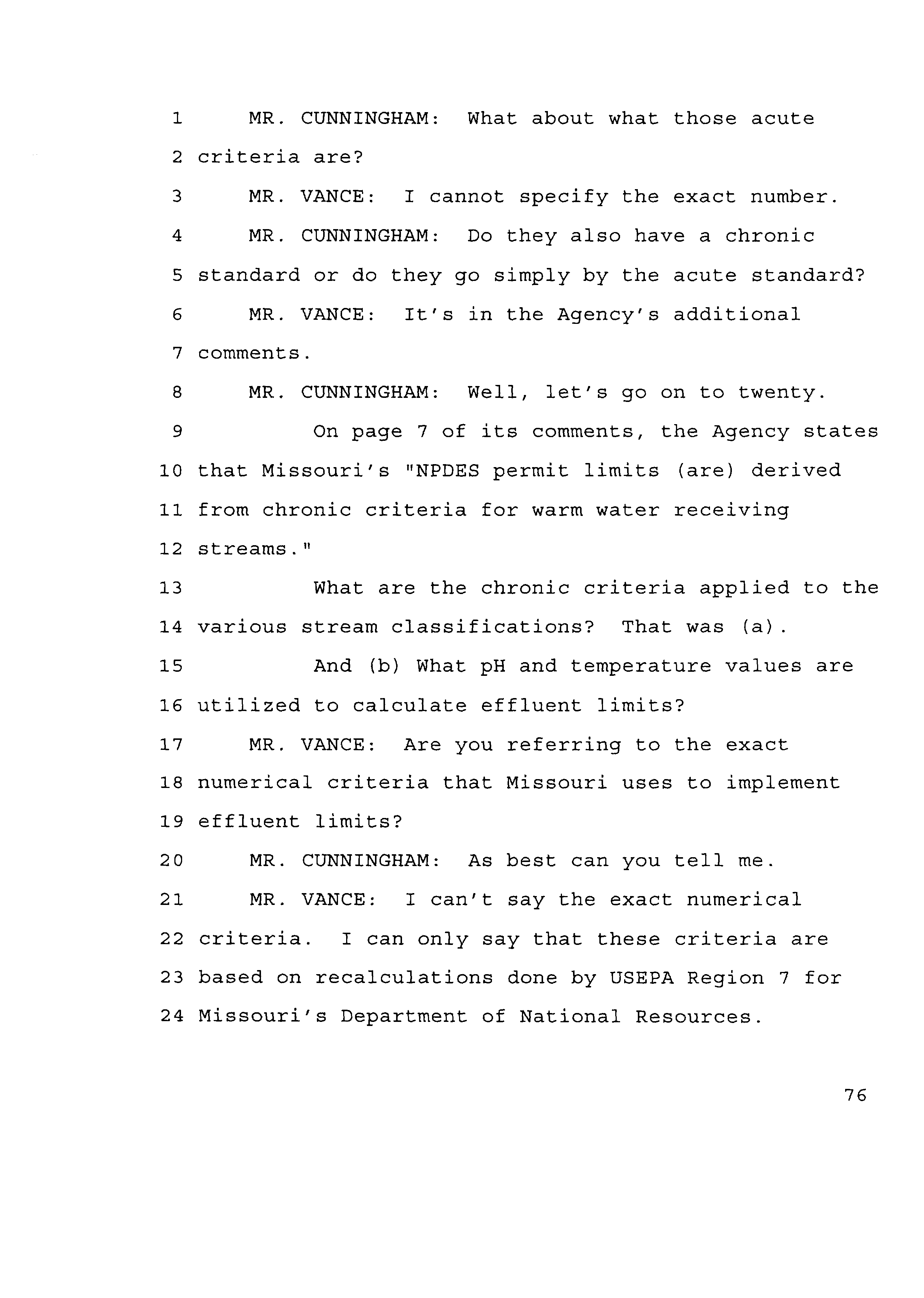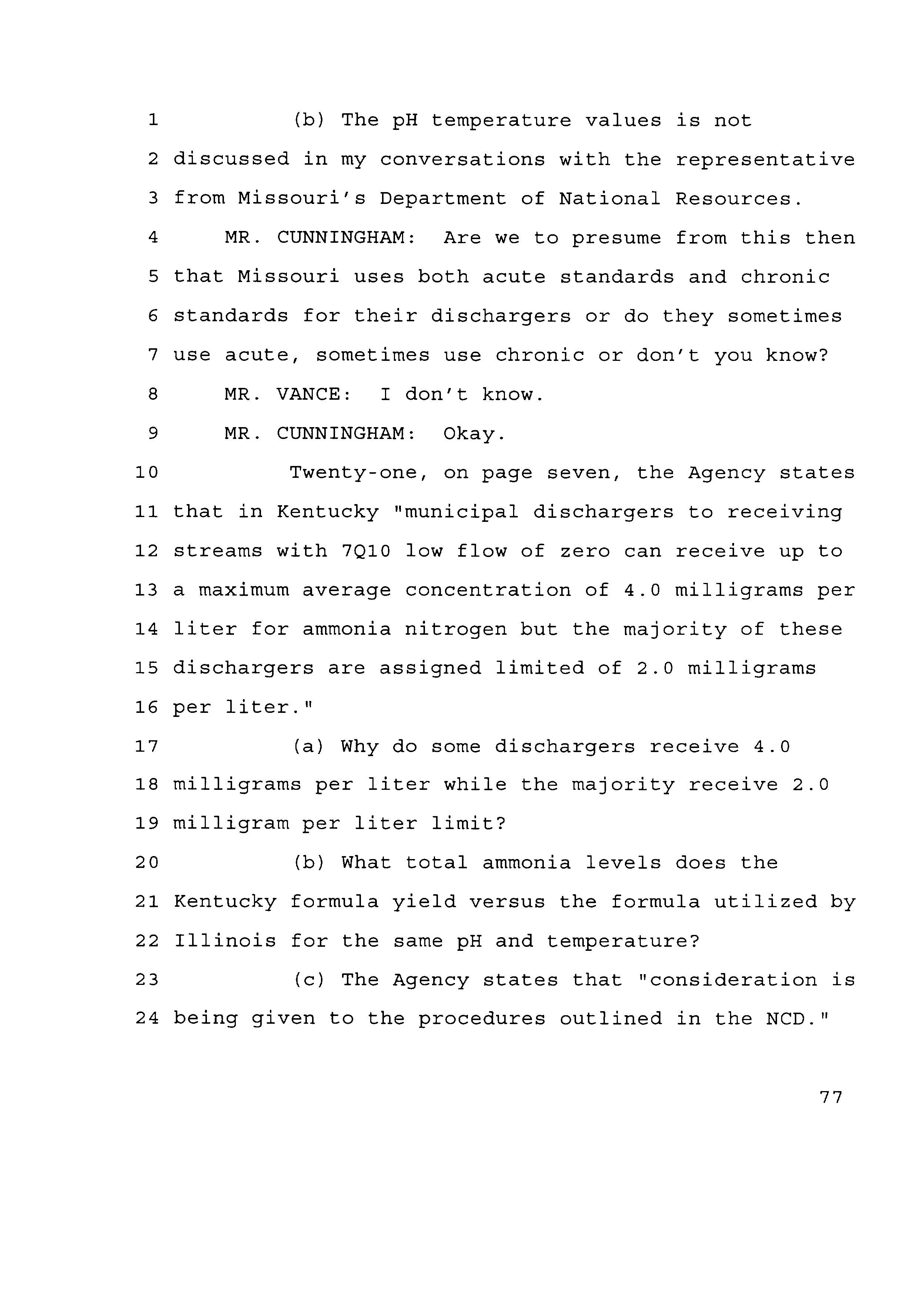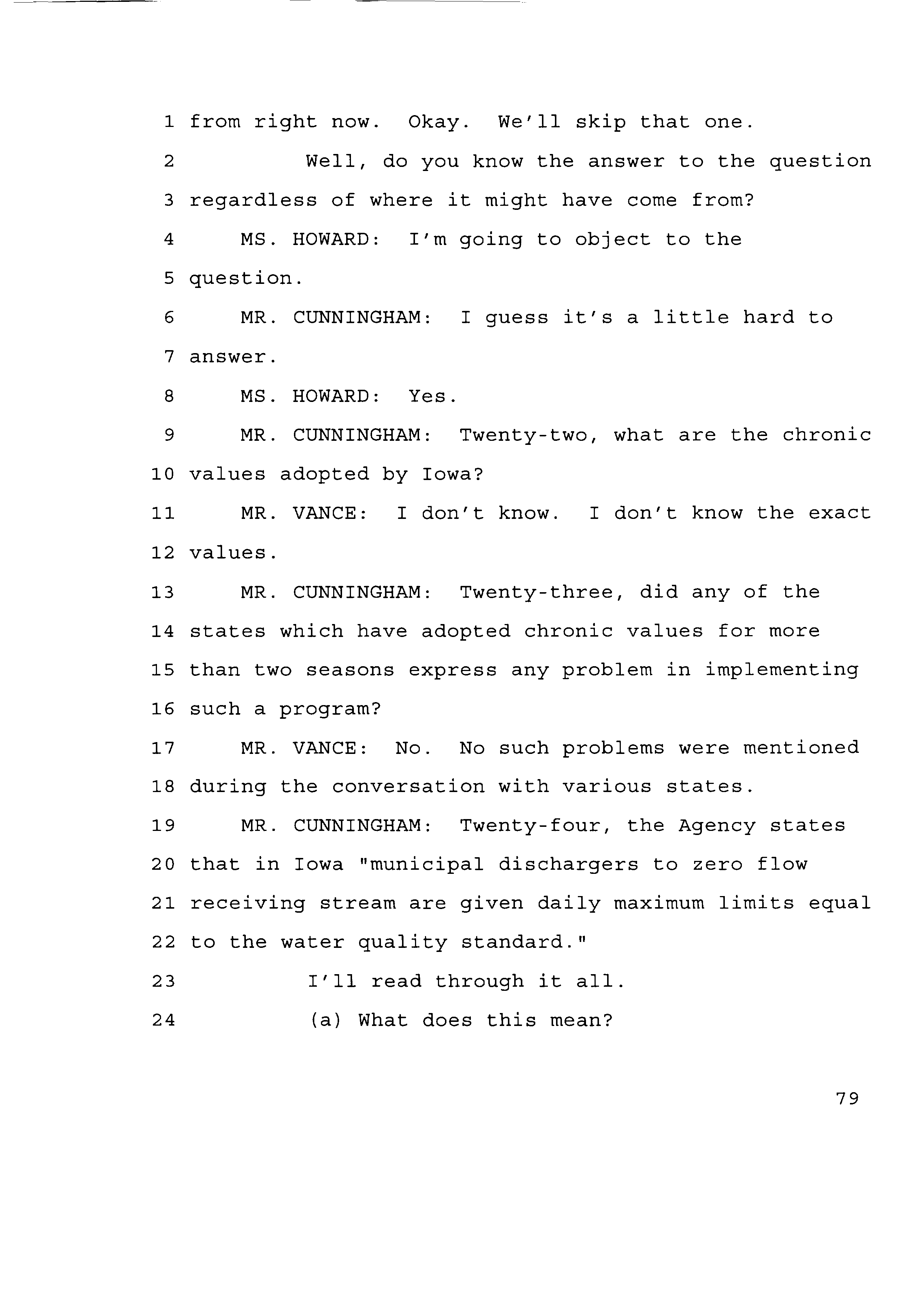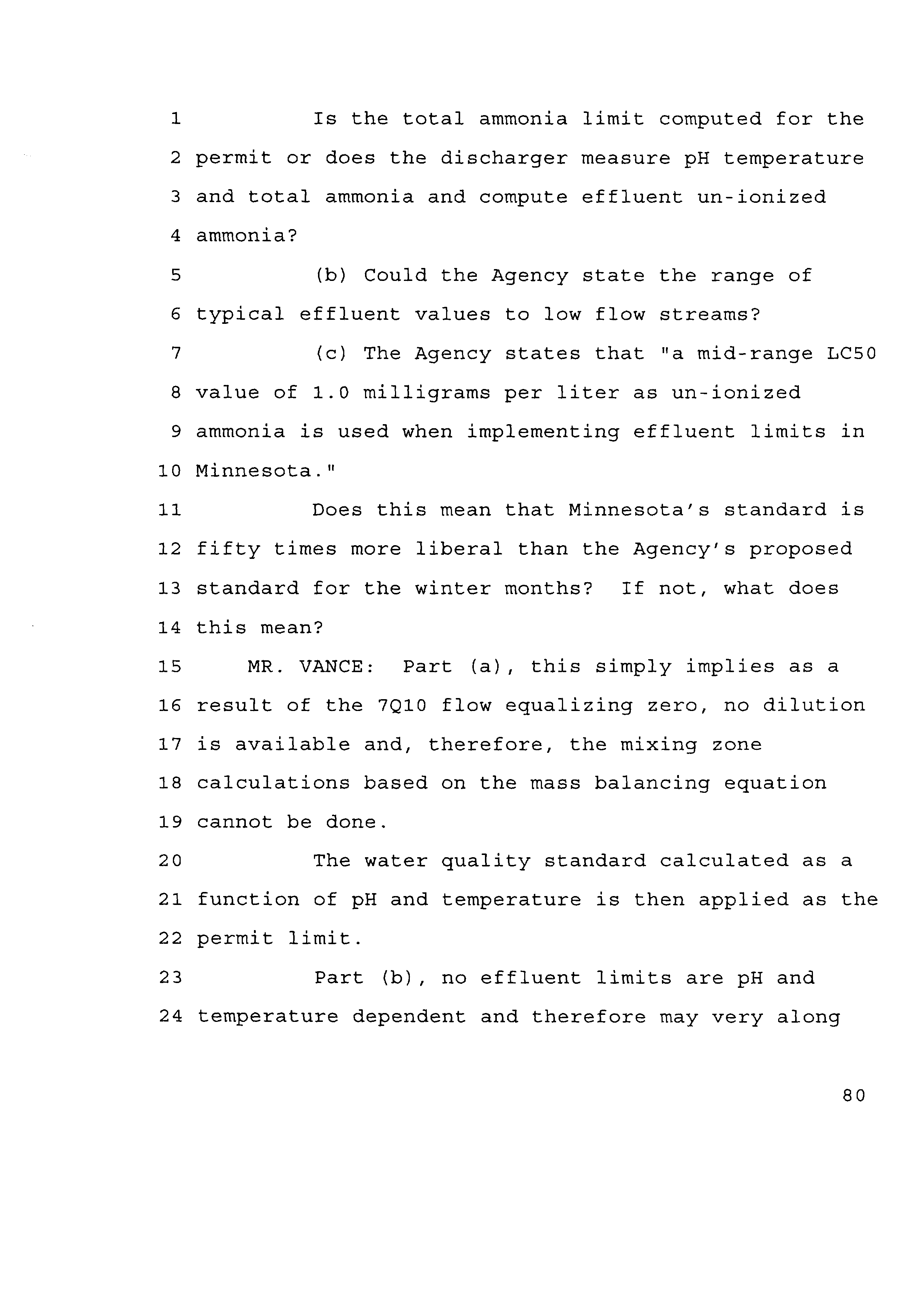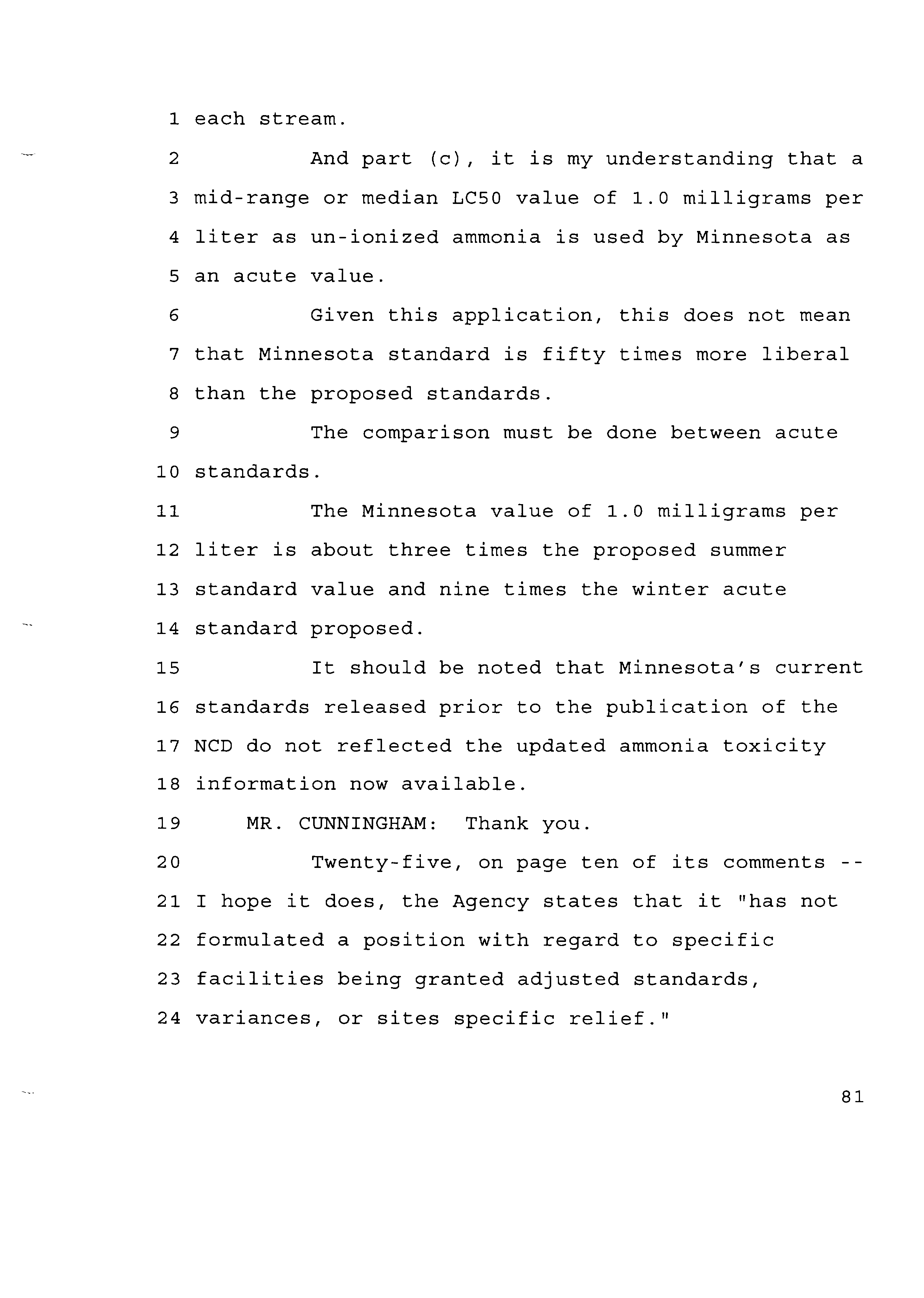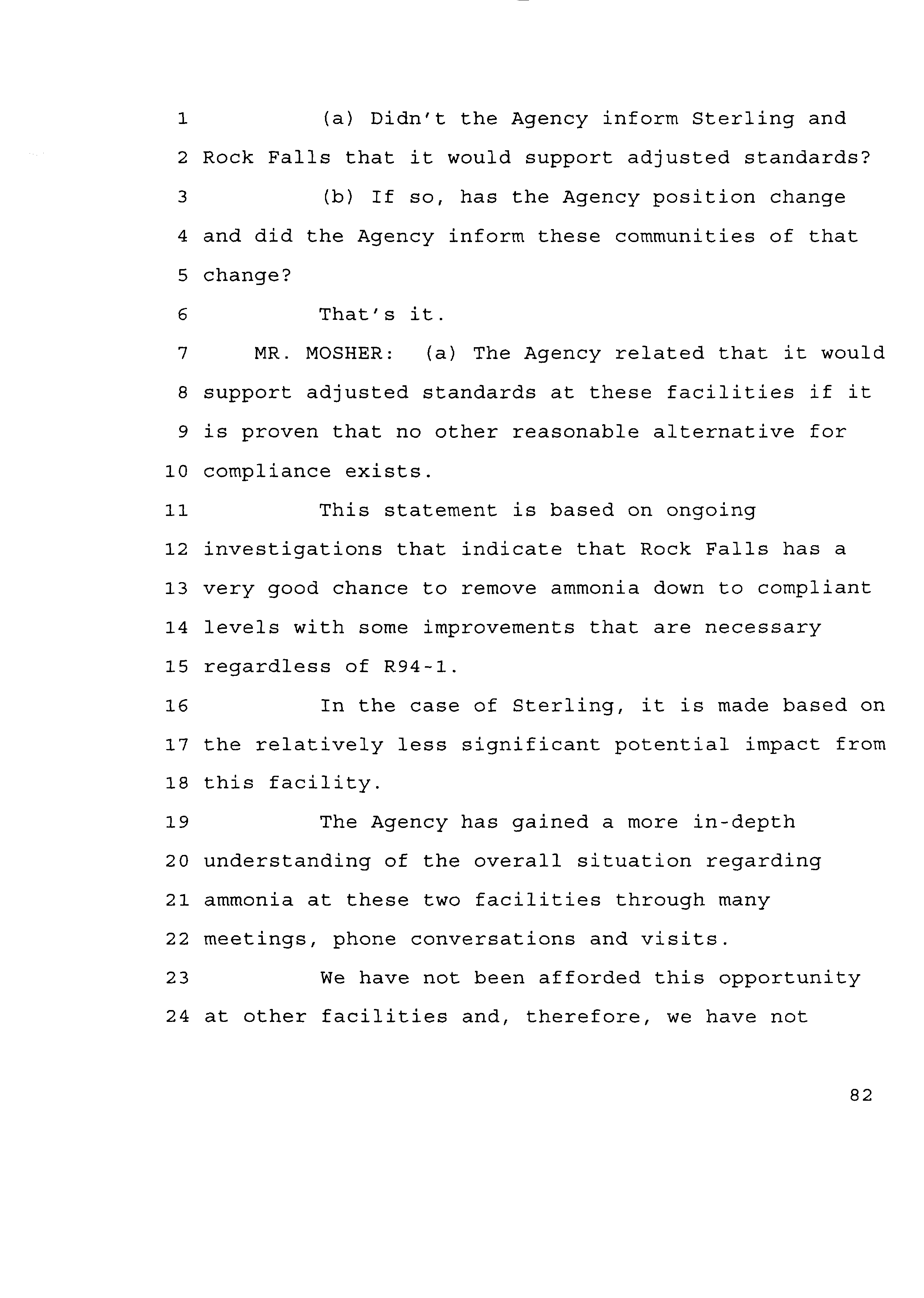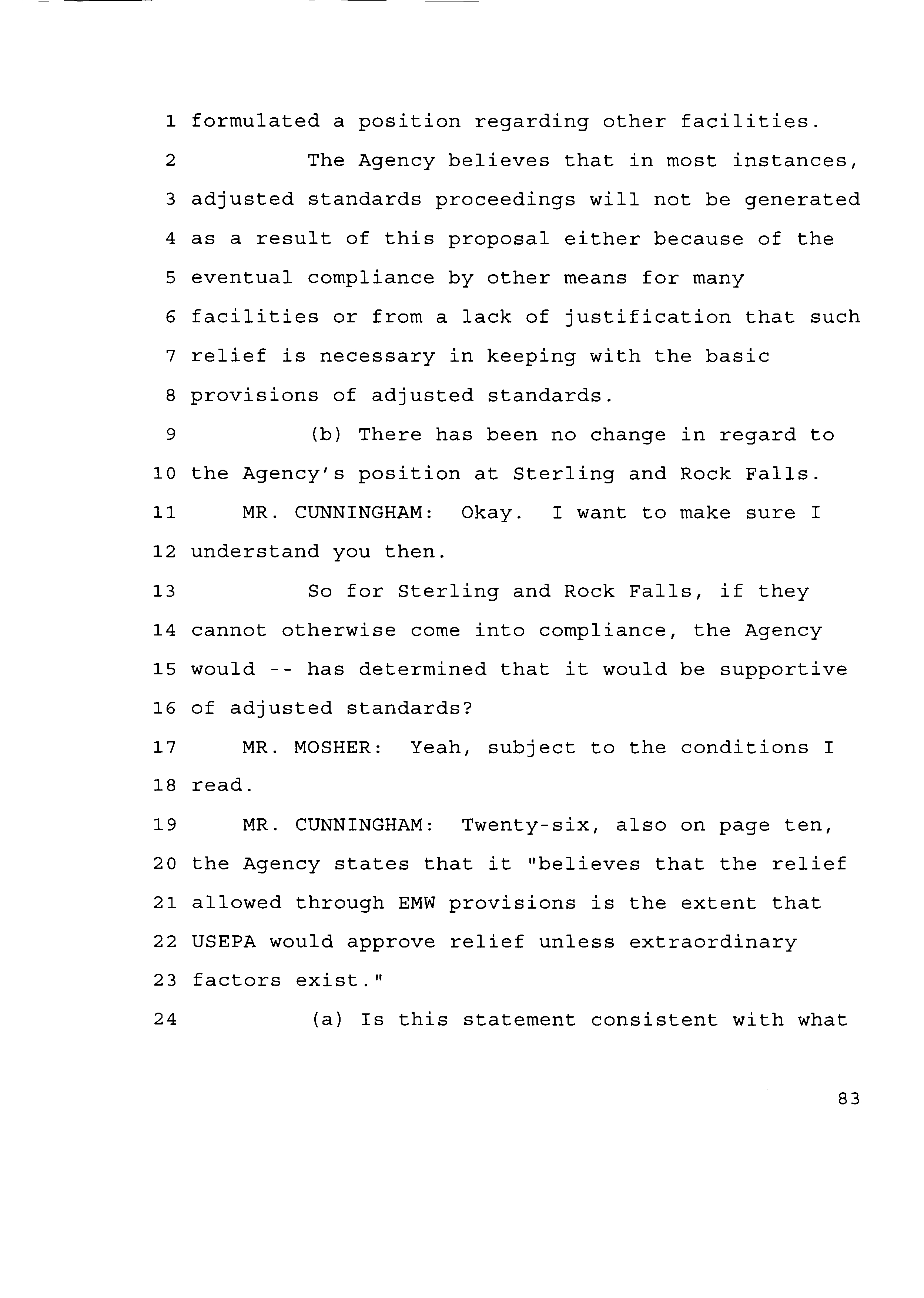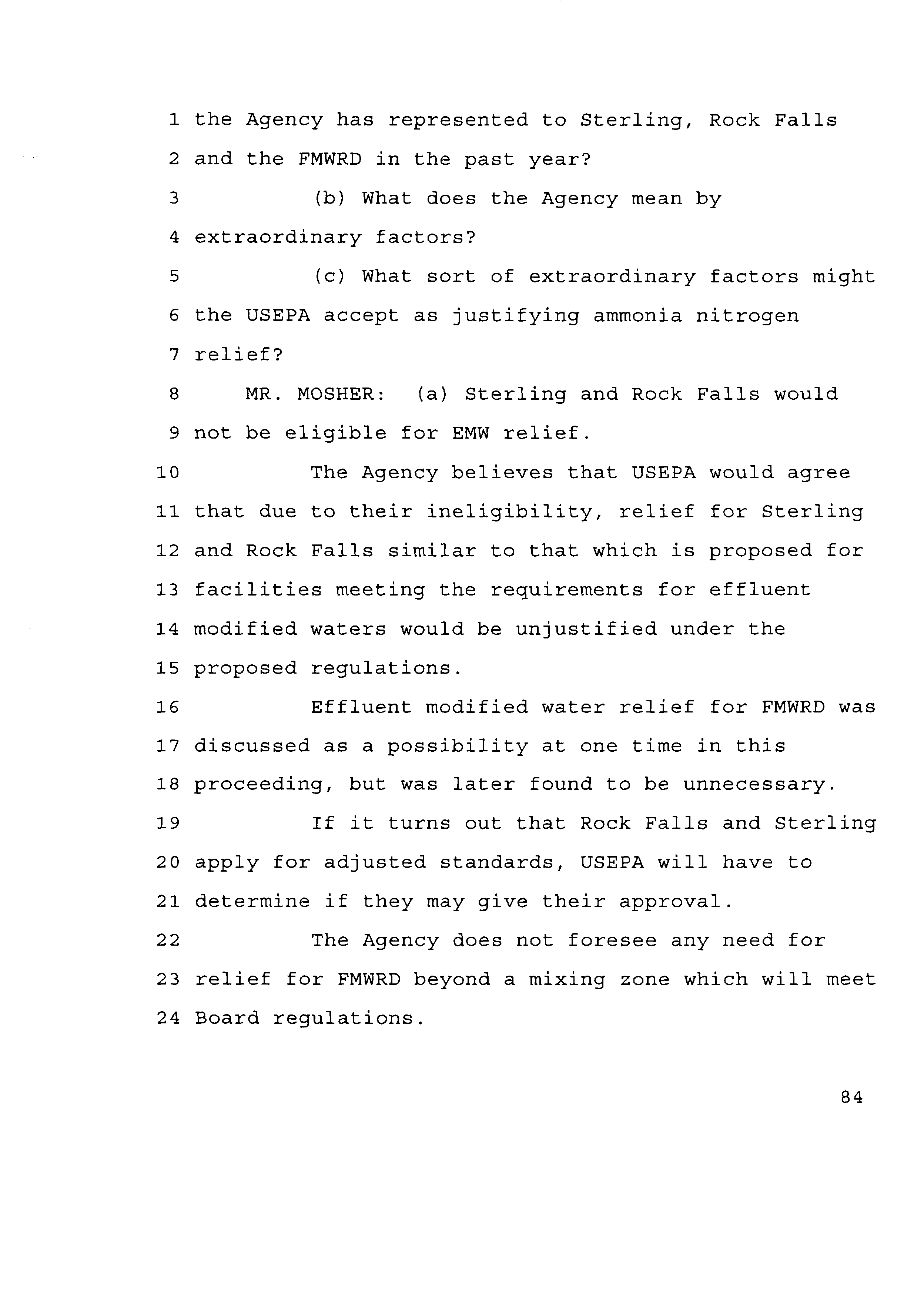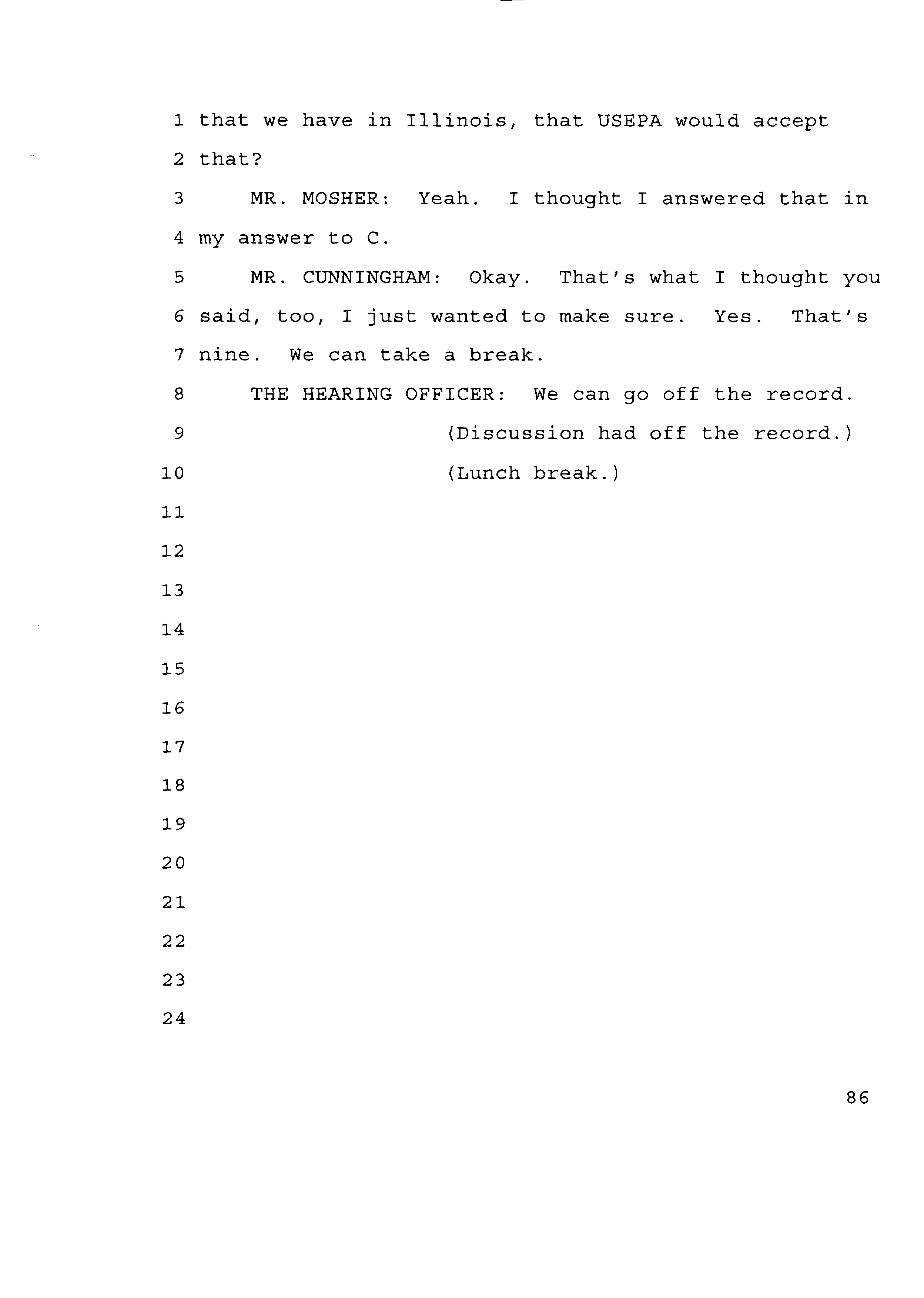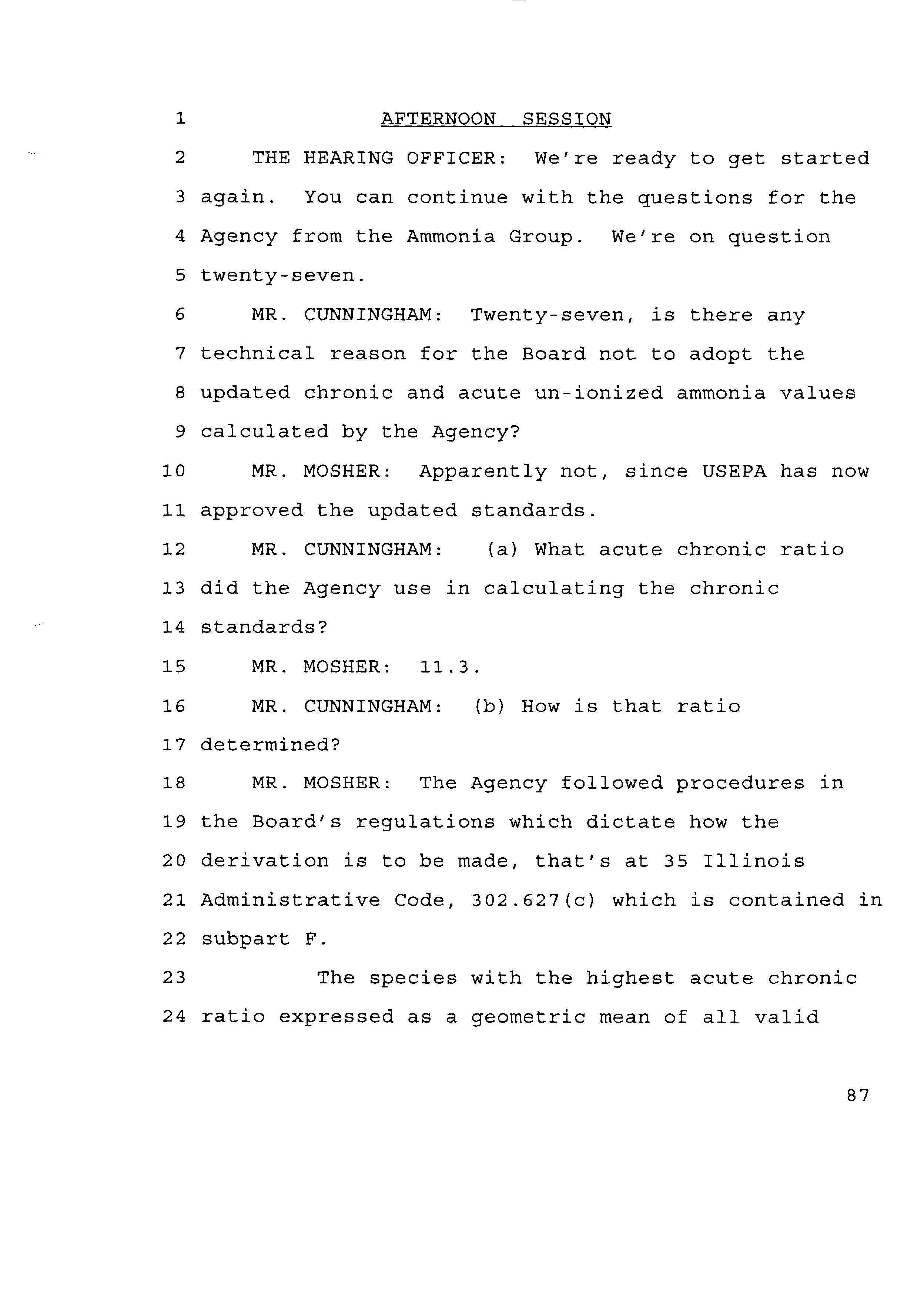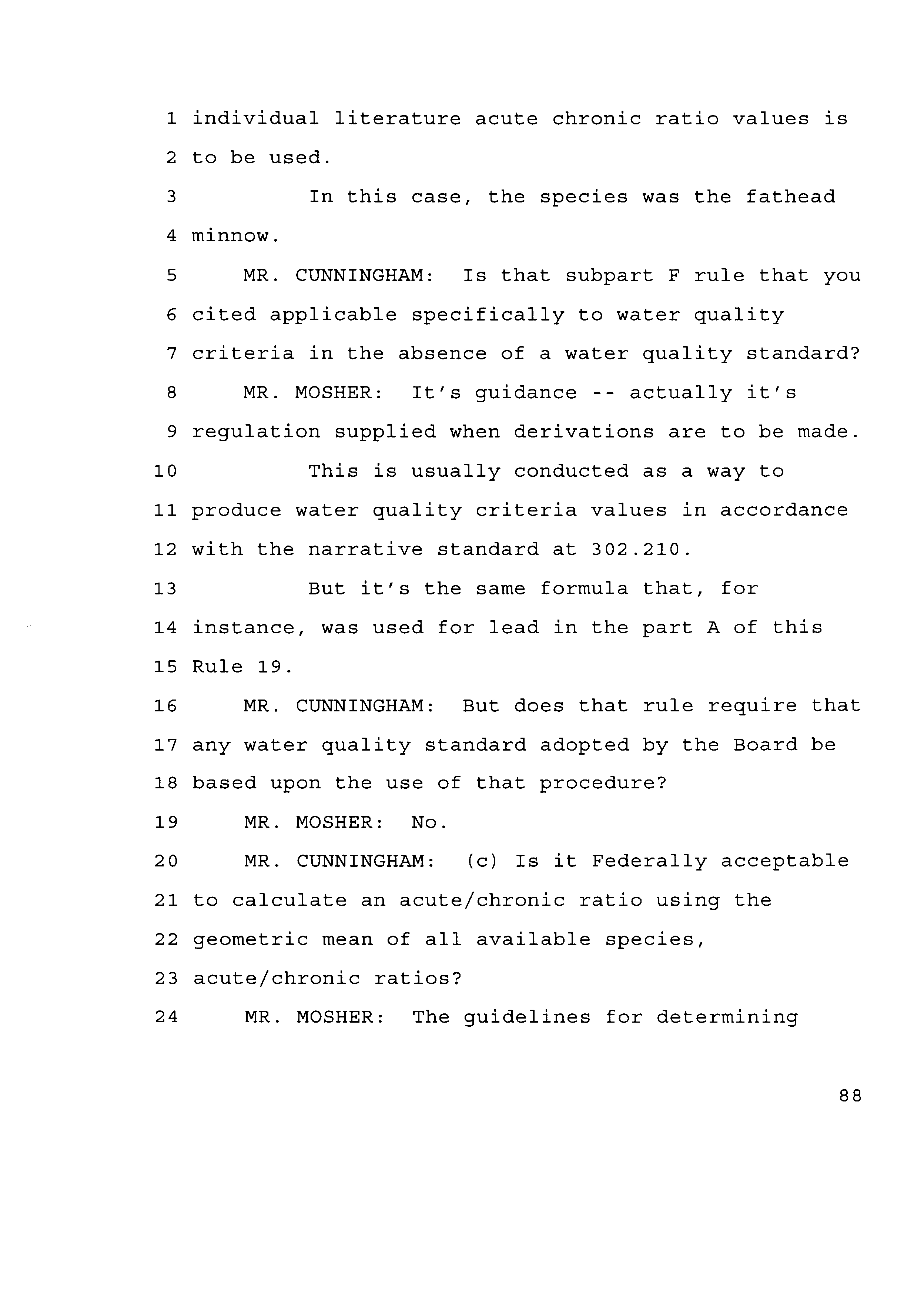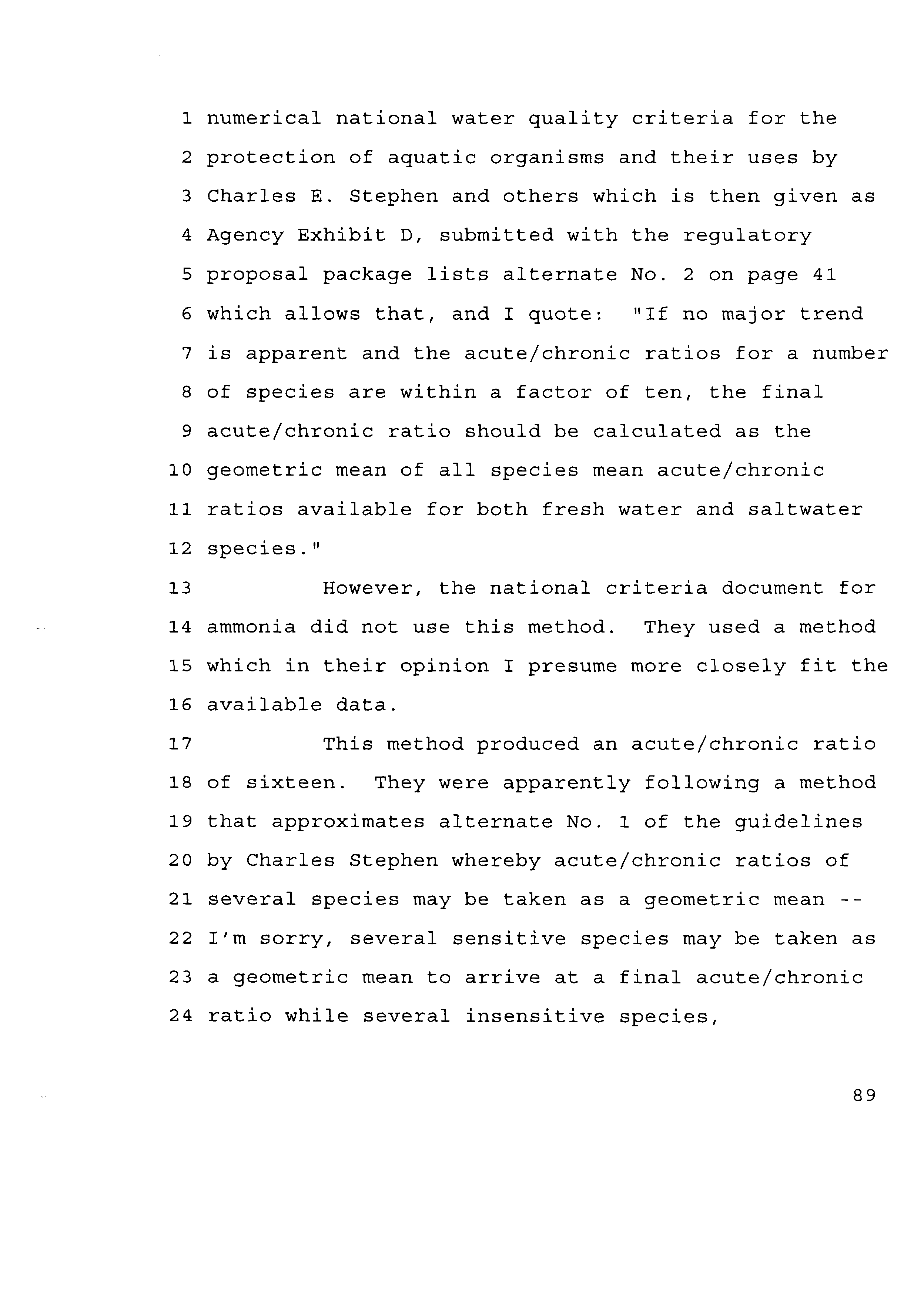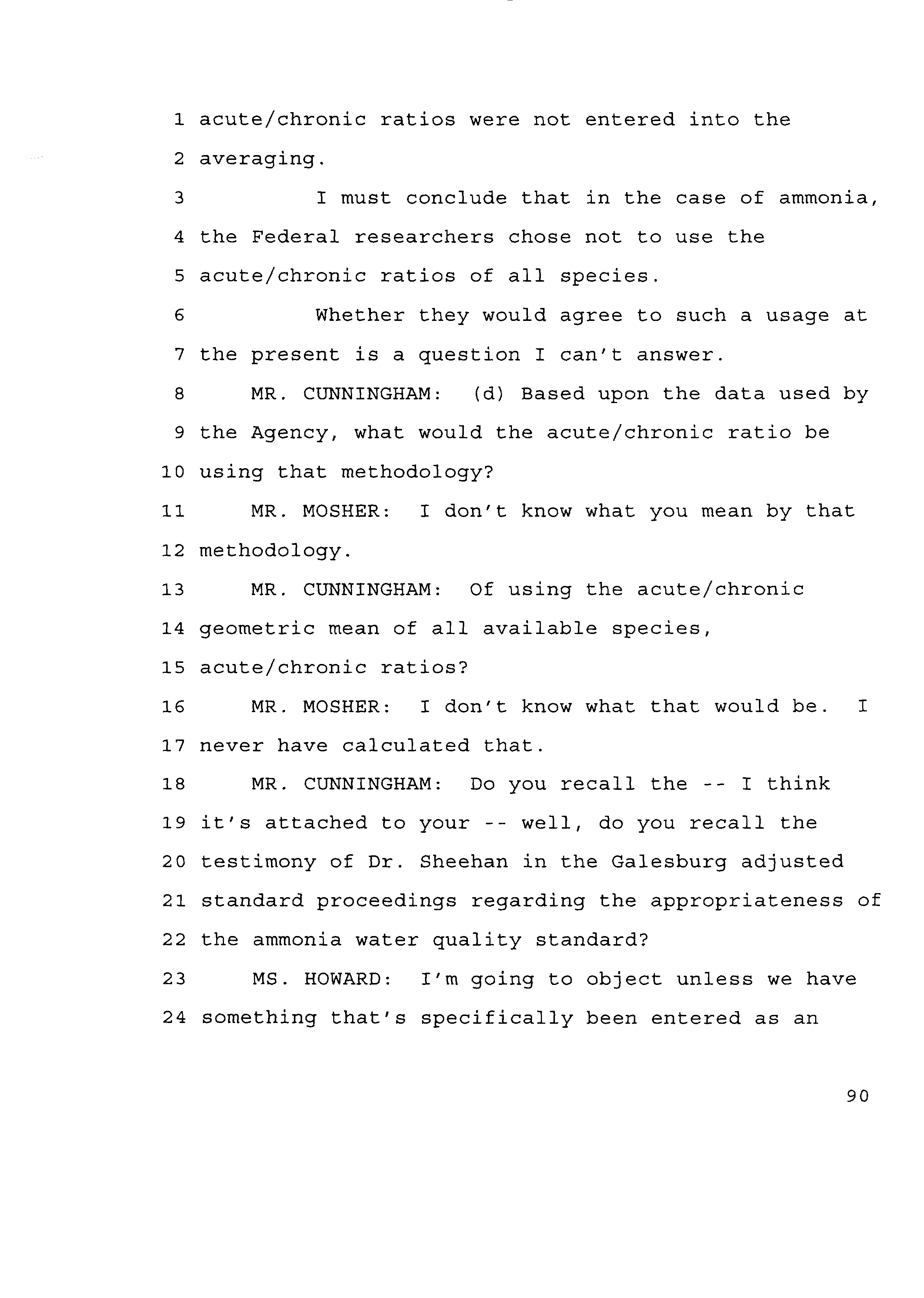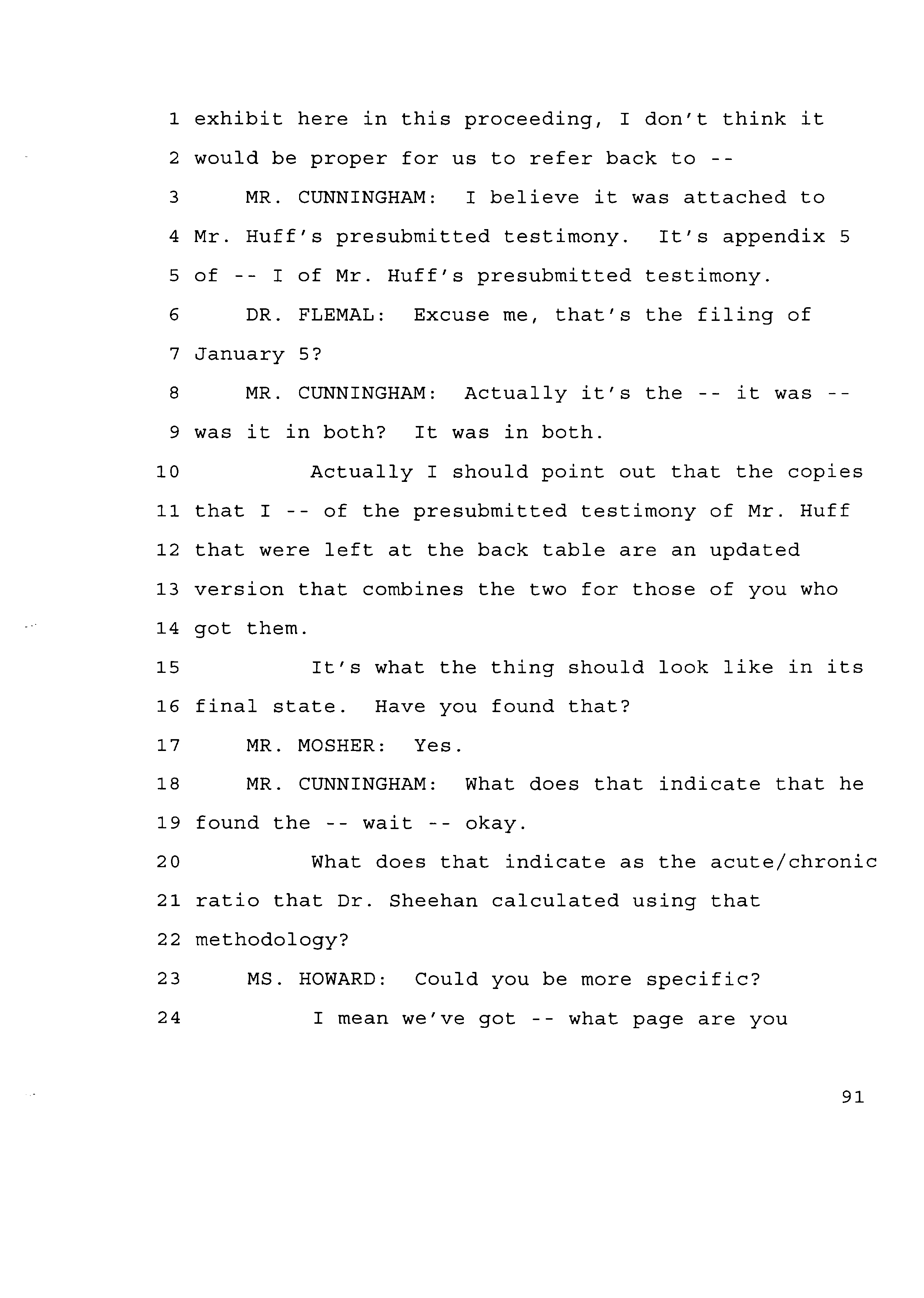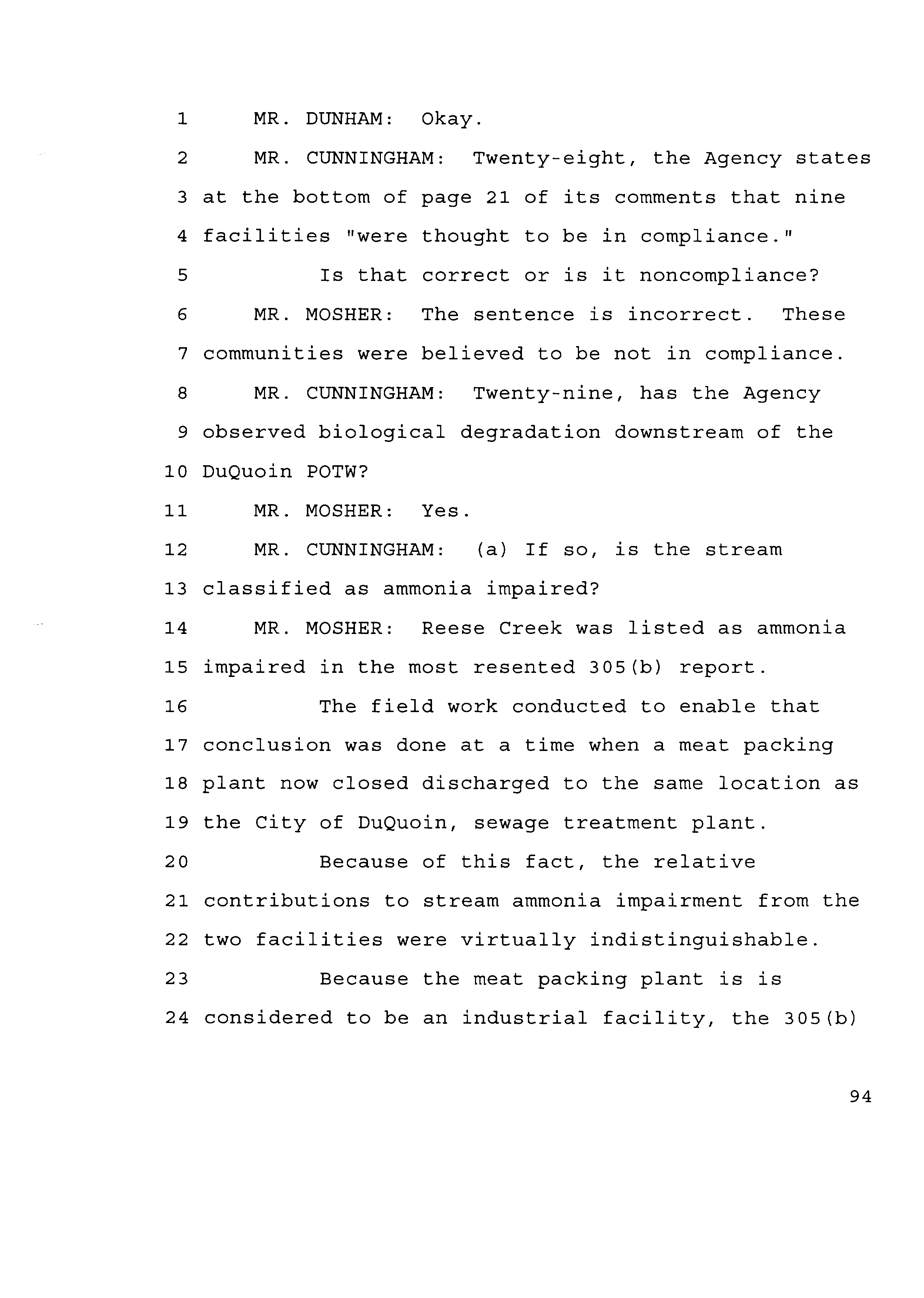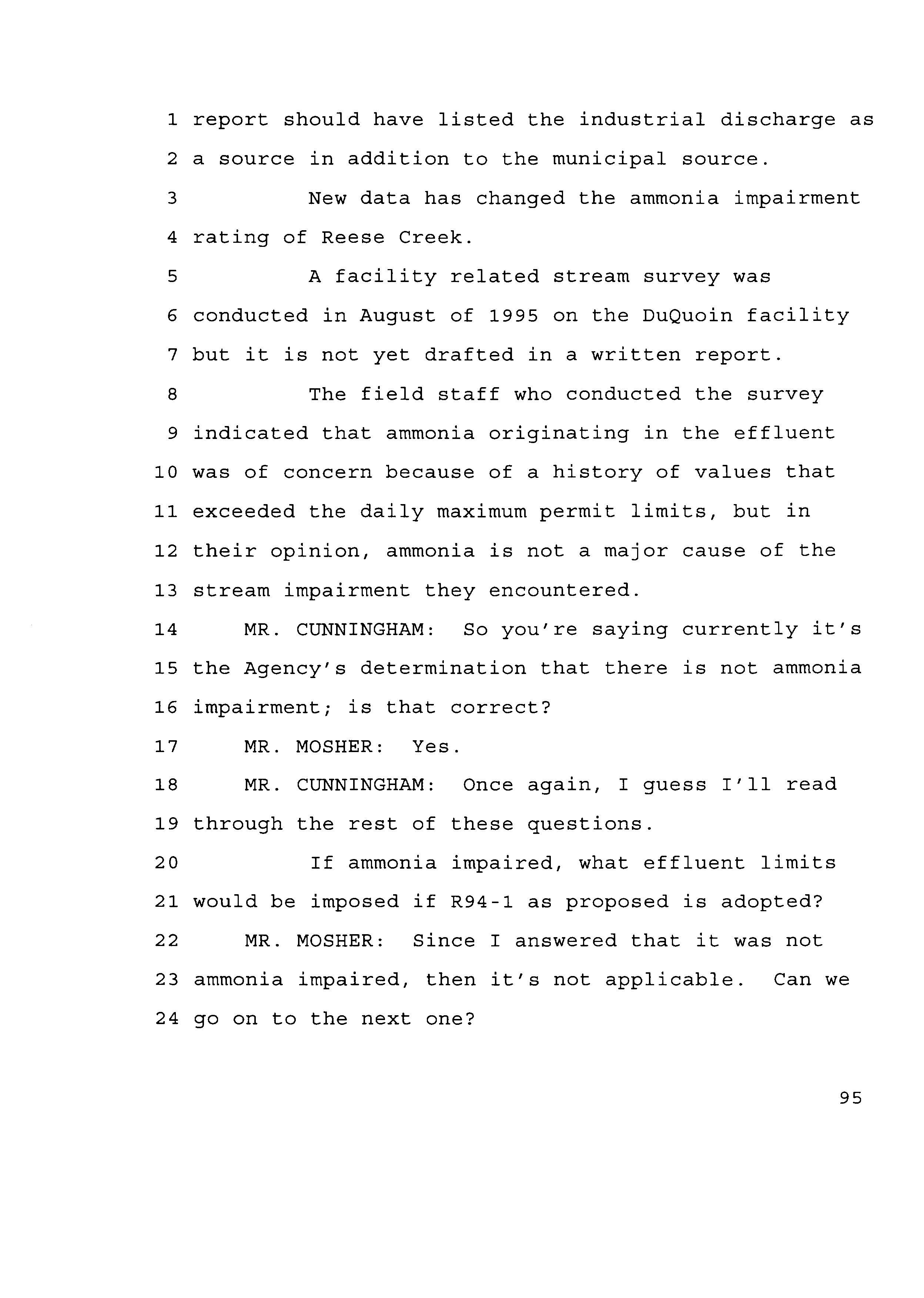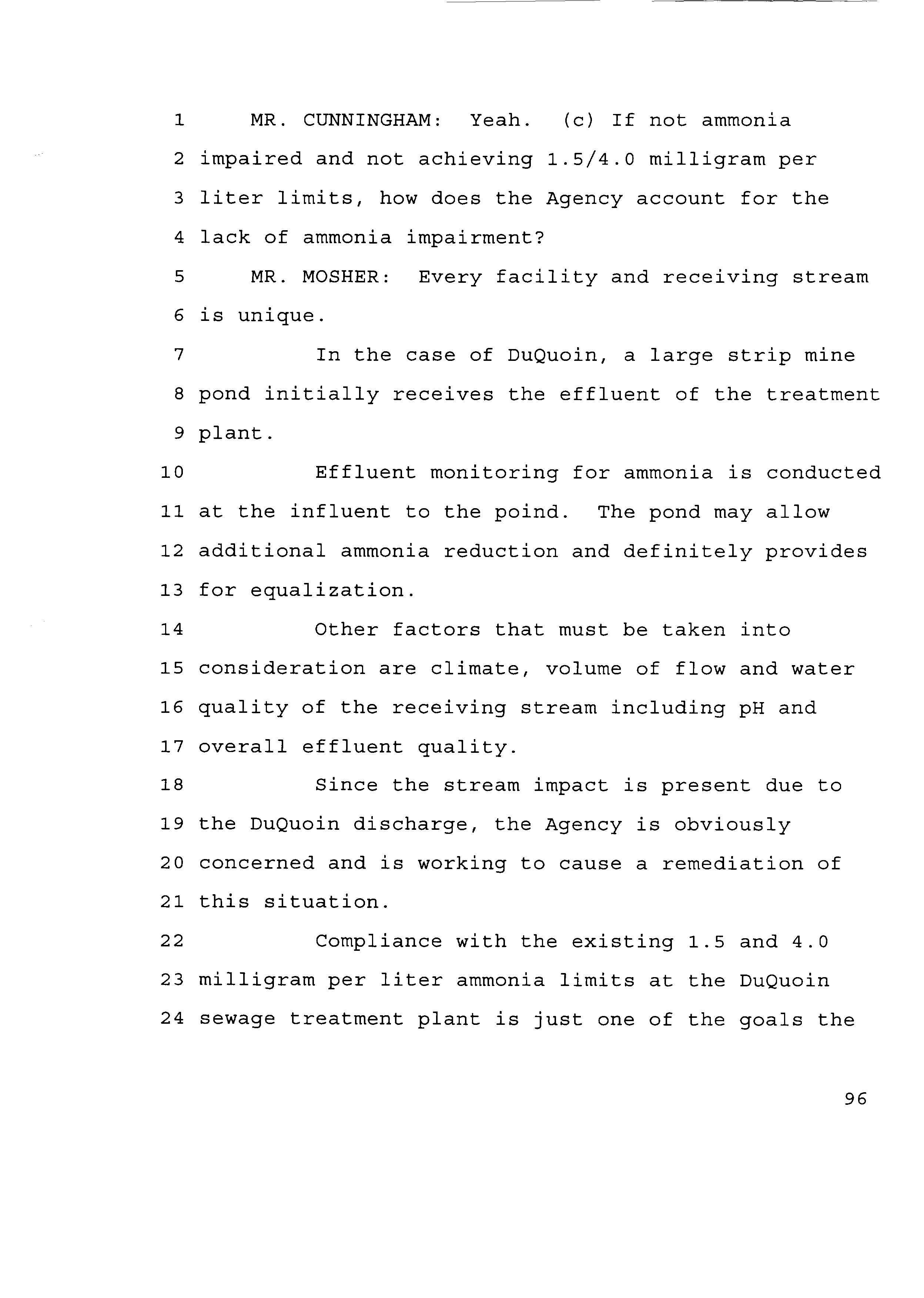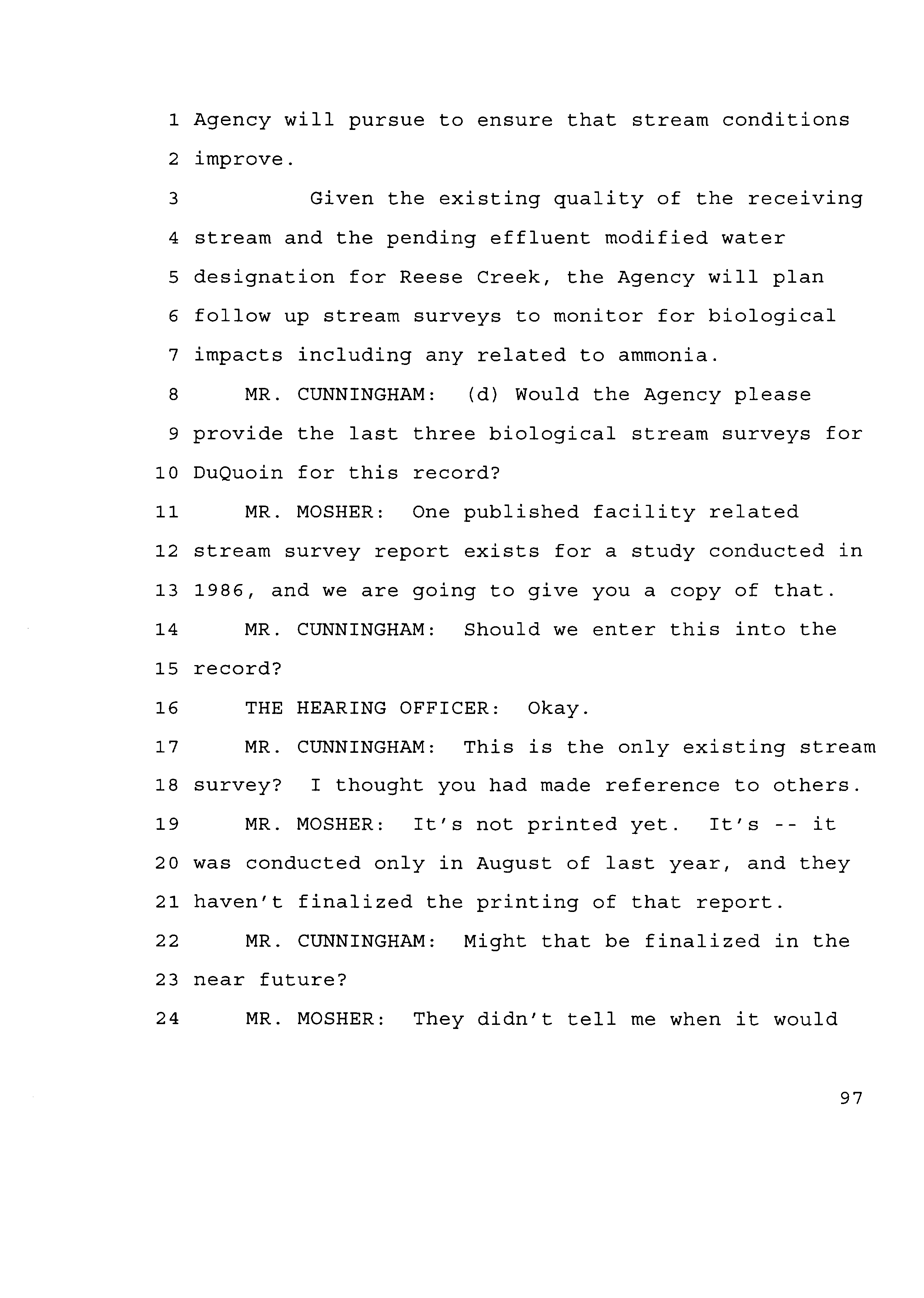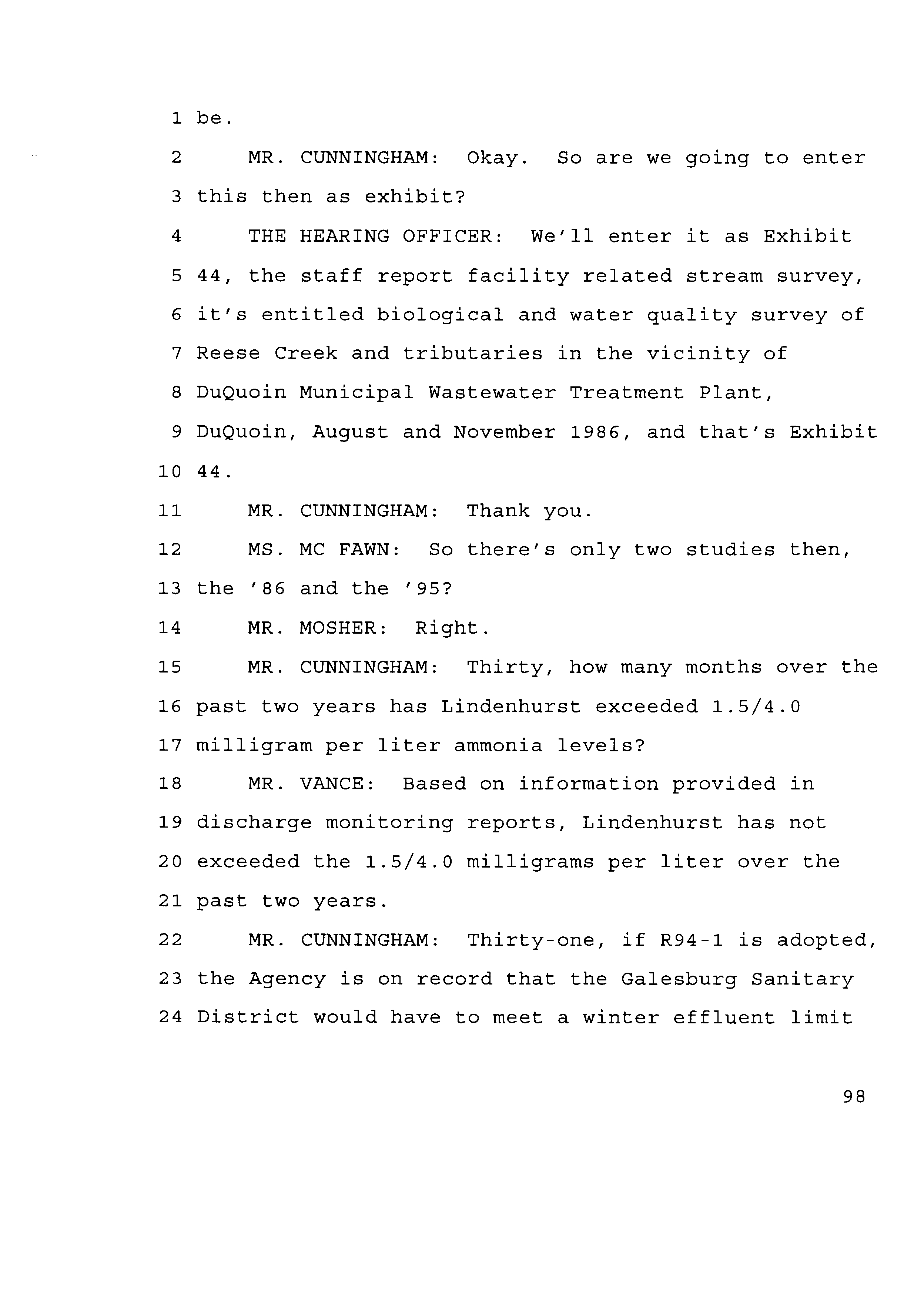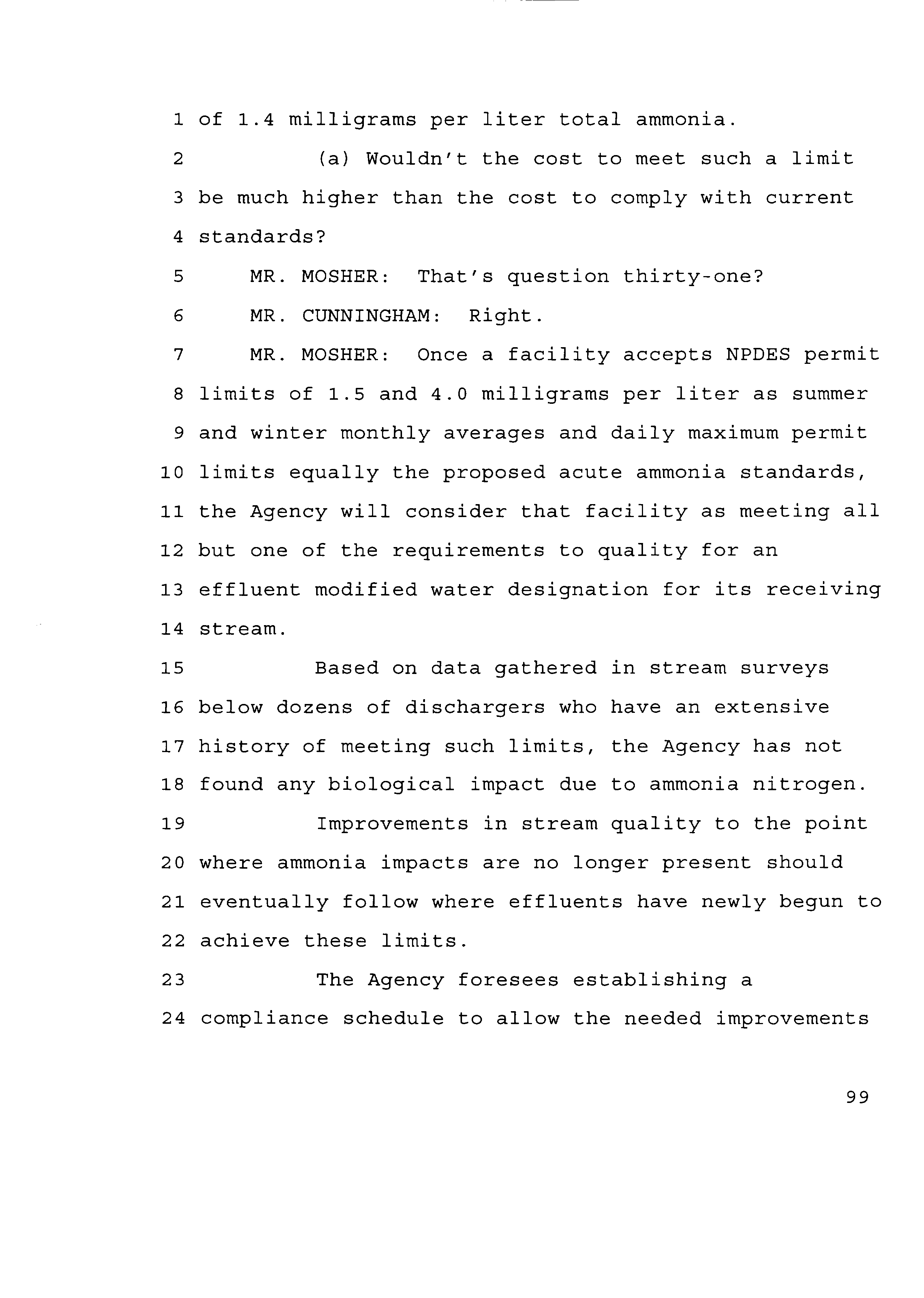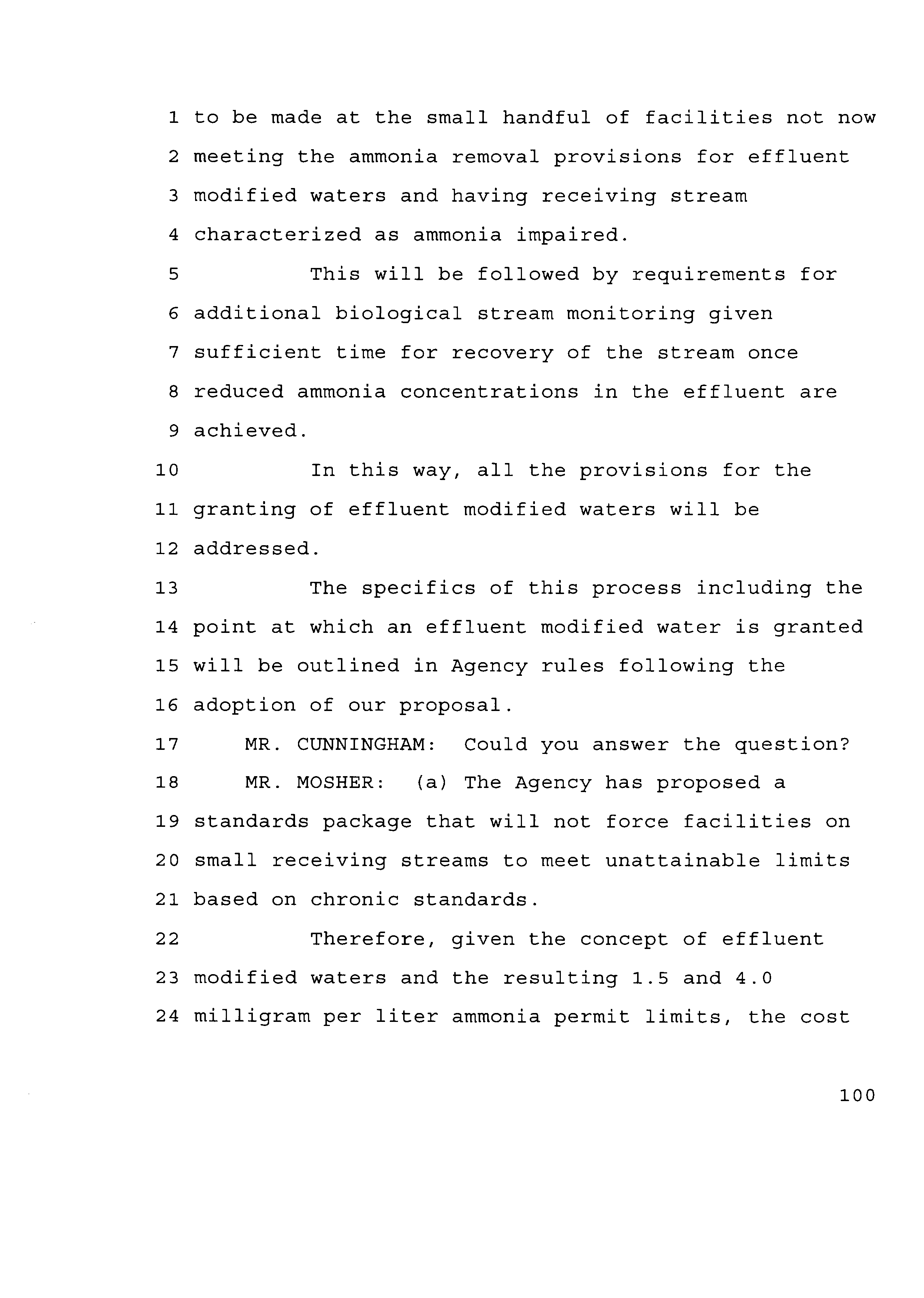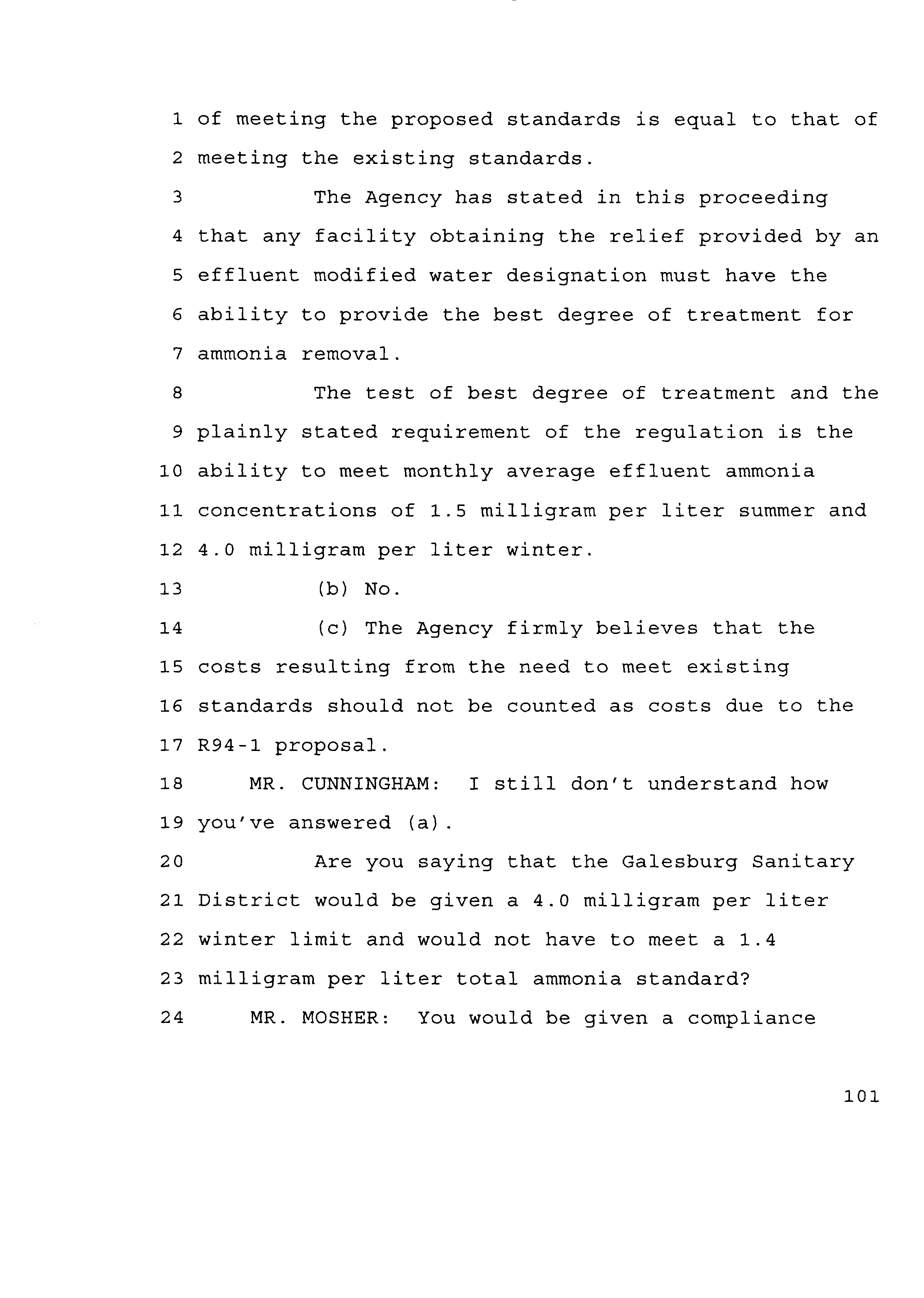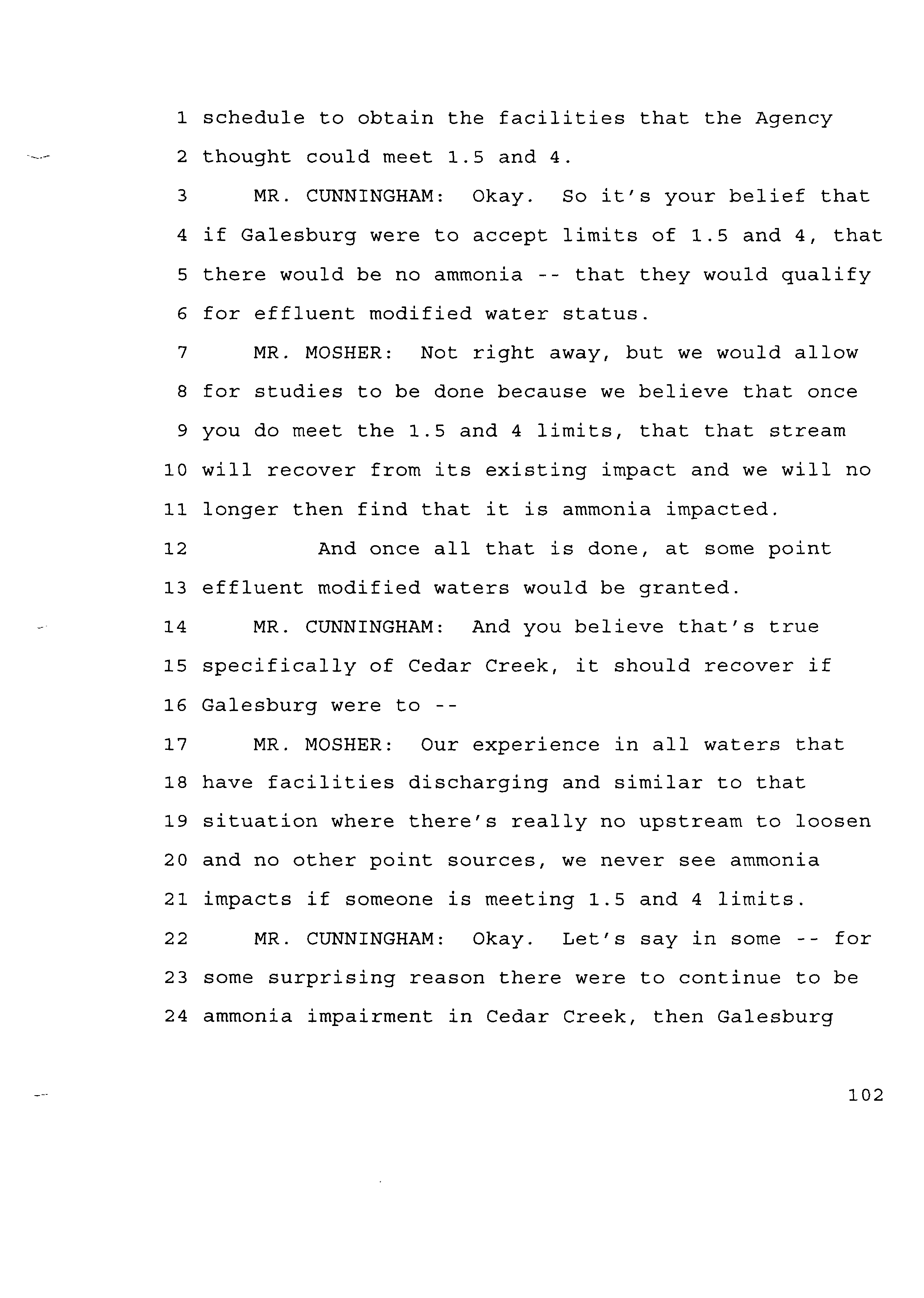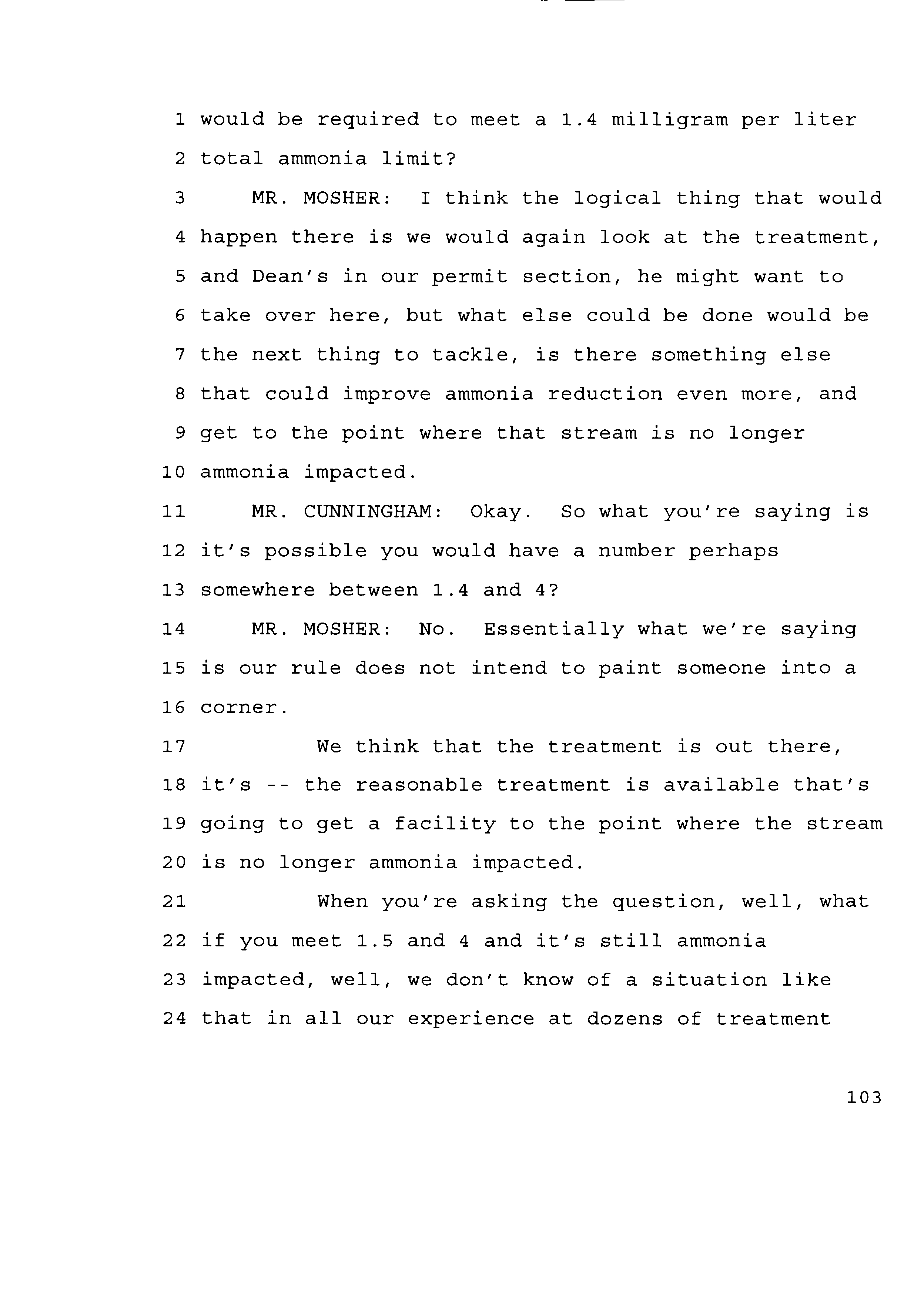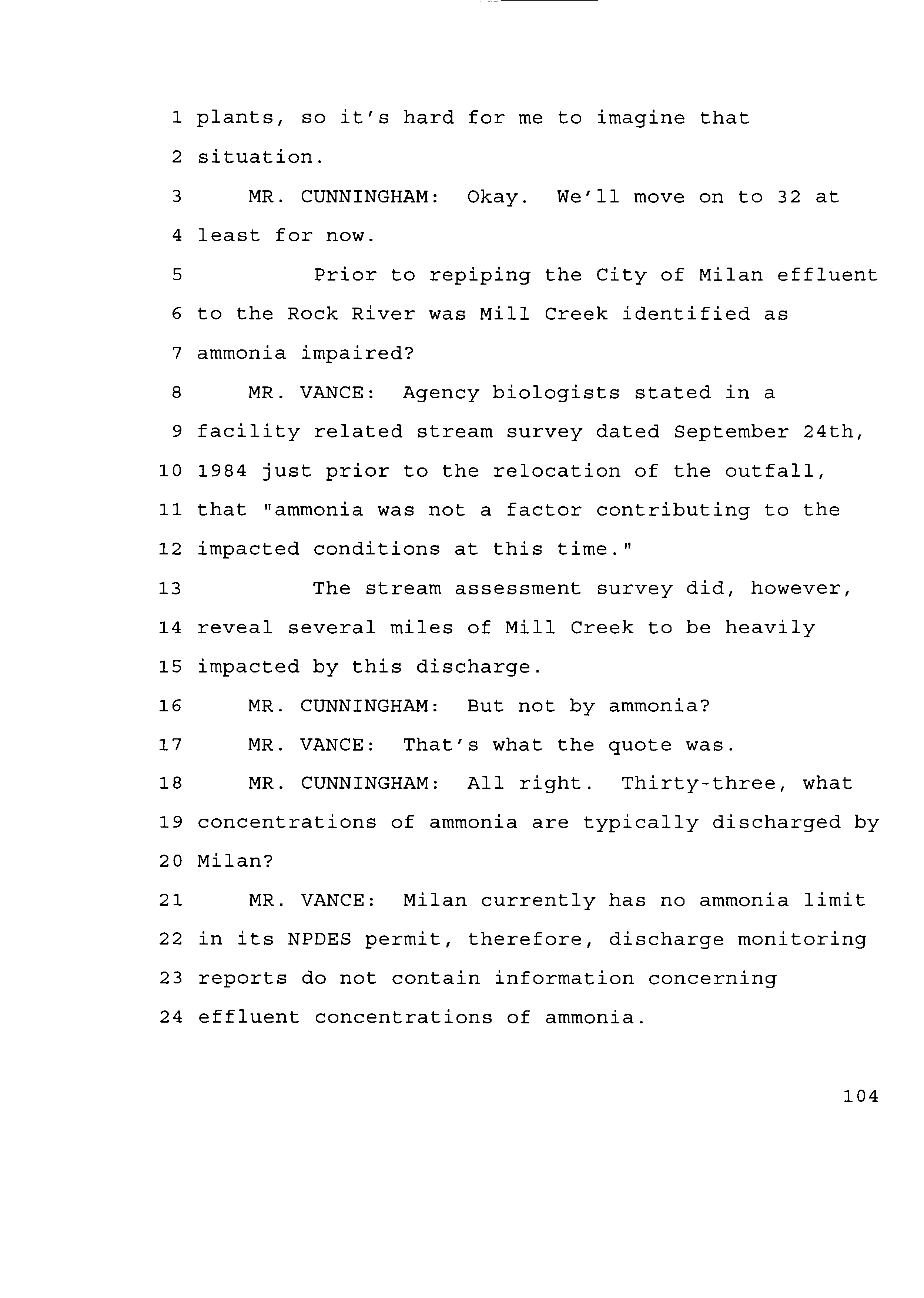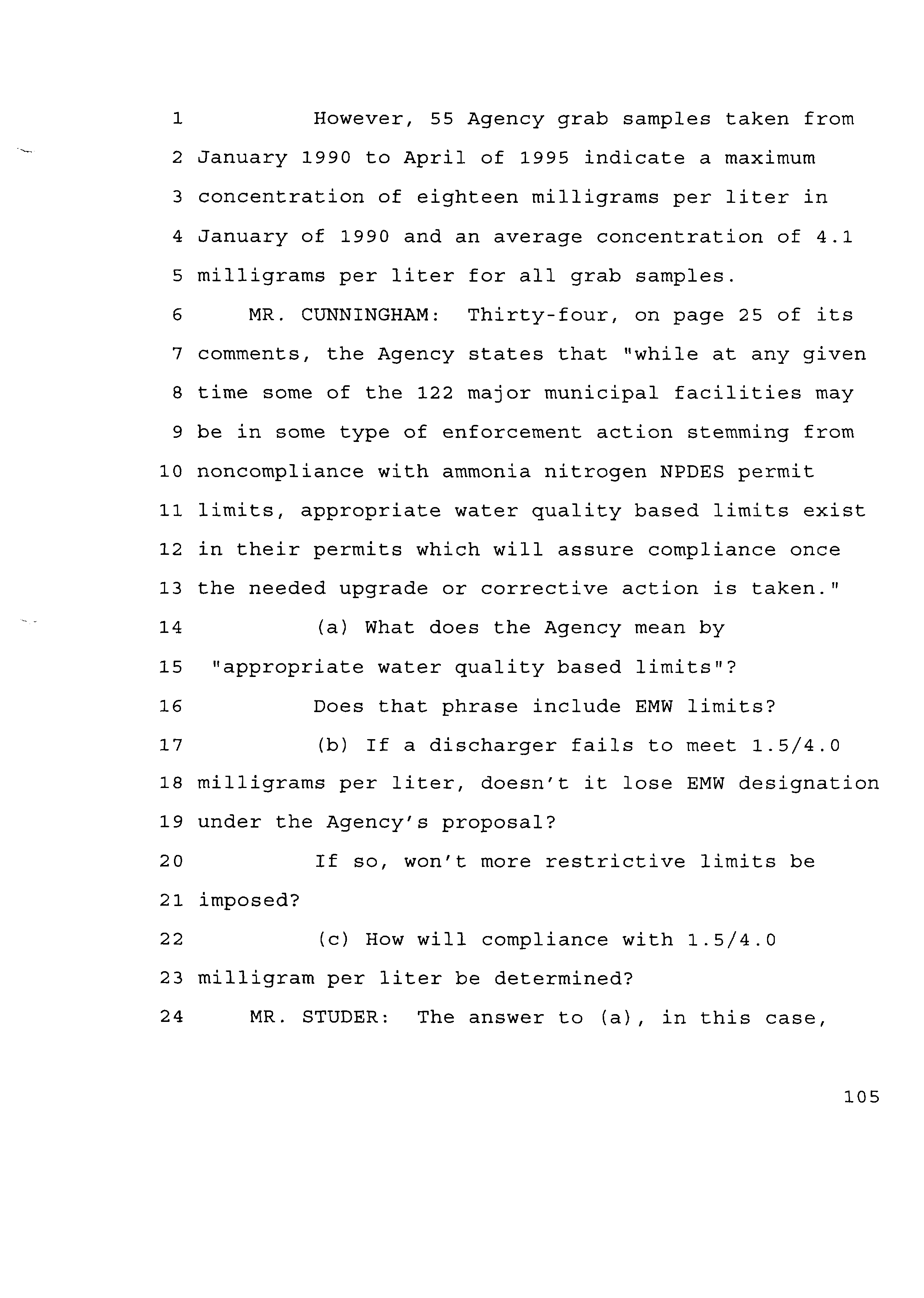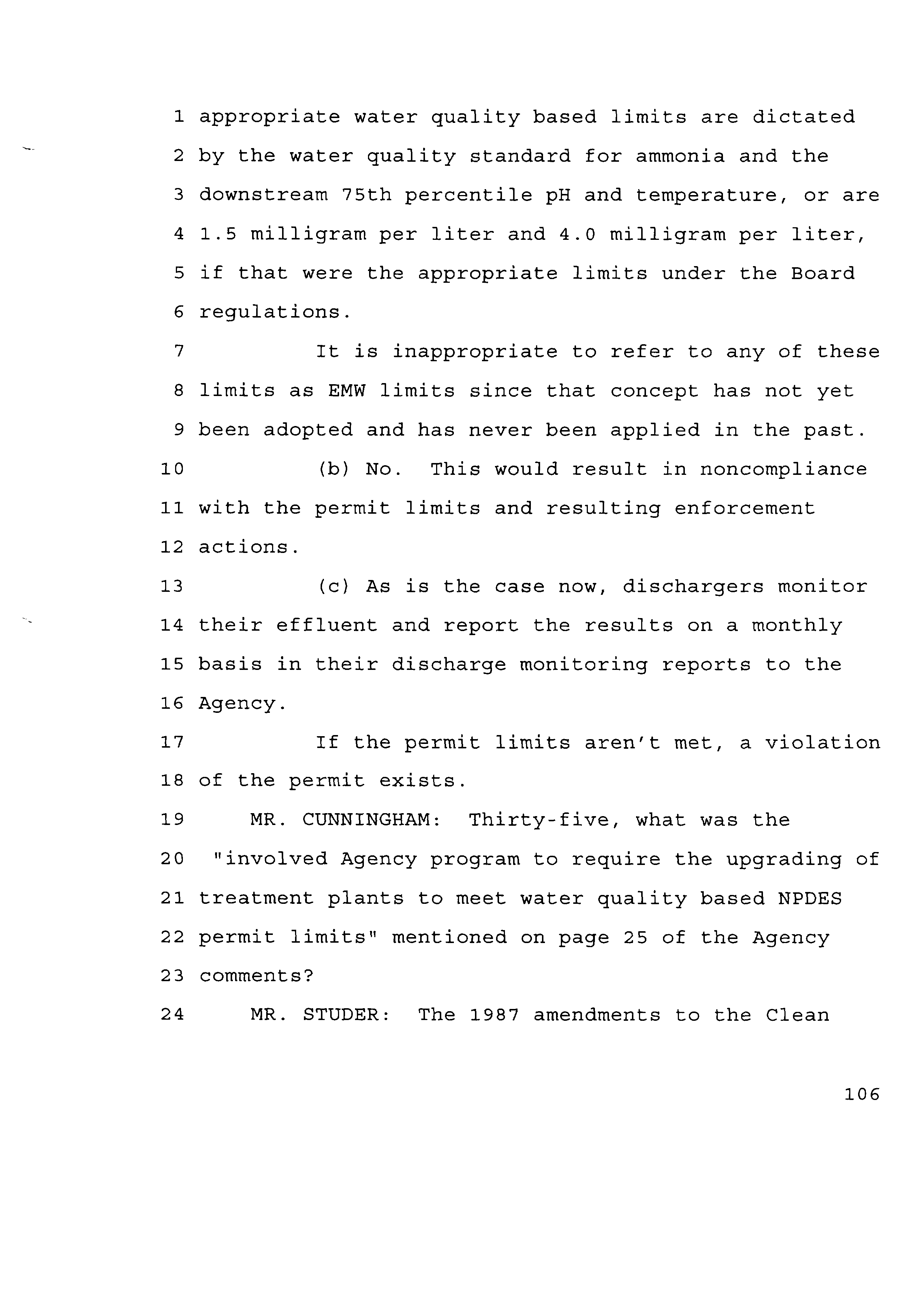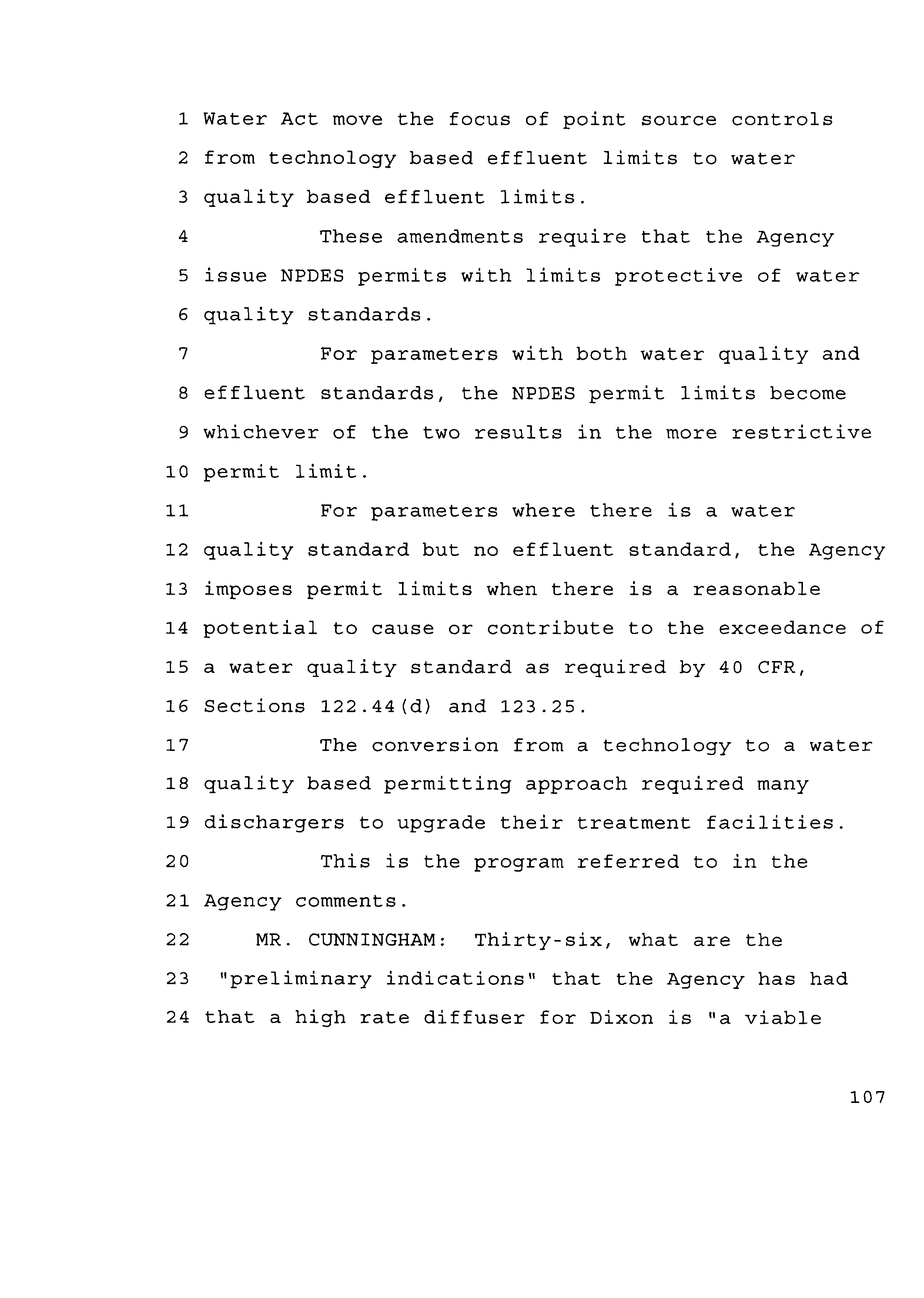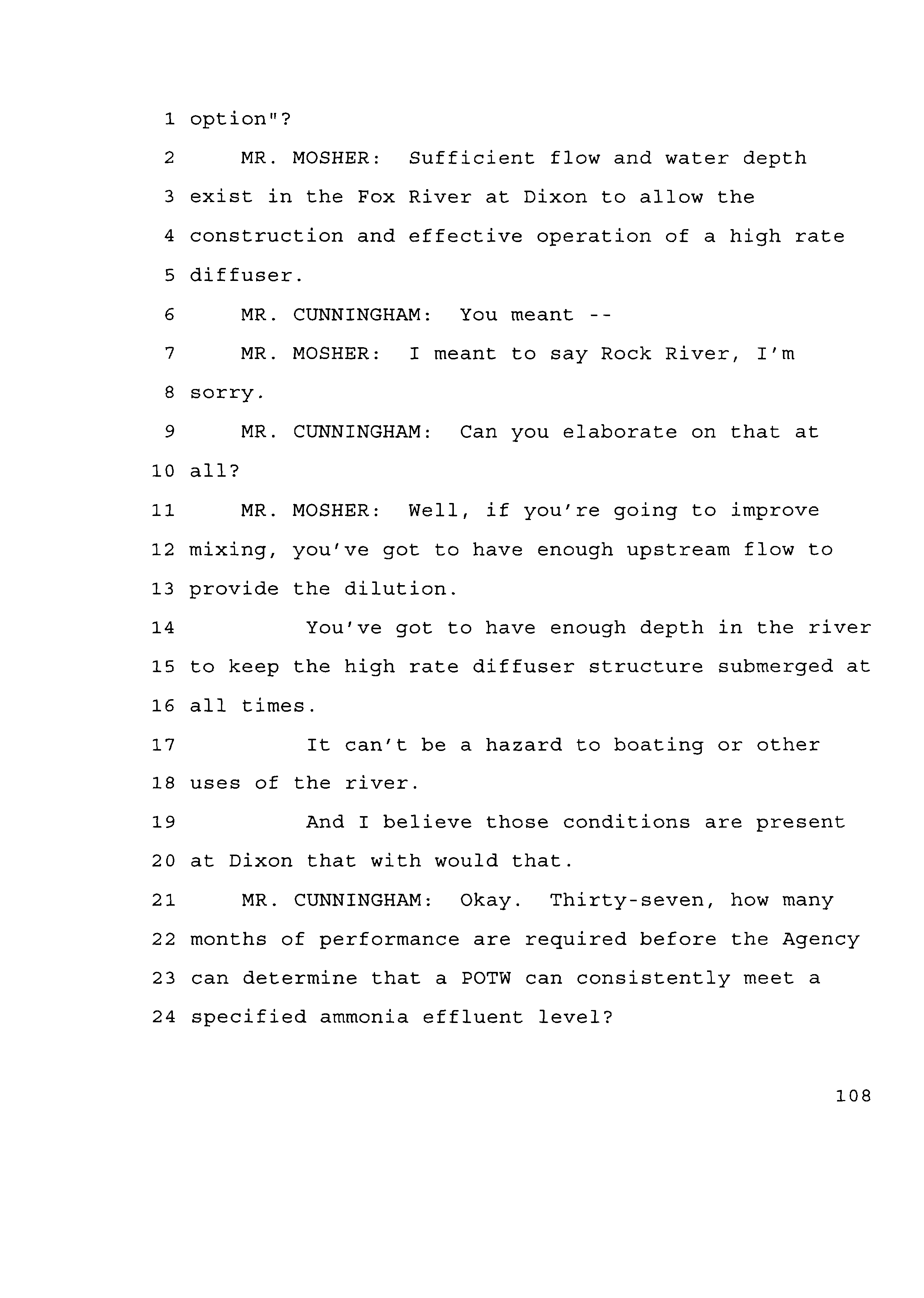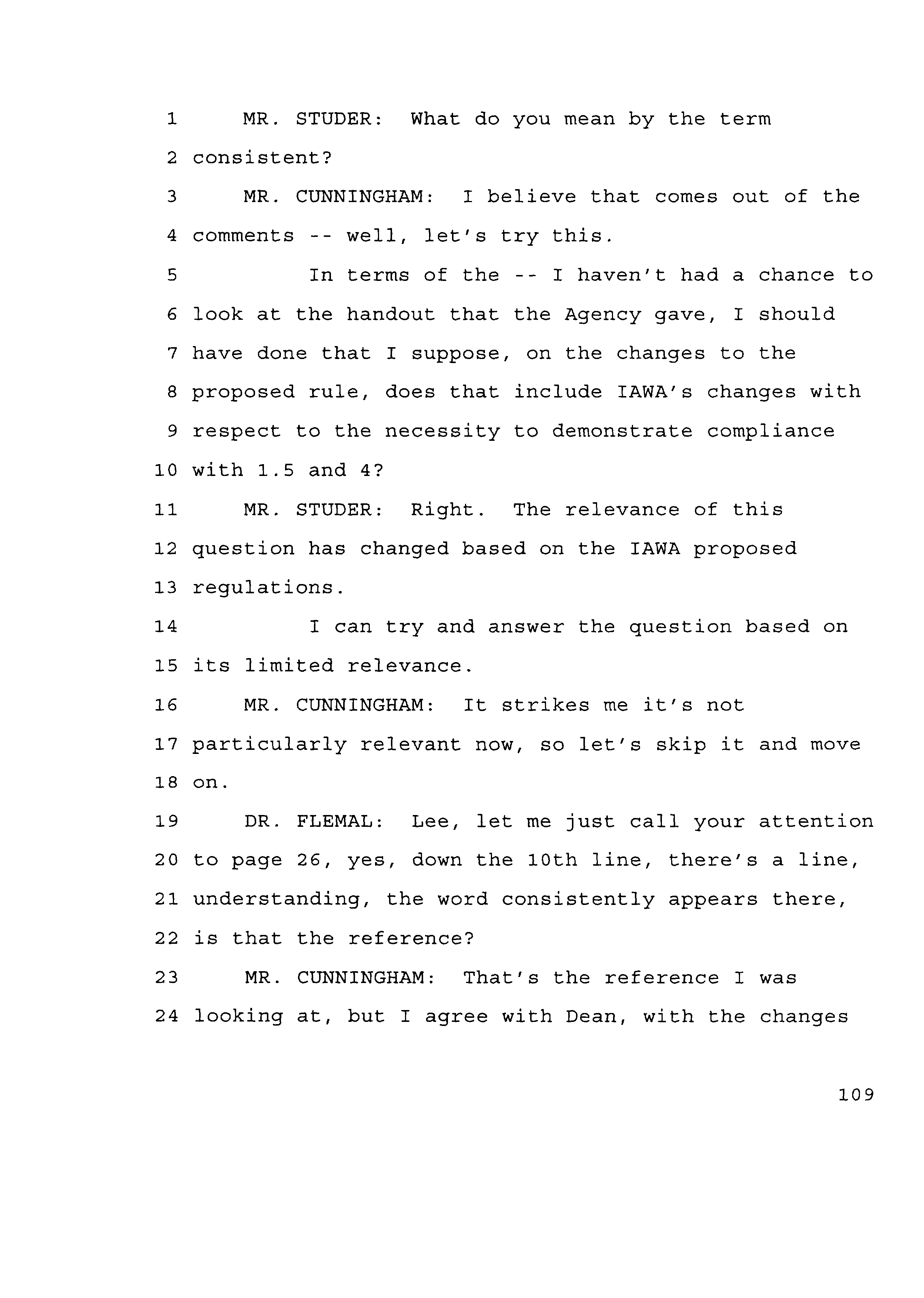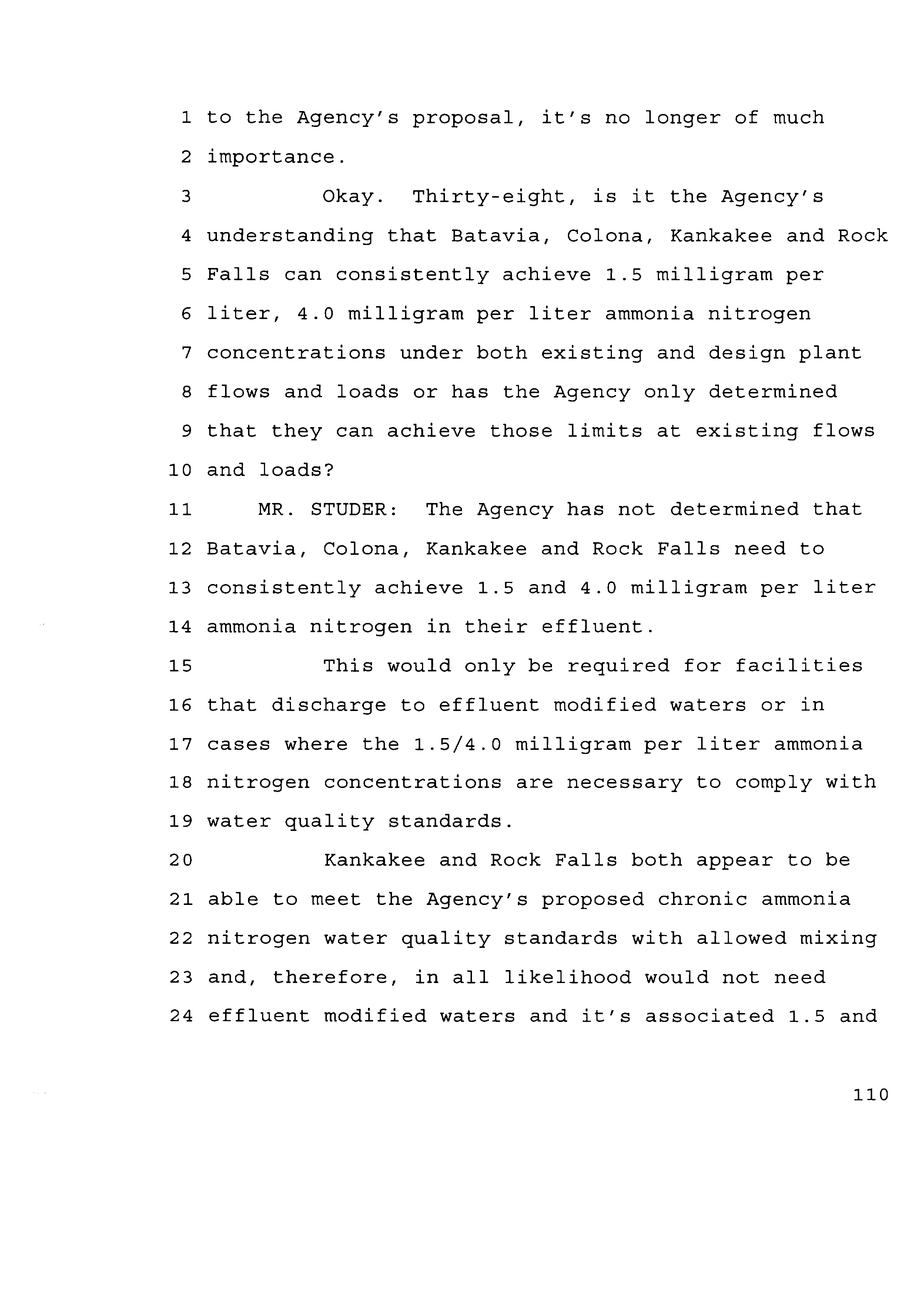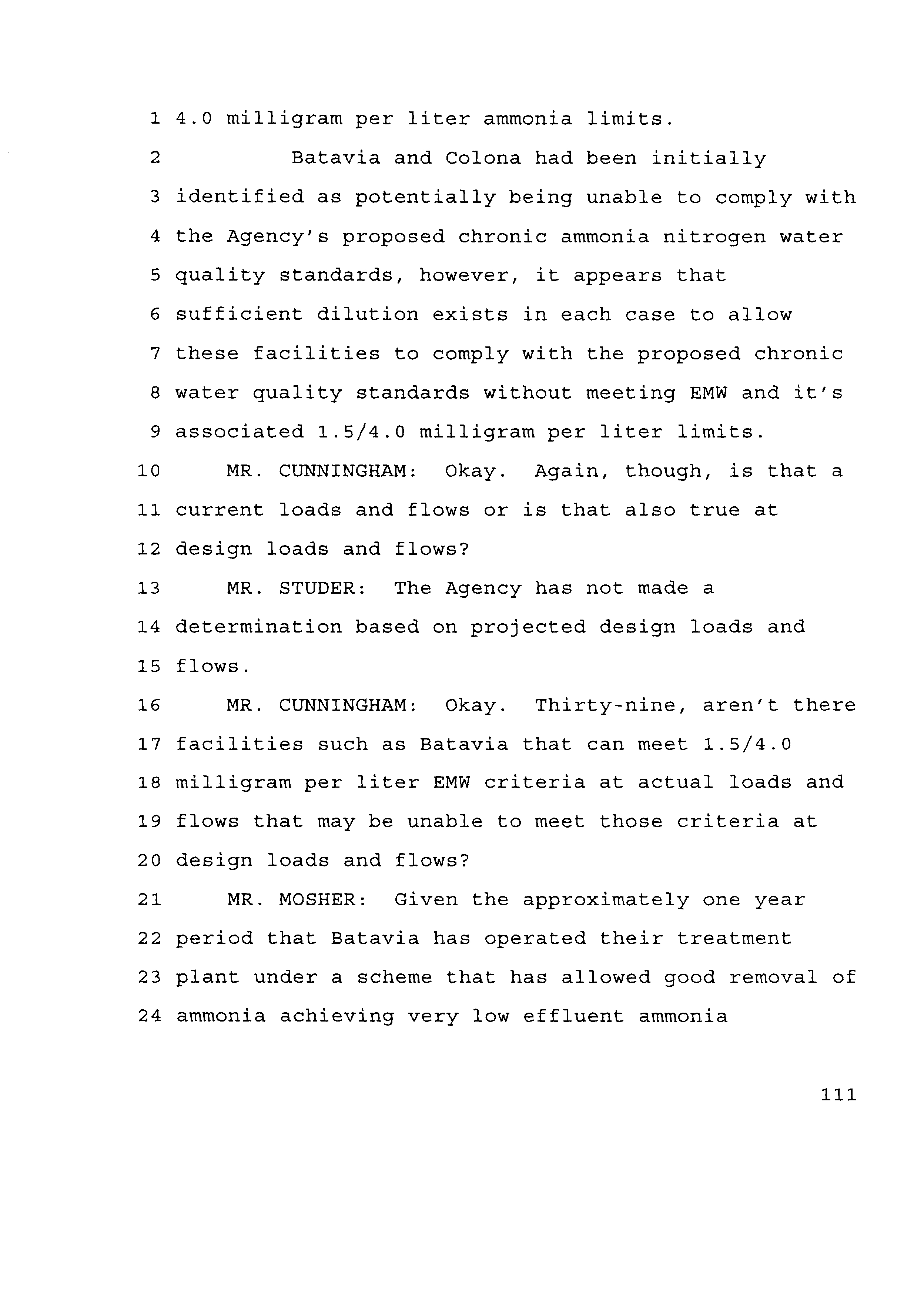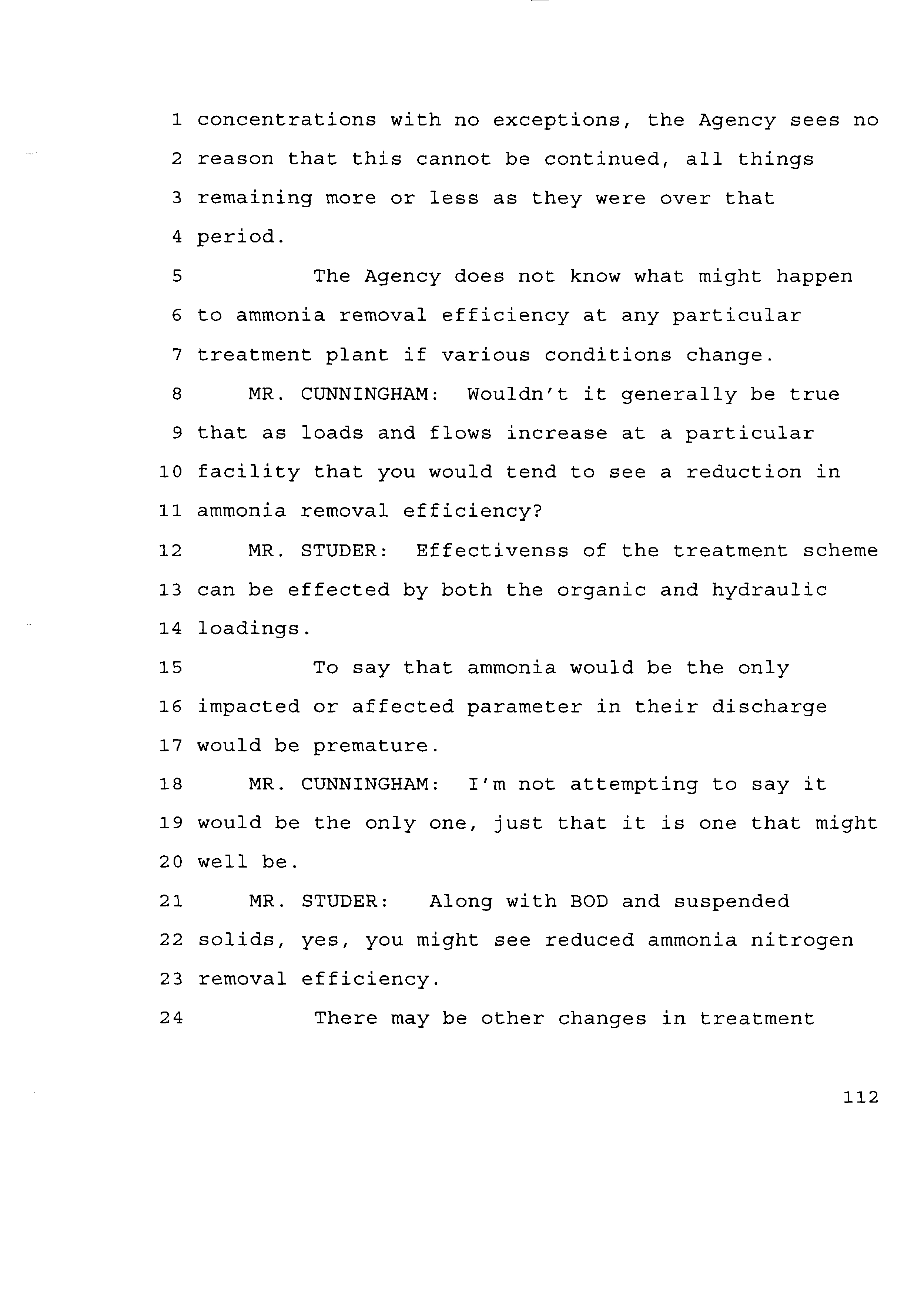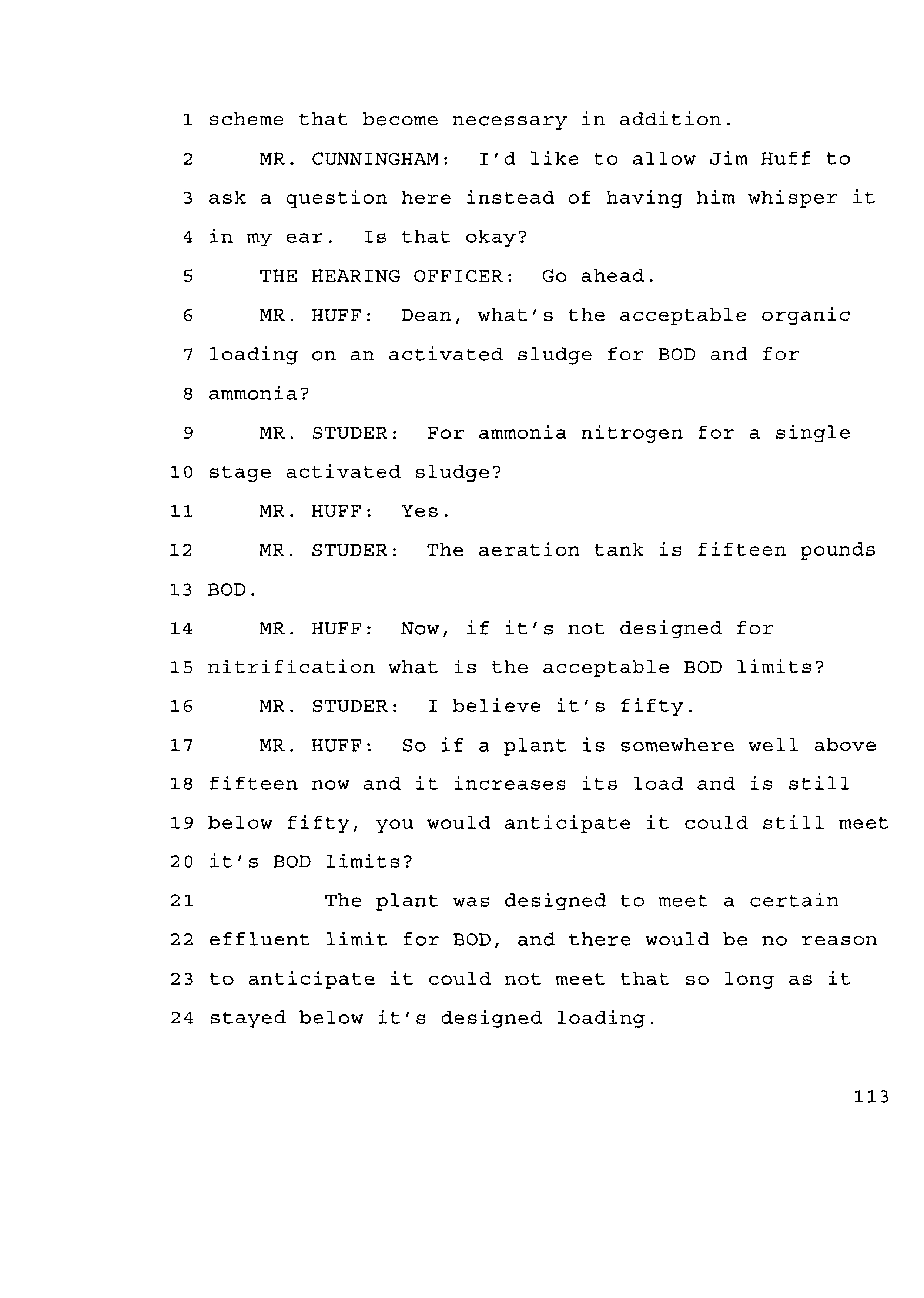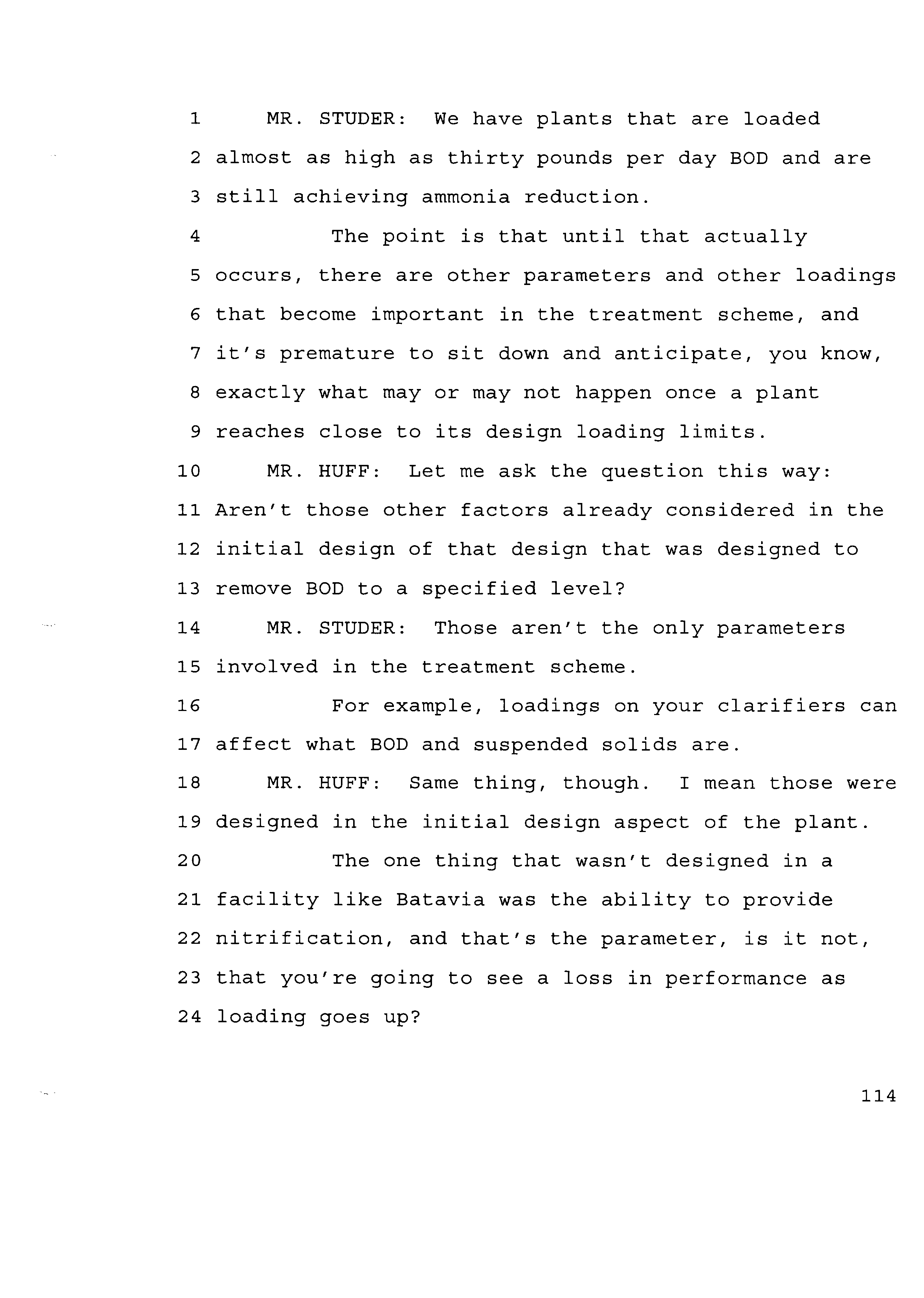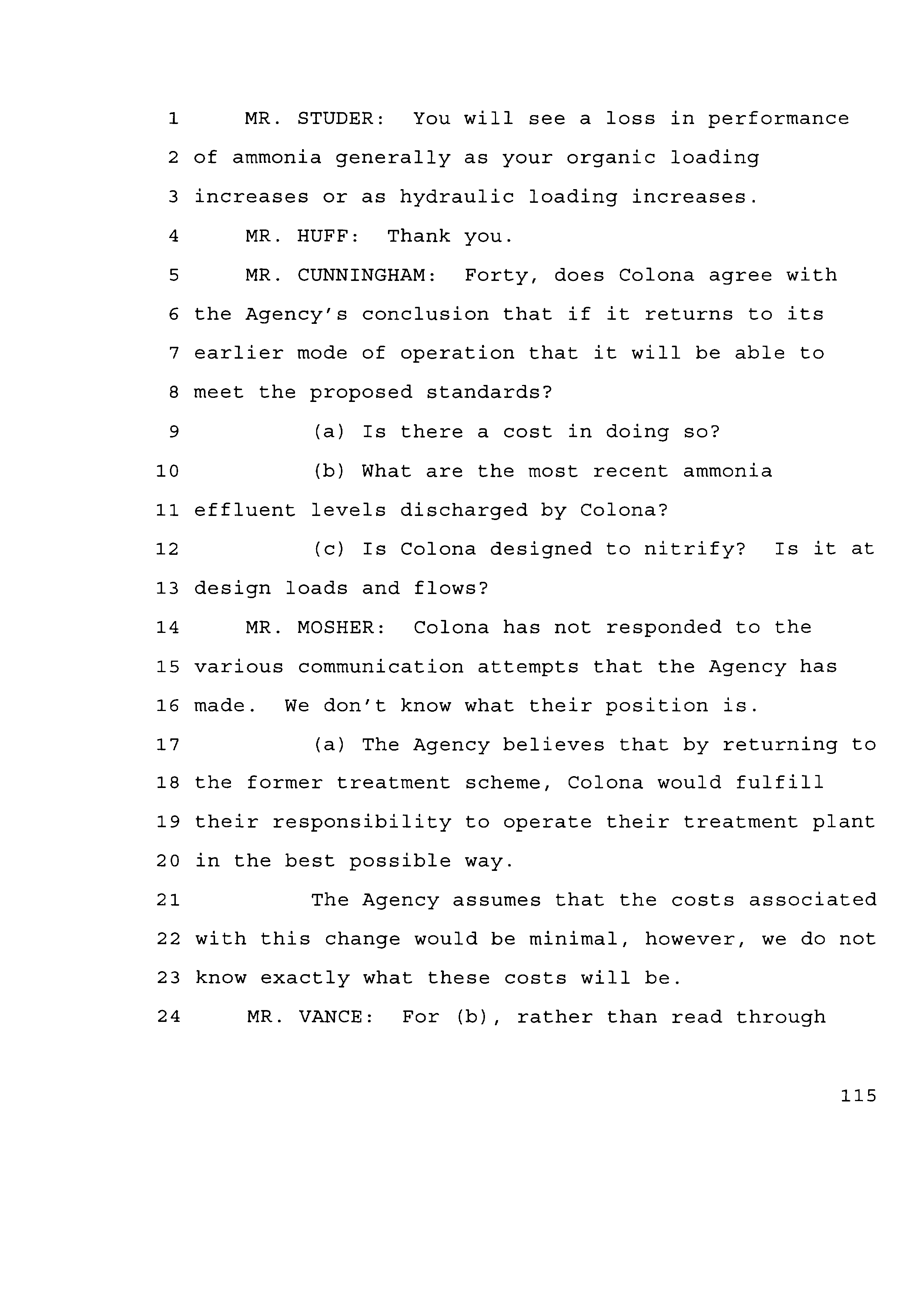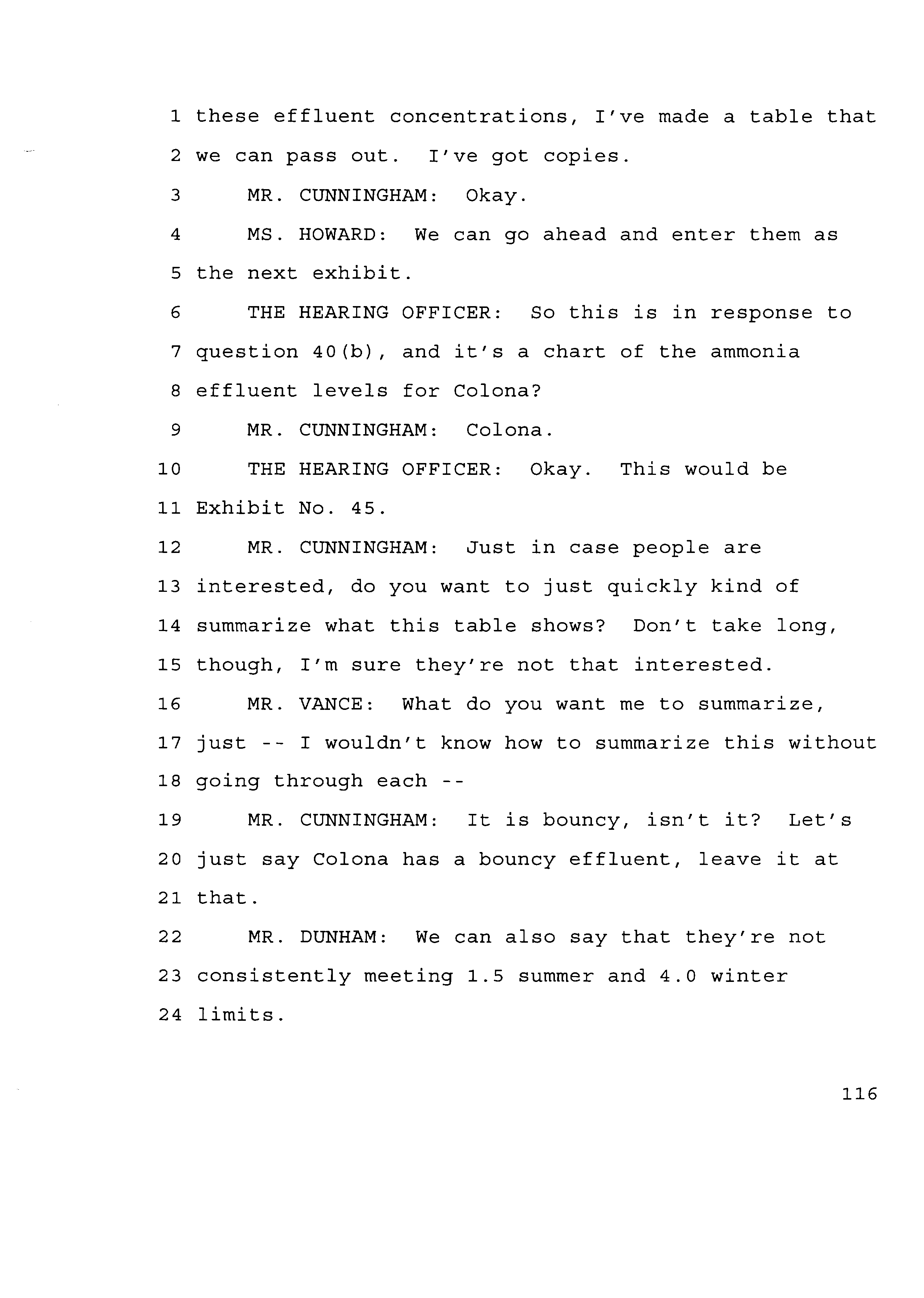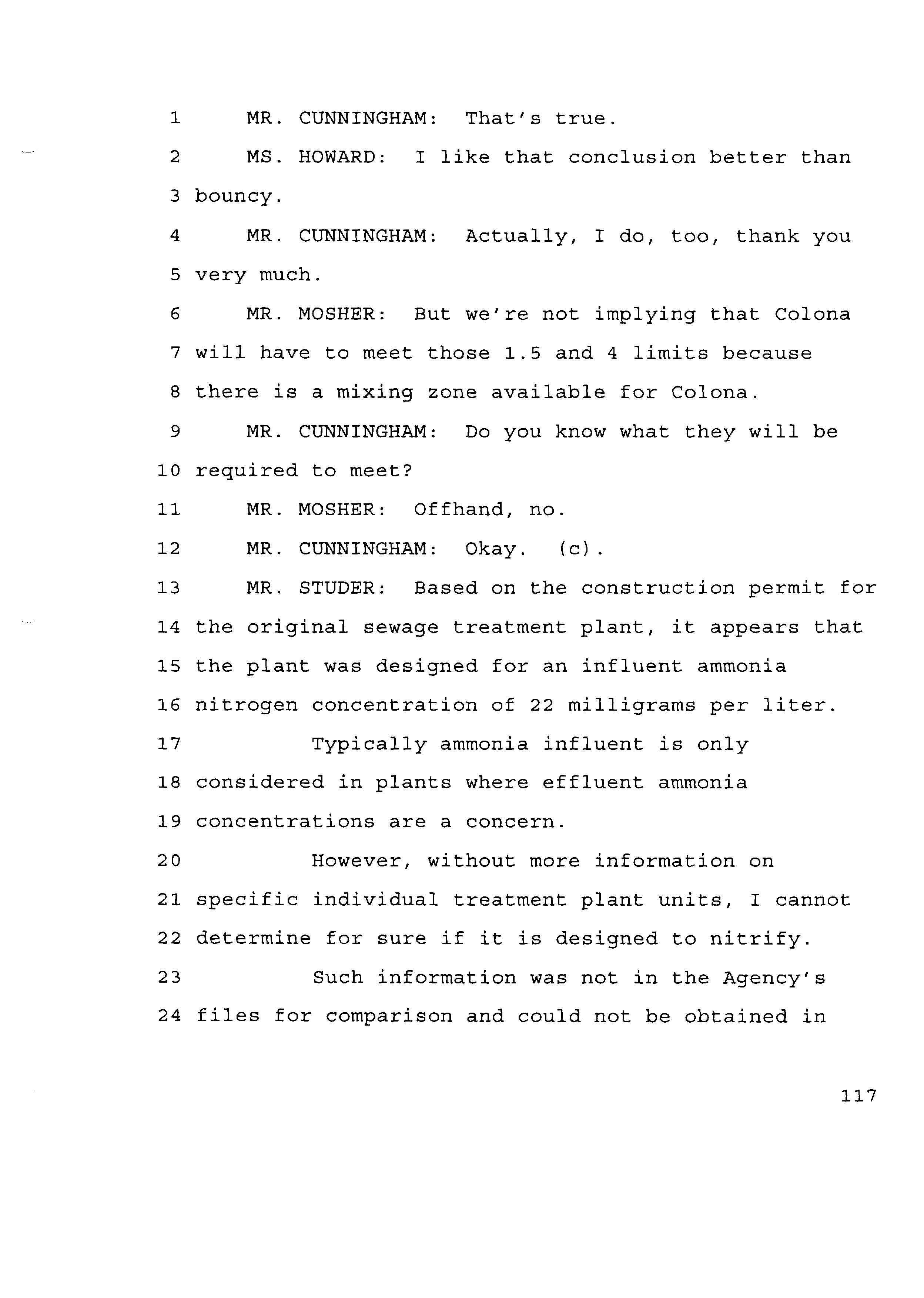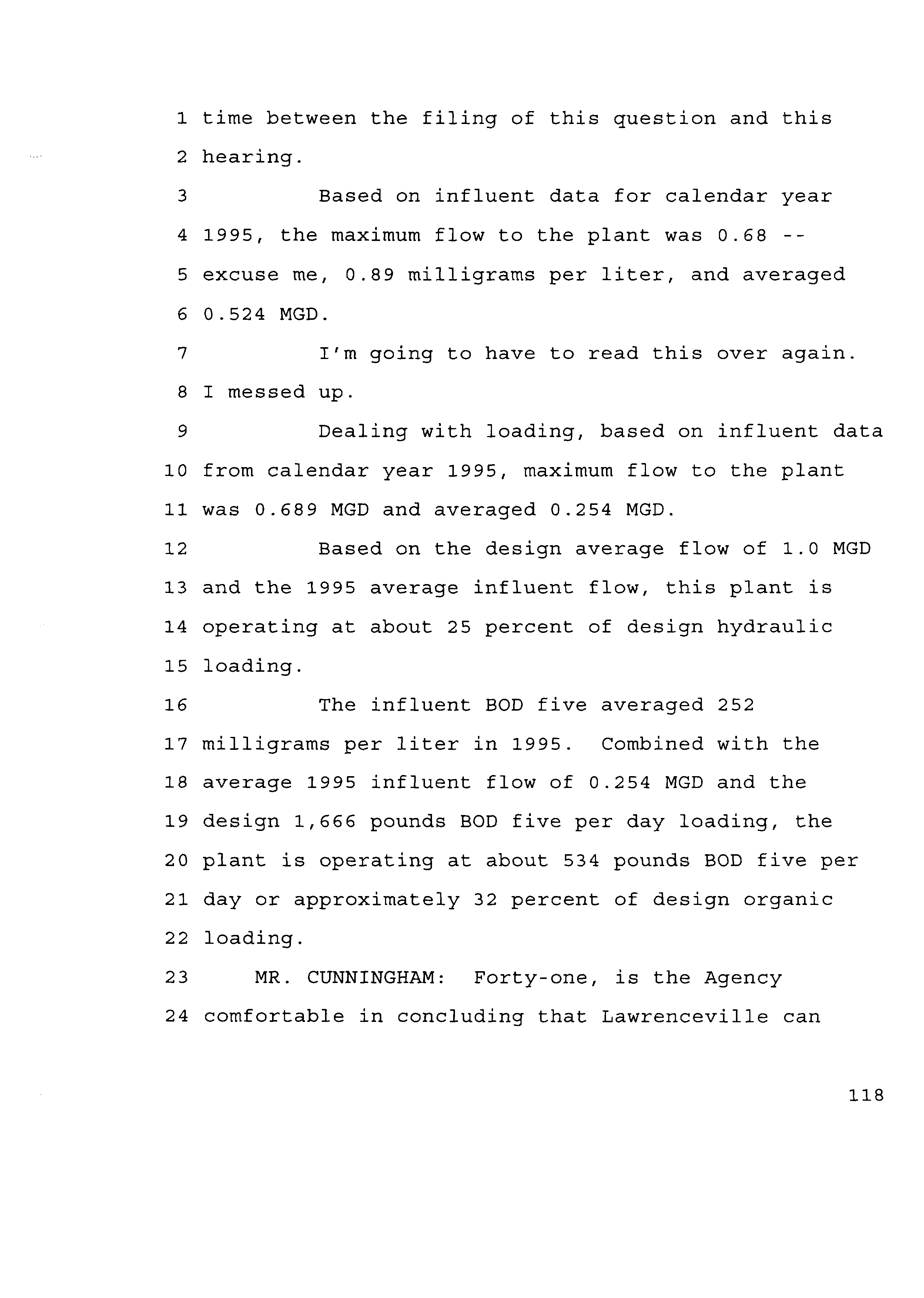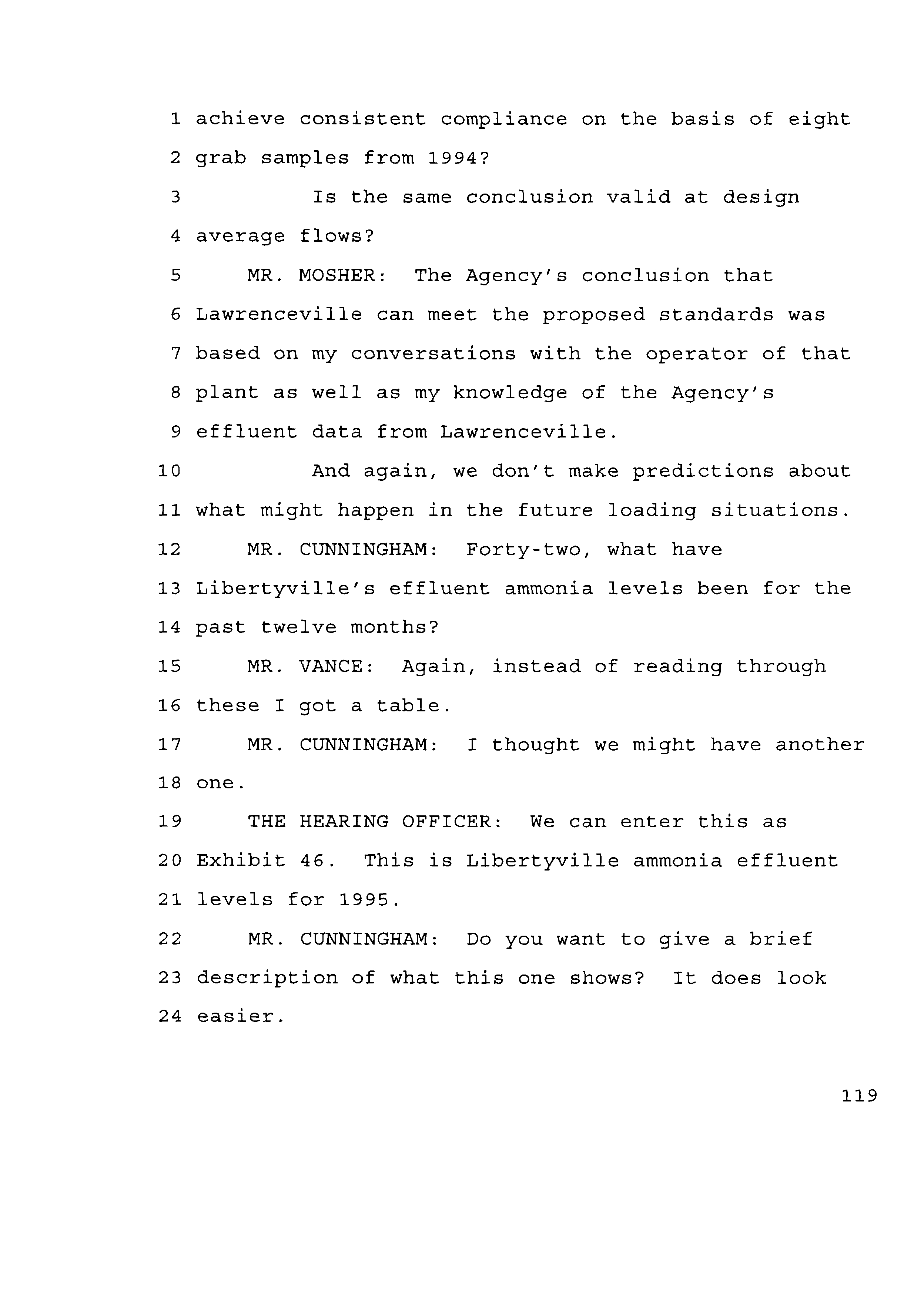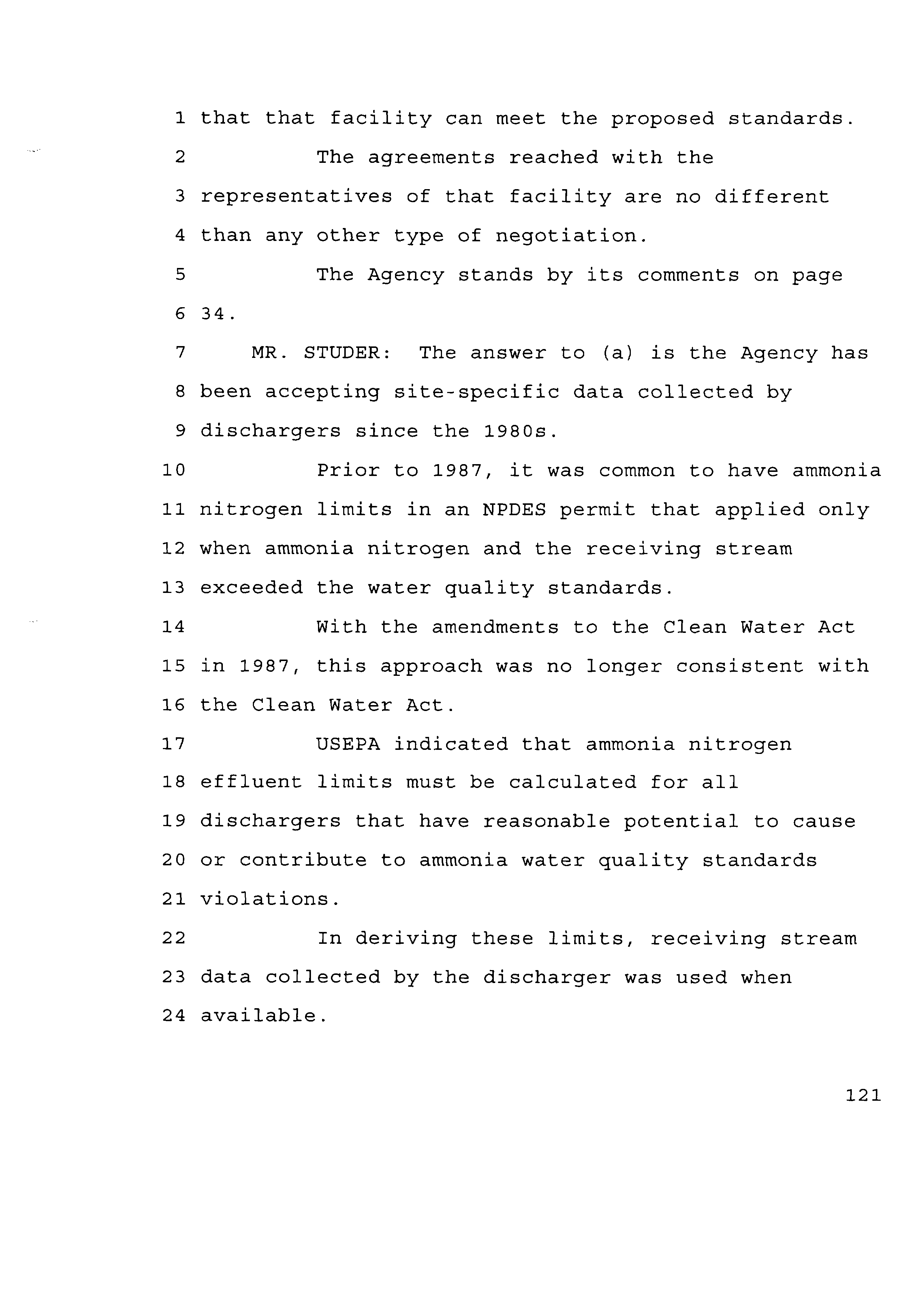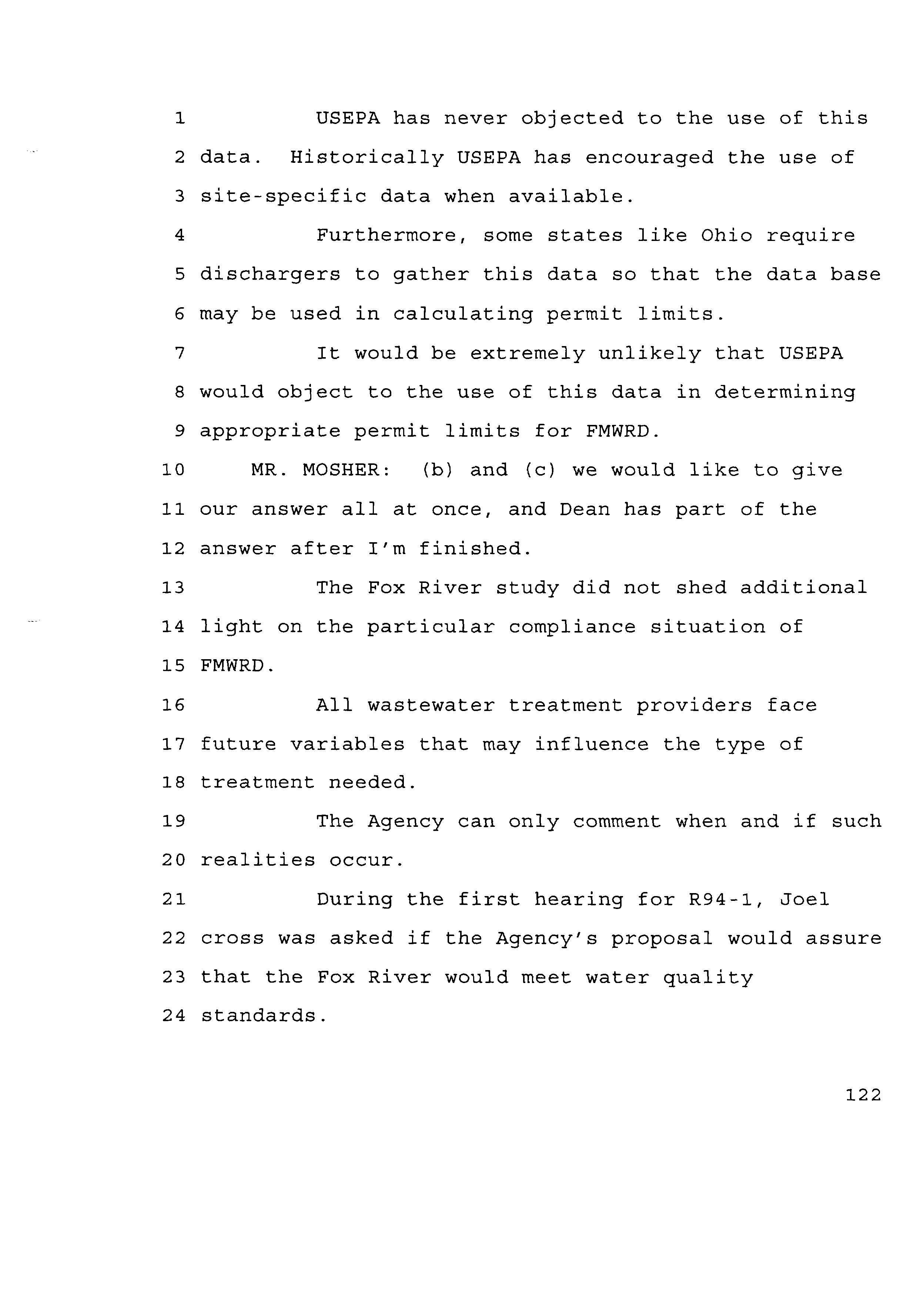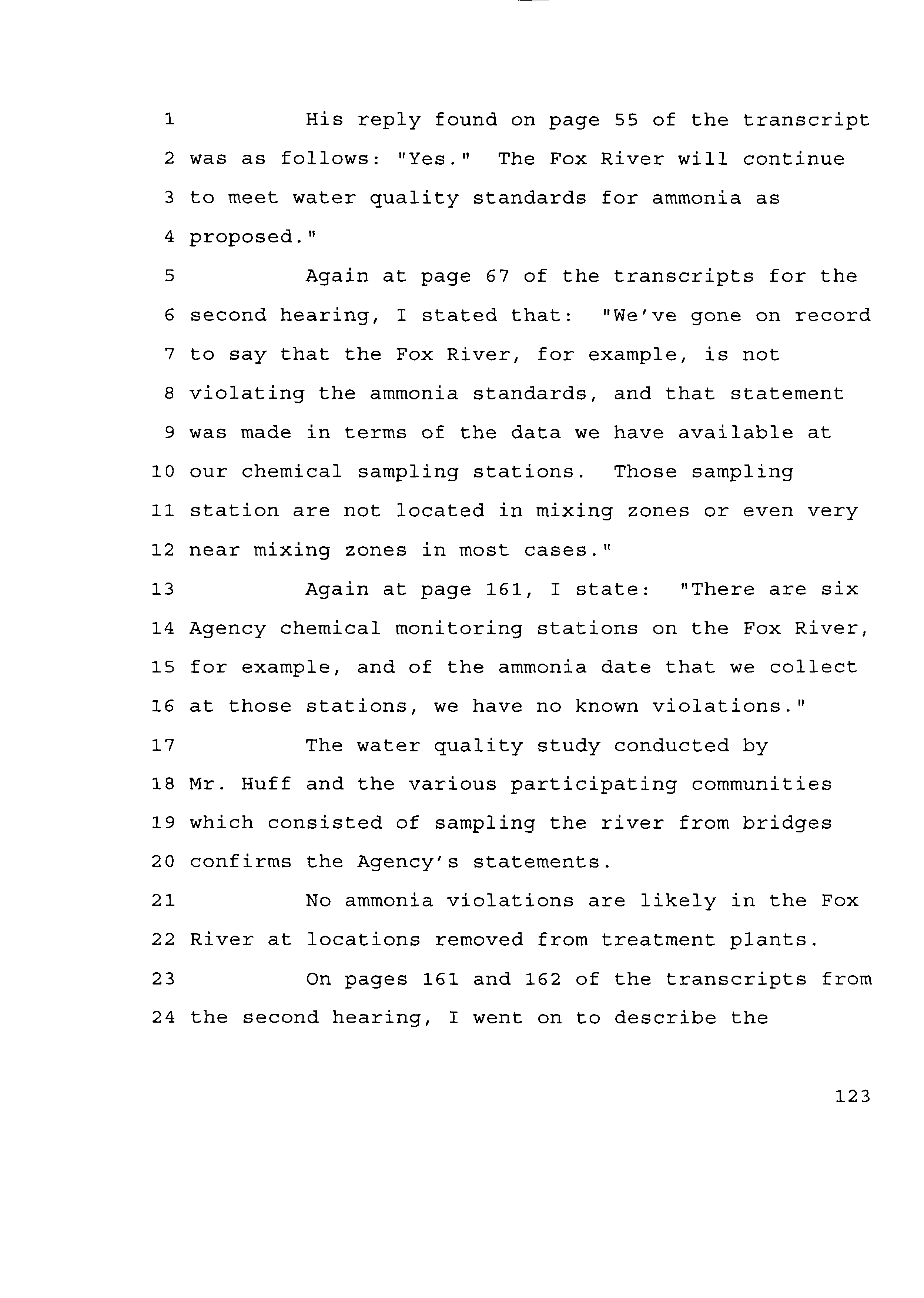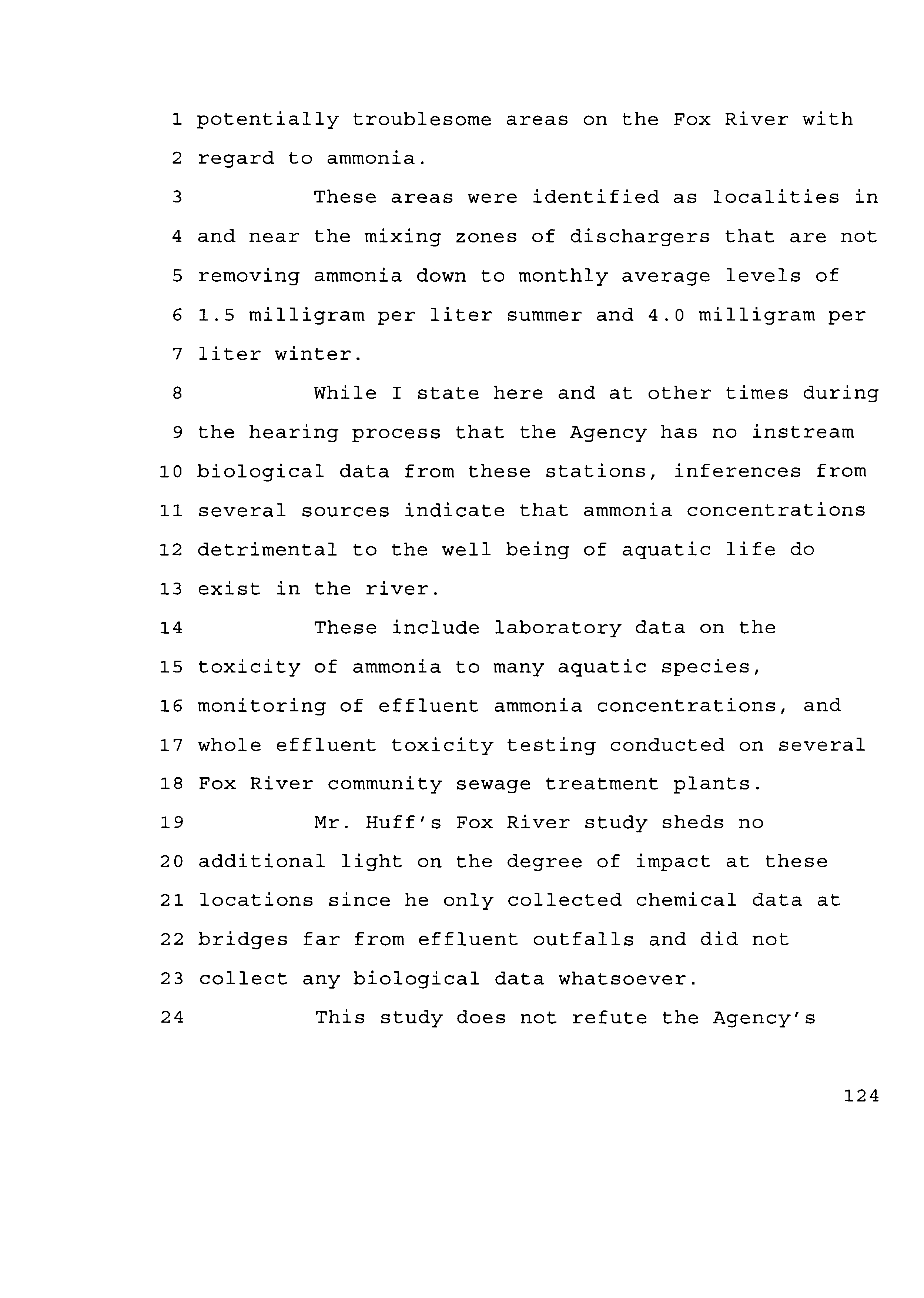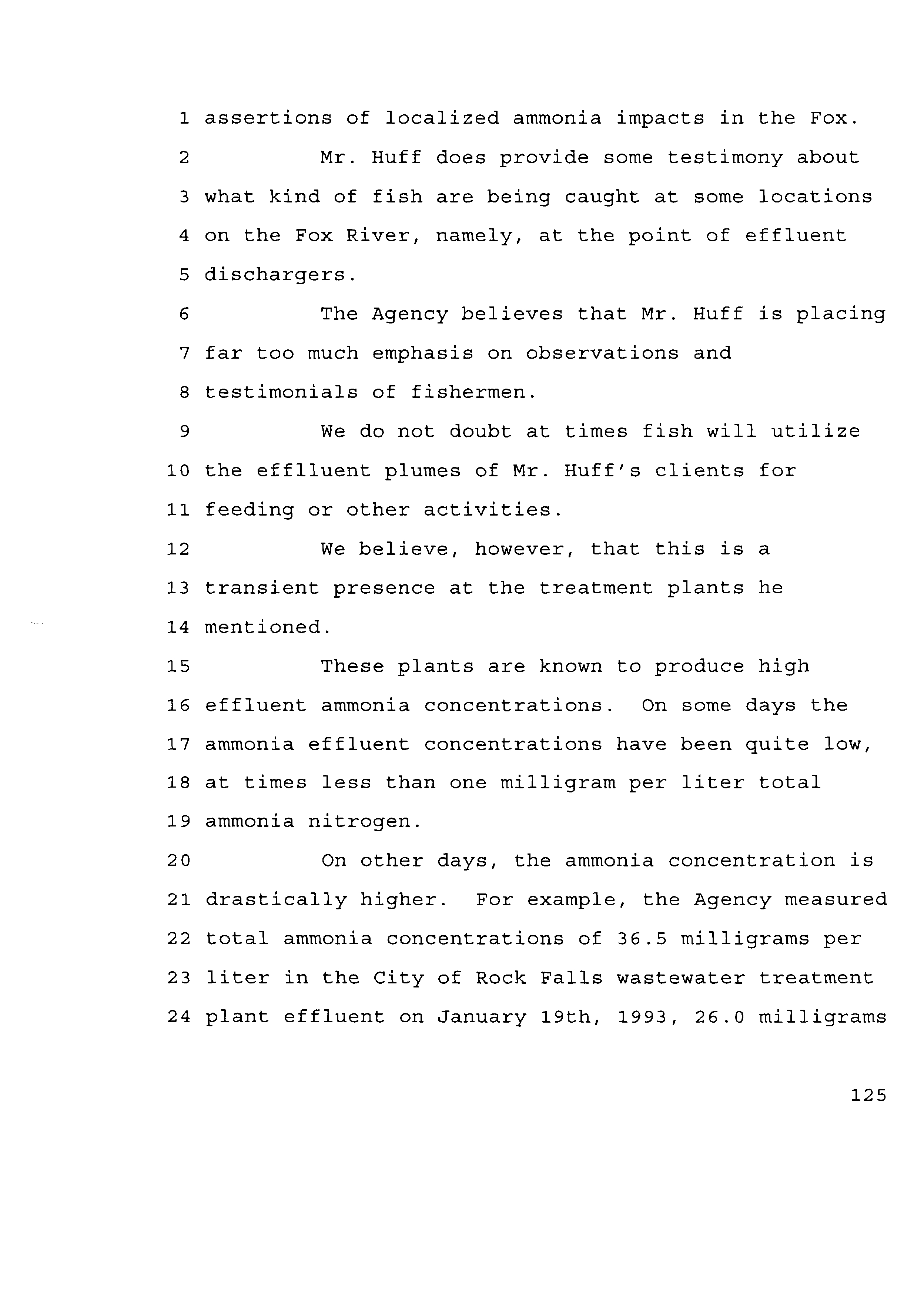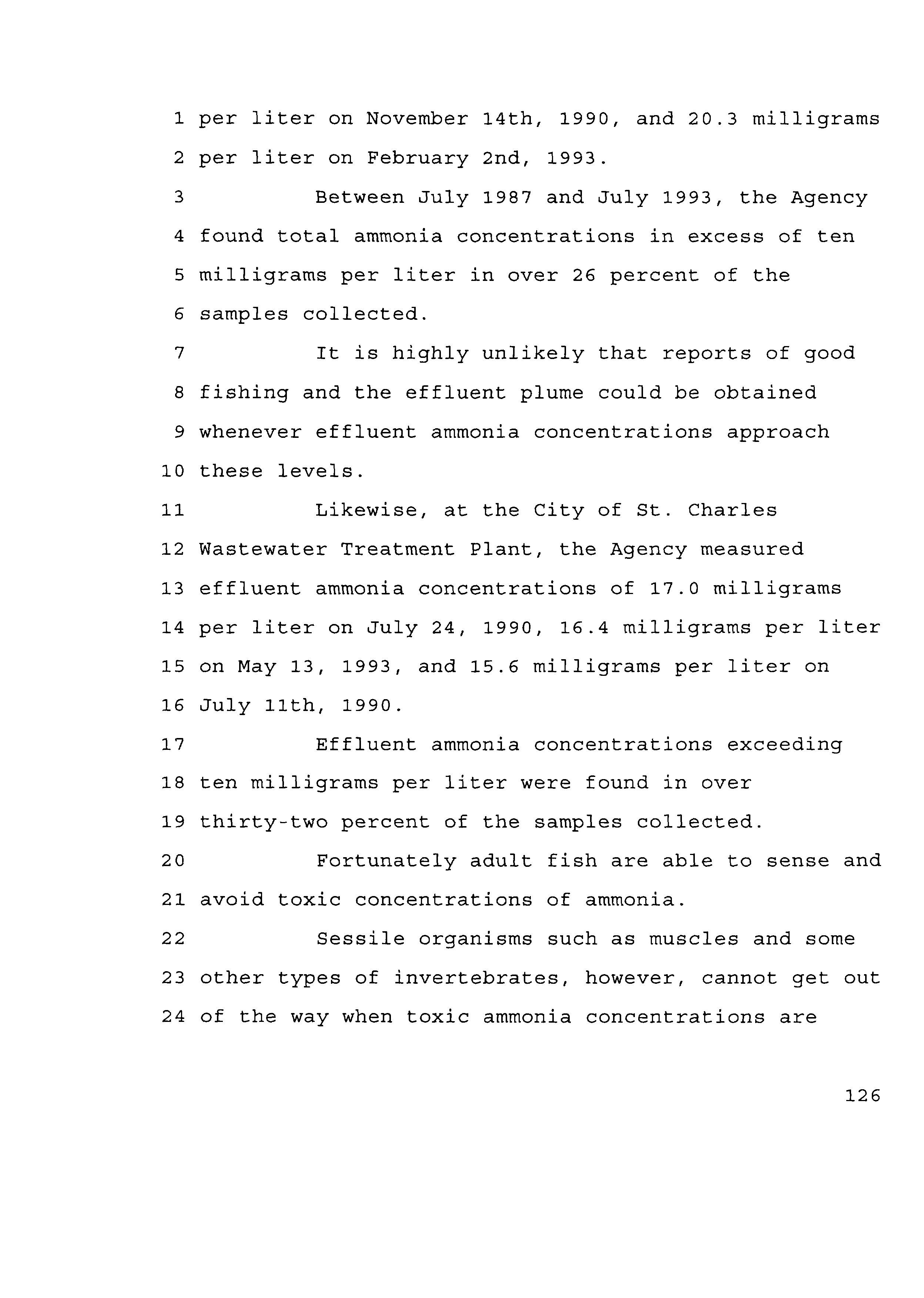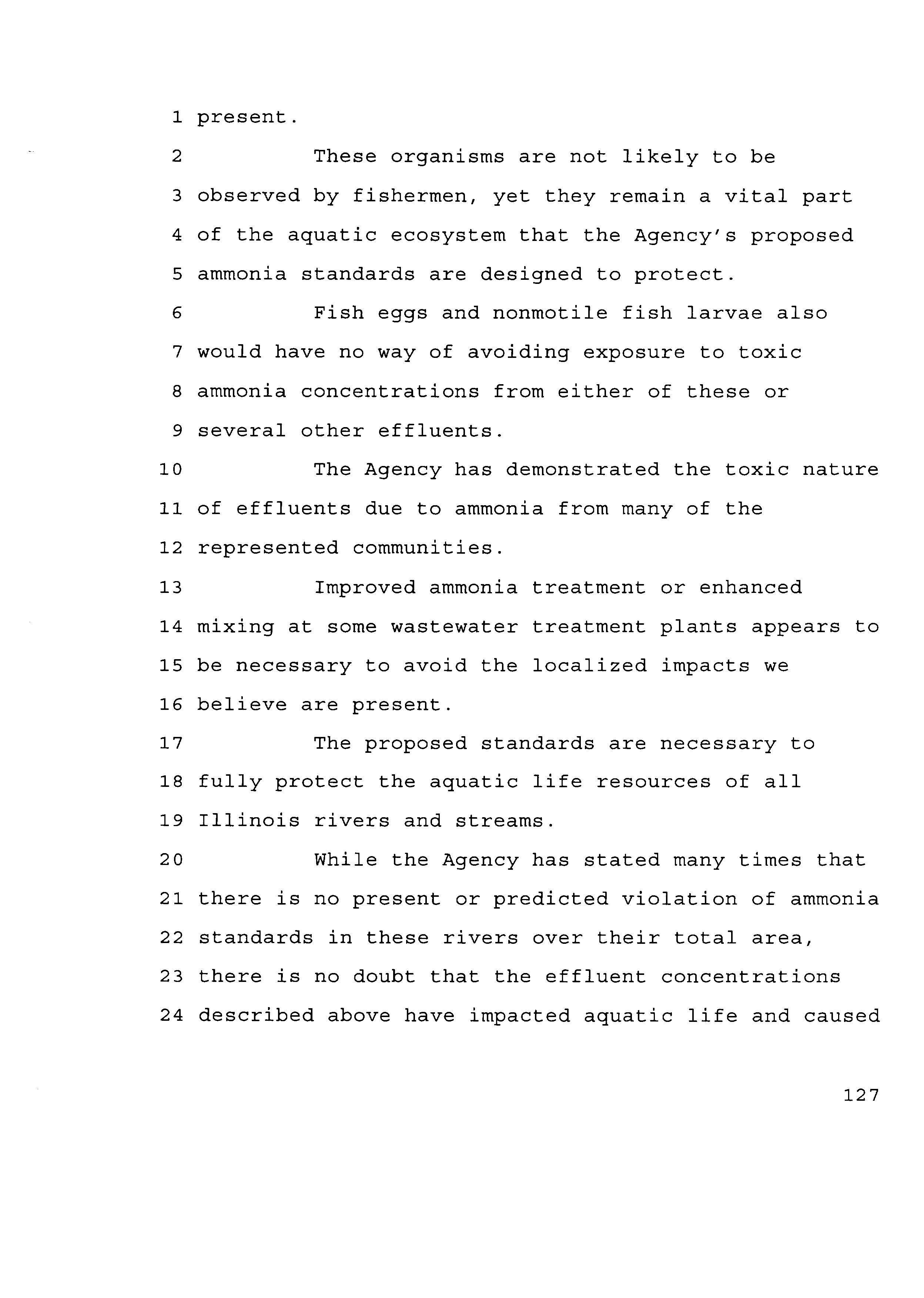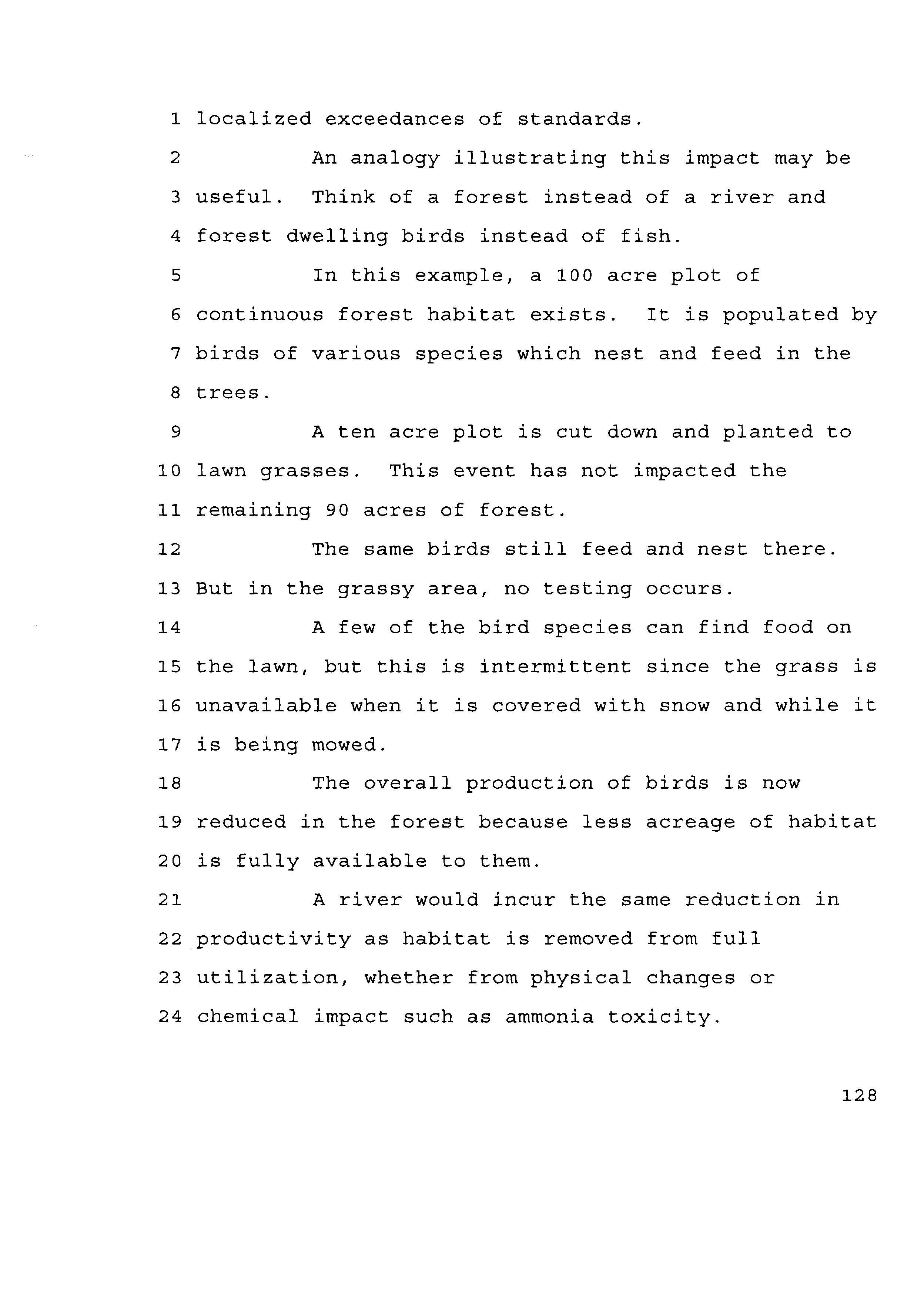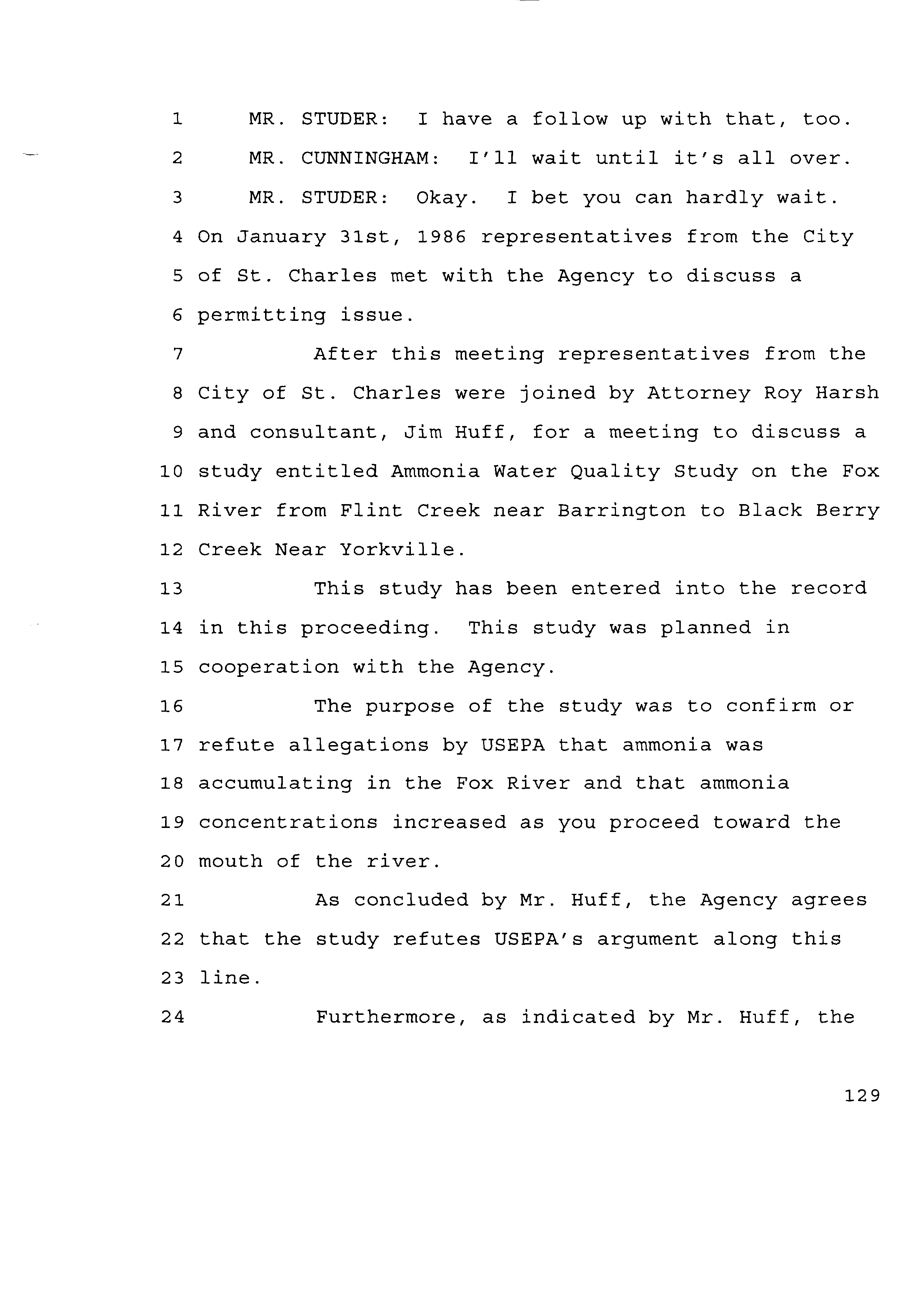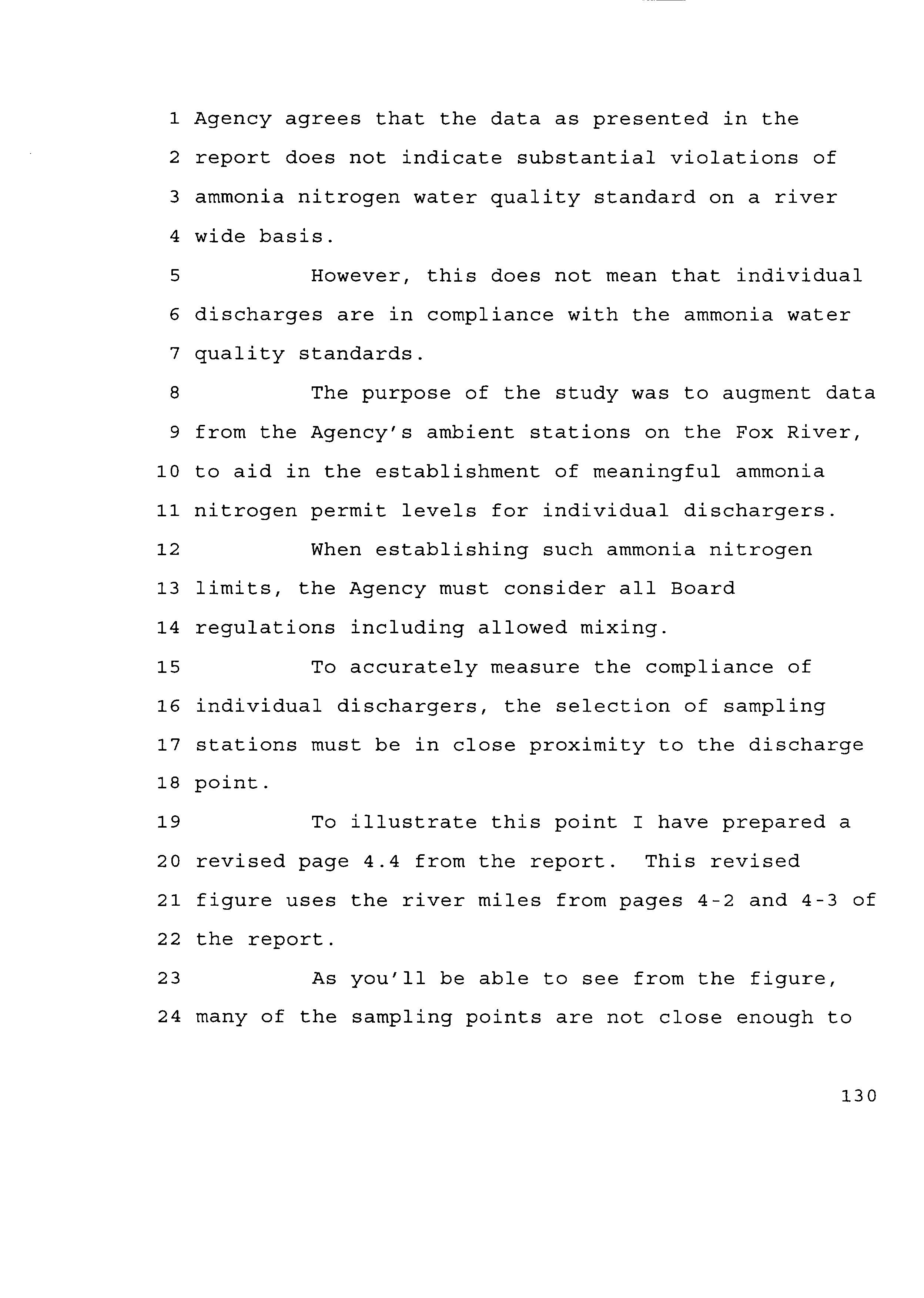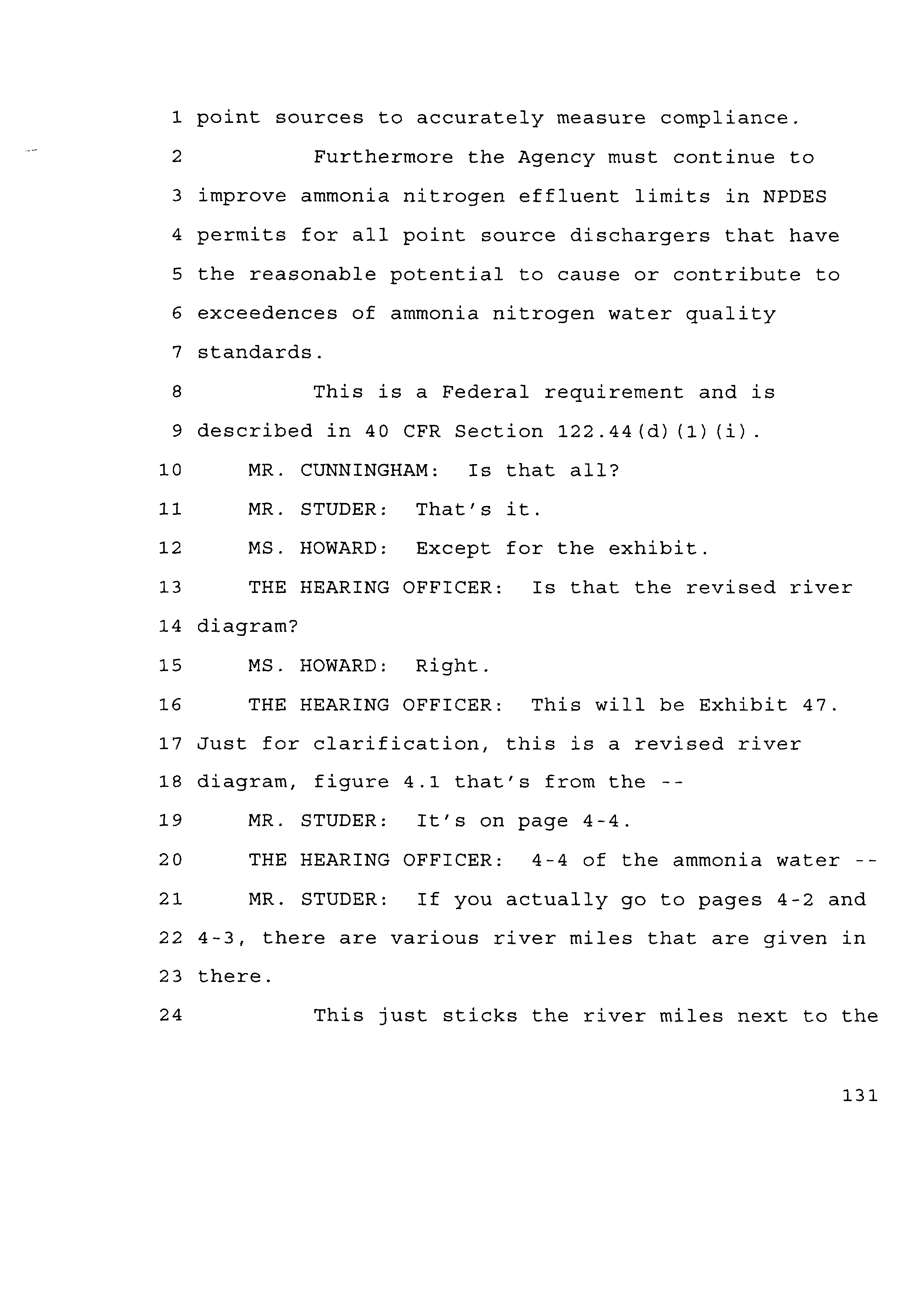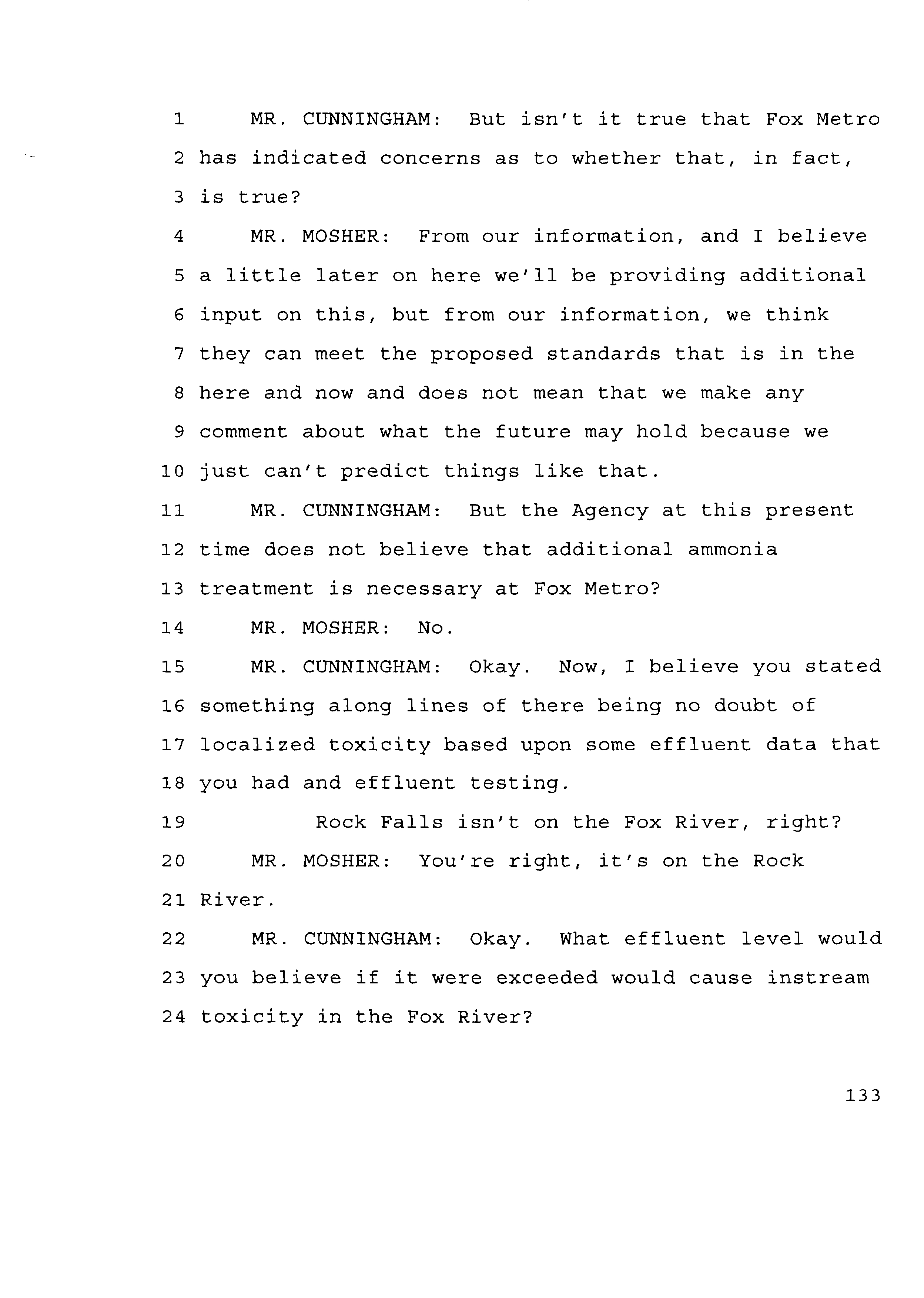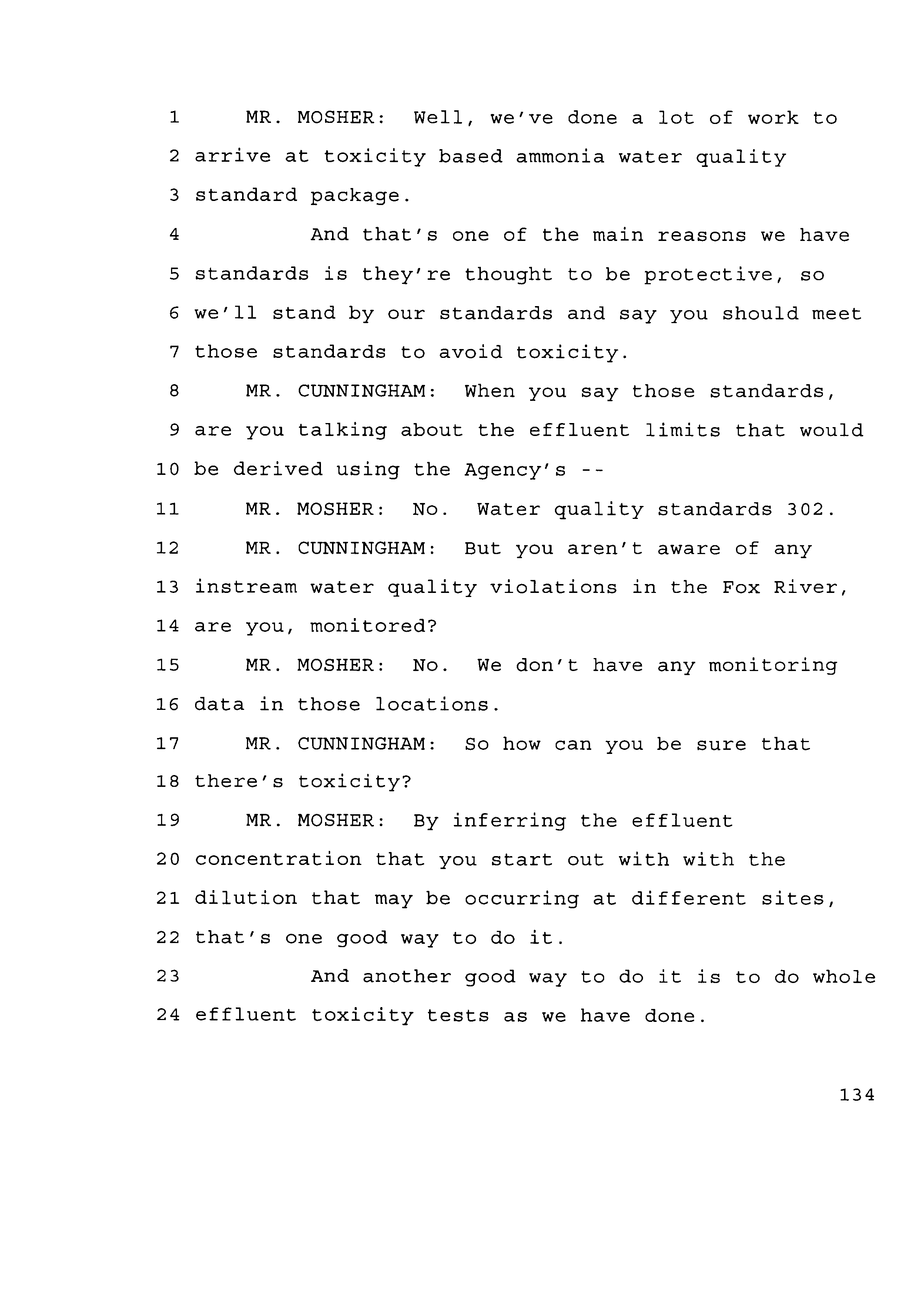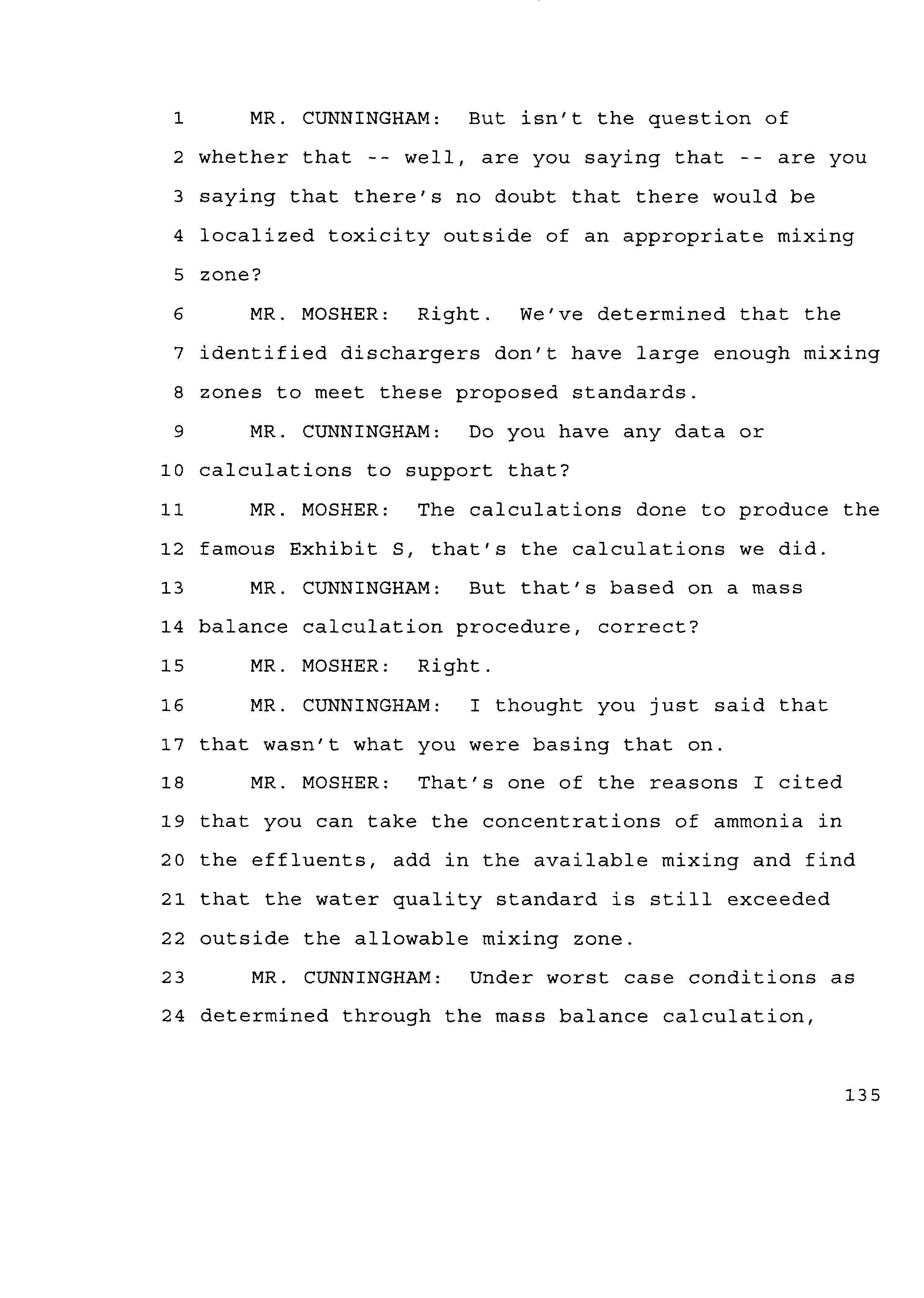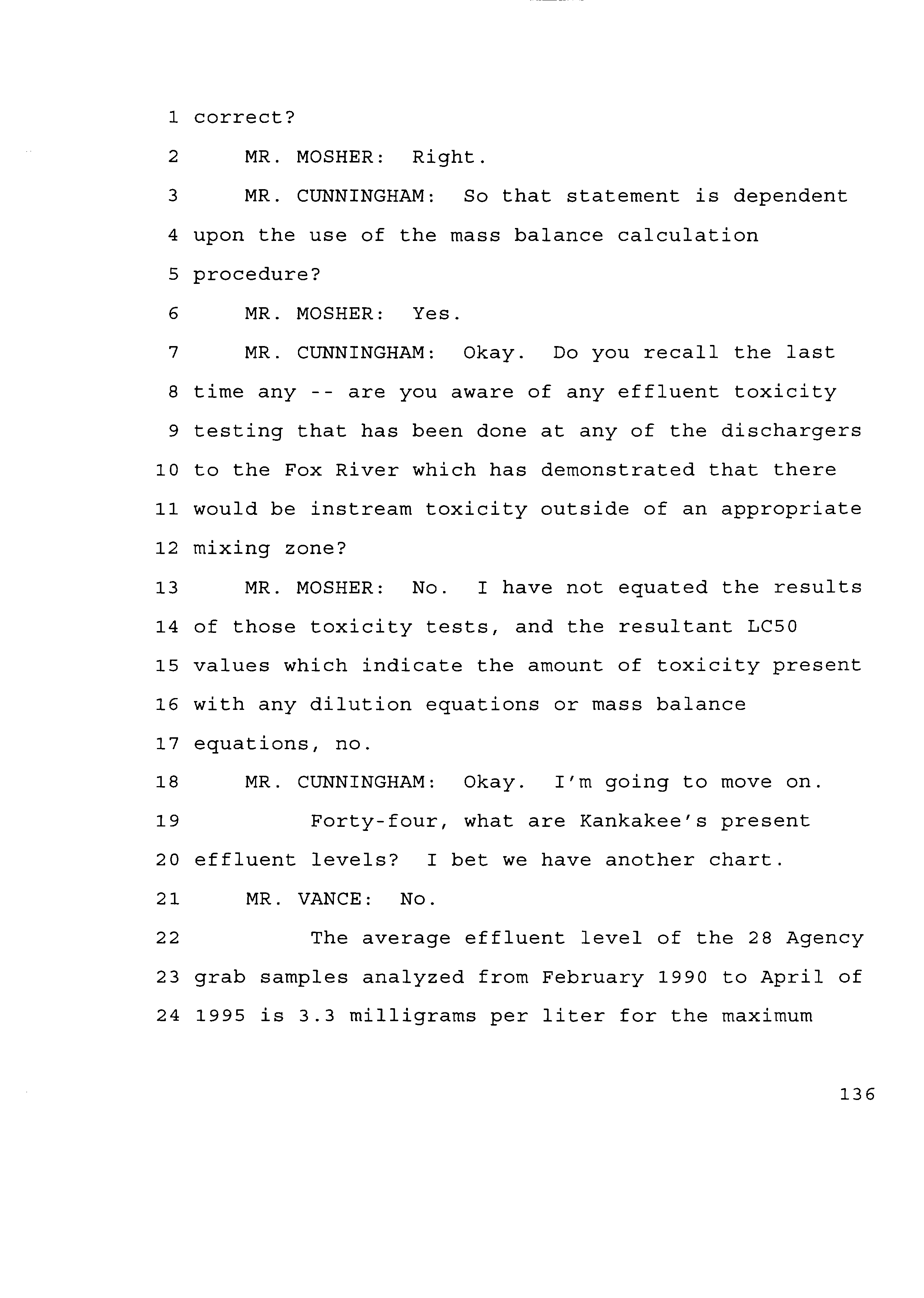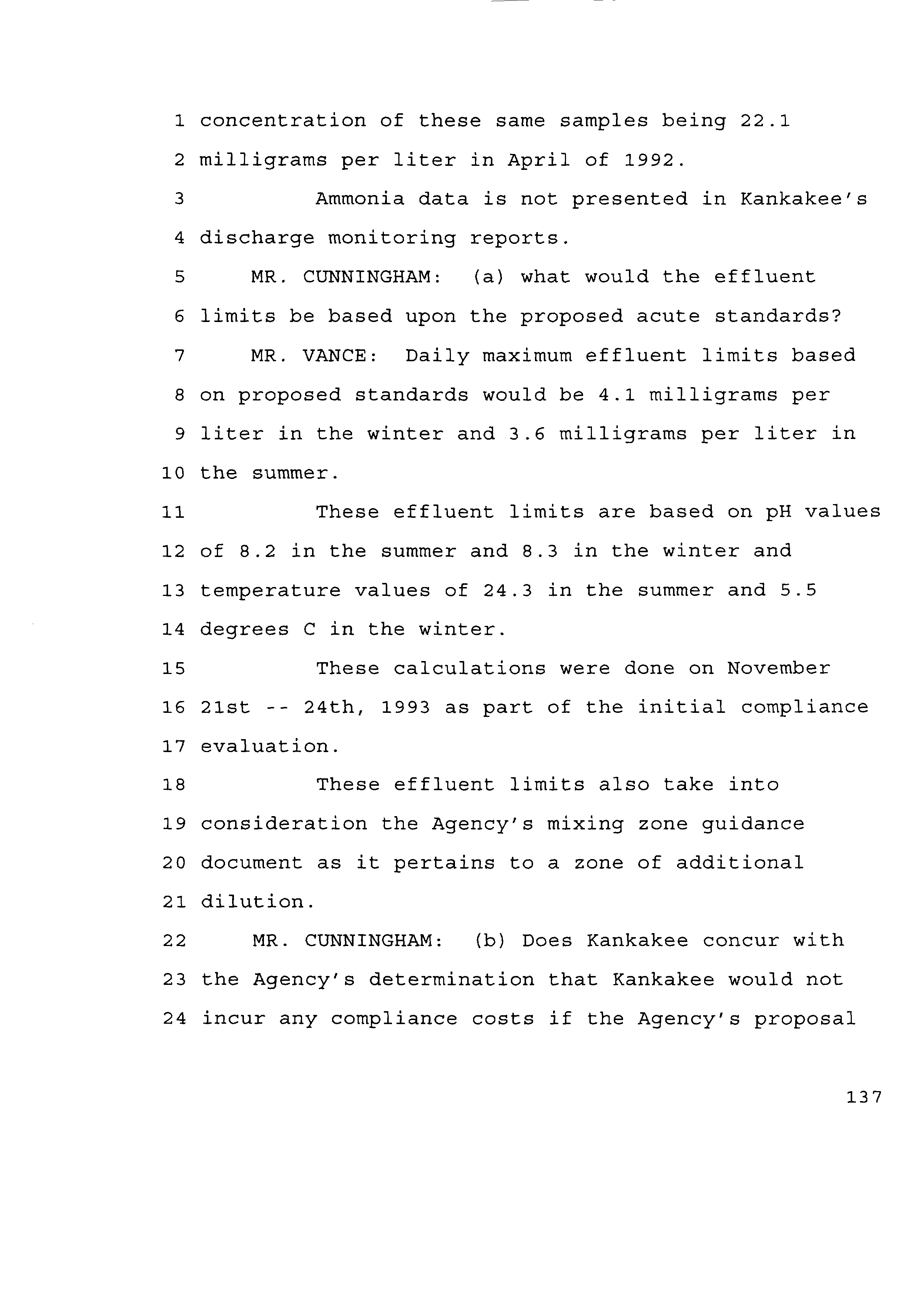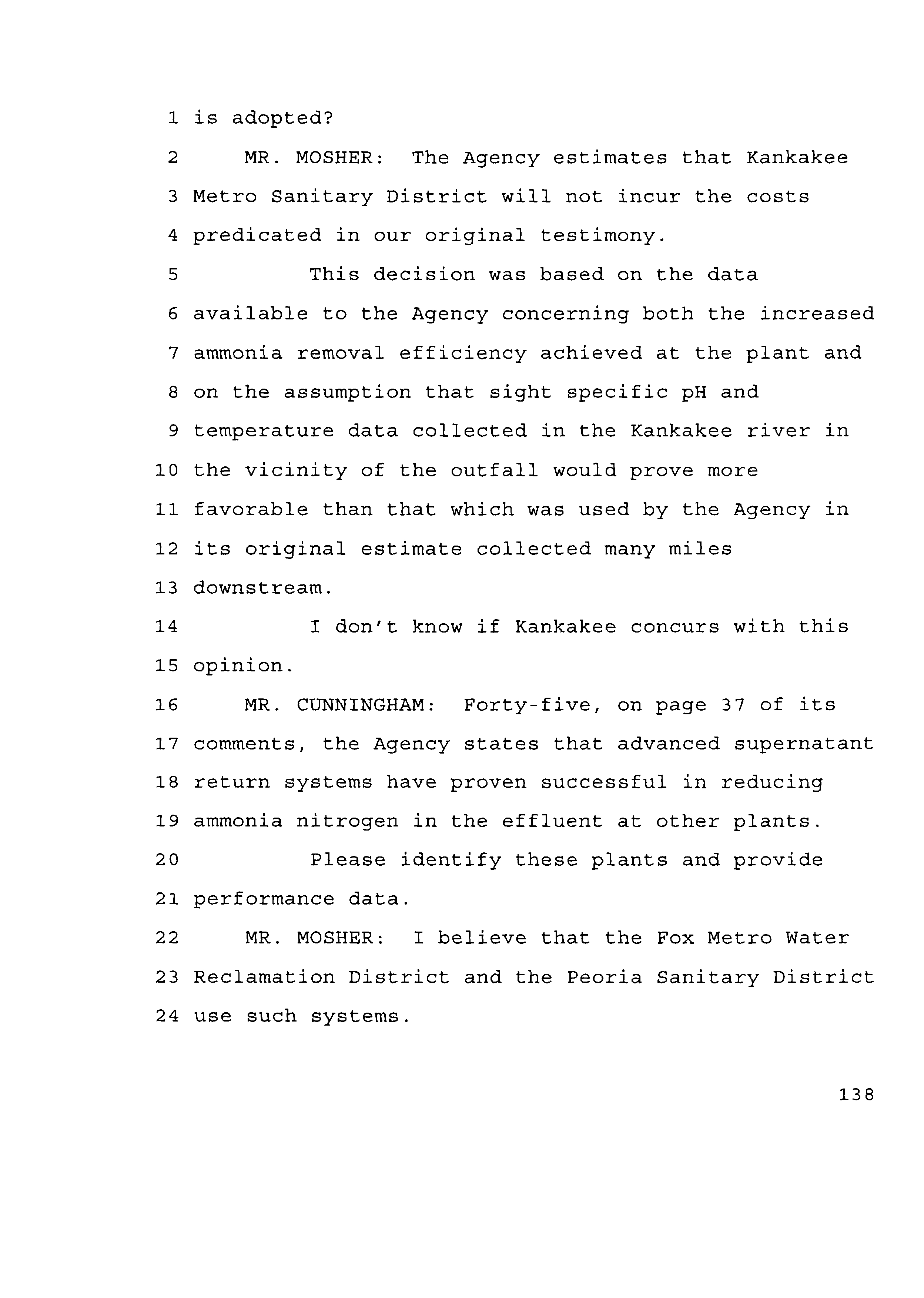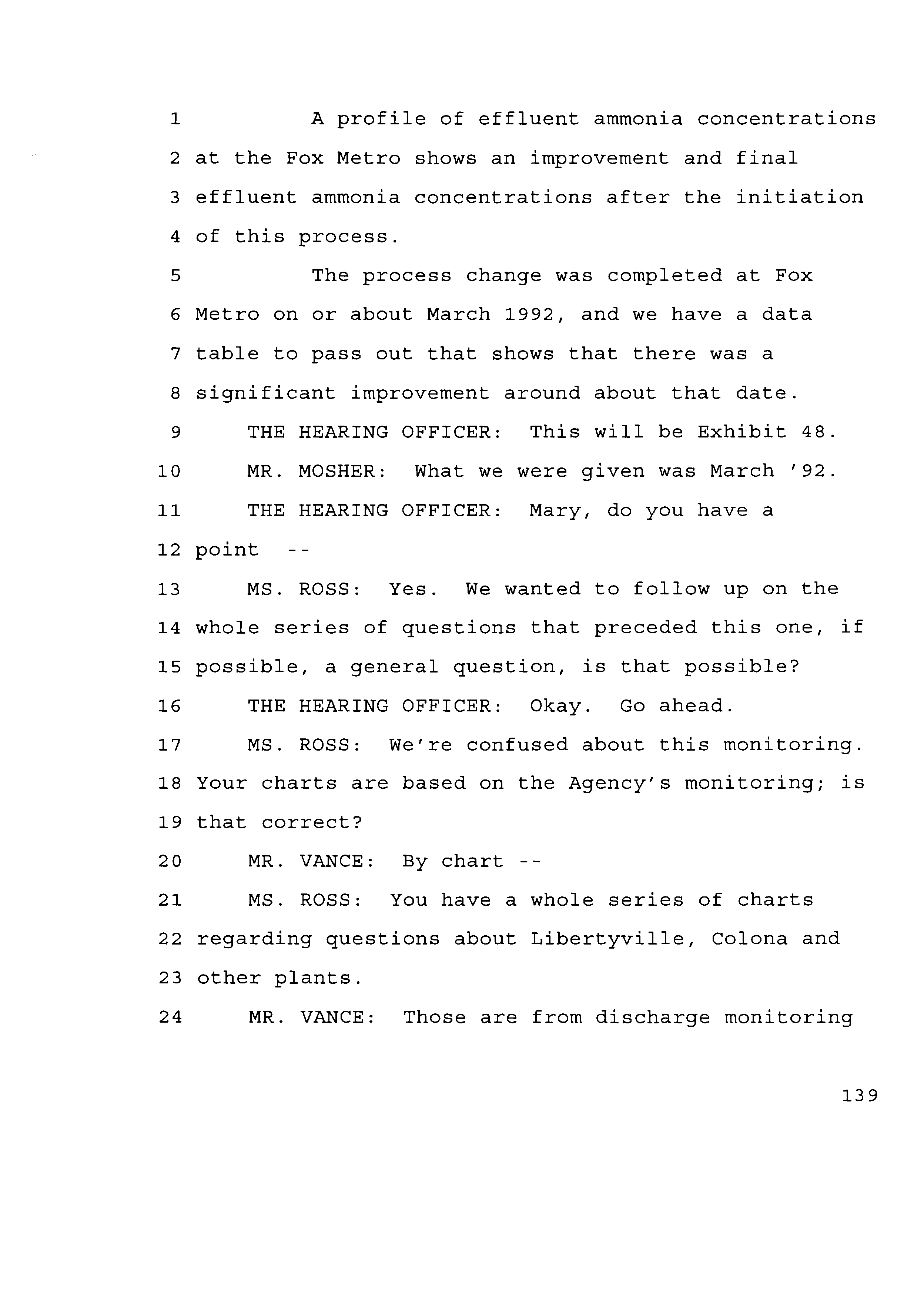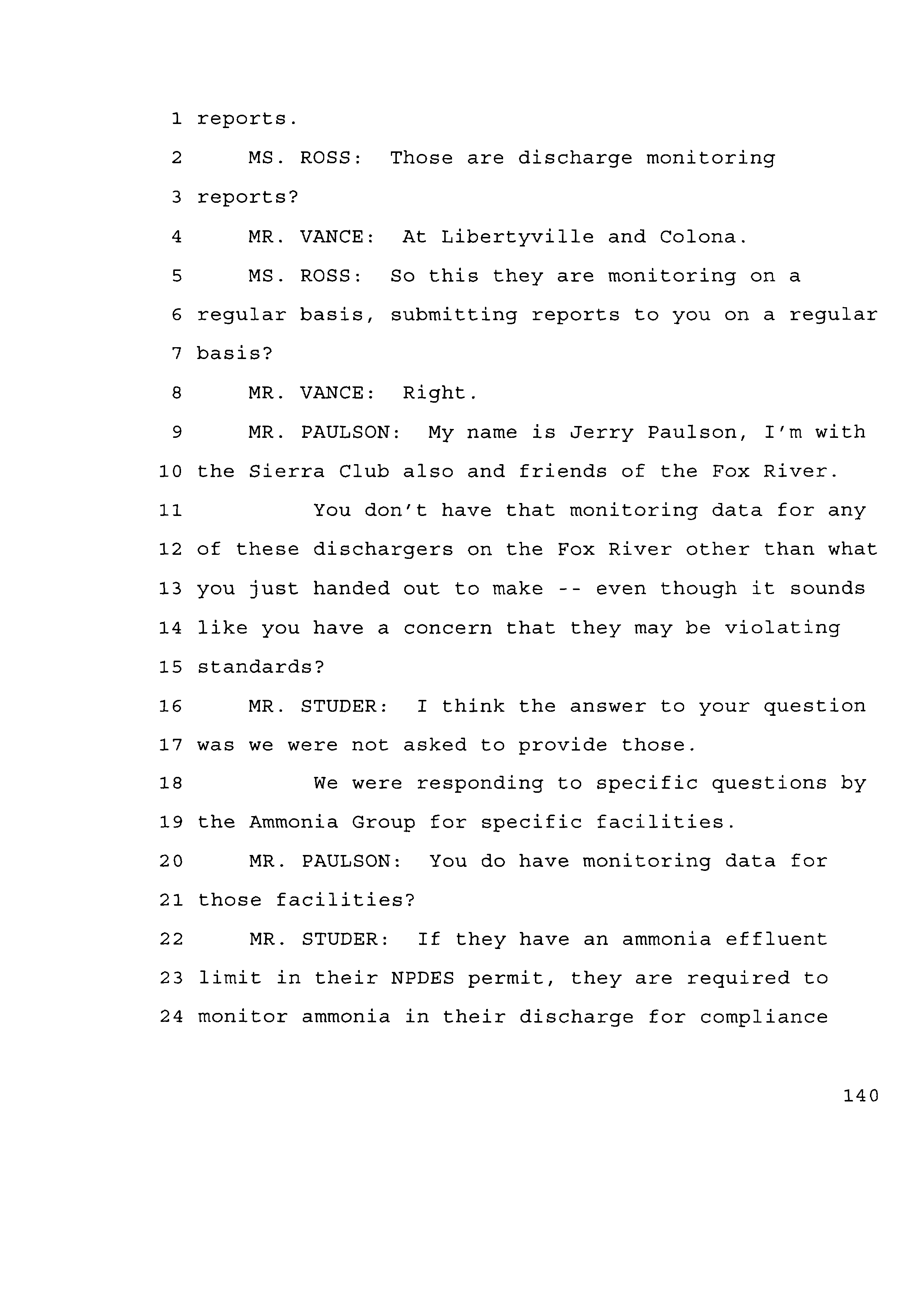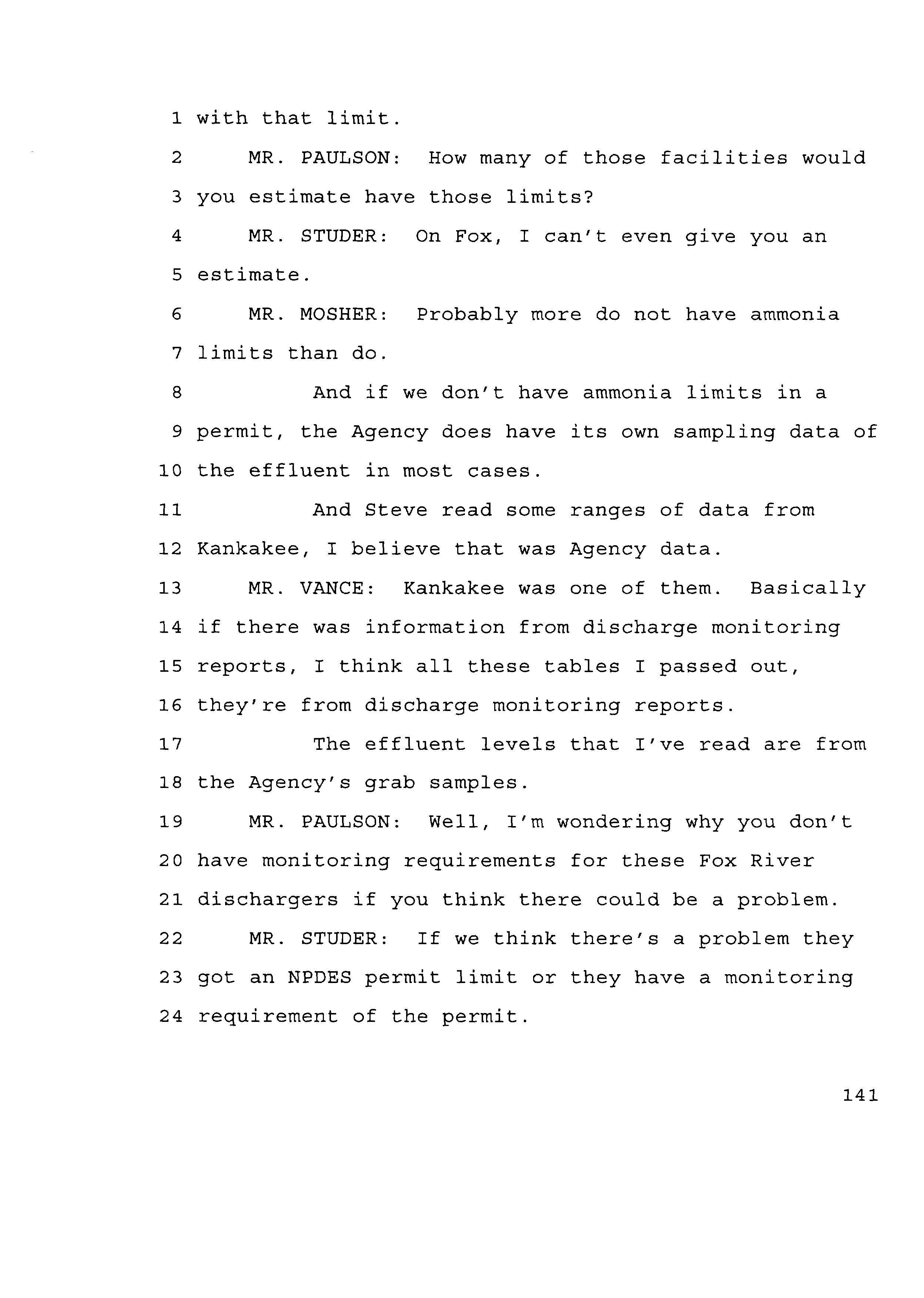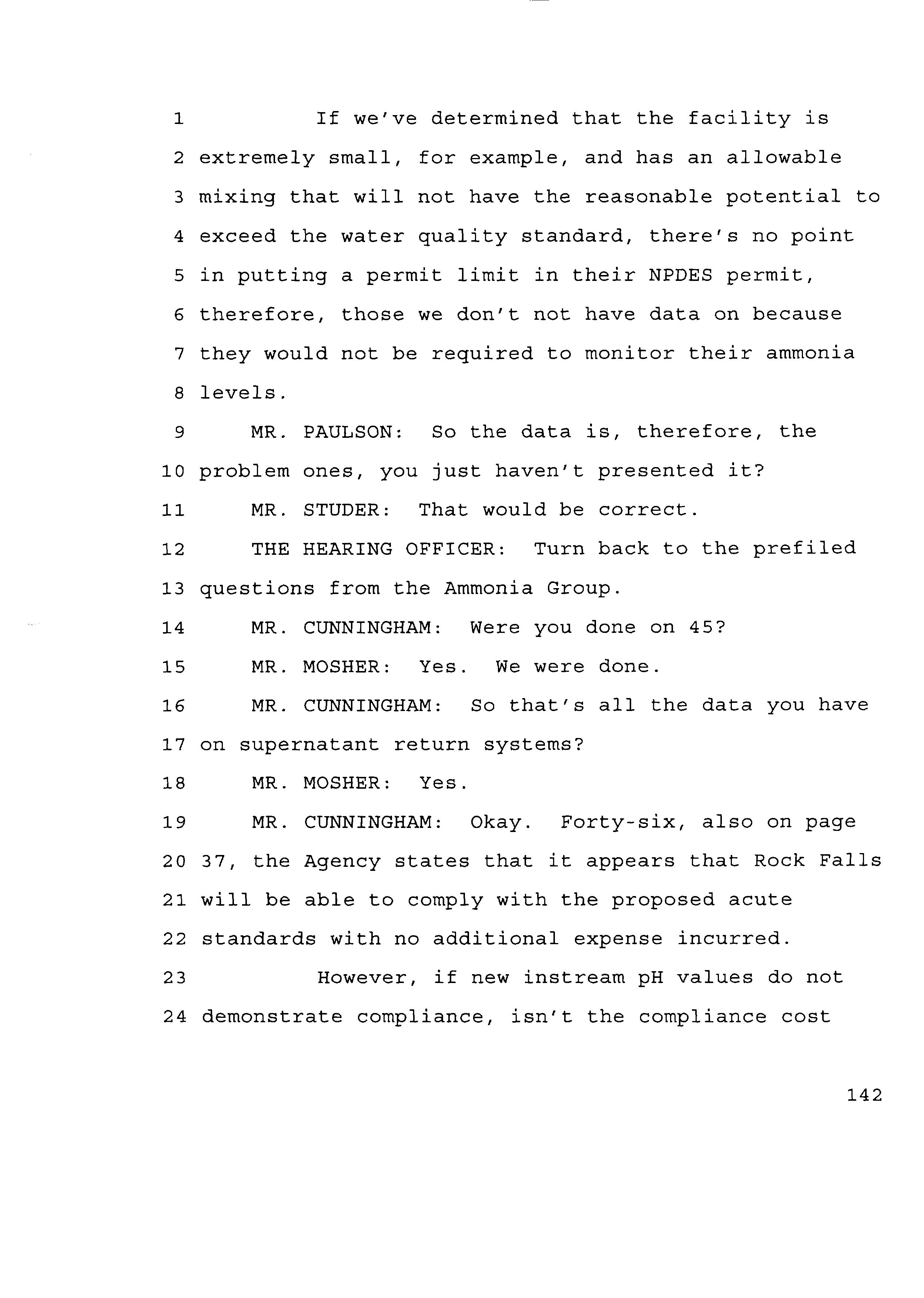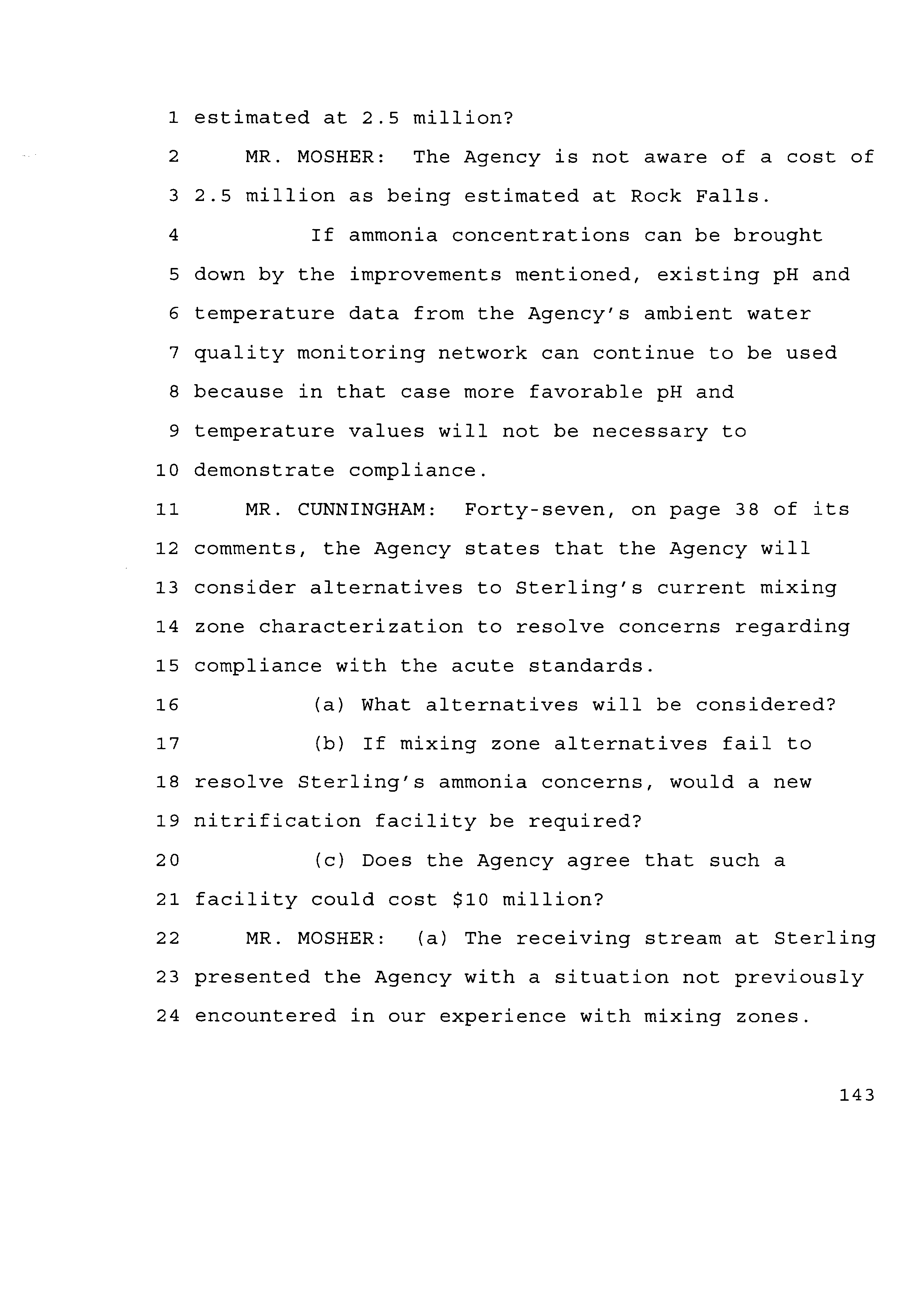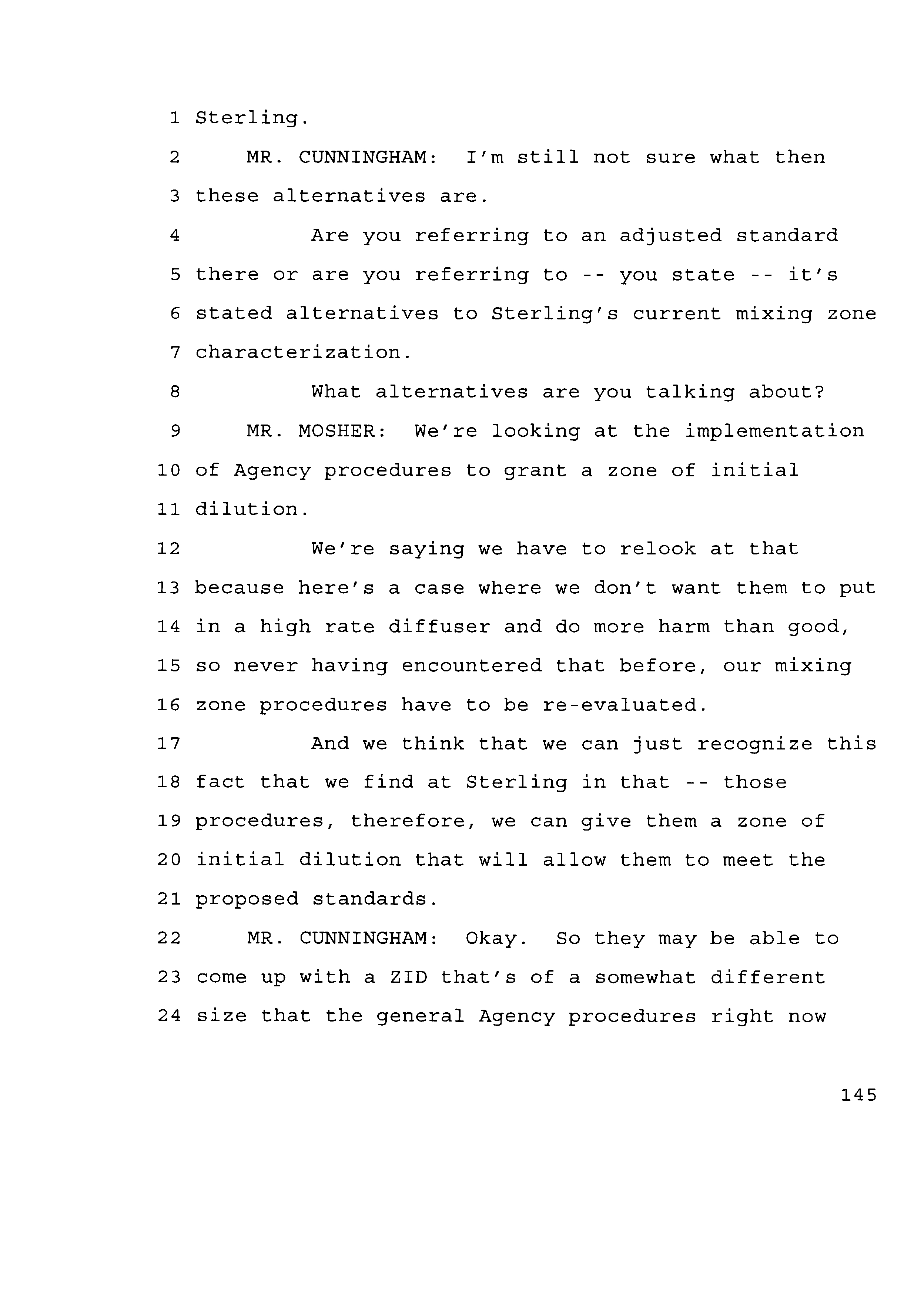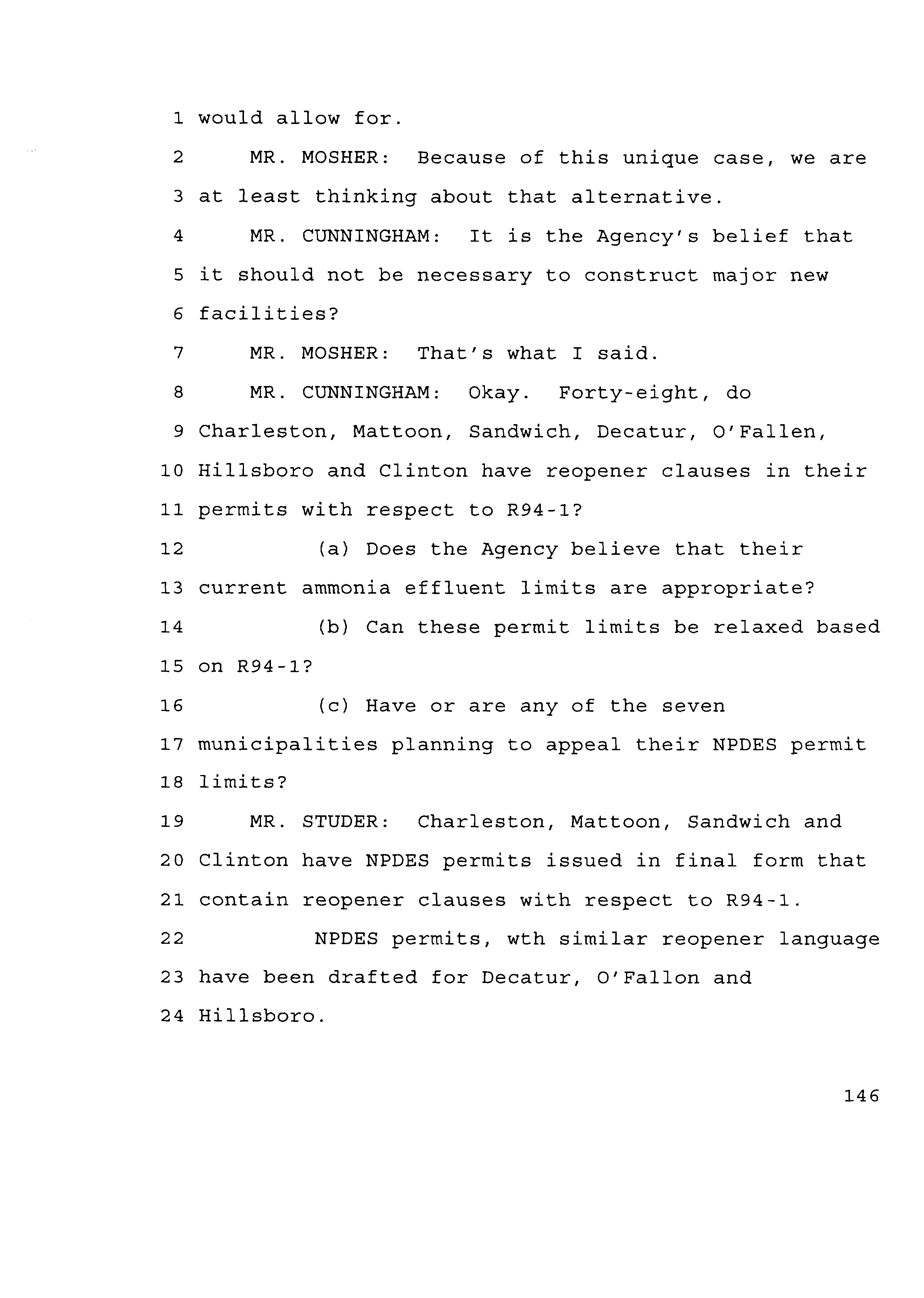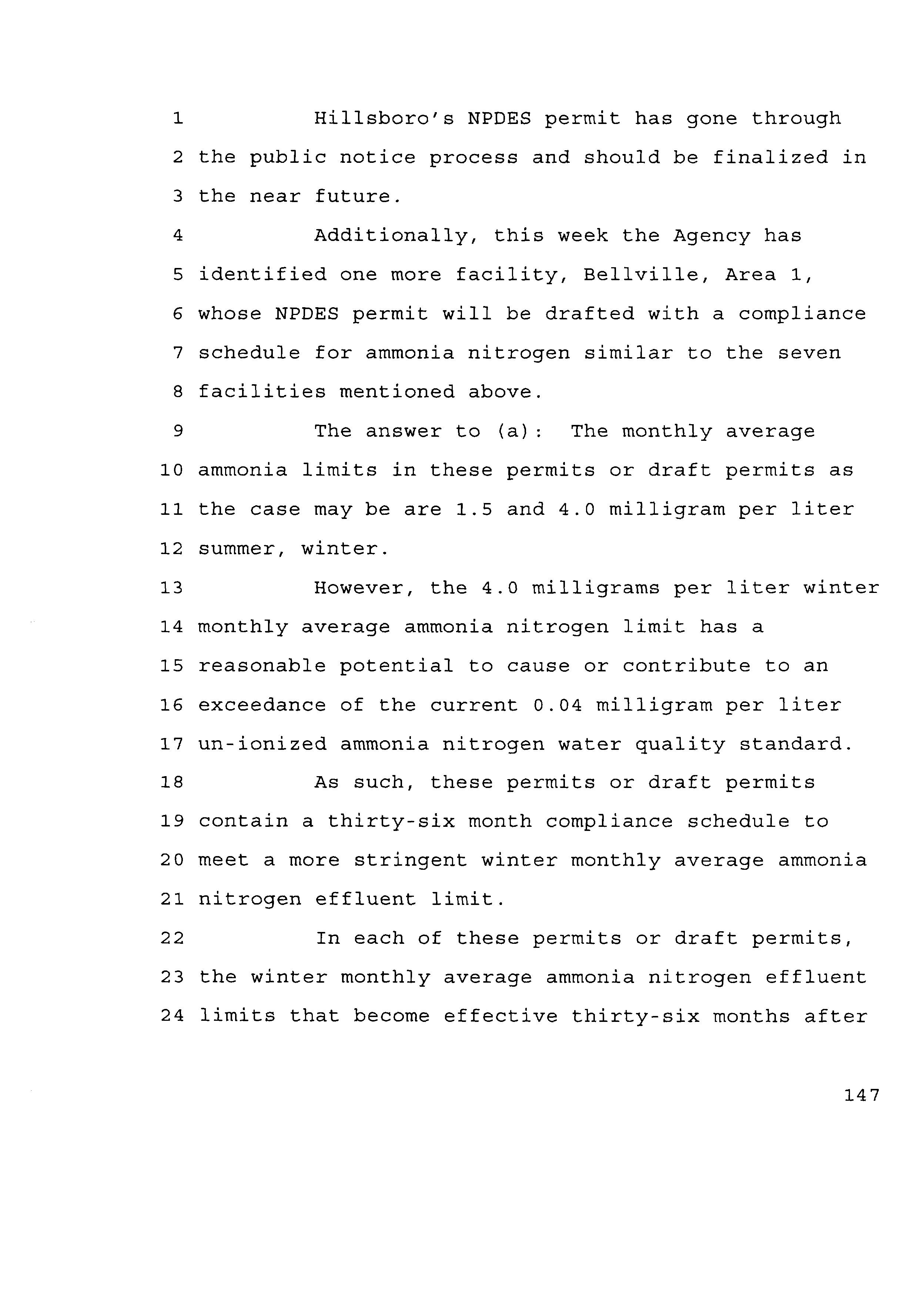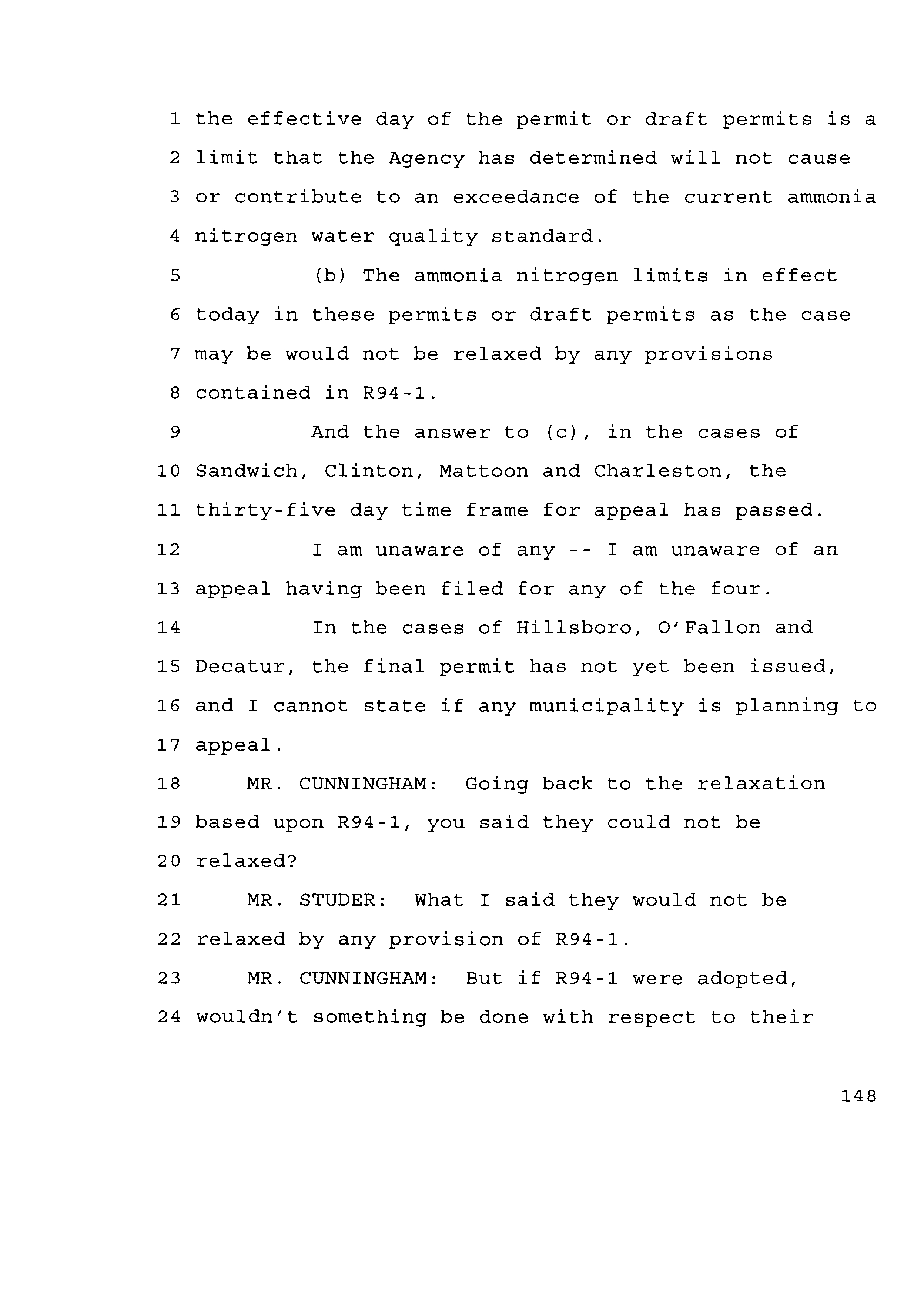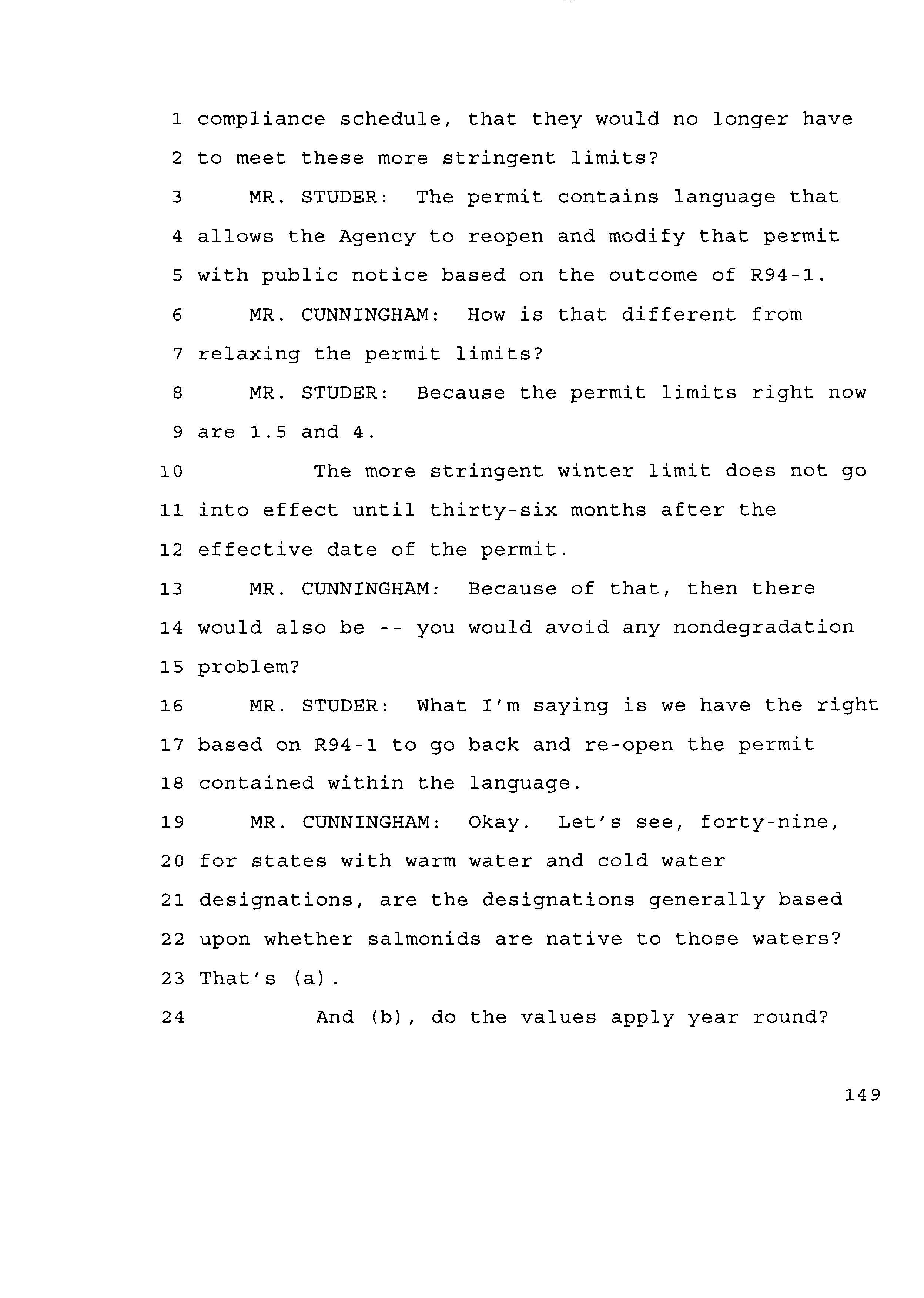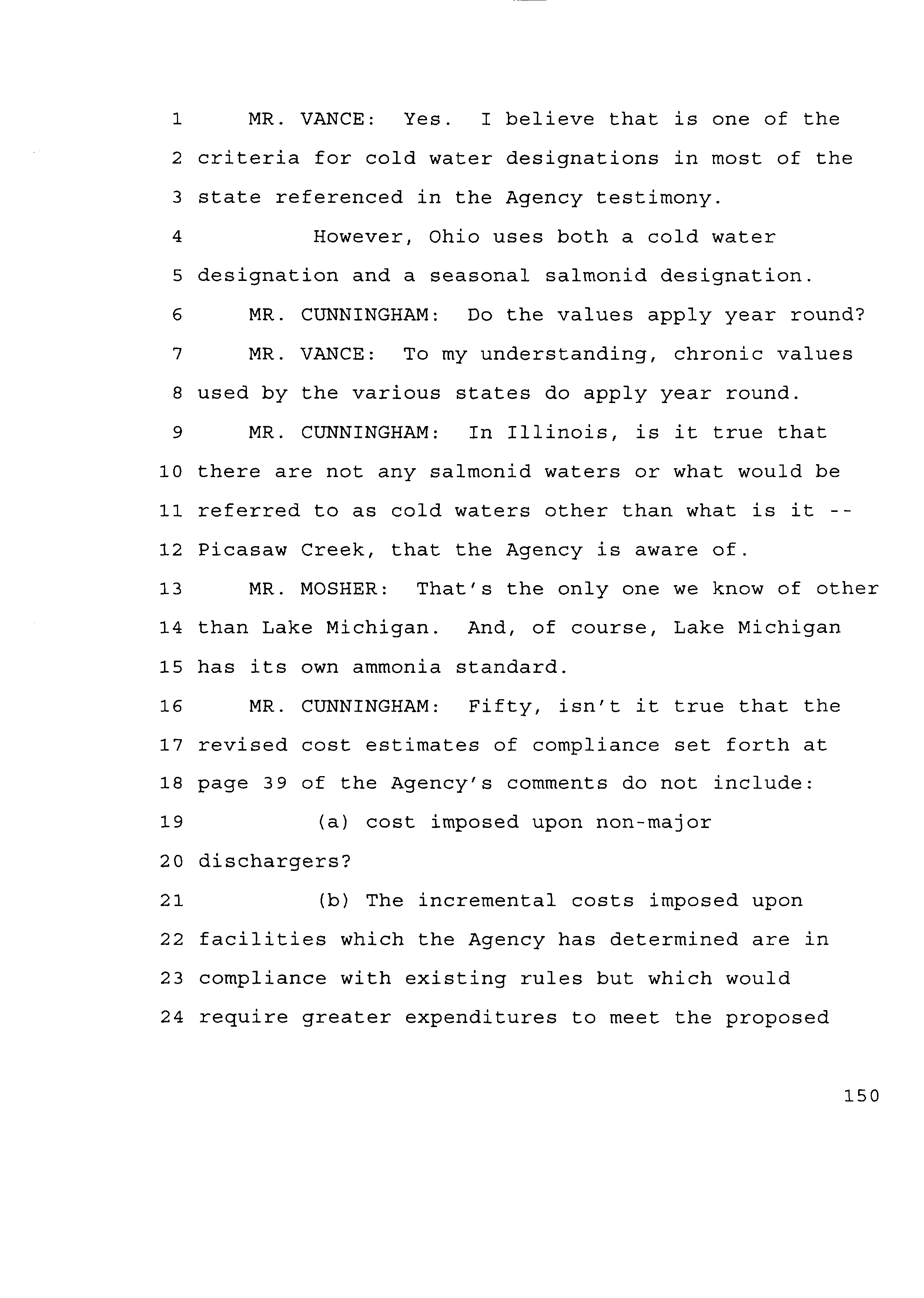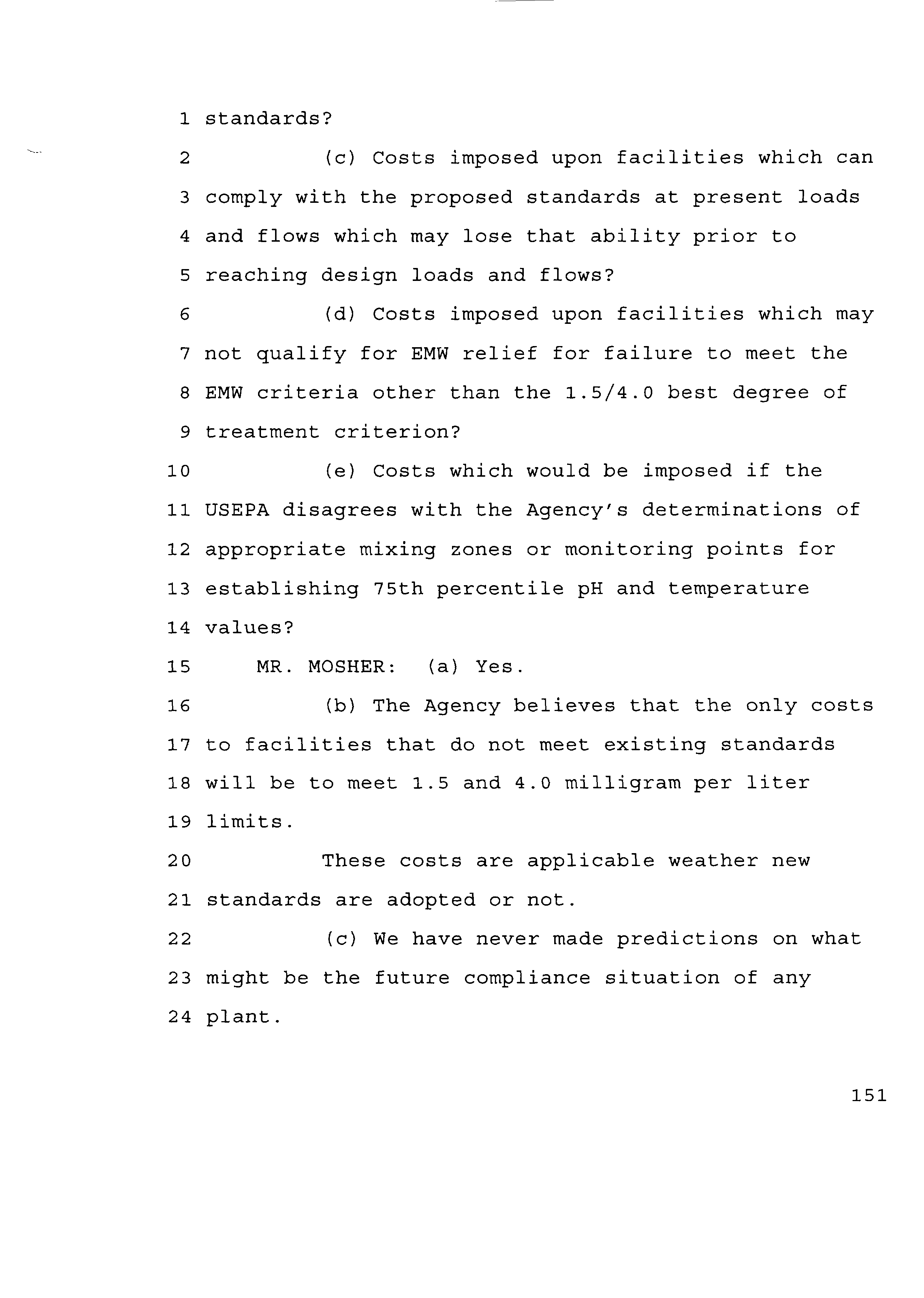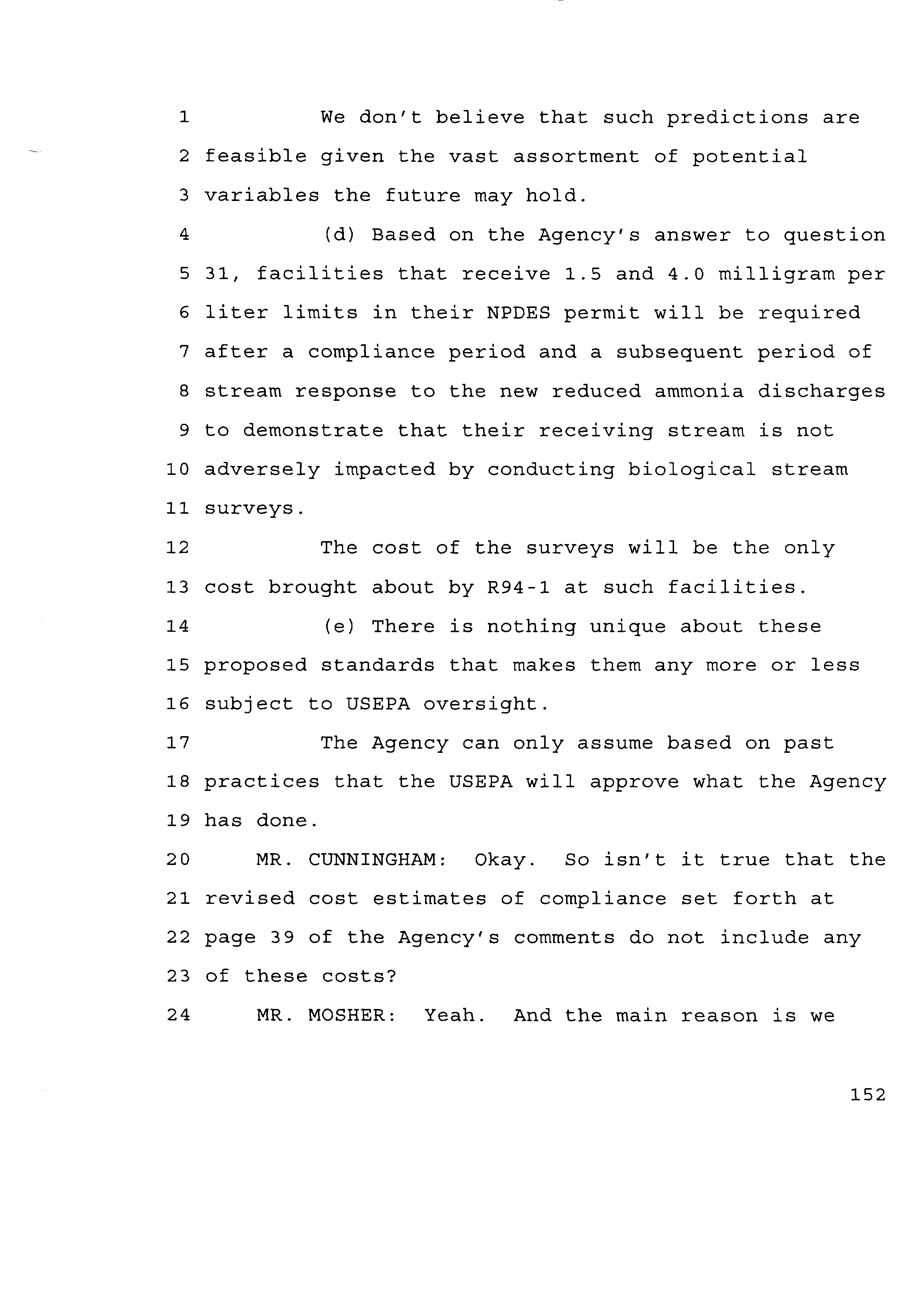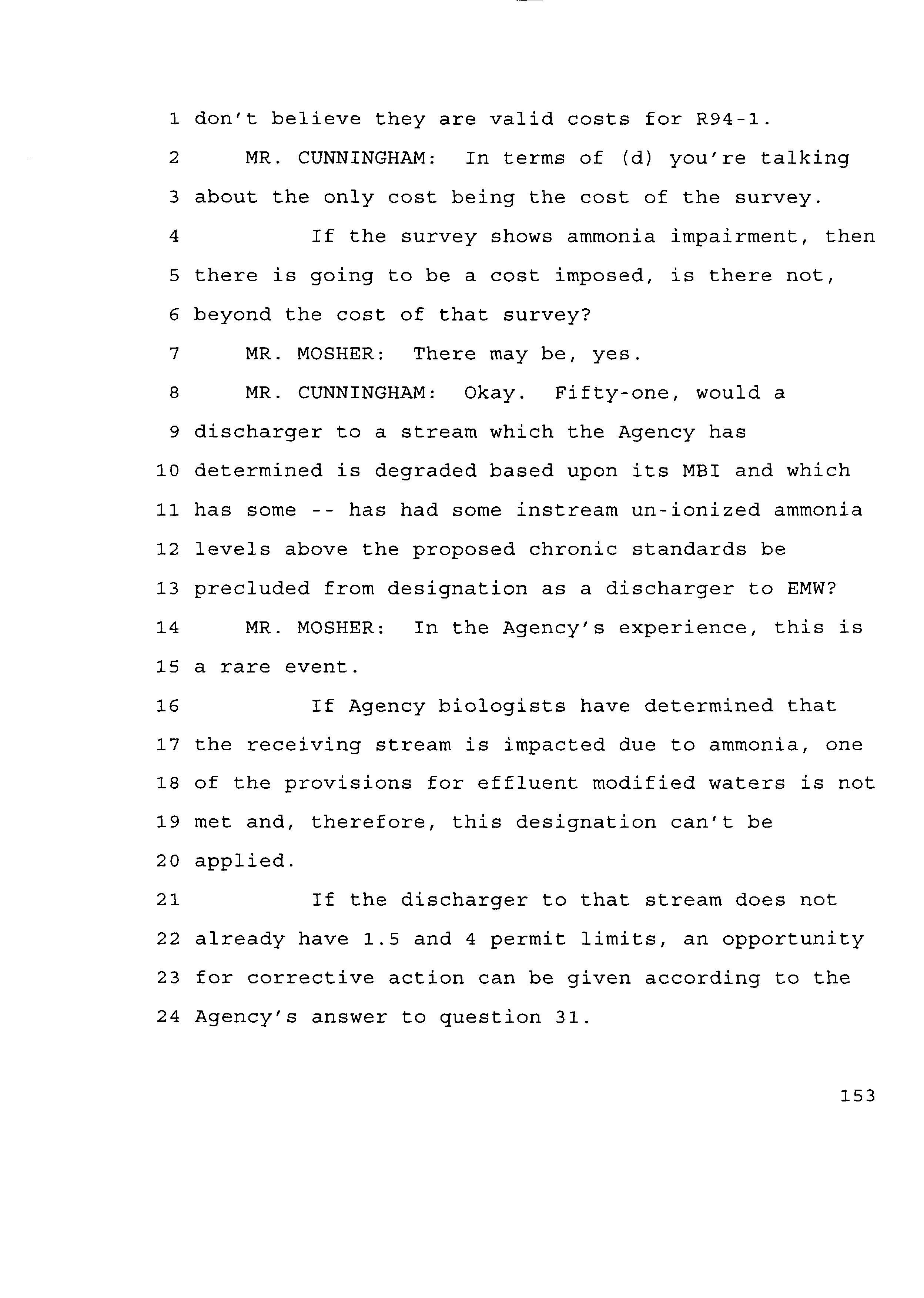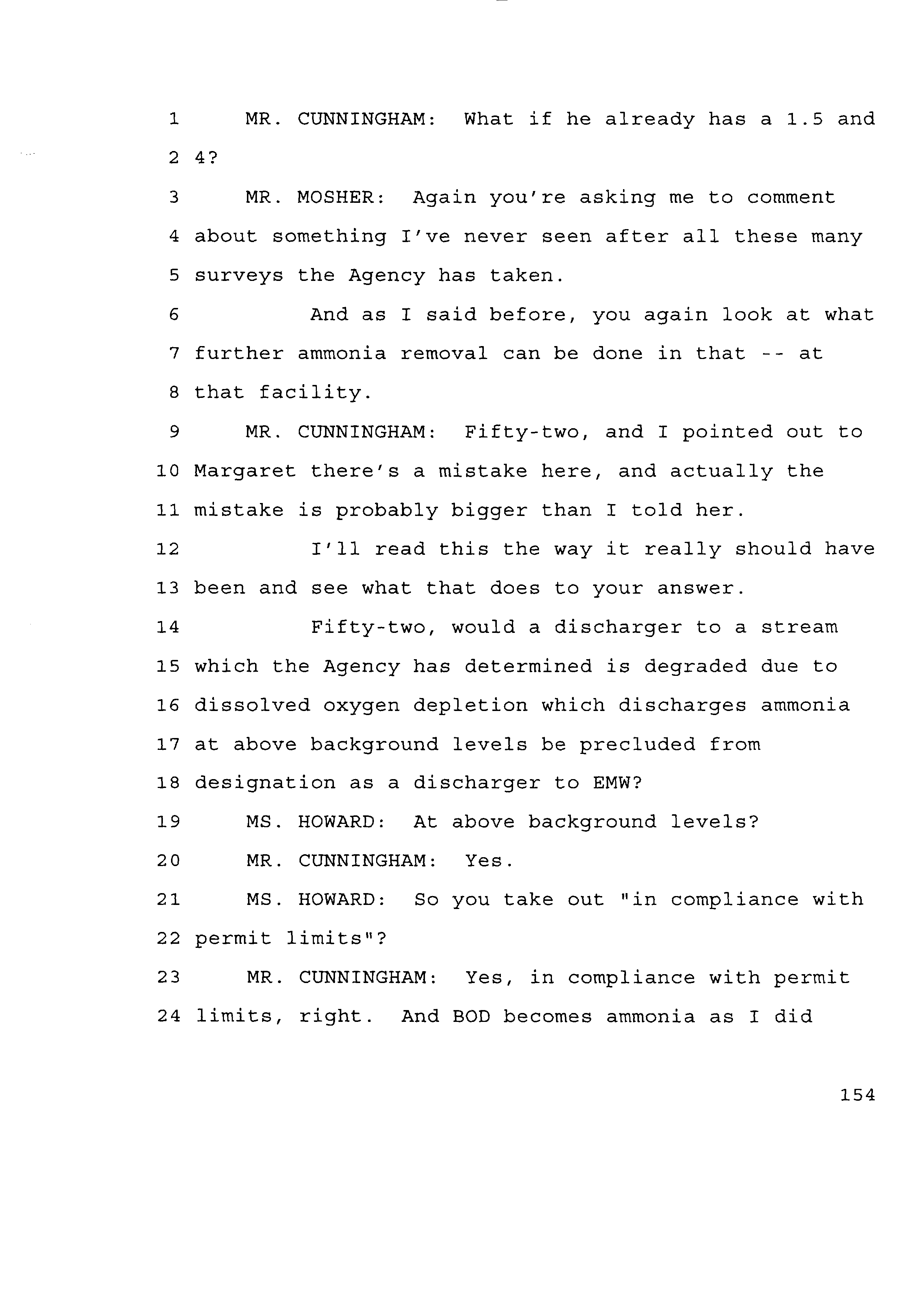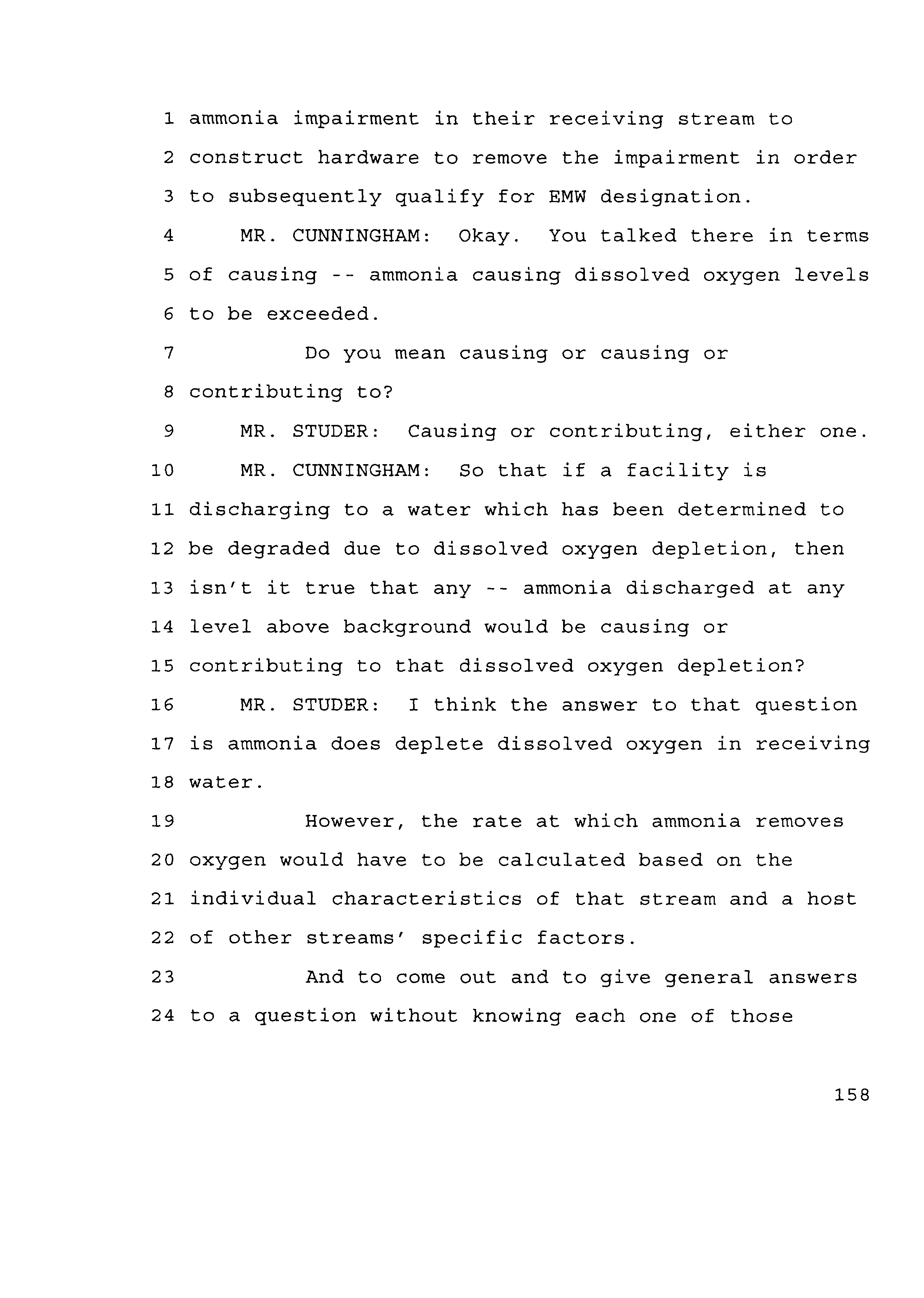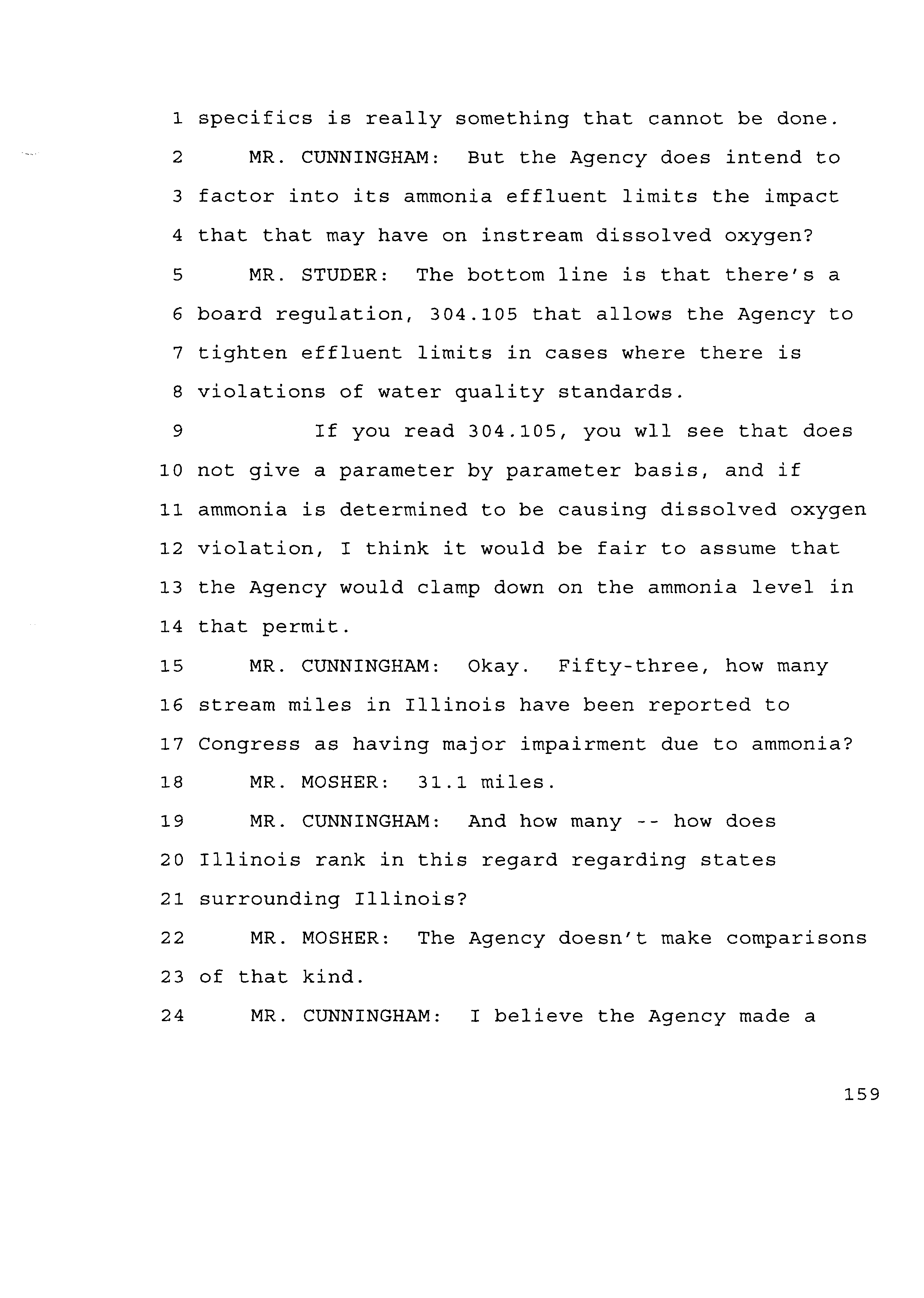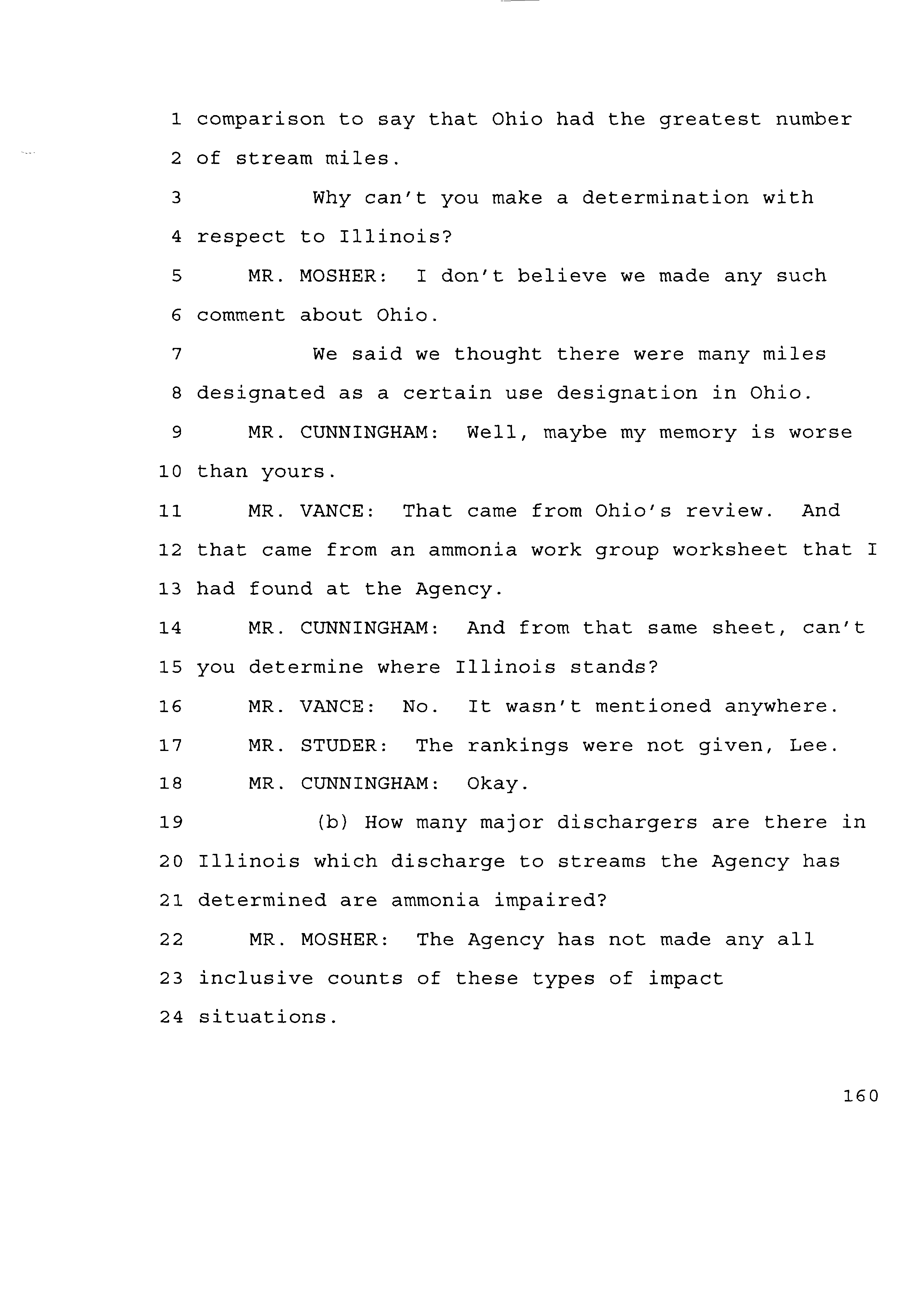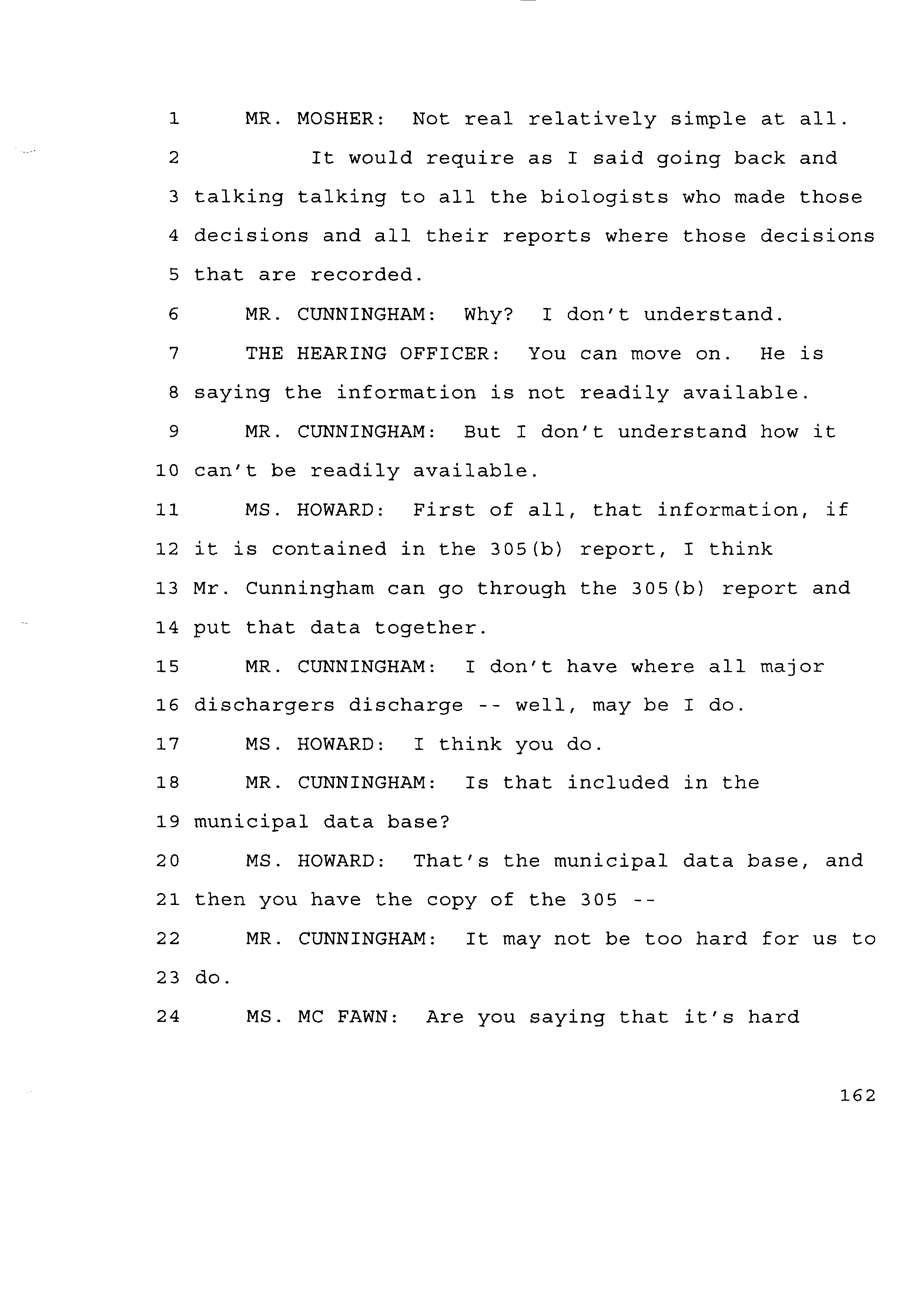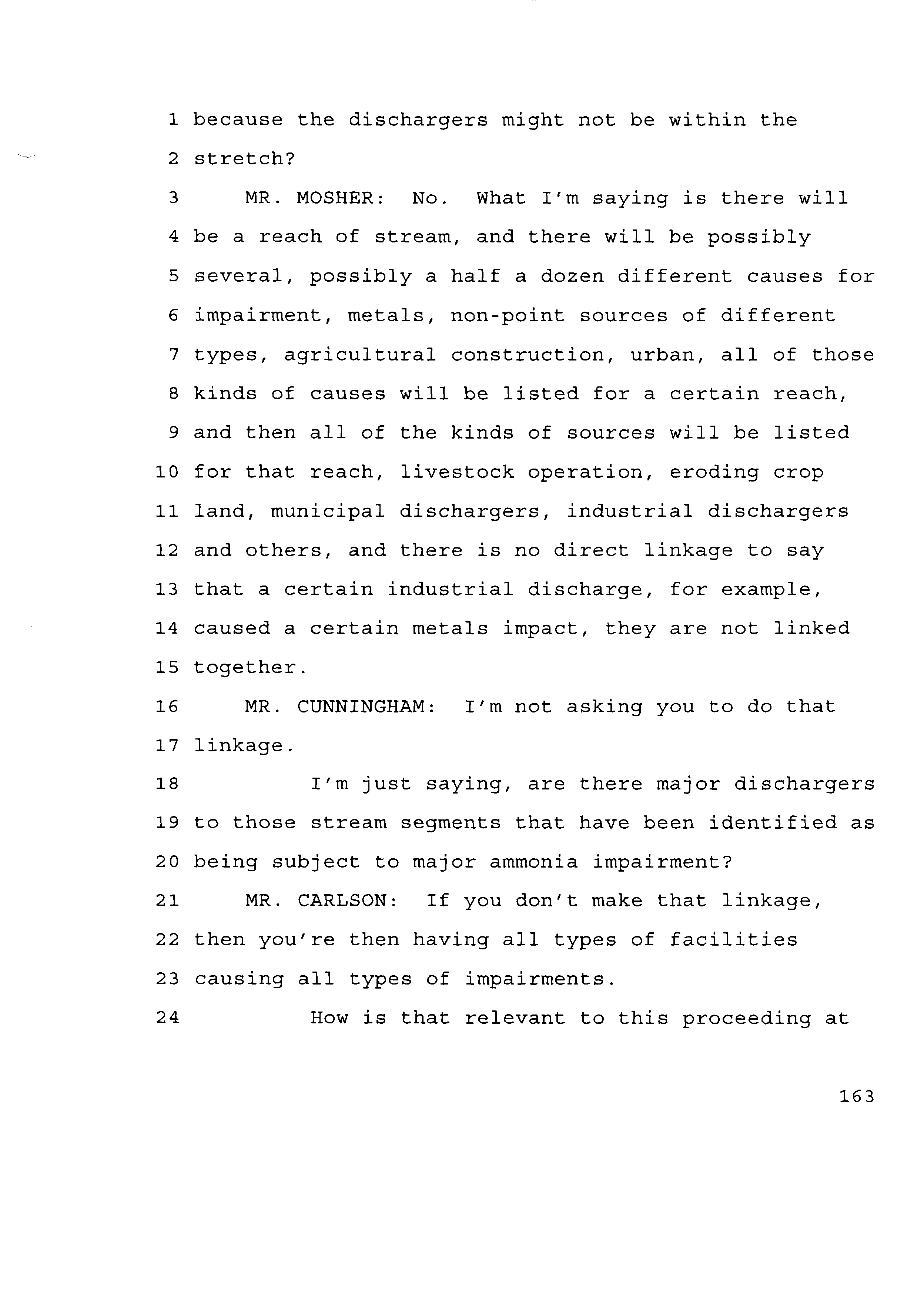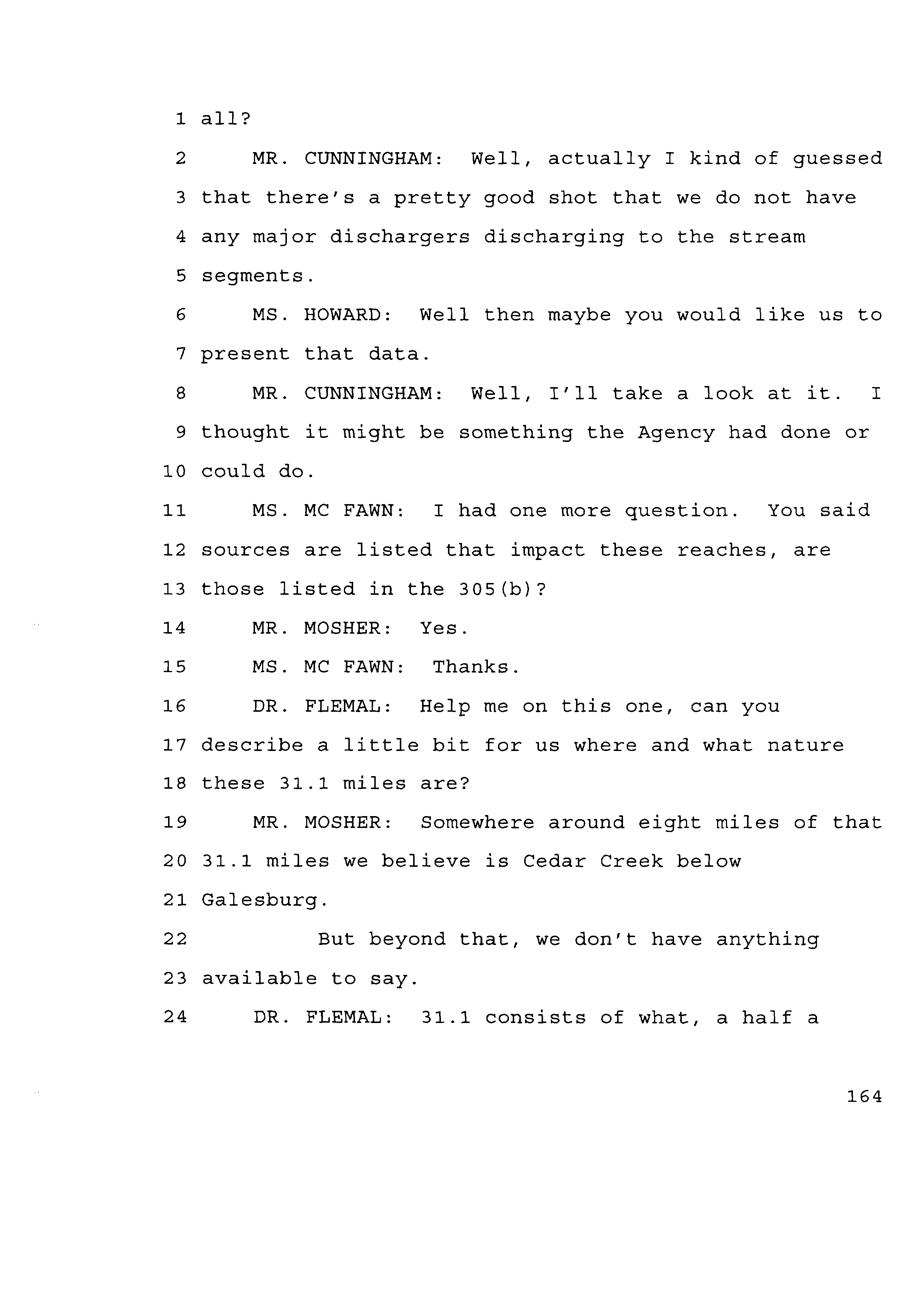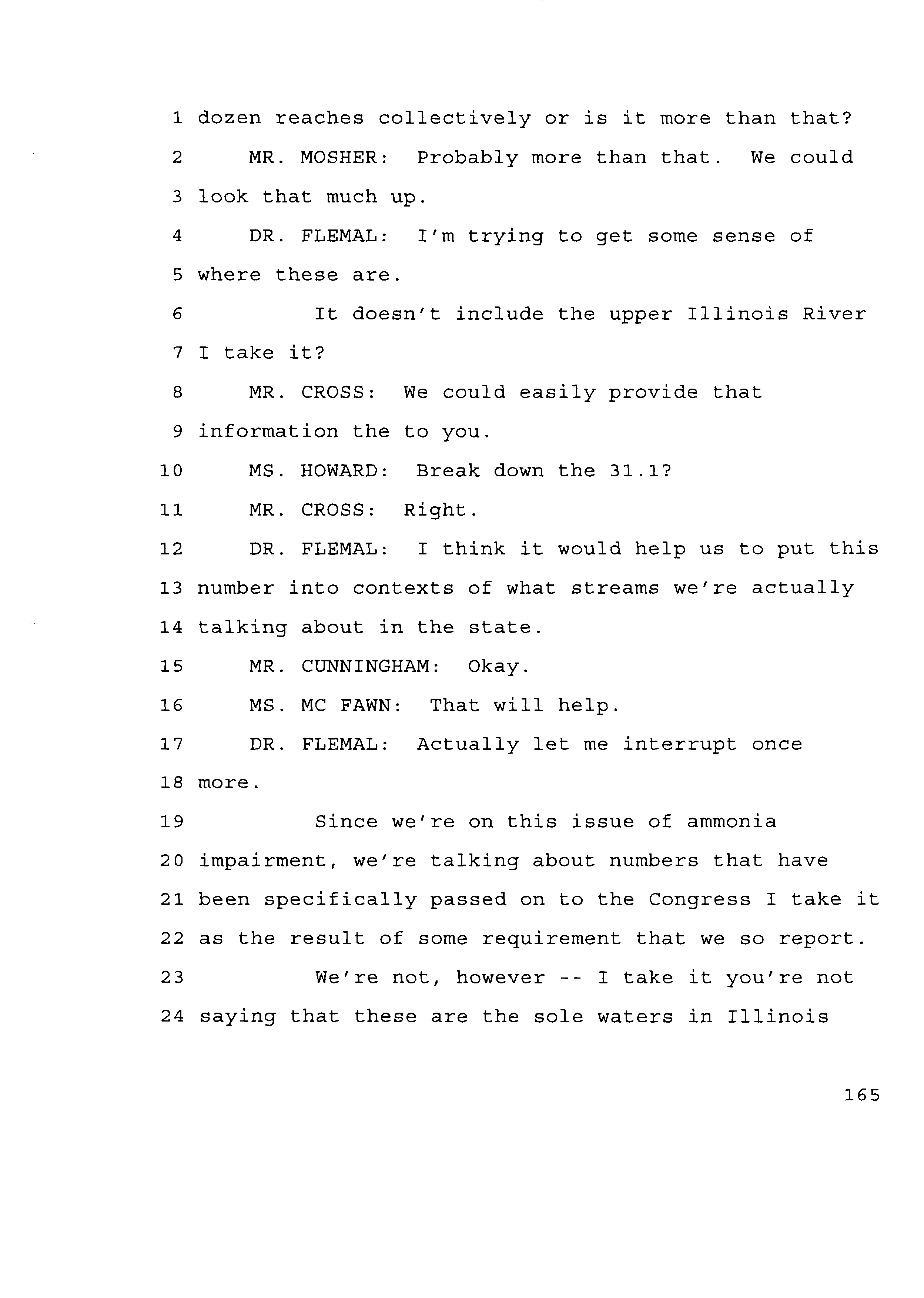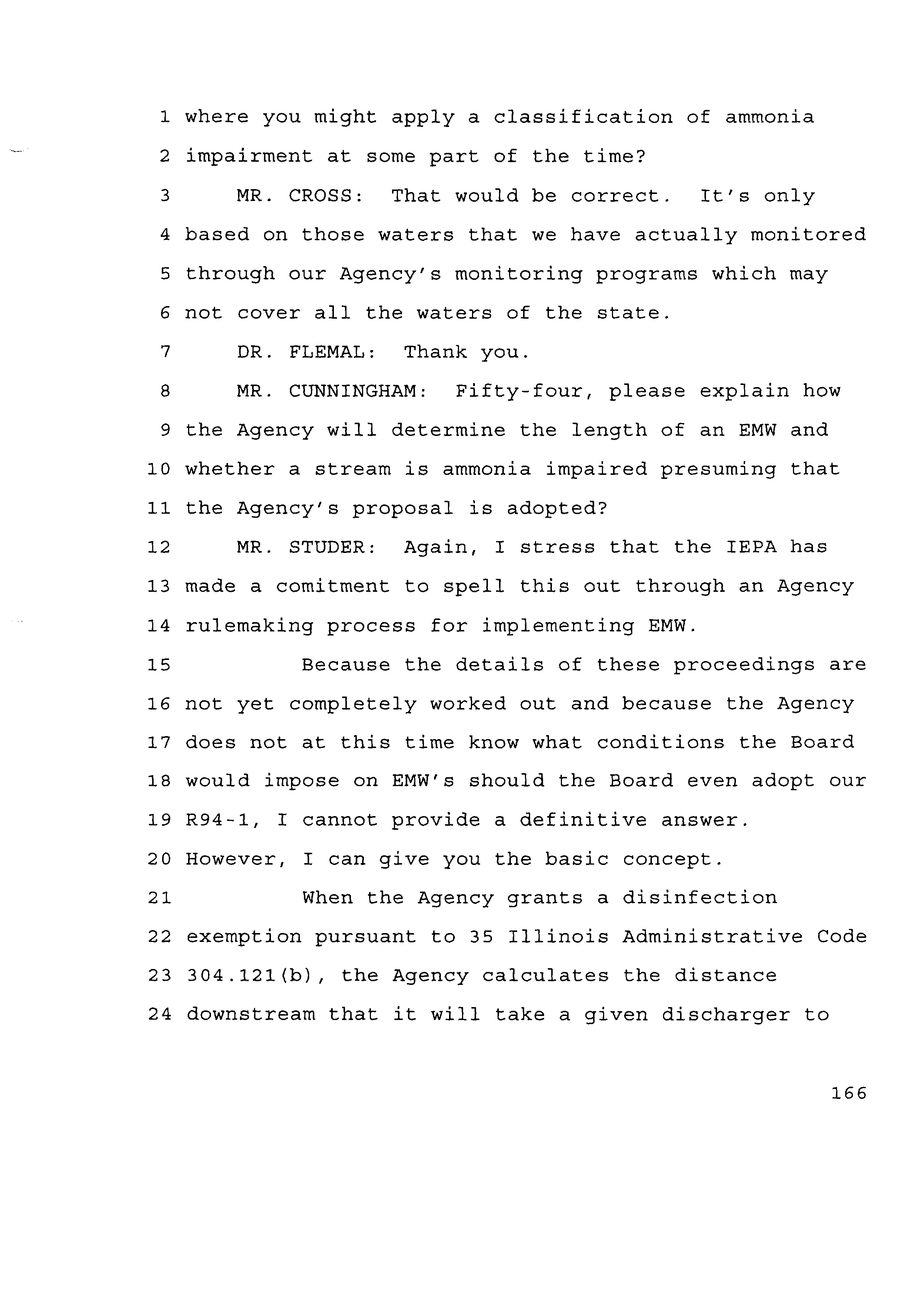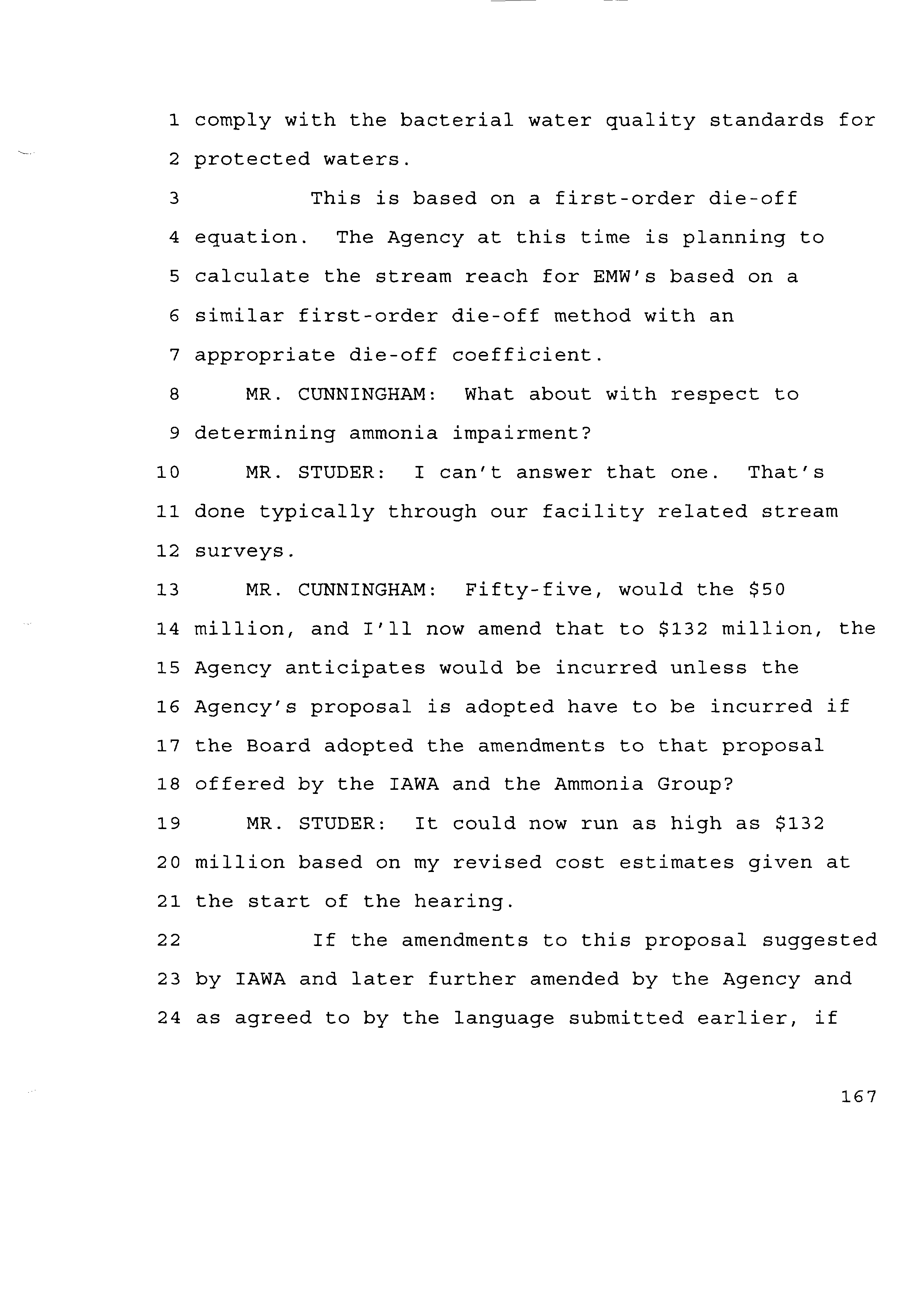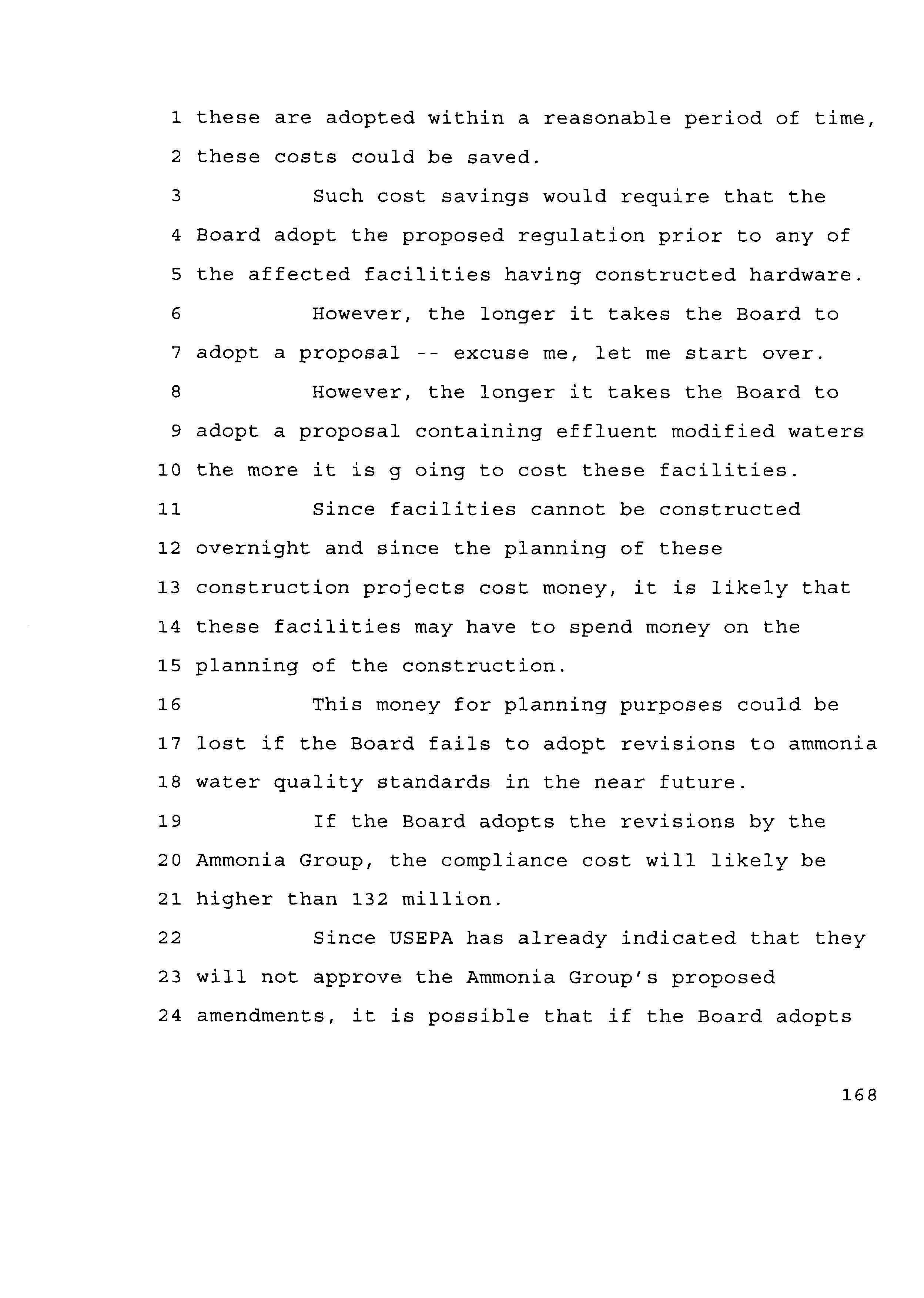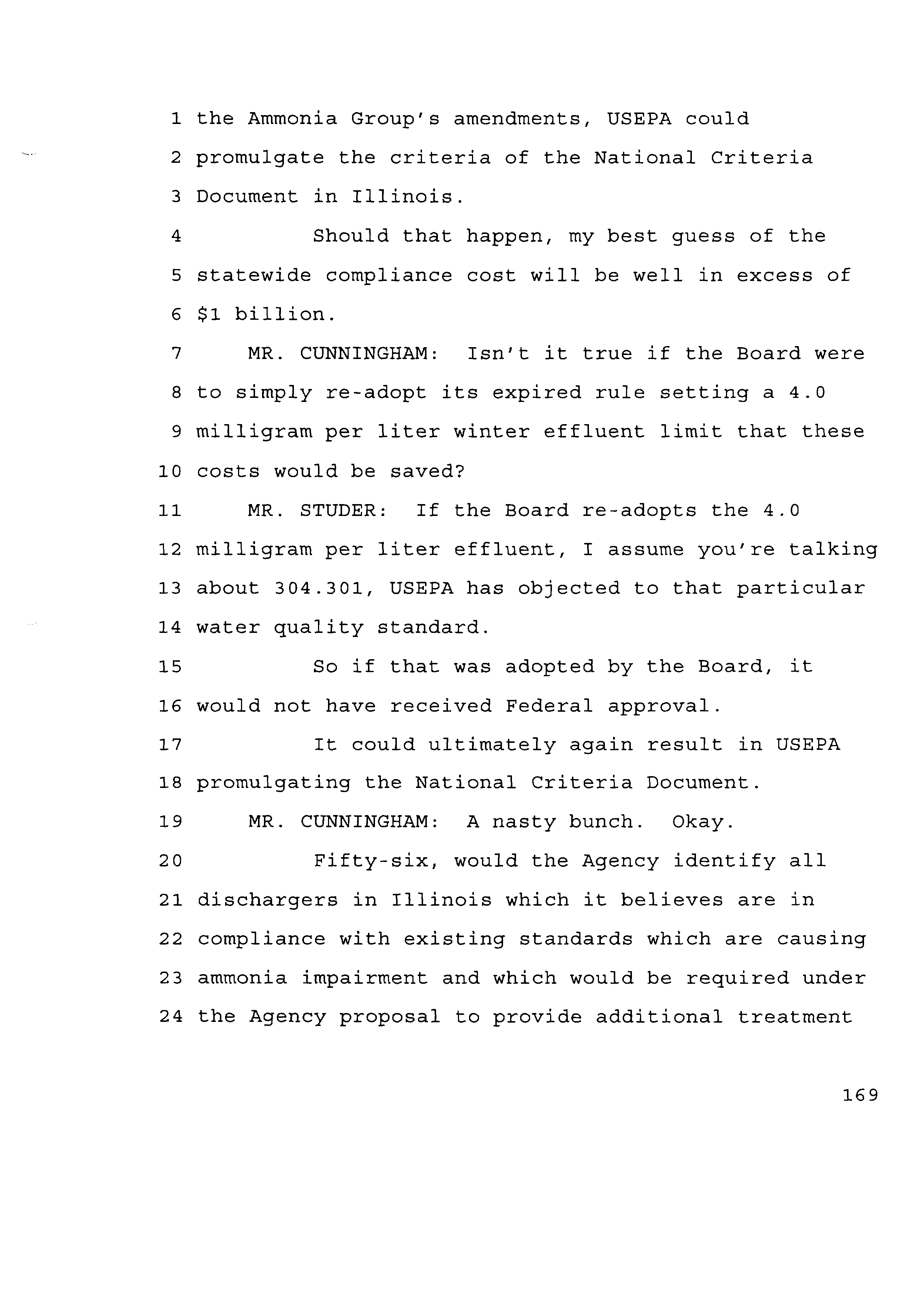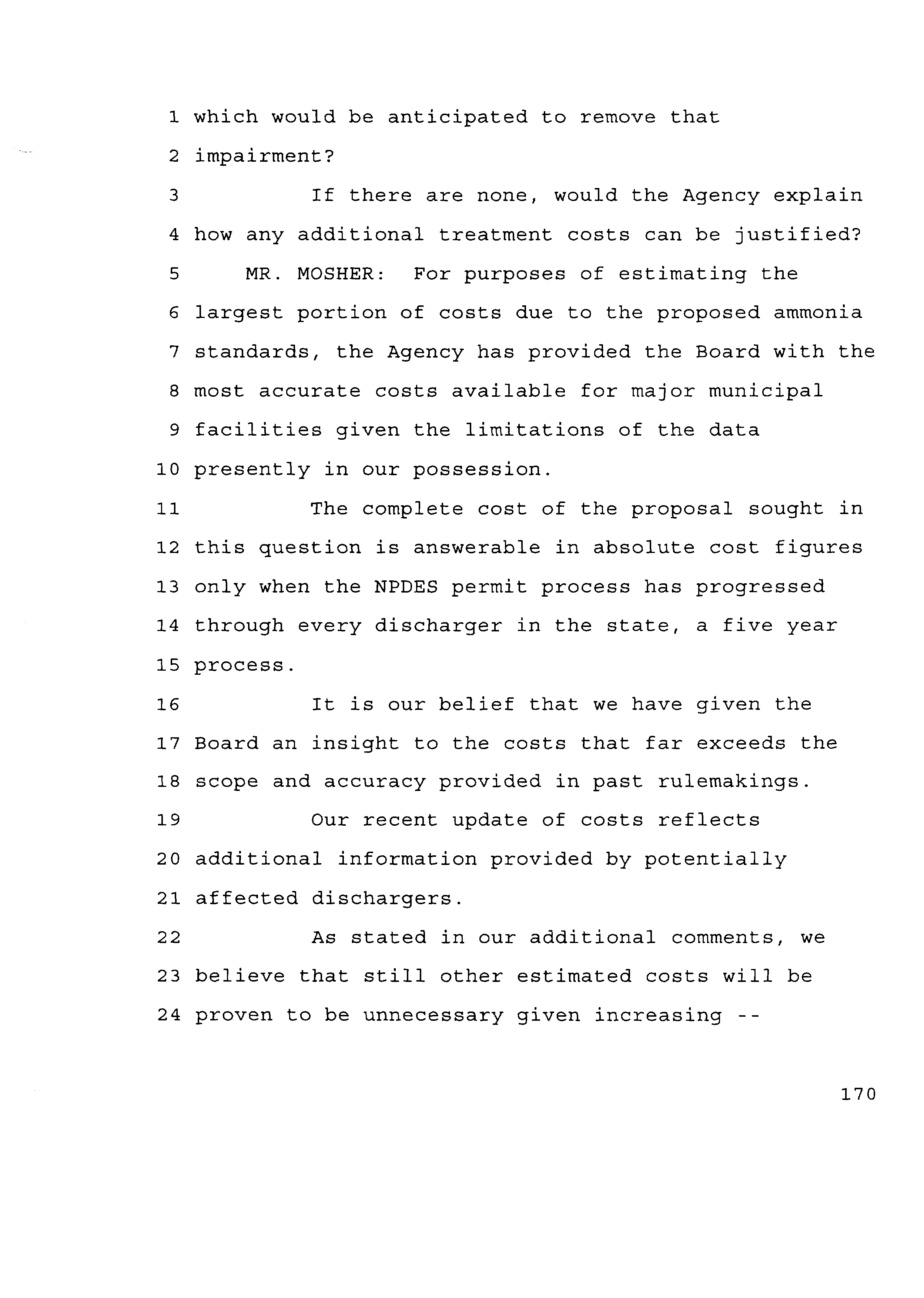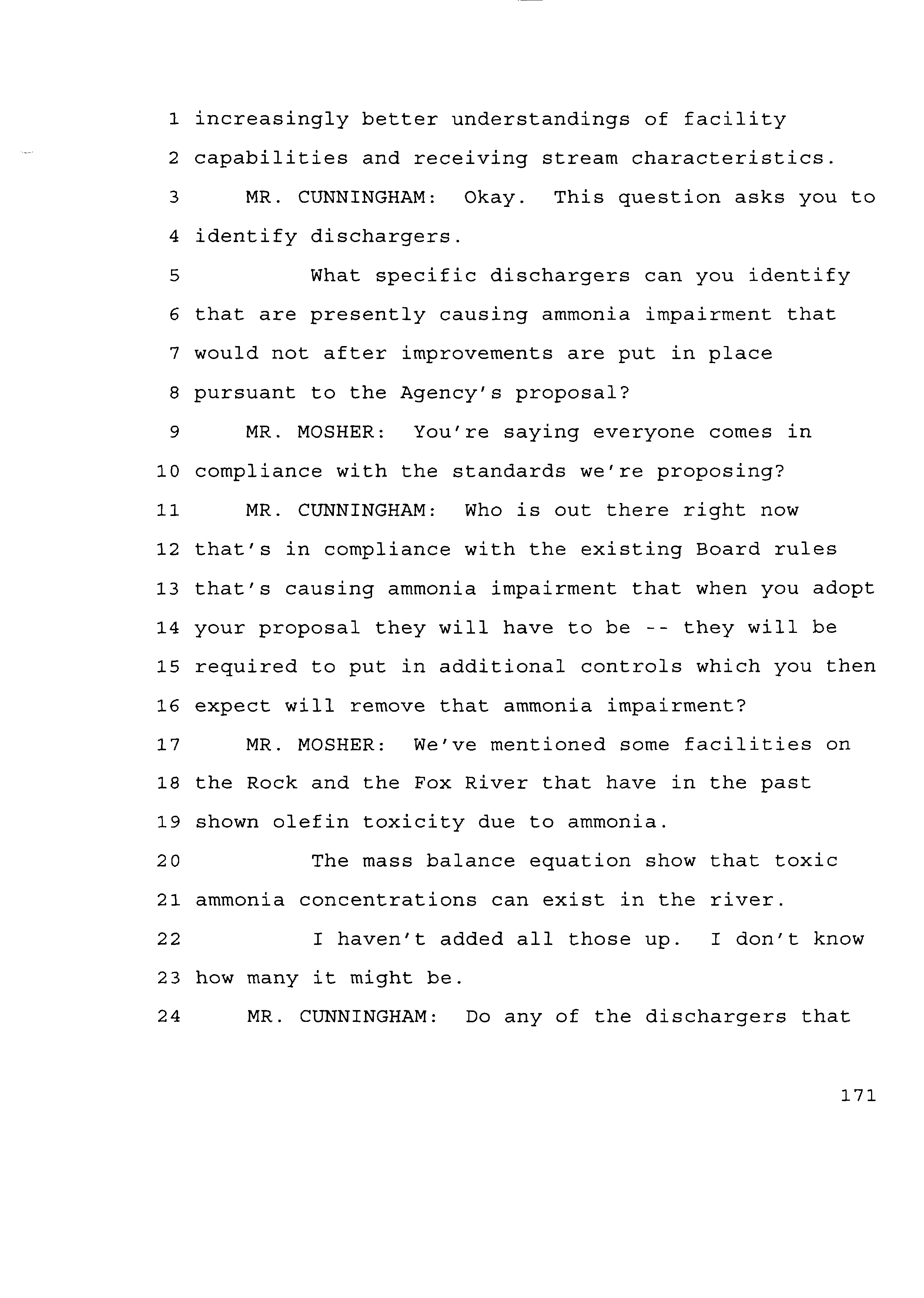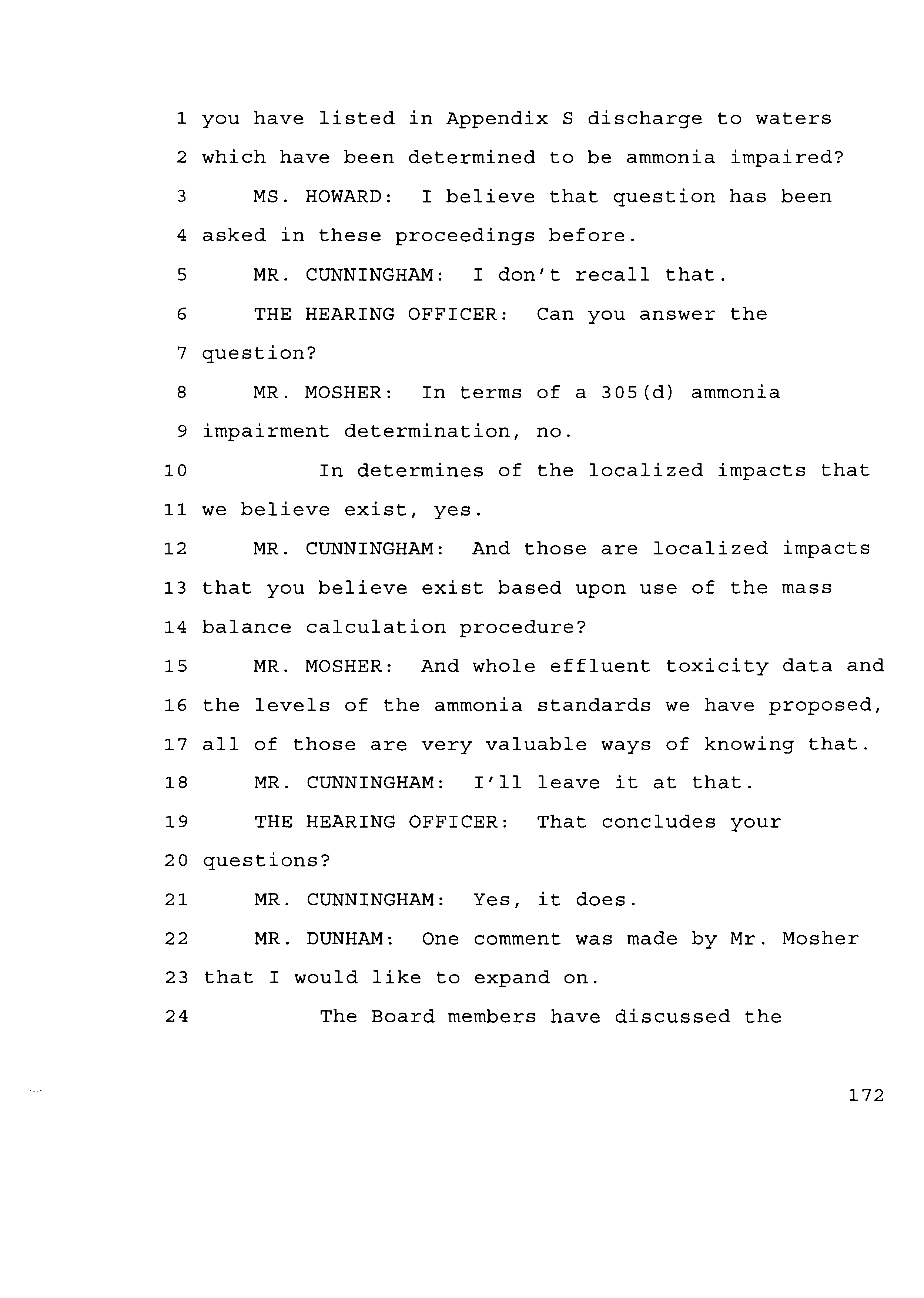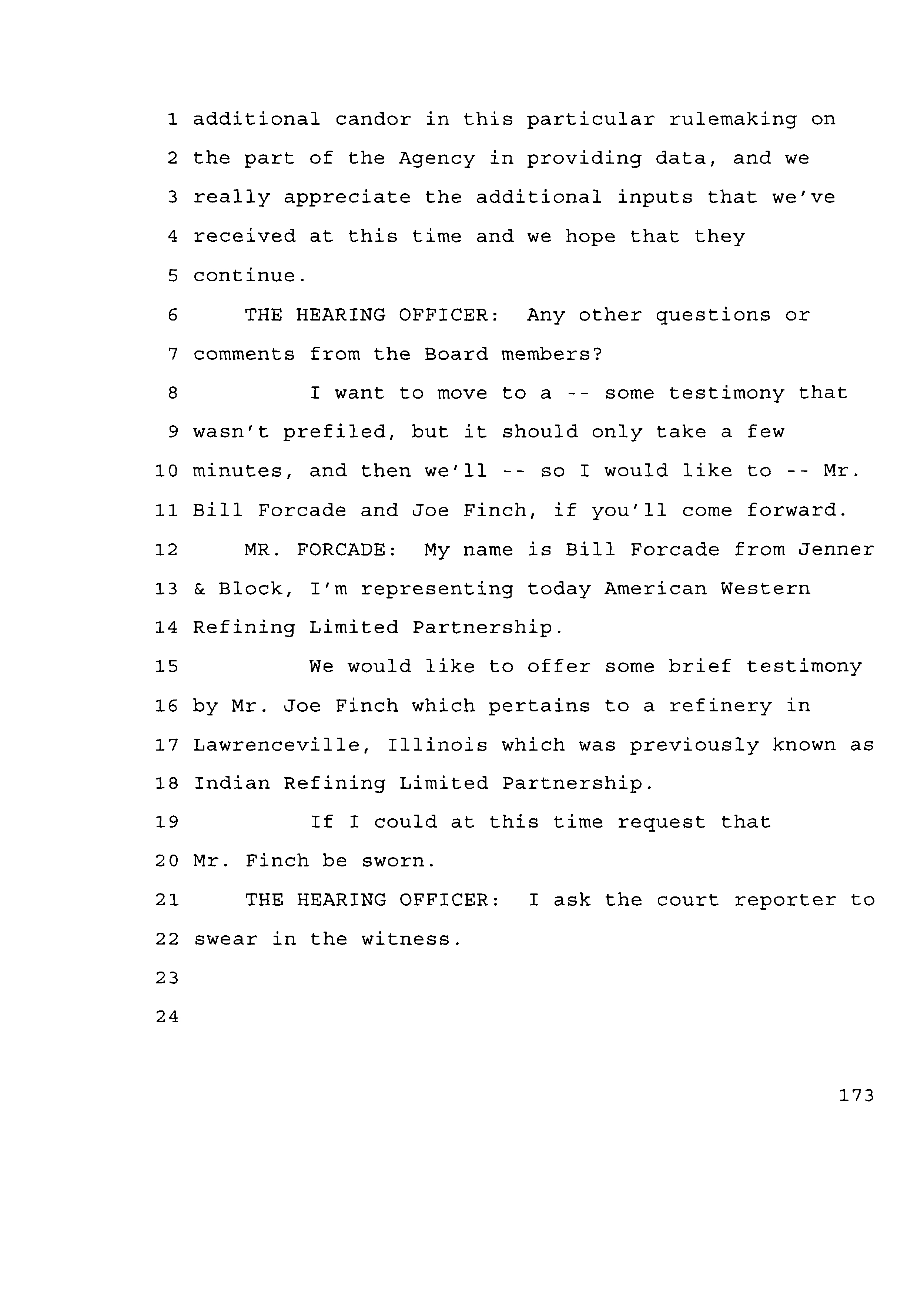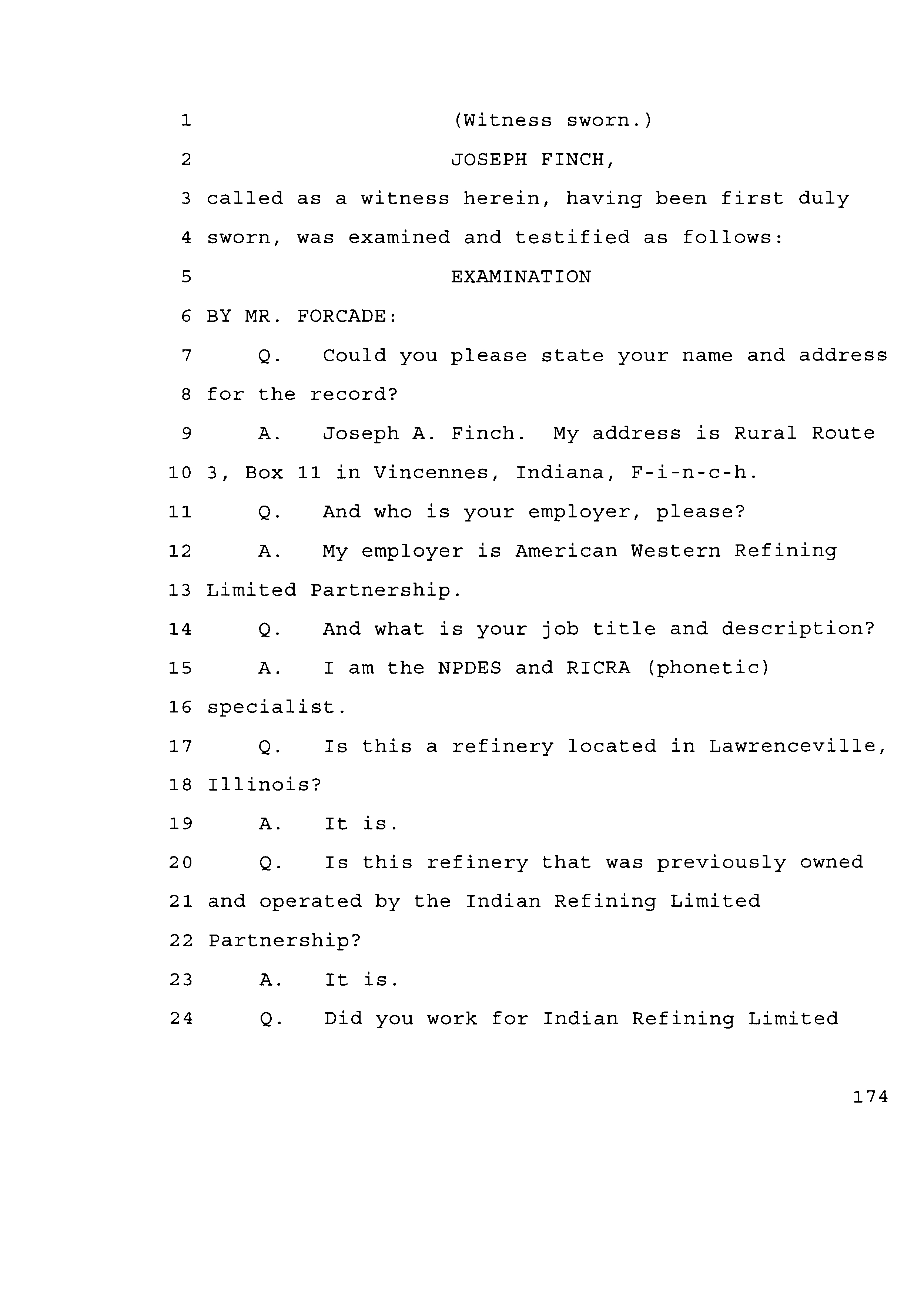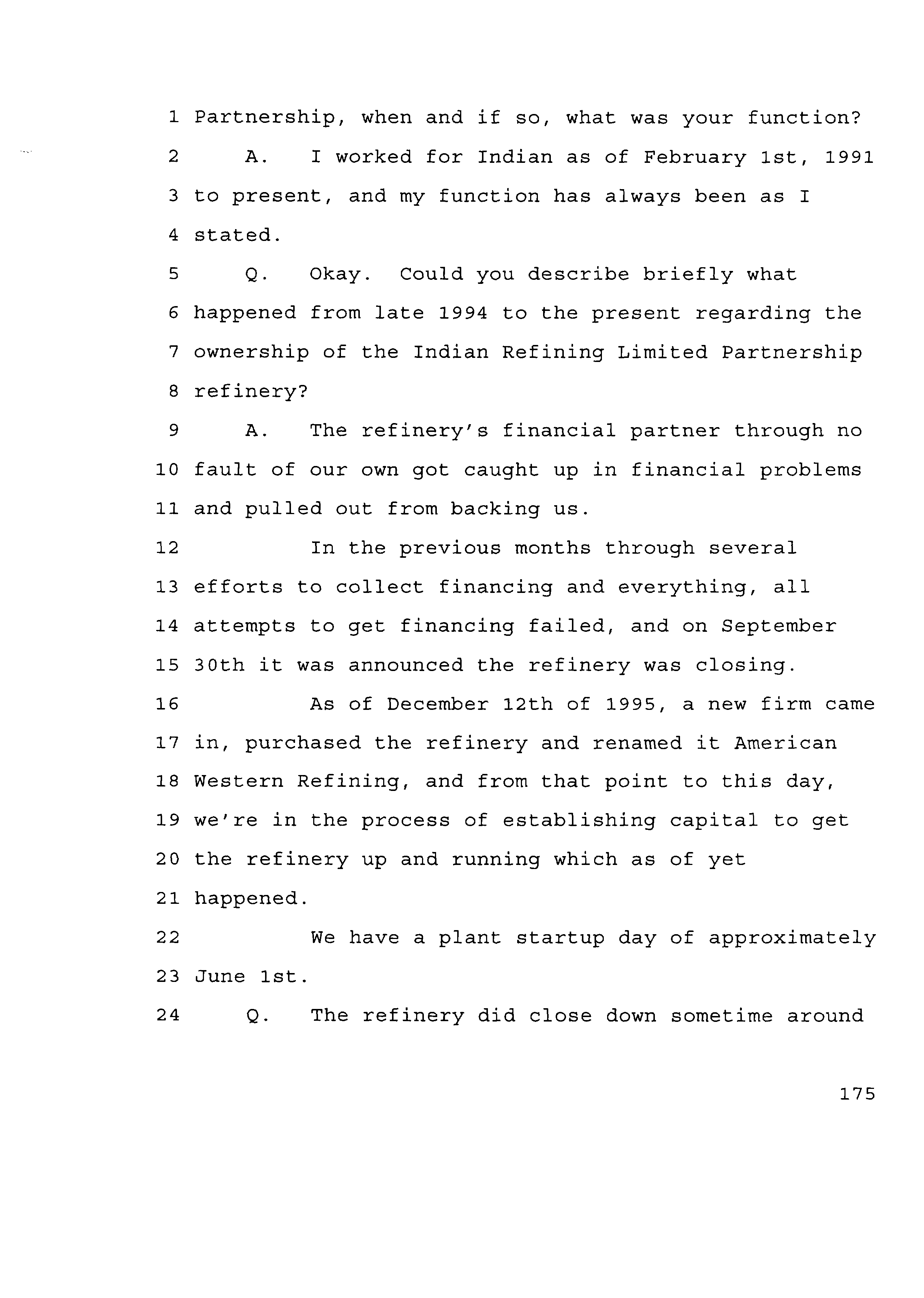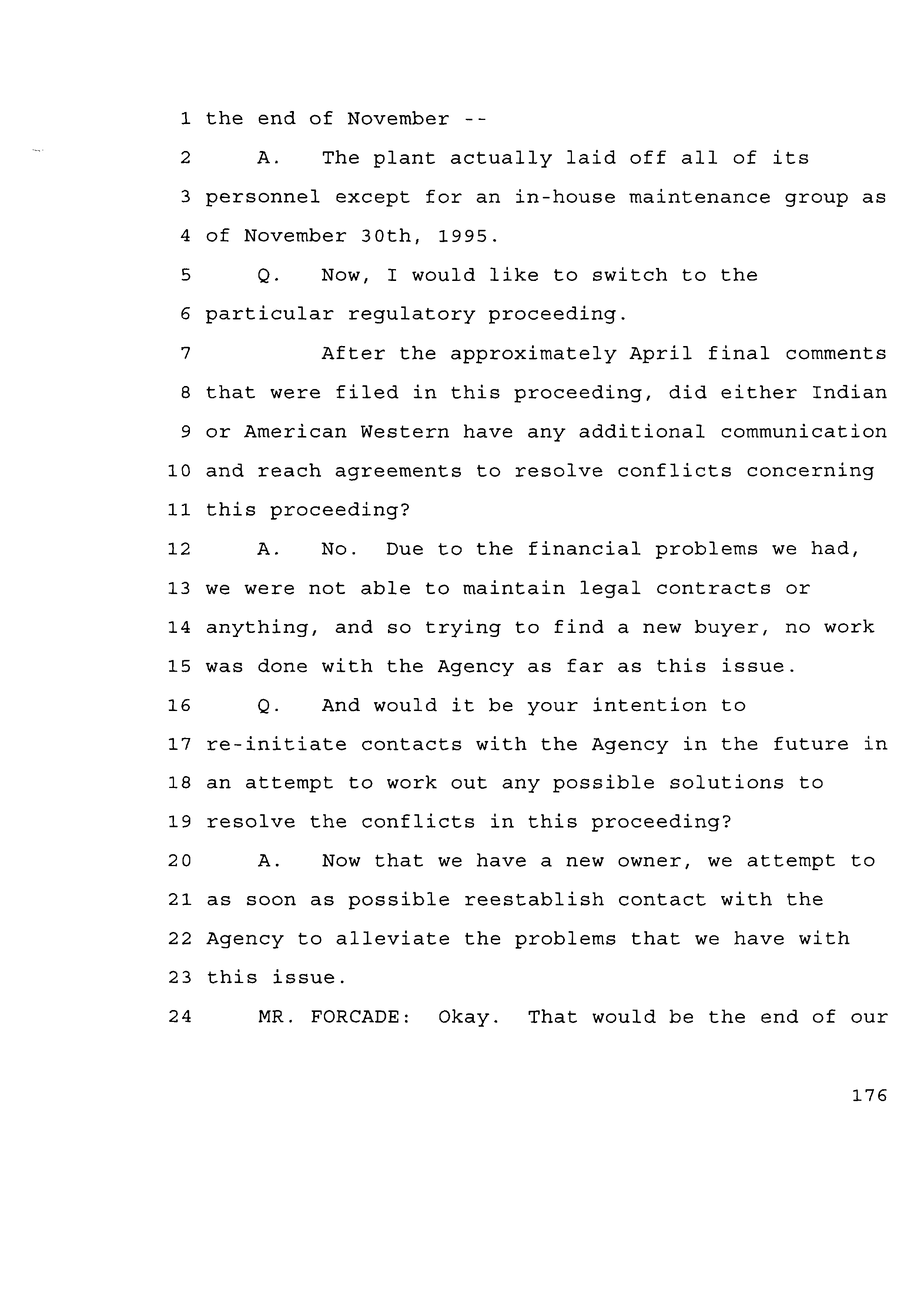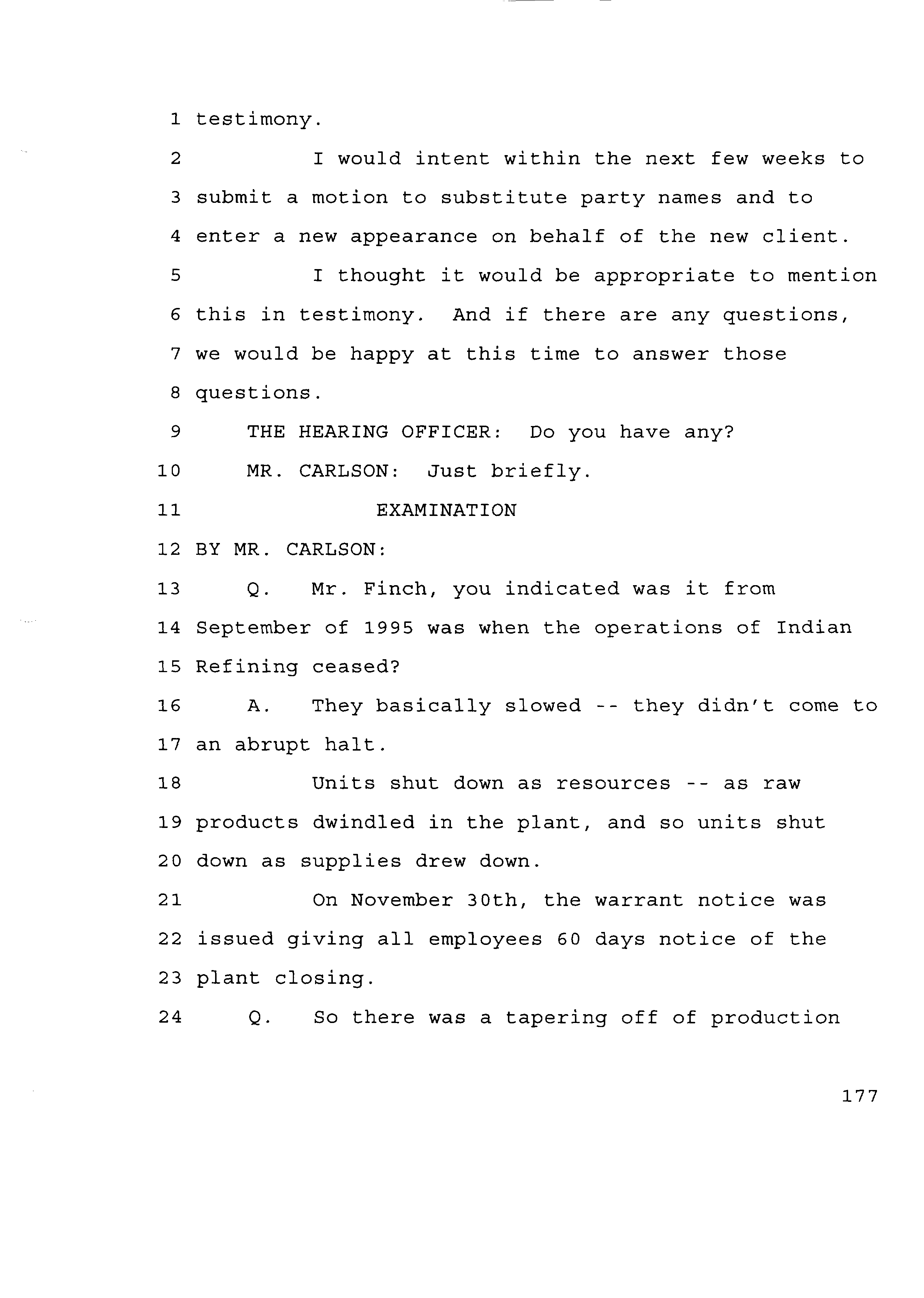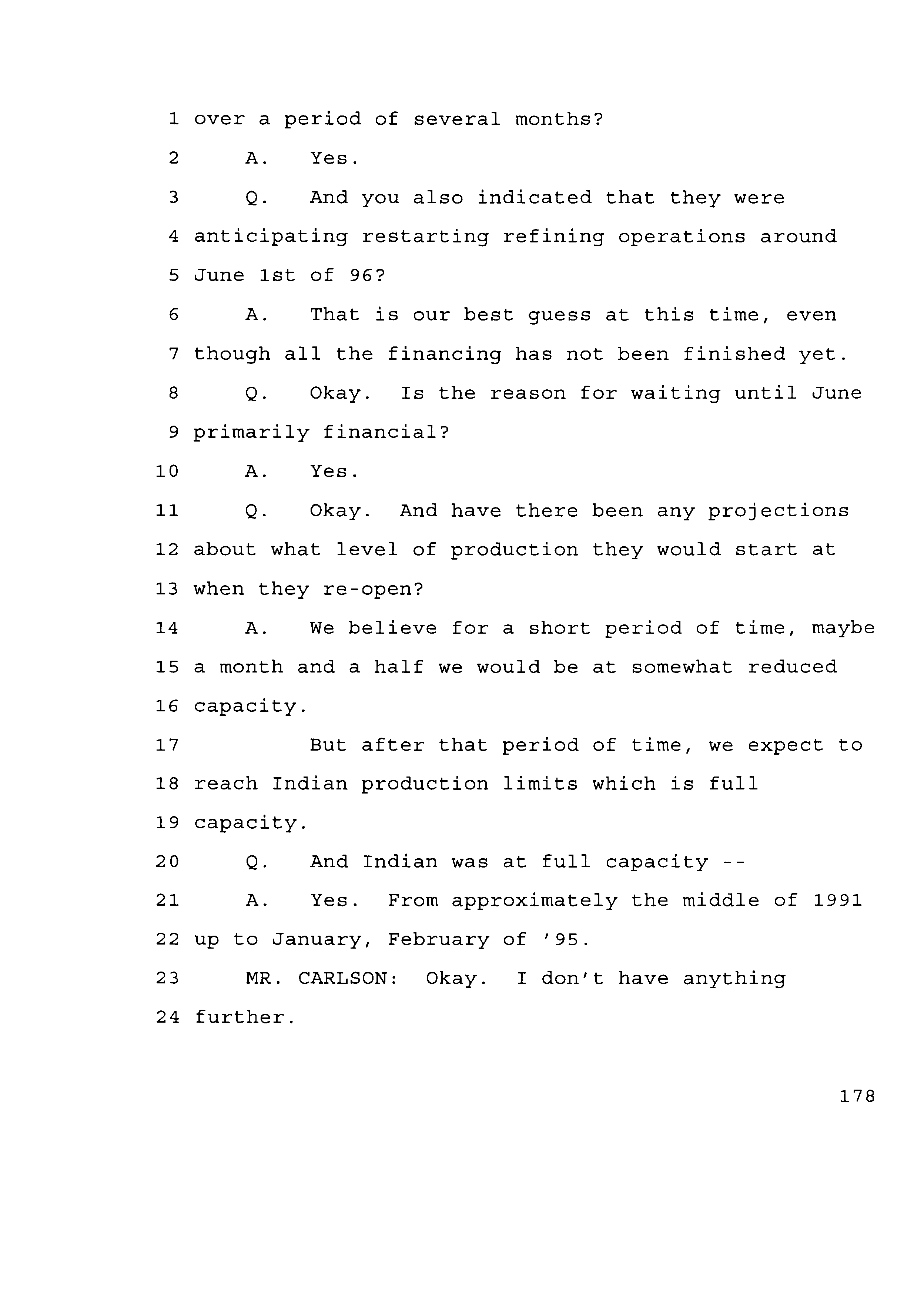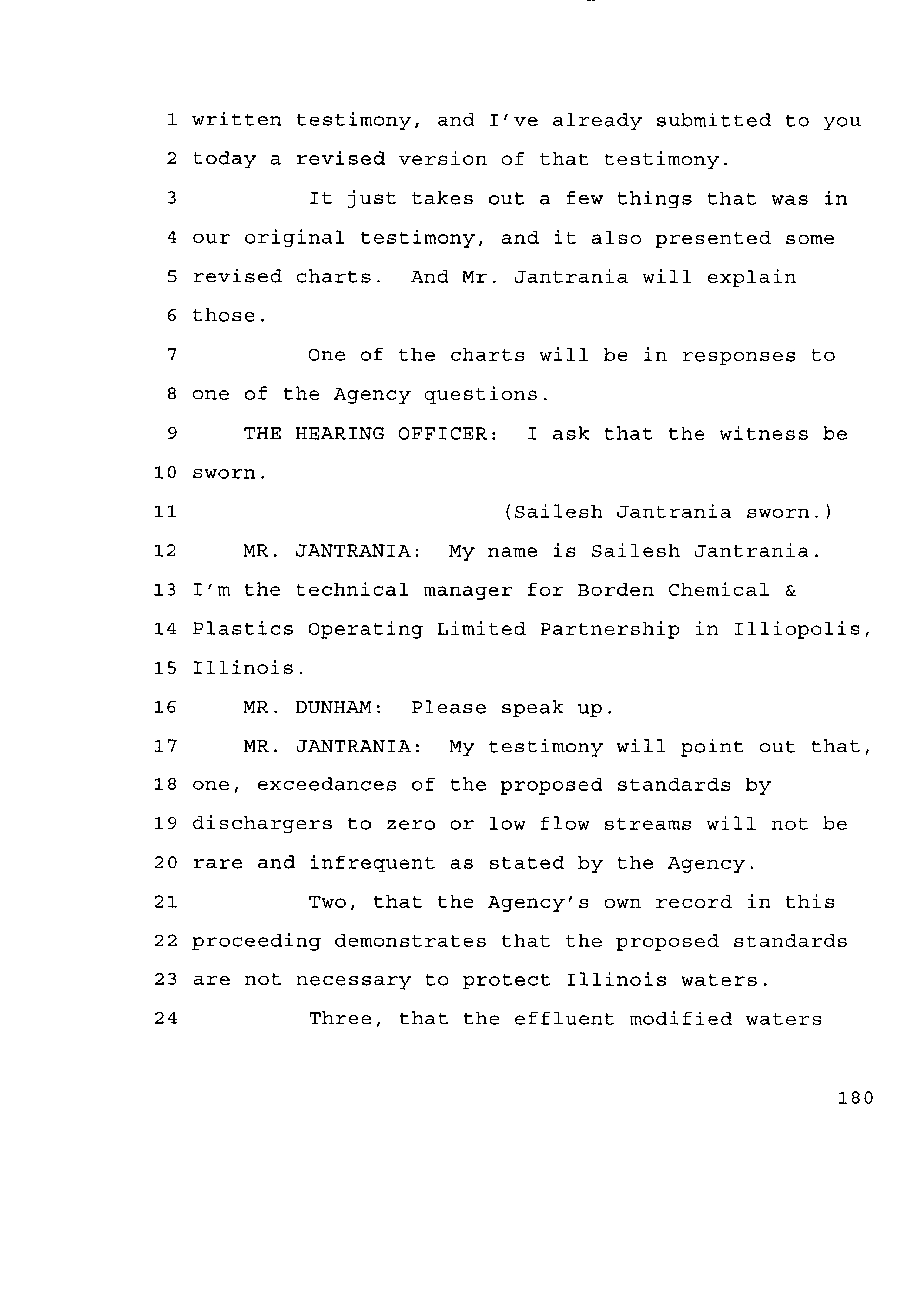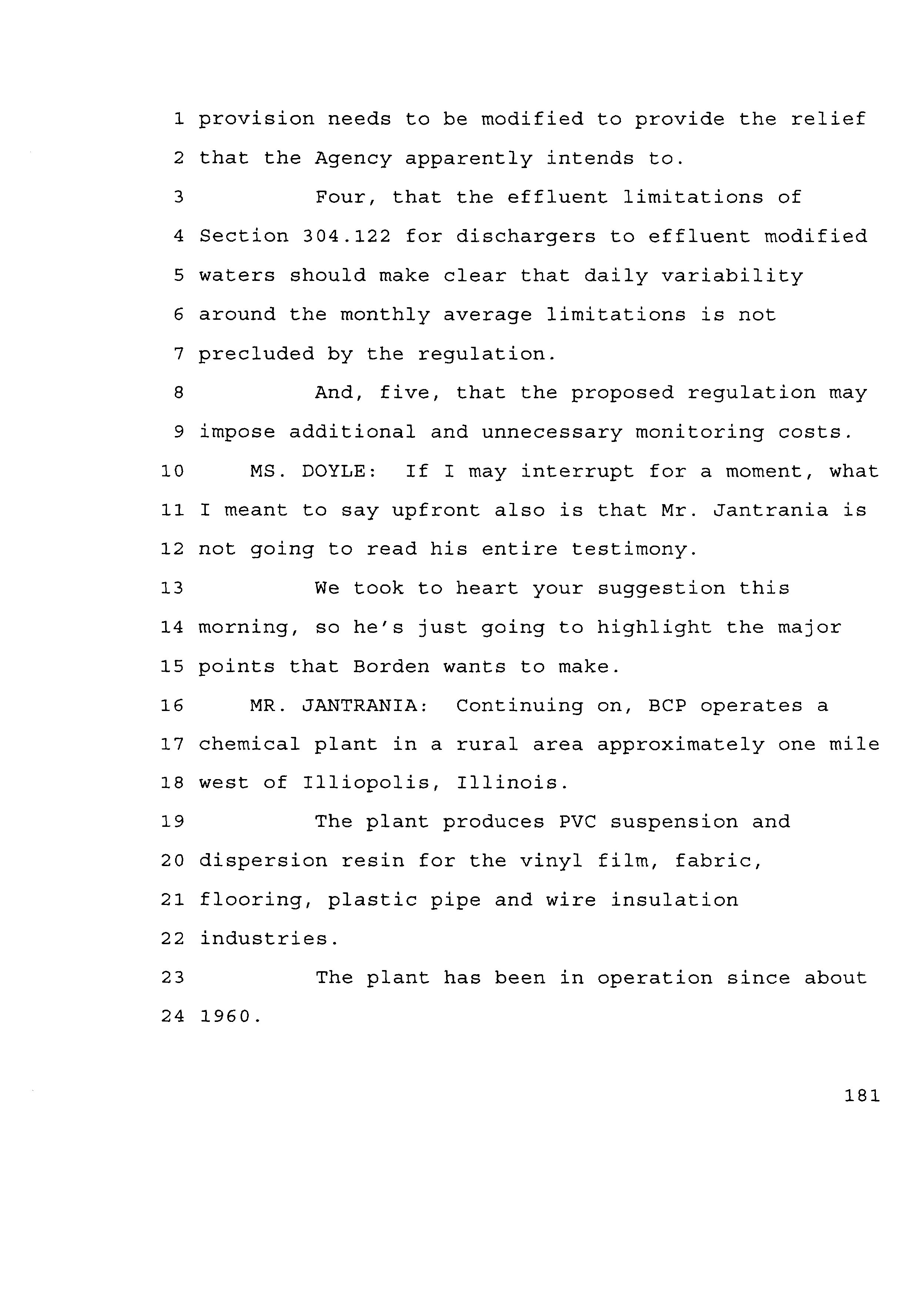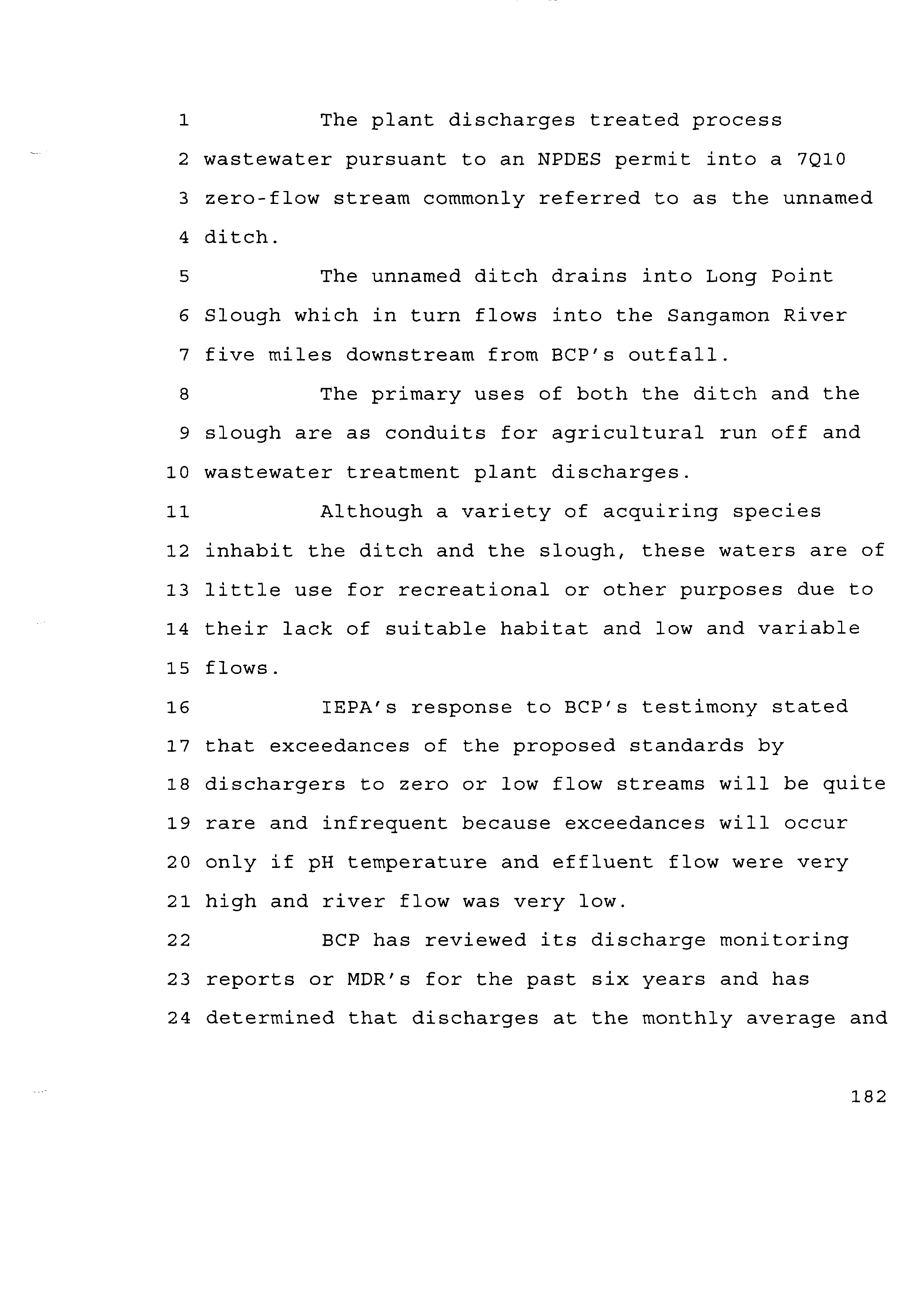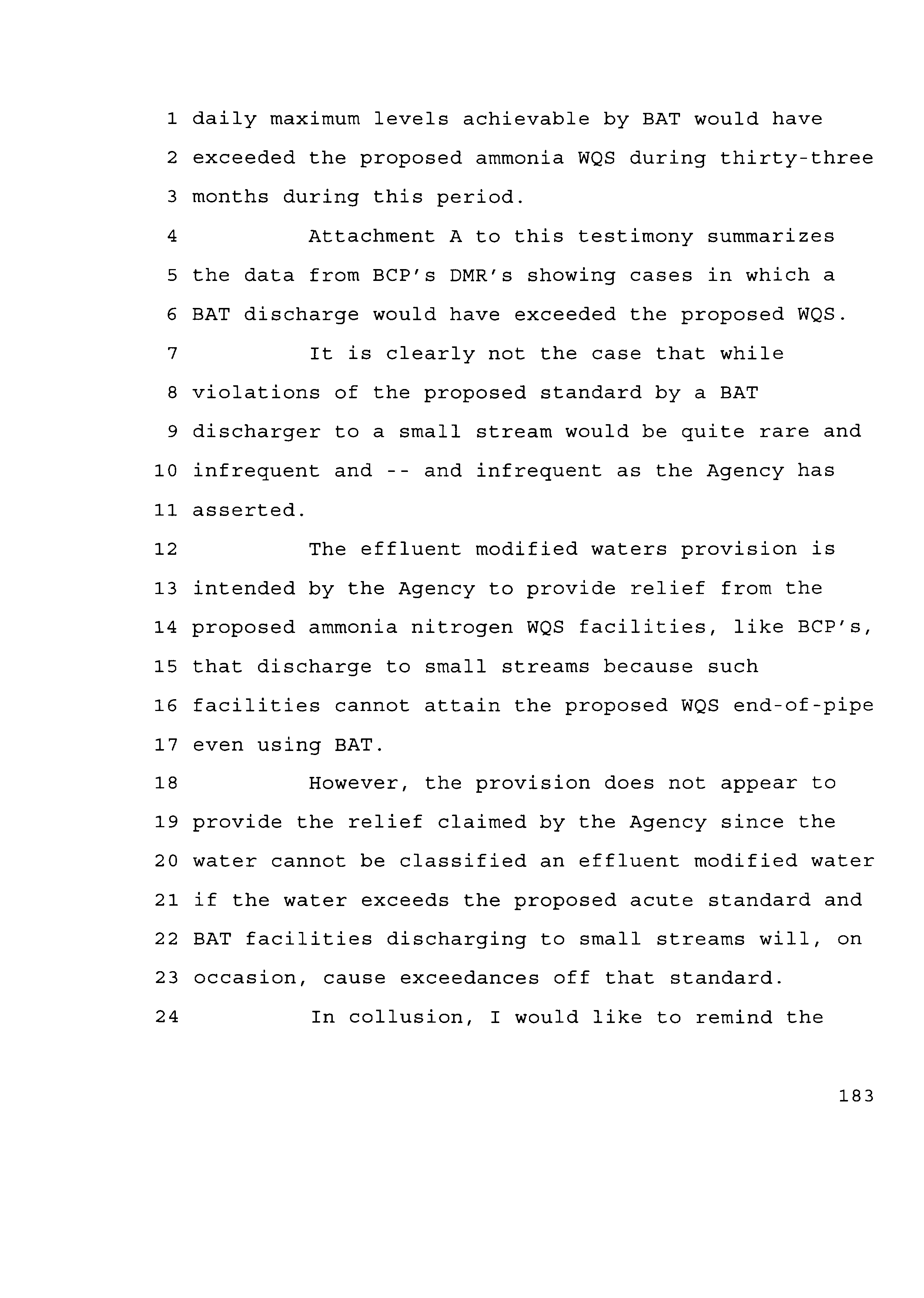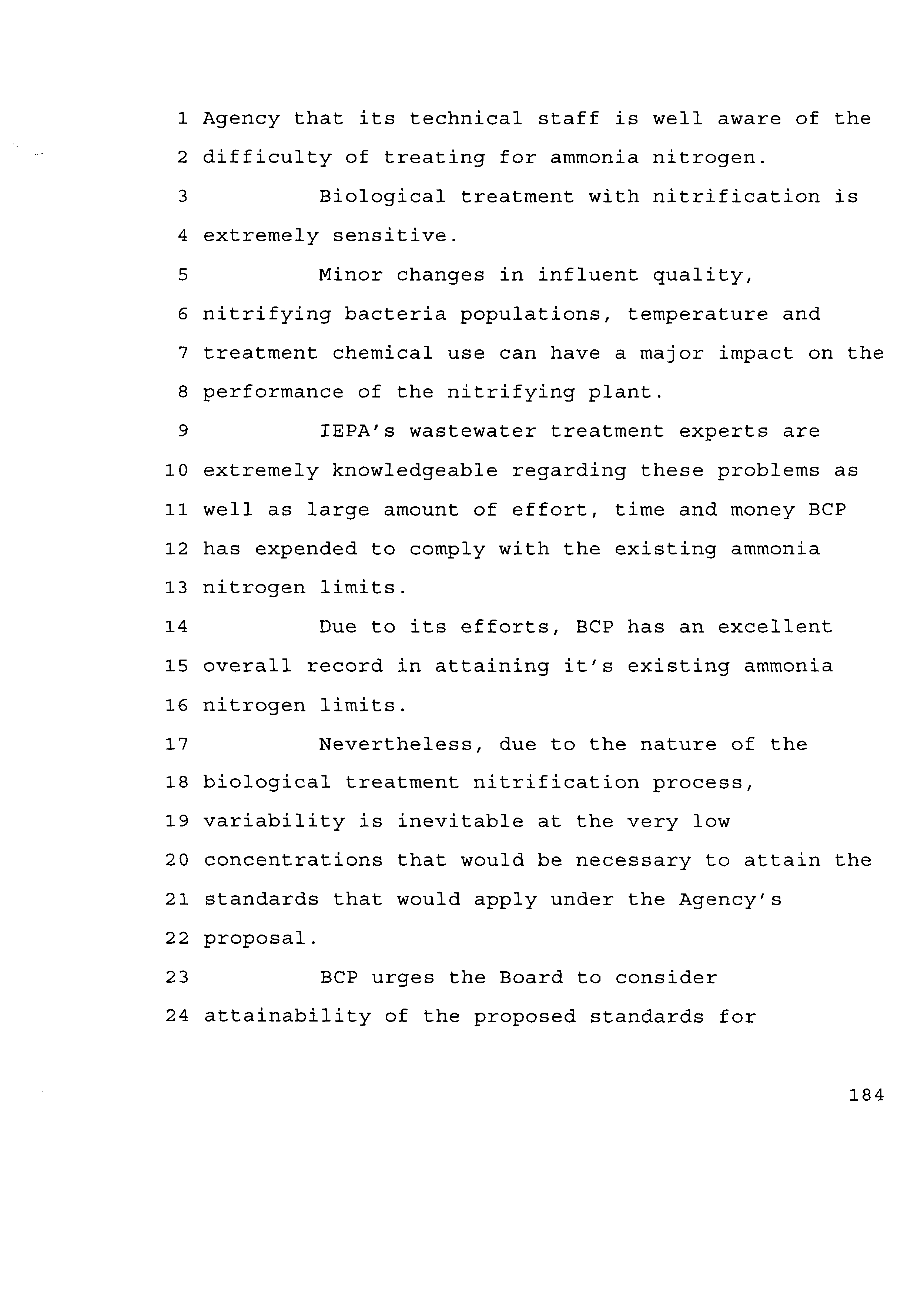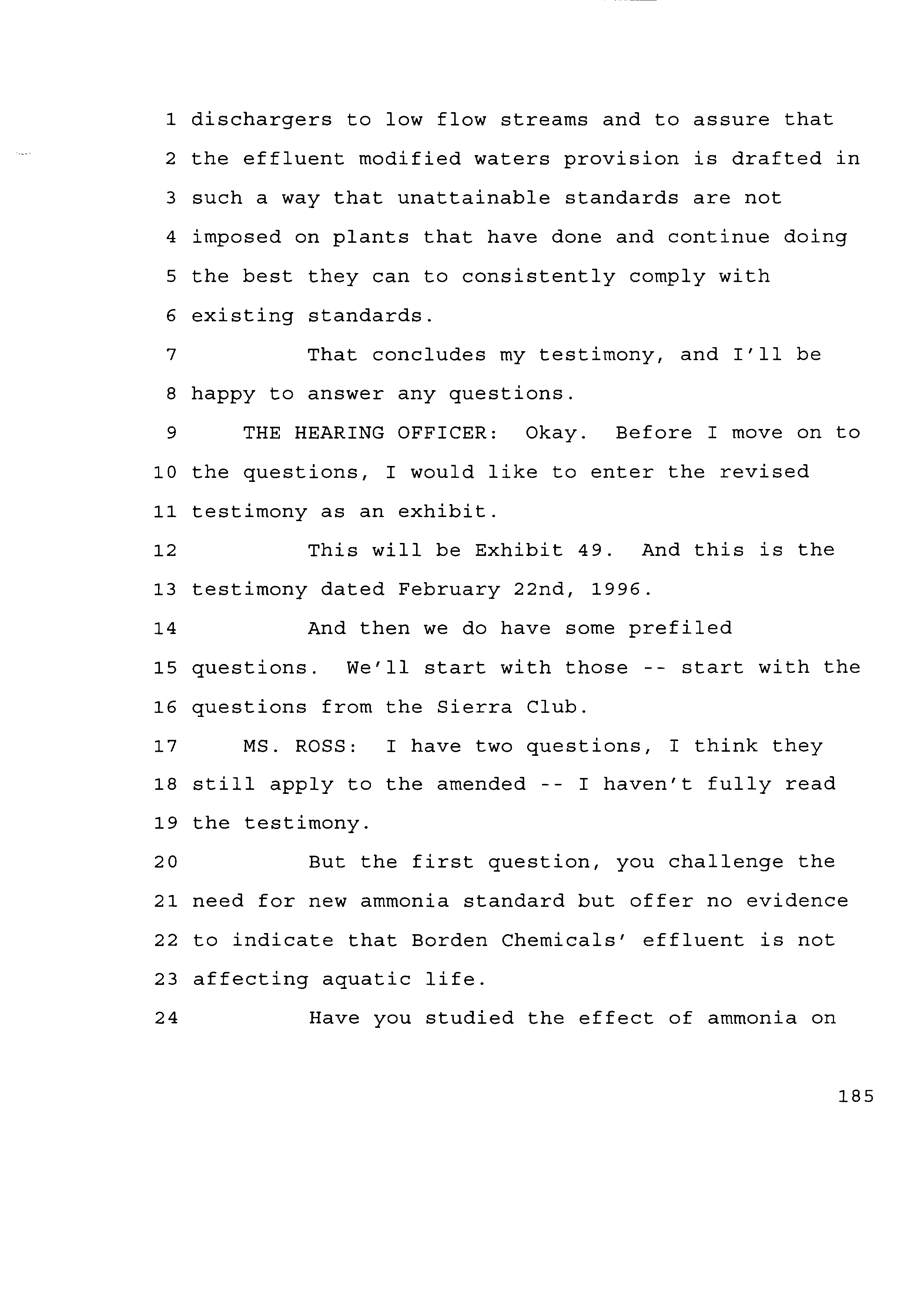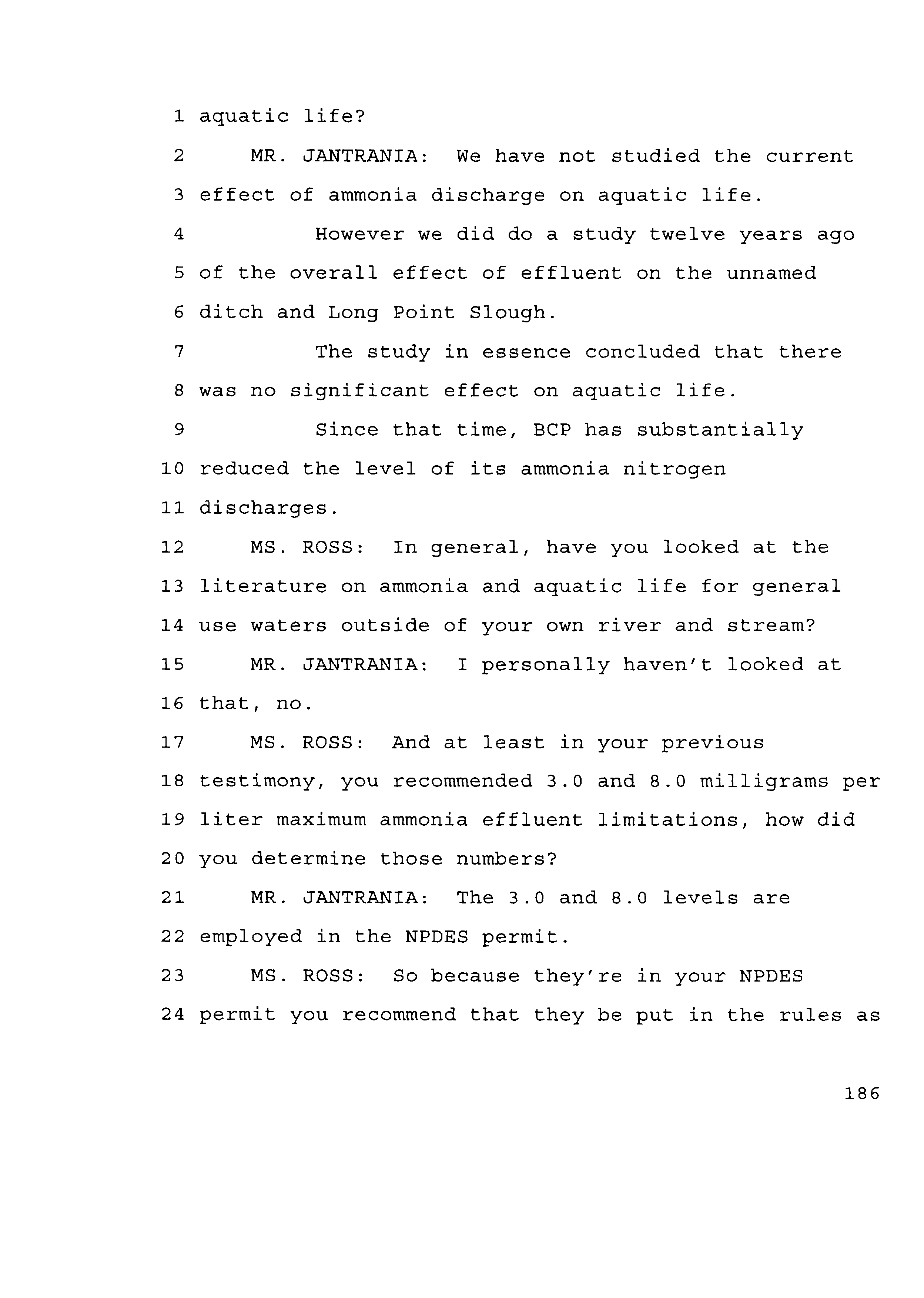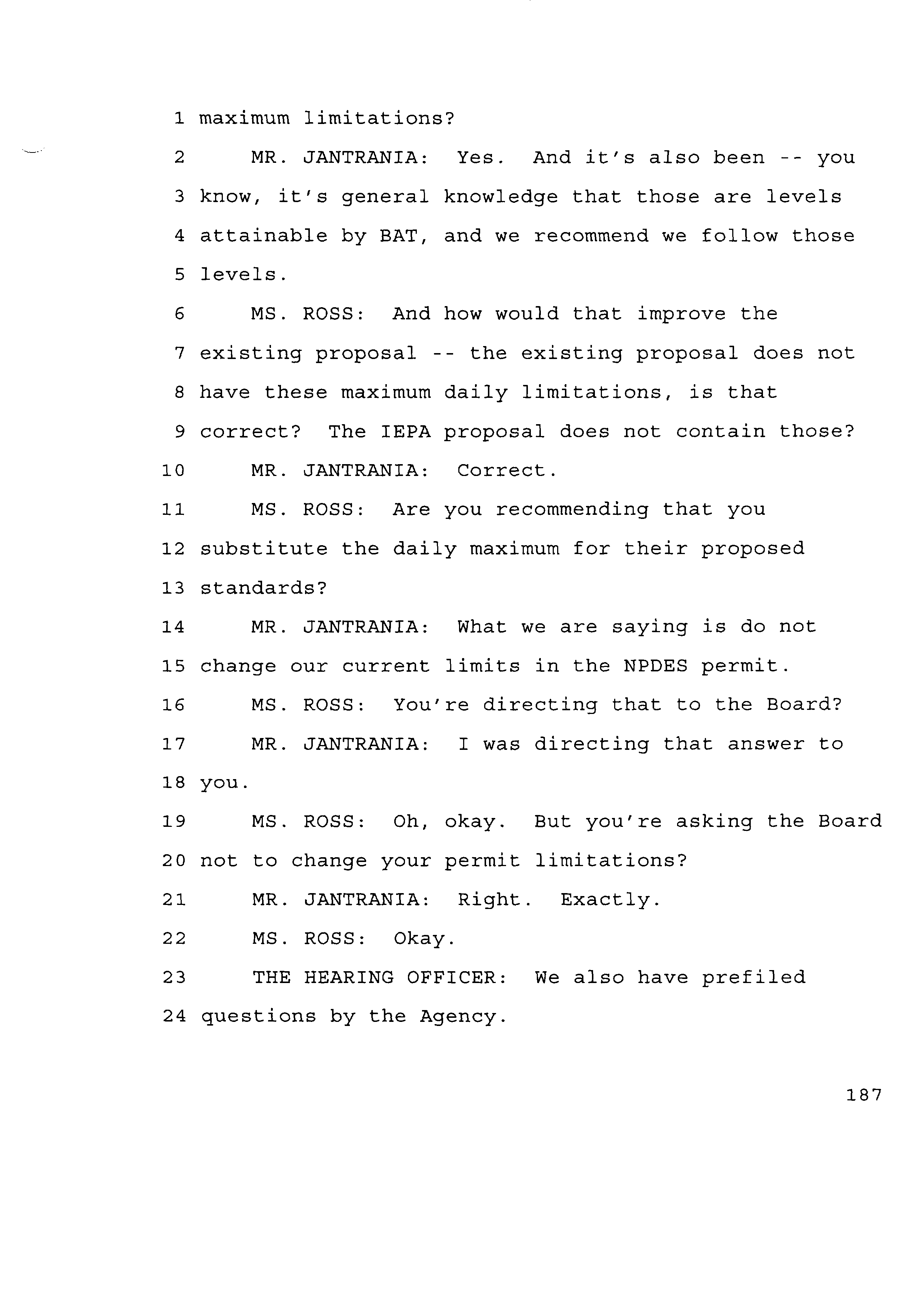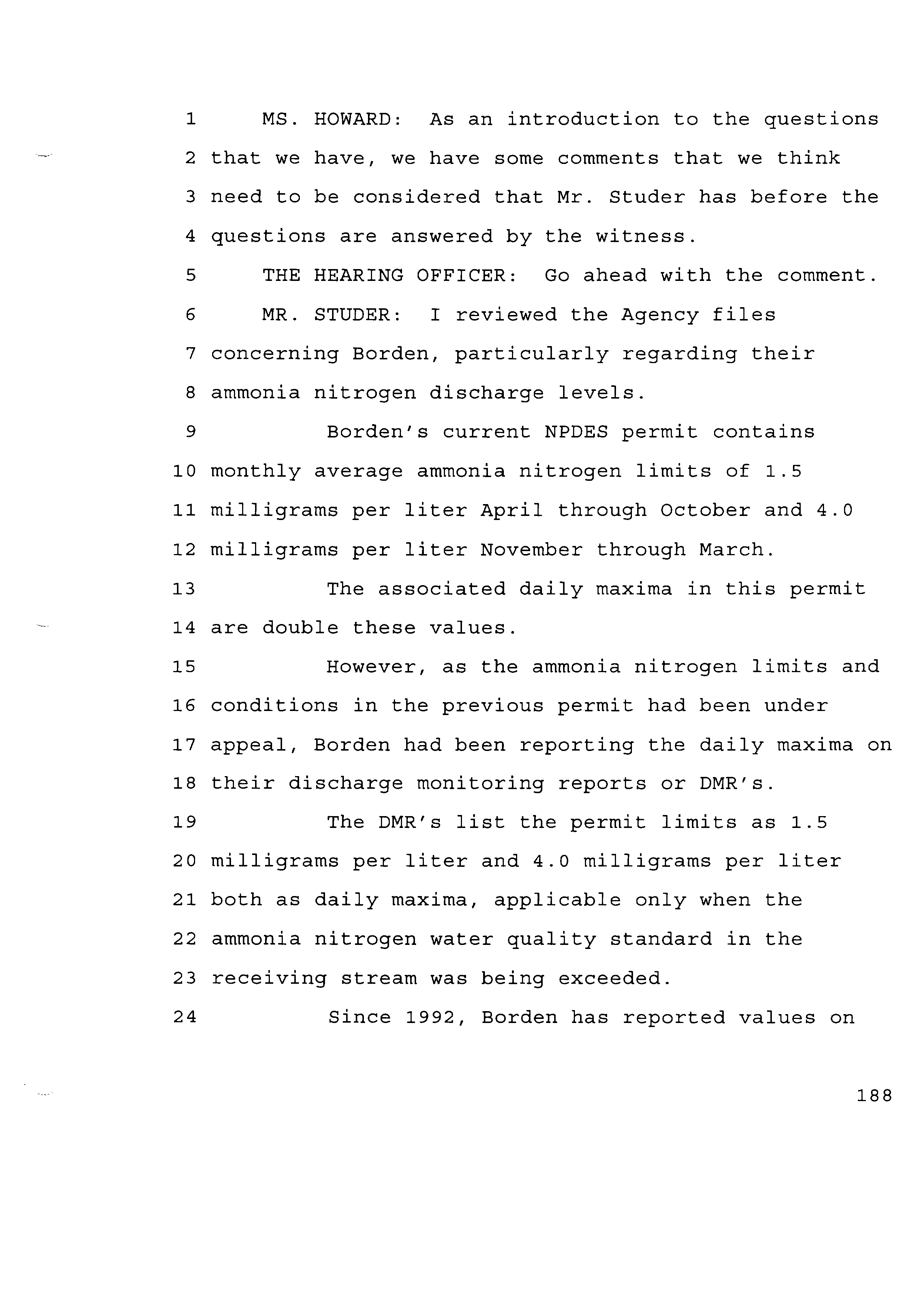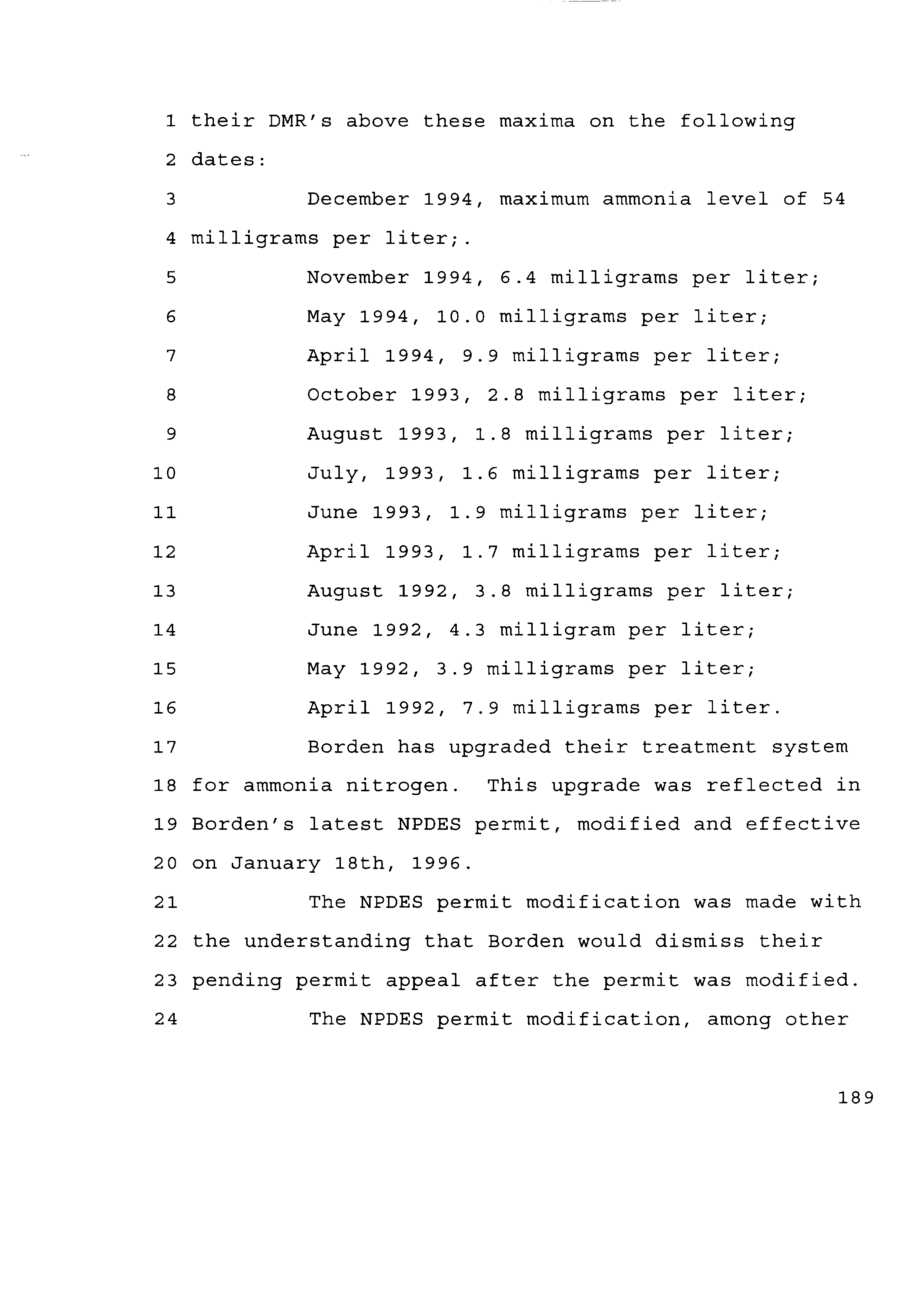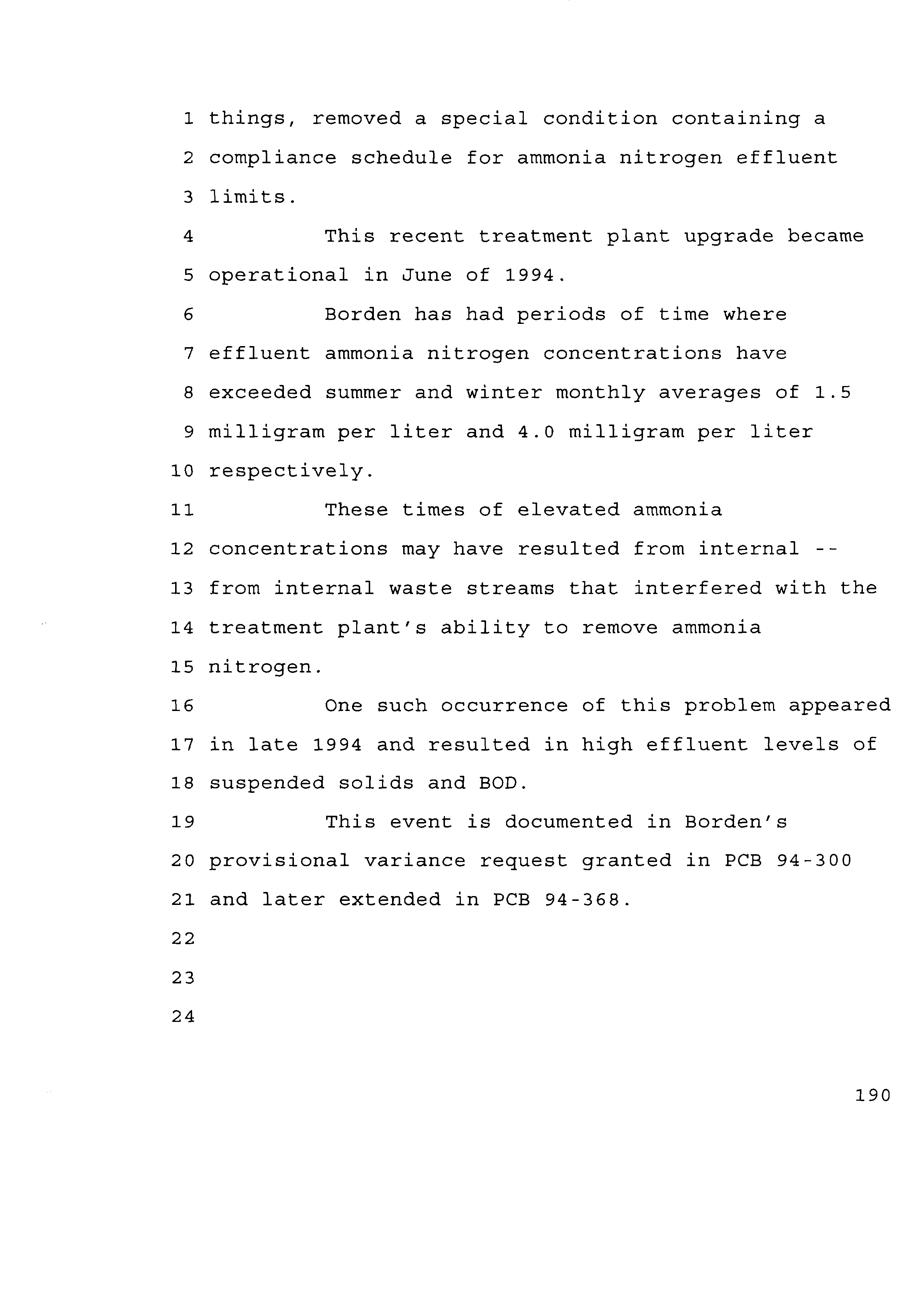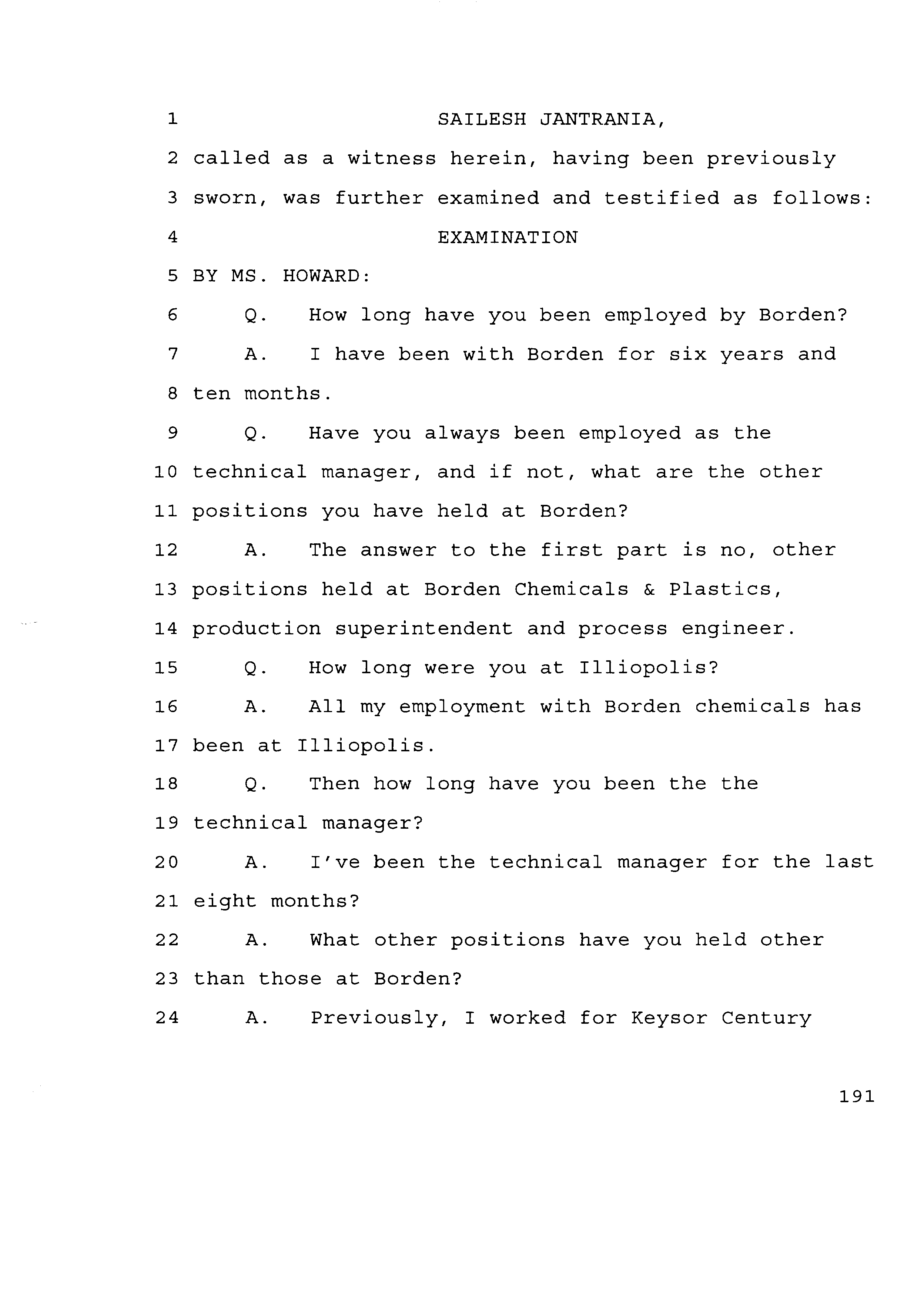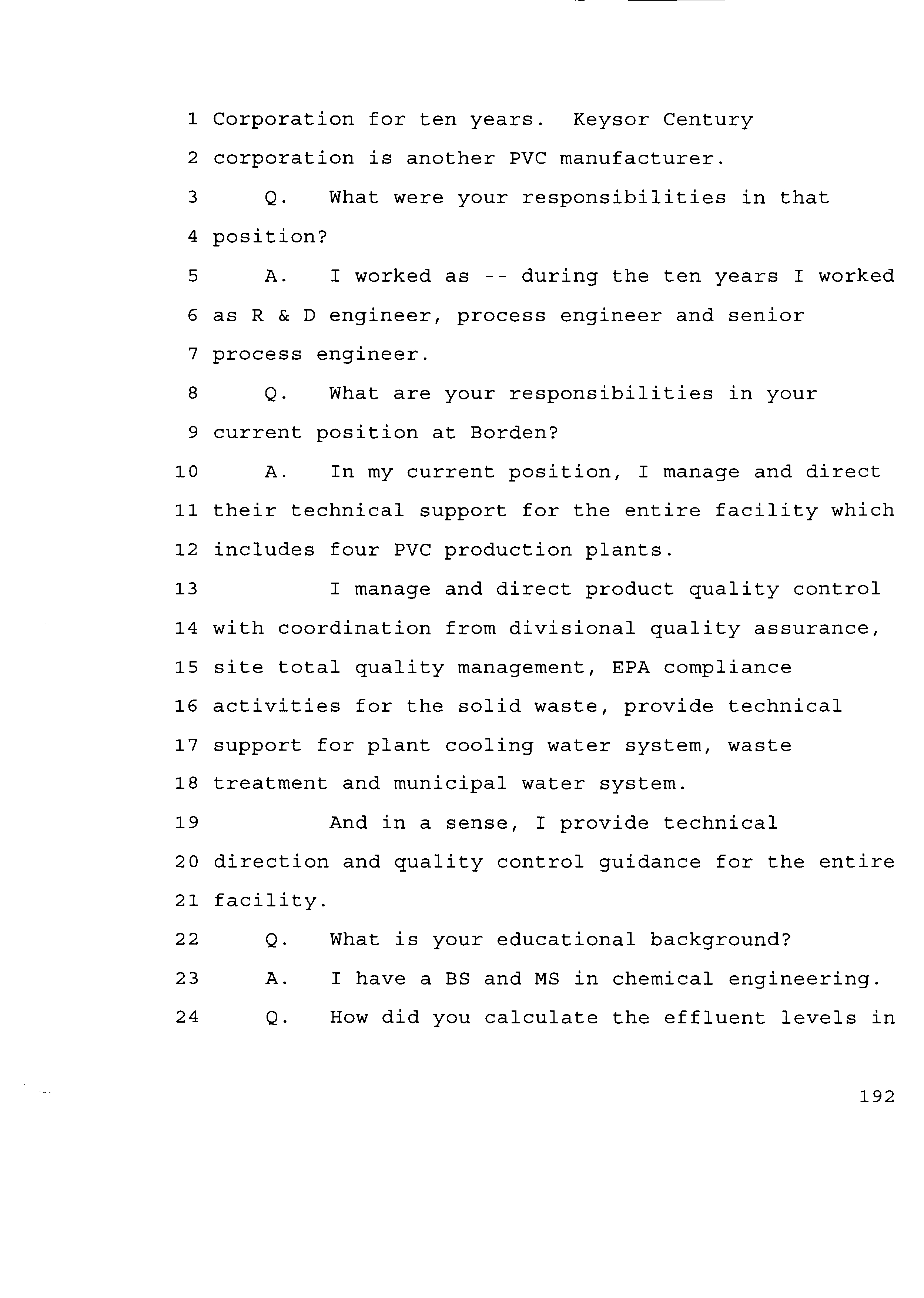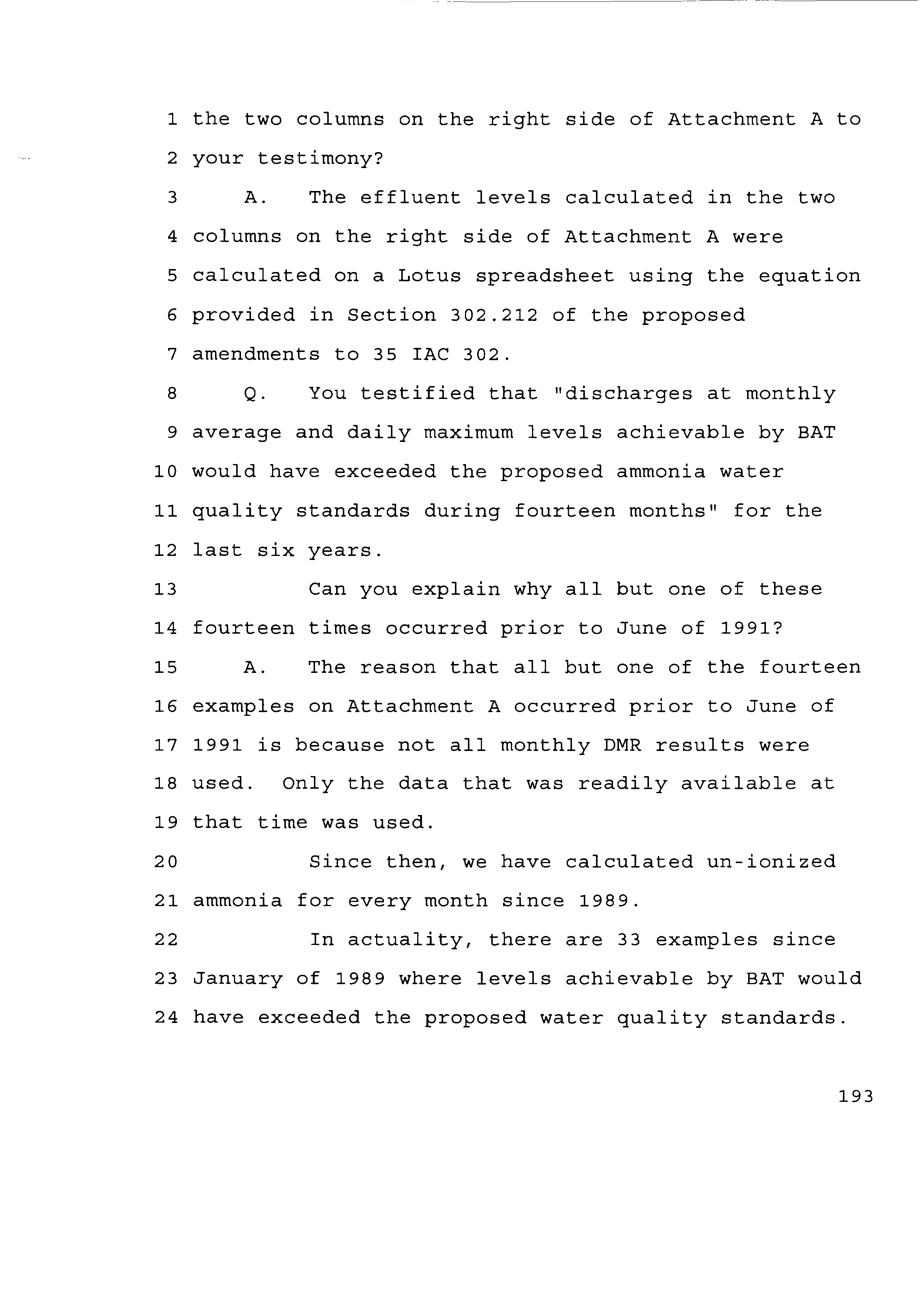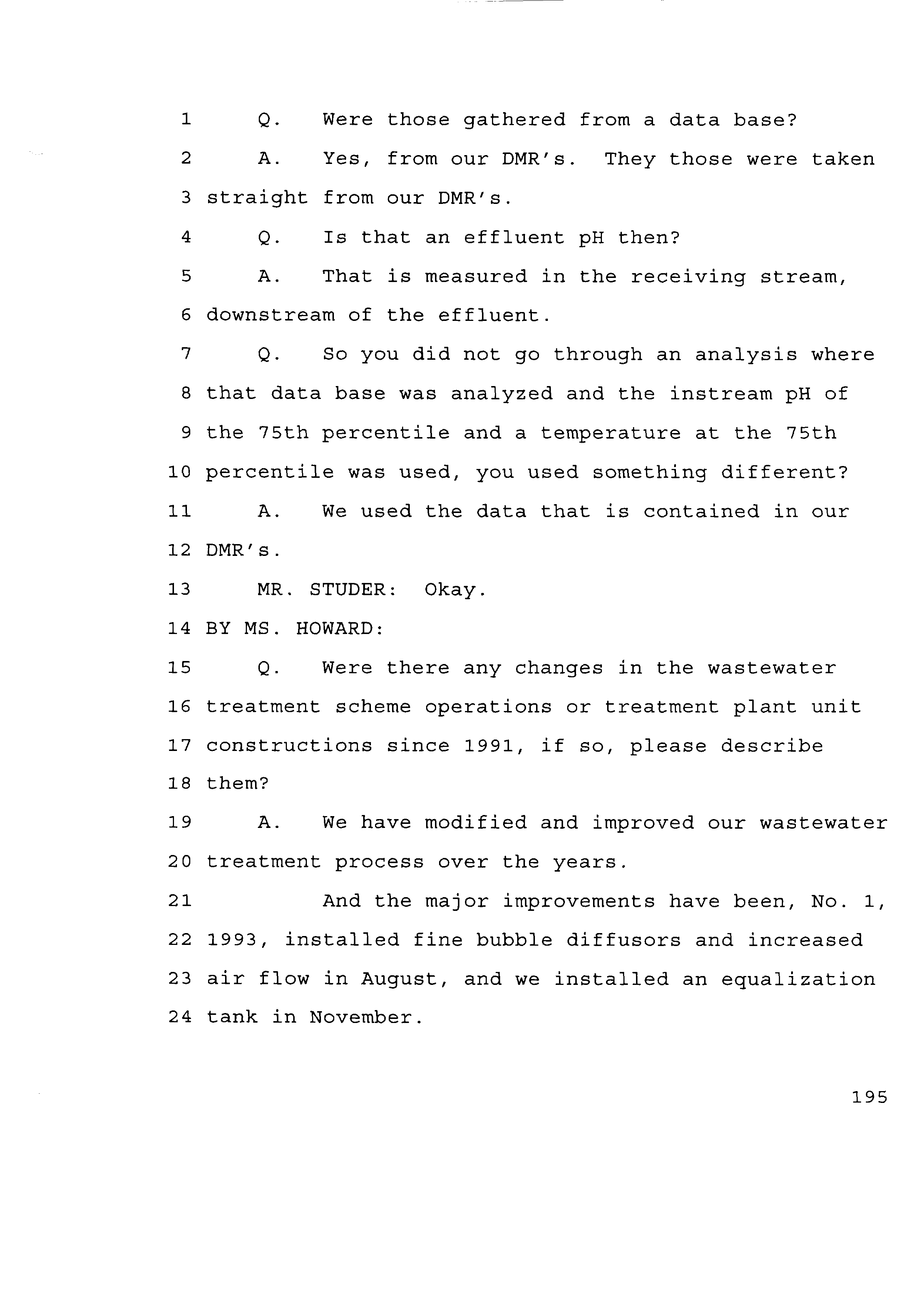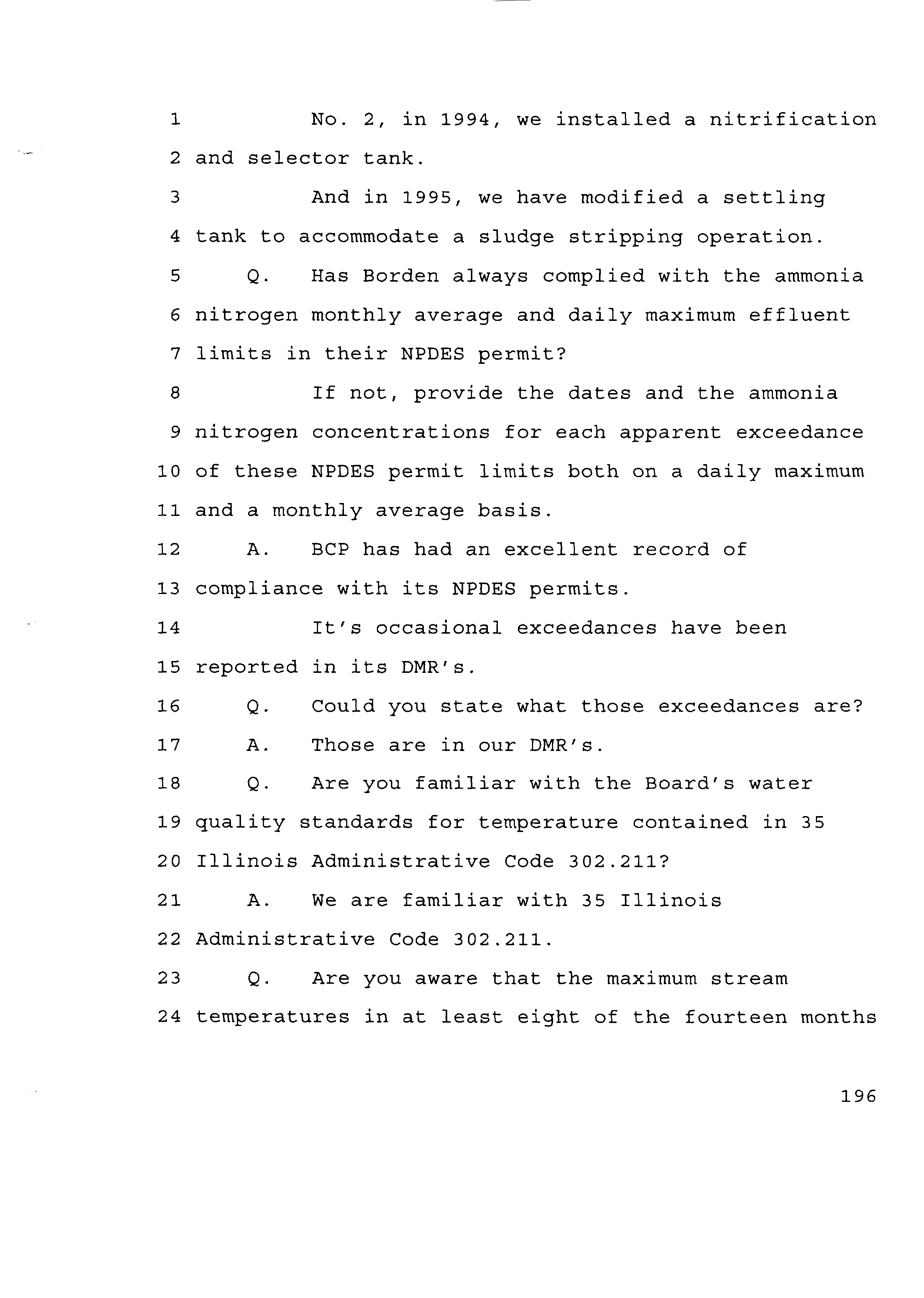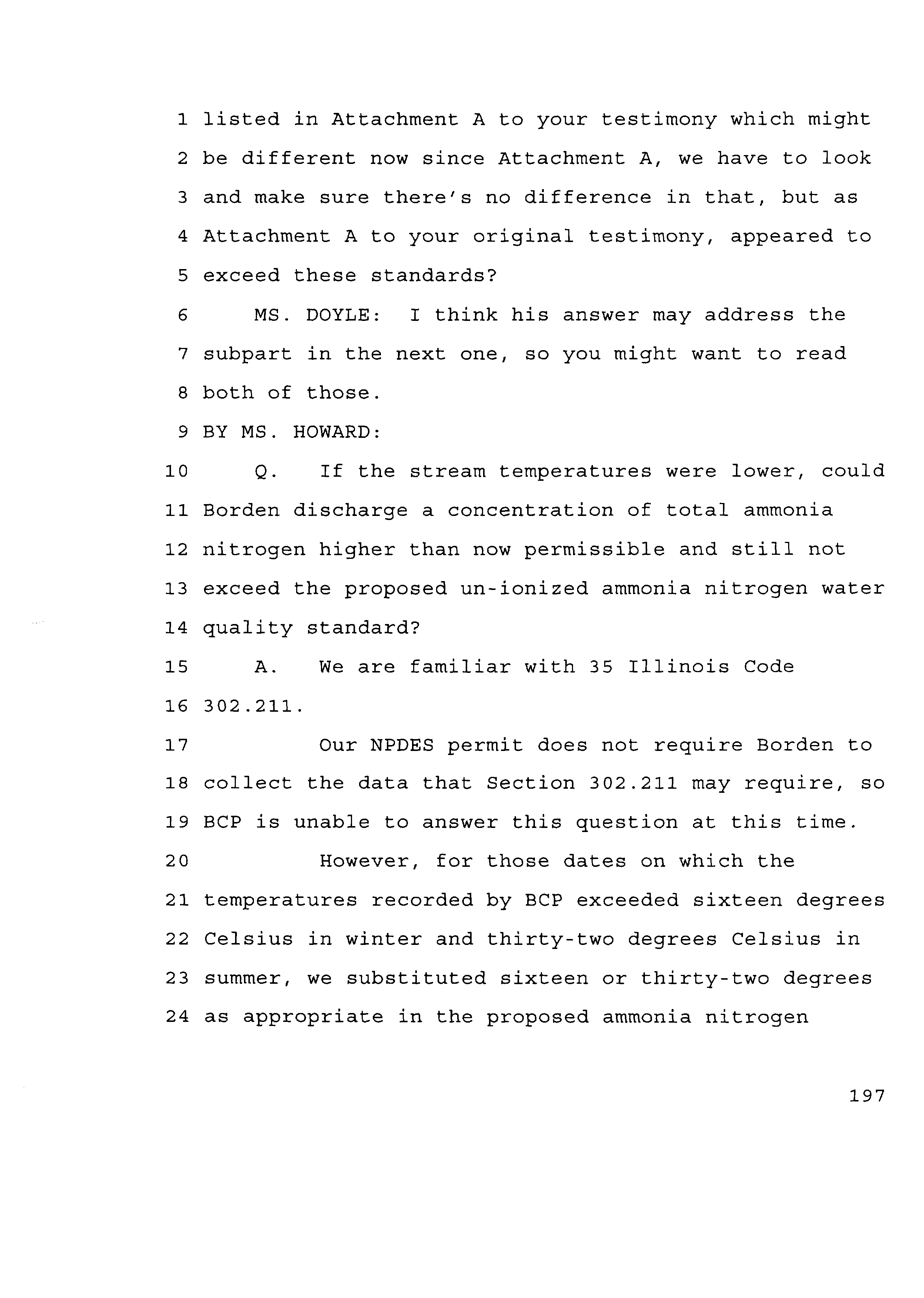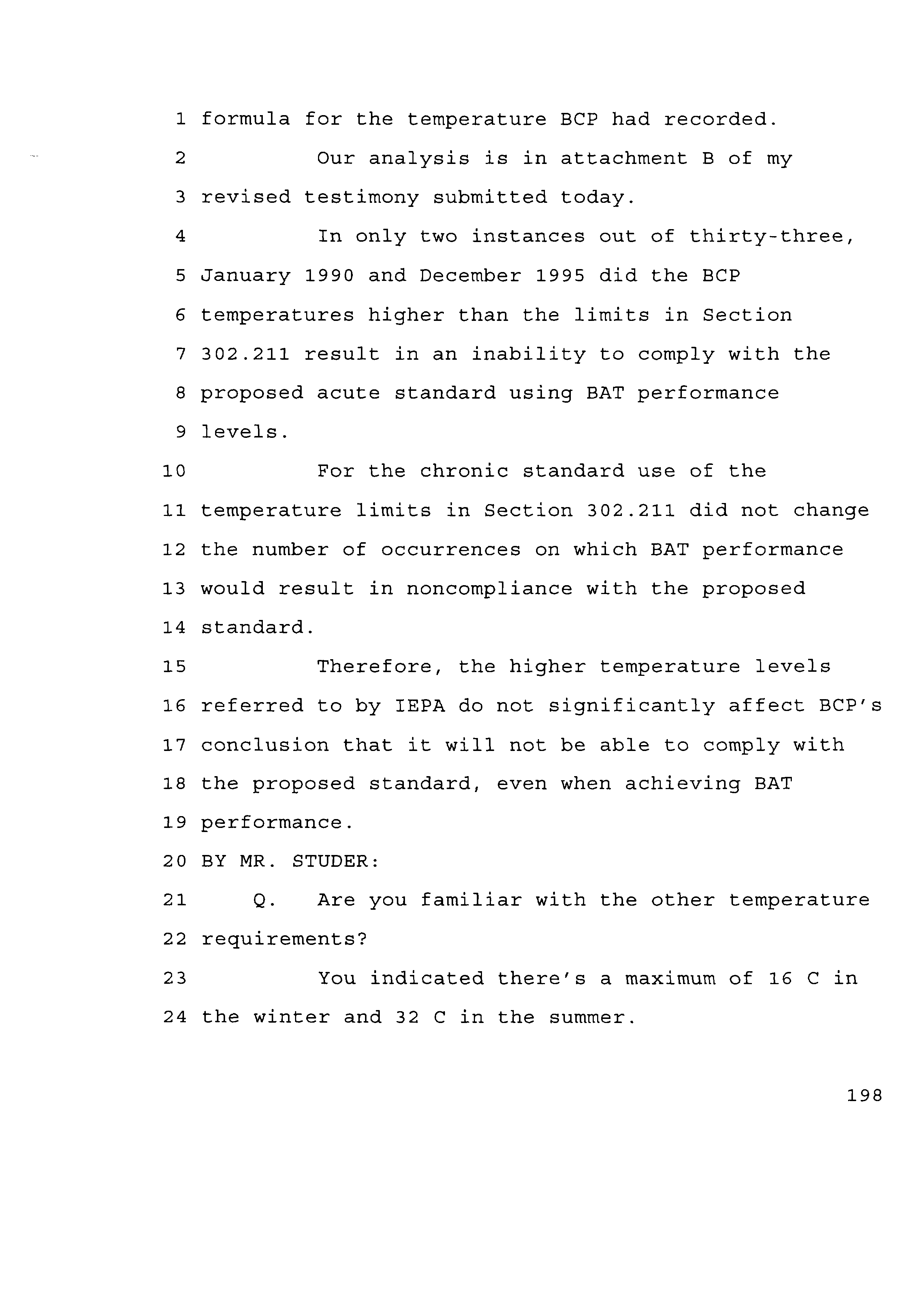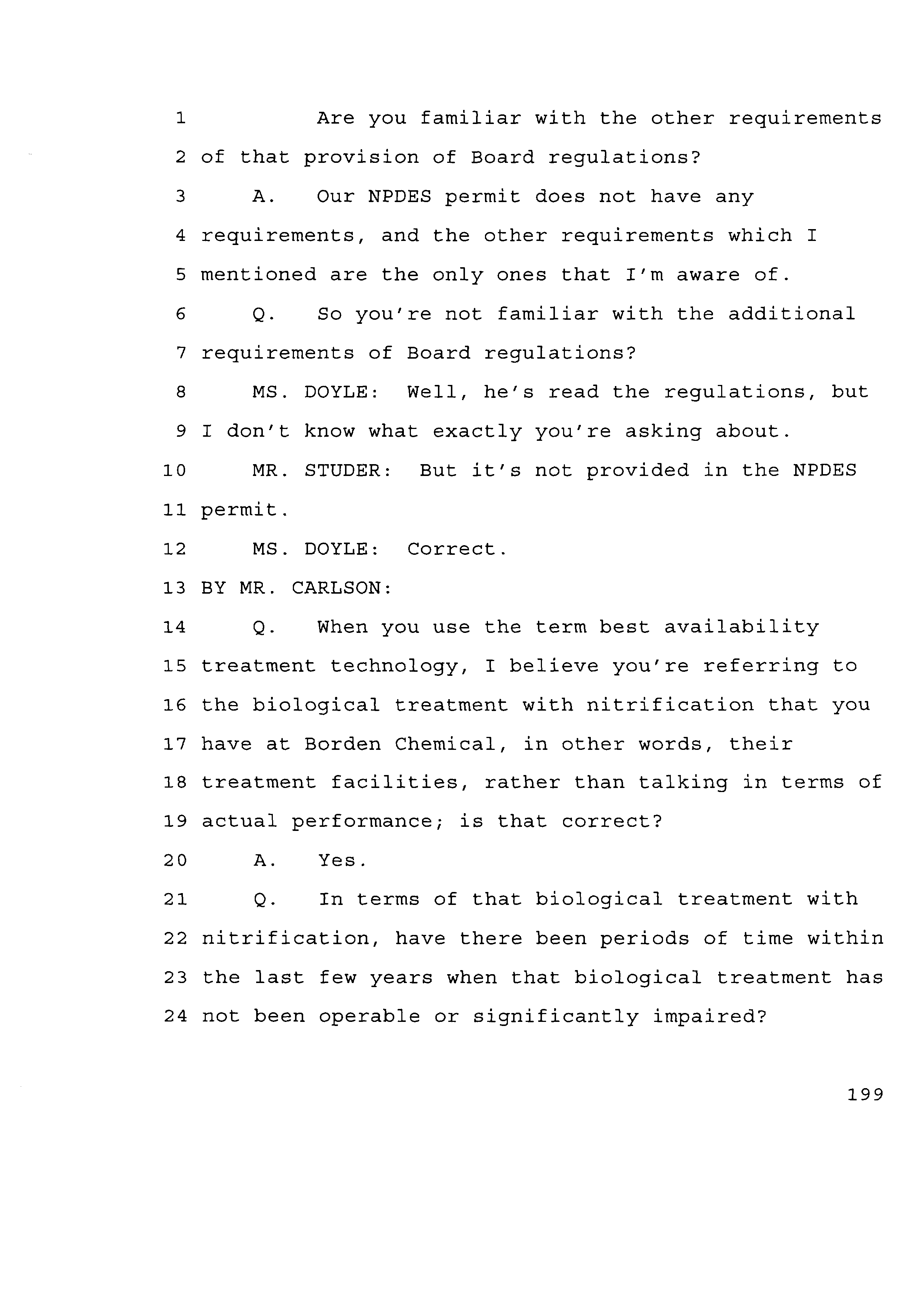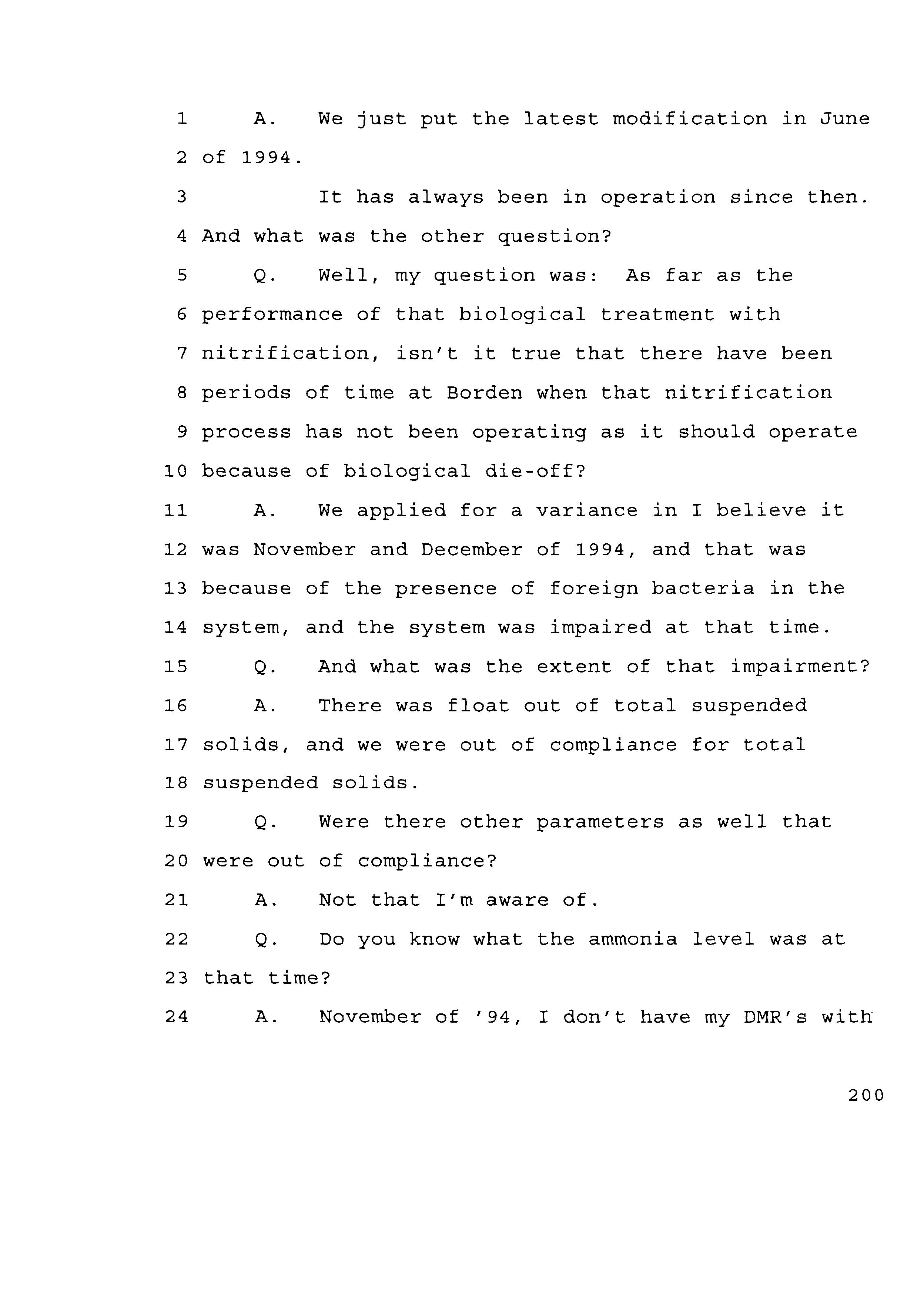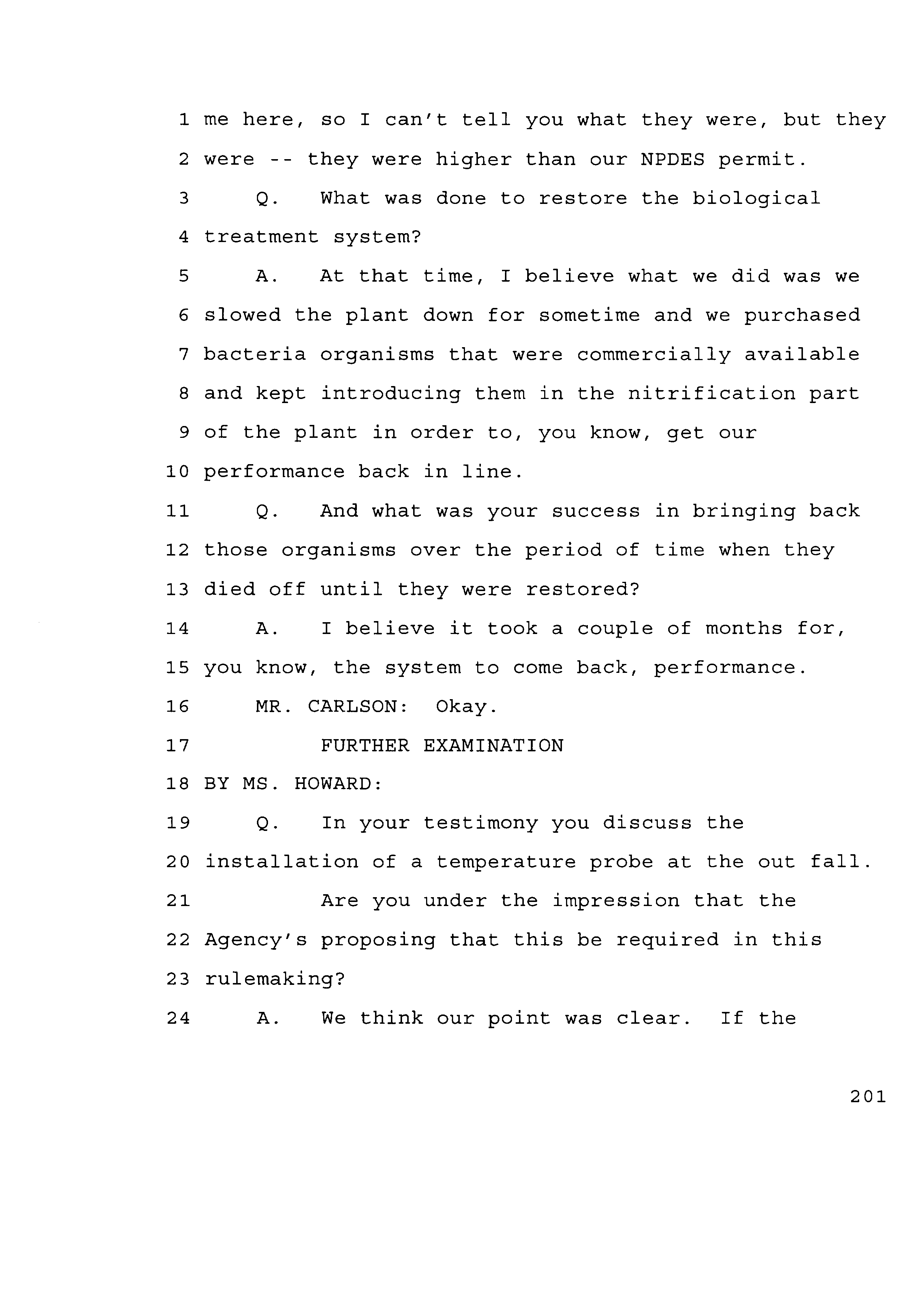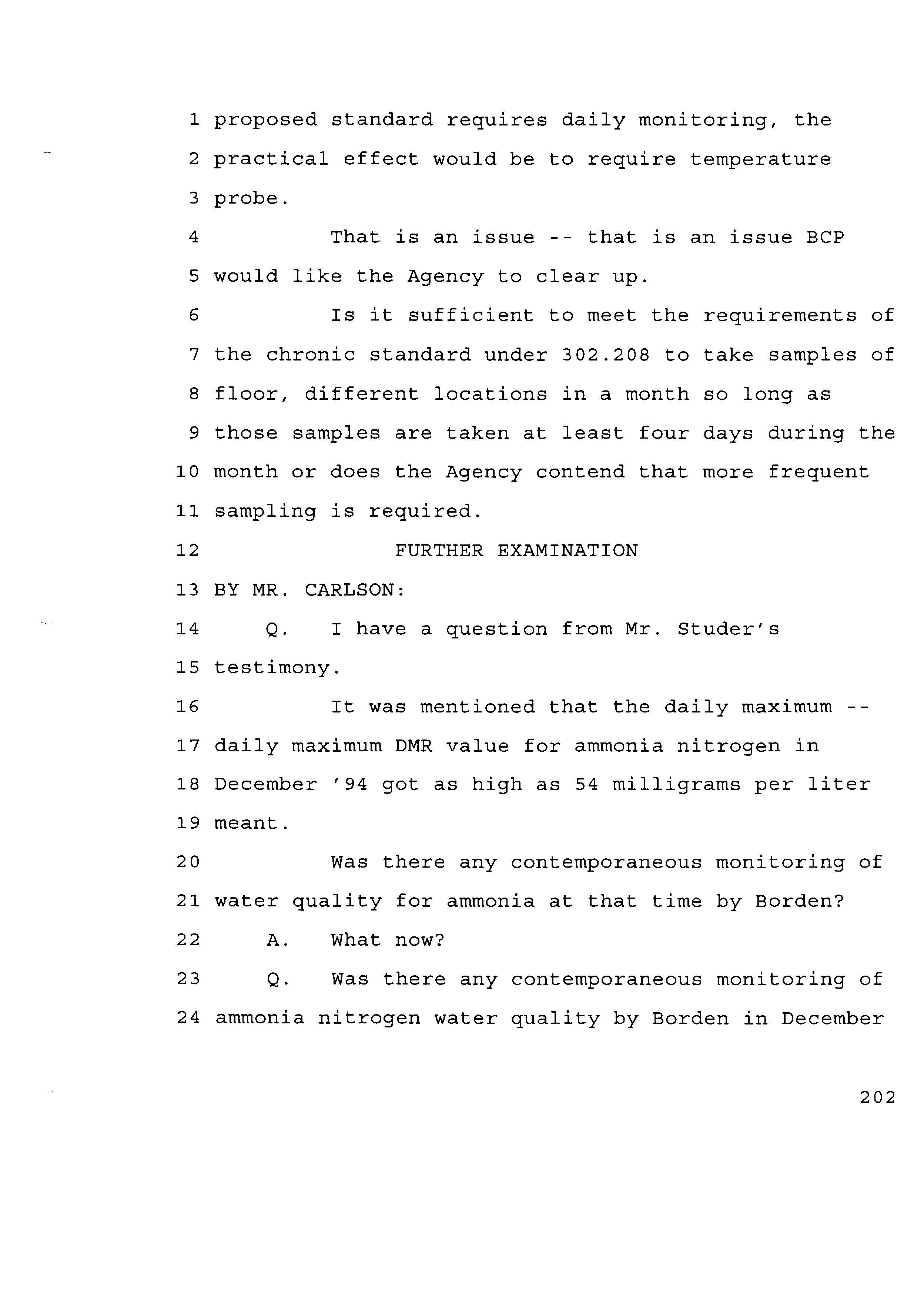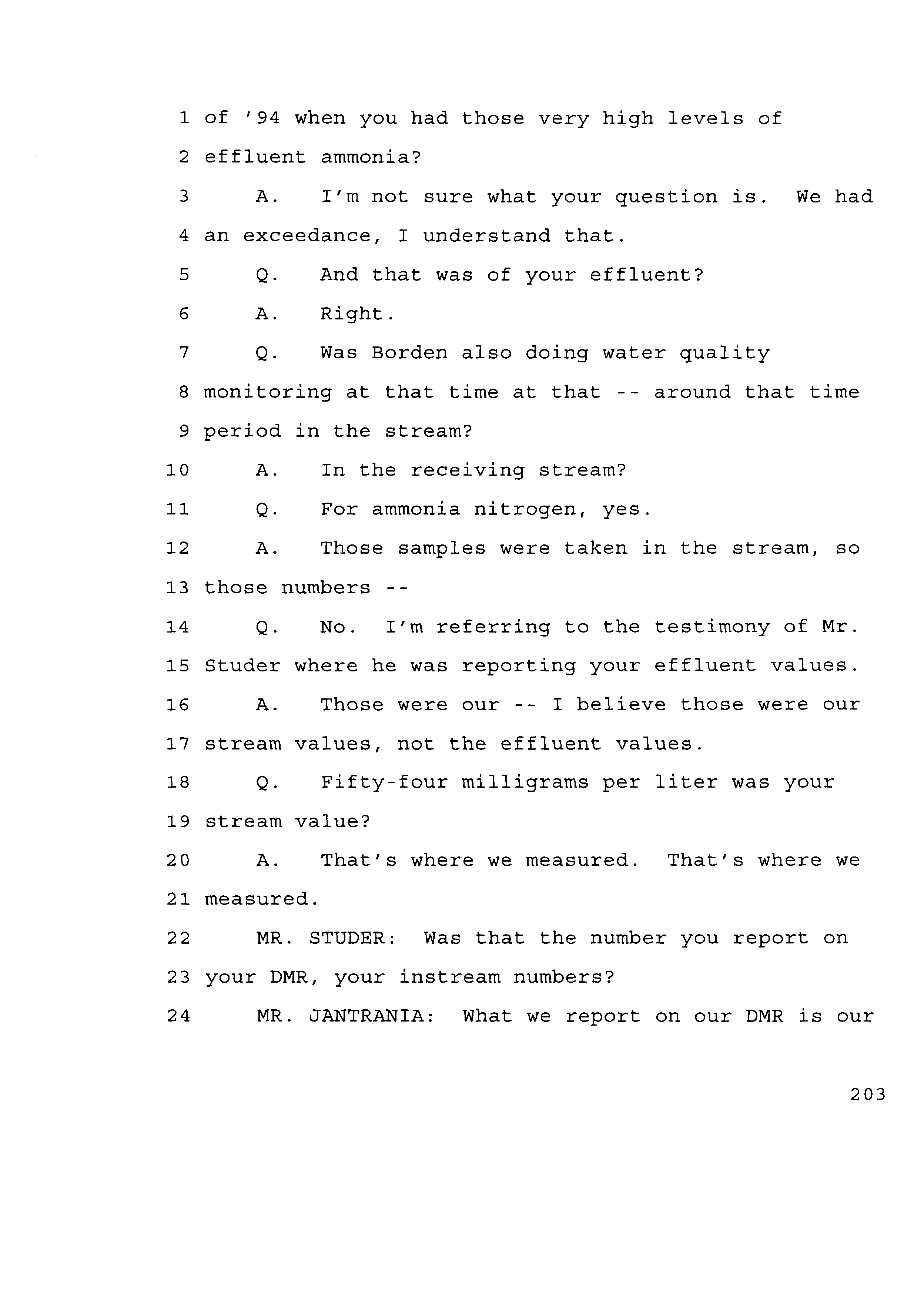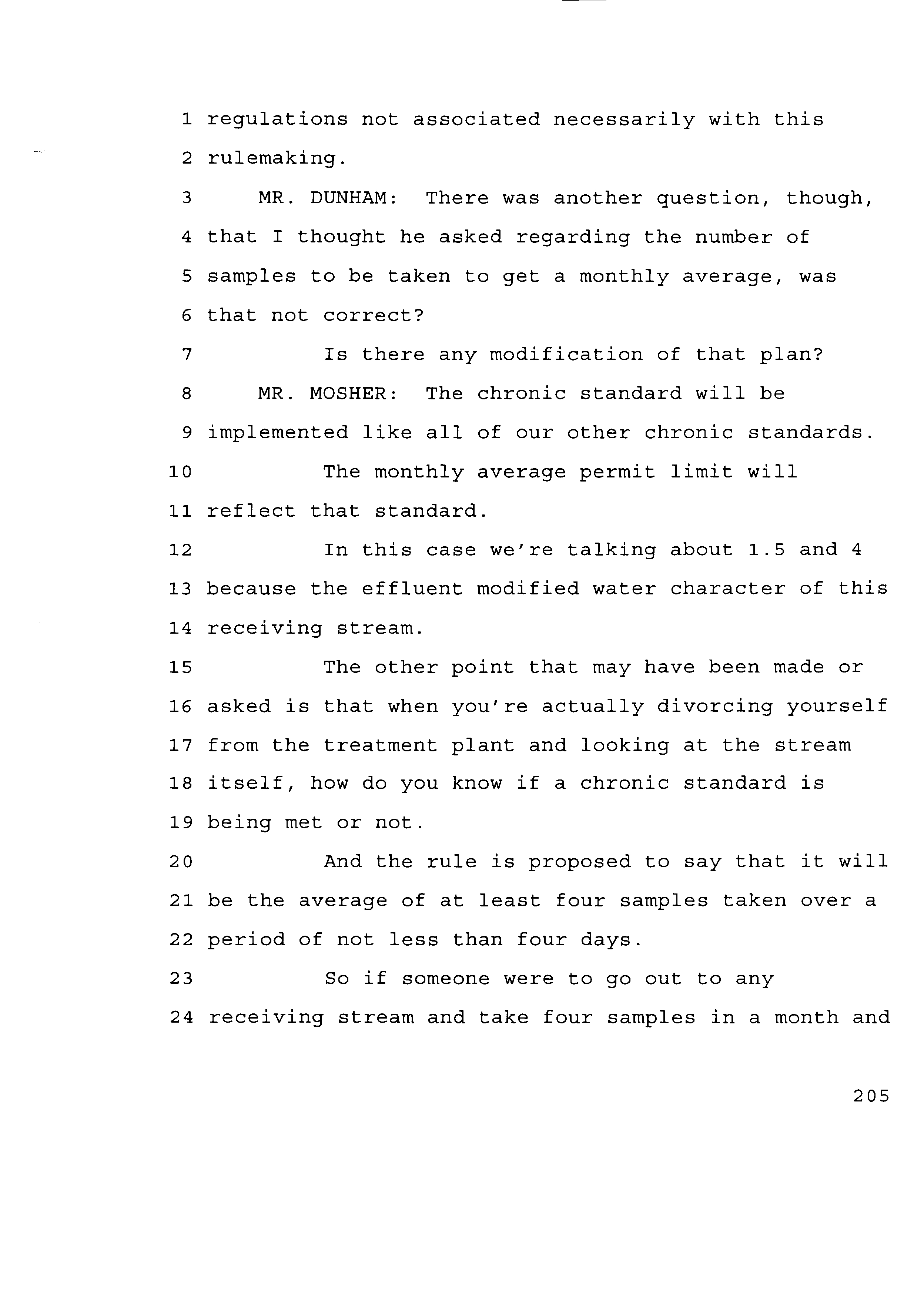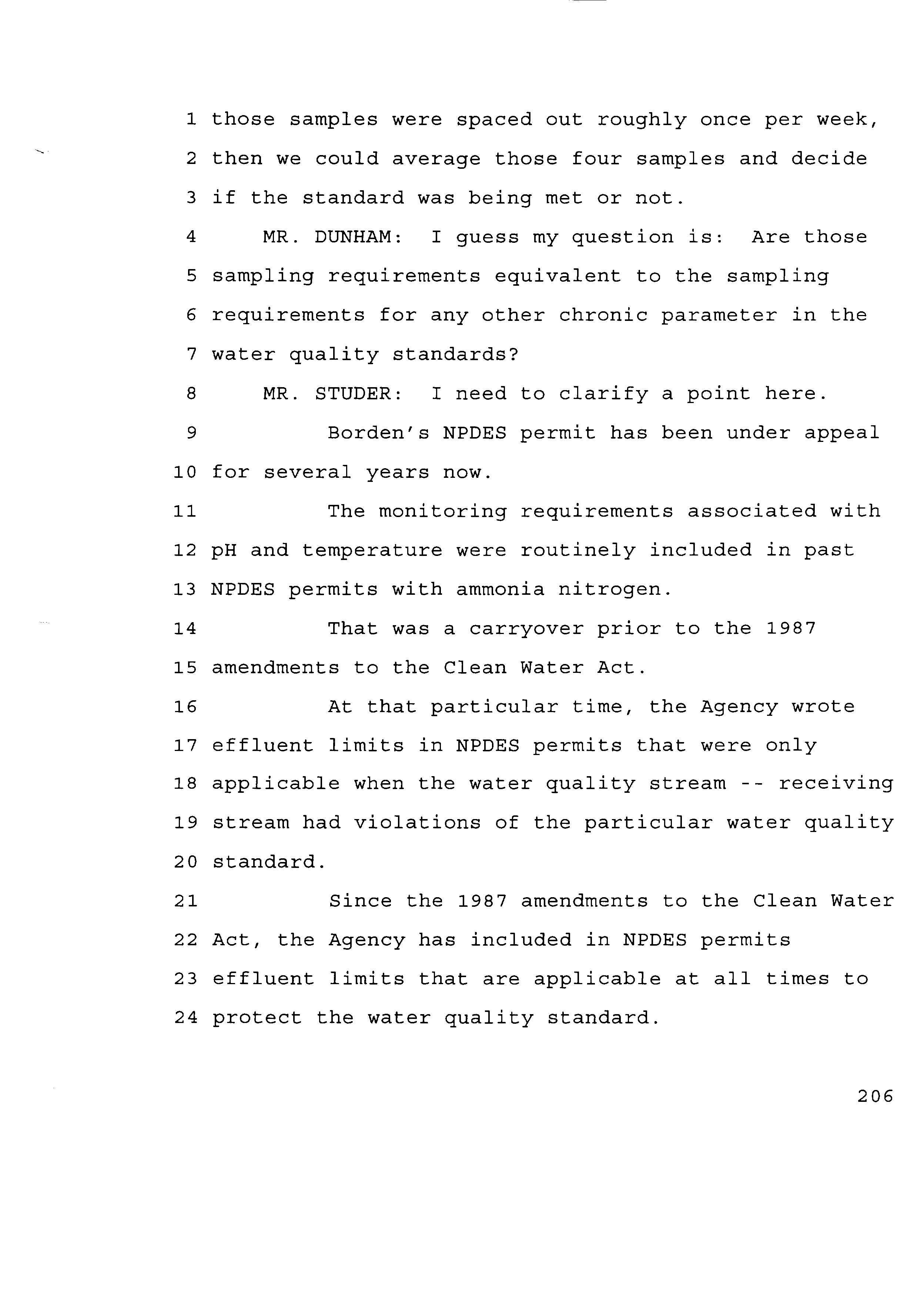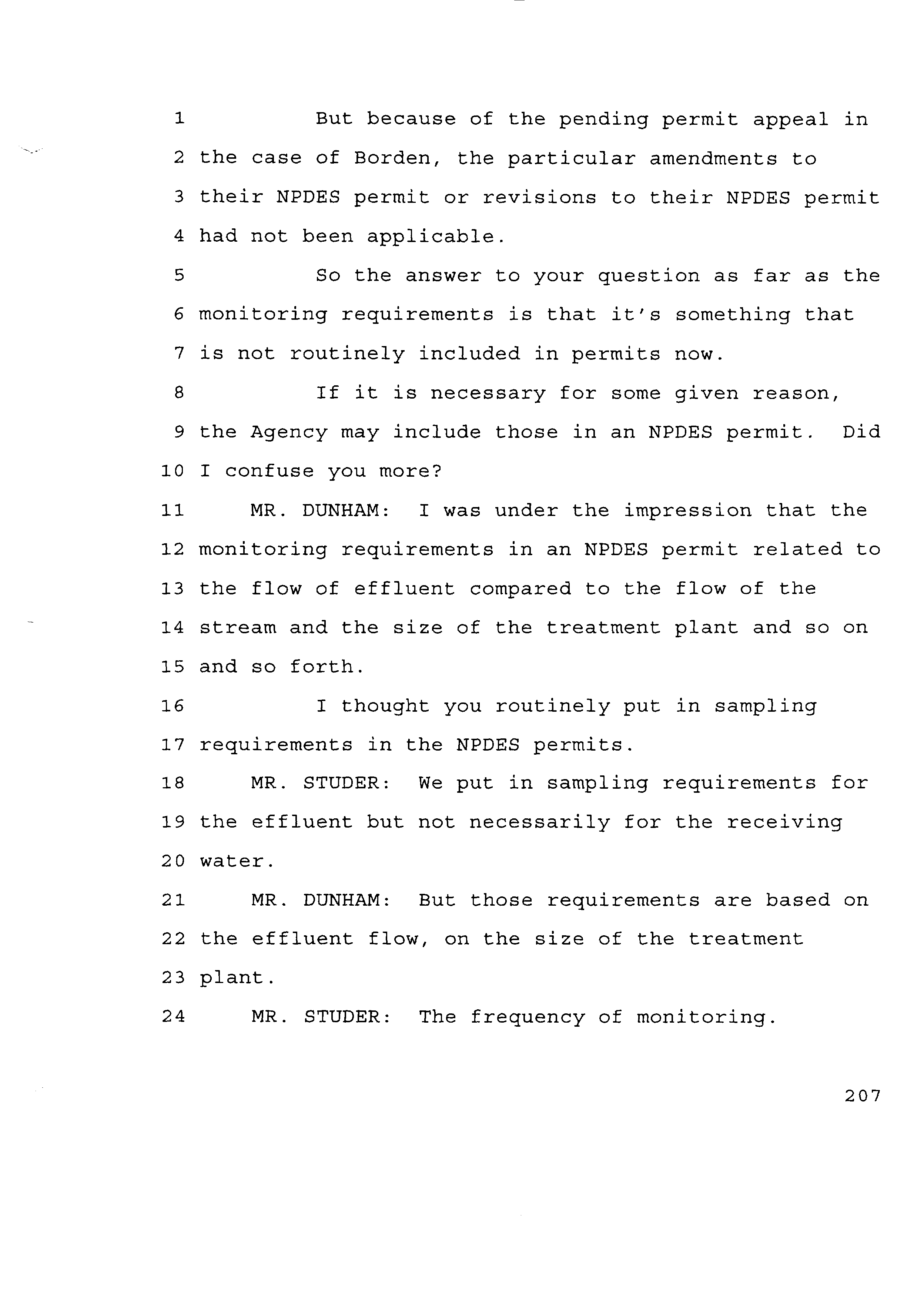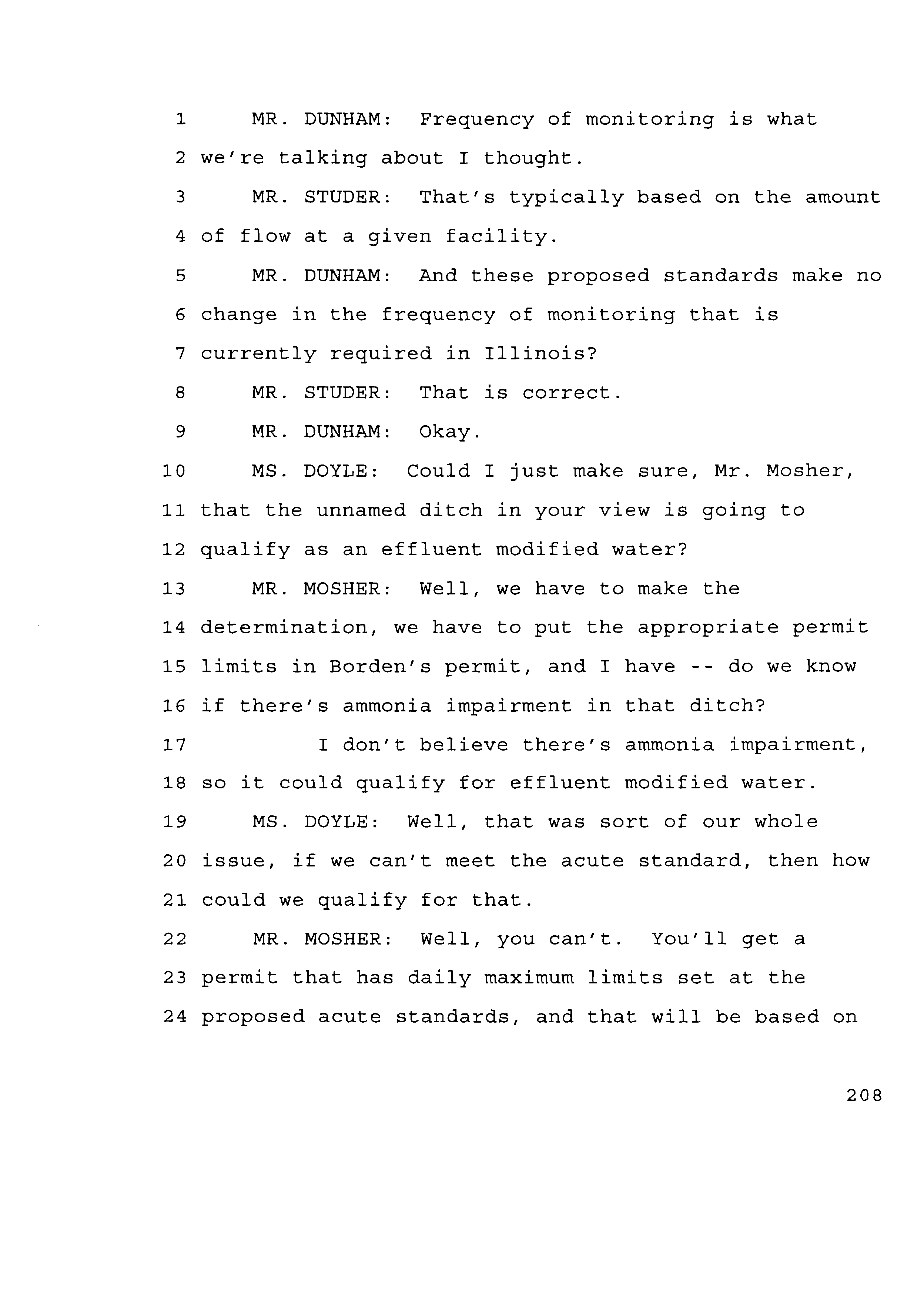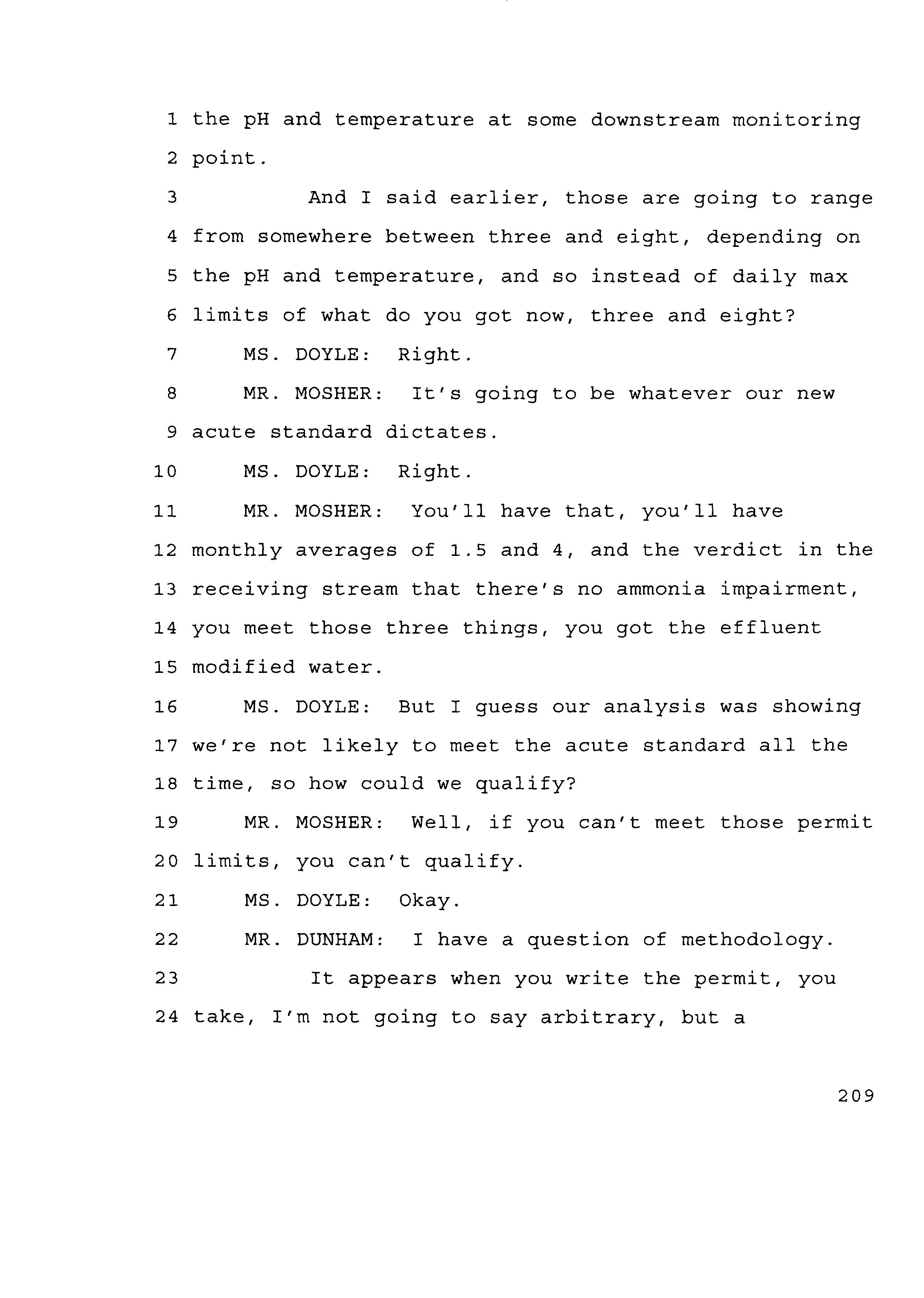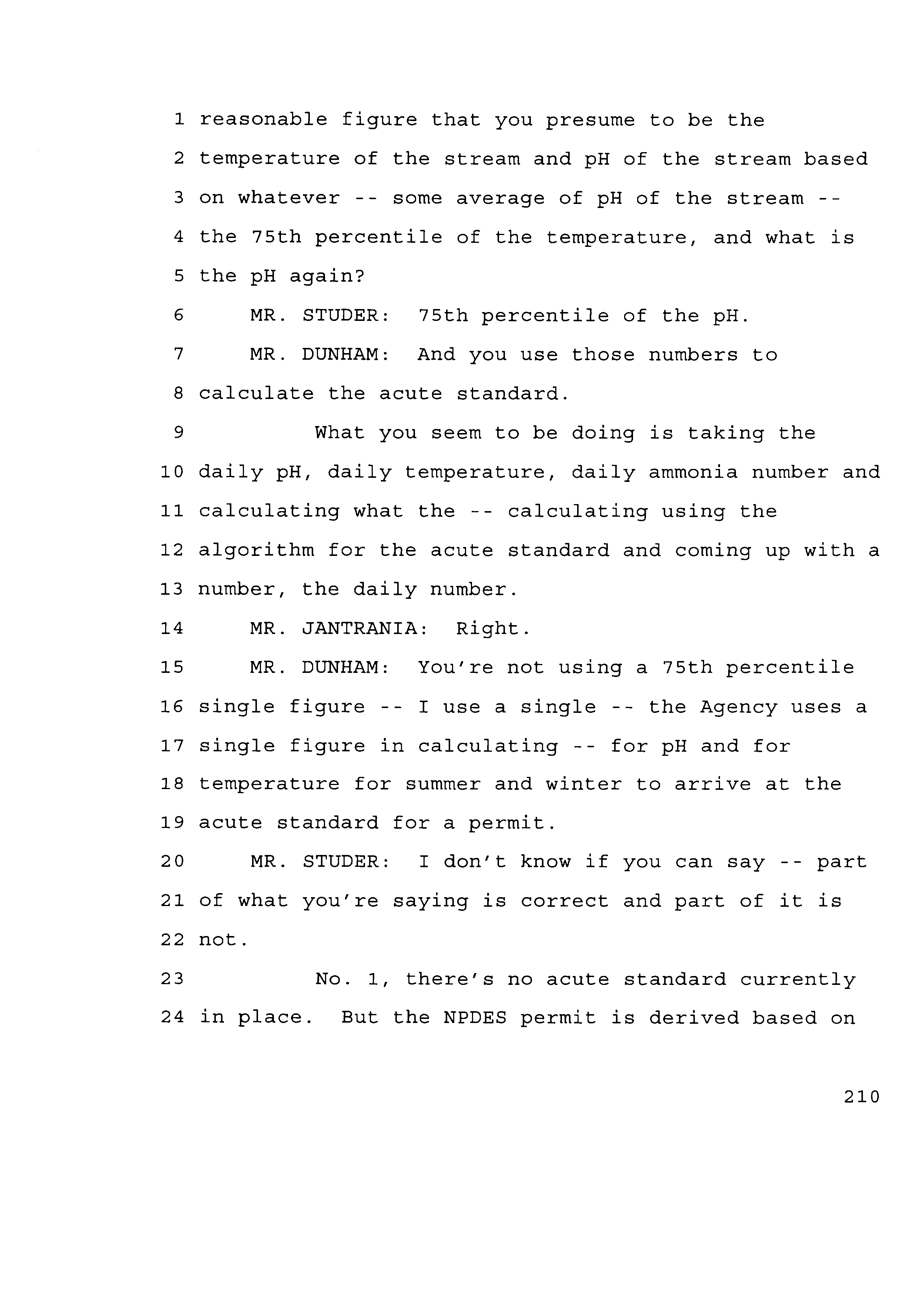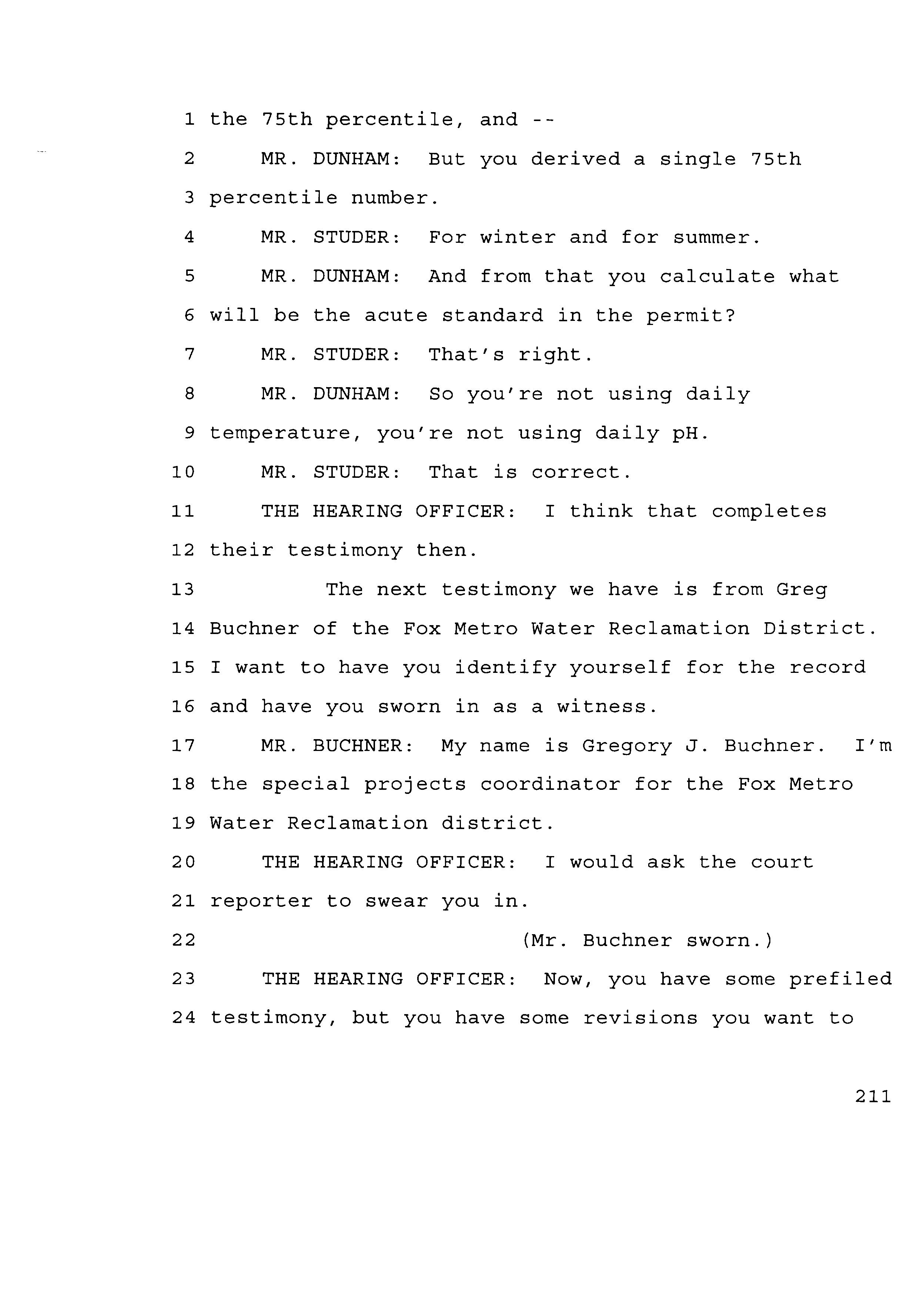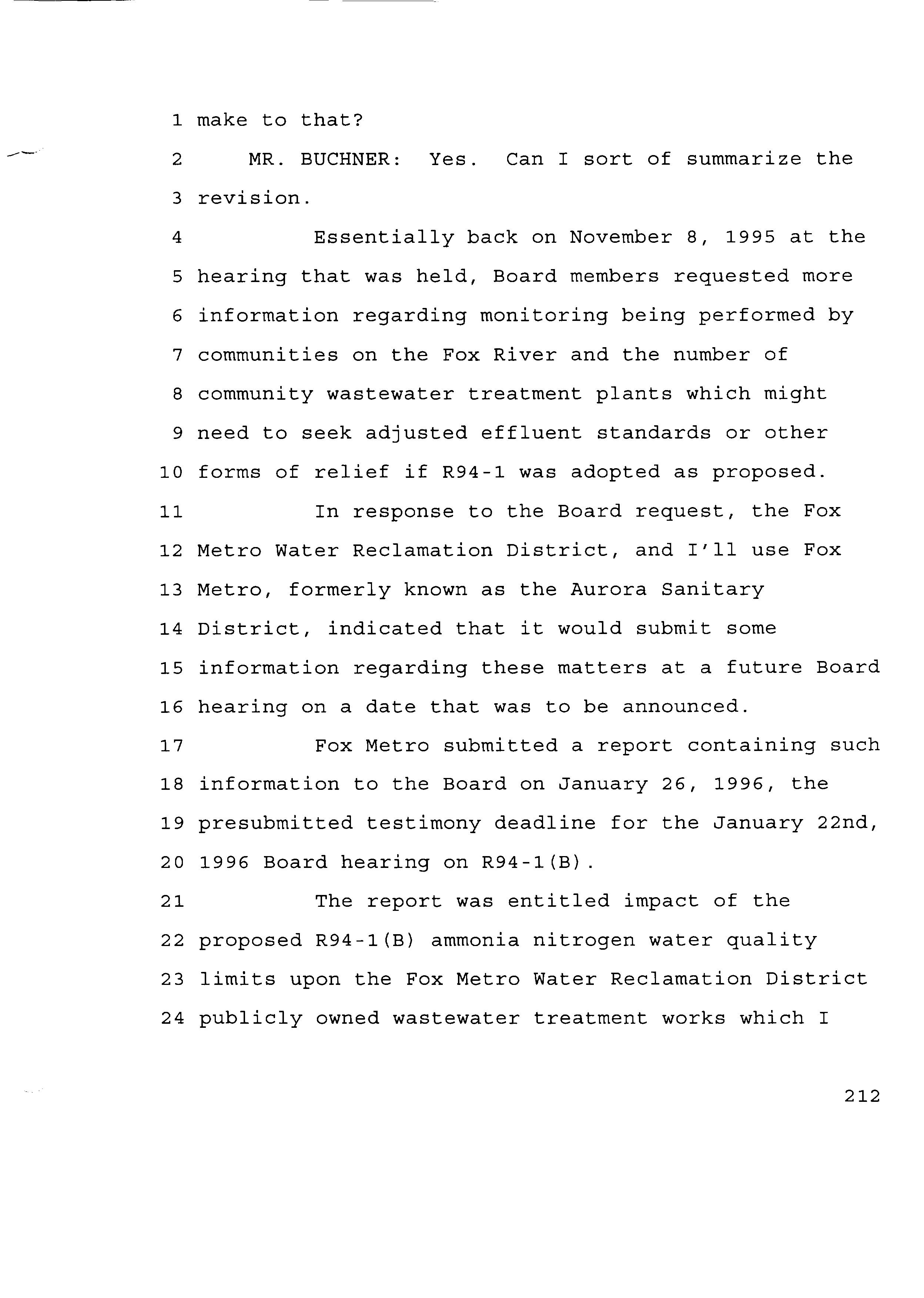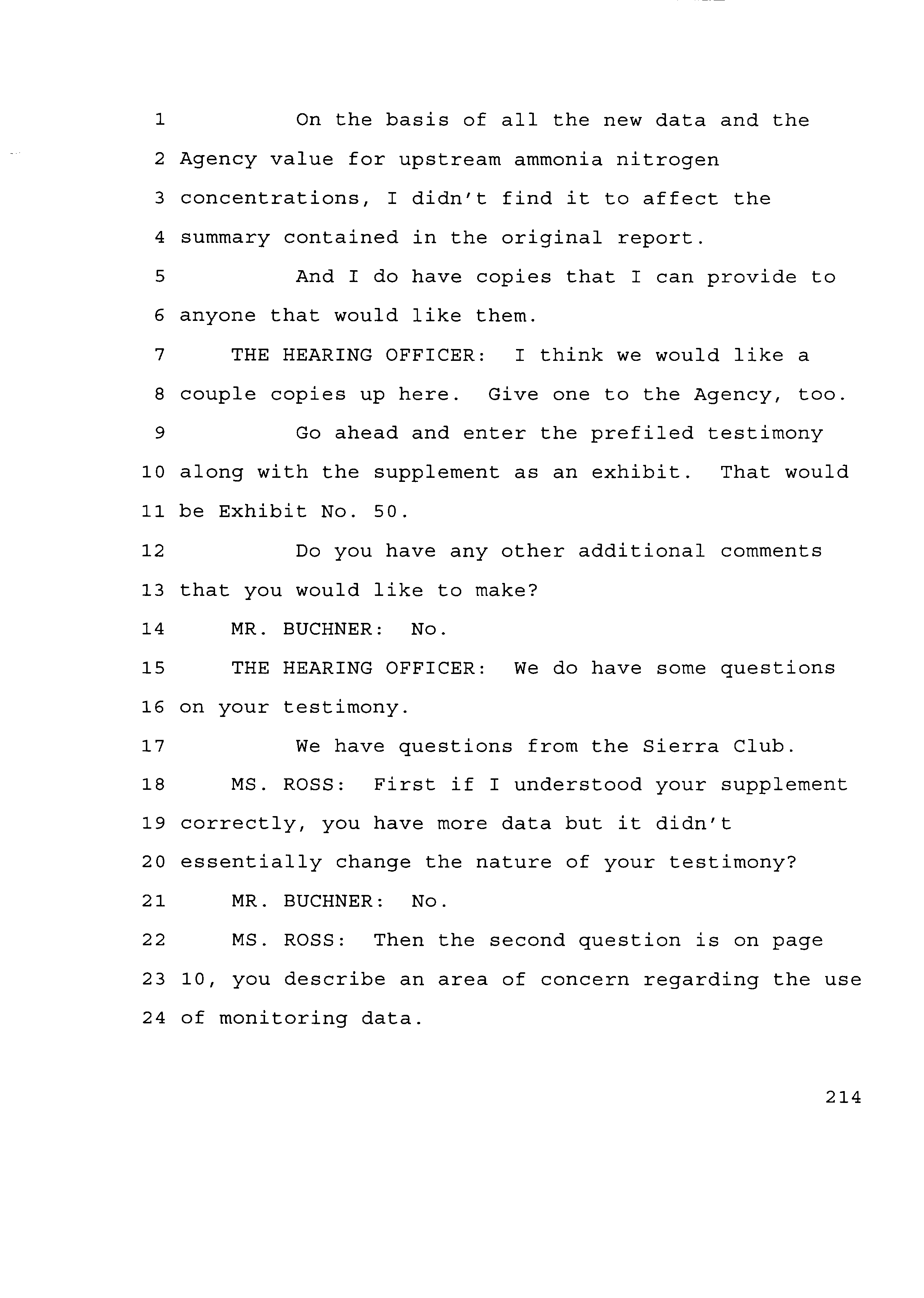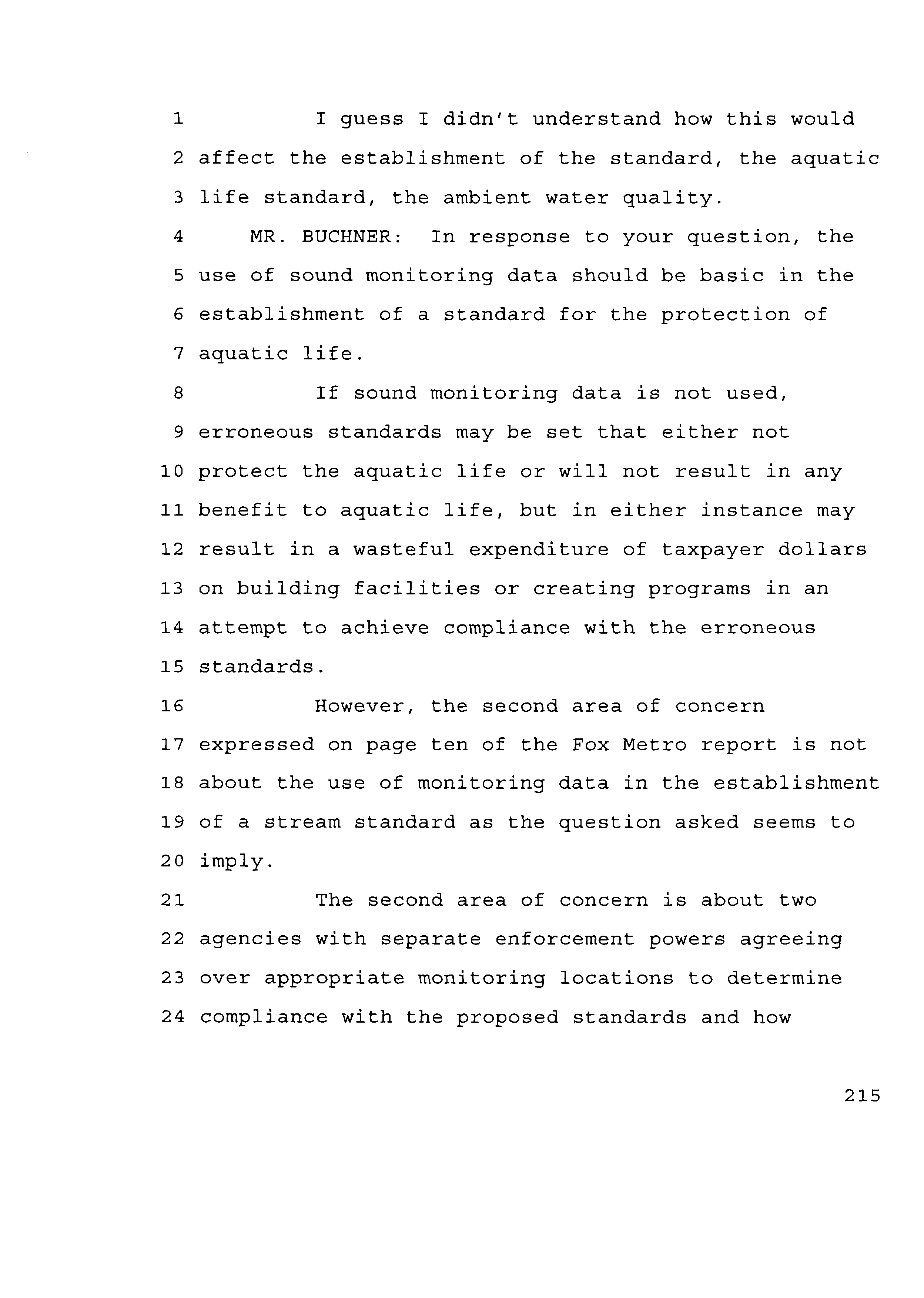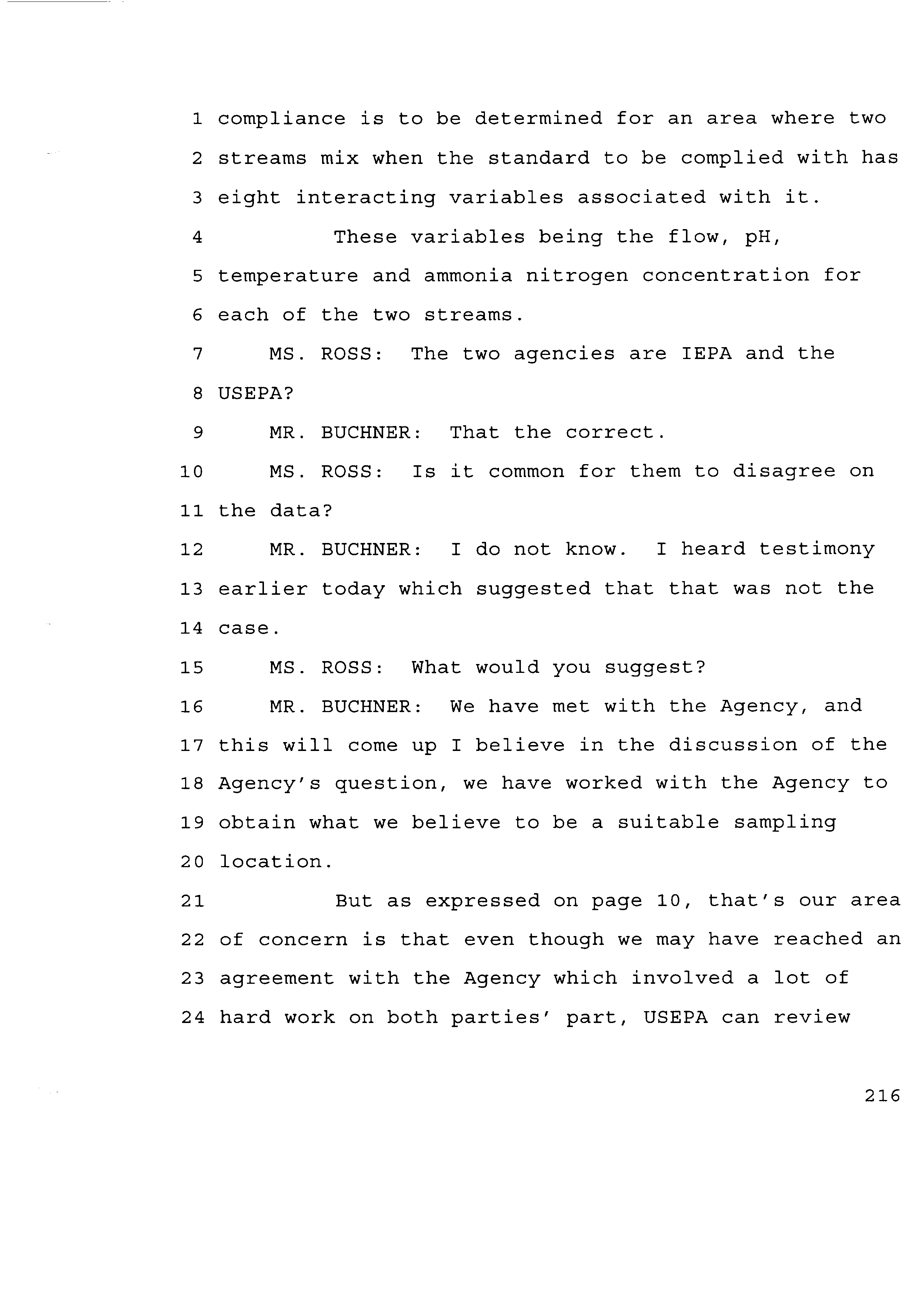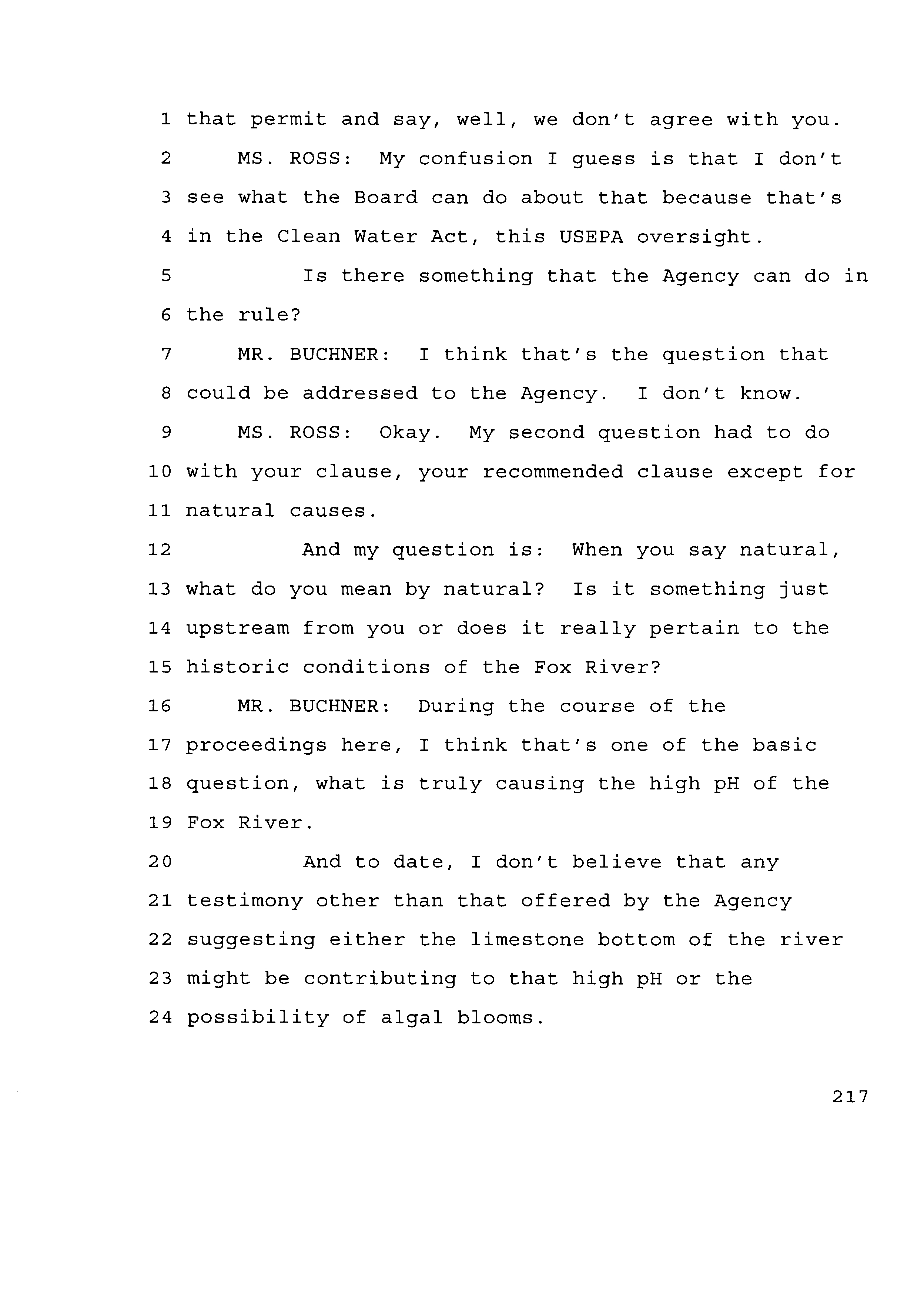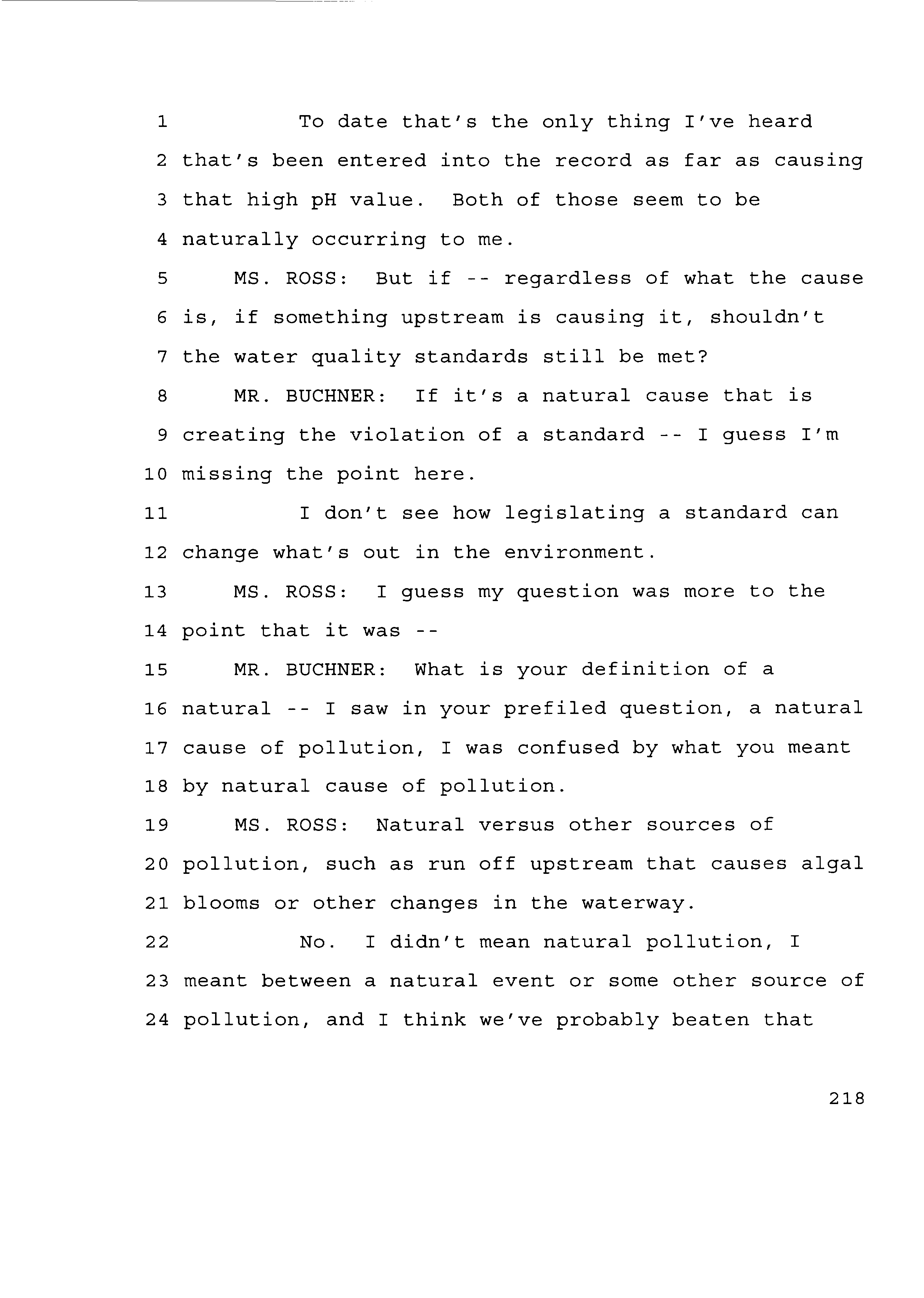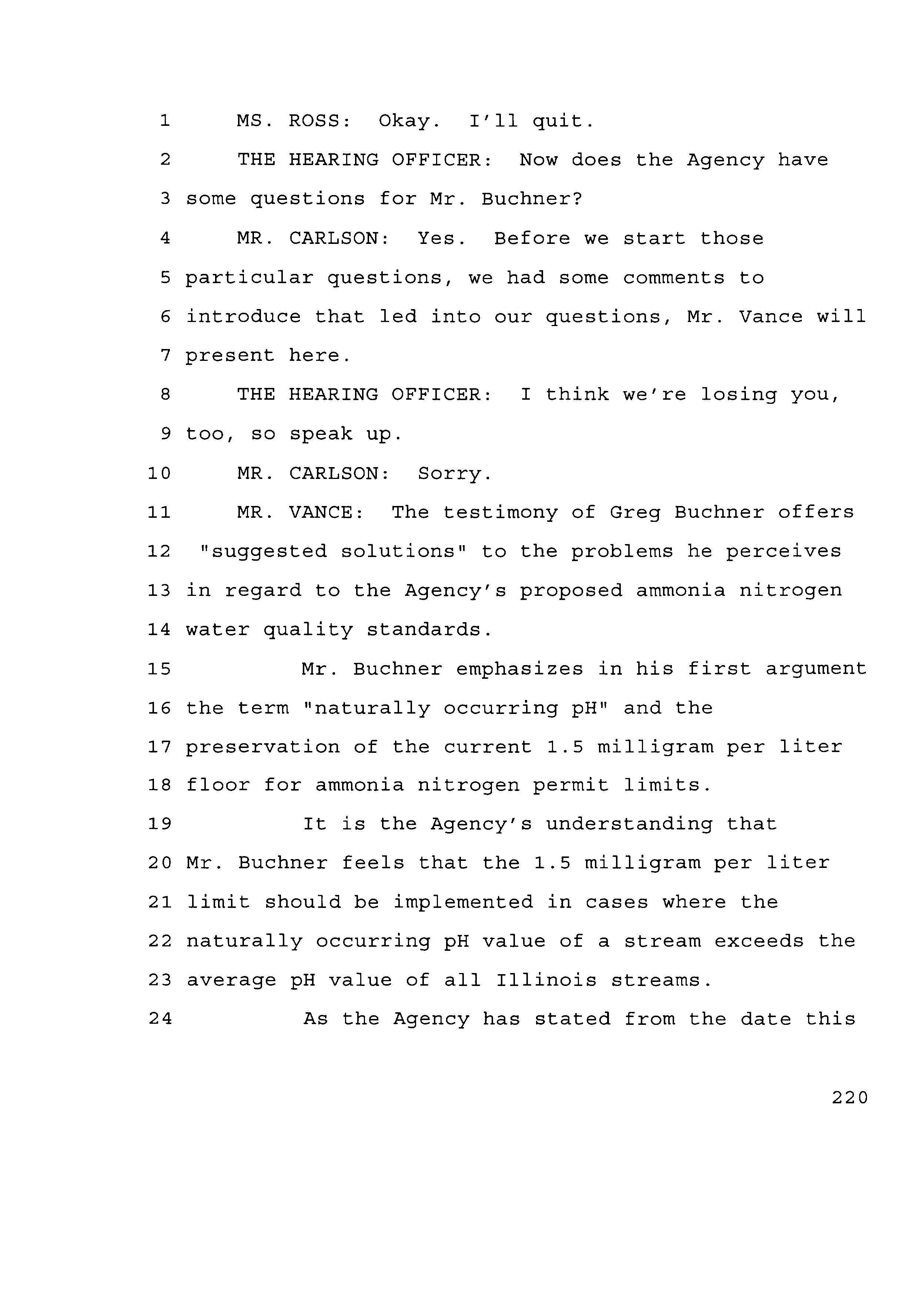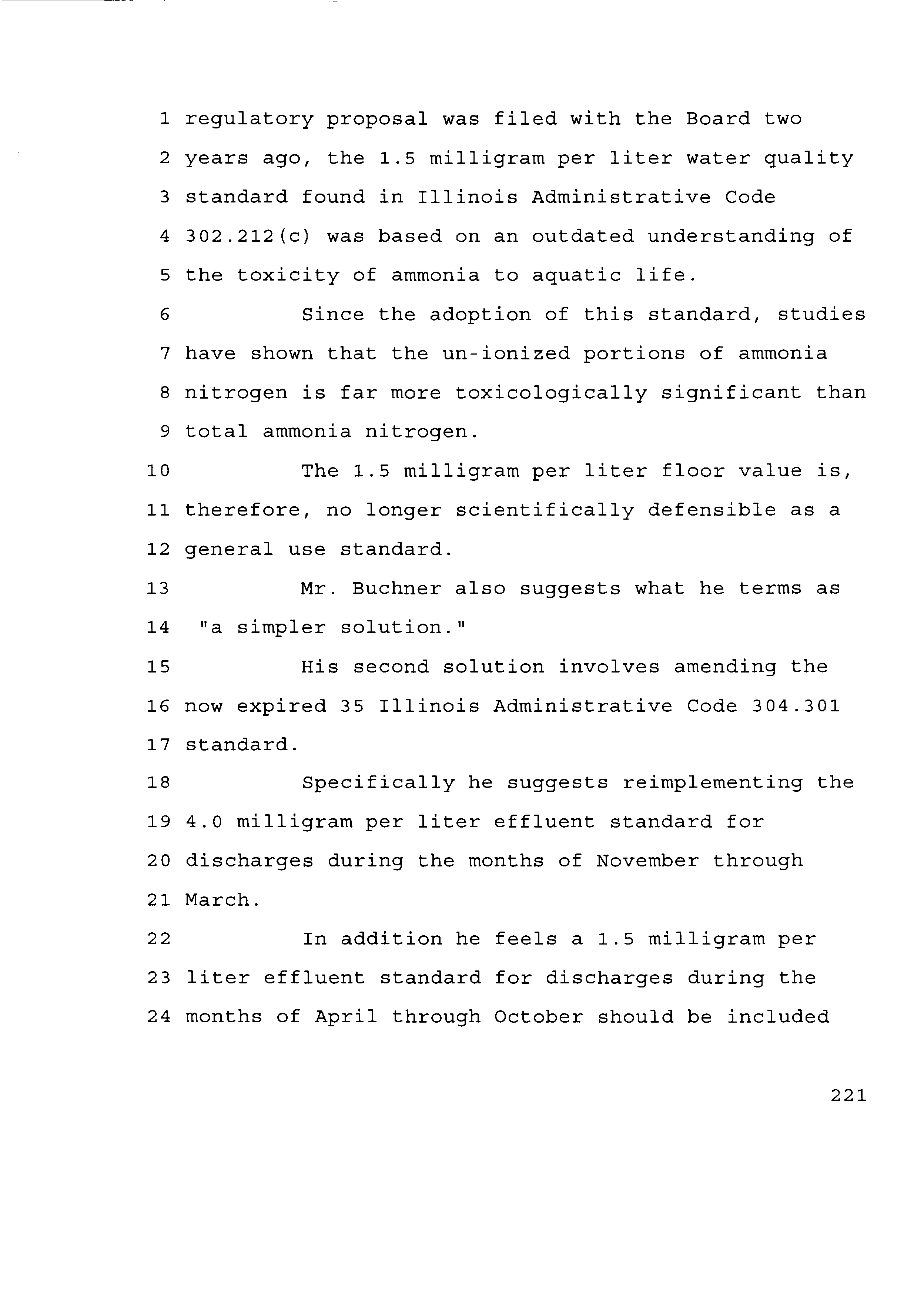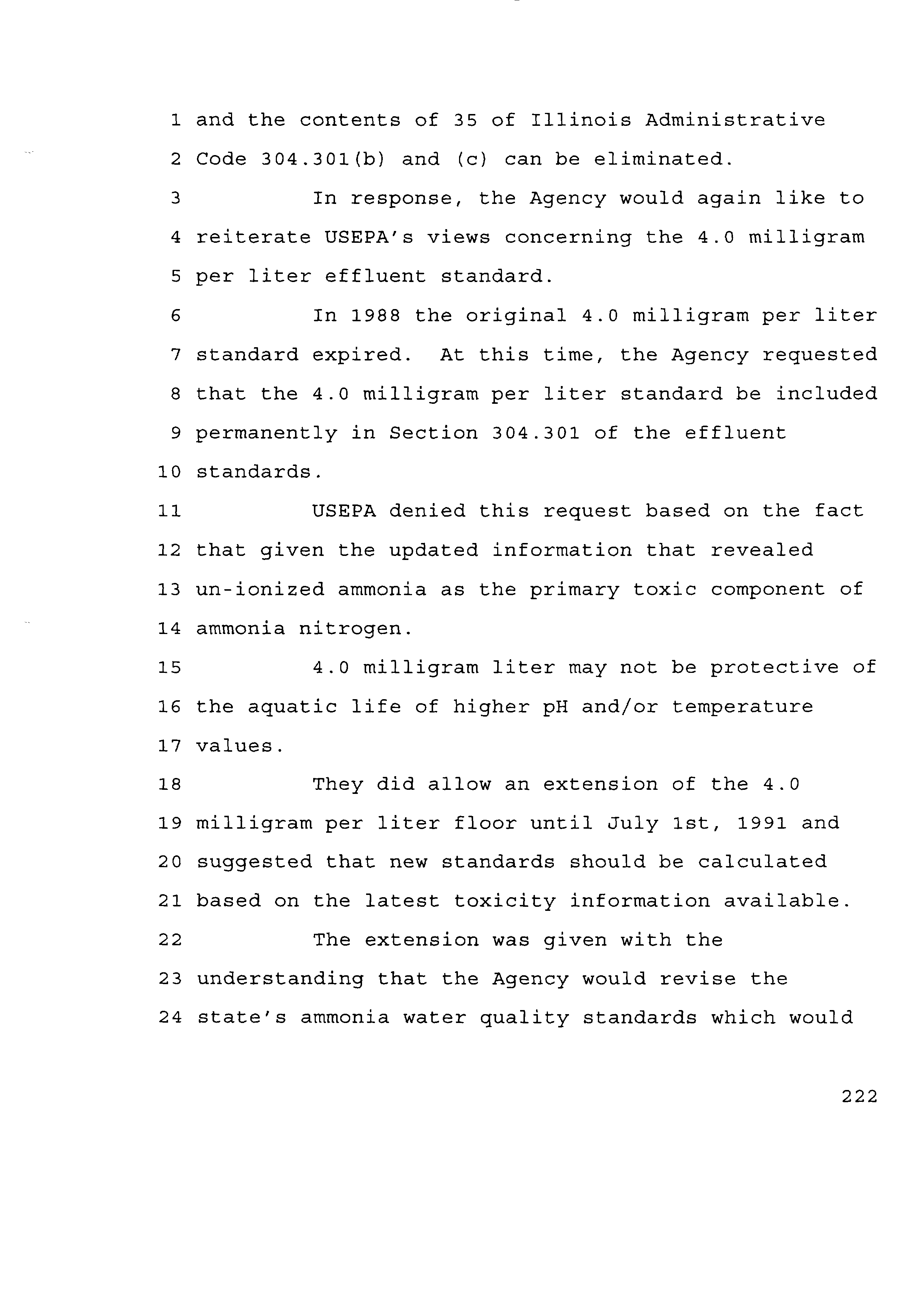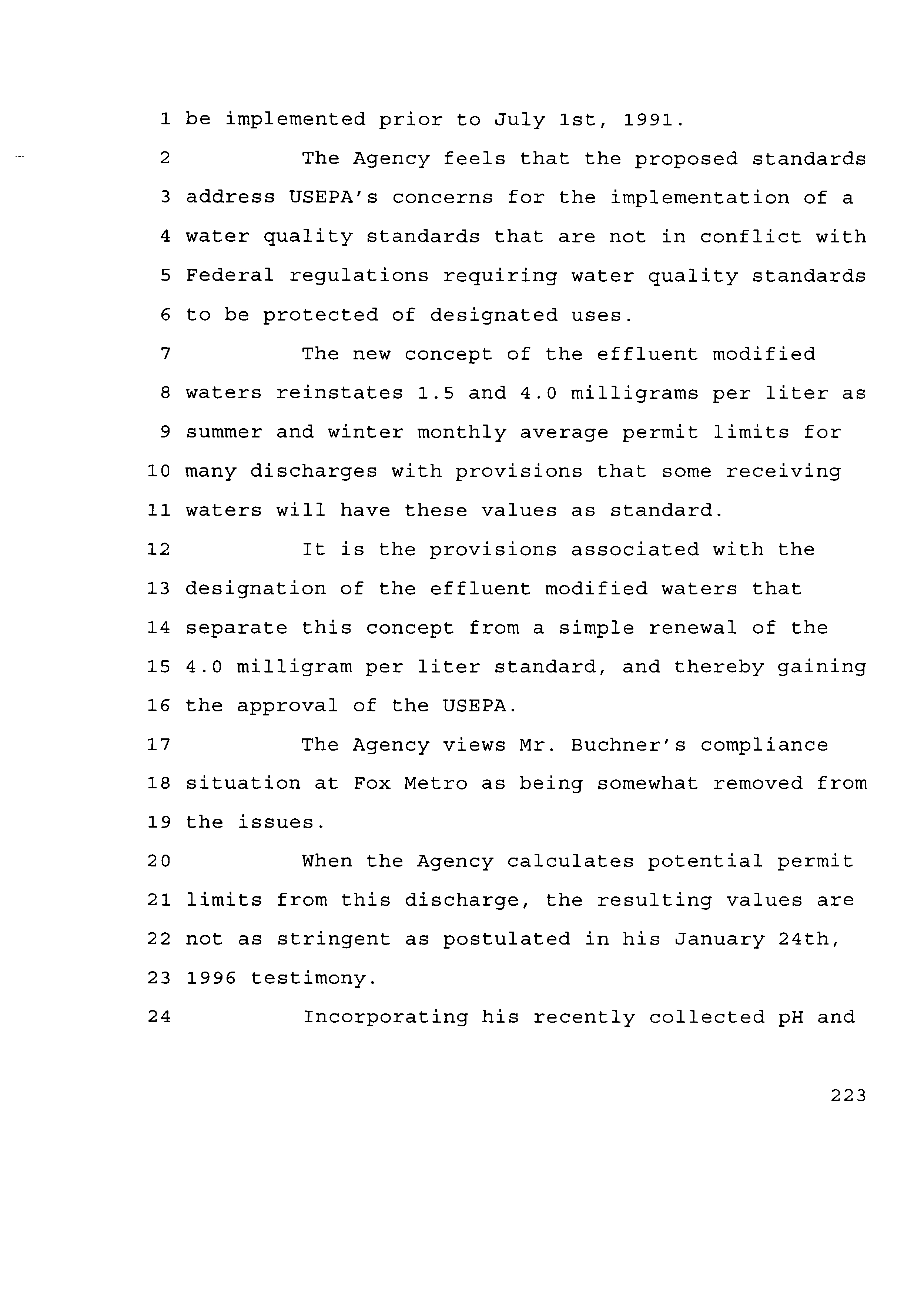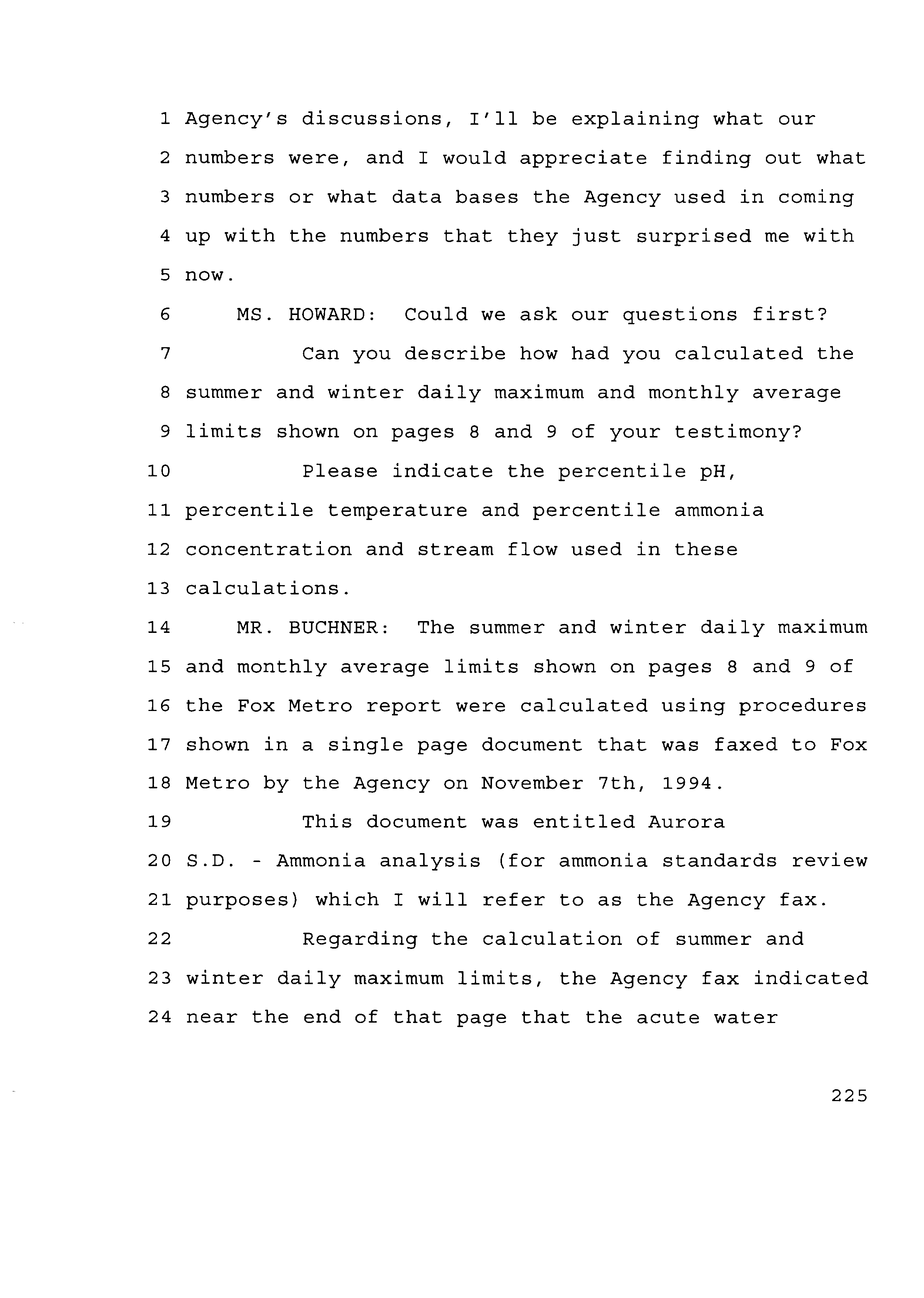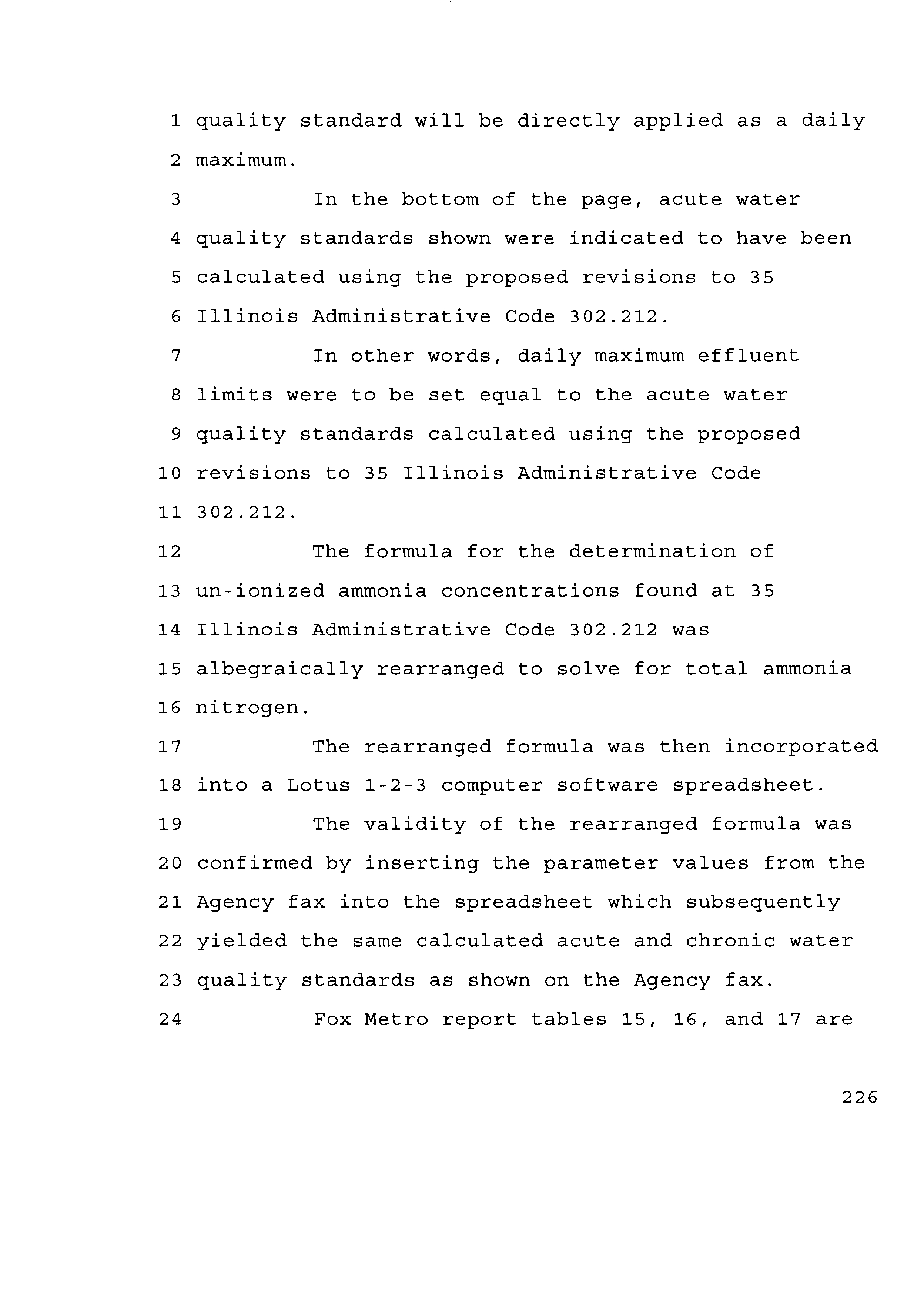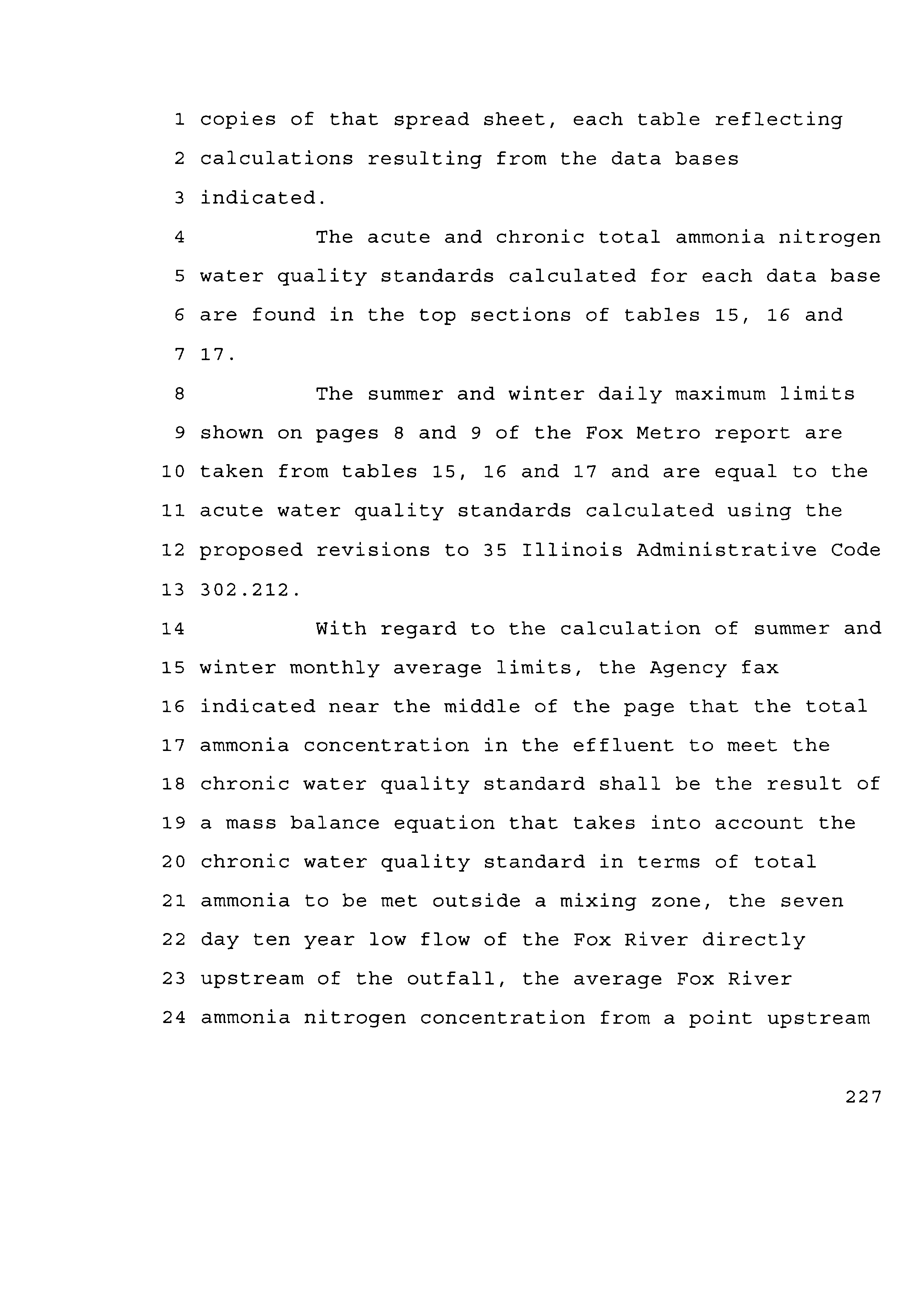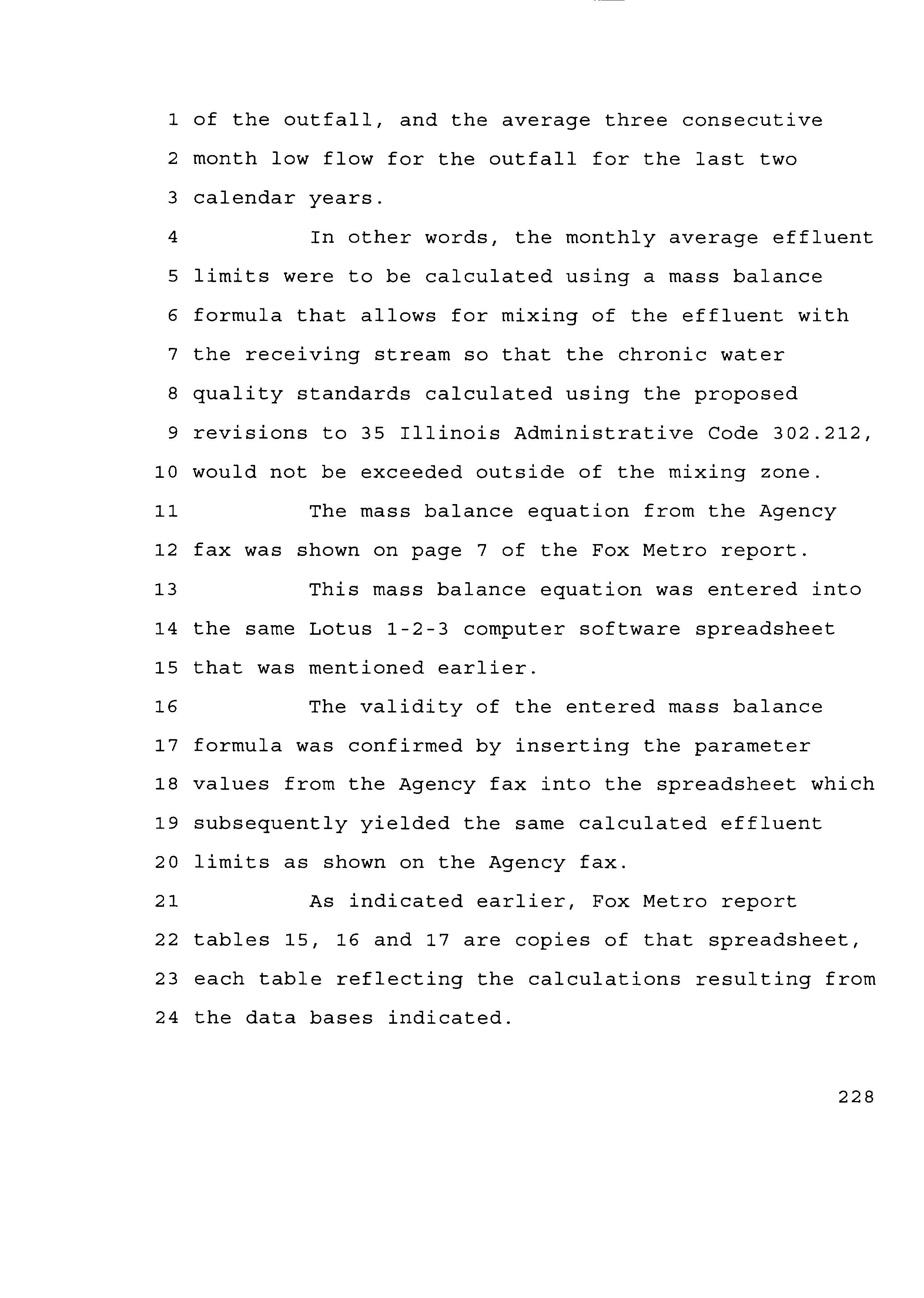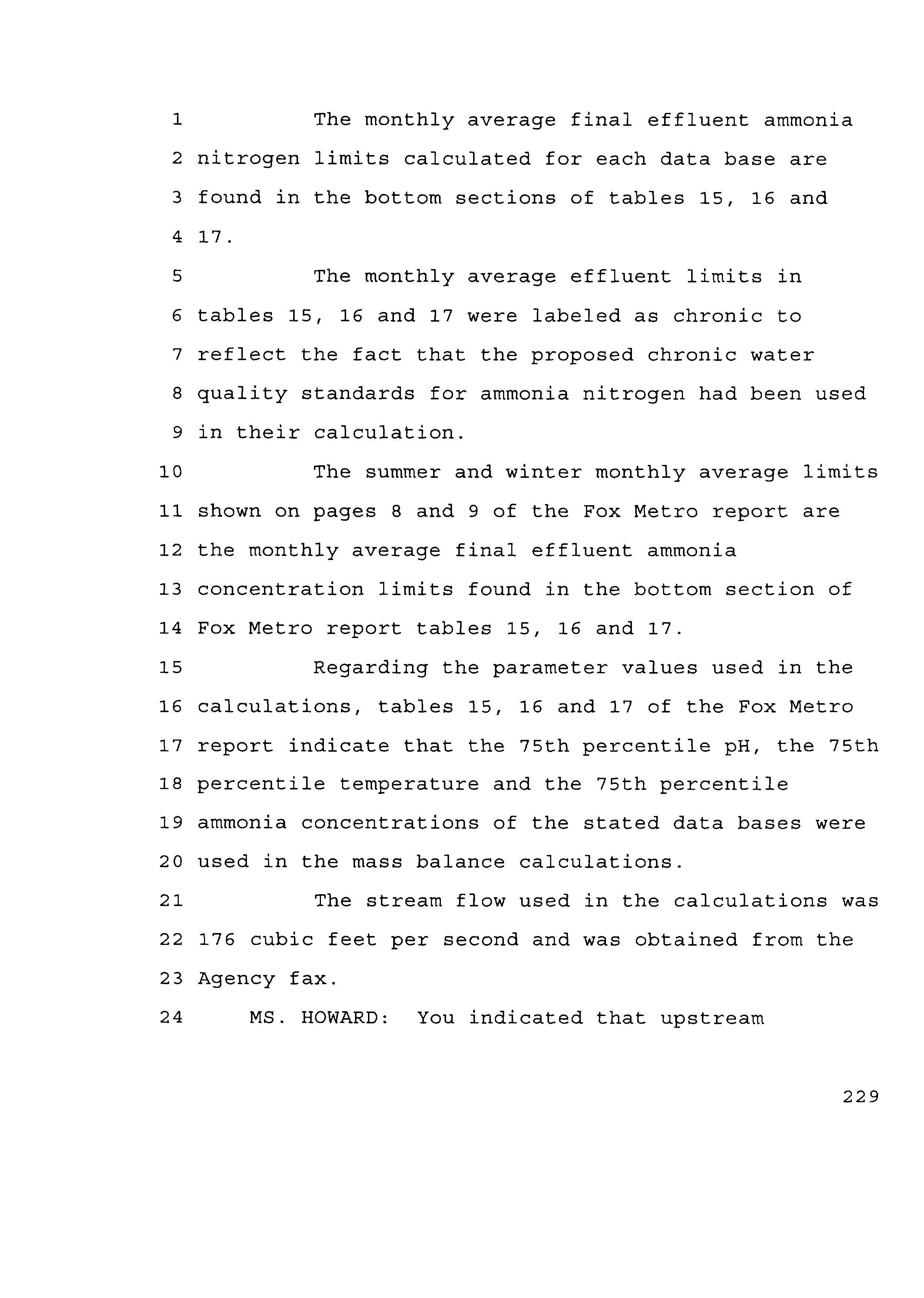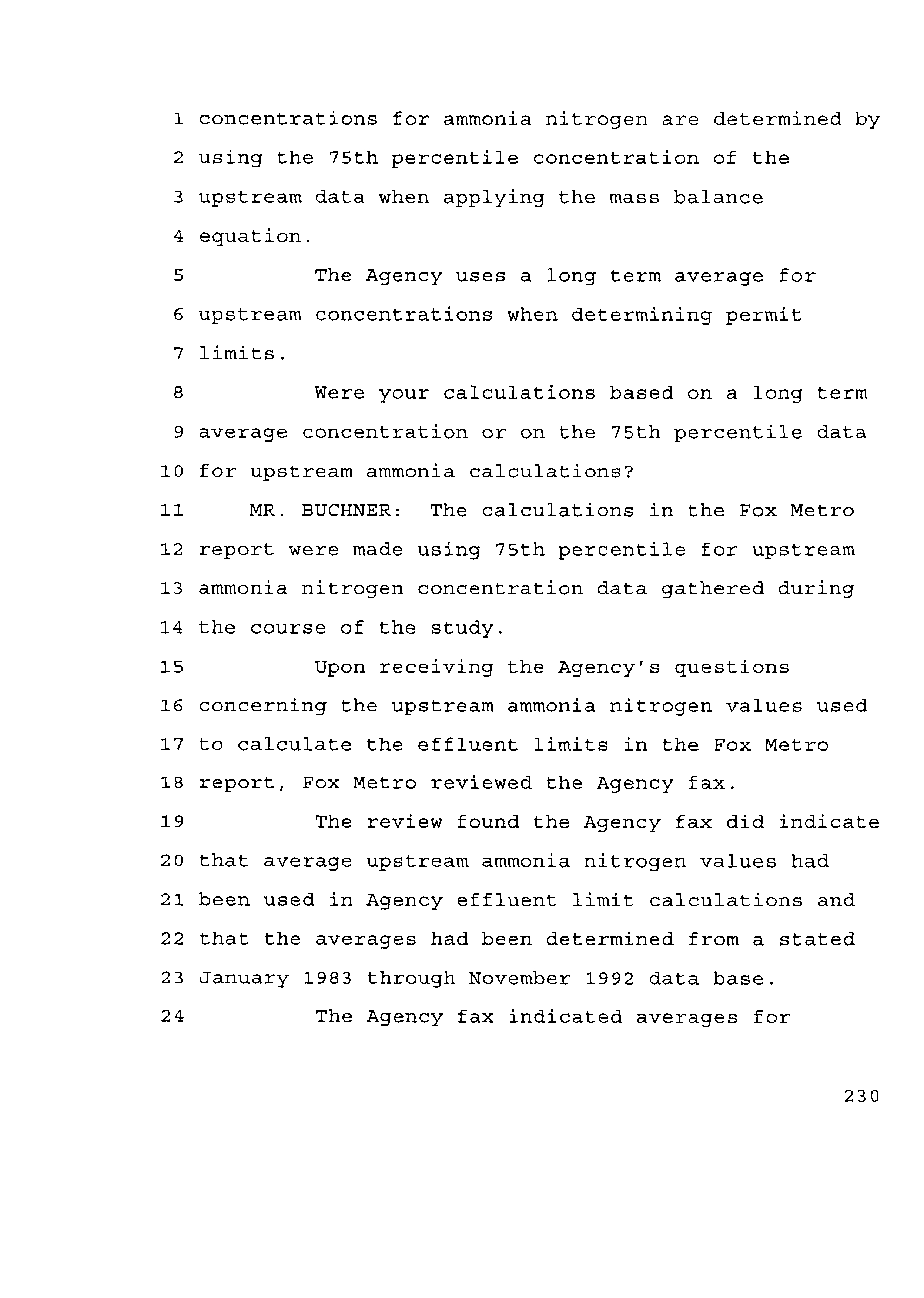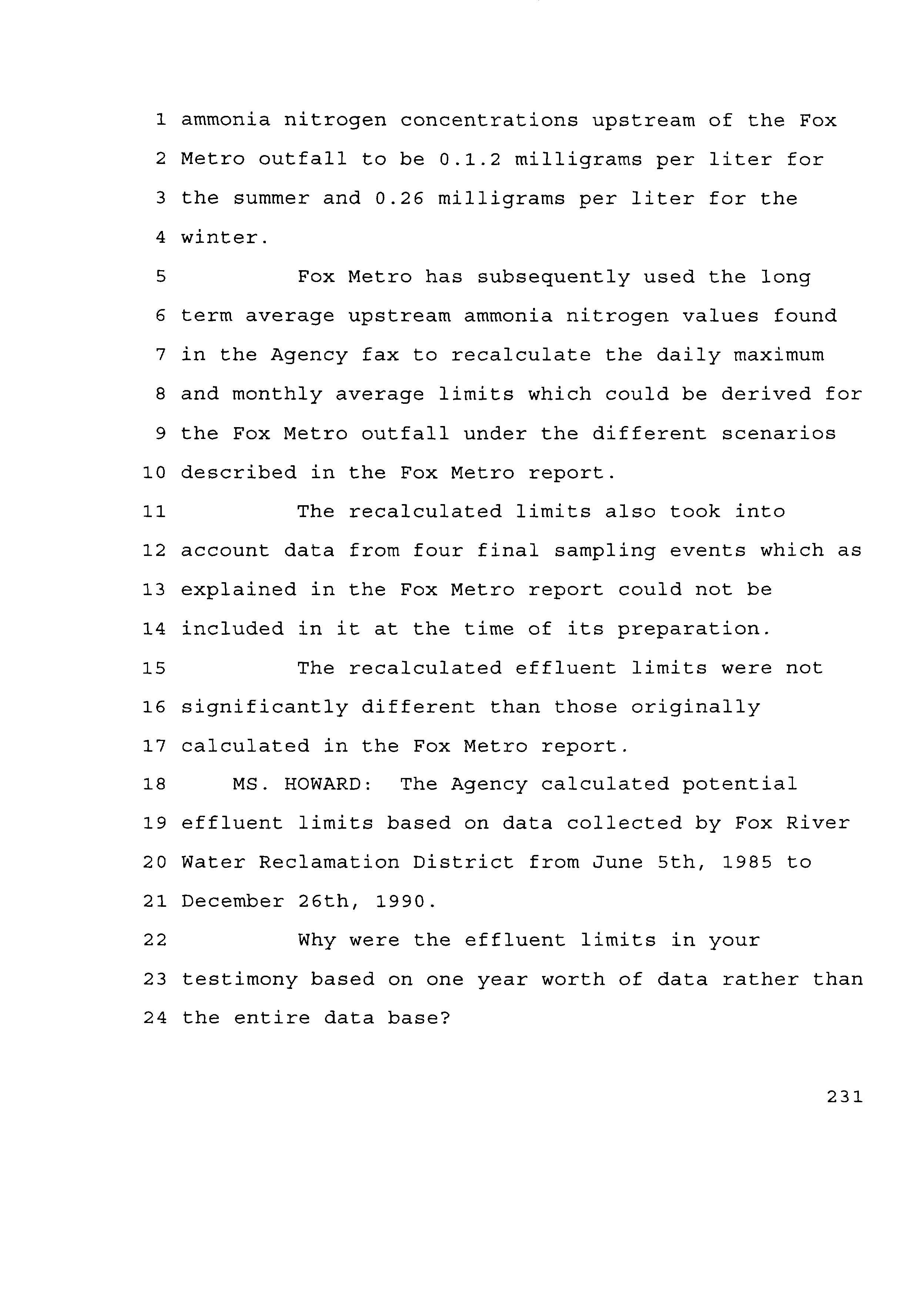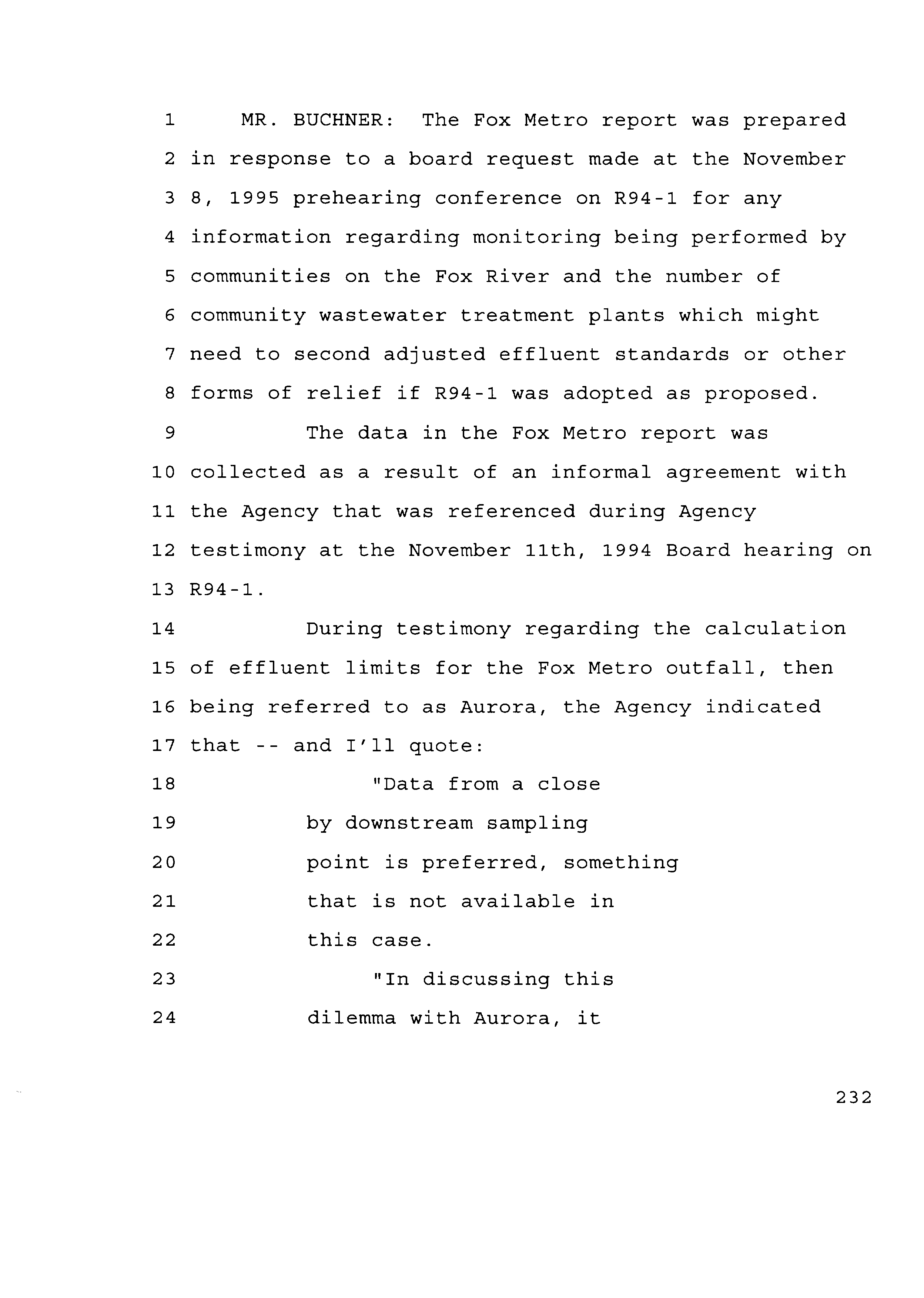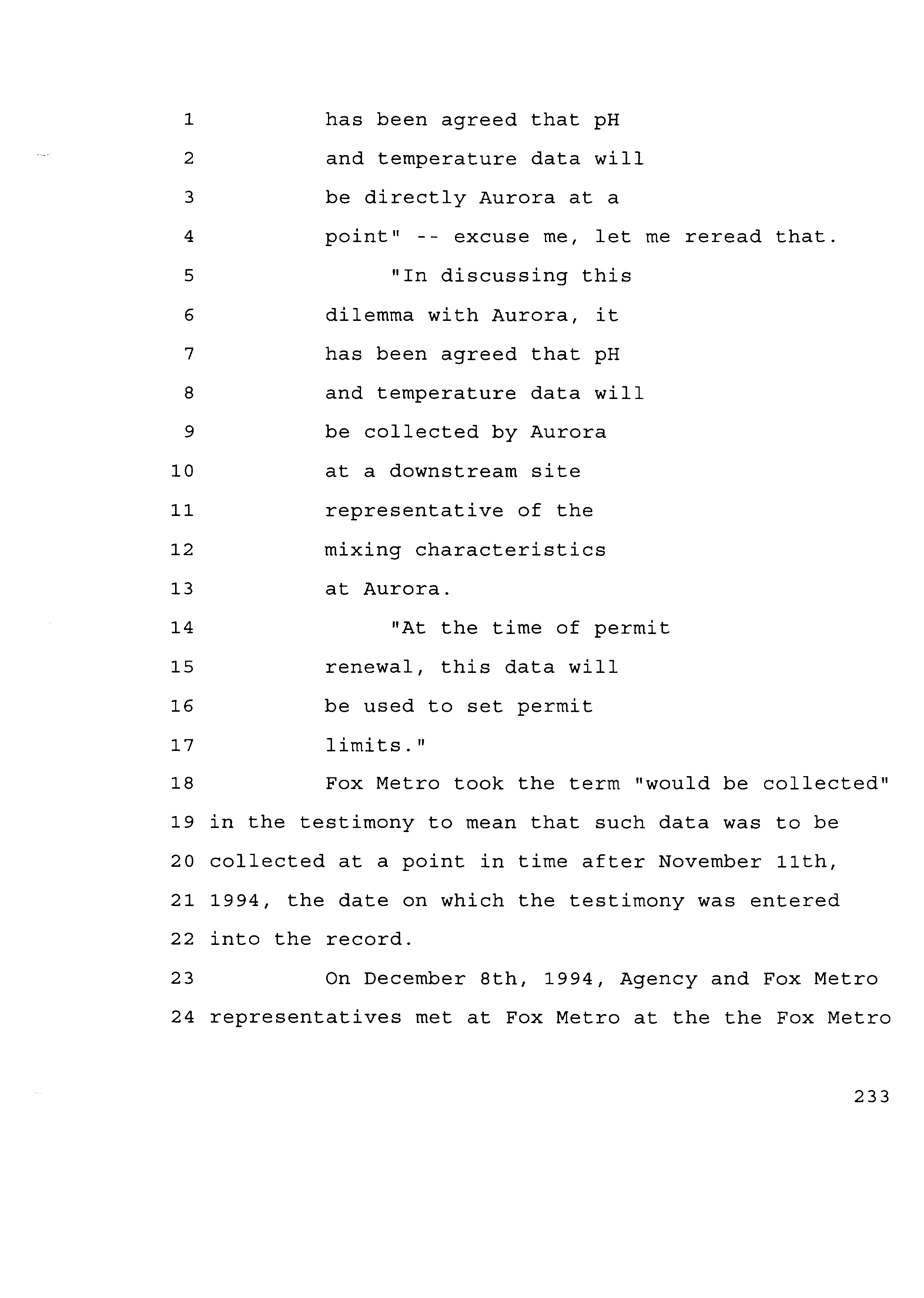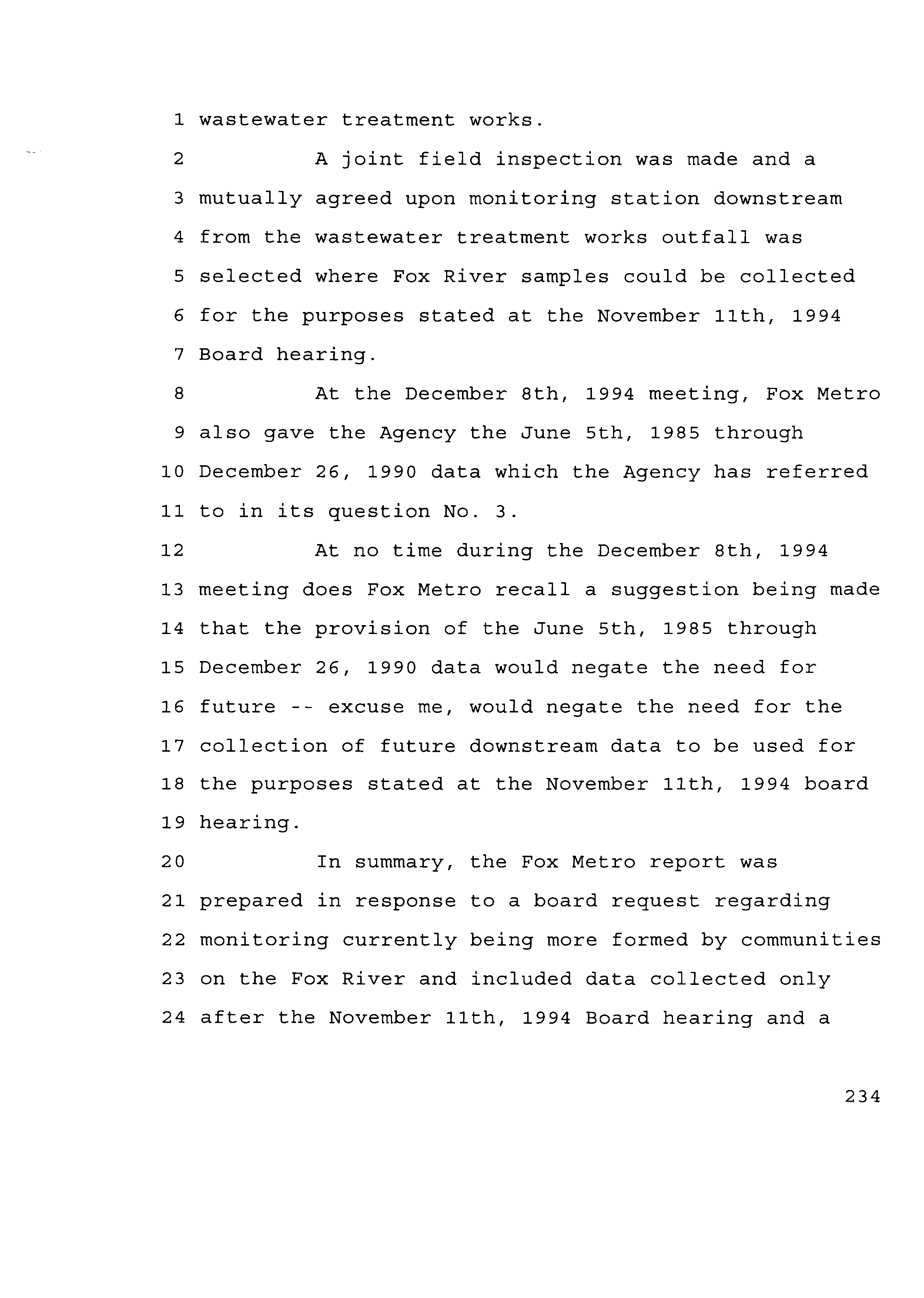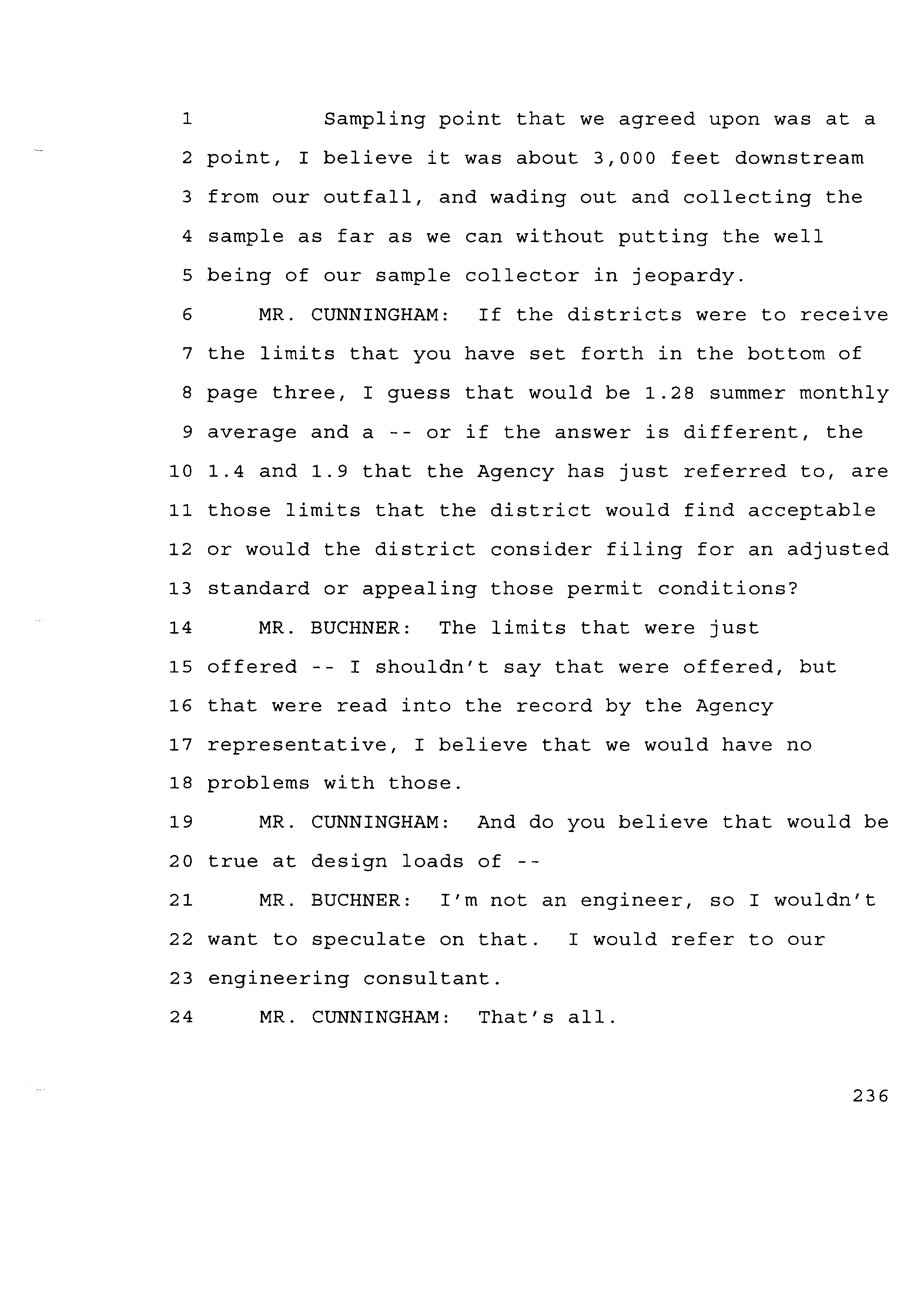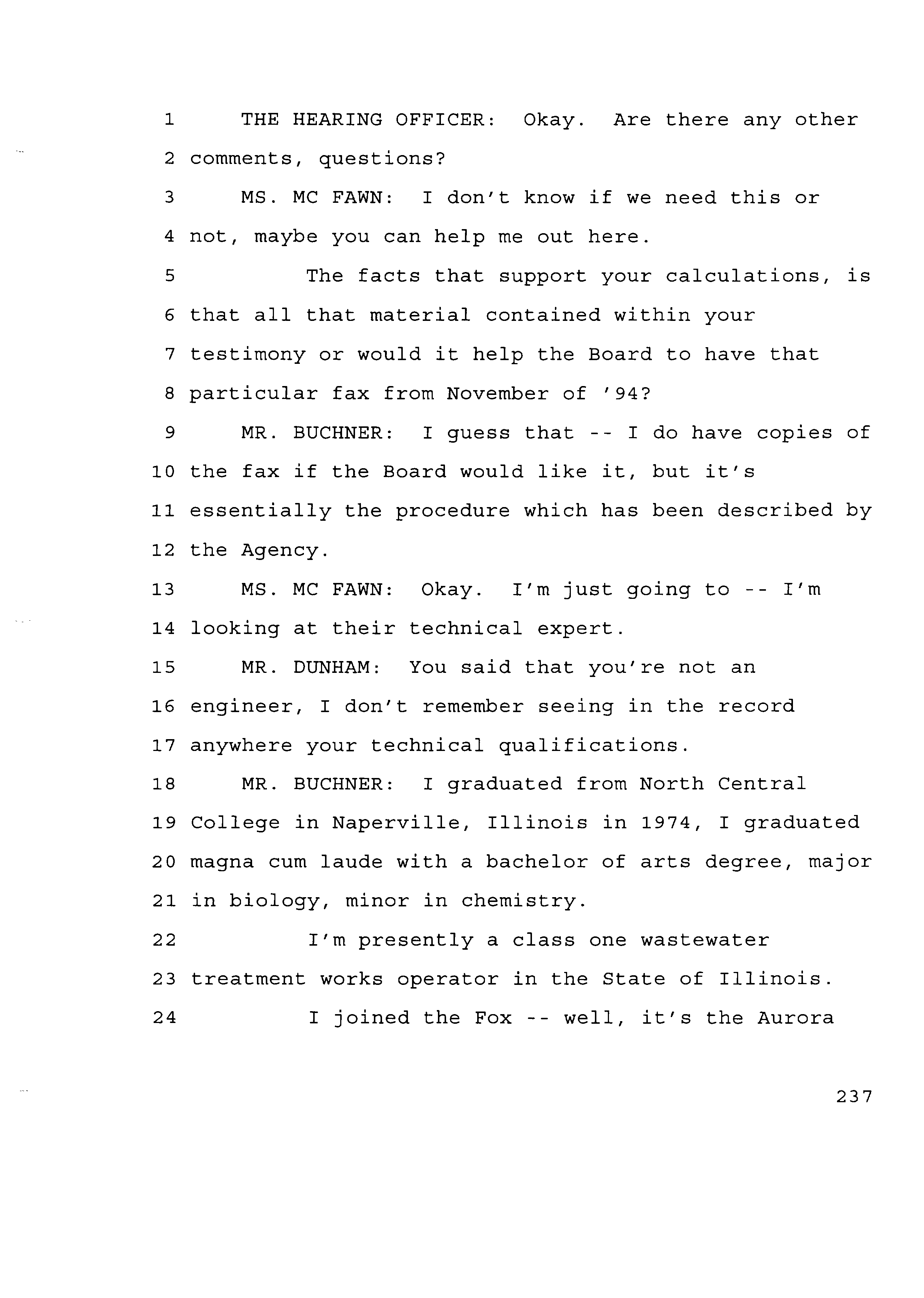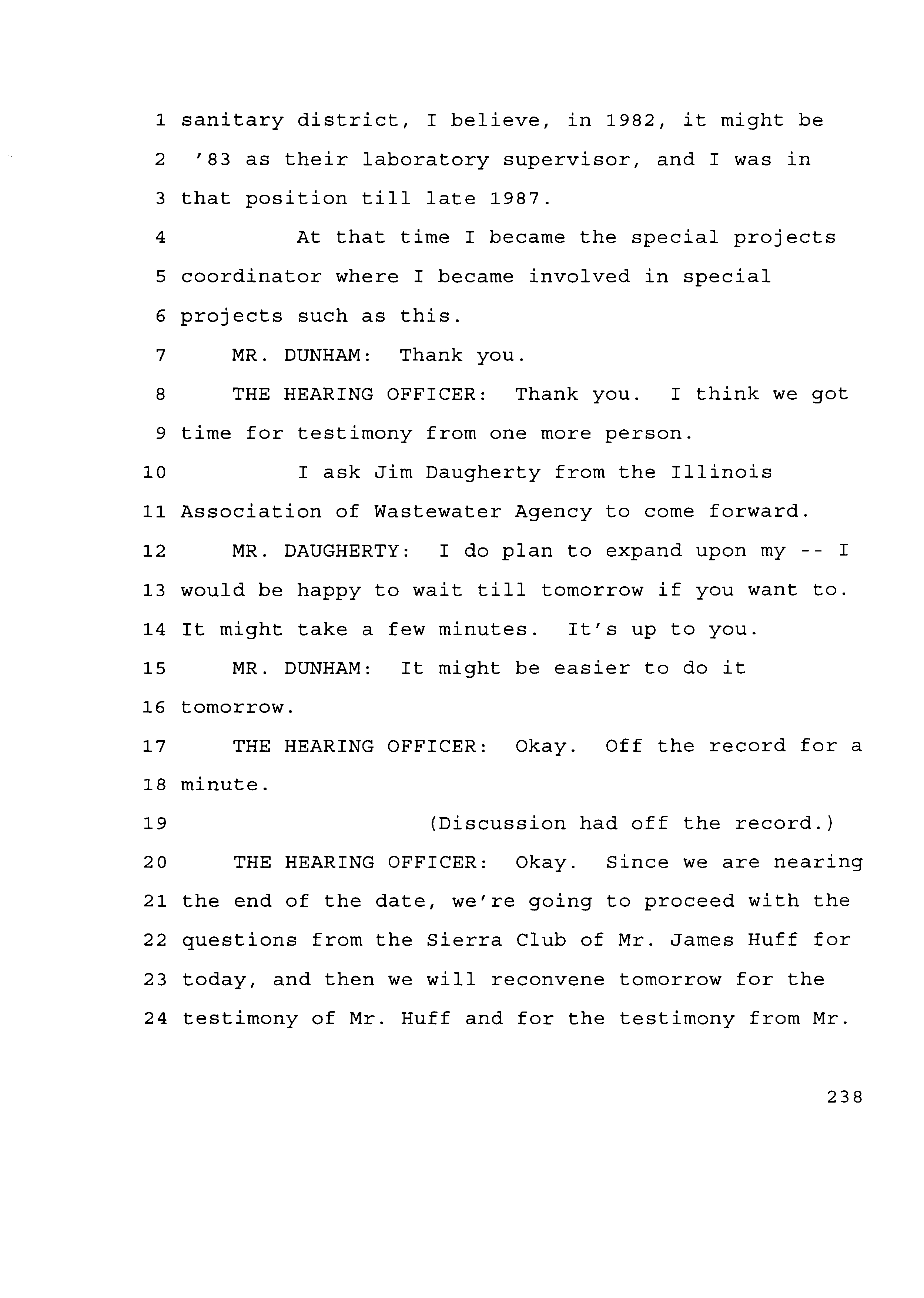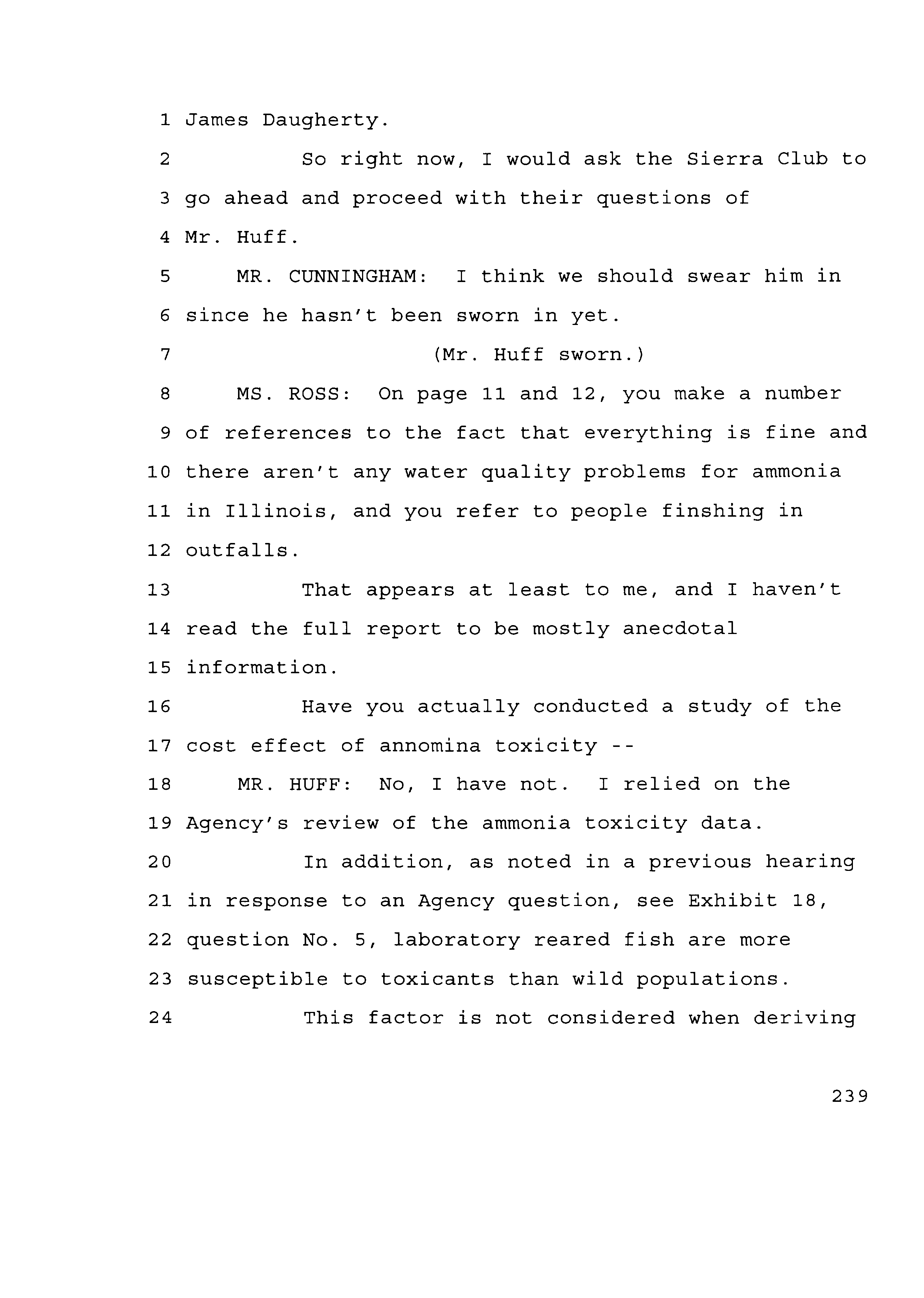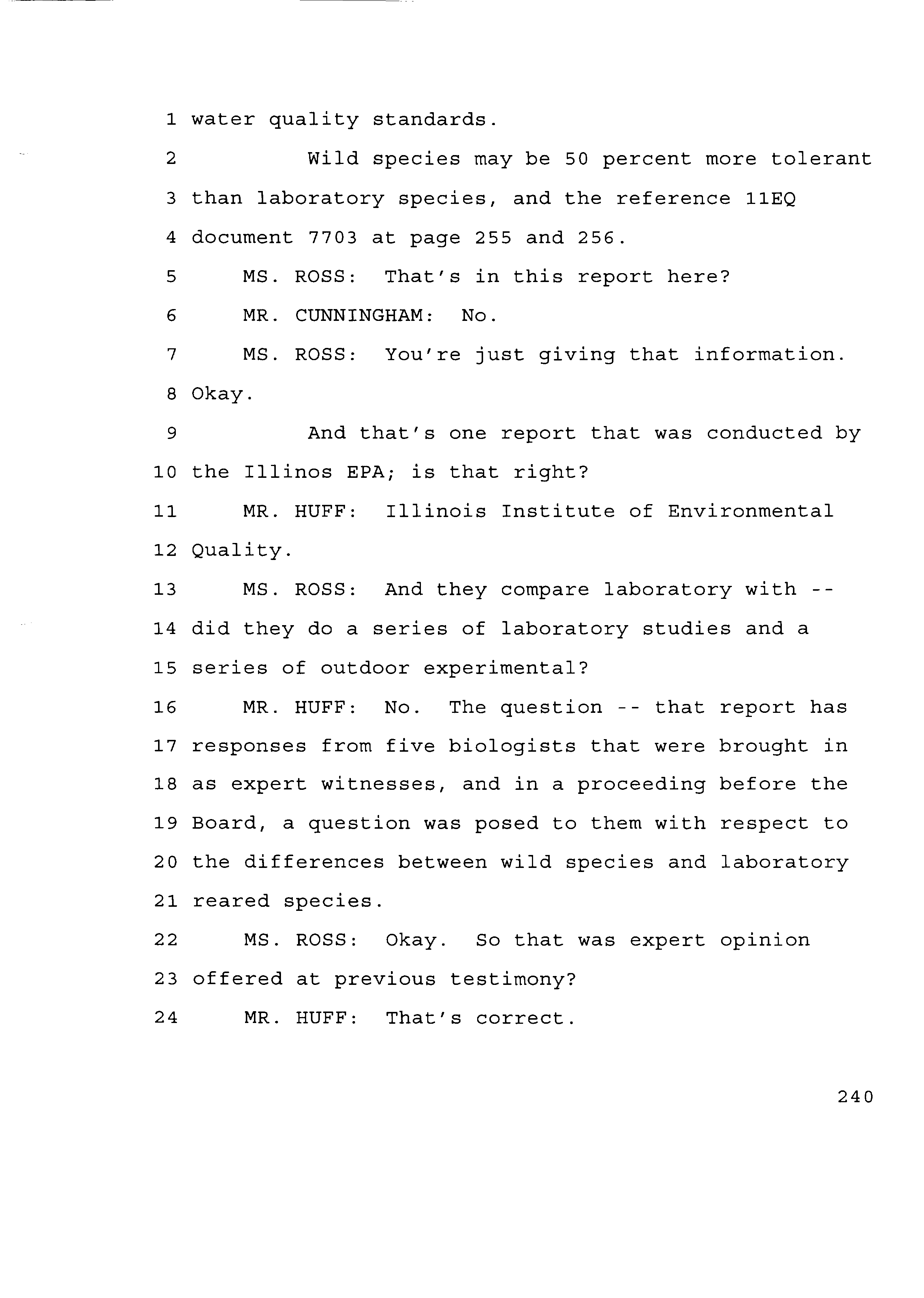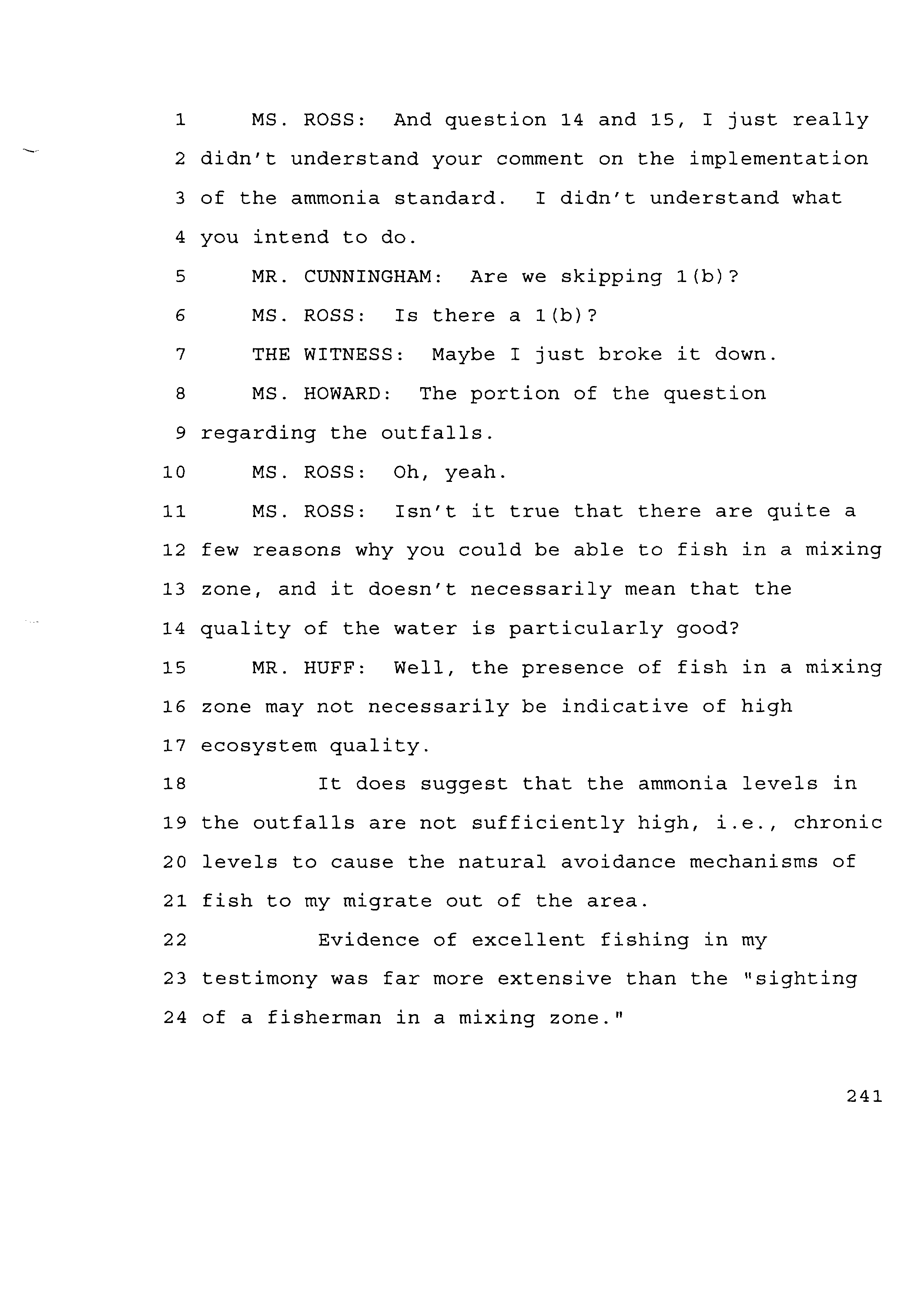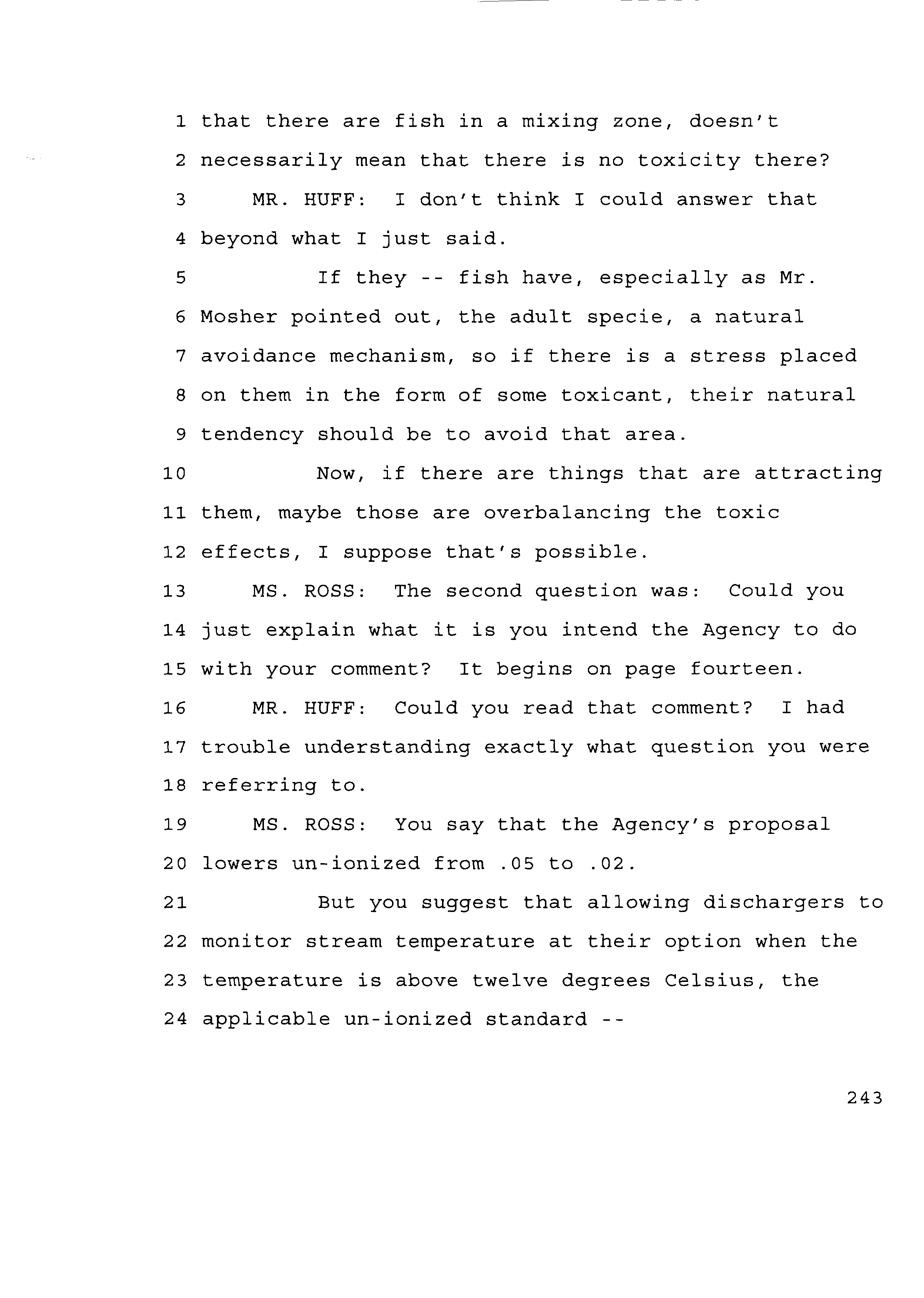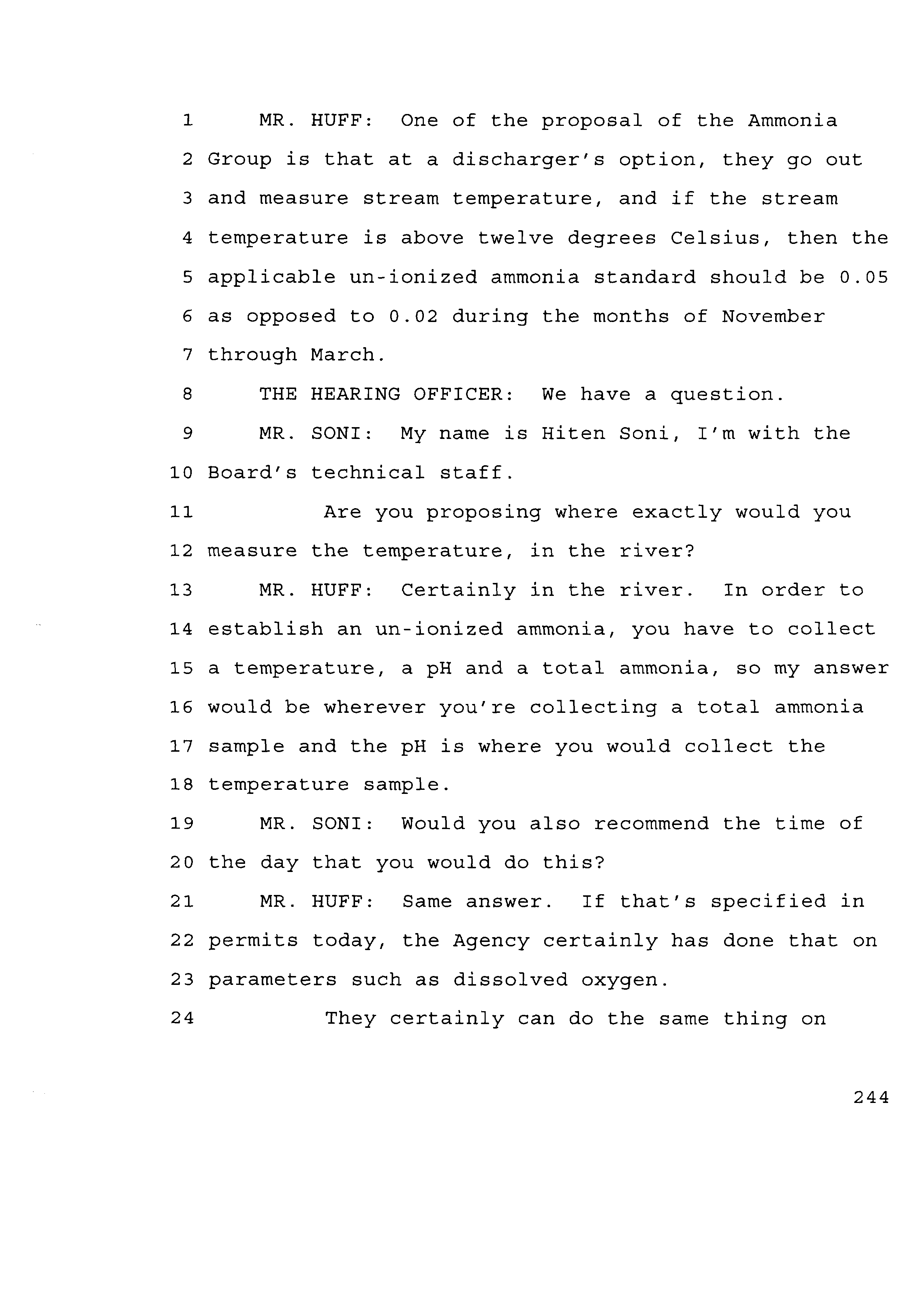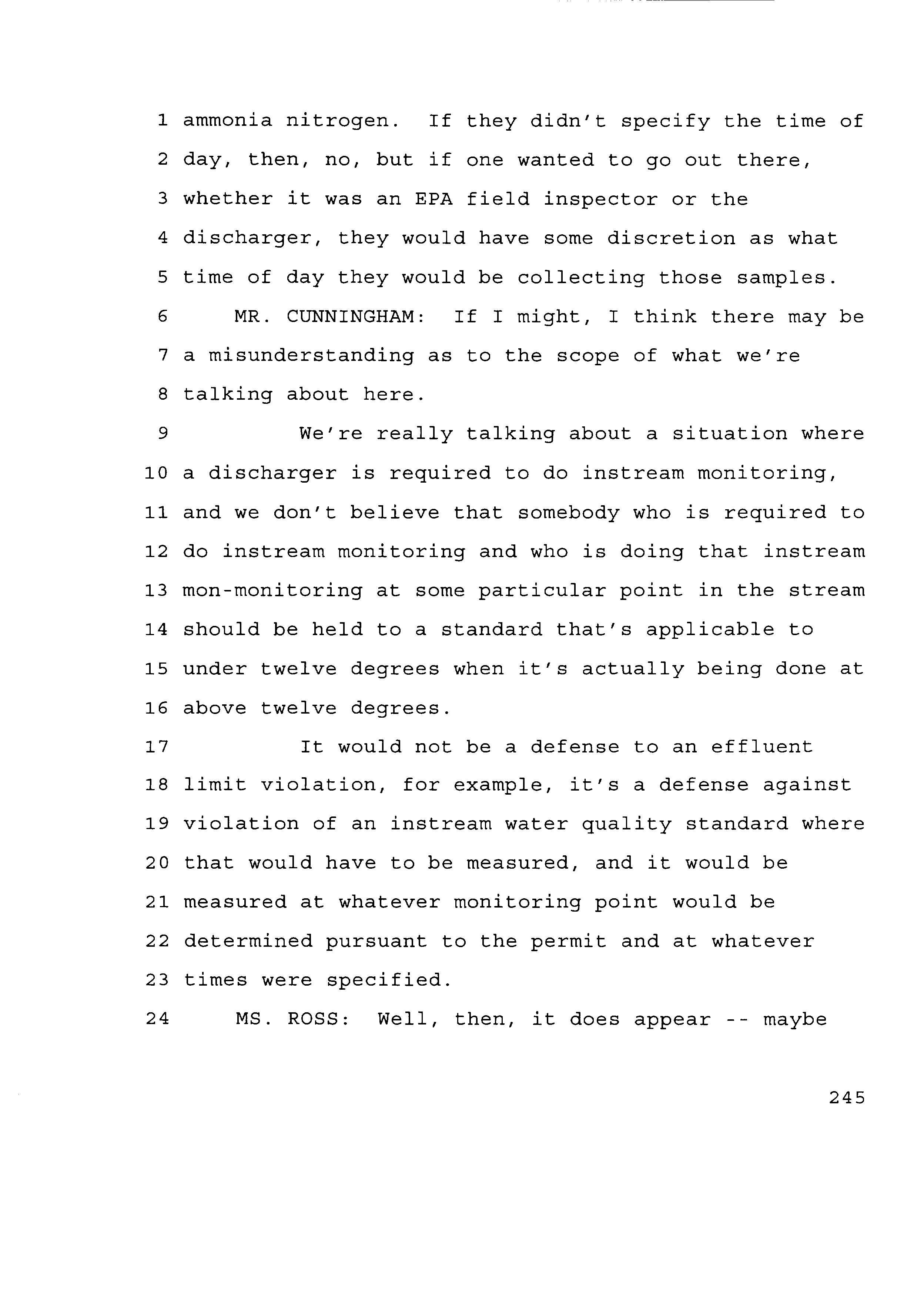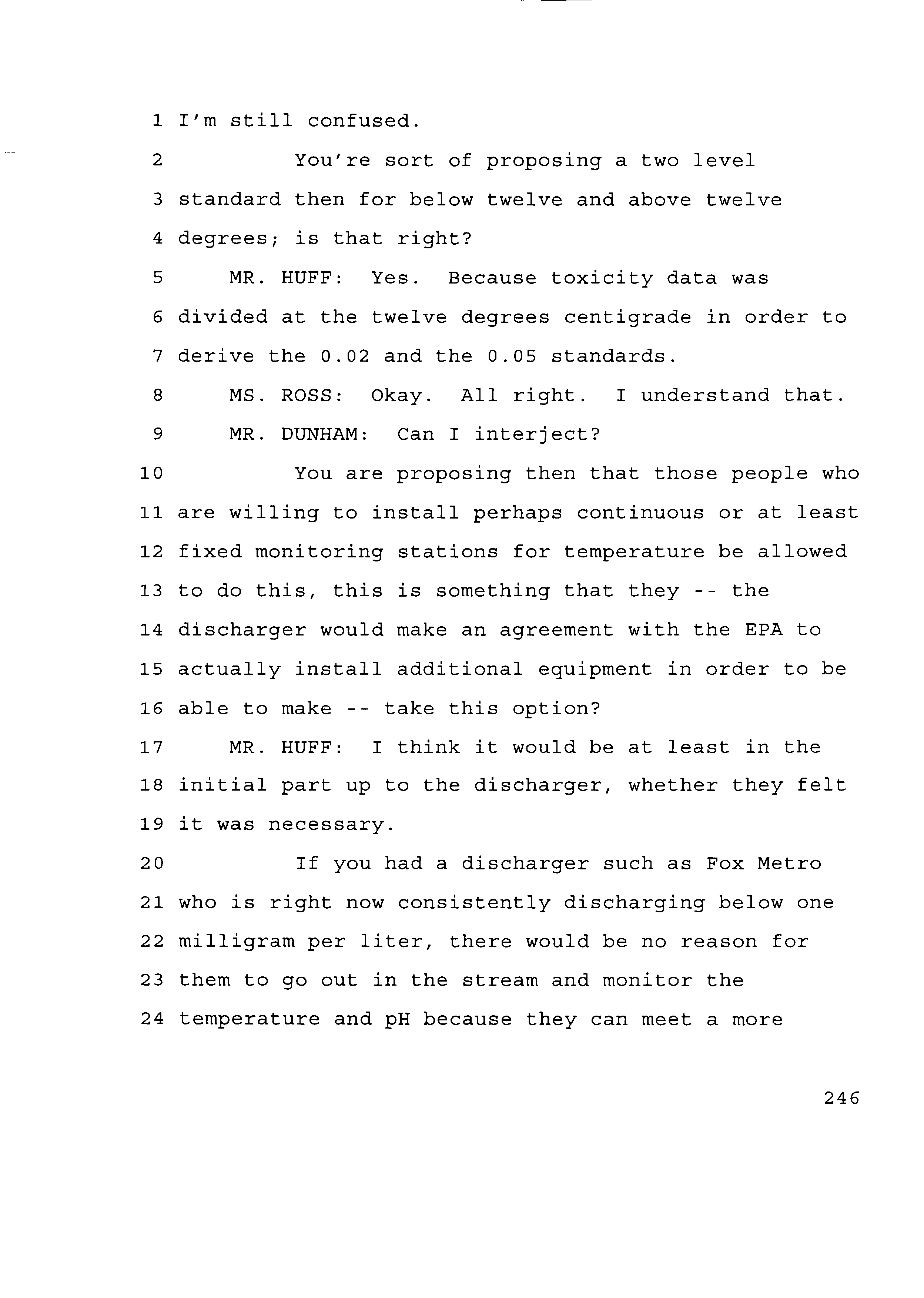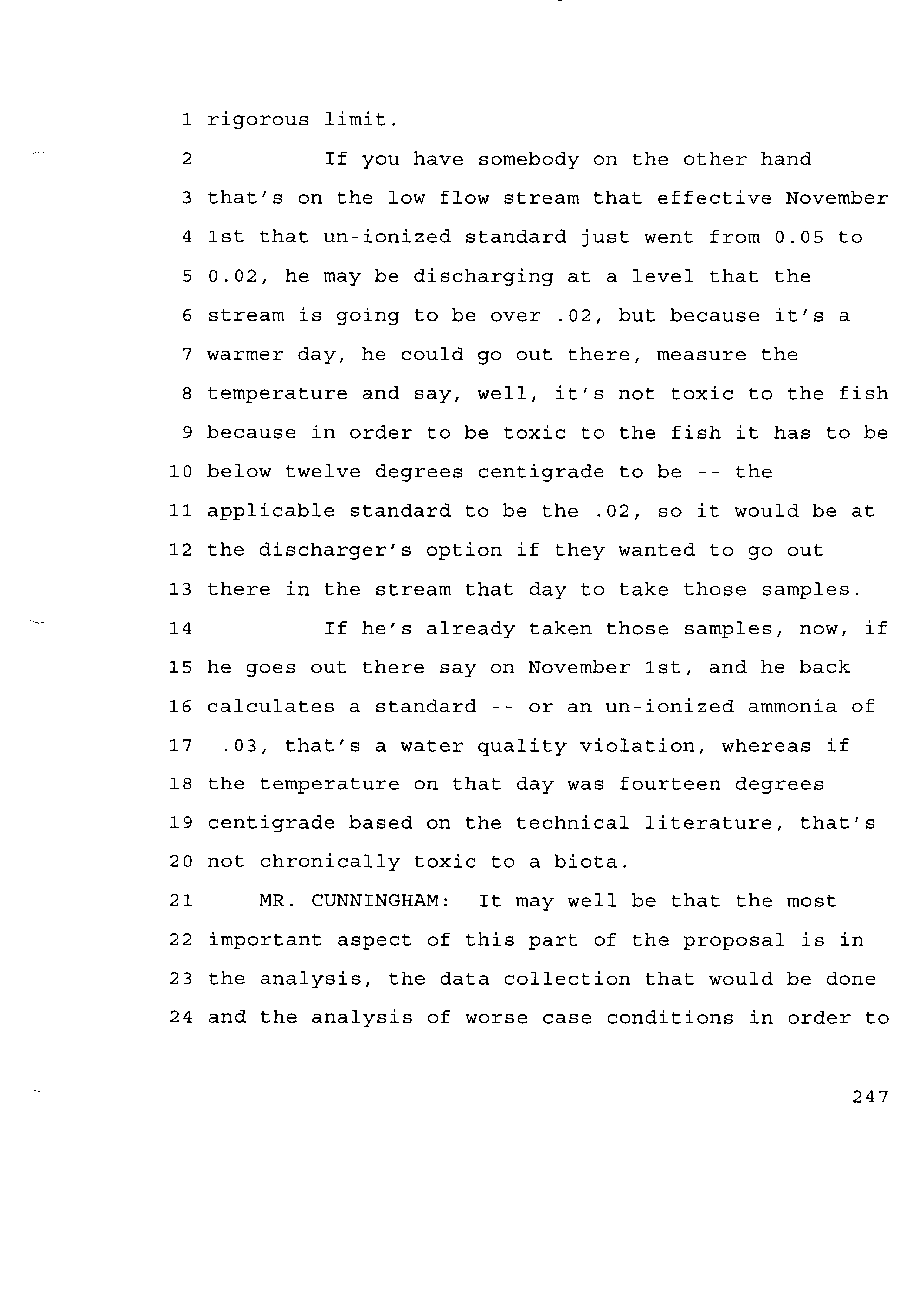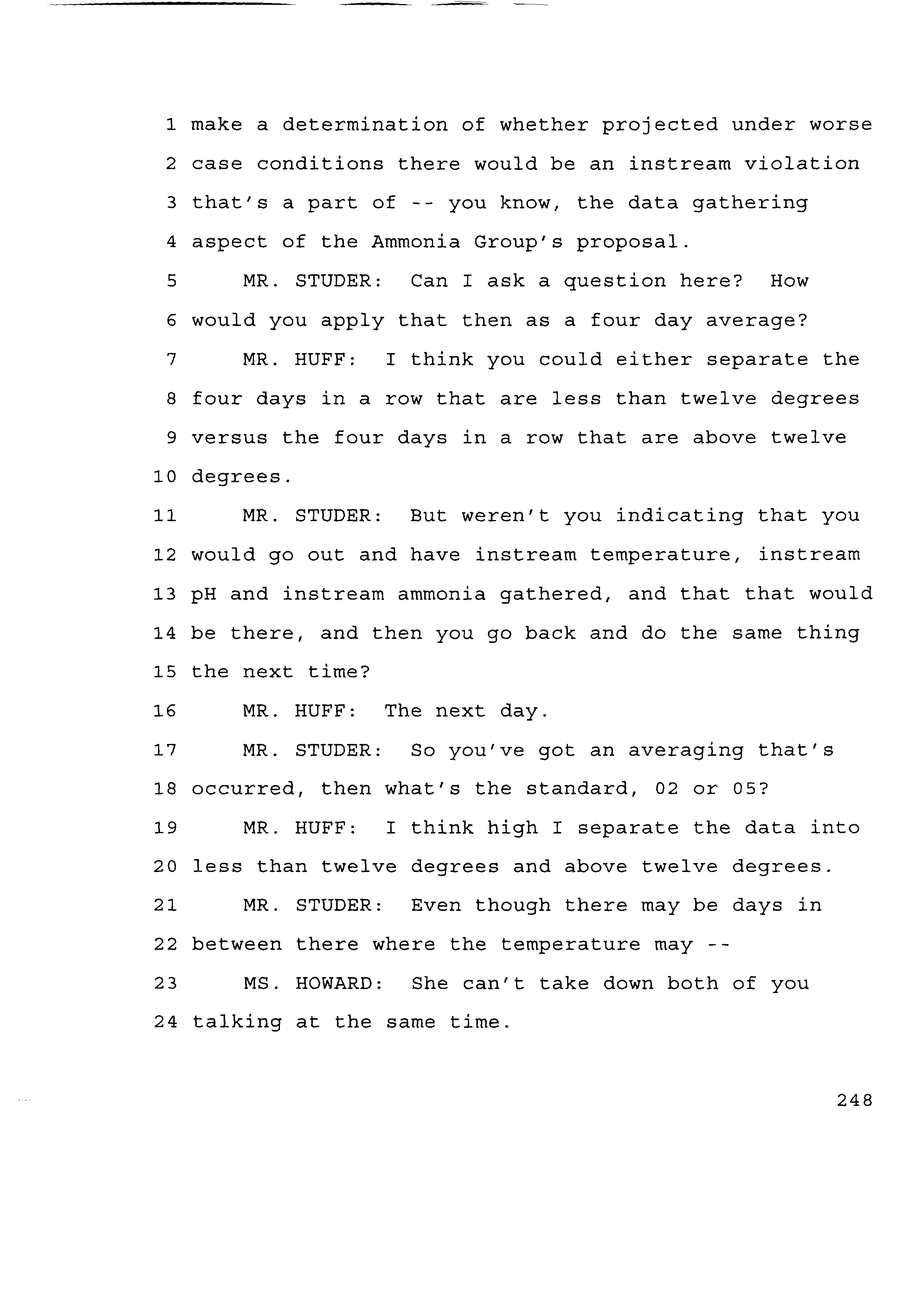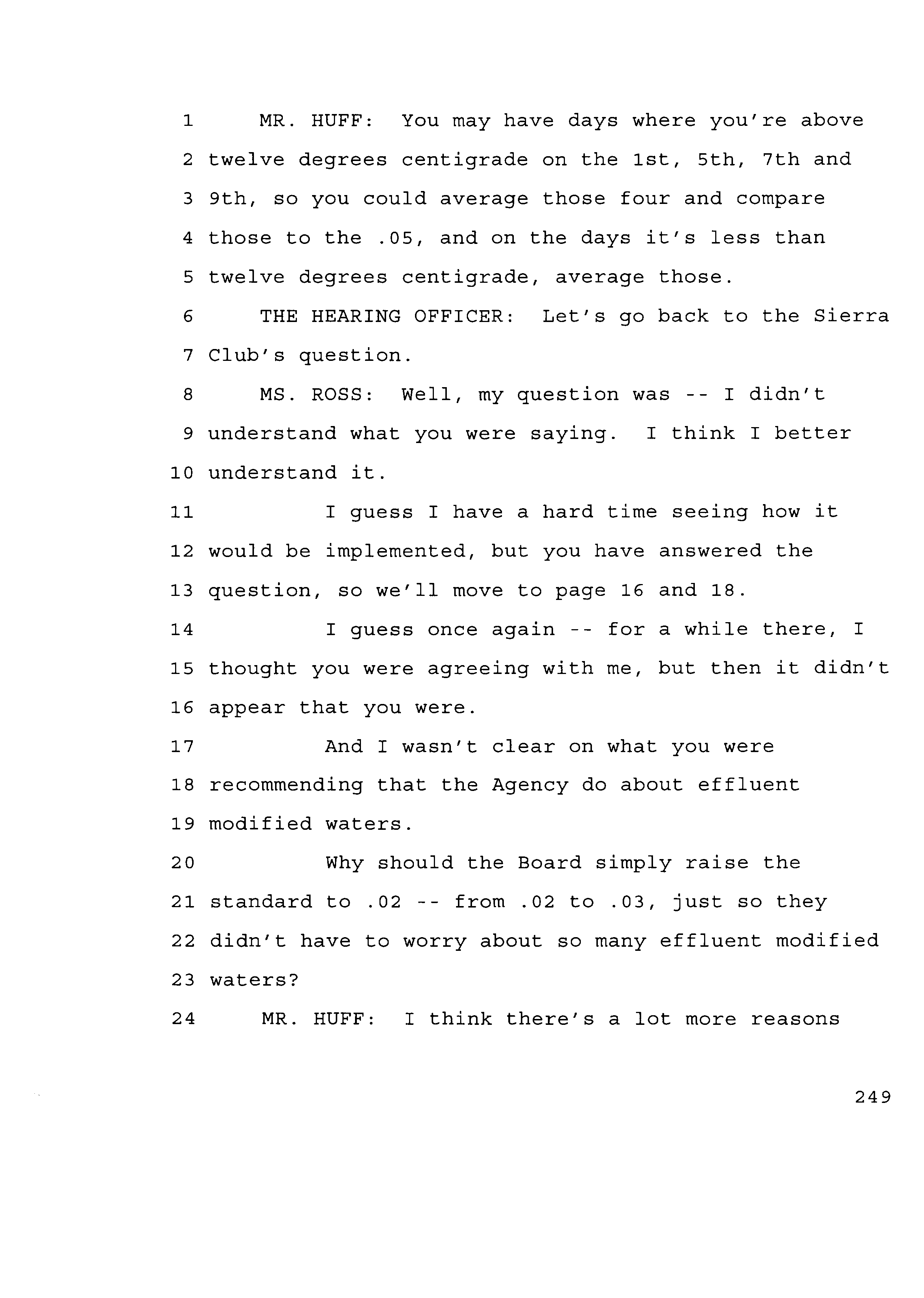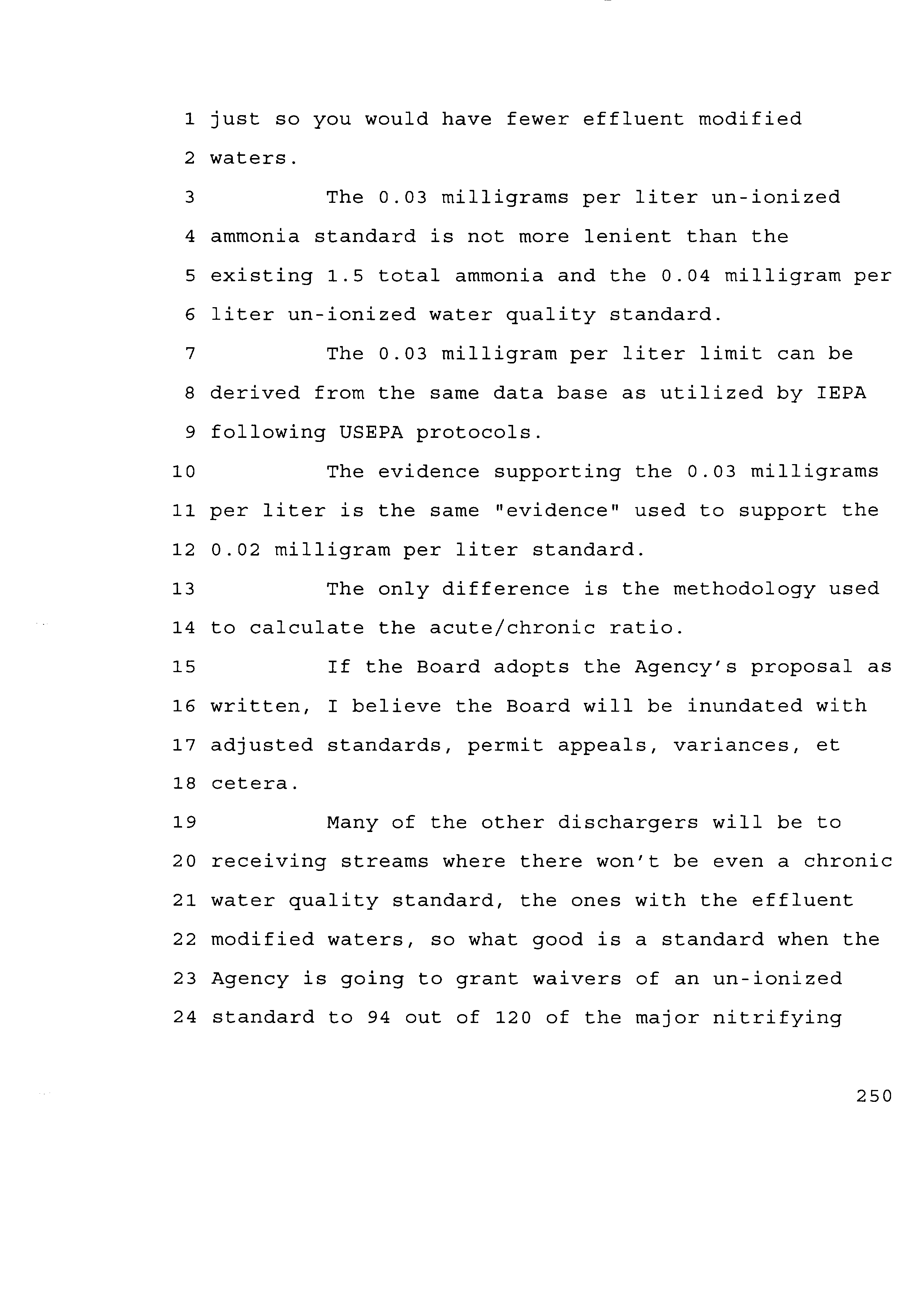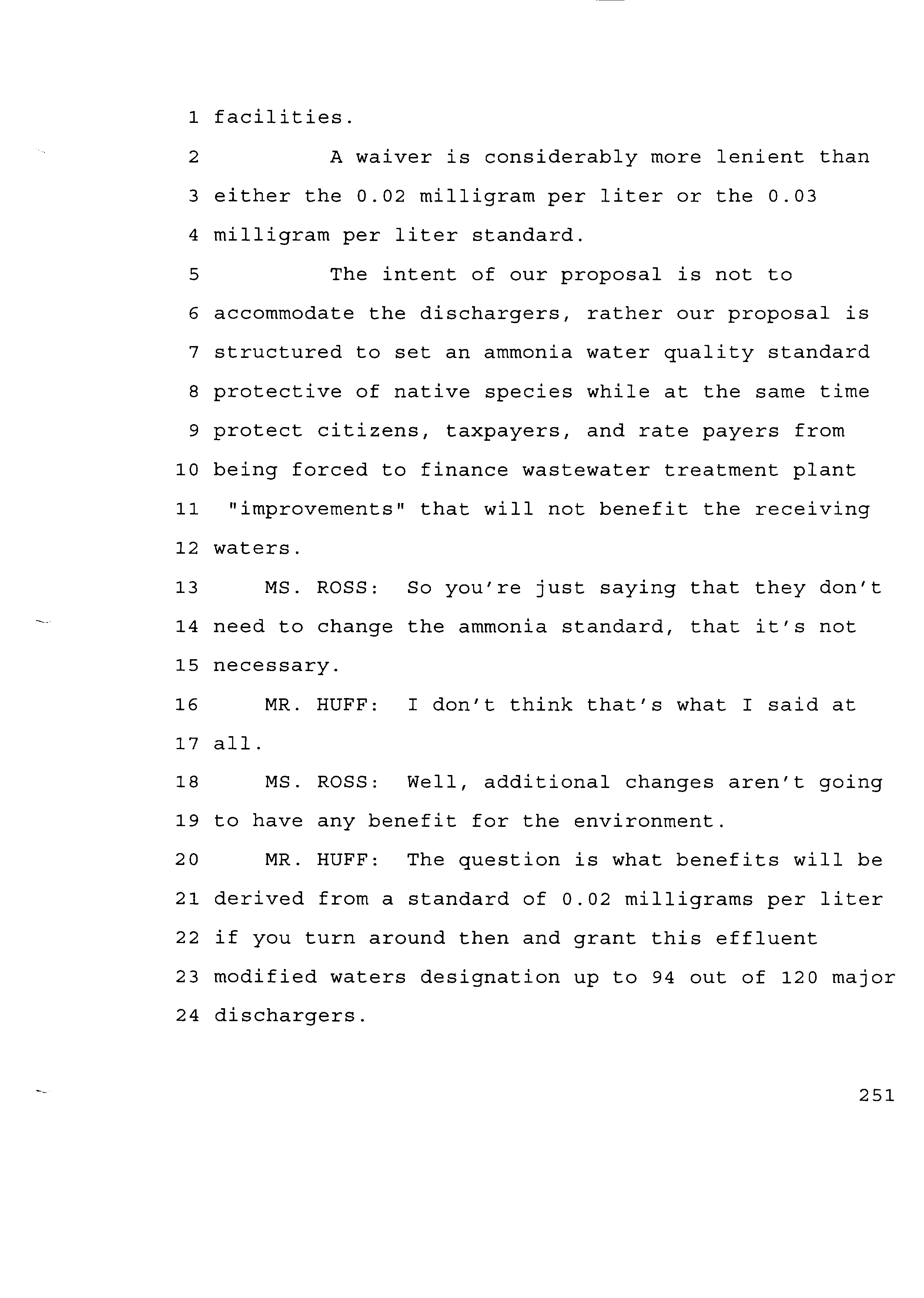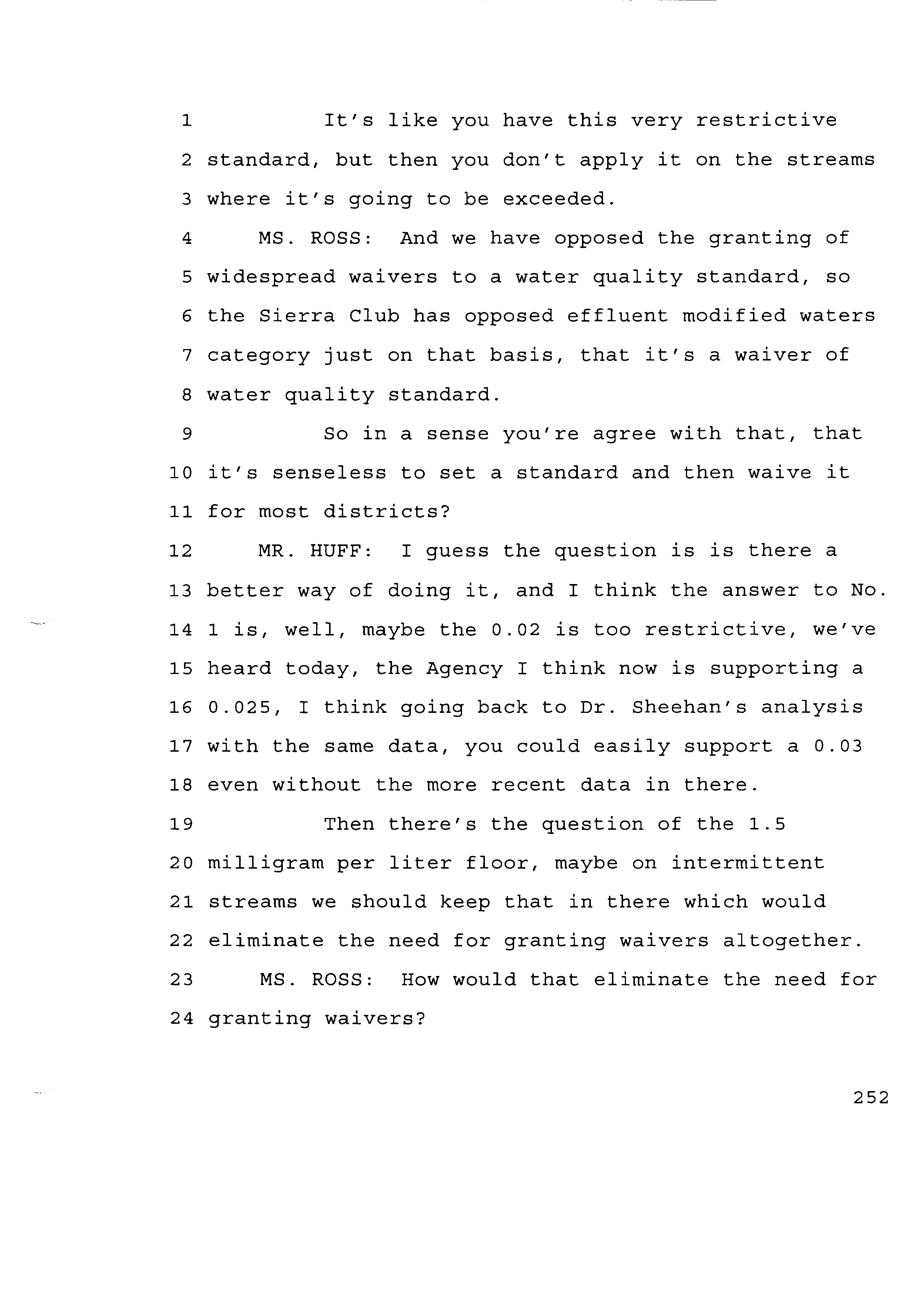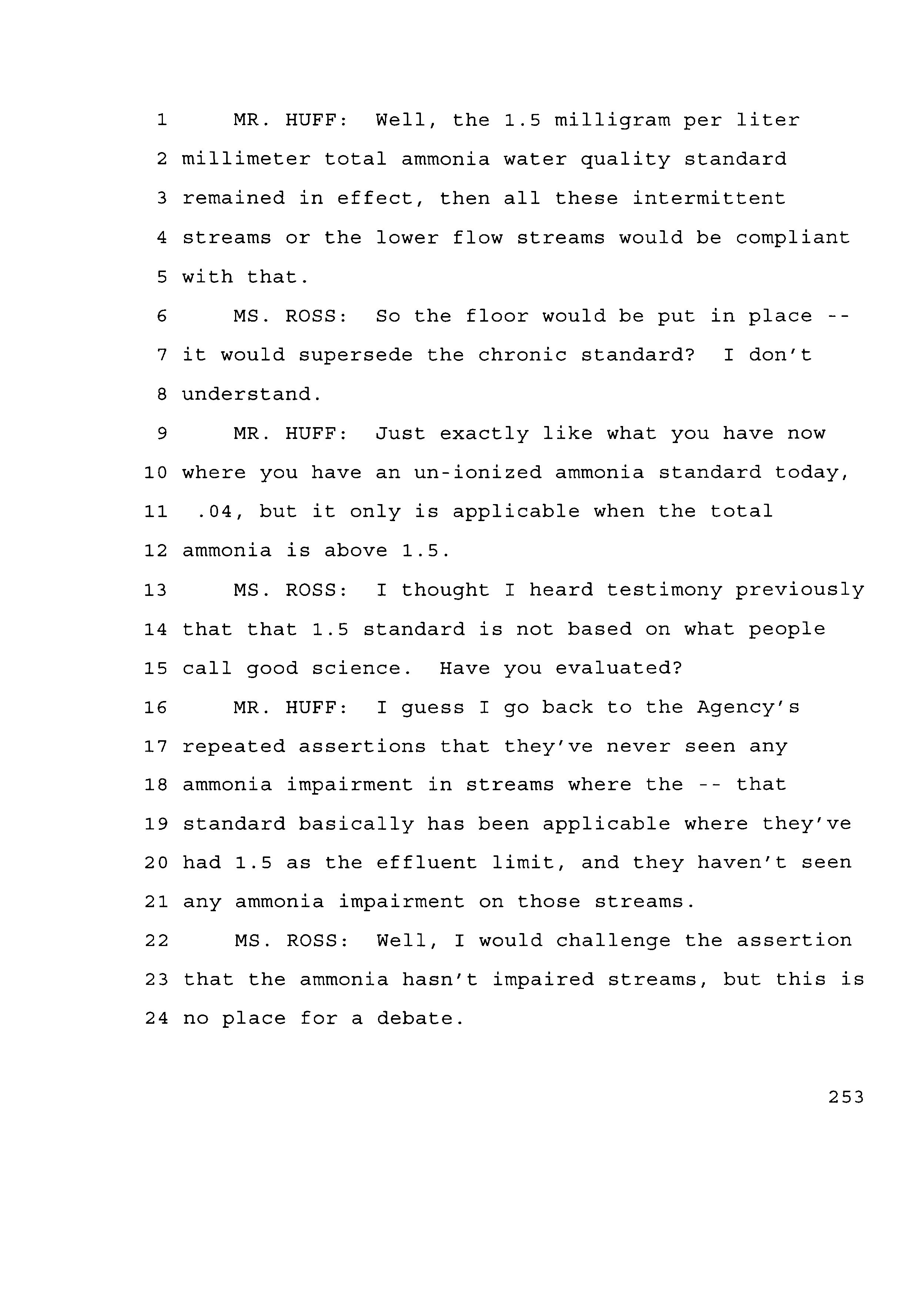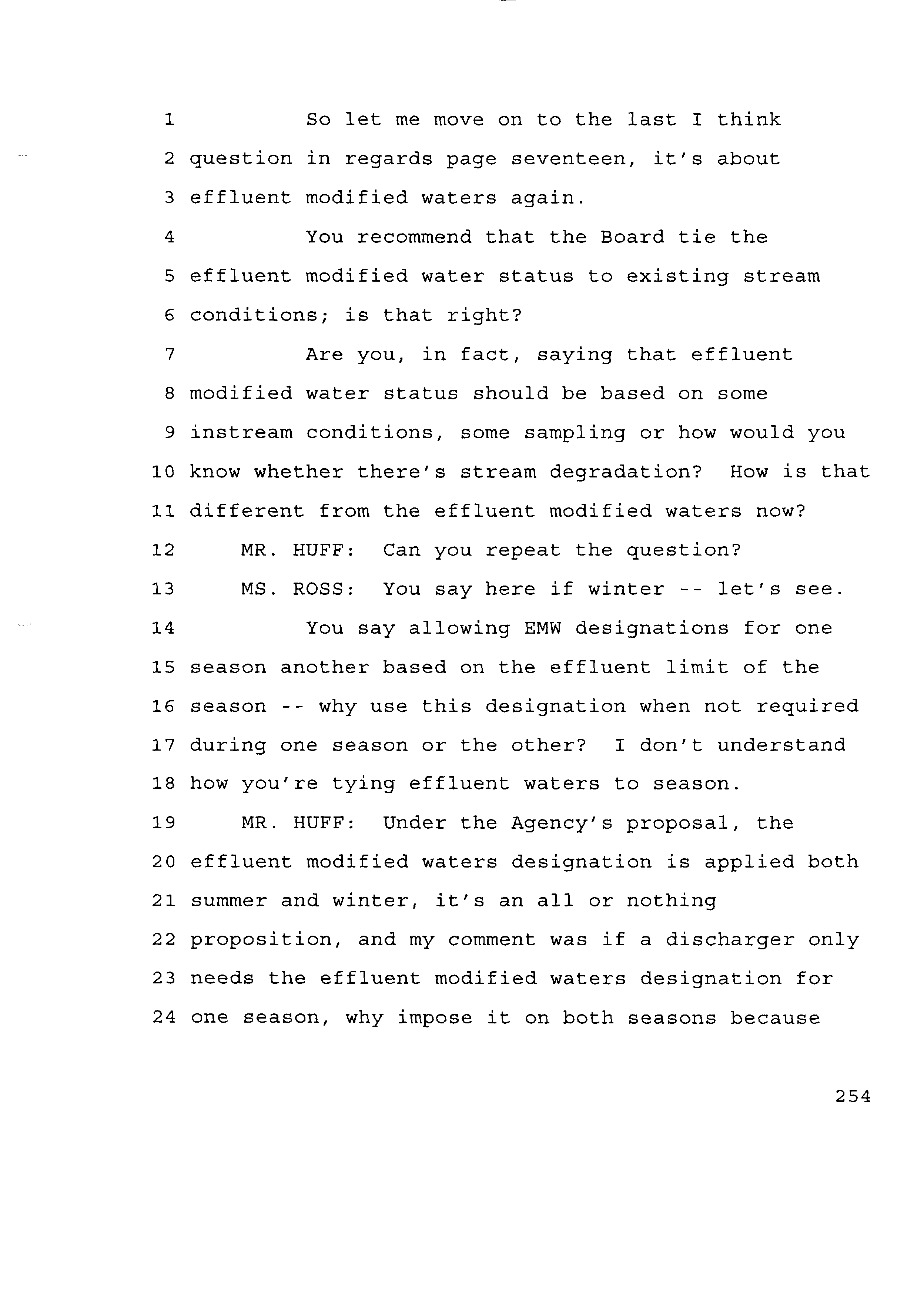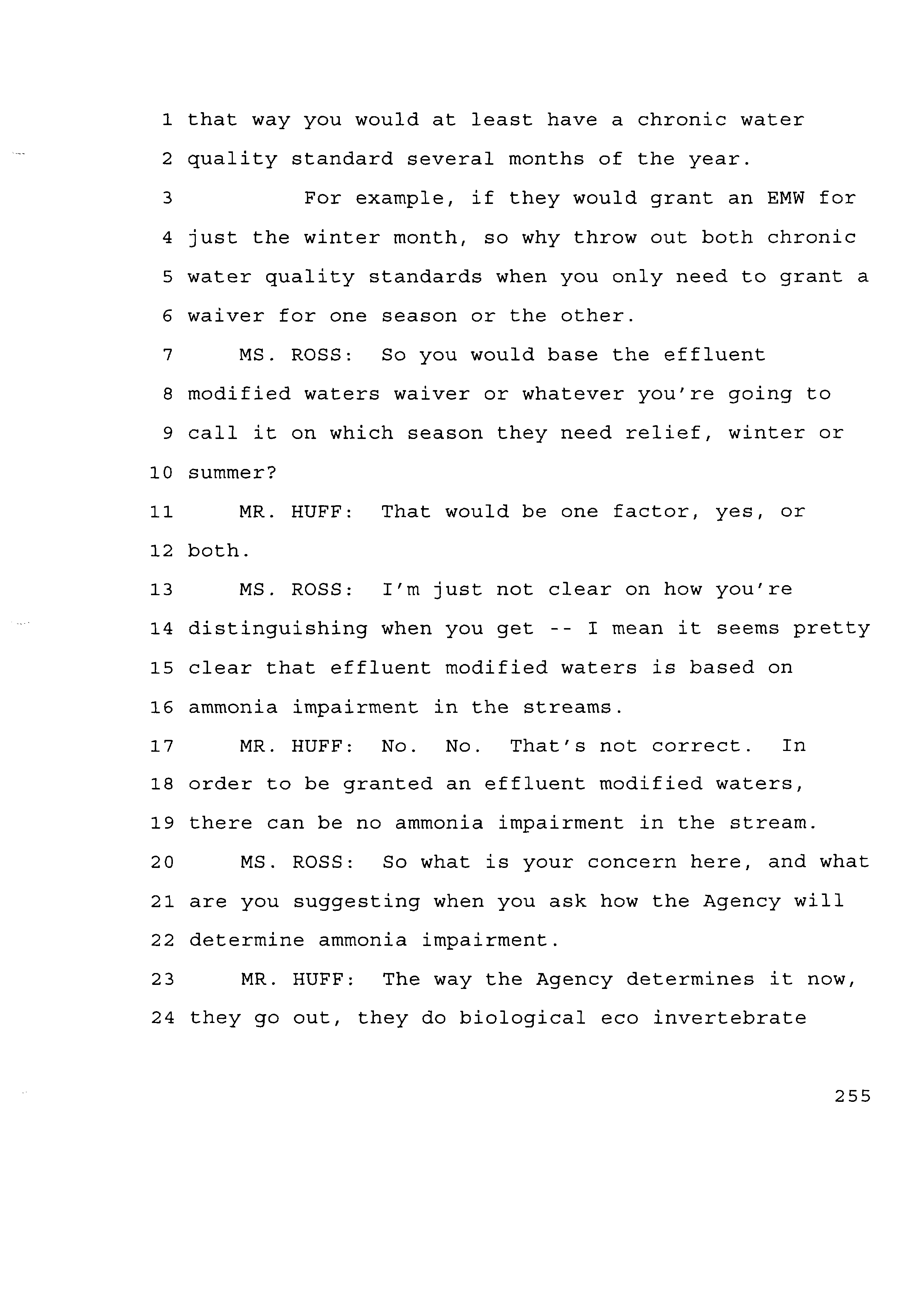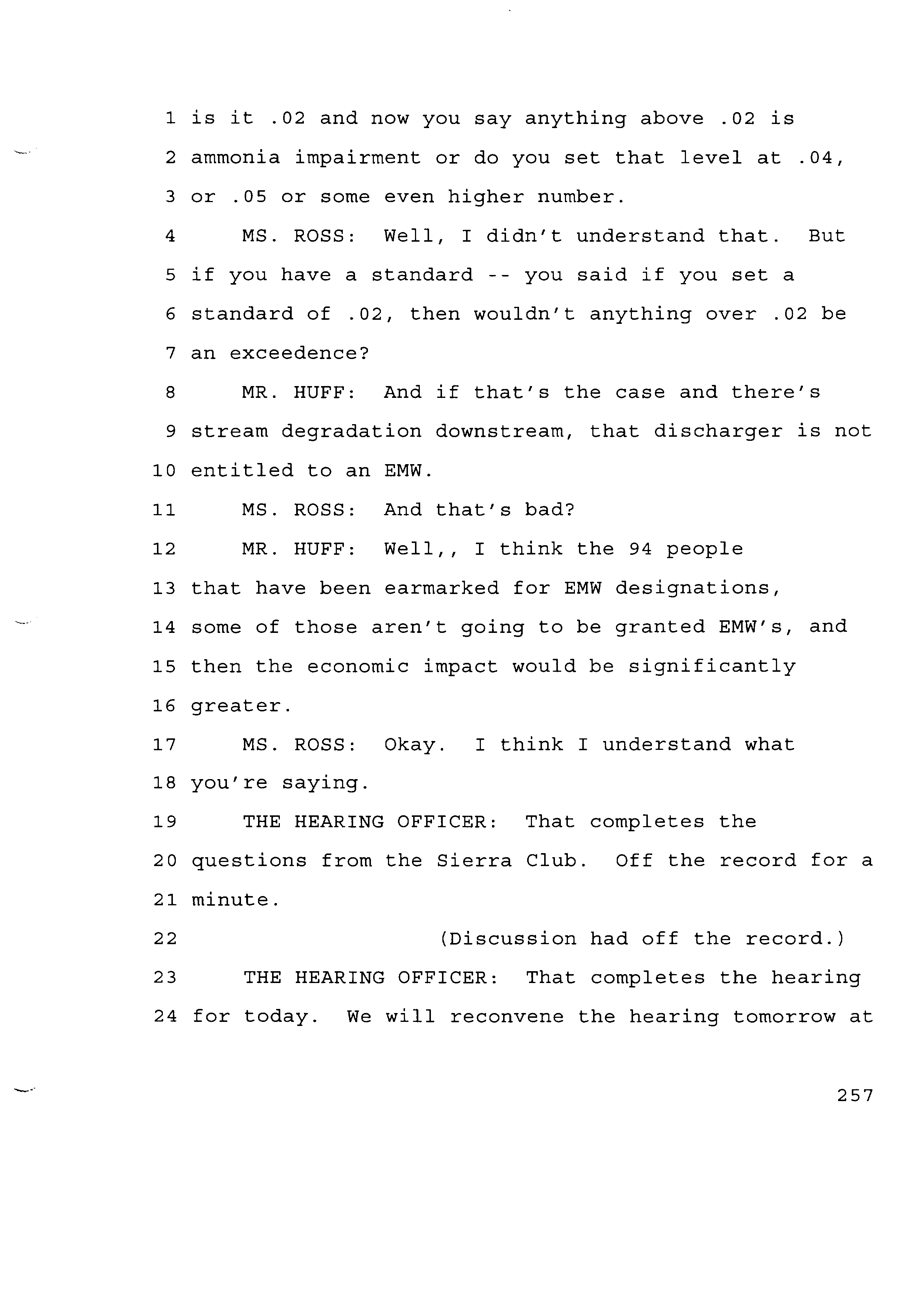1
2
3
4
5
6
7
8
9
10
11
12
13
14
15
16
17
18
19
20
21
22
23
24
APPEARANCES:
MS.
MR.
MR.
DR.
MS.
MS.
R94-/(B)
(Rulemaking)
ORIGINAL
BEFORE THE ILLINOIS POLLUTION CONTROL BOARD
r~’~fl
\
~tAR11199S
IN THE MATTER OF
\S~~ARD
AMENDMENTS
TO 35
ILL.
ADM CODE 302.202,
302.212,
302.213,
304.122 AND 304.301
(Ammonia Nitrogen)
Report
of proceedings had
in the above-entitled
cause, before Ms. Diane O’Neill,
the Hearing Officer,
on February
22,
1996 at the hour of 10:00 o’clock
a.m.
at the State of Illinois Building,
100 West
Randolph,
Chicago,
IL
60601.
DIANE O’NEILL,
The Hearing Officer
J.
THEODORE MEYER,
Board Member
EMMETT
E.
DUNHAM, Board Member
RONALD
FLEMAL,
Board Member
MARILI MC FAWN, Board Member
AMY HOOGASIAN,
Board Staff
1
1
APPEARANCES:
2
ILLINOIS
3
Mr.
4
Ms.
5
Mr.
6
Mr.
7
Mr.
8
Mr.
9
10
11
12
13
14
15
16
17
18
19
20
21
22
23
24
(Continued)
ENVIRONMENTAL PROTECTION AGENCY
Bruce
L.
Carlson
Margaret
P. Howard
Joel Cross
Dean J.
Studer
Robert
G. Mosher
Steve Vance
2
1
THE HEARING OFFICER:
Good morning.
This
is a
2 public hearing held by the Pollution Control Board in
3 Docket
No.
R94-1(B)
in the matter of amendments
to 35
4 Illinois Administrative Code 302.202,
302.212,
5 302.213 and 304.301 dealing with amendments
to
6 ammonia nitrogen rule.
7
My name
is Diane O’Neill,
I’m the Hearing
8 Officer for this hearing.
The attendant Board member
9
is Emmett Dunham who
is seated to my left.
10
We also have with us today Board member
11 Dr.
Ronald Flemal who is on my right.
12
Chairman Clara Manning had planned
to be
13 with us today,
but for unforeseen circumstances
she
14 was unable to make it up from Springfield,
but we do
15 have her assistant with us today, Amy Hoogasian.
16
And we also have present from the Board
17 our
--
from our technical
staff Hiten Soni.
18
Now,
the Agency filed these proposed
19 amendments with the Board on February 24th,
1994.
20 This proposal was filed pursuant to Section 27 of the
21 Environmental
Protection Act.
22
The Agency has certified that the proposed
23 rulemaking
is needed to fulfill the requirements
of
24 the Federal Clean Water Act.
3
1
The Board has accepted the proposed
2 rulemaking
as
a Federally required rule pursuant to
3 Section 28.2
of the act.
4
The Board must adopt
a rule that meets the
5 applicable Federal standard and is consistent with
6
Illinois statute.
7
On January 4th,
1996,
the Board severed the
8 proposed amendments
into two dockets.
Subdocket A
9 contains a proposed amendments to the lead and
10 mercury water quality standards.
11
The amendments
in subdocket A were published
12 for first notice January
26,
1996.
13
Subdocket B contains the proposed amendments
14
to the ammonia nitrogen rule water quality standard,
15 and this hearing
is on subdocket
B,
the amendments
to
16 ammonia nitrogen.
17
The Hearing Officer orders scheduling this
18 hearing,
establishes
scheduling for the presubmission
19 of testimony and questions.
20
The Board received prefiled testimony from
21 several parties.
Like
I
said,
I hope there’s copies
22 on the side there for anybody who has not already
23 received them.
24
Testimony was submitted by the Illinois
4
1 Environmental
Protection Agency,
Sailesh Jantrania,
2 on behalf of Borden Chemicals
& Plastics,
James
3 Daugherty on behalf of the Illinois Association
of
4 Wastewater Agencies,
Greg Buchner on behalf
of the
5
Fox Metro Water Reclamation District and by James
6 Huff on behalf
of the Ammonia Group.
7
In order to expedite this proceeding,
I
8 request that all prefiled testimony be entered as
if
9
read.
10
By entered as if read,
I mean that the
11 prepared testimony with any corrections
is entered
as
12 an exhibit and will be made part of the transcript.
13
It will be treated the same as
if it were
14 actually read into the transcript.
15
And as this is a rulemaking and not
a
16 contested case,
all relevant,
not duplicative
17 information will be allowed into the record.
18
We also have as
the preliminary,
we have a
19 motion that is before the Board in this matter.
20
There was a motion filed by the Agency on
21 February 13th,
1996 to strike the testimony of
22 Sailesh Jantrania on behalf
of Borden Chemicals and
23 Plastics.
24
Borden Chemicals and Plastics filed
a
5
1 response
to the motion on February
14,
1996.
A
2 response
to the motion was also filed by the Ammonia
3 Group.
4
On February 16th,
a Hearing Officer order
5 was issued denying the motion to strike.
6
Yesterday the Agency filed
its reply to the
7
response.
After reviewing the reply by the Agency,
I
8 find no reason to change
the Hearing Officer order of
9 February 16th allowing the testimony from Borden
10 Chemicals and Plastics.
11
Therefore,
we will allow the testimony to be
12 entered into the record today.
And the Agency’s
13 objection to the testimony will be entered into the
14
record.
15
Are there any other preliminary matters or
16 motions that need to be addressed that time?
17
MS.
HOWARD:
No.
18
THE HEARING OFFICER:
I guess we can begin with
19 the Agency’s testimony.
20
MS. HOWARD:
We have a revised cost estimate
21 statement that we would like to make to revise the
22 testimony of Dean Studer.
23
MR. DUNHAM:
Is this
a revision from the January
24 29th,
pretrial testimony as well or is this the
6
1 revision in that testimony?
2
MS. HOWARD:
I believe this is a revision
of
3
that.
Yes,
this revises that section.
4
MR.
DUNHAM:
Okay.
5
THE HEARING OFFICER:
Do you know what exhibit
6
that was entered as?
7
MR. DUNHAM:
2-S,
I believe, wasn’t
it?
8
MS. HOWARD:
It’s actually a revision
of Section
9
D on pages
40 through 43.
It would supplement
that
10 section.
11
THE HEARING OFFICER:
It was previously entered
12 as Exhibit
2
at the November 10th hearing.
13
MS. HOWARD:
Right.
We filed it on January
26,
14
1996.
15
THE HEARING OFFICER:
So this testimony hasn’t
16 been entered?
17
MR.
CARLSON:
This is an update
of those pages
18 from the Agency’s additional
comments filed January
19 26th
--
or dated January 26th.
20
MR.
DUNHAM:
You’re talking about the economic
21 impact
if the proposed ammonia nitrogen standards are
22 not adopted or are you talking about the proposed
23 impact
if they are adopted on page 39?
24
MS. HOWARD:
On page
40,
the economic impact
if
7
the proposed ammonia nitrogen standards are not
1
2
adopted.
3
THE HEARING OFFICER:
Do you have replacement
4 pages for that testimony?
5
MS.
HOWARD:
It’s not a replacement,
it’s a
6
supplement,
what he would be testifying to right
7 now.
8
MR.
CUNNINGHAM:
Can
I
see a copy?
9
MS.
HOWARD:
He’s going to read
a statement.
10 It’s not something we are entering.
11
MR.
CUNNINGHAM:
I have
a question here.
12
THE HEARING OFFICER:
I’m sorry,
if you’re going
13 to make a statement,
you need to identify yourself
14 for the court reporter.
15
MR. CUNNINGHAM:
I’m Lee Cunningham,
Gardner,
16 Carton
& Douglas on behalf
of the Ammonia Group.
17
The Agency’s testimony was actually
18 presented as additional
comments,
and we’re now
19 talking about modification
of Dean Studer’s
20 testimony.
21
It would seem to me to be helpful
if we
22 could identify who’s testimony this really
is,
who is
23 responsible
for what part
of
it.
24
MS.
HOWARD:
This
is the economic statement
that
8
was made and this was testimony that
--
or it’s
information that Dean Studer put together.
MR. CUNNINGHAM:
So that’s
--
you’re talking
about
this,
on pages forty through
--
to the
conclusion?
MS. HOWARD:
MR. DUNHAM:
that,
on page 30
MS. HOWARD:
MR. DUNHAM:
Or page what?
MS.
HOWARD:
This D section is the section that
Dean researched and he’s familiar with.
The other
economic section
is what Bob did.
THE HEARING OFFICER:
Okay.
All right.
We want
to swear in the Agency’s witnesses first off.
THE HEARING OFFICER:
I
ask the court
reporter to
swear
in the witnesses
for the Agency.
(Agency witnesses sworn.)
THE HEARING OFFICER:
I
just also want you to
identify who you have with you today for the record.
MS. HOWARD:
My name
is Margaret Howard,
and
I
represent the Illinois EPA.
Mr. Bruce Carison is also an attorney with
the Illinois EPA.
Dean
--
Mr.
Dean Studer
is with
Forty through forty-three.
Well,
the economic
starts before
or so?
Right
1
2
3
4
5
6
7
8
9
10
11
12
13
14
15
16
17
18
19
20
21
22
23
24
9
1 the permit
section.
Mr.
Steve Vance
is with the
2 planning section.
3
Mr. Joel Cross
is the supervisor
for the
4 planning section,
and Mr.
Bob Mosher or Robert Mosher
5
is also with the planning section.
6
THE HEARING OFFICER:
Thank you.
7
MR.
STUDER:
In the prefiled Agency’s additional
8 comments,
the Agency identified seven facilities
as
9 unable
to comply with the existing water quality
10 standards during the winter months due to the
11 expiration
of the 4.0 milligram per liter winter
12 ammonia nitrogen effluent standard of
35 Illinois
13 Administrative Code 304.301.
14
All seven
of these facilities
can and have
15 complied with the winter monthly average ammonia
16 nitrogen effluent limit of 4.0 milligrams per liter
17 and a summer monthly average ammonia nitrogen
18 effluent limit
of 1.5 milligrams per liter.
19
In the prefiled comments,
the Agency
20 estimated that the cost to upgrade these
facilities
21 would be roughly equal to the cost of going from
a
22 secondary plant to a secondary plant designed to
23 remove ammonia nitrogen.
24
Since the time of the filing
of the prefiled
10
1 comments,
the Agency has re-evaluated these estimated
2
costs and has developed more accurate cost estimates
3 from actual wastewater treatment plant performance
in
4 Illinois.
5
These revised cost estimates are based on
6 several presumptions.
First,
it was presumed that a
7
2.0 milligram per liter total ammonia nitrogen
8 concentration would be sufficient
to comply with the
9 current
0.04 milligram per liter un-ionized ammonia
10 water quality standard.
11
The second presumption
is that organic
12 loading in the aeration tanks
of
8 pounds BOD per
13 1,000 cubic feet and a hydraulic retention time of at
14 least
24 hours will allow
a 2.0 milligram per liter
15 total ammonia effluent to be met.
16
Third, protection from excess flows and
17 hydraulic surges must be provided.
18
Typically this is done by the use of
19 sidestream excess
flow treatment facilities.
20
The final presumption
is that adequate
21 pretreatment
exists to protect the treatment process
22 from toxics and to keep the influent wastewater
23 within design strengths.
24
Means Building Construction Cost Data 1994
11
1 and adjusted to 1996 dollars was used to prepare the
2 construction cost estimates.
These estimates include
3 overhead, profit and contingency.
4
The following are construction cost
5 estimates based on design average flow for adding
6 treatment to meet winter ammonia nitrogen effluent
7
limits for activated sludge plants.
8
One milligram per liter would cost $2
9 million.
That’s one MGD would be
$2 million.
A
5
10 MGD plant would be 6,440,000.
A 10 MGD plant would
11 be $11,800,000.
And a 20 MGD plant would be
12 $22,800,000.
13
An exhibit showing these costs graphed as
a
14 function of plant size will be presented at the end
15
of this statement.
16
The estimates for additional treatment for
17 the seven identified municipal dischargers
as derived
18 from the graphs are given as follows.
19
One of the plants at one MGD would cost
$2
20 million,
one of the seven plants
at 1.045 MGD would
21 be $2,050,000.
22
One plant at
1.68 MGD
is 2,755,000.
One
23 plant
at 1.837 MGD would be $2,929,000.
One plant
at
24
3 MGD
is $4,220,000.
12
1
One plant
at 4.5 MGD
is $5,885,000.
And one
2 plant
at 41 MGD which would be $46,700,000.
3
A total
of seven plants with a combined
4 design average flow of 54.062 MGD and a total cost of
5
$66,000,539.
6
The revised total capital cost estimate for
7 these seven facilities
is in excess
of
$66 million.
8
It
is important to realize that these
9 facilities have already borne the cost of
10 constructing best degree of treatment for ammonia
11 removal once,
and now if the proposed ammonia
12 nitrogen standards are not adopted with their EMW
13 provisions before the end of these
facilities’
14 compliance
schedules,
these same facilities will be
15 required to expend in excess of
$66 million to comply
16 with existing ammonia nitrogen requirements.
17
This is an enormous sum of money to be spent
18 especially
considering that the Agency has not found
19 instances
of ammonia degradation
in the receiving
20 waters below these facilities.
21
If this current trend continues,
it is
22 reasonable
to assume that these numbers would double
23 when the current five year NPDES cycle
is complete
24 and could reach
a total
of well of excess of $132
13
1 million.
2
The Agency believes that this will continue
3 for the next two to three years and will stop only
4
after all major municipal NPDES permits
in the
5 current NPDES cycle have been renewed.
6
MS. HOWARD:
We can enter this as the next
7
exhibit.
You should have copies
of
it.
8
This is one of them.
We would like to enter
9
it as copies.
We just have one exhibit.
10
THE HEARING OFFICER:
You’re entering the graph
11
of the plant size versus the cost?
12
MS. HOWARD:
Right.
13
THE HEARING OFFICER:
It will be Exhibit No.
40.
14 Can we have some extra copies for the Board members?
15
MS. HOWARD:
Sure.
I’m sorry.
16
THE HEARING OFFICER:
I would also like to note
17 for the record that Board member,
J.
Theodore Meyer
18 has joined us at the hearing.
19
MR.
CUNNINGHAM:
Do we have an exhibit number on
20 this?
21
THE HEARING OFFICER:
Exhibit No.
40.
22
MR.
DUNHAM:
Is it the Agency’s position that the
23 effluent modified waters provision and the proposed
24 language
of this rule would take care of these
14
1 construction costs or obviate the need for additional
2 construction?
3
MR.
STUDER:
That is correct.
4
MS. HOWARD:
There’s one clarification
I would
5
like to make.
Mr. Studer when you read seven plants
6 at 54.062 MGD,
did you intend that the total
cost
7 would be $66,539,000?
8
MR.
STUDER:
That’s correct.
9
MS.
HOWARD:
The Agency would request that the
10 Agency’s additional comments that were filed on
11 January 26th,
1996 including Mr. Studer’s revised
12 statement be entered as an exhibit.
13
THE HEARING OFFICER:
Okay.
14
MR.
CUNNINGHAM:
I have an objection to that.
15 Still
I
think we need to identify who’s testimony
16 this actually
is before we have
it entered into the
17 record as testimony.
At this point it’s just
18 comments.
19
MS. HOWARD:
The Agency was under the impression
20 that when the Board met with us for the prehearing
21 conference that we had to
--
they wanted additional
22 information,
so we labeled the document additional
23 comments.
24
Different Agency personnel were responsible
15
1 for researching
to answer
the different issues raised
2 by the Board.
3
Do you guys want
to
--
I could go through
4 each one.
S
THE HEARING OFFICER:
I think it’s acceptable to
6
just enter this as an Agency comment,
and then as we
7 go through the questions,
the Agency will direct
it
8
to the personnel that are most able to answer
it,
and
9 then
I
think from there we can determine
--
10
MR. CUNNINGHAM:
I guess
so long as it’s made
11 clear that these are just Agency comments,
should not
12 be given the same weight
as sworn testimony,
I don’t
13 have any problem with that.
14
THE HEARING OFFICER:
Okay.
We’ll note that for
15 the record.
So we will enter the Agency comments.
16
MR. DUNHAM:
The alternative
I believe would be
17 to
--
could this be entered as
a group effort and as
18 the sworn testimony of these individuals here,
was it
19 worked
on by other people?
20
MS. HOWARD:
Oh,
no.
21
MR.
DUNHAM:
This is the group that produced
--
22
MS.
HOWARD:
This is the group that put the
23 additional
comments together.
24
MR.
DUNHAM:
Is there an objection to this being
16
1 the sworn testimony of this group?
2
MR. CUNNINGHAM:
Well,
I’ll tell you all and all
3
it’s a little bit troublesome
that this hasn’t been
4 divided out into any one’s particular
testimony,
but
5
I won’t object to that.
6
MR. DUNHAM:
I have some trouble with it myself
7 because
I don’t know whose comments
I was reading,
8 but
it appears to be within a narrow universe of
9 persons.
10
THE HEARING OFFICER:
I think we can note that it
11 is an Agency’s additional
comment and it’s not
12 identified exactly to which members of the Agency
13 prepared which parts of the document and leave
it up
14
to the Board to give
it its proper weight,
whether
it
15 needs to be considered
as sworn testimony.
16
So we can enter the Agency’s additional
17 comments as Exhibit No.
41.
18
Does that conclude the Agency’s presentation
19 of testimony?
20
MR.
MOSHER:
No.
21
MS. HOWARD:
I
just wanted to reiterate the point
22 that the Agency based on what was said at the
23 prehearing
conference was under the impression that
24 the Board wanted additional comments from the Agency,
17
1 and that’s why we did not specifically label anything
2
testimony.
3
We had a combined effort
of the four people
4 that are sitting before
the Board today,
put together
5
the information that went into the document entitled
6 Agency Additional
Comments,
and it was not an intent
7
to take away any weight from the information that’s
8 contained in the additional
comments.
9
It’s not the intent
of the Agency, but that
10 it was just a matter of we were under the impression
11 it was just additional
information
that the Board
12 needed from the Agency as a whole,
and that’s why the
13 four people that are here are the ones that put those
14 comments
together.
15
I
just wanted to make sure that that was
16 clear.
That’s the end of our comments.
17
THE HEARING OFFICER:
We can move on to the
18 questions that were prefiled in this matter to the
19 Agency.
20
I would like to start with the questions
21 from the Sierra Club.
Mary Ross,
I would like you to
22 identify yourself for the record and then just ask
23 the questions.
24
MS. ROSS:
Mary ross with the IllinoIs Chapter of
18
1 the Sierra Club.
Should
I read them into the
2 record?
3
THE HEARING OFFICER:
Yes, please.
4
MS.
ROSS:
Our first question is that the IEPA
5 repeatedly asserts that ammonia discharge has not
6 resulted
in changes in aquatic ecosystems
systems
in
7
Illinois.
8
Based on the evidence presented in the
9 following studies to which
--
to the questions we
10 attached copies of summaries or abstract, how can the
11 IEPA claim ammonia has not adversely affected the
12 aquatic life in the Illinois waterways.
13
I’ll just summarize for the record.
We
14 included a summary of the Illinois River Fingernail
15 Clam Toxicity Study,
a study by Neiderlehner
and
16 Cairns reguarding
a study on periphyton
communities
17 in ammonia concentrations,
and a study about adverse
18 effects
of ammonia of several species.
19
MR. MOSHER:
Our answer to the first part of
20 Mary’s Question No.
1,
the statement attributed
to
21 the Agency requires a bit of clarification.
22
We have stated that discharges meeting
23 monthly average permit
limits of
1.5 and 4.0
24 milligram per liter total ammonia nitrogen and
19
1 discharging into the small
to medium size streams
2 that are feasible to routinely study have caused no
3 impacts
to the stream biota that we are aware of.
4
This is not to say that ammonia discharges
5
of the past have not changed ecosystems
in Illinois,
6 nor is it correct to say that no existing discharges
7 have impacted ecosystems.
8
Our point
is that dischargers displaying
a
9 certain amount of ammonia removal ability do not seem
10 to be causing an impact.
11
Our answer to subpart A of your question,
12 the Agency is aware of the condition of fingernail
13 clam and other populations on the upper Illinois
14 River.
15
We believe the causes
of this adverse impact
16 are complex and involve the entire history of
17 discharges to this river system dating back over 100
18 years.
19
Present ammonia discharges
cannot be
20 considered
to prevent the recovery of this resource,
21 and the discovery of recolonization sites by
22 fingernail
clams speaks to the overall improvements
23
in ammonia removal at the major discharges just
--
24 dischargers
to the river and other pollution control
20
1 now employed.
2
Our answer to B of question No.
1,
the
3 effects
of ammonia on periphyton have not been
4 included in the Agency’s water quality derivation
5 process.
6
The diverse group of species considered to
7 constitute periphyton
is unlike the other species
8 used in our derivation
as well as that of USEPA.
9
Periphyton are very small organisms and the
10 test procedures
used are out of
the ordinary.
11
Many separate species
of plants
and animals
12 are included in the term periphyton.
13
We concede that reported effects may be
14 significant,
but not enough
is known about how this
15 type of data should be interpreted for the Agency to
16 change
its recommendation for ammonia standards.
17
My answer to
C,
the paper you cite on the
18 effects
of ammonia to fish and invertebrates
and
19 outdoor experimental
streams was known to us as we
20 prepared our ammonia water quality standard
21 derivation.
22
This study is variable because
it confirms
23 results obtained under more controlled conditions
in
24 the laboratory,
that
is the toxicity data used to
21
1 calculate the standards the Agency has proposed.
2
It is true that sometimes an experiment
will
3 show that a given species expresses adverse effects
4
at concentrations
at the same concentration or even
5
lower than
a standard.
6
The process
of taking geometric means of the
7 available data for a species implies that the lower
8 concentration as well
as the higher concentration
9 adverse effects responses
of a species will get
10 average doubt.
11
A certain amount of variability
is to be
12 expected in these types of studies, and the
13 derivation process factors this into the final
14 standard.
15
The Agency regards the findings of the
16 Hurmatic and others study as confirming the
17 credibility
of the standards we have proposed.
18
They are protective
of aquatic
life in
19 Illinois without being overly protective.
20
MS.
ROSS:
Can
I ask a follow-up question?
You
21 mentioned
a 1.5 and four
--
22
THE HEARING OFFICER:
I think we’re having
23 trouble hearing you.
24
MS.
ROSS:
You refer to
1.5 before effluent
22
1
standards,
isn’t that the current effluent standard
2
in the existing rules?
3
MR. MOSHER:
No.
There was an expired effluent
4 standard that allowed the 4.0
in the winter,
that
5 expired five years ago.
6
The 1.5 part of that was in the existing
7 water quality standard for ammonia as what we refer
8
to as the floor.
9
It never got more stringent than that.
10 Those just
so happen to be the numbers we are
11 proposing that facilities qualifying for effluent
12 modified waters must meet as permit
limits.
13
MS.
ROSS:
A quick question,
why monthly,
why
a
14 monthly average?
15
MR.
STUDER:
The 4.0 milligram per liter was
16 contained in 35 Illinois Administrative Code 304.301,
17 that section expired on July 1st of
1991.
18
As Board regulations
are prescribed
as
19 monthly averages,
that
is the process on which it was
20 used.
21
MS.
ROSS:
A question about the periphyton
22 related species.
Because you don’t know all species,
23 and little critters are probably very important to
24 the ecosystem,
wouldn’t
it be important
to use the
23
1 most conservative standard since
it is possible
and,
2 in fact, you know,
it appears likely that adverse
3 effects on the ecosystem occur at concentrations
4
lower than what may affect some fish in bigger
5 species?
6
MR. MOSHER:
Well,
I did state that it’s data
7 that we ought
to pay attention
to, but our problem
8 with it was that all the other toxicity tests that we
9 used to come up with this standard were of
a very set
10 pattern done under certain procedures,
certain
11 methodologies,
and the periphyton test just wasn’t
12 anything like those,
so we don’t know how comparable
13
it
is.
14
We don’t believe
it can just be
--
that data
15 for the periphyton can just be inserted with all the
16 rest of the data.
17
And for us to react to it like
it was done
18 under those same methodologies,
it’s a problem.
19
This is something relatively new on the
20
scene, periphyton
type studies.
USEPA didn’t have to
21 deal with it.
We don’t have guidance from them on
22 how we should deal with
it.
23
It’s just something that doesn’t seem to fit
24 in what we derived.
24
1
MS.
ROSS:
But
in health based
studies,
it’s
2
common to use
a margin of safety factor like a ten or
3 something like that to accommodate
effects that
4 aren’t necessarily
--
effects on very susceptible
5 species.
6
Your procedure takes the most sensitive
7
species,
but because you’re not necessarily
8 considering everything,
wouldn’t
it be advisable
to
9 take
--
to add some sort of margin of safety and use
10 the lowest possible standard?
11
MR. MOSHER:
I believe there already is a margin
12
of safety in what we have derived.
13
The guidelines
for deriving water quality
14 criteria for protecting aquatic
life never
--
USEPA
15 plainly states
in their guidance document that it’s
16 not a method that seeks to protect absolutely every
17 species,
and that’s the basis on how they do it.
18
So all
I can say is that safety factors get
19 added on in other ways,
and we feel that we’re
20 protecting
all the aquatic life that
is found
in
21 general use waters
of Illinois by what we proposed.
22
MS.
ROSS:
One final question about the
1.4 and
23 4.0,
just a question,
would
it be possible
for
24 facilities
to meet a less than monthly standard like
25
1
a daily standard or weekly average?
2
MR. MOSHER:
Well,
there will be a daily maximum
3
limit
in those permits that will be set equal
to the
4 proposed acute standards,
so to protect toxicity that
5 might occur within hours or a few days,
we’re saying
6
that none of these
facilities
on the small
streams
7 could ever exceed that acute
standard.
8
That’s one of the conditions
for effluent
9 modified waters.
10
MR.
ETTINGER:
I’m also with the Sierra
Club.
11 I’m Albert Ettinger.
12
THE HEARING OFFICER:
Spell your name for the
13 record.
14
MR.
ETTINGER:
E-t-t-i-n-g-e-r.
15
What would be the daily maximum be
if you
16 had
a 1.5 monthly average?
17
MR. MOSHER:
The daily maximum would be
18 contingent upon the pH and temperature
values that we
19 find in the receiving stream.
20
Currently we use 75th percentile
of those
21 values from a long term data base.
22
The range in terms of total ammonia,
I can
23 give you kind of an estimate,
that those daily
24 maximums would be somewhere around three parts per
26
1 million total ammonia on up to seven or eight parts,
2 and that strictly,
you know,
depends on what pH and
3 temperature we use for the specific discharge.
4
MR. ETTINGER:
So
a 1.5 monthly average would get
5 you a three to five daily max probably.
6
MR. MOSHER:
Three to eight
I think
I
said,
7 something like that.
8
MR. ETTINGER:
Thank you.
9
DR.
FLEMAL:
To follow up on the studies that
10 have been provided to us, my understanding of the
11 natural history surveys of the Illinois River study
12 was that the high ammonia concentrations
were largely
13 port water concentrations.
14
Do you make anything of the fact that it was
15 port water concentrations were the toxic parts
as
16 opposed to water column concentrations?
17
MR.
MOSHER:
Yes.
That’s why
I
--
my answer
18 involved the past hundred years
of history and the
19 fact that some of the sediments
in our rivers,
20 especially the upper Illinois River are and do have a
21 high ammonia concentration.
22
And
I don’t know that anyone really knows
23 exactly where
it came from.
But one theory
is that
24 the past sins of dischargers through the years has
27
1 caused that accumulation.
2
And what we are
--
our point that we wanted
3
to make that was present
levels of ammonia in
4 wastewater effluence can’t account for the toxicity
5
that they’re seeing in these fingernail
clams,
so it
6 must be we think something in the sediment.
7
DR.
FLEMAL:
Do we encounter sediment conditions
8 with that high level of ammonia toxicity anywhere
9 else on the Illinois River,
or is
it peculiar to
10 there?
11
MR. MOSHER:
The fingernail
clams really are a
12 very common species,
and
I
don’t know anywhere
13 elsewhere where they’ve been depleted on the large
14 scale that they have been in the Illinois river.
15
So if we use the presence of fingernail
16 clams as our guide,
I don’t personally know of any
17 other problem areas with this type of toxicity.
18
THE HEARING OFFICER:
You have to identify
19 yourself.
20
MR. LEJA:
I’m also with the Sierra Club,
my name
21
is Bill Leja.
22
THE HEARING OFFICER:
Could you just spell your
23 name for the record?
24
MR.
LEJA:
L-e-j-a.
Fingernail
clam
28
1 disappearances have been reported in many large
2
rivers,
the upper Mississippi River and
I believe the
3
river downstream of Des Moines,
Iowa and probably
4 others,
so it’s not a phenomenon limited to the
5 Illinois River.
6
THE HEARING OFFICER:
Did you have one more
7 question for the Agency?
8
MS.
ROSS:
The second question ±5:
Why are the
9 existing Board procedures
that allow dischargers
to
10 request relief from a regulatory requirement
so
11 inadequate
that an effluent modified water
12 concentration must be created?
13
MR.
MOSHER:
Hundreds
of treatment facilities
14 exist
in Illinois that discharge
to small streams and
15 are designed according to what most would regard as
16 the best treatment technology available for ammonia
17 removal.
18
Nonetheless,
very few of these plants
can
19 meet the proposed chronic standards
at all times.
20
Forcing each of these communities
and
21 industries
to follow the Board’s existing procedures
22
to obtain adjusted standards for their particular
23 needs would be extremely expensive and would provide
24 no benefit
to the environment.
29
1
The Agency believes that the effluent limits
2 proposed that would in part allow the effluent
3 modified water designation should be attained by all
4 plants discharging under conditions
of limited
5 delusion and should be universally applied to these
6 facilities.
7
Adherence to the effluent
limits dictated by
8 our proposal will ensure that receiving streams will
9 support an unimpacted community of aquatic life with
10 regard to ammonia.
11
The Agency sees the effluent modified water
12 imperative
as the only viable way that
it can
13 recognize
the limits
of the best reasonably available
14 ammonia removal technology and keep its resources
15 free to deal with other regulatory matters.
16
There
is,
of course,
nothing inadequate
17 about
the way the Board adopts adjusted standards,
18 however,
we see no point
in repeating an identical
19 process hundreds of times.
20
Under or proposal,
once a discharger has
21 accepted permit limits reflective of the minimum
22 requirements
of treatment and no evidence exists that
23 the receiving stream
is impacted by ammonia,
the
24 Agency will be able to administer the relief needed
30
1 from the water quality standard.
2
THE HEARING OFFICER:
Did you have any follow-up
3 questions to that?
4
MS.
ROSS:
Sorry.
How does the effluent modified
5 waters
classification relate to the non-degradation
6 requirements
of the Clean Water Act and the Illinois
7 Environmental
Protection Act?
8
MR. MOSHER:
We’re not allowing any additional
9 ammonia loading by designating
a stream effluent
10 modified water and giving these dischargers
1.5 and
4
11
limits.
12
So
I see no cause to invoke the
13 non-degradation
rule in those cases.
14
MS.
ROSS:
But as sewage treatment plants
grow,
15 are you saying that their ammonia discharge would be
16 frozen at
a certain limit?
17
MR. MOSHER:
If they grow,
then they are subject
18
to the non-degradation
rule because additional
19 ammonia loading may result from that growth.
20
MS. ROSS:
And you’re saying that granting
21 effluent modified through your administrative
22 procedures
would not cause increased ammonia
23 discharge to the rivers?
24
MR. MOSHER:
Not at this point
in time.
If we
31
1 take all these several hundred dischargers
and renew
2
their permits
for the same design average flow that
3 they now have,
that doesn’t represent an increase
in
4 loading
of ammonia.
So granting them effluent
5 modified waters
is not in violation of
6 non-degradation.
7
If they later on come and say we’re growing,
8 we need more design treatment,
have to build
9
something,
then we would put that facility through
10 the non—degradation
review that we currently use.
11
MS.
ROSS:
What
is the current non-degradation
12 review?
13
MR. MOSHER:
The Board has a regulation
at
14 302.105,
I believe,
that says that the
--
essentially
15
I guess
I
can paraphrase
it, that water shall not be
16 reduced in their quality by any increase and loading
17 of pollutants.
18
And to implement that rule,
the Agency has
a
19 procedure where when any permittee comes to us and
20 says we need to expand our plant or we want to build
21 a new plant for any kind of facility, we look at that
22 as a potential to violate the non—degradation
rule
23 because more of some pollutant might be added to
a
24 receiving water.
32
1
We use our biological
streams classification
2 system to look at the present biological quality of
3 the stream,
and where there is an existing very high
4 quality that we feel might be impacted by an
5 increased loading,
that sends this given discharger’s
6 request into a more complicated study where we want
7
to answer the question is what you’re planning to
8
increase,
does that have any potential
to violate
the
9 Board’s rule cause degradation
to your receiving
10 water.
11
So
if it’s a stream
in Illinois that doesn’t
12 have this really high level
of quality,
it’s then
13 easier for us to make the decision that that won’t be
14 further degraded by the new discharge.
15
And as waters get more and more high
16 quality,
the decision becomes more involved and more
17 data is needed possibly.
18
MS.
ROSS:
Okay.
Thanks.
19
THE HEARING OFFICER:
The next set of preflied
20 questions that we have are from the Illinois
21 Association
of Wastewater Agencies.
22
MR. DAUGHERTY:
Good morning.
My name is Jim
23 Daugherty,
representing
the Illinois Association
of
24 Wastewater Agencies.
33
1
My questions
for the Agency on pages
17
2 through 21 of the Agency’s additional
comments, you
3 presented
a recalculation
of proposed ammonia
4 nitrogen water quality standards including additional
5 toxicity study completed since the original
6
derivation.
7
And the concluding paragraph
of the original
8 testimony in this proceeding,
the Illinois
9 Association
of Wastewater Agency stated that:
“It
10 encourages
the adoption of regulations which are
11 based on scientific understanding.”
12
Which
standards,
the original or the
13 recalculated best reflect
a rigorous scientific
14 analysis of all the current data on toxicity of
15 ammonia nitrogen?
16
MR. MOSHER:
The recalculated
standards reflect
17 the latest toxicity data and,
therefore,
better
18 represent water quality standards based on the
19 toxicity of ammonia nitrogen.
20
MR. DAUGHERTY:
Would you urge that the Board
21 adopt revised calculated numbers?
22
MR.
MOSHER:
Yes.
Let me read
a statement.
The
23 Agency provide USEPA with copies
of the papers from
24 which the new data on ammonia toxicity was obtained.
34
1
Their approval of the resulting updated
2 acute and chronic ammonia standards
is expressed in
a
3
letter which we now provide for the R94-1 record.
4
MS. HOWARD:
Here’s the original and some extra
5
copies that were sent over with it.
6
THE HEARING OFFICER:
Question make some copies
7
later.
8
We’ll enter this as Exhibit
42.
It’s a
9
letter from the USEPA to Joe Cross
of the Illinois
10 Environmental
Protection Agency.
11
It’s dated February 21st,
1996,
and it’s
12 Exhibit No.
42.
13
MR.
DAUGHERTY:
It might be beneficial
for you to
14 read it so everyone understands what the letter
15 says.
16
MR.
MOSHER:
Dear Mr.
Cross,
Region
5 received
17 the Illinois Environmental
Protection Agency’s
18 additional
comments on the R94-1(B)
rulemaking
as
19 submitted to the Illinois Pollution Control Board and
20 dated January
26,
1996.
21
We also received the comments of the
22 Illinois Association
of Wastewater Agency’s
(IAWA)
23 dated January
25,
1996.
24
As requested,
these documents were reviews
35
1 reviewed for consistency with the Clean Water Act
2
(CWA)
and Federal
regulations.
3
In particular,
the section pertaining
to the
4 Agency’s review of the current scientific information
5 on ammonia toxicity and the subsequent revision
of
6 the criteria and the IAWA’s proposed recording of
7 Sections 302.213 and 304.122 are consistent with the
8 CWA and Federal regulations.
9
If you have questions regarding this matter,
10 please do not hesitate to contact Edward Hammer of my
11 staff
at
(312)
886-3019.
12
Sincerely yours,
Joan Karnauskas,
chief
13 standards and applied sciences branch.
14
And that letter is dated February 21st,
15
1996.
16
MR.
DAUGHERTY:
Thank you.
My next question
17 relates to the proposed rewording by the Illinois
18 Association
of Wastewater Agency.
19
Does the Agency oppose the opposed rewording
20 proposed by the Illinois Association
of Wastewater
21 Agencies for Sections
302.213 and Section 304.12(D)?
22
MR. MOSHER:
I’ll read a statement
I hope answers
23 that.
24
Additionally,
the Agency solicited USEPA’s
36
1 concurrence
regarding the proposed changes to 35
2 Illinois Administrative Code 304.122
as introduced
3
into the record by the IAWA and since augmented by
4 the Agency.
5
IAWA and the Agency are in agreement with
6 the Agency’s modification
of IAWA’s changes,
and
7 USEPA as
I just read also agrees that these changes
8 are appropriate.
9
A copy of the newly modified language of
10 this section is provided.
And again,
I just read the
11 USEPA concurrence
letter.
12
MS.
HOWARD:
I think you should also have copies
13
in the packet
that
I gave you.
14
MR.
DAUGHERTY:
Okay.
No further questions.
15 Thank you.
16
THE HEARING OFFICER:
We need to enter this as an
17 exhibit,
the proposed IAWA modifications
should be
18 entered as Exhibit 43.
19
MS.
ROSS:
Madam Hearing Officer,
can we follow
20 up on that?
21
What
is the existing proposal now then?
Is
22 it what’s submitted in your amended testimony?
23
MR.
MOSHER:
They’re passing out copies.
There
24
is
a
few words changed in parts
--
in part 304.122.
37
1
THE HEARING OFFICER:
I would like to note for
2
the record that Board Member Marili McFawn has joined
3 our hearing.
4
Are we ready to move on to the next set of
5 questions?
The next set of prefiled questions
for
6 the Agency were from the Ammonia Group,
Mr.
Lee
7 Cunningham.
S
MR.
CUNNINGHAM:
Yes.
9
THE HEARING OFFICER:
Do you want to ask the
10 questions from there or do you want to come up to the
11 table?
12
MR.
CUNNINGHAM:
Actually
I would be happy to
13 come up to the table.
14
It would be nice to be able to spread
out
a
15 little bit.
16
MR. CUNNINGHAM:
Could Mr. Huff come up as well?
17
THE HEARING OFFICER:
Sure.
18
MR.
CUNNINGHAM:
Question
1:
On page
2
of the
19 Agency’s comments,
the Agency states that “based on
20 this letter and other indications made by USEPA
21 personnel,
the Agency believes that USEPA would
22 implement the ammonia nitrogen standards found,”
in
23 the NCD
if the Agency’s proposal
is not adopted.
24
(A)
Could the Agency specify what these
38
1 other indications are?
2
MR.
CROSS:
During the development
of the
3 proposed ammonia nitrogen standards,
the Agency spent
4 several months
in negotiations with USEPA seeking
5 their approval.
The phrase
“other indications” used in
page
2
of the Agency’s comments refers specifically
to the discussions
during these negotiations between
USEPA and the Agency.
MR. CUNNINGHAM:
(B)
Why must the Agency’s
proposal
in particular be adopted?
MR. CROSS:
The Agency’s proposal
is the only
proposal before the Illinois Pollution Control Board
that has been approved by the USEPA.
MR. CUNNINGHAM:
But that does not mean that
there are not other proposed
--
let’s make this more
positive.
possible that there are alternative
would be acceptable by USEPA?
I am stating that the proposals that
Board that have been reviewed by the
Is it
proposals that
MR.
CROSS:
are before the
USEPA,
the only ones that they have reviewed and
approved is the ones proposed by the Agency.
MR.
CUNNINGHAM:
I”m asking,
isn’t
it possible
6
7
8
9
10
11
12
13
14
15
16
17
18
19
20
21
22
23
24
39
1 that there are other rules which could be adopted
2 which would be acceptable by USEPA?
3
MS.
HOWARD:
I’m going to object to the
4
question.
5
I don’t know that we could answer
--
I mean
6 there’s hundreds and thousands
of rules that could
7 possibly be drafted that could be posed before the
8 Board,
but whether we could say whether USEPA would
9 be able to
--
would approve them,
we’re not
in the
10 shoes
of the USEPA.
11
MR.
CUNNINGHAM:
Has USEPA ever said to you that
12 the only proposal that would be acceptable
to us is
13 the Agency’s proposal?
14
MR. CROSS:
No.
15
MR.
CUNNINGHAM:
Thank you.
16
Question
2:
When was the last time the
17 USEPA adopted
a water quality standard applicable
18 specifically to Illinois based upon the inadequacy of
19
a Board-adopted water quality standard?
20
MR.
CROSS:
To the extent
of my knowledge,
the
21 USEPA has not adopted a water quality standard
22 applicable to Illinois specifically.
23
This has been due to the fact that up to
24 this point
in time,
Illinois Pollution Control Board
40
1 proceedings have resulted in the adoption
of water
2 quality standards that have been consistent with the
3 goals and intent of the Clean Water Act, or in other
4 words,
approval by USEPA.
S
I am aware
of at least one example
in Region
6
5 where USEPA initiated promulgation
of water quality
7 regulation.
8
That involved
a situation where the state
9 did not have a designated use established for
a
10 particular river.
11
Efforts made by that state up until that
12 point had not been successful.
13
During the process,
USEPA promulgated the
14 regulation.
The state did resolve the issue to USEPA
15 satisfaction and the Federal promulgation process was
16 discontinued.
17
MR.
CUNNINGHAM:
Thank you.
18
Three:
If the USEPA proposed to implement
19 ammonia water quality standards found in the
--
let’s
20 add a T in there,
implement the ammonia water quality
21 standards found in the NCD, would the Agency support
22 that proposal or oppose it?
23
MR.
CROSS:
The Agency will not speculate on such
24 a position at this time without an evaluation
and
41
1 review of such a proposal by the USEPA.
2
MR. CUNNINGHAM:
If the USEPA were to propose to
3
adopt a rule in Illinois more stringent than the
4 Agency is currently proposing,
would the Agency
5 propose that
--
oppose that or support
it?
6
MR. CROSS:
Again I’m not going to speculate
7 without
a thorough evaluation
of what that would mean
8
in Illinois.
9
MR.
CUNNINGHAM:
Okay.
10
Four:
With the significant
cutbacks in
11 USEPA funding, does the Agency anticipate
a reduction
12 in USEPA oversight and review of state NPDES permits
13 and water quality standards?
14
MR.
CROSS:
The USEPA still does not have an
15 approve budget
and,
therefore,
it is not known at
16 this time what cutbacks USEPA may ultimately be faced
17 with.
18
There
is,
however,
a reduction
in oversight
19 and review of Federal NPDES permits
issue by Illinois
20 primarily because as a delegated state,
Illinois has
21 demonstrated to USEPA that it has been effective
in
22 the administration
of that Federal program.
23
Unlike the NPDES permitting activity,
the
24 development
of water quality standards
is not a USEPA
42
1 delegated program activity to states.
2
USEPA’s role
is to review state water
3 quality standards,
to determine
if they are
4 consistent with the goals and the intent
of the Clean
5 Water Act and are obligated to develop state water
6 quality standards
if
a state fails to do so.
7
To the best of my knowledge,
USEPA has no
8 intentions
of reducing oversight or review of
9 Illinois water quality standards.
10
MR.
CUNNINGHAM:
Has the USEPA reduced
--
well,
11 some of this you already answered, but I’ll go ahead
12 with the question as submitted,
reduced such
13 oversight and review and does it still routinely
14 review NPDES permits for major dischargers?
15
MR.
STUDER:
USEPA Region
5 has recently changed
16 the method by which oversight
of Illinois’
issuance
17 of NPDES permits
is accomplished.
18
This change
is reflected in the performance
19 partnership agreement that the Agency and USEPA have
20 now entered into.
21
Part of the philosophy reflected in that
22 agreement
is that where the state conducts rigorous
23 self assessment
of
its own permitting and other day
24 to day activities
--
I’m sorry.
43
1
Part of the philosophy reflected in that
2 agreement
is that where the state conducts rigorous
3
self assessment
of
its own environmental programs
and
4
is doing
a good job of performance,
USEPA concurrent
5 review of permitting and other day to day activities
6
can be minimized.
7
Major municipal NPDES permit renewal
8 applications
and requests for modifications are sent
9 to the region soon after the Agency receives them.
10
For modifications,
the Agency and USEPA
11 attempts to reach agreement prior to the permit being
12 drafted.
13
For reissued permit,
the Agency sends
a copy
14 of the public notice permit to the region.
15
Currently reissued NPDES permits are not
16 finalized until the region sends a letter which
17 generally indicates that the region has not reviewed
18 the permit but the Agency may finalize the renewal
19 process consistent with Federally approved procedures
20 and methods
at state and Federal regulations.
21
However,
the region may elect to review the
22 permit
as part of a post issuance audit.
23
Since October 1st,
1995,
I am not aware of
24 one major municipal reissued permit that the region
44
1 has reviewed prior
to reissuance.
2
MR.
CUNNINGHAM:
Would it be possible for the
3 Agency to submit for this record the performance
4 partnership
agreement you referred to?
5
MS. HOWARD:
We could submit
it
later.
We don’t
6 have a copy with us.
7
MR.
CUNNINGHAM:
Fine.
8
Six:
On page
2
of the Agency’s comments,
9 the Agency states that the USEPA’s position
liwill not
10 be modified in light of proposed amendments
to the
11 Clean Water Act.”
12
However,
isn’t
it true that,
A,
those
13 amendments would require the USEPA to update
it’s
14 criteria for ammonia within one year and indicate
15 that such review
is
“a high priority”?
16
MR.
CROSS:
If
I may,
could
I
answer subparts
A,
17 B and
C collectively?
18
MR. CUNNINGHAM:
Should
I read them all?
19
THE HEARING OFFICER:
Yes.
20
MR.
CUNNINGHAM:
(b):
Those amendments would
21 preclude the USEPA from establishing water quality
22 standards where the the cost is not “reasonably
23 related”
to the anticipated benefits and would
24 specifically authorize states to consider costs and
45
1 benefits when
--
when setting water quality standards
2
(see pages
111 and 112 of the report attached.)
3
(c)
:
The intent of the proposed amendments
4
is to ensure that “sound science,” that should be
5
sound science,
not service,
is used in setting
6 standards and requirements under the Clean Water Act
7
(see page
97 of the report attached.)
8
MR.
CROSS:
Yes.
This is true,
however,
as
9 pointed out in the letter dated December
15th,
1995
10 from USEPA and entered as Agency Exhibit
T with the
11 Agency’s additional
comments,
this bill was passed by
12 the House but not the Senate.
13
USEPA anticipated that the Senate version
14 would have major changes from the House version.
15
In addition,
the President has threatened
to
16 veto the House version of the bill.
17
Based on these factors,
the Agency stands by
18 its statement made in the additional comments that
19 USEPA’s position will not be modified in light
of the
20 proposed amendments
to the Clean Water Act.
21
However,
considering the information
22 contained in the portions of the report on HR 961
23 attached to the Ammonia Group’s prefiled questions,
24 the Agency believes those portions support exactly
46
1 what the Agency has done in developing
its ammonia
2 nitrogen proposal that is presently before the
3
Board.
4
As stated in the Agency’s proposal package
5
filed with the Board on February 24th,
1994,
the
6 Agency’s testimony filed with the Board on October
7 25th,
1994 and various statements made by Agency
8 representatives
throughout
this proceeding,
the
9 Agency found that the ammonia values contained in the
10 national criteria document
for ammonia nitrogen to be
11 overly protective for the native and resident species
12
in Illinois’ general use waters.
13
The Agency also took into consider
14 consideration when developing the proposed ammonia
15 nitrogen regulations the compliance abilities
of
16 wastewater treatment plants designed to remove
17 ammonia from effluent using
a nitrification
stage of
18 treatment.
19
The standards set forth in the Agency’s
20 proposal were based on the derivation procedures
21 contained
in the Board’s regulations
in 35 Illinois
22 Administrative Code,
Subpart
F and utilizing up to
23 date information.
24
Additional
literature searches
in the past
47
1
few months further updated that information which we
2 discussed in detail
in the Agency’s additional
3
comments.
4
So as to question 6(a)
proposed by the
5 Ammonia Group,
the Agency has updated
its criteria
6
for ammonia within the past three months.
7
With respect to question
6 (c)
,
the Agency
8 has already implemented this suggestion by developing
9 these standards according to the most appropriate
10 derivation procedures available and by protecting
11 species that are native and resident to Illinois
12 waters without being overly restrictive.
13
Illinois has also already implemented the
14 suggestions
of HR 961 expressed in question
6 (b)
15
The Illinois General Assembly has required
16 the Board to consider the economic reasonableness
as
17 well
as the technical feasibility of any regulation
18 proposed under Section 27 of the Environmental
19 Protection Act.
20
The Agency has specifically provided
21 information on the technical feasibility of this
22 proposal throughout this proceeding over the last two
23 years.
24
The economic reasonableness
of this proposal
48
1 has also been continuously updated,
even through
2 today’s hearing.
3
Therefore,
not only does the Agency stand by
4
its statement that USEPA’s position will not be
5 modified in light
of the proposed amendments to the
6
Clean Water Act,t he Agency believes that the State
7
of Illinois steps ahead of the suggestions
8 highlighted in HR 961 even if the bill were to be
9 adopted by the Senate and signed by the President
10 unchanged.
11
MS. HOWARD:
Could
I interject just for point
of
12 clarification?
13
When you stated that the standards
set forth
14
in the Agency’s proposal were based on the derivation
15 procedures
contained in the Board regulation,
did you
16 mean to cite 35 Illinois Administrative
Code part 302
17 subpart F?
18
MR.
CROSS:
That’s correct.
19
MR. CUNNINGHAM:
No.
7,
and I’ll give a little
20 preface
to this.
21
On pages two and three
of the Agency
22 comments,
right at the bottom it states,
the Ammonia
23 Group’s proposed amendments violated
a minimum
24 Section 303
(c) (2) (A)
of the Clean Water Act,
40 CFR
49
1
122.41(e),
40 CFR 131.10(a)
and 40 CFR 131.11 (a) (1).
2
How does the Ammonia Group’s proposal
3 violate Section 303
(c) (2) (a)
of the Clean Water
4 Act?
5
MR.
CROSS:
Again,
I will choose to answer all of
6 those subparts collectively
if
I may.
7
MR.
CUNNINGHAM:
Okay.
B,
40 CFR 122.41(e).
C,
8
40 CFR 131.10(a).
And,
D,
40 CFR 131.11 (a) (1).
9
MR.
CROSS:
On page three of the Agency’s
10 additional
comments,
the Agency stated
that:
“The
11 Ammonia Group’s proposed amendments violate
at
a
12 minimum Section 303(c) (2) (a)
of the Clean Water Act,
13 40 CFR 131.10(a),
and 40 CFR 131.11(a) (1)
.“
14
This sentence should actually be amended to
15 add 40 CFR 122.41(e).
16
This sentence was pertaining to comments
17 made in a letter from USEPA to the Agency dated
18 January 24th,
1995,
submitted in this proceeding
as
19 Exhibit
37.
20
The first paragraph of that letter states
21 that:
“The proposed changes submitted to the Board
22 by Mr.
Lee Cunningham during the public comment
23 period were reviewed by USEPA for consistency with
24 the Clean Water Act
(CWA)
and Federal regulations.”
50
1
The last paragraph of that letter states:
2
“The above discussion
is by no means an exhaustive
3 recitation
of our concerns,
however,
we tried to
4 highlight the major concerns we have with the
5 proposal.
6
Overall,
USEPA considers Mr.
Cunningham’s
7 proposed changes to be mostly speculative and without
8 factual support and would if adopted result
in
9 disapproval
of IEPA’s ammonia standard.”
10
The Agency interprets
these statements
to
11 mean that USEPA has determined that the Ammonia Group
12 represented by Mr.
Cunningham proposed amendments
to
13 the Agency’s proposal would be inconsistent with the
14 Clean Water Act or Federal regulations.
15
In paragraph
three, USEPA stated that
16 Illinois
is required under Section 303(c) (2) (a)
and
17 40 CFR 131.11 (a) (1)
to develop criteria using
18 available data to protect the state’s designated
19 uses.
20
In paragraph four, USEPA stated Clean Water
21 Act and Federal regulations
at
303(c)
(2) (a)
and 40
22 CFR 131.10(a) prohibit waste assimilation
as a use.
23
In paragraph five, USEPA stated that both
24 General Condition
5
of the National Pollutant
51
1 Discharge Elimination System permits issued
in
2 Illinois and provisions
found at 40 CFR 122.41(e)
3 require that
--
require that permittee shall
at all
4 times properly operate and maintain all facilities
5 and systems of treatment and control which are
6 installed or used by the permittee to achieve
7 compliance with the conditions
of the permit.
8
USEPA even stated that they are
--
USEPA
9 even stated that they were
“intrigued by the language
10 of Mr.
Cunningham’s
proposal
as
it requires an
11 admission of ongoing permit violation by any
12 permittee who chose to invoke it.”
13
Each of these statements were in response to
14 portions
of the Ammonia Group’s proposed amendments
15 and
in response to the Ammonia Group’s criticism of
16 the Agency’s proposal.
17
MR. CUNNINGHAM:
Okay.
I understand that USEPA
18 doesn’t like my proposal and has said it is
19 inconsistent with Federal Law.
20
My question was directed to what is there
21 about our proposal that is violative
of Federal Law,
22 specifically
in terms of a couple things
I
recall
23 your mentioning, what does waste assimilation being
24 prohibited as a use have to do
--
how is the Ammonia
52
1 Group’s proposal violating that?
2
MR.
CROSS:
And
I believe in the response that
I
3
just provided,
we indicated that we would amend that
4 statement by saying that it inconsistent with those
5 Federal acts and requirements
of
state.
6
MR.
CUNNINGHAM:
And how
is it inconsistent?
7
MR.
CROSS:
I already contained that in my
8 response and based on the letter from USEPA,
and just
9 went through that explanation.
10
MR. CUNNINGHAM:
How does the Ammonia group’s
11 proposal result
in waste assimilation
as
a use?
12
MS. HOWARD:
I’m going to object to the
13 question.
14
I believe what we are saying
is we are
15 citing what USEPA has stated in their letter
in terms
16
of specific
sections of the Clean Water Act and the
17 Federal regulations
that they believe the proposal
is
18 inconsistent with that statement.
19
Now,
exactly how they’ve derived at
the
20 conclusions
of what they’re inconsistent with
I think
21 we reviewed by stating exactly what provisions
they
22 thought were
--
they were inconsistent with,
and
I
23 think we’ve already answered the question.
24
MR.
CUNNINGHAM:
So,
in other words, you’re
53
1 totally relying on USEPA’s stated view?
2
MS. HOWARD:
We’re relying on what USEPA put in
3 their letter.
4
MR.
CUNNINGHAM:
And there’s no independent
5 thinking on the Agency on this issue whatsoever?
6
MS. HOWARD:
We haven’t made a review with
7
that
--
from that perspective,
only USEPA has.
8
MR. CUNNINGHAM:
Gosh,
I was kind of hoping you
9 would.
10
THE HEARING OFFICER:
Move on to the next
11 question.
12
MR.
CUNNINGHAM:
Yes.
13
Eight,
on page
3
of
its comments,
the Agency
14 states that “Illinois
is the first state in Region
5
15
to develop and prepare new ammonia nitrogen water
16 quality standards.”
17
(a),
how did it come about that Illinois
is
18 the first?
19
MR. MOSHER:
Indiana has already adopted the
20 national criteria for ammonia.
21
Iowa, Missouri and Ohio have adopted ammonia
22 standards based on the national criteria document
23 methodology and adjusted for conditions
in those
24 states.
54
1
Illinois
is, therefore,
not the first Region
2
5
state to review
its ammonia standards
in recent
3 years,
but it is the first state to develop and
4 propose standards based on
a methodology different
5 from the national criteria document.
6
MR.
CUNNINGHAM:
When did these other states
7
adopt these rules?
8
MR. MOSHER:
I don’t know myself.
9
MR.
CARLSON:
I believe
for most of these it is
10 stated in our comments
as to the times.
11
MR.
CUNNINGHAM:
So is this just a mistake
in
12 saying what the Agency said on page three with
13 respect to us being the first state?
14
MS. HOWARD:
No.
The difference
is that we’re
15 the first to actually develop and proposed standards
16 based on the methodology different from the NCD.
17
MR.
CUNNINGHAM:
Okay.
18
(b)
,
and maybe you’ve already answered this,
19 can you identify any states that have revised their
20 ammonia water quality standards based on their most
21 recent triennial review?
22
MR.
MOSHER:
The Agency has already given the
23 Board the information
it has with respect to other
24 states
in the Agency’s additional
comments,
in direct
55
1 response to the question by the Board requesting
2 information about other states in Region
5 and the
3 remaining border
states.
4
MR.
CUNNINGHAM:
(c),
if
so, what standards were
5 adopted by those states?
6
MR. MOSHER:
My answer would be the same again.
7
MR.
CUNNINGHAM:
Okay.
Do you know what
8 standards Indiana has adopted?
9
MR.
MOSHER:
They took
a very exact rendition of
10 the national criteria document recommended
criteria.
11
MR.
CUNNINGHAM:
What criteria are those, what
12 chronic standards?
13
MR.
MOSHER:
It’s
in the form of
a formula.
It’s
14 based on pH and temperature
input,
and
-~
15
MS. HOWARD:
The Agency has submitted the
16 national criteria document
as an exhibit,
and it was
17 with our proposal package that we filed.
18
MR.
CUNNINGHAM:
And did they just adopt the
19 whole thing?
20
MR. MOSHER:
That’s my understanding.
21
MR.
CUNNINGHAM:
Do they have a rule that says
22 the NCD
is
a rule?
23
Isn’t
it possible to go through the NCD and
24 come up with a number of different ways of
56
8
9
10
11
12
13
14
15
16
17
18
19
20
21
22
23
24
1 calculating
limits?
2
MR.
MOSHER:
It’s my understanding
they took the
3 formula provided in the national criteria document.
4
Once you have that as your standard,
your
5 options are very limited.
That’s
it.
6
MR.
CUNNINGHAM:
I think I’m missing something
7 here.
There are not
--
standards have to somehow
be calculated from the national criteria document,
correct?
MR.
MOSHER:
Right.
MR.
CUNNINGHAM:
How did they go about
calculating those standards?
MR.
MOSHER:
The document gives
a formula.
You
plug in your pH and temperature from your site and
outcomes an un-ionized ammonia concentration,
that’s
the standard.
MR.
CUNNINGHAM:
It’s solely pH and temperature?
MR. MOSHER:
Yeah.
We
--
MS.
HOWARD:
We’re going to have to defer to the
national criteria document that we entered.
MR.
CUNNINGHAM:
Okay.
MS. MC FAWN:
Is the Indiana rule on record?
MS. HOWARD:
In the record?
57
1
MS. MC FAWN:
Yes.
2
MS.
HOWARD:
No.
We haven’t submitted
that.
3
MR.
CUNNINGHAM:
Question
9: What,
if anything,
4
is the USEPA doing to require any of the states
5 surveyed by the Agency to change their ammonia
6
standards.
7
MR. MOSHER:
It is our understanding
that an
8 ammonia standards review will be required of all
9 Region
5 states.
10
Indiana,
Ohio,
IAWA and Missouri have
11 apparently completed this task,
and we believe that
12 Wisconsin
is currently undergoing
a review of their
13 ammonia standards.
14
MR.
CUNNINGHAM:
You said certain states have
15 completed that review?
16
MR. MOSHER:
Well,
again,
that would be a good
17 question for USEPA.
18
It’s our understanding from talking to the
19
states,
seeing what they have,
that it looks
like
20 they already have,
yes,
those certain states
I
21 mentioned.
22
MR.
CUNNINGHAM:
Do you know what the results
of
23 that review were
--
those reviews?
24
MR.
MOSHER:
We provided the information we had
58
1 to the Board.
2
MR.
CUNNINGHAM:
So you have nothing beyond what
3 you’ve already provided?
4
MR. MOSHER:
No.
5
MR. CUNNINGHAM:
Is that same answer true for
10,
6 which,
if any,
of those states have pending
7 rulemakings to change their ammonia water quality
8 standards?
9
MR. MOSHER:
Same answer.
10
MR.
CUNNINGHAM:
Eleven,
how many times has the
11 USEPA taken over an NPDES permit
issued by the Agency
12 because state action was unacceptable?
13
MR.
STUDER:
The Agency turns NPDES permits over
14 to USEPA when the region objects to a proposed NPDES
15 permit
and the Agency,
the discharger,
and USEPA have
16 failed to agree on how to resolve the objection.
17
The process
starts when the Agency sends
18 USEPA proposed NPDES permit,
a permit which has gone
19 through the public notice process and the Agency
20 considers acceptable.
21
In accordance with Federal regulations,
22 USEPA must either accept the proposed permit
or issue
23
a letter stating specific objections
to the proposed
24 permit within ninety days of
its receipt.
59
1
If an objection letter is sent and the
2 Agency and USEPA cannot find
a solution,
typically
3 USEPA’s
first step is to threaten to hold a hearing
4 on the proposed permit.
5
Although USEPA has threatened to hold
a
6
hearing,
to my knowledge no hearings have ever taken
7 place.
8
Generally that permit application process
9 then remains on hold until USEPA asks the Agency to
10 resolve the issue.
11
The most recent example of this
is the
12 attempted reissuance
of the Metropolitan Water
13 Reclamation District
of Greater Chicago’s Stickney
14 plant’s permit.
15
MR.
CUNNINGHAM:
Has USEPA adopted Federal
16 ammonia standards
in lieu of the state’s
standards
in
17 any of the states surveyed by the Agency?
And if
18 not,
why not?
19
MR. MOSHER:
Is that question
12?
20
MR.
CUNNINGHAM:
Yes.
21
MR. MOSHER:
May answer would be the same as
it
22 was for question
10.
23
MR. CUNNINGHAM:
Which
is you have nothing to
24 add.
60
1
MR.
MOSHER:
We provided the Board with the
2 information we had.
3
MR.
CUNNINGHAM:
And does that information
4 indicate that this has ever happened?
5
MS. HOWARD:
It depends on which state you’re
6 talking about.
7
MR.
CUNNINGHAM:
Any of them.
8
MS. HOWARD:
We submitted specific comments about
9 what we knew about each individual
state,
and it’s
10 contained within our additional
comments,
the states
11 that surround Illinois or are Region
5.
12
THE HEARING OFFICER:
So the question has already
13 been answered.
14
MR. CUNNINGHAM:
Okay.
15
Thirteen,
in monitoring stream temperature
16 and pH for determining the 75th percentile values
for
17 the Agency’s mass balance calculation procedure,
what
18 is the minimum number
of samples and minimum
19 monitoring duration acceptable to the Agency for the
20 calculation
of water qualify based effluent
limits
21 and how has this policy changed over the past five
22 years?
23
MR.
MOSHER:
The Agency uses the most recent ten
24 years of pH and temperature data available when
61
1 utilizing
a downstream ambient water quality
2 monitoring network sampling station
as the source of
3
this data.
4
This generally means
that
90 individual
5 samples are included.
6
Due to the uncertainties
of weather patterns
7 from one year to the next,
review of data collected
8 only over
a one year period could yield misleading
9 conclusions no matter how many samples were taken
10 over that period.
11
On an ideal basis,
three years of data
12 collected once per week is probably adequate under
13 most circumstances.
14
For streams that receive little
flow,
other
15 than that from a single discharger,
less data could
16 be acceptable provided that several years are
17 represented.
18
Over the last five years,
the Agency has
19 required monitoring periods
of at least
a year and on
20 upwards.
21
MR.
CUNNINGHAM:
So are you saying that
if
22 someone wants to develop site specific pH and
23 temperature data to support an effluent
limit other
24 than what would
--
the Agency would base upon its
62
1 nearest monitoring
station or whatever,
that that
2 process would take at least three years?
3
MR. MOSHER:
In some situations,
I think three
4 years would be a good idea.
5
In others
it could be less,
but probably no
6
fewer than two years.
7
MR.
CUNNINGHAM:
What types of situations would
8 you look for
--
what would make you want to look more
9 or less?
10
MR. MOSHER:
As
I said,
if it’s a small receiving
11 stream and there’s only one discharger,
the two years
12
is probably adequate.
13
Other situations,
I think three years would
14 be good.
15
MR.
CUNNINGHAM:
Fourteen,
in selecting
a
16 location to use for measuring stream temperature
and
17 pH,
what criteria does the Agency use?
18
And I’ll just read through all these.
(a)
19 Can this location be within the mixing zone?
(b)
Can
20 this location be within the ZID?
(c)
Can the
21 effluent temperature and pH ever be used?
(d)
Where
22 are the monitoring locations for the FMWRD,
Dixon,
23 Springfield and Rock Falls located in relation to the
24 outfall
structures,
the mixing zone and the ZID?
63
1
MR. MOSHER:
There
is presently no set formula
2
for determining where the ideal location for sampling
3 should be.
4
Where the Agency has suggested
a particular
5
location,
several site-specific factors were relied
6 upon.
7
These include the volume
of flow of the
8 discharge
in relation to the size and volume
of flow
9
of the receiving stream and the efficiency
of mixing
10 known or thought
to be present.
11
The goal in this endeavor is to identify the
12 most critical area for ammonia concentration,
pH and
13 temperature
to occur.
14
Protection
of aquatic life is the reason for
15 ammonia standards,
and this must remain the guiding
16
factor.
It may be possible to standardize the
17 selection process,
and this,
of course,
is an issue
18 that may be addressed in an Agency rules
document.
19
Answer to subquestion
(a)
:
The ideal
20 location for measuring pH and temperature in
a
21 receiving stream could exist
in the far field portion
22
of a mixing
zone.
23
(b)
Given
the limited size, portion to ZID5,
24 that’s zone of initial delusion,
the ideal monitoring
64
1 area would never occur
in a ZID.
2
This statement
is based on the present
3 implementation procedure,
that
is using
a 75th
4 percentile pH and temperature
to set permit
limits.
5
(c)
Effluent pH and temperature would not
6
likely be similar to that which would occur under
7 conditions
of effluent acclimation and/or mixing with
8
the receiving stream
so,
therefore,
effluent values
9 would never be used to establish permit
limits.
10
(d)
all
of the monitoring areas
the Agency
11 identified
in the respective receiving streams
for
12 these facilities
are located downstream
of the
13 effluent outfalls.
14
None are in an area that could ever be
15 located within
a ZID should ZID5 ever be granted to
16 these dischargers.
17
To the Agency’s knowledge,
only one of these
18 dischargers,
FMWRD has ever delineated the mixing
19 zone for their effluent.
20
Permits now in effect
for Springfield
21 Sanitary Discharge,
Spring Creek and FMWRD recognize
22
a mixing zone for ammonia under existing standards.
23
I believe that the sampling locations are
24 either at the edge of the mixing zone or in an area
65
1
that would be outside the mixing zone.
2
MR.
CUNNINGHAM:
What about Rock Falls?
3
MR. MOSHER:
My last sentence included Rock
4 Falls,
included all the ones you mentioned in that
5 question.
6
MR.
CUNNINGHAM:
Okay.
7
Fifteen,
isn’t
it true that the chronic
8 standards adopted by other states are generally
9 established
at the hundredth’s place rather than the
10 thousandth’s place as proposed by the Agency?
11
MR. MOSHER:
It is very common for water quality
12 standards to be expressed to the nearest whole part
13 per billion.
14
Several metals currently are expressed to
15 this level
in the Board’s regulations,
and the
16 proposed mercury standard is expressed as parts per
17 trillion.
18
Many other states have these identical
19 standards.
States which are operating under the
20 national criteria document for ammonia values used as
21 standards
--
excuse me.
Let me reread my last
22 sentence.
23
States which are operating under the
24 national criteria document values
as standards for
66
1 ammonia are using,
we presume,
the tables
of ammonia
2 values provided by that document.
3
Tenths of parts per billion or the ten
4 thousandths place
in terms of parts per million are
5 given.
6
There
is certainly nothing unusual
about the
7 way in which the proposed ammonia standards
for
8 Illinois are expressed
in our proposal.
9
MR.
CUNNINGHAM:
I guess
I should have pointed
10 out that
I was talking about ammonia chronic
11 standards here.
12
Isn’t
it true that the ammonia chronic
13 standards adopted by the other states are generally
14 established
at the hundredth place rather than the
15 thousandth’s
place as proposed by the Agency?
16
MR. MOSHER:
Again,
if you’re using the national
17 criteria document,
criteria for ammonia
as Indiana
18 uses,
they take it out to the ten thousandth’s
place.
19
MR. CUNNINGHAM:
But that’s one of the all the
20 states you surveyed,
correct?
21
MR. MOSHER:
Correct.
22
MR.
CUNNINGHAM:
So isn’t it true that generally
23 the states that you surveyed have their standards
in
24 the hundredth’s place?
67
1
MR. MOSHER:
It’s also true most of those states
2 haven’t reviewed their ammonia standards
in recent
3 years.
4
MR. CUNNINGHAM:
But it
is true that most of them
5
are in the hundredth place?
6
MR.
STUDER:
When
a formula
is given in
a
7
standard,
Lee,
I
don’t think we can answer that.
8
It’s
a formula that’s
a standard for those
9
that have
--
for example,
Iowa,
Missouri and Ohio
10 have developed a formula based on the national
11 criteria document.
12
MR. CUNNINGHAM:
Okay.
We’ll move on.
13
Sixteen, various
states surveyed by the
14 Agency use default temperature and pH values when
15 sight specific data are not available for determining
16 water qualify based effluent
limits.
17
(a)
how does the default values
compare to
18 the values
the Agency utilizes for dischargers
to the
19 Rock and Fox Rivers?
20
(b)
On
a 7Q10 low flow stream of
zero,
what
21 do these default temperature and pH values
transfer
22 into for effluent total ammonia limits under the
23 Agency’s proposal?
24
(c) when downstream pH and temperature are
68
1 used in other states
in lieu of default values,
are
2
75th percentile values used for calculating effluence
3
or are some other values used?
4
MR. VANCE:
For part
(a),
the values
of
7.8 used
5
in Indiana and 7.2 used in Kentucky when
6 site-specific
data are not available are typically
7 much less than the 75th percentile pH values when
8 computing effluent
limits for discharges
to the Rock
9 and Fox Rivers.
10
These values may represent typical pH values
11 found
in those states but definitely do not typify
12 those
in Illinois.
13
Part
(b),
using
a pH of
7.8,
temperature
of
14 25 degrees
C would result
in a thirty day average
15 limit
of
1.4,
and a daily max of
8.2.
16
Using the same pH of
7.8,
and 10 degree
C
17 would result
in 1.6 thirty day average and 9.0 daily
18 max.
19
Using
a pH of
7.2 with 25 degrees
C,
a
20 thirty day average of 5.3,
a daily max of
31.8.
21
And using the same pH of 7.2 with 10 degrees
22 C result
in 6.4 thirty day average and 35.4 daily
23 max.
24
Those are
in milligrams per liter,
those
69
1 concentrations.
2
MR.
CUNNINGHAM:
Thank you.
And
(C)?
3
MR. VANCE:
(c)
it
is my understanding
the states
4 contacted use a 75th percentile with the exception of
5 Michigan and Wisconsin.
6
And
I would like to make a statement.
The
7 Agency contacted the Region
5
states along with the
8 other states bordering Illinois to obtain information
9 concerning the ammonia standards currently adopted by
10 each of these states.
11
The Agency will attempt to clarify portions
12 of our testimony,
however,
the Agency cannot
13 elaborate on many of the details given.
14
This information was gathered in November
15 and December of 1995
in response
to the Board’s
16 request to provide information concerning the status
17 of the remaining Region
5 states with regards to the
18 current ammonia standards that each state has
19 adopted.
20
MR.
CUNNINGHAM:
From your survey of the other
21 states,
do you know what portion of the stream volume
22 these states used to determine their effluent
23 limits?
24
MR. VANCE:
I don’t believe
I could state
that.
70
1
MR.
CUNNINGHAM:
Okay.
2
Seventeen,
Ohio uses
a term “limited aquatic
3 research.”
4
(a)
What does this term mean?
5
(b) How many stream miles are so
6 designated?
7
(c)
Is this similar to 7Q10 low flows of
8 zero?
9
(d)
Is this similar to EMW?
10
(e) What ammonia effluent limits
are applied
11 to dischargers
to limited aquatic resources?
12
MR. VANCE:
Part
(a),
limited aquatic resource
13 should be replaced by limited
--
“limited resource
14 water”
in the Agency’s testimony.
15
Limited resource water is one of the six
16 aquatic
life designations used in Ohio.
17
These waters
--
these are waters
that have
18 been found
--
that have been the subject
of
a use
19 attainability analysis and have been found to lack
20 the potential for any resemblance
of any other
21 aquatiac life habitat as determined by certain
22 biological
criteria.
23
The use attainability analysis must
24 demonstrate that the extent extant fauna
is
71
1 substantially degraded and that potential for
2 recovery of the fauna
to
a level characteristic
of
3 any other aquatic life habitat
is realistically
4 precluded due to natural background conditions or
5 irretrievable human induced conditions.
6
All stream segments designated limited
7 resource water are reviewed on a triennial basis or
8
sooner to determine whether the use designation
9
should be changed.
10
(b)
The number of stream miles designated
as
11 limited resource water was not mentioned
in my
12 conversation with Ohio Environmental
Protection
13 Agency.
14
(c)
No limited resource water
--
no.
15 Limited resource water
is an aquatic
life use
16 designated nation
in the state of Ohio.
17
MR. MOSHER:
The answer to D
is no.
Ohio system
18 uses a an additional category of use designation
to
19 account for waters that won’t meet the usual water
20 quality standards for ammonia and other parameters.
21
Decreased expectations
for aquatic
life are
22 allowed.
23
Under the effluent modified water concept
24 proposed by the Agency, only ammonia standards are
72
1
changed,
and all other general use water quality
2 standards are in force.
3
Expectations
for aquatic life quality are
4 not decreased in effluent modified waters proposed
5
for Illinois.
6
The Agency’s proposal requires ammonia
7 removal
to the best degree reasonably possible.
8
I don’t
think that requirement
is in force
in Ohio.
DR.
FLEMAL:
Lee, can
I just jump in here and ask
something?
MR.
CUNNINGHAM:
Sure.
DR.
FLEMAL:
It sounds to me like limited
resource water
is parallel
to our secondary use
water,
is that fair?
MR. MOSHER:
No, because just one parameter,
the
title
of secondary use waters includes the term
indigenous
aquatic life which kind of implies that
only the things that can live there are protected.
We are saying that effluent modified waters
will have everything
--
DR. FLEMAL:
I’m not trying to draw a comparison
between effluent modified waters.
But limited
resource water,
the Ohio concept sounds rather
--
9
10
11
12
13
14
15
16
17
18
19
20
21
22
23
24
73
1
MR. MOSHER:
Oh,
okay.
The big difference
is
I
2 believe
in Ohio,
all of these waters are more or less
3 head water
--
we would call them zero flow type
4 streams instead of the canals as
it occurs
in
5
Illinois.
6
MR. DUNHAM:
The Cuyahoga River
in Ohio may or
7 may not be a limited resource water as
it goes
8 through close to the Cleveland industrial
strip.
9
MR. MOSHER:
I don’t know if we can answer that.
10
MR. DUNHAM:
I was thinking
in those terms when
11 you were speaking.
12
MR.
CUNNINGHAM:
Do you know how typical
it would
13 be for a discharger to discharge to a limited
14 resource water in Ohio,
whether that’s an unusual
15 situation or fairly typical?
16
MR. MOSHER:
I believe
it’s fairly typical.
It
17 would be quite
a few of those.
18
MR. CUNNINGHAM:
Do you have any idea how long
19 such a reach might be?
20
MR. MOSHER:
No.
21
MR. VANCE:
Part
(e),
I did not specifically ask
22 this question when talking to representatives
in
23 Ohio,
but
I would assume effluent limits are pH and
24 temperature dependent for dischargers
to these
74
1 waters.
2
MR.
CUNNINGHAM:
Eighteen,
does the 0.05
3 milligram per liter chronic standard for warm water
4 streams
in Michigan apply
in both the summer and
5 winter?
6
MR. VANCE:
Yes.
It’s my understanding
it does.
7
MR.
CUNNINGHAM:
Is it true generally that where
8 we have warm water and cold water designations
that
9 they apply year round,
that that has to do with the
10 aquatic life rather than the season?
11
MR. VANCE:
Yeah,
I would assume so in most
12 cases.
13
MR.
CUNNINGHAM:
Nineteen,
on page six of it’s
14 comments, the Agency states that “Missouri’s
use of
15 acute criteria for ammonia nitrogen” differentiates
16 it from Ohio.
17
Please explain this in more detail and
18 specify the acute criteria.
19
MR. VANCE:
Is it my understanding that Missouri
20 uses acute criteria for all aquatic
life water body
21 designations.
22
This
is different
from Ohio in that Ohio
23 only implements
an acute criteria for dischargers
to
24 limited resource water.
75
1
MR. CUNNINGHAM:
What about what those acute
2 criteria are?
3
MR.
VANCE:
I cannot specify the exact number.
4
MR.
CUNNINGHAM:
Do they also have a chronic
5 standard or do they go simply by the acute standard?
6
MR. VANCE:
It’s in the Agency’s additional
7
comments.
8
MR. CUNNINGHAM:
Well,
let’s go on to twenty.
9
On page
7
of its comments,
the Agency states
10 that Missouri’s
“NPDES permit limits
(are)
derived
11 from chronic criteria for warm water receiving
12 streams.”
13
What are the chronic criteria applied to the
14 various stream classifications?
That was
(a)
15
And
(b)
What pH and temperature values are
16 utilized to calculate effluent
limits?
17
MR. VANCE:
Are you referring to the exact
18 numerical criteria that Missouri uses to implement
19 effluent
limits?
20
MR. CUNNINGHAM:
As best can you tell me.
21
MR. VANCE:
I can’t
say the exact numerical
22 criteria.
I can only say that these criteria are
23 based on recalculations done by USEPA Region
7
for
24 Missouri’s Department
of National Resources.
76
1
(b)
The pH temperature
values
is not
2 discussed in my conversations
with the representative
3 from Missouri’s Department
of National Resources.
4
MR.
CUNNINGHAM:
Are we to presume from this then
5 that Missouri uses both acute
standards and chronic
6 standards for their dischargers
or do they sometimes
7
use acute,
sometimes use chronic or don’t you know?
8
MR. VANCE:
I don’t know.
9
MR. CUNNINGHAM:
Okay.
10
Twenty-one,
on page seven,
the Agency states
11 that in Kentucky “municipal dischargers to receiving
12 streams with 7Q10 low flow of zero can receive up to
13
a maximum average concentration
of 4.0 milligrams per
14 liter for ammonia nitrogen but the majority of these
15 dischargers are assigned limited of 2.0 milligrams
16 per liter.”
17
(a)
Why do some dischargers
receive 4.0
18 milligrams
per liter while the majority receive 2.0
19 milligram per liter limit?
20
(b)
What total ammonia levels does the
21 Kentucky formula yield versus the formula utilized by
22 Illinois for the same pH and temperature?
23
(c)
The Agency states that
“consideration
is
24 being given to the procedures outlined
in the NCD.”
77
1
Does this mean the procedures
are under
2 consideration rather than the specific water quality
3 standards recommended
in the NCD?
4
MR.
VANCE:
Part
(a),
I did not ask questions
5 pertaining
to permitting issues when
I contacted the
6
individual
states.
7
I assume whether the 4.0 or 2.0 limits are
8 dependent upon available dilution.
9
(b)
Using
a pH of 8.0 to represent both
10 summer and winter conditions and a temperature
of 25
11 degrees
C in the summer and
5 degrees
C
in the
12 winter,
Kentucky’s
chronic standard would be 0.31
13 milligrams per liter in the summer and 1.35
14 milligrams per liter
in the winter.
15
The proposed standard currently before the
16 Board would result
in chronic standards of
0.9
17 milligrams per liter
in the summer and 1.5 milligrams
18 per liter in the winter.
19
MR.
CUNNINGHAM:
C?
20
MR. VANCE:
(c)
I cannot find where you stated
21 this on page
7 or
8
of the Kentucky’s review of water
22 quality standards.
23
MR.
CUNNINGHAM:
That’s interesting.
Well,
I
24 doubt
I made it up, but I’m not sure where
it comes
78
1 from right now.
Okay.
We’ll skip that one.
2
Well,
do you know the answer to the question
3 regardless
of where
it might have come from?
4
MS.
HOWARD:
I’m going to object
to the
5 question.
6
MR.
CUNNINGHAM:
I guess it’s a little hard to
7 answer.
8
MS. HOWARD:
Yes.
9
MR.
CUNNINGHAM:
Twenty-two,
what are the chronic
10 values adopted by Iowa?
11
MR. VANCE:
I don’t know.
I don’t know the exact
12 values.
13
MR.
CUNNINGHAM:
Twenty-three,
did any of the
14 states which have adopted chronic values for more
15 than two seasons express any problem in implementing
16 such a program?
17
MR.
VANCE:
No.
No such problems were mentioned
18 during the conversation with various states.
19
MR.
CUNNINGHAM:
Twenty-four,
the Agency states
20 that in Iowa “municipal dischargers
to zero flow
21 receiving stream are given daily maximum limits equal
22 to the water quality standard.”
23
I’ll read through it all.
24
(a)
What does this mean?
79
1
Is the total ammonia limit computed for the
2 permit or does the discharger measure pH temperature
3 and total ammonia and compute effluent un-ionized
4 ammonia?
5
(b)
Could the Agency state the range of
6 typical effluent values
to low flow streams?
7
(c)
The Agency states that
“a mid-range LC5O
8 value of 1.0 milligrams per liter
as un-ionized
9 ammonia
is used when implementing effluent
limits
in
10 Minnesota.”
11
Does this mean that Minnesota’s
standard is
12 fifty times more liberal than the Agency’s proposed
13 standard for the winter months?
If not,
what does
14 this mean?
15
MR. VANCE:
Part
(a),
this simply implies
as a
16 result of the 7Q10 flow equalizing
zero,
no dilution
17 is available and,
therefore,
the mixing zone
18 calculations based on the mass balancing equation
19 cannot be done.
20
The water quality standard calculated
as a
21 function of pH and temperature
is then applied as the
22 permit
limit.
23
Part
(b),
no effluent limits are pH and
24 temperature dependent and therefore may very along
80
1 each stream.
2
And part
(c),
it is my understanding that
a
3 mid-range or median LC5O value of
1.0 milligrams per
4
liter as un-ionized ammonia
is used by Minnesota as
5
an acute value.
6
Given this application,
this does not mean
7 that Minnesota standard
is fifty times more liberal
8 than the proposed standards.
9
The comparison must be done between acute
10 standards.
11
The Minnesota value of
1.0 milligrams
per
12 liter is about three times the proposed summer
13 standard value and nine times the winter acute
14 standard proposed.
15
It should be noted that Minnesota’s
current
16 standards released prior to the publication
of the
17 NCD do not reflected the updated ammonia toxicity
18 information now available.
19
MR.
CUNNINGHAM:
Thank you.
20
Twenty-five,
on page ten of
its comments
--
21
I hope
it does,
the Agency states that it
“has not
22 formulated a position with regard to specific
23 facilities being granted adjusted standards,
24 variances,
or sites specific relief.”
81
1
(a)
Didn’t the Agency inform Sterling and
2 Rock Falls that it would support adjusted standards?
3
(b)
If
so,
has the Agency position change
4 and did the Agency inform these communities
of that
5 change?
6
That’s
it.
7
MR.
MOSHER:
(a)
The Agency related that it would
8 support adjusted standards at these
facilities
if
it
9
is proven that no other reasonable alternative
for
10 compliance exists.
11
This statement
is based on ongoing
12 investigations
that indicate that Rock Falls has a
13 very good chance to remove ammonia down to compliant
14 levels with some improvements that are necessary
15 regardless
of R94-1.
16
In the case of Sterling,
it
is made based on
17 the relatively less significant potential
impact from
18 this facility.
19
The Agency has gained
a more in-depth
20 understanding
of the overall situation regarding
21 ammonia at these two facilities through many
22 meetings,
phone conversations and visits.
23
We have not been afforded this opportunity
24 at other facilities
and, therefore,
we have not
82
1 formulated
a position regarding other facilities.
2
The Agency believes that in most instances,
3 adjusted standards proceedings will not be generated
4
as
a result
of this proposal either because of the
5 eventual
compliance by other means
for many
6 facilities or from a lack of justification that such
7
relief
is necessary in keeping with the basic
8 provisions
of adjusted standards.
9
(b)
There has been no change
in regard to
10 the Agency’s position at Sterling and Rock Falls.
11
MR.
CUNNINGHAM:
Okay.
I want to make sure
I
12 understand you then.
13
So for Sterling and Rock Falls,
if they
14 cannot otherwise come into compliance,
the Agency
15 would
--
has determined that it would be supportive
16
of adjusted standards?
17
MR. MOSHER:
Yeah,
subject to the conditions
I
18
read.
19
MR. CUNNINGHAM:
Twenty-six,
also on page ten,
20 the Agency states that it “believes that the relief
21 allowed through EMW provisions
is the extent that
22 USEPA would approve relief unless extraordinary
23 factors exist.”
24
(a)
Is this statement consistent with what
83
1
the Agency has represented
to Sterling,
Rock Falls
2 and the FMWRD in the past year?
3
(b)
What does the Agency mean by
4 extraordinary factors?
5
(c)
What sort of extraordinary
factors might
6
the USEPA accept
as justifying ammonia nitrogen
7 relief?
8
MR.
MOSHER:
(a)
Sterling and Rock Falls would
9 not be eligible for EMW relief.
10
The Agency believes that USEPA would agree
11 that due to their ineligibility,
relief for Sterling
12 and Rock Falls similar to that which is proposed for
13 facilities meeting the requirements
for effluent
14 modified waters would be unjustified under the
15 proposed regulations.
16
Effluent modified water relief for FMWRD was
17 discussed as a possibility
at one time in this
18 proceeding,
but was later found to be unnecessary.
19
If it turns out that Rock Falls
and Sterling
20 apply for adjusted standards,
USEPA will have to
21 determine
if they may give their approval.
22
The Agency does not foresee any need for
23 relief for FMWRD beyond a mixing zone which will meet
24 Board regulations.
84
1
(b)
When the Agency used the term
2 extraordinary factors,
we were referring to forms
of
3 relief other than effluent modified water
4 designation.
5
These are cases where the relief requested
6 would not compromise the quality of aquatic life in
7 any part of
the receiving water and where the
8 economic cost would,
therefore,
be unjustified.
9
The Board’s adjusted standards process
10 outlines these
factors.
11
(c)
While the USEPA could be anticipated
to
12 have concerns similar to those of the Agency,
we
13 cannot definitely assess
all factors that you USEPA
14 may ultimately
apply when reviewing these
15 situations.
16
THE HEARING OFFICER:
I think this is a good time
17 to take a break.
Are we done with question 26?
18
MR.
CUNNINGHAM:
Actually could
I ask one
19 follow-up question?
20
THE HEARING OFFICER:
Fine.
21
MR.
CUNNINGHAM:
I guess this is largely with
22 respect to Section
B,
is it your belief that
if an
23 adequate justification can be made for an adjusted
24 standard under the statutory and regulatory program
85
1 that we have
in Illinois, that USEPA would accept
2
that?
3
MR. MOSHER:
Yeah.
I thought
I answered that
in
4 my answer to
C.
5
MR.
CUNNINGHAM:
Okay.
That’s what
I thought you
6
said,
too,
I
just wanted to make sure.
Yes.
That’s
7 nine.
We can take a break.
8
THE HEARING OFFICER:
We can go off the record.
9
(Discussion had off the record.)
10
(Lunch break.)
11
12
13
14
15
16
17
18
19
20
21
22
23
24
86
1
AFTERNOON
SESSION
2
THE HEARING OFFICER:
We’re ready to get started
3
again.
You can continue with the questions for the
4 Agency from the Ammonia Group.
We’re on question
5 twenty-seven.
6
MR.
CUNNINGHAM:
Twenty-seven,
is there any
7 technical reason for the Board not to adopt the
8 updated chronic and acute un-ionized ammonia values
9 calculated by the Agency?
10
MR.
MOSHER:
Apparently not,
since USEPA has now
11 approved the updated standards.
12
MR.
CUNNINGHAM:
(a) What acute chronic ratio
13 did the Agency use in calculating the chronic
14 standards?
15
MR.
MOSHER:
11.3.
16
MR.
CUNNINGHAM:
(b)
How is that ratio
17 determined?
18
MR. MOSHER:
The Agency followed procedures
in
19 the Board’s regulations which dictate how the
20 derivation
is to be made,
that’s
at 35 Illinois
21 Administrative Code,
302.627(c)
which is contained in
22 subpart
F.
23
The species with the highest
acute chronic
24 ratio expressed
as a geometric mean of all valid
87
1 individual
literature acute
chronic ratio values
is
2 to be used.
3
In this case,
the species was the fathead
4 minnow.
5
MR.
CUNNINGHAM:
Is that subpart
F rule that you
6 cited applicable specifically to water quality
7 criteria
in the absence
of
a water quality standard?
8
MR. MOSHER:
It’s guidance
--
actually it’s
9 regulation
supplied when derivations
are to be made.
10
This
is usually conducted as a way to
11 produce water quality criteria values in accordance
12 with the narrative standard at 302.210.
13
But it’s the same formula that,
for
14 instance, was used for lead in the part A of this
15 Rule
19.
16
MR.
CUNNINGHAM:
But does that rule require that
17 any water quality standard adopted by the Board be
18 based upon the use of that procedure?
19
MR. MOSHER:
No.
20
MR.
CUNNINGHAM:
(c)
Is it Federally acceptable
21
to calculate an acute/chronic
ratio using the
22 geometric mean of all available species,
23 acute/chronic
ratios?
24
MR.
MOSHER:
The guidelines
for determining
88
1 numerical national water quality criteria for the
2 protection
of aquatic organisms and their uses by
3 Charles
E.
Stephen and others which is then given as
4 Agency Exhibit
D,
submitted with the regulatory
5 proposal package lists alternate No.
2
on page 41
6 which allows that,
and
I quote:
“If no major trend
7
is apparent and the acute/chronic
ratios for a number
8
of species are within a factor of ten,
the final
9 acute/chronic ratio should be calculated
as the
10 geometric mean of all species mean acute/chronic
11 ratios available for both fresh water and saltwater
12 species.”
13
However,
the national criteria document for
14 ammonia did not use this method.
They used
a method
15 which
in their opinion
I presume more closely fit the
16 available data.
17
This method produced an acute/chronic ratio
18 of sixteen.
They were apparently following
a method
19 that approximates
alternate No.
1
of the guidelines
20 by Charles Stephen whereby acute/chronic
ratios of
21 several
species may be taken as
a geometric mean
--
22 I’m sorry,
several
sensitive species may be taken as
23 a geometric mean to arrive at a final acute/chronic
24 ratio while several
insensitive
species,
89
1 acute/chronic ratios were not entered into the
2
averaging.
3
I must conclude that in the case of ammonia,
4 the Federal researchers
chose not to use the
5 acute/chronic ratios
of all species.
6
Whether they would agree to such a usage at
7 the present
is a question
I can’t answer.
8
MR.
CUNNINGHAM:
(d)
Based upon the data used by
9 the Agency,
what would the acute/chronic
ratio be
10 using that methodology?
11
MR. MOSHER:
I don’t know what you mean by that
12 methodology.
13
MR.
CUNNINGHAM:
Of using the acute/chronic
14 geometric mean of all available species,
15 acute/chronic ratios?
16
MR.
MOSHER:
I don’t know what that would be.
17 never have calculated
that.
18
MR.
CUNNINGHAM:
Do you recall the
--
I think
19 it’s attached
to your
--
well,
do you recall
the
20 testimony of Dr.
Sheehan in the Galesburg adjusted
21 standard proceedings
regarding the appropriateness
of
22 the ammonia water quality standard?
23
MS. HOWARD:
I’m going
to object unless we have
24 something that’s specifically been entered
as an
90
1 exhibit here
in this proceeding,
I don’t
think it
2 would be proper for us to refer back to
--
3
MR.
CUNNINGHAM:
I believe
it was attached to
4 Mr. Huff’s presubmitted testimony.
It’s appendix
5
5
of
--
I
of Mr.
Huff’s presubmitted testimony.
6
DR.
FLEMAL:
Excuse me,
that’s
the filing
of
7 January 5?
8
MR.
CUNNINGHAM:
Actually it’s the
--
it was
--
9 was
it in both?
It was in both.
10
Actually
I
should point out that the copies
11 that
I
--
of the presubmitted testimony of Mr.
Huff
12 that were left at the back table are an updated
13 version that combines the two for those of you who
14 got them.
15
It’s what the thing should look like in its
16 final
state.
Have you found that?
17
MR. MOSHER:
Yes.
18
MR.
CUNNINGHAM:
What does that indicate that he
19 found the
--
wait
--
okay.
20
What does that indicate as the acute/chronic
21 ratio that Dr.
Sheehan calculated using that
22 methodology?
23
MS. HOWARD:
Could you be more specific?
24
I mean we’ve got
--
what page are you
91
1 referring to?
2
MR.
CUNNINGHAM:
Page nine.
3
MR. MOSHER:
So you’d like me to just find it and
4
read it to you?
5
MR.
CUNNINGHAM:
Well,
do you have any reason to
6 believe that what Dr.
Sheehan has done
is
7 inappropriate according
to the methodology we’ve been
8 discussing,
the use of mean of all available
species,
9 acute/chronic
ratios?
10
MR.
MOSHER:
I haven’t done any analysis of
if
11 this
is appropriate.
12
I
read to you out of the national
criteria
13 document
--
I’m sorry,
the guidelines
for determining
14 criteria.
15
I’ve read out of the national criteria
16 document for ammonia
as to what
I believe
is what
17 they found appropriate and what they did and,
of
18 course, you know what we did and found appropriate,
19 but
I didn’t study Dr.
Sheehan’s work.
20
MR.
CUNNINGHAM:
Okay.
Would that result
in a
21 lower acute/chronic ratio
if this methodology were to
22 be used in lieu of the methodology the Agency used?
23
MR. MOSHER:
Again,
I can’t comment other than
I
24 can see the number that Dr.
Sheehan came up with,
and
92
1
it
is
a
lower number,
but whether that
is valid or
2
not,
I have not made that determination.
3
MR.
CUNNINGHAM:
Is the acute/chronic
ratio
4
lower,
is that what you’re saying?
5
MR.
MOSHER:
If you mean the
7.13,
then that
is
6
lower than 11.3,
and it’s lower than
16.
7
MR.
CUNNINGHAM:
Okay.
Then
(e)
I take it
--
8 well,
what chronic standards would be calculated
from
9 the acute values calculated by the Agency if that
10 acute/chronic ratio had been used?
I take
it you
11 don’t know?
12
MR. MOSHER:
I don’t know.
13
MR.
DUNHAM:
May
I
ask,
why
is the geometric mean
14 used as opposed to the mean if the criterion
is that
15 you can only use acute/chronic
ratios within
a factor
16 of ten?
17
Geometric means usually span several
--
18 often span several orders of magnitude,
and an
19 arithmetic mean isn’t
as biased when you’re within
20 one order of magnitude.
21
Do you know why they use the geometric mean
22 at all?
23
MR. MOSHER:
No.
In that instance
I can’t
24 comment.
93
1
MR.
DUNHAM:
Okay.
2
MR.
CUNNINGHAM:
Twenty-eight,
the Agency states
3
at the bottom of page 21 of
its comments that nine
4 facilities
“were thought to be in compliance.”
5
Is that correct or is
it noncompliance?
6
MR. MOSHER:
The sentence
is incorrect.
These
7 communities were believed to be not
in compliance.
8
MR.
CUNNINGHAM:
Twenty-nine,
has the Agency
9 observed biological degradation downstream
of the
10 DuQuoin POTW?
11
MR. MOSHER:
Yes.
12
MR.
CUNNINGHAM:
(a)
If
so,
is the stream
13 classified
as ammonia impaired?
14
MR. MOSHER:
Reese Creek was listed as ammonia
15 impaired
in the most resented 305(b)
report.
16
The field work conducted to enable that
17 conclusion was done at a time when
a meat packing
18 plant now closed discharged to the same location as
19 the City of DuQuoin,
sewage treatment plant.
20
Because of this fact,
the relative
21 contributions
to stream ammonia impairment
from the
22 two facilities were virtually indistinguishable.
23
Because the meat packing plant
is is
24 considered to be an industrial
facility,
the 305(b)
94
1
report should have listed the industrial discharge
as
2
a source
in addition to the municipal source.
3
New data has changed the ammonia impairment
4 rating of Reese Creek.
5
A facility related stream survey was
6 conducted in August
of
1995 on the DuQuoin facility
7 but it
is not yet drafted in
a written report.
8
The field staff who conducted the survey
9 indicated that ammonia originating
in the effluent
10 was of concern because of a history of values
that
11 exceeded
the daily maximum permit
limits, but
in
12 their opinion,
ammonia
is not a major cause of the
13 stream impairment they encountered.
14
MR.
CUNNINGHAM:
So you’re saying currently it’s
15 the Agency’s determination that there
is not ammonia
16 impairment;
is that correct?
17
MR. MOSHER:
Yes.
18
MR.
CUNNINGHAM:
Once again,
I guess
I’ll read
19 through the rest of these questions.
20
If ammonia impaired, what effluent
limits
21 would be imposed if R94-l
as proposed is adopted?
22
MR.
MOSHER:
Since
I answered that it was not
23 ammonia impaired,
then it’s not applicable.
Can we
24 go on to the next one?
95
1
MR.
CUNNINGHAM:
Yeah.
(c)
If not ammonia
2 impaired and not achieving 1.5/4.0 milligram per
3
liter limits, how does the Agency account for the
4 lack of ammonia impairment?
5
MR. MOSHER:
Every facility and receiving stream
6
is unique.
7
In the case of DuQuoin,
a large strip mine
8 pond initially receives the effluent
of the treatment
9 plant.
10
Effluent monitoring
for ammonia
is conducted
11 at the influent to the poind.
The pond may allow
12 additional
ammonia reduction and definitely provides
13 for equalization.
14
Other factors
that must be taken into
15 consideration are climate, volume of flow and water
16 quality of the receiving stream including pH and
17 overall effluent quality.
18
Since the stream impact
is present due to
19 the DuQuoin discharge,
the Agency is obviously
20 concerned and is working to cause a remediation
of
21 this situation.
22
Compliance with the existing
1.5 and 4.0
23 milligram per liter ammonia limits
at
the DuQuoin
24 sewage treatment plant
is just one of the goals the
96
1 Agency will pursue
to ensure that stream conditions
2
improve.
3
Given the existing quality of the receiving
4 stream and the pending effluent modified water
5 designation
for Reese
Creek,
the Agency will plan
6
follow up stream surveys to monitor for biological
7 impacts including any related to ammonia.
8
MR.
CUNNINGHAM:
(d) Would the Agency please
9 provide the last three biological stream surveys for
10 DuQuoin for this record?
11
MR. MOSHER:
One published facility related
12 stream survey report exists for a study conducted in
13
1986, and we are going to give you a copy of that.
14
MR.
CUNNINGHAM:
Should we enter this into the
15 record?
16
THE HEARING OFFICER:
Okay.
17
MR.
CUNNINGHAM:
This is the only existing stream
18 survey?
I thought you had made reference to others.
19
MR. MOSHER:
It’s not printed yet.
It’s
--
it
20 was conducted only in August
of last year,
and they
21 haven’t finalized the printing
of that report.
22
MR.
CUNNINGHAM:
Might that be finalized in the
23 near future?
24
MR. MOSHER:
They didn’t tell me when it would
97
lbe.
2
MR.
CUNNINGHAM:
Okay.
So are we going to enter
3
this then as exhibit?
4
THE HEARING OFFICER:
We’ll enter it as Exhibit
5
44,
the staff report facility related stream survey,
6 it’s entitled biological and water quality survey of
7 Reese Creek and tributaries
in the vicinity of
8 DuQuoin Municipal Wastewater Treatment
Plant,
9 DuQuoin, August and November
1986,
and that’s Exhibit
10
44.
11
MR.
CUNNINGHAM:
Thank you.
12
MS. MC FAWN:
So there’s only two studies then,
13 the
‘86 and the
‘95?
14
MR. MOSHER:
Right.
15
MR. CUNNINGHAM:
Thirty, how many months
over the
16 past two years has Lindenhurst exceeded 1.5/4.0
17 milligram per liter ammonia levels?
18
MR. VANCE:
Based on information provided in
19 discharge monitoring reports,
Lindenhurst has not
20 exceeded
the 1.5/4.0 milligrams per liter over the
21 past two years.
22
MR.
CUNNINGHAM:
Thirty-one,
if R94-l
is adopted,
23 the Agency is on record that the Galesburg Sanitary
24 District would have to meet a winter effluent limit
98
1
of
1.4 milligrams per liter total ammonia.
2
(a) Wouldn’t
the cost to meet such a limit
3 be much higher than the cost to comply with current
4 standards?
5
MR. MOSHER:
That’s question thirty-one?
6
MR.
CUNNINGHAM:
Right.
7
MR.
MOSHER:
Once
a facility accepts NPDES permit
8
limits of
1.5 and 4.0 milligrams per liter
as summer
9 and winter monthly averages and daily maximum permit
10 limits equally the proposed acute ammonia standards,
11 the Agency will consider that facility as meeting all
12 but one of the requirements
to quality for an
13 effluent modified water designation for its receiving
14
stream.
15
Based on data gathered
in stream surveys
16 below dozens of dischargers who have an extensive
17 history of meeting such limits,
the Agency has not
18 found any biological
impact due to ammonia nitrogen.
19
Improvements
in stream quality to the point
20 where ammonia impacts are no longer present
should
21 eventually
follow where effluents have newly begun to
22 achieve these
limits.
23
The Agency foresees establishing a
24 compliance
schedule to allow the needed improvements
99
1 to be made at the small handful
of facilities not now
2 meeting the ammonia removal provisions
for effluent
3 modified waters and having receiving stream
4 characterized as ammonia impaired.
5
This will be followed by requirements
for
6 additional
biological
stream monitoring
given
7 sufficient
time for recovery of the stream once
8 reduced ammonia concentrations
in the effluent
are
9 achieved.
10
In this way,
all the provisions
for the
11 granting of effluent modified waters will be
12 addressed.
13
The specifics
of this process including the
14 point
at which an effluent modified water is granted
15 will be outlined
in Agency rules following the
16 adoption of our proposal.
17
MR.
CUNNINGHAM:
Could you answer the question?
18
MR.
MOSHER:
(a)
The Agency has proposed a
19 standards package that will not force
facilities on
20 small receiving streams to meet unattainable
limits
21 based on chronic standards.
22
Therefore,
given the concept
of effluent
23 modified waters and the resulting 1.5 and 4.0
24 milligram per liter ammonia permit
limits,
the cost
100
1
of meeting the proposed standards
is equal
to that of
2 meeting the existing standards.
3
The Agency has stated in this proceeding
4 that any facility obtaining the relief provided by an
5 effluent modified water designation must have the
6 ability to provide the best degree of treatment
for
7 ammonia removal.
8
The test of best degree of treatment and the
9 plainly stated requirement
of the regulation
is the
10 ability to meet monthly average effluent ammonia
11 concentrations
of 1.5 milligram per liter summer and
12 4.0 milligram per liter winter.
13
(b)
No.
14
(c)
The Agency firmly believes that the
15 costs resulting from the need to meet existing
16 standards should not be counted as costs due to the
17 R94-1 proposal.
18
MR.
CUNNINGHAM:
I still don’t understand how
19 you’ve answered
(a)
20
Are you saying that the Galesburg Sanitary
21 District would be given
a 4.0 milligram per liter
22 winter limit and would not have to meet a 1.4
23 milligram per liter total ammonia standard?
24
MR. MOSHER:
You would be given
a compliance
101
1 schedule to obtain
the facilities that the Agency
2 thought could meet 1.5 and 4.
3
MR.
CUNNINGHAM:
Okay.
So it’s your belief that
4
if Galesburg were to accept limits of 1.5 and
4,
that
5 there would be no ammonia
-
-
that they would qualify
6
for effluent modified water status.
7
MR. MOSHER:
Not right away, but we would allow
8
for studies
to be done because we believe that once
9 you do meet the 1.5 and
4
limits,
that that stream
10 will recover from its existing impact and we will no
11 longer then find that
it is ammonia impacted.
12
And once all that
is done,
at some point
13 effluent modified waters would be granted.
14
MR. CUNNINGHAM:
And you believe that’s true
15 specifically of Cedar Creek,
it should recover if
16 Galesburg were to
--
17
MR. MOSHER:
Our experience
in all waters
that
18 have facilities discharging and similar to that
19 situation where there’s really no upstream to loosen
20 and no other point sources, we never see ammonia
21 impacts
if someone
is meeting
1.5 and
4
limits.
22
MR.
CUNNINGHAM:
Okay.
Let’s
say in some
--
for
23 some surprisIng reason there were to continue to be
24 ammonia impairment
in Cedar Creek,
then Galesburg
102
1 would be required to meet a 1.4 milligram per liter
2
total ammonia limit?
3
MR.
MOSHER:
I think
4 happen there
is we would
5 and Dean’s
in our permit section,
he might want to
6
take over here,
but what else could be done would be
7
the next thing to tackle,
is there
something else
8
that could improve ammonia reduction even more,
and
get to the point where that stream
is no longer
ammonia impacted.
MR.
CUNNINGHAM:
Okay.
So what you’re
saying is
it’s possible you would have a number perhaps
somewhere between 1.4 and 4?
MR.
MOSHER:
No.
Essentially what we’re
saying
is our rule does not intend to paint someone
into a
corner.
We think that the treatment
is out there,
it’s
--
the reasonable
treatment
is available that’s
going to get
a facility to the point where the stream
is no longer ammonia impacted.
When you’re asking the question,
well,
what
if you meet 1.5 and
4 and it’s still ammonia
impacted,
well,
we don’t know of a situation like
that in all our experience
at dozens of treatment
the logical thing that would
again look at the treatment,
9
10
11
12
13
14
15
16
17
18
19
20
21
22
23
24
103
1 plants,
so it’s hard for me to imagine that
2 situation.
3
MR.
CUNNINGHAM:
Okay.
We’ll move on to
32 at
4 least for now.
5
Prior to repiping the City of Milan effluent
6 to the Rock River was Mill Creek identified
as
7 ammonia impaired?
8
MR. VANCE:
Agency biologists
stated in a
9 facility related stream survey dated September 24th,
10
1984 just prior to the relocation of the outfall,
11 that
“ammonia was not
a factor contributing to the
12 impacted conditions
at this time.”
13
The stream assessment
survey did,
however,
14 reveal
several miles of Mill Creek to be heavily
15 impacted by this discharge.
16
MR.
CUNNINGHAM:
But not by ammonia?
17
MR. VANCE:
That’s what the quote was.
18
MR.
CUNNINGHAM:
All right.
Thirty-three,
what
19 concentrations
of ammonia are typically discharged by
20 Milan?
21
MR. VANCE:
Milan currently has no ammonia limit
22
in its NPDES permit,
therefore,
discharge monitoring
23 reports do not contain information concerning
24 effluent concentrations
of ammonia.
104
1
However,
55 Agency grab samples
taken from
2 January 1990 to April
of
1995 indicate
a maximum
3 concentration
of eighteen milligrams per liter in
4 January of
1990 and an average concentration
of 4.1
5 milligrams per liter for all grab samples.
6
MR.
CUNNINGHAM:
Thirty-four,
on page 25 of
its
7 comments, the Agency states that “while at any given
8
time some of the 122 major municipal facilities may
9 be in some type of enforcement
action stemming from
10 noncompliance with ammonia nitrogen NPDES permit
11 limits,
appropriate water quality based limits exist
12
in their permits which will assure compliance once
13 the needed upgrade or corrective action
is taken.”
14
(a)
What does the Agency mean by
15
“appropriate water quality based limits”?
16
Does that phrase include EMW limits?
17
(b)
If a discharger fails to meet 1.5/4.0
18 milligrams per liter,
doesn’t
it lose EMW designation
19 under the Agency’s proposal?
20
If
so, won’t more restrictive
limits be
21 imposed?
22
(c) How will compliance with 1.5/4.0
23 milligram per liter be determined?
24
MR.
STUDER:
The answer to
(a),
in this
case,
105
1 appropriate water quality based limits are dictated
2 by the water quality standard for ammonia and the
3 downstream
75th percentile pH and temperature,
or are
4
1.5 milligram per liter and 4.0 milligram per liter,
5
if that were the appropriate
limits under the Board
6
regulations.
7
It is inappropriate
to refer to any of these
8
limits as EMW limits since that concept has not yet
9 been adopted and has never been applied in the past.
10
(b)
No.
This would result
in noncompliance
11 with the permit limits and resulting enforcement
12 actions.
13
(c) As is the case now,
dischargers monitor
14 their effluent and report the results on a monthly
15 basis
in their discharge monitoring reports
to the
16 Agency.
17
If the permit limits aren’t met,
a violation
18 of the permit exists.
19
MR.
CUNNINGHAM:
Thirty-five,
what was the
20
“involved Agency program to require the upgrading of
21 treatment plants to meet water quality based NPDES
22 permit
limits” mentioned on page 25 of the Agency
23 comments?
24
MR. STUDER:
The 1987 amendments
to the Clean
106
1 Water Act move the focus of point source controls
2 from technology based effluent limits
to water
3 quality based effluent limits.
4
These amendments require that the Agency
5
issue NPDES permits with limits protective
of water
6 quality standards.
7
For parameters with both water quality and
8 effluent standards,
the NPDES permit
limits become
9 whichever of the two results
in the more restrictive
10 permit
limit.
11
For parameters where there
is a water
12 quality standard but no effluent standard,
the Agency
13 imposes permit limits when there
is a reasonable
14 potential
to cause or contribute to the exceedance
of
15 a water quality standard as required by 40
CFR,
16 Sections 122.44(d)
and 123.25.
17
The conversion from
a technology to a water
18 quality based permitting approach required many
19 dischargers to upgrade their treatment facilities.
20
This is the program referred to in the
21 Agency comments.
22
MR.
CUNNINGHAM:
Thirty-six,
what are the
23
“preliminary indications”
that the Agency has had
24 that a high rate diffuser for Dixon
is “a viable
107
1 option’~?
2
MR.
MOSHER:
Sufficient flow and water depth
3
exist in the Fox River at Dixon to allow the
4 construction and effective operation of
a high rate
5
diffuser.
6
MR. CUNNINGHAM:
You meant
--
7
MR.
MOSHER:
I meant
to say Rock River,
I’m
8
sorry.
9
MR.
CUNNINGHAM:
Can you elaborate on that at
10 all?
11
MR.
MOSHER:
Well,
if you’re going to improve
12 mixing,
you’ve got to have enough upstream flow to
13 provide the dilution.
14
You’ve got to have enough depth in the river
15
to keep the high rate diffuser structure submerged at
16 all times.
17
It can’t be a hazard to boating or other
18 uses of the river.
19
And
I believe those conditions
are present
20 at Dixon that with would that.
21
MR. CUNNINGHAM:
Okay.
Thirty-seven,
how many
22 months
of performance are required before the Agency
23 can determine that
a POTW can consistently meet a
24 specified ammonia effluent level?
108
1
MR.
STUDER:
What do you mean by the term
2 consistent?
3
MR.
CUNNINGHAM:
I believe that comes out of the
4 comments
--
well,
let’s try this.
5
In terms
of the
--
I haven’t had
a chance to
6 look at the handout that the Agency gave,
I should
7 have done that
I suppose,
on the changes to the
8 proposed
rule,
does that include IAWA’s changes with
9 respect to the necessity to demonstrate
compliance
10 with 1.5 and 4?
11
MR.
STUDER:
Right.
The relevance of this
12 question has changed based on the IAWA proposed
13 regulations.
14
I can try and answer the question based on
15 its limited relevance.
16
MR.
CUNNINGHAM:
It strikes me it’s not
17 particularly relevant now,
so let’s skip it and move
18 on.
19
DR.
FLEMAL:
Lee,
let me just call your attention
20 to page
26,
yes,
down the 10th line,
there’s
a line,
21 understanding,
the word consistently appears there,
22
is that the reference?
23
MR.
CUNNINGHAM:
That’s the reference
I was
24 looking at,
but
I agree with Dean,
with the changes
109
1
to the Agency’s proposal,
it’s no longer
of much
2 importance.
3
Okay.
Thirty-eight,
is it the Agency’s
4 understanding that Batavia,
Colona,
Kankakee and Rock
5
Falls can consistently achieve 1.5 milligram per
6
liter,
4.0 milligram per liter ammonia nitrogen
7 concentrations under both existing and design plant
8
flows and loads or has the Agency only determined
9
that they can achieve those
limits at existing flows
10 and loads?
11
MR.
STUDER:
The Agency has not determined that
12 Batavia,
Colona,
Kankakee and Rock Falls need to
13 consistently achieve 1.5 and 4.0 milligram per liter
14 ammonia nitrogen in their effluent.
15
This would only be required for facilities
16 that discharge
to effluent modified waters or in
17 cases where the 1.5/4.0 milligram per liter ammonia
18 nitrogen concentrations
are necessary to comply with
19 water quality standards.
20
Kankakee and Rock Falls both appear to be
21 able to meet the Agency’s proposed chronic ammonia
22 nitrogen water quality standards with allowed mixing
23 and,
therefore,
in all likelihood would not need
24 effluent modified waters and it’s associated
1.5 and
1 4.0 milligram per liter ammonia limits.
2
Batavia and Colona had been initially
3 identified as potentially being unable
to comply with
4 the Agency’s proposed chronic ammonia nitrogen water
5 quality standards,
however,
it appears that
6 sufficient dilution exists in each case to allow
7 these facilities
to comply with the proposed chronic
8 water quality standards without meeting EMW and it’s
9 associated
1.5/4.0 milligram per liter limits.
10
MR.
CUNNINGHAM:
Okay.
Again,
though,
is that
a
11 current
loads and flows or is that also true at
12 design loads and flows?
13
MR.
STUDER:
The Agency has not made a
14 determination based on projected design loads and
15
flows.
16
MR.
CUNNINGHAM:
Okay.
Thirty-nine,
aren’t there
17 facilities
such as Batavia that can meet 1.5/4.0
18 milligram per liter EMW criteria at actual loads and
19 flows that may be unable
to meet those criteria
at
20 design loads and flows?
21
MR. MOSHER:
Given the approximately one year
22 period that Batavia has operated their treatment
23 plant under
a scheme that has allowed good removal
of
24 ammonia achieving very low effluent ammonia
111
1 concentrations with no exceptions,
the Agency sees no
2
reason that this cannot be continued,
all things
3 remaining more or less as they were over that
4 period.
5
The Agency does not know what might happen
6 to ammonia removal efficiency at any particular
7 treatment plant
if various
conditions change.
8
MR.
CUNNINGHAM:
Wouldn’t
it generally be true
9 that as loads and flows increase at a particular
10 facility that you would tend to see
a reduction in
11 ammonia removal efficiency?
12
MR.
STUDER:
Effectivenss
of the treatment scheme
13 can be effected by both the organic and hydraulic
14 loadings.
15
To say that ammonia would be the only
16 impacted or affected parameter in their discharge
17 would be premature.
18
MR. CUNNINGHAM:
I’m not attempting to say it
19 would be the only one,
just that it is one that might
20 well be.
21
MR. STUDER:
Along with BOD and suspended
22 solids,
yes,
you might
see reduced ammonia nitrogen
23 removal efficiency.
24
There may be other changes
in treatment
112
1
scheme that become necessary in addition.
2
MR.
CUNNINGHAM:
I’d like to allow Jim Huff to
3
ask a question here instead of having him whisper it
4
in my ear.
Is that okay?
5
THE HEARING OFFICER:
Go ahead.
6
MR. HUFF:
Dean,
what’s the acceptable
organic
7 loading on an activated sludge for BOD and for
8 ammonia?
9
MR.
STUDER:
For ammonia nitrogen for
a single
10 stage activated sludge?
11
MR. HUFF:
Yes.
12
MR.
STUDER:
The aeration tank
is fifteen pounds
13
BOD.
14
MR.
HUFF:
Now,
if it’s not designed for
15 nitrification what
is the acceptable BOD limits?
16
MR.
STUDER:
I believe it’s fifty.
17
MR. HUFF:
So if a plant
is somewhere well above
18 fifteen now and it increases
its load and is still
19 below fifty,
you would anticipate
it could still meet
20 it’s BOD limits?
21
The plant was designed to meet a certain
22 effluent limit for BOD,
and there would be no reason
23 to anticipate
it could not meet that
so long as
it
24 stayed below it’s designed loading.
1
MR.
STUDER:
We have plants that are loaded
2
almost as high as thirty pounds per day BOD and are
3
still achieving ammonia reduction.
4
The point
is that until that actually
5 occurs,
there are other parameters and other loadings
6
that become important
in the treatment
scheme,
and
7
it’s premature to sit down and anticipate,
you know,
8 exactly what may or may not happen once a plant
9 reaches close to its design loading limits.
10
MR.
HUFF:
Let me ask the question this way:
11 Aren’t those other factors already considered in the
12 initial design of that design that was designed to
13 remove BOD to
a specified level?
14
MR.
STUDER:
Those aren’t the only parameters
15 involved in the treatment scheme.
16
For example,
loadings on your clarifiers
can
17 affect what BOD and suspended solids are.
18
MR.
HUFF:
Same thing,
though.
I mean those were
19 designed in the initial design aspect
of the plant.
20
The one thing that wasn’t designed in
a
21 facility like Batavia was the ability to provide
22 nitrification,
and that’s the parameter,
is it not,
23 that you’re going to see a loss in performance
as
24 loading goes up?
114
1
MR. STUDER:
You will see a loss in performance
2
of ammonia generally as your organic loading
3 increases or as hydraulic loading increases.
4
MR.
HUFF:
Thank you.
5
MR. CUNNINGHAM:
Forty,
does Colona agree with
6 the Agency’s conclusion
that if it returns
to its
7 earlier mode of operation that it will be able to
8 meet the proposed standards?
9
(a)
Is there
a cost in doing
so?
10
(b)
What are the most recent ammonia
11 effluent levels discharged by Colona?
12
(c)
Is Colona designed to nitrify?
Is
it at
13 design loads and flows?
14
MR.
MOSHER:
Colona has not responded to the
15 various communication attempts that the Agency has
16 made.
We don’t know what their position
is.
17
(a)
The Agency believes that by returning to
18 the former treatment scheme,
Colona would fulfill
19 their responsibility to operate their treatment plant
20 in the best possible way.
21
The Agency assumes that the costs
associated
22 with this change would be minimal,
however,
we do not
23 know exactly what these costs will be.
24
MR. VANCE:
For
(b),
rather than read through
115
1 these effluent concentrations,
I’ve made
a table that
2 we can pass out.
I’ve got copies.
3
MR.
CUNNINGHAM:
Okay.
4
MS. HOWARD:
We can go ahead and enter them as
5
the next exhibit.
6
THE HEARING OFFICER:
So this is in response to
7 question
40(b),
and it’s a chart of the ammonia
8 effluent levels
for Colona?
9
MR. CUNNINGHAM:
Colona.
10
THE HEARING OFFICER:
Okay.
This would be
11 Exhibit No.
45.
12
MR.
CUNNINGHAM:
Just in case people
are
13 interested,
do you want to just quickly kind of
14 summarize what this table shows?
Don’t take long,
15 though,
I’m sure they’re not that interested.
16
MR. VANCE:
What do you want me to summarize,
17 just
--
I wouldn’t know how to summarize this without
18 going through each
--
19
MR.
CUNNINGHAM:
It is bouncy,
isn’t it?
Let’s
20 just say Colona has a bouncy effluent,
leave
it at
21 that.
22
MR.
DUNHAM:
We can also say that they’re not
23 consistently meeting
1.5 summer and 4.0 winter
24
limits.
116
1
MR.
CUNNINGHAM:
That’s true.
2
MS.
HOWARD:
I
like that conclusion better than
3 bouncy.
4
MR.
CUNNINGHAM:
Actually,
I
do,
too,
thank you
5 very much.
6
MR. MOSHER:
But we’re not implying that Colona
7 will have to meet those
1.5 and
4
limits because
8 there
is
a mixing zone available for Colona.
9
MR.
CUNNINGHAM:
Do you know what they will be
10 required to meet?
11
MR. MOSHER:
Offhand,
no.
12
MR.
CUNNINGHAM:
Okay.
(c).
13
MR.
STUDER:
Based on the construction
permit for
14 the original sewage treatment plant,
it appears that
15 the plant was designed for an influent ammonia
16 nitrogen concentration
of
22 milligrams per liter.
17
Typically ammonia influent
is only
18 considered
in plants where effluent ammonia
19 concentrations
are
a concern.
20
However, without more information on
21 specific individual treatment plant units,
I cannot
22 determine for sure if
it
is designed to nitrify.
23
Such information was not in the Agency’s
24 files for comparison and could not be obtained in
117
1
time between the filing
of this question and this
2 hearing.
3
Based on influent data for calendar year
4
1995,
the maximum flow to the plant was 0.68
--
5 excuse me,
0.89 milligrams per liter,
and averaged
6
0.524 MGD.
7
I’m going to have to read this over again.
8
I messed up.
9
Dealing with loading, based on influent data
10 from calendar year 1995, maximum flow to the plant
11 was 0.689 MGD and averaged 0.254
MGD.
12
Based on the design average flow of
1.0 MGD
13 and the 1995 average
influent flow,
this plant
is
14 operating at about
25 percent
of design hydraulic
15 loading.
16
The influent BOD five averaged 252
17 milligrams per liter in 1995.
Combined with the
18 average
1995 influent flow of 0.254 MGD and the
19 design 1,666 pounds BOD five per day loading,
the
20 plant
is operating
at about
534 pounds BOD five per
21 day or approximately
32 percent
of design organic
22 loading.
23
MR.
CUNNINGHAM:
Forty-one,
is the Agency
24 comfortable
in concluding that Lawrenceville
can
118
achieve consistent compliance on the basis
of eight
1
2 grab samples
from 1994?
3
Is the same conclusion valid at design
4 average flows?
5
MR. MOSHER:
The Agency’s conclusion that
6 Lawrenceville
can meet the proposed standards was
7 based on my conversations with the operator of that
8 plant
as well as my knowledge of the Agency’s
9 effluent
data from Lawrenceville.
10
And again,
we don’t make predictions
about
11 what might happen
in the future loading situations.
12
MR.
CUNNINGHAM:
Forty-two,
what have
13 Libertyville’s
effluent ammonia
levels been for the
14 past twelve months?
15
MR. VANCE:
Again,
instead of reading through
16 these
I got a table.
17
MR.
CUNNINGHAM:
I thought we might have another
18
one.
19
THE HEARING OFFICER:
We can enter this as
20 Exhibit
46.
This is Libertyville ammonia effluent
21 levels for 1995.
22
MR.
CUNNINGHAM:
Do you want to give a brief
23 description
of what this one shows?
It does look
24 easier.
119
I would describe this as fairly
1
MR. VANCE:
2
consistent.
3
MR.
CUNNINGHAM:
It was awfully easy.
Monthly
4 average probably about
.5 milligrams per liter,
daily
5 max of
1.67,
just kind of on average?
6
MR.
CARLSON:
I think the exhibit
speaks
for
7
itself.
8
MR.
CUNNINGHAM:
Fine.
I’m just trying to help
9 them out there a little bit.
10
Okay.
Forty-three,
what response does the
11 Agency have to the concerns raised by the FMWRD as to
12 how much it can rely on the present agreement with
13 the Agency noted on page 34 of the Agency’s
14 comments?
15
(a)
Does the Agency know whether USEPA will
16 accept that agreement?
17
(b)
In light of the recently completed Fox
18 River study,
does the Agency believe that it would be
19 appropriate for Fox Metro to install additional
20 ammonia removal facilities
if any of its concerns
21 should occur?
22
(c)
If
so, why?
23
MR. MOSHER:
From our analysis
of the present
24 performance of ammonia removal at FMWRD,
we believe
120
1 that that facility can meet the proposed standards.
2
The agreements reached with the
3 representatives
of that facility are no different
4 than any other type of negotiation.
5
The Agency stands by its comments on page
6
34.
7
MR.
STUDER:
The answer
to
(a)
is the Agency has
8 been accepting site-specific data collected by
9 dischargers
since the 1980s.
10
Prior to 1987,
it was common to have ammonia
11 nitrogen limits in an NPDES permit that applied only
12 when ammonia nitrogen and the receiving stream
13 exceeded the water quality standards.
14
With the amendments
to the Clean Water Act
15 in 1987,
this approach was no longer consistent with
16 the Clean Water Act.
17
USEPA indicated that ammonia nitrogen
18 effluent limits must be calculated for all
19 dischargers
that have reasonable potential
to cause
20 or contribute to ammonia water quality standards
21 violations.
22
In deriving these limits,
receiving stream
23 data collected by the discharger was used when
24 available.
121
1
USEPA has never objected to the use of this
2 data.
Historically USEPA has encouraged the use of
3 site-specific data when available.
4
Furthermore,
some states like Ohio require
5 dischargers
to gather this data so that the data base
6 may be used in calculating permit
limits.
7
It would be extremely unlikely that USEPA
8 would object
to the use of this data in determining
9 appropriate permit limits for FMWRD.
10
MR. MOSHER:
(b)
and
(c)
we would like to give
11 our answer all at once,
and Dean has part of the
12 answer after I’m finished.
13
The Fox River study did not shed additional
14 light on the particular compliance situation
of
15 FMWRD.
16
All wastewater treatment providers
face
17 future variables that may influence the type of
18 treatment needed.
19
The Agency can only comment when and
if such
20 realities occur.
21
During the first hearing for R94-l,
Joel
22 cross was asked
if the Agency’s proposal would assure
23 that the Fox River would meet water quality
24 standards.
122
1
His reply found on page
55 of the transcript
2 was as follows:
“Yes.”
The Fox River will continue
3
to meet water quality standards for ammonia as
4 proposed.”
S
Again at page 67 of the transcripts
for the
6 second hearing,
I stated that:
“We’ve gone on record
7
to say that the Fox River,
for example,
is not
8 violating the ammonia standards,
and that statement
9 was made in terms of the data we have available
at
10 our chemical
sampling stations.
Those
sampling
11 station are not located in mixing zones or even very
12 near mixing zones
in most cases.”
13
Again at page
161,
I
state:
“There are six
14 Agency chemical monitoring stations on the Fox River,
15 for example,
and of the ammonia date that we collect
16 at those stations, we have no known violations.”
17
The water quality study conducted by
18 Mr. Huff and the various participating
communities
19 which consisted of sampling the river from bridges
20 confirms the Agency’s statements.
21
No ammonia violations
are likely in the Fox
22 River at locations removed from treatment plants.
23
On pages
161 and 162 of the transcripts
from
24 the second hearing,
I went on to describe the
123
1 potentially troublesome areas on the Fox River with
2 regard to ammonia.
3
These areas were identified
as localities
in
4 and near the mixing zones of dischargers that are not
5 removing ammonia down to monthly average
levels
of
6
1.5 milligram per liter summer and 4.0 milligram per
7
liter winter.
8
While
I state here and at other times during
9
the hearing process
that the Agency has no instream
10 biological data from these stations,
inferences from
11 several sources indicate that ammonia concentrations
12 detrimental
to the well being of aquatic
life do
13 exist
in the river.
14
These include laboratory data on the
15 toxicity of ammonia to many aquatic species,
16 monitoring
of effluent ammonia concentrations,
and
17 whole effluent toxicity testing conducted on several
18 Fox River community sewage treatment plants.
19
Mr. Huff’s Fox River study sheds no
20 additional
light on the degree of impact at these
21 locations since
he only collected chemical data at
22 bridges
far from effluent outfalls and did not
23 collect any biological
data whatsoever.
24
This study does not refute the Agency’s
124
1 assertions
of localized ammonia impacts
in the Fox.
2
Mr. Huff does provide some testimony about
3 what kind of fish are being caught
at some locations
4 on the Fox River,
namely,
at the point of effluent
5 dischargers.
6
The Agency believes that Mr. Huff is placing
7
far too much emphasis on observations
and
8 testimonials
of fishermen.
9
We do not doubt at times fish will utilize
10 the effiluent plumes of Mr. Huff’s clients for
11 feeding or other activities.
12
We believe,
however,
that this is a
13 transient presence
at the treatment plants he
14 mentioned.
15
These plants are known to produce high
16 effluent ammonia concentrations.
On some days the
17 ammonia effluent concentrations
have been quite
low,
18 at times less than one milligram per liter total
19 ammonia nitrogen.
20
On other days,
the ammonia concentration
is
21 drastically higher.
For example,
the Agency measured
22 total ammonia concentrations
of
36.5 milligrams
per
23 liter
in the City of Rock Falls wastewater
treatment
24 plant effluent on January 19th,
1993,
26.0 milligrams
125
1 per liter on November 14th,
1990,
and 20.3 milligrams
2 per liter on February 2nd,
1993.
3
Between July 1987 and July 1993,
the Agency
4 found total ammonia concentrations
in excess
of ten
5 milligrams per liter
in over 26 percent
of the
6 samples collected.
7
It is highly unlikely that reports
of good
8 fishing and the effluent plume could be obtained
9 whenever effluent ammonia concentrations
approach
10 these levels.
11
Likewise,
at the City of St. Charles
12 Wastewater Treatment
Plant,
the Agency measured
13 effluent ammonia concentrations of 17.0 milligrams
14 per liter on July 24,
1990,
16.4 milligrams per liter
15
on May 13,
1993,
and 15.6 milligrams per liter on
16 July 11th,
1990.
17
Effluent ammonia concentrations
exceeding
18 ten milligrams per liter were found in over
19 thirty-two percent of the samples collected.
20
Fortunately adult fish are able to sense and
21 avoid toxic concentrations
of ammonia.
22
Sessile organisms
such as muscles and some
23 other types of invertebrates,
however,
cannot get out
24 of the way when toxic ammonia concentrations
are
126
1 present.
2
These organisms are not likely to be
3 observed by fishermen,
yet they remain
a vital part
4
of
the aquatic ecosystem that the Agency’s proposed
5 ammonia standards are designed to protect.
6
Fish eggs and nonmotile fish larvae also
7 would have no way of avoiding exposure
to toxic
8 ammonia concentrations
from either of these or
9 several other effluents.
10
The Agency has demonstrated the toxic nature
11 of effluents due to ammonia from many of the
12 represented communities.
13
Improved ammonia treatment or enhanced
14 mixing at some wastewater treatment plants appears
to
15 be necessary to avoid the localized impacts we
16 believe are present.
17
The proposed standards are necessary to
18 fully protect
the aquatic life resources
of all
19 Illinois rivers and streams.
20
While the Agency has stated many times that
21 there
is no present or predicted violation
of ammonia
22 standards
in these rivers over their total
area,
23 there
is no doubt that the effluent concentrations
24 described above have impacted aquatic life and caused
127
1 localized exceedances
of standards.
2
An analogy illustrating this impact may be
3 useful.
Think of a forest instead of a river and
4 forest dwelling birds
instead of fish.
5
In this example,
a 100 acre plot of
6 continuous
forest habitat exists.
It is populated by
7 birds of various species which nest and feed in the
8
trees.
9
A ten acre plot is cut down and planted to
10 lawn grasses.
This event has not impacted the
11 remaining
90 acres
of forest.
12
The same birds still feed and nest
there.
13 But
in the grassy area,
no testing occurs.
14
A few of the bird species can find food on
15 the lawn,
but this
is intermittent
since the grass
is
16 unavailable when it is covered with snow and while
it
17 is being mowed.
18
The overall production
of birds
is now
19 reduced in the forest because
less acreage of habitat
20 is fully available to them.
21
A river would incur the same reduction
in
22 productivity
as habitat
is removed from full
23 utilization,
whether from physical changes or
24 chemical
impact such as ammonia toxicity.
128
1
MR.
STUDER:
I have a follow up with that,
too.
2
MR.
CUNNINGHAM:
I’ll wait until
it’s all over.
3
MR.
STUDER:
Okay.
I bet you can hardly wait.
4 On January 31st,
1986 representatives
from the City
5
of
St.
Charles met with the Agency to discuss a
6 permitting
issue.
7
After this meeting representatives
from the
8 City of St. Charles were joined by Attorney Roy Harsh
9 and consultant,
Jim Huff,
for a meeting to discuss a
10 study entitled Ammonia Water Quality Study on the Fox
11 River from Flint Creek near Barrington
to Black Berry
12 Creek Near Yorkville.
13
This study has been entered into the record
14 in this proceeding.
This study was planned in
15 cooperation with the Agency.
16
The purpose
of the study was to confirm or
17 refute allegations by USEPA that ammonia was
18 accumulating
in the Fox River and that ammonia
19 concentrations
increased as you proceed toward the
20 mouth of the river.
21
As concluded by Mr.
Huff,
the Agency agrees
22 that the study refutes USEPA’s argument along this
23
line.
24
Furthermore,
as indicated by Mr.
Huff,
the
129
1 Agency agrees that the data as presented in the
2 report does not indicate substantial violations
of
3 ammonia nitrogen water quality standard on a river
4 wide basis.
5
However,
this does not mean that individual
6 discharges are in compliance with the ammonia water
7 quality standards.
8
The purpose of the study was to augment data
9 from the Agency’s ambient stations on the Fox River,
10 to aid in the establishment
of meaningful ammonia
11 nitrogen permit
levels for individual
dischargers.
12
When establishing such ammonia nitrogen
13
limits,
the Agency must consider all Board
14 regulations
including allowed mixing.
15
To accurately measure the compliance
of
16 individual
dischargers,
the selection of sampling
17 stations must be in close proximity to the discharge
18 point.
19
To illustrate this point
I have prepared a
20 revised page 4.4 from the report.
This revised
21 figure uses the river miles from pages
4-2 and 4-3 of
22 the report.
23
As you’ll be able to see from the figure,
24 many of the sampling points are not close enough to
130
1 point sources to accurately measure compliance.
2
Furthermore
the Agency must continue to
3 improve ammonia nitrogen effluent limits
in NPDES
4 permits for all point source dischargers that have
5
the reasonable potential
to cause or contribute to
6 exceedences
of ammonia nitrogen water quality
7
standards.
8
This
is a Federal requirement and is
9 described in 40 CFR Section 122.44(d) (1) (i)
10
MR.
CUNNINGHAM:
Is that all?
11
MR.
STUDER:
That’s
it.
12
MS. HOWARD:
Except for the exhibit.
13
THE HEARING OFFICER:
Is that the revised river
14 diagram?
15
MS. HOWARD:
Right.
16
THE HEARING OFFICER:
This will be Exhibit
47.
17 Just for clarification,
this is a revised river
18 diagram,
figure 4.1 that’s from the
--
19
MR.
STUDER:
It’s on page 4-4.
20
THE HEARING OFFICER:
4-4 of the ammonia water
--
21
MR.
STUDER:
If you actually go to pages
4-2 and
22
4-3,
there are various river miles that are given in
23 there.
24
This just sticks the river miles next to the
131
actual points of interest on the Fox River.
MR.
CUNNINGHAM:
Now,
this is
a lot of little
things on here.
THE HEARING OFFICER:
Maybe we should leave this
to go over when we do Mr. Huff’s testimony.
MR.
CUNNINGHAM:
Sure.
Let’s
at least put it
aside for now.
It may well take a little looking
8at.
Let me start by asking this:
In light
of
the recently completed Fox River
study,
does the
Agency believe that it would be appropriate
for Fox
Metro to install additional ammonia removal
facilities
if any of its concerns should occur?
That’s subsection B of
43,
the question
I
just asked.
MR. MOSHER:
Do you want me to read it again?
MR. CUNNINGHAM:
No.
I’d rather have you answer
the question really.
Is the upshot of what you said that,
yes,
you believe
it may be appropriate
for Fox MEtro
to
add additional ammonia treatment?
MR.
MOSHER:
We previously stated that we think
with the existing level of treatment at Fox Metro
that they can meet the proposed standards.
1
2
3
4
5
6
7
9
10
11
12
13
14
15
16
17
18
19
20
21
22
23
24
132
1
MR.
CUNNINGHAM:
But isn’t
it true that Fox Metro
2 has indicated concerns as to whether that,
in fact,
3
is true?
4
MR. MOSHER:
From our information,
and
I believe
5
a little later on here we’ll be providing additional
6
input on this,
but from our information,
we think
7 they can meet the proposed standards that is
in the
8 here and now and does not mean that we make any
9 comment about what the future may hold because we
10 just can’t predict things
like that.
11
MR. CUNNINGHAM:
But the Agency at this present
12 time does not believe that additional ammonia
13 treatment
is necessary at Fox Metro?
14
MR. MOSHER:
No.
15
MR.
CUNNINGHAM:
Okay.
Now,
I believe you stated
16 something along lines of there being no doubt of
17 localized toxicity based upon some effluent data that
18 you had and effluent testing.
19
Rock Falls isn’t on the Fox River,
right?
20
MR.
MOSHER:
You’re right,
it’s on the Rock
21 River.
22
MR. CUNNINGHAM:
Okay.
What effluent level would
23 you believe
if
it were exceeded would cause instream
24 toxicity
in the Fox River?
133
1
MR. MOSHER:
Well,
we’ve done a lot of work to
2
arrive at toxicity based ammonia water quality
3 standard package.
4
And that’s one of the main reasons we have
5 standards is they’re thought to be protective,
so
6 we’ll stand by our standards and say you should meet
7
those standards
to avoid toxicity.
8
MR.
CUNNINGHAM:
When you say those
standards,
9
are you talking about the effluent
limits that would
10 be derived using
the Agency’s
--
11
MR.
MOSHER:
No.
Water quality standards
302.
12
MR.
CUNNINGHAM:
But you aren’t aware
of any
13 instream water quality violations
in the Fox River,
14 are you,
monitored?
15
MR.
MOSHER:
No.
We don’t have any monitoring
16 data in those
locations.
17
MR. CUNNINGHAM:
So how can you be sure that
18 there’s toxicity?
19
MR. MOSHER:
By inferring the effluent
20 concentration that you start out with with the
21 dilution that may be occurring at different
sites,
22 that’s one good way to do
it.
23
And another good way to do it is to do whole
24 effluent toxicity tests
as we have done.
134
1
MR.
CUNNINGHAM:
But isn’t the question of
2 whether that
--
well,
are you saying that
--
are you
3
saying that there’s no doubt that there would be
4 localized toxicity outside of an appropriate mixing
5
zone?
6
MR. MOSHER:
Right.
We’ve
determined that the
7 identified dischargers
don’t have large enough mixing
8
zones to meet these proposed standards.
9
MR. CUNNINGHAM:
Do you have any data or
10 calculations
to support that?
11
MR. MOSHER:
The calculations
done to produce the
12 famous Exhibit
S,
that’s the calculations
we did.
13
MR.
CUNNINGHAM:
But that’s based on
a mass
14 balance calculation procedure,
correct?
15
MR. MOSHER:
Right.
16
MR.
CUNNINGHAM:
I thought you just said that
17 that wasn’t what you were basing that on.
18
MR. MOSHER:
That’s one of the reasons
I cited
19 that you can take the concentrations
of ammonia
in
20 the effluents,
add in the available mixing and find
21 that the water quality standard is still exceeded
22 outside the allowable mixing zone.
23
MR.
CUNNINGHAM:
Under worst case conditions
as
24 determined through the mass balance calculation,
135
correct?
MR.
MOSHER:
Right.
MR. CUNNINGHAM:
So that statement
is dependent
upon the use of the mass balance calculation
procedure?
MR. MOSHER:
Yes.
MR. CUNNINGHAM:
Okay.
Do you recall the last
time any
--
are you aware of any effluent toxicity
testing that has been done at any of the dischargers
to the Fox River which has demonstrated that there
would be instream toxicity outside
of an appropriate
mixing zone?
MR. MOSHER:
No.
I have not equated the results
of those toxicity tests,
and the resultant LC5O
values which indicate the amount
of toxicity present
with any dilution equations or mass balance
equations,
no.
MR. CUNNINGHAM:
Okay.
I’m going to move on.
Forty-four,
what are Kankakee’s present
effluent levels?
I bet we have another chart.
MR. VANCE:
No.
The average effluent level of the 28 Agency
samples analyzed from February 1990
to April
of
is 3.3 milligrams per liter for the maximum
1
2
3
4
5
6
7
8
9
10
11
12
13
14
15
16
17
18
19
20
21
22
23
24
grab
1995
136
1 concentration
of these same samples being 22.1
2 milligrams per liter in April
of 1992.
3
Ammonia data is not presented in Kankakee’s
4 discharge monitoring reports.
5
MR.
CUNNINGHAM:
(a)
what would the effluent
6 limits be based upon the proposed acute standards?
7
MR. VANCE:
Daily maximum effluent
limits based
8 on proposed standards would be 4.1 milligrams per
9
liter in the winter and 3.6 milligrams per liter in
10 the summer.
11
These effluent
limits are based on pH values
12 of
8.2 in the summer and 8.3 in the winter and
13 temperature values
of 24.3
in the summer and 5.5
14 degrees
C in the winter.
15
These calculations were done on November
16 21st
--
24th,
1993 as part of the initial compliance
17 evaluation.
18
These effluent limits also take into
19 consideration the Agency’s mixing zone guidance
20 document as
it pertains
to a zone of additional
21 dilution.
22
MR.
CUNNINGHAM:
(b)
Does Kankakee concur with
23 the Agency’s determination that Kankakee would not
24 incur any compliance
costs if the Agency’s proposal
137
1
is adopted?
2
MR. MOSHER:
The Agency estimates that Kankakee
3 Metro Sanitary District will not incur the costs
4 predicated
in our original testimony.
5
This decision was based on the data
6 available to the Agency concerning both the increased
7 ammonia removal efficiency achieved at the plant and
8
on the assumption that sight specific pH and
9 temperature data collected in the Kankakee river
in
10 the vicinity of the outfall would prove more
11 favorable than that which was used by the Agency in
12 its original
estimate collected many miles
13 downstream.
14
I don’t know if Kankakee concurs with this
15 opinion.
16
MR.
CUNNINGHAM:
Forty-five,
on page
37
of
its
17 comments,
the Agency states that advanced supernatant
18 return systems have proven successful
in reducing
19 ammonia nitrogen
in the effluent
at other plants.
20
Please identify these plants and provide
21 performance
data.
22
MR.
MOSHER:
I believe that the Fox Metro Water
23 Reclamation District and the Peoria Sanitary District
24 use such systems.
138
1
A profile of effluent ammonia concentrations
2
at the Fox Metro
shows an improvement and final
3 effluent ammonia concentrations after the initiation
4
of this process.
5
The process
change was completed
at Fox
6 Metro on or about March 1992,
and we have a data
7 table to pass out that shows that there was a
8 significant
improvement around about that date.
9
THE HEARING OFFICER:
This will be Exhibit
48.
10
MR. MOSHER:
What we were given was March
‘92.
11
THE HEARING OFFICER:
Mary,
do you have
a
12 point
--
13
MS. ROSS:
Yes.
We wanted to follow up on the
14 whole series
of questions that preceded this one,
if
15 possible,
a general question,
is that possible?
16
THE HEARING OFFICER:
Okay.
Go ahead.
17
MS.
ROSS:
We’re confused about this monitoring.
18 Your charts are based on the Agency’s monitoring;
is
19 that correct?
20
MR. VANCE:
By chart
--
21
MS.
ROSS:
You have a whole series
of charts
22 regarding questions about Libertyville,
Colona and
23 other plants.
24
MR. VANCE:
Those are from discharge monitoring
139
1 reports.
2
MS.
ROSS:
Those are discharge monitoring
3 reports?
4
MR. VANCE:
At Libertyville
and Colona.
5
MS.
ROSS:
So this they are monitoring on a
6 regular basis,
submitting reports to you on a regular
7 basis?
8
MR. VANCE:
Right.
9
MR.
PAULSON:
My name is Jerry Paulson,
I’m with
10 the Sierra Club also and friends
of the Fox River.
11
You don’t have that monitoring data for any
12 of these dischargers on the Fox River other than what
13 you just handed out to make
--
even though
it sounds
14 like you have a concern that they may be violating
15 standards?
16
MR.
STUDER:
I think the answer to your question
17 was we were not asked to provide those.
18
We were responding
to specific questions by
19 the Ammonia Group for specific facilities.
20
MR. PAULSON:
You do have monitoring data for
21 those facilities?
22
MR. STUDER:
If they have an ammonia effluent
23 limit
in their NPDES permit,
they are required to
24 monitor ammonia
in their discharge
for compliance
140
1 with that limit.
2
MR.
PAULSON:
How many of those
facilities would
3 you estimate have those
limits?
4
MR.
STUDER:
On Fox,
I can’t even give you an
5
estimate.
6
MR.
MOSHER:
Probably more do not have ammonia
7 limits than do.
8
And if we don’t have ammonia limits
in a
9 permit,
the Agency does have its own sampling data of
10 the effluent in most
cases.
11
And Steve read some ranges of data from
12 Kankakee,
I believe that was Agency data.
13
MR. VANCE:
Kankakee was one of them.
Basically
14
if there was information from discharge monitoring
15 reports,
I think all these tables
I passed out,
16 they’re from discharge monitoring reports.
17
The effluent levels that I’ve read are from
18 the Agency’s grab samples.
19
MR.
PAULSON:
Well,
I’m wondering why you don’t
20 have monitoring requirements
for these
Fox River
21 dischargers
if you think there could be a problem.
22
MR.
STUDER:
If we think there’s
a problem they
23 got an NPDES permit
limit or they have a monitoring
24 requirement
of the permit.
141
1
If we’ve determined that the facility is
2 extremely small,
for example,
and has an allowable
3 mixing that will not have the reasonable potential
to
4 exceed the water quality standard, there’s no point
5
in putting
a permit limit
in their NPDES permit,
6
therefore,
those we don’t not have data on because
7 they would not be required to monitor their ammonia
8
levels.
9
MR.
PAULSON:
So the data is,
therefore,
the
10 problem ones, you just haven’t presented it?
11
MR.
STUDER:
That would be correct.
12
THE HEARING OFFICER:
Turn back to the prefiled
13 questions from the Ammonia Group.
14
MR.
CUNNINGHAM:
Were you done on 45?
15
MR. MOSHER:
Yes.
We were done.
16
MR.
CUNNINGHAM:
So that’s
all the data you have
17 on supernatant
return systems?
18
MR. MOSHER:
Yes.
19
MR.
CUNNINGHAM:
Okay.
Forty-six,
also on page
20
37,
the Agency states that it appears that Rock Falls
21 will be able to comply with the proposed acute
22 standards with no additional
expense incurred.
23
However,
if new instream pH values do not
24 demonstrate
compliance,
isn’t the compliance
cost
142
1 estimated at 2.5 million?
2
MR. MOSHER:
The Agency is not aware of a cost of
3
2.5 million
as being estimated at Rock Falls.
4
If ammonia concentrations
can be brought
5 down by the improvements mentioned,
existing pH and
6 temperature data from the Agency’s ambient water
7 quality monitoring network can continue to be used
8 because
in that case more favorable pH and
9 temperature values will not be necessary to
10 demonstrate
compliance.
11
MR. CUNNINGHAM:
Forty-seven,
on page 38 of its
12 comments,
the Agency states that the Agency will
13 consider alternatives
to Sterling’s current mixing
14 zone characterization
to resolve concerns regarding
15 compliance with the acute standards.
16
(a) What alternatives
will be considered?
17
(b)
If mixing zone alternatives
fail to
18 resolve Sterling’s
ammonia concerns,
would a new
19 nitrification facility be required?
20
(c)
Does the Agency agree that such a
21 facility could cost
$10 million?
22
MR. MOSHER:
(a)
The receiving stream at Sterling
23 presented the Agency with a situation not previously
24 encountered
in our experience with mixing
zones.
143
1
In order to improve mixing and meet the
2 proposed standards under
the present mixing zone
3 implementation procedures,
a high rate diffuser would
4 be needed.
S
However,
to install the diffuser, prime
6 aquatic
life habitat would have to be permanently
7 destroyed.
8
It appears that more will be lost by
9 installing
a diffuser than will be gained by its
10 operation.
11
This this particular case and in others
like
12
it,
the Agency must weigh the balance of
13 environmental
benefit.
14
(b)
If fixing zone procedures do not provide
15 adequate relief,
then the
--
then given the lagoon
16 system existing at Sterling,
a very substantial
17 change
in treatment would be required to meet the
18 proposed standards.
19
An adjusted standard has been mentioned in
20 resolving this particular issue without resorting to
21 the complete replacement
of Sterling’s existing
22 treatment plant.
23
(c)
The Agency has not researched the cost
24 of completely replacing the existing facility at
144
1 Sterling.
2
MR. CUNNINGHAM:
I’m still not sure what then
3 these alternatives
are.
4
Are you referring to an adjusted standard
5 there
or are you referring to
--
you state
--
it’s
6
stated alternatives
to Sterling’s
current mixing zone
7 characterization.
8
What alternatives
are you talking about?
9
MR.
MOSHER:
We’re looking at the implementation
10 of Agency procedures
to grant a zone of initial
11 dilution.
12
We’re saying we have to relook
at that
13 because here’s
a case where we don’t want them to put
14 in
a high rate diffuser and do more harm than good,
15 so never having encountered that before,
our mixing
16 zone procedures have to be re-evaluated.
17
And we think that we can just recognize this
18 fact that we find at Sterling in that
--
those
19 procedures,
therefore,
we can give them
a zone of
20 initial dilution that will allow them to meet the
21 proposed standards.
22
MR.
CUNNINGHAM:
Okay.
So they may be able to
23 come up with a ZID that’s
of a somewhat different
24 size that the general Agency procedures right now
145
1 would allow for.
2
MR.
MOSHER:
Because of this unique
case,
we are
3
at least thinking about that alternative.
4
MR.
CUNNINGHAM:
It is the Agency’s belief that
5
it should not be necessary to construct major new
6 facilities?
7
MR. MOSHER:
That’s what
I said.
8
MR.
CUNNINGHAM:
Okay.
Forty-eight,
do
9 Charleston,
Mattoon,
Sandwich, Decatur,
O’Fallen,
10 Hillsboro and Clinton have reopener clauses
in their
11 permits with respect to R94-1?
12
(a)
Does the Agency believe that their
13 current ammonia effluent limits are appropriate?
14
(b)
Can these permit limits be relaxed based
15 on R94-l?
16
(c) Have or are any of the seven
17 municipalities planning to appeal their NPDES permit
18 limits?
19
MR.
STUDER:
Charleston,
Mattoon,
Sandwich and
20 Clinton have NPDES permits
issued in final form that
21 contain reopener clauses with respect to R94-1.
22
NPDES permits,
wth similar reopener
language
23 have been drafted for Decatur,
O’Fallon and
24 Hilisboro.
146
1
Hillsboro’s NPDES permit has gone through
2
the public notice process and should be finalized in
3
the near future.
4
Additionally,
this week the Agency has
5 identified one more facility, Bellville,
Area
1,
6
whose NPDES permit will be drafted with a compliance
7 schedule
for ammonia nitrogen similar to the seven
8 facilities mentioned above.
9
The answer to
(a)
:
The monthly average
10 ammonia limits in these permits or draft permits
as
11 the case may be are 1.5 and 4.0 milligram per liter
12
summer,
winter.
13
However,
the 4.0 milligrams per liter winter
14 monthly average ammonia nitrogen limit has a
15 reasonable potential
to cause or contribute
to an
16 exceedance
of the current 0.04 milligram per liter
17 un-ionized ammonia nitrogen water quality standard.
18
As such,
these permits or draft permits
19 contain
a thirty-six month compliance schedule
to
20 meet a more stringent winter monthly average ammonia
21 nitrogen effluent limit.
22
In each of these permits or draft permits,
23 the winter monthly average ammonia nitrogen effluent
24 limits that become effective thirty-six months after
147
1 the effective day of the permit or draft permits
is a
2 limit that the Agency has determined will not cause
3 or contribute
to an exceedance of the current ammonia
4 nitrogen water quality standard.
5
(b) The ammonia nitrogen limits
in effect
6 today in these permits or draft permits
as the case
7 may be would not be relaxed by any provisions
8 contained in R94-l.
9
And the answer to
(c),
in the cases
of
10 Sandwich,
Clinton, Mattoon and Charleston,
the
11 thirty-five day time frame for appeal has passed.
12
I am unaware
of any
--
I am unaware
of an
13 appeal having been filed for any of the four.
14
In the cases of Hillsboro,
O’Fallon and
15 Decatur,
the final permit has not yet been issued,
16 and
I
cannot state
if any municipality
is planning to
17 appeal.
18
MR.
CUNNINGHAM:
Going back to the relaxation
19 based upon R94-1, you said they could not be
20 relaxed?
21
MR.
STUDER:
What
I
said they would not be
22 relaxed by any provision of R94-l.
23
MR. CUNNINGHAM:
But if R94-l were adopted,
24 wouldn’t
something be done with respect to their
148
1 compliance schedule,
that they would no longer have
2
to meet these more stringent
limits?
3
MR.
STUDER:
The permit contains language that
4 allows the Agency to reopen and modify that permit
5 with public notice based on the outcome
of R94-1.
6
MR.
CUNNINGHAM:
How is that different
from
7 relaxing the permit limits?
8
MR.
STUDER:
Because the permit limits
right now
9
are 1.5 and 4.
10
The more stringent winter limit does not go
11 into effect until thirty-six months after the
12 effective date of the permit.
13
MR.
CUNNINGHAM:
Because
of that,
then there
14 would also be
--
you would avoid any nondegradation
15 problem?
16
MR.
STUDER:
What I’m saying
is we have the right
17 based on R94-l to go back and re-open the permit
18 contained within the language.
19
MR.
CUNNINGHAM:
Okay.
Let’s see,
forty-nine,
20 for states with warm water and cold water
21 designations,
are the designations generally based
22 upon whether salmonids are native to those waters?
23 That’s
(a).
24
And
(b),
do the values apply year round?
149
1
MR. VANCE:
Yes.
I believe that
is one of
the
2 criteria for cold water designations
in most of the
3
state referenced
in the Agency testimony.
4
However,
Ohio uses both a cold water
5 designation and a seasonal salmonid designation.
6
MR. CUNNINGHAM:
Do the values apply year round?
7
MR. VANCE:
To my understanding,
chronic values
8 used by the various states do apply year round.
9
MR.
CUNNINGHAM:
In Illinois,
is
it true that
10 there are not any salmonid waters or what would be
11 referred to as cold waters other than what
is
it
--
12 Picasaw Creek,
that the Agency
is aware of.
13
MR. MOSHER:
That’s the only one we know of other
14 than Lake Michigan.
And,
of
course,
Lake Michigan
15 has
its own ammonia standard.
16
MR.
CUNNINGHAM:
Fifty,
isn’t it true that the
17 revised cost estimates
of compliance set forth at
18 page 39 of the Agency’s comments do not include:
19
(a)
cost imposed upon non-major
20 dischargers?
21
(b) The incremental
costs
imposed upon
22 facilities which the Agency has determined are in
23 compliance with existing rules but which would
24 require greater expenditures
to meet the proposed
150
1 standards?
2
(c)
Costs imposed upon facilities which can
3 comply with the proposed standards
at present
loads
4 and flows which may lose that ability prior
to
S reaching design loads and flows?
6
(d)
Costs imposed upon facilities which may
7 not qualify for EMW relief
for failure
to meet the
8 EMW criteria other than the 1.5/4.0 best degree
of
9 treatment criterion?
10
(e)
Costs which would be imposed
if the
11 USEPA disagrees with the Agency’s determinations
of
12 appropriate mixing
zones or monitoring points
for
13 establishing
75th percentile pH and temperature
14 values?
15
MR. MOSHER:
(a)
Yes.
16
(b)
The Agency believes that the only costs
17 to facilities
that do not meet existing standards
18 will be to meet 1.5 and 4.0 milligram per liter
19 limits.
20
These costs are applicable weather new
21 standards are adopted or not.
22
(c) We have never made predictions
on what
23 might be the future compliance situation of any
24 plant.
151
1
We don’t believe that such predictions
are
2 feasible given
the vast assortment
of potential
3 variables the future may hold.
4
(d) Based on the Agency’s answer to question
5
31,
facilities that receive 1.5 and 4.0 milligram per
6 liter limits
in their NPDES permit will be required
7 after a compliance period and a subsequent period of
8 stream response to the new reduced ammonia discharges
9 to demonstrate that their receiving stream is not
10 adversely impacted by conducting biological
stream
11 surveys.
12
The cost of the surveys will be the only
13 cost brought about by R94-1
at such facilities.
14
(e)
There
is nothing unique about
these
15 proposed standards
that makes them any more or less
16 subject to USEPA oversight.
17
The Agency can only assume based on past
18 practices that the USEPA will approve what the Agency
19 has done.
20
MR. CUNNINGHAM:
Okay.
So isn’t
it true that the
21 revised cost estimates
of compliance
set forth
at
22 page 39 of the Agency’s comments do not include any
23 of these costs?
24
MR. MOSHER:
Yeah.
And the main reason
is we
152
1
don’t believe they are valid costs
for R94-l.
2
MR.
CUNNINGHAM:
In terms of
(d)
you’re talking
3
about the only cost being the cost of the survey.
4
If the survey shows ammonia impairment,
then
S
there
is going to be
a cost imposed,
is there not,
6 beyond the cost of that survey?
7
MR.
MOSHER:
There may be, yes.
8
MR. CUNNINGHAM:
Okay.
Fifty-one,
would
a
9 discharger
to a stream which the Agency has
10 determined
is degraded based upon its MBI and which
11 has some
--
has had some instream un-ionized ammonia
12 levels above the proposed chronic standards be
13 precluded from designation
as a discharger to EMW?
14
MR.
MOSHER:
In the Agency’s experience,
this is
15 a rare event.
16
If Agency biologists
have determined that
17 the receiving stream is impacted due to ammonia,
one
18 of the provisions
for effluent modified waters
is not
19 met and,
therefore,
this designation can’t be
20 applied.
21
If the discharger
to that stream does not
22 already have 1.5 and
4 permit
limits,
an opportunity
23 for corrective action can be given according to the
24 Agency’s answer
to question 31.
153
1
MR. CUNNINGHAM:
What
if he already has a 1.5 and
2
4?
3
MR.
MOSHER:
Again you’re asking me to comment
4 about something I’ve never seen after all these many
5 surveys the Agency has taken.
6
And as
I said before, you again look at what
7 further ammonia removal can be done
in that
--
at
8 that facility.
9
MR.
CUNNINGHAM:
Fifty-two,
and
I pointed out
to
10 Margaret there’s a mistake here,
and actually the
11 mistake
is probably bigger than
I told her.
12
I’ll read this the way it really should have
13 been and see what that does to your answer.
14
Fifty-two,
would
a discharger to a stream
15 which the Agency has determined
is degraded due to
16 dissolved oxygen depletion which discharges ammonia
17 at above background
levels be precluded from
18 designation
as a discharger to EMW?
19
MS. HOWARD:
At above background
levels?
20
MR.
CUNNINGHAM:
Yes.
21
MS. HOWARD:
So you take out
“in compliance with
22 permit limits”?
23
MR. CUNNINGHAM:
Yes,
in compliance with permit
24
limits,
right.
And BOD becomes ammonia as
I did
154
1 point
out.
2
MS. HOWARD:
Right.
3
MR.
STUDER:
What’s the background
level?
4
MR. CUNNINGHAM:
Whatever the background level
S
is.
6
You determine a background
level and you
7
find out ammonia
is being discharged
at greater than
8
that level.
9
MR. STUDER:
That’s going to depend on
a
lot of
10 things in there.
11
One,
if the discharger
is discharging
--
I
12 assume at this point there’s no permit limits
for
13 ammonia
in there?
14
MR. CUNNINGHAM:
I don’t really care,
either
15 way.
16
Let’s say there are none.
Fine.
17
MR.
STUDER:
I think
in hey case like that,
if
18 the Agency has made a determination that there
is
19 ammonia degradation and there’s no permit
limits,
I
20 think our first line of approach would be to provide
21 permit limits
of one and a half and four,
allow that
22 discharger
a compliance period to obtain those limits
23 and then we could come back and re-evaluate.
24
MR. CUNNINGHAM:
I’m not saying that there has
1 already been
a finding of ammonia impairment.
2
I’m saying that there has been a
3 determination
of degradation due to dissolved
4 oxygen.
5
MR.
STUDER:
What size stream are we talking
6 about?
7
MR.
CUNNINGHAM:
An intermittent
stream,
8 perennial
stream.
9
MR. STUDER:
Do you want to provide a name?
10
MR.
CUNNINGHAM:
Cedar Creek.
11
MR.
STUDER:
Under the Agency’s proposal,
any
12 stream reach that has uses known to be adversely
13 impacted by ammonia would be precluded from obtaining
14 EMW status.
15
As discussed at earlier hearings,
the Agency
16 has committed to promulgating rulemaking
implementing
17 EMW procedures.
18
Because the details of these procedures
are
19 not yet completely worked out and because the Agency
20 has no sure way of knowing exactly what conditions
21 the Board would impose on EMW’s,
should the Board
22 adopt R94-l,
I cannot give a definitive answer.
23
However,
in attempting to provide the Board
24 with enough information
to make an informed decision
156
1
on this matter,
I’ll offer the following.
2
If the dissolved oxygen depletion is being
3
caused by ammonia and the dissolved oxygen depletion
4
is causing use impairment
in the receiving stream,
5 then it would appear that ammonia
is at least part of
6
the cause of use impairment.
7
As long as ammonia
is causing use impairment
8
in the receiving stream,
the designation
of EMW
9 cannot be given to that water body under the Agency’s
10 proposal.
11
Furthermore,
if the ammonia limits
in an
12 NPDES permit are so high or in this case do not exist
13
as to allow depletion of dissolved oxygen below
the
14 dissolved oxygen water quality standard,
the Agency
15 would probably tighten effluent limits contained in
16 the permit.
17
In the case of dissolved oxygen water
18 quality standards violation,
the Agency may require
a
19 reduction in both ammonia limits and other oxygen
20 depleting wastes such as BOD pursuant to the
21 provisions
of
35 Illinois Administrative
Code
22 304.105.
23
It
is the Agency’s intention to afford the
24 opportunity
to each discharger that currently has
157
1 ammonia impairment
in their receiving stream to
2 construct hardware to remove the impairment
in order
3
to subsequently qualify for EMW designation.
4
MR. CUNNINGHAM:
Okay.
You talked there
in terms
5
of causing
--
ammonia causing dissolved oxygen levels
6 to be exceeded.
7
Do you mean causing or causing or
8 contributing
to?
9
MR. STUDER:
Causing or contributing,
either
one.
10
MR. CUNNINGHAM:
So that if
a facility is
11 discharging
to a water which has been determined
to
12 be degraded
due to dissolved oxygen depletion,
then
13
isn’t
it true that any
--
ammonia discharged
at any
14 level above background would be causing or
15 contributing to that dissolved oxygen depletion?
16
MR.
STUDER:
I
think the answer to that question
17
is ammonia does deplete dissolved oxygen
in receiving
18 water.
19
However,
the rate at which ammonia removes
20 oxygen would have to be calculated based on the
21 individual
characteristics
of that stream and a host
22
of other streams’
specific factors.
23
And to come out and to give general
answers
24
to a question without knowing each one of those
158
1 specifics
is really something that cannot be done.
2
MR.
CUNNINGHAM:
But the Agency does intend to
3
factor into its ammonia effluent limits the impact
4 that that may have on instream dissolved oxygen?
5
MR.
STUDER:
The bottom
line is that there’s
a
6 board regulation,
304.105
that allows the Agency to
7 tighten effluent limits
in cases where there
is
8 violations of water quality standards.
9
If you read 304.105,
you wll see that does
10 not give a parameter by parameter basis,
and if
11 ammonia is determined to be causing dissolved oxygen
12 violation,
I think
it would be fair to assume that
13 the Agency would clamp down on the ammonia level
in
14 that permit.
15
MR.
CUNNINGHAM:
Okay.
Fifty-three,
how many
16 stream miles
in Illinois have been reported to
17 Congress
as having major impairment
due to ammonia?
18
MR.
MOSHER:
31.1 miles.
19
MR. CUNNINGHAM:
And how many
--
how does
20 Illinois rank in this regard regarding states
21 surrounding Illinois?
22
MR. MOSHER:
The Agency doesn’t make comparisons
23 of that kind.
24
MR.
CUNNINGHAM:
I believe the Agency made a
159
1 comparison to say that Ohio had the greatest number
2 of stream miles.
3
Why can’t you make a determination with
4 respect to Illinois?
5
MR. MOSHER:
I don’t believe we made any such
6 comment about Ohio.
7
We said we thought there were many miles
8 designated
as a certain use designation
in Ohio.
9
MR.
CUNNINGHAM:
Well,
maybe my memory is worse
10 than yours.
11
MR. VANCE:
That came from Ohio’s review.
And
12 that came from an ammonia work group worksheet
that
I
13 had found at the Agency.
14
MR.
CUNNINGHAM:
And from that same sheet,
can’t
15 you determine where Illinois stands?
16
MR. VANCE:
No.
It wasn’t mentioned anywhere.
17
MR.
STUDER:
The rankings were not given,
Lee.
18
MR.
CUNNINGHAM:
Okay.
19
(b)
How many major dischargers
are there
in
20 Illinois which discharge to streams the Agency has
21 determined are ammonia impaired?
22
MR. MOSHER:
The Agency has not made any all
23 inclusive counts
of these types of impact
24 situations.
160
1
MR.
CUNNINGHAM:
Would that be difficult to do?
2
MR. MOSHER:
It’s not information that gets
3 summarized.
4
It would more or less require
a survey of
5 all our field biologists and looking at their past
6 reports and trying to pull together from
a very large
7 amount of data.
8
MR.
CUNNINGHAM:
Isn’t there
a 305(b)
report
9 which identifies the specific stream segments in
10 Illinois which have major impairment
due to ammonia
11 from which you came up with this 31.1 mile figure?
12
MR. MOSHER:
Yes.
But the information in the
13 305(b)
report does not allow the linkage between
14 certain dischargers and certain stream impairments.
15
It simply lists all the causes
of impairment
16 for
a certain region,
all the sources with no linkage
17 between source and cause.
18
MR.
CUNNINGHAM:
Sure.
But you have identified
19 stream segments
in that report that are ammonia
20 impaired,
and the Agency certainly has
the
21 information where major dischargers
discharge,
so
22 wouldn’t
it be relatively simple to figure out how
23 many major dischargers
discharge within those
24 impaired stream segments?
161
1
MR. MOSHER:
Not real relatively simple at
all.
2
It would require
as
I said going back and
3 talking talking
to all the biologists who made those
4 decisions and all their reports where those decisions
5 that are recorded.
6
MR. CUNNINGHAM:
Why?
I don’t understand.
7
THE HEARING OFFICER:
You can move on.
He is
8
saying the information
is not readily available.
9
MR.
CUNNINGHAM:
But
I don’t understand how it
10 can’t be readily available.
11
MS.
HOWARD:
First
of all,
that information,
if
12
it is contained in the 305(b)
report,
I think
13 Mr.
Cunningham can go through the
305(b)
report and
14 put that data together.
15
MR. CUNNINGHAM:
I don’t have where all major
16 dischargers
discharge
--
well,
may be
I
do.
17
MS.
HOWARD:
I think you do.
18
MR. CUNNINGHAM:
Is that included in the
19 municipal data base?
20
MS. HOWARD:
That’s
the municipal data base,
and
21 then you have the copy of the 305
--
22
MR.
CUNNINGHAM:
It may not be too hard for us to
23 do.
24
MS. MC FAWN:
Are you saying that it’s hard
162
1 because the dischargers might not be within the
2 stretch?
3
MR.
MOSHER:
No.
What I’m saying
is there will
4 be a reach of stream,
and there will be possibly
5 several, possibly a half
a dozen different causes for
6
impairment, metals, non-point sources of different
7 types,
agricultural
construction,
urban,
all of those
8 kinds of causes will be listed for a certain reach,
9 and then all
of the kinds of sources will be listed
10 for that reach,
livestock operation,
eroding crop
11
land, municipal dischargers,
industrial dischargers
12 and others,
and there
is no direct linkage to say
13 that a certain industrial
discharge,
for example,
14 caused a certain metals
impact,
they are not linked
15 together.
16
MR.
CUNNINGHAM:
I’m not asking you to do that
17 linkage.
18
I’m just saying,
are there major dischargers
19 to those stream segments that have been identified
as
20 being subject to major ammonia impairment?
21
MR.
CARLSON:
If you don’t make that linkage,
22 then you’re then having all types of facilities
23 causing all types
of impairments.
24
How
is that relevant to this proceeding
at
163
1
all?
2
MR. CUNNINGHAM:
Well,
actually
I kind of guessed
3 that there’s a pretty good shot that we do not have
4 any major dischargers discharging
to the stream
5 segments.
6
MS. HOWARD:
Well then maybe you would like us to
7 present that
data.
8
MR. CUNNINGHAM:
Well,
I’ll take a look at
it.
9 thought
it might be something the Agency had done or
10 could do.
11
MS. MC FAWN:
I had one more question.
You said
12 sources are listed that impact these reaches,
are
13 those listed in the 305(b)?
14
MR. MOSHER:
Yes.
15
MS. MC FAWN:
Thanks.
16
DR.
FLEMAL:
Help me on this one,
can you
17 describe a little bit for us where and what nature
18 these 31.1 miles are?
19
MR. MOSHER:
Somewhere around eight miles
of that
20 31.1 miles we believe is Cedar Creek below
21 Galesburg.
22
But beyond
that,
we don’t have anything
23 available to say.
24
DR.
FLEMAL:
31.1 consists
of what,
a half
a
164
1
dozen reaches collectively or is it more than that?
2
MR. MOSHER:
Probably more than that.
We could
3 look that much up.
4
DR.
FLEMAL:
I’m trying to get some sense of
5 where these are.
6
It doesn’t include the upper Illinois River
7
I
take it?
8
MR.
CROSS:
We could easily provide that
9 information the to you.
10
MS. HOWARD:
Break down the 31.1?
11
MR.
CROSS:
Right.
12
DR.
FLEMAL:
I think
it would help us to put this
13 number into contexts
of what streams we’re actually
14 talking about
in the state.
15
MR.
CUNNINGHAM:
Okay.
16
MS. MC FAWN:
That will help.
17
DR.
FLEMAL:
Actually let me interrupt once
18 more.
19
Since we’re on this issue
of ammonia
20 impairment,
we’re talking about numbers that have
21 been specifically passed on to the Congress
I take
it
22 as the result of some requirement
that we so report.
23
We’re
not, however
--
I take
it you’re not
24 saying that these are the sole waters
in Illinois
165
1 where you might apply a classification
of ammonia
2 impairment
at some part of the time?
3
MR. CROSS:
That would be correct.
It’s only
4 based on those waters that we have actually monitored
5 through our Agency’s monitoring programs which may
6 not cover
all the waters
of the state.
7
DR.
FLEMAL:
Thank you.
8
MR.
CUNNINGHAM:
Fifty-four,
please explain how
9 the Agency will determine the length of an EMW and
10 whether a stream is ammonia impaired presuming that
11 the Agency’s proposal
is adopted?
12
MR.
STUDER:
Again,
I stress that the IEPA has
13 made a comitment to spell this out through an Agency
14 rulemaking process for implementing EMW.
15
Because the details of these proceedings
are
16 not yet completely worked out and because the Agency
17 does not at this time know what conditions
the Board
18 would impose on EMW’s should the Board even adopt our
19 R94—1,
I cannot provide
a definitive
answer.
20 However,
I
can give you the basic concept.
21
When the Agency grants a disinfection
22 exemption pursuant to 35 Illinois Administrative Code
23 304.121(b),
the Agency calculates the distance
24 downstream that it will take a given discharger
to
166
1 comply with the bacterial water quality standards for
2 protected waters.
3
This is based on
a first-order die-off
4 equation.
The Agency at this time
is planning to
5 calculate the stream reach for EMW’s based on
a
6 similar first-order die-off method with an
7 appropriate die-off coefficient.
8
MR. CUNNINGHAM:
What about with respect to
9 determining ammonia impairment?
10
MR.
STUDER:
I
can’t answer that one.
That’s
11 done typically through our facility related stream
12 surveys.
13
MR.
CUNNINGHAM:
Fifty-five,
would the $50
14 million,
and I’ll now amend that to $132 million,
the
15 Agency anticipates would be incurred unless the
16 Agency’s proposal
is adopted have to be incurred if
17 the Board adopted the amendments
to that proposal
18 offered by the IAWA and the Ammonia Group?
19
MR. STUDER:
It could now run as high as
$132
20 million based on my revised cost estimates given at
21 the start
of the hearing.
22
If the amendments
to this proposal
suggested
23 by IAWA and later further amended by the Agency and
24
as agreed to by the language submitted earlier,
if
167
1 these are adopted within
a reasonable period of time,
2
these costs could be saved.
3
Such cost savings would require that the
4 Board adopt the proposed regulation prior to any of
S
the affected facilities having constructed hardware.
6
However,
the longer
it takes the Board
to
7
adopt
a proposal
--
excuse me,
let me start over.
8
However,
the longer
it takes the Board to
9 adopt
a proposal containing effluent modified waters
10 the more
it
is g oing to cost these facilities.
11
Since facilities
cannot be constructed
12 overnight and since the planning
of these
13 construction projects cost money,
it is likely that
14 these facilities may have to spend money on the
15 planning of the construction.
16
This money for planning purposes could be
17 lost if the Board fails to adopt
revisions to ammonia
18 water quality standards
in the near future.
19
If the Board adopts the revisions by the
20 Ammonia Group,
the compliance
cost will likely be
21 higher than 132 million.
22
Since USEPA has already indicated that they
23 will not approve the Ammonia Group’s proposed
24 amendments,
it is possible that if the Board adopts
168
1 the Ammonia Group’s amendments,
USEPA could
2 promulgate
the criteria
of the National Criteria
3 Document
in Illinois.
4
Should that happen,
my best guess of the
S statewide compliance cost will be well
in excess of
6
$1 billion.
7
MR.
CUNNINGHAM:
Isn’t
it true if the Board were
8 to simply re-adopt its expired rule setting a 4.0
9 milligram per liter winter effluent limit that these
10 costs would be saved?
11
MR. STUDER:
If the Board re-adopts the 4.0
12 milligram per liter effluent,
I
assume you’re talking
13 about
304.301, USEPA has objected to that particular
14 water quality standard.
15
So
if that was adopted by the Board,
it
16 would not have received Federal
approval.
17
It could ultimately again result
in USEPA
18 promulgating
the National Criteria Document.
19
MR.
CUNNINGHAM:
A nasty bunch.
Okay.
20
Fifty-six,
would the Agency identify all
21 dischargers
in Illinois which it believes are
in
22 compliance with existing standards which are causing
23 ammonia impairment and which would be required under
24 the Agency proposal to provide additional
treatment
169
1 which would be anticipated to remove that
2 impairment?
3
If there are none, would the Agency explain
4 how any additional
treatment costs can be justified?
5
MR.
MOSHER:
For purposes
of estimating
the
6 largest portion of costs due to the proposed ammonia
7
standards,
the Agency has provided the Board with the
8 most accurate costs available for major municipal
9 facilities given the limitations
of the data
10 presently in our possession.
11
The complete cost of the proposal
sought
in
12 this question is answerable
in absolute cost figures
13 only when the NPDES permit process has progressed
14 through every discharger
in the state,
a five year
15 process.
16
It is our belief that we have given the
17 Board an insight
to the costs that far exceeds the
18 scope and accuracy provided in past rulemakings.
19
Our recent update
of costs reflects
20 additional
information provided by potentially
21 affected dischargers.
22
As stated in our additional
comments,
we
23 believe that still other estimated costs will be
24 proven to be unnecessary given increasing
--
170
1 increasingly better understandings
of facility
2 capabilities
and receiving stream characteristics.
3
MR.
CUNNINGHAM:
Okay.
This question asks you to
4 identify dischargers.
5
What specific dischargers can you identify
6
that are presently causing ammonia impairment that
7 would not after improvements are put
in place
8 pursuant to the Agency’s proposal?
9
MR. MOSHER:
You’re saying everyone comes
in
10 compliance with the standards we’re proposing?
11
MR. CUNNINGHAM:
Who is out there right now
12 that’s
in compliance with the existing Board rules
13 that’s causing ammonia impairment that when you adopt
14 your proposal they will have to be
--
they will be
15 required to put
in additional
controls which you then
16 expect will remove that ammonia impairment?
17
MR. MOSHER:
We’ve mentioned some facilities
on
18 the Rock and the Fox River that have
in the past
19 shown olefin toxicity due to ammonia.
20
The mass balance equation show that toxic
21 ammonia concentrations
can exist
in the river.
22
I haven’t added all those up.
I don’t know
23 how many it might be.
24
MR.
CUNNINGHAM:
Do any of the dischargers
that
171
1 you have listed
in Appendix
S discharge to waters
2 which have been determined
to be ammonia impaired?
3
MS.
HOWARD:
I believe that question has been
4 asked in these proceedings before.
5
MR.
CUNNINGHAM:
I don’t recall
that.
6
THE HEARING OFFICER:
Can you answer the
7 question?
8
MR. MOSHER:
In terms of a 305(d)
ammonia
9
impairment
determination,
no.
10
In determines
of the localized impacts
that
11 we believe
exist,
yes.
12
MR.
CUNNINGHAM:
And those are localized impacts
13 that you believe exist based upon use of the mass
14 balance calculation procedure?
15
MR. MOSHER:
And whole effluent toxicity data and
16 the levels
of the ammonia standards we have proposed,
17 all of those are very valuable ways of knowing that.
18
MR.
CUNNINGHAM:
I’ll leave
it at that.
19
THE HEARING OFFICER:
That concludes your
20 questions?
21
MR.
CUNNINGHAM:
Yes,
it does.
22
MR. DUNHAM:
One comment was made by Mr. Mosher
23 that
I would like to expand on.
24
The Board members have discussed the
172
additional
candor in this particular rulemaking on
the part of the Agency
in providing data,
and we
really appreciate
the additional
inputs that we’ve
received at this time and we hope that they
continue.
THE HEARING OFFICER:
Any other questions or
comments from the Board members?
I want to move to a
--
some testimony that
wasn’t prefiled, but
it should only take a few
minutes,
and then we’ll
--
so
I would like to
--
Mr.
Bill Forcade and Joe Finch,
if you’ll come forward.
MR.
FORCADE:
My name
is Bill Forcade from Jenner
& Block,
I’m representing today American Western
Refining Limited Partnership.
We would like to offer some brief testimony
by Mr.
Joe Finch which pertains to a refinery in
Lawrenceville,
Illinois which was previously known as
Indian Refining Limited Partnership.
If
I could at this time request that
Mr.
Finch be sworn.
THE HEARING OFFICER:
I ask the court reporter
to
22 swear in the witness.
23
24
1
2
3
4
5
6
7
8
9
10
11
12
13
14
15
16
17
18
19
20
21
173
1
(Witness sworn.)
2
JOSEPH FINCH,
3 called as a witness herein,
having been first duly
4 sworn,
was examined and testified as follows:
5
EXAMINATION
BY MR. FORCADE:
Q.
Could you please state your name and address
specialist.
Q.
Is this a refinery located in Lawrenceville,
18 Illinois?
A.
It
is.
Q.
Is this refinery that was previously owned
and operated by the Indian Refining Limited
Partnership?
A.
It
is.
Q.
Did you work for Indian Refining Limited
6
7
8
9
10
11
12
13
14
15
16
17
for the record?
A.
Joseph A.
Finch.
My address
is Rural Route
3, Box 11
in Vincennes,
Indiana,
F-i-n-c-h.
Q.
And who
is your employer, please?
A.
My employer is American Western Refining
Limited Partnership.
Q.
And what
is your job title and description?
A.
I am the NPDES and RICRA
(phonetic)
19
20
21
22
23
24
174
1
Partnership,
when and if
so, what was your function?
2
A.
I worked for Indian as of February 1st,
1991
3
to present,
and my function has always been as
I
4
stated.
5
Q.
Okay.
Could you describe briefly what
6 happened from late 1994 to the present regarding the
7 ownership
of the Indian Refining Limited Partnership
8 refinery?
9
A.
The refinery’s financial partner through no
10 fault of our own got caught up in financial problems
11 and pulled out from backing us.
12
In the previous months through several
13 efforts to collect financing and everything,
all
14 attempts to get financing failed,
and on September
15 30th it was announced the refinery was closing.
16
As of December 12th of 1995,
a new firm came
17
in, purchased the refinery and renamed
it American
18 Western Refining, and from that point
to this day,
19 we’re
in the process of establishing
capital
to get
20 the refinery up and running which as of yet
21 happened.
22
We have a plant startup day of approximately
23 June 1st.
24
Q.
The refinery did close down sometime around
175
1 the end of November
--
2
A.
The plant actually laid off all of
its
3 personnel
except for an in-house maintenance group as
4
of November
30th,
1995.
5
Q.
Now,
I would like to switch to the
6 particular regulatory proceeding.
7
After the approximately April final
comments
8 that were filed in this proceeding,
did either
Indian
9 or American Western have any additional
communication
10 and reach agreements to resolve conflicts concerning
11 this proceeding?
12
A.
No.
Due to the financial problems we had,
13 we were not able to maintain legal contracts or
14 anything,
and so trying to find a new buyer,
no work
15 was done with the Agency as far as this issue.
16
Q.
And would it be your intention to
17 re-initiate
contacts with the Agency in the future
in
18 an attempt to work out any possible solutions to
19 resolve the conflicts
in this proceeding?
20
A.
Now that we have a new owner,
we attempt
to
21 as soon as possible reestablish contact with the
22 Agency to alleviate the problems that we have with
23 this issue.
24
MR.
FORCADE:
Okay.
That would be the end of our
176
1
testimony.
2
I would intent within the next few weeks
to
3
submit
a motion to substitute party names and to
4 enter
a new appearance on behalf of the new client.
5
I thought it would be appropriate
to mention
6 this
in testimony.
And
if there are any questions,
7 we would be happy at this time to answer those
8 questions.
9
THE HEARING OFFICER:
Do you have any?
10
MR.
CARLSON:
Just briefly.
11
EXAMINATION
12 BY MR. CARLSON:
13
Q.
Mr.
Finch, you indicated was
it from
14 September of
1995 was when the operations
of Indian
15 Refining ceased?
16
A.
They basically slowed
--
they didn’t come to
17 an abrupt halt.
18
Units shut down as resources
--
as raw
19 products dwindled in the plant,
and so units
shut
20 down as supplies drew down.
21
On November 30th,
the warrant notice was
22 issued giving all employees
60 days notice
of the
23 plant closing.
24
Q.
So there was a tapering off of production
177
1 over
a period
of several months?
2
A.
Yes.
3
Q.
And you also indicated that they were
4 anticipating restarting refining operations around
5 June 1st of
96?
6
A.
That
is our best guess
at this time,
even
7 though all the financing has not been finished yet.
8
Q.
Okay.
Is the reason for waiting until June
9 primarily financial?
10
A.
Yes.
11
Q.
Okay.
And have there been any projections
12 about what
level
of production they would start
at
13 when they re-open?
14
A.
We believe for
a short period
of time,
maybe
15 a month and a half we would be at somewhat reduced
16 capacity.
17
But after that period of
time,
we expect
to
18 reach Indian production
limits which is full
19 capacity.
20
Q.
And Indian was at
full capacity
--
21
A.
Yes.
From approximately the middle
of
1991
22 up to January,
February of
‘95.
23
MR.
CARLSON:
Okay.
I don’t have anything
24 further.
178
1
THE HEARING OFFICER:
Okay.
I think that
2 completes
the testimony.
Thank you.
3
MR.
FORCADE:
I appreciate the courtesy of
4 allowing us to interrupt here.
Thank you.
5
THE HEARING OFFICER:
I think we can take
a
6
little short break, maybe
five,
ten minute break and
7 then come back and have the testimony from Borden
8 Chemicals
& Plastics.
9
(Short break.)
10
THE HEARING OFFICER:
We’re going to proceed with
11 the testimony of Borden Chemicals
& Plastics
12 Company.
13
I would like you to identify yourself for
14 the record, please.
15
MS. DOYLE:
I’m Carol Doyle
of Sidley
& Austin
16 representing Borden Chemicals
& Plastics Limited
17 Operating Partnership.
18
And
I have with me Salish Jantrania who is
19 from the Borden Chemicals plant which is located in
20 Illiopolis,
Illinois which is not too far from
21 Springfield.
22
He is a technical manager
at that plant,
and
23 he
is going to give testimony today.
24
We submitted testimony back in January,
179
1 written testimony,
and I’ve already submitted to you
2 today a revised version of that testimony.
3
It just takes out a few things that was
in
4 our original testimony,
and it also presented some
5 revised charts.
And Mr. Jantrania will explain
6
those.
7
One of the charts will be in responses to
8
one of the Agency questions.
9
THE HEARING OFFICER:
I ask that the witness be
10 sworn.
11
(Sailesh Jantrania sworn.)
12
MR.
JANTRANIA:
My name
is Sailesh Jantrania.
13 I’m the technical manager for Borden Chemical
&
14 Plastics Operating Limited Partnership
in Illiopolis,
15 Illinois.
16
MR. DUNHAM:
Please speak
up.
17
MR.
JANTRANIA:
My testimony will point out that,
18 one,
exceedances
of the proposed standards by
19 dischargers to zero or low flow streams will not be
20 rare and infrequent
as stated by the Agency.
21
Two, that the Agency’s own record in this
22 proceeding demonstrates
that the proposed standards
23 are not necessary to protect Illinois waters.
24
Three,
that the effluent modified waters
180
1 provision needs to be modified to provide the relief
2
that the Agency apparently intends
to.
3
Four,
that the effluent
limitations
of
4 Section 304.122
for dischargers
to effluent modified
5 waters should make clear that daily variability
6 around the monthly average limitations
is not
7 precluded by the regulation.
8
And,
five,
that the proposed regulation may
9
impose additional
and unnecessary monitoring
costs.
10
MS.
DOYLE:
If
I may interrupt for
a moment, what
11
I meant
to say upfront also is that Mr.
Jantrania is
12 not going to read his entire testimony.
13
We took to heart your suggestion this
14 morning,
so he’s just going
to highlight the major
15 points that Borden wants to make.
16
MR. JANTRANIA:
Continuing
on, BCP operates
a
17 chemical plant
in
a rural area approximately one mile
18 west of Illiopolis,
Illinois.
19
The plant produces PVC suspension and
20 dispersion resin for the vinyl
film,
fabric,
21 flooring,
plastic pipe and wire insulation
22 industries.
23
The plant has been in operation since about
24 1960.
181
1
The plant discharges
treated process
2 wastewater pursuant to an NPDES permit into a 7Q10
3 zero-flow stream commonly referred to as the unnamed
4
ditch.
S
The unnamed ditch drains
into Long Point
6 Slough which in turn flows into the Sangamon River
7 five miles downstream from BCP’s outfall.
8
The primary uses of both the ditch and the
9
slough are as conduits for agricultural
run off and
10 wastewater treatment plant discharges.
11
Although a variety of acquiring species
12 inhabit the ditch and the slough,
these waters are of
13 little use for recreational
or other purposes due to
14 their lack of suitable habitat and low and variable
15
flows.
16
IEPA’s response to BCP’s testimony stated
17 that exceedances
of the proposed standards by
18 dischargers
to zero or low flow streams will be quite
19 rare and infrequent because exceedances will occur
20 only if pH temperature and effluent flow were very
21 high and river flow was very low.
22
BCP has reviewed its discharge monitoring
23 reports or MDR’s for the past six years and has
24 determined that discharges
at the monthly average and
182
1 daily maximum levels achievable by BAT would have
2 exceeded the proposed ammonia WQS during thirty-three
3 months during this period.
4
Attachment A to this testimony summarizes
5 the data from BCP’s DMR’s showing cases in which a
6 BAT discharge would have exceeded the proposed WQS.
7
It is clearly not the case that while
8 violations
of the proposed standard by a BAT
9 discharger
to a small stream would be quite rare and
10 infrequent and
--
and infrequent
as the Agency has
11 asserted.
12
The effluent modified waters provision is
13 intended by the Agency to provide relief from the
14 proposed ammonia nitrogen WQS facilities,
like BCP’s,
15 that discharge
to small streams because such
16 facilities
cannot attain the proposed WQS end-of-pipe
17 even using BAT.
18
However,
the provision does not appear to
19 provide
the relief claimed by the Agency since the
20 water cannot be classified an effluent modified water
21
if the water exceeds the proposed acute standard and
22 BAT facilities discharging
to small streams will,
on
23 occasion,
cause exceedances off that standard.
24
In collusion,
I would like to remind the
183
1 Agency that its technical staff
is well aware
of the
2 difficulty of treating for ammonia nitrogen.
3
Biological
treatment with nitrification
is
4 extremely sensitive.
5
Minor changes
in influent quality,
6 nitrifying bacteria populations,
temperature and
7 treatment chemical use can have a major impact on the
8 performance
of the nitrifying plant.
9
IEPA’s wastewater treatment
experts are
10 extremely knowledgeable regarding these problems
as
11 well as large amount
of effort,
time and money BCP
12 has expended to comply with the existing ammonia
13 nitrogen limits.
14
Due to its efforts,
BCP has an excellent
15 overall record
in attaining it’s existing ammonia
16 nitrogen limits.
17
Nevertheless,
due to the nature
of the
18 biological
treatment nitrification process,
19 variability
is inevitable
at the very low
20 concentrations
that would be necessary to attain the
21 standards that would apply under the Agency’s
22 proposal.
23
BCP urges
the Board
to consider
24 attainability
of the proposed standards
for
184
S
6
7
8
9
10
11
12
13
14
15
16
17
18
19
20
21
22
23
24
1 dischargers
to low flow streams and to assure that
2 the effluent modified waters provision is drafted in
3
such
a way that unattainable
standards are not
4 imposed on plants that have done and continue doing
the best they can to consistently comply with
existing standards.
That concludes my testimony,
and I’ll be
happy to answer any questions.
THE HEARING OFFICER:
Okay.
Before
I move on to
the questions,
I would like to enter the revised
testimony as an exhibit.
This will be Exhibit
49.
And this
is the
testimony dated February 22nd,
1996.
And then we do have some prefiled
questions.
We’ll
start with those
--
start with the
questions from the Sierra Club.
MS.
ROSS:
I have two questions,
I think they
still apply to the amended
--
I haven’t fully read
the testimony.
But the first question, you challenge
the
need for new ammonia standard but offer no evidence
to indicate that Borden Chemicals’
effluent
is not
affecting aquatic life.
Have you studied the effect of ammonia on
185
1 aquatic
life?
2
MR.
JANTRANIA:
We have not studied the current
3
effect of ammonia discharge on aquatic life.
4
However we did do a study twelve years ago
5
of the overall effect
of effluent on the unnamed
6
ditch and Long Point Slough.
7
The study in essence concluded that there
8 was no significant
effect on aquatic
life.
9
Since that time,
BCP has substantially
10 reduced the level
of its ammonia nitrogen
11 discharges.
12
MS.
ROSS:
In general, have you looked at the
13 literature on ammonia and aquatic
life for general
14 use waters outside
of your own river and stream?
15
MR.
JANTRANIA:
I personally haven’t
looked at
16 that,
no.
17
MS. ROSS:
And at least in your previous
18 testimony,
you recommended 3.0 and 8.0 milligrams per
19 liter maximum ammonia effluent limitations,
how did
20 you determine those numbers?
21
MR.
JANTRANIA:
The 3.0 and 8.0 levels are
22 employed
in the NPDES permit.
23
MS.
ROSS:
So because they’re
in your NPDES
24 permit you recommend that they be put
in the rules
as
186
maximum limitations?
MR.
JANTRANIA:
Yes.
And it’s also been
--
you
know,
it’s general knowledge that those are levels
attainable
by BAT,
and we recommend we follow those
levels.
MS.
ROSS:
And how would that improve the
existing proposal
--
the existing proposal
does not
have these maximum daily limitations,
is that
correct?
The IEPA proposal does not contain those?
MR.
JANTRANIA:
Correct.
MS.
ROSS:
Are you recommending that you
substitute the daily maximum for their proposed
standards?
MR.
JANTRANIA:
What we are saying
is do not
change our current limits in the NPDES permit.
MS.
ROSS:
You’re directing that to the Board?
MR.
JANTRANIA:
I was directing that answer to
18 you.
MS.
ROSS:
Oh,
okay.
But you’re asking the Board
not to change your permit
limitations?
MR.
JANTRANIA:
Right.
Exactly.
MS.
ROSS:
Okay.
THE HEARING OFFICER:
We also have prefiled
24 questions by the Agency.
1
2
3
4
S
6
7
8
9
10
11
12
13
14
15
16
17
19
20
21
22
23
187
1
MS.
HOWARD:
As an introduction
to the questions
2 that we have,
we have some comments that we think
3 need to be considered
that Mr.
Studer has before the
4 questions are answered by the witness.
5
THE HEARING OFFICER:
Go ahead with the comment.
6
MR.
STUDER:
I reviewed the Agency files
7 concerning Borden, particularly regarding their
8 ammonia nitrogen discharge levels.
9
Borden’s current NPDES permit
contains
10 monthly average ammonia nitrogen limits
of
1.5
11 milligrams per liter April through October and 4.0
12 milligrams per liter November through March.
13
The associated daily maxima
in this permit
14 are double these values.
15
However,
as the ammonia nitrogen limits and
16 conditions
in the previous permit had been under
17 appeal,
Borden had been reporting the daily maxima on
18 their discharge monitoring reports or DMR’s.
19
The DMR’s list the permit limits
as
1.5
20 milligrams per liter and 4.0 milligrams per liter
21 both as daily maxima,
applicable only when the
22 ammonia nitrogen water quality standard in the
23 receiving stream was being exceeded.
24
Since
1992,
Borden has reported values on
188
1 their DMR’s above these maxima on the following
2
dates:
December 1994, maximum ammonia level
of
54
milligrams per liter;.
November
1994,
6.4 milligrams per liter;
May 1994,
10.0 milligrams per liter;
April
1994,
9.9 milligrams per liter;
October 1993,
2.8 milligrams per liter;
August
1993,
1.8 milligrams per liter;
July,
1993,
1.6 milligrams per liter;
June 1993,
1.9 milligrams per liter;
April
1993,
1.7 milligrams per liter;
August
1992,
3.8 milligrams per liter;
June 1992,
4.3 milligram per liter;
May
1992,
3.9 milligrams per liter;
April
1992,
7.9 milligrams per liter.
Borden has upgraded their treatment
system
for ammonia nitrogen.
This upgrade was reflected in
Borden’s latest NPDES permit, modified and effective
on January
18th,
1996.
The NPDES permit modification was made with
the understanding that Borden would dismiss their
pending permit appeal after
the permit was modified.
The NPDES permit modification,
among other
3
4
5
6
7
8
9
10
11
12
13
14
15
16
17
18
19
20
21
22
23
24
189
1 things,
removed a special condition containing
a
2 compliance
schedule for ammonia nitrogen effluent
3
limits.
4
This recent treatment plant upgrade became
5 operational
in June of
1994.
6
Borden has had periods
of time where
7 effluent ammonia nitrogen concentrations have
8 exceeded summer and winter monthly averages
of
1.5
9 milligram per liter and 4.0 milligram per liter
10 respectively.
11
These times
of elevated ammonia
12 concentrations
may have resulted from internal
--
13 from internal waste streams that interfered with the
14 treatment plant’s ability to remove ammonia
15 nitrogen.
16
One such occurrence
of this problem appeared
17
in late 1994 and resulted in high effluent levels
of
18 suspended solids and BOD.
19
This event
is documented
in Borden’s
20 provisional variance request granted
in PCB 94-300
21 and later extended in PCB 94-368.
22
23
24
190
1
SAILESH JANTRANIA,
2 called as a witness herein,
having been previously
3
sworn,
was further examined and testified
as follows:
4
EXAMINATION
5 BY MS.
HOWARD:
6
Q.
How long have you been employed by Borden?
7
A.
I have been with Borden for six years and
8 ten months.
9
Q.
Have you always been employed as the
10 technical manager,
and if not, what are the other
11 positions you have held at Borden?
12
A.
The answer to the first part
is no,
other
13 positions held at Borden Chemicals
& Plastics,
14 production
superintendent and process engineer.
15
Q.
How long were you at Illiopolis?
16
A.
All my employment with Borden chemicals has
17 been at Illiopolis.
18
Q.
Then how long have you been the the
19 technical manager?
20
A.
I’ve been the technical manager for the last
21 eight months?
22
A.
What other positions have you held other
23 than those
at Borden?
24
A.
Previously,
I worked for Keysor Century
191
1 Corporation for ten years.
Keysor Century
2 corporation
is another PVC manufacturer.
3
Q.
What were your responsibilities
in that
4 position?
5
A.
I worked as
--
during the ten years
I worked
6
as R
& D engineer, process engineer and senior
7 process engineer.
8
Q.
What are your responsibilities
in your
9 current position
at Borden?
10
A.
In my current position,
I manage and direct
11 their technical
support for the entire facility which
12 includes four PVC production plants.
13
I manage and direct product quality control
14 with coordination from divisional quality assurance,
15 site total
quality management,
EPA compliance
16 activities
for the solid waste,
provide technical
17 support for plant cooling water system,
waste
18 treatment and municipal water system.
19
And
in a sense,
I provide technical
20 direction and quality control guidance for the entire
21 facility.
22
Q.
What
is your educational background?
23
A.
I have a BS and MS in chemical
engineering.
24
Q.
How did you calculate the effluent levels
in
192
1 the two columns on the right side of Attachment A to
2 your testimony?
3
A.
The effluent levels calculated
in the two
4 columns on the right side of Attachment A were
5 calculated on
a Lotus spreadsheet using the equation
6 provided in Section 302.212
of the proposed
7 amendments to 35
IAC 302.
8
Q.
You testified that “discharges
at monthly
9 average and daily maximum levels achievable by BAT
10 would have exceeded the proposed ammonia water
11 quality standards during fourteen months”
for the
12 last six years.
13
Can you explain why all but one of these
14 fourteen times occurred prior to June of
1991?
15
A.
The reason that all but one of the fourteen
16 examples on Attachment A occurred prior to June of
17
1991
is because not all monthly DMR results were
18 used.
Only the data that was readily available
at
19 that time was used.
20
Since then,
we have calculated un-ionized
21 ammonia for every month since
1989.
22
In actuality,
there are
33 examples since
23 January of 1989 where levels achievable by BAT would
24 have exceeded the proposed water quality standards.
193
Several
months
in every winter since
1989
2 would require better than BAT performance
to meet the
proposed standards.
Of the
33 months,
twelve were prior to June
of
1991,
and 22
fall after June of
1991.
See
attached revised Attachment A of,
you know,
my
revised testimony.
Q.
How was that calculated?
A.
That was calculated again using the same
spreadsheet and with an equation provided in Section
302.212
of the proposed amendments
to 35 IAC 302.
MS.
HOWARD:
I would like to have Mr.
Studer ask
a question.
BY MR.
STUDER:
Q.
You calculated
in
I believe columns columns
10 and 11 on the Attachment A of your testimony
various acute
standards and various
chronic
standards.
What pH levels and what stream levels did
to calculate those two columns?
On Attachment,
column ten and column eleven
pH and temperature used in that data itself.
Okay.
Where was that data derived?
A.
Those are measured values.
3
4
5
6
7
8
9
10
11
12
13
14
15
16
17
18
19
20
21
22
23
24
you use
A.
use the
Q.
194
1
Q.
Were those gathered from a data base?
2
A.
Yes,
from our DMR’s.
They those were taken
3 straight from our DMR’s.
4
Q.
Is that an effluent pH then?
5
A.
That
is measured in the receiving stream,
6 downstream
of the effluent.
7
Q.
So you did not go through an analysis where
8 that data base was analyzed and the instream pH of
9 the 75th percentile and a temperature at the 75th
10 percentile
was used, you used something different?
11
A.
We used the data that is contained in our
12
DMR’s.
13
MR.
STUDER:
Okay.
14 BY MS. HOWARD:
15
Q.
Were there any changes
in the wastewater
16 treatment scheme operations or treatment plant unit
17 constructions
since
1991,
if
so, please
describe
18 them?
19
A.
We have modified and improved our wastewater
20 treatment process over the years.
21
And the major improvements have been,
No.
1,
22
1993,
installed fine bubble diffusors and increased
23 air flow in August,
and we installed an equalization
24 tank in November.
No.
2,
in 1994,
we installed
a nitrification
1
2 and selector tank.
3
And in 1995,
we have modified a settling
4 tank to accommodate
a sludge stripping operation.
5
Q.
Has Borden always complied with the ammonia
6 nitrogen monthly average and daily maximum effluent
7 limits
in their NPDES permit?
8
If not,
provide the dates and the ammonia
9 nitrogen concentrations
for each apparent exceedance
10 of these NPDES permit limits both on a daily maximum
11 and
a monthly average basis.
12
A.
BCP has had an excellent record of
13 compliance with its NPDES permits.
14
It’s occasional
exceedances have been
15 reported
in its DMR’s.
16
Q.
Could you state what those exceedances are?
17
A.
Those are in our DMR’s.
18
Q.
Are you familiar with the Board’s water
19 quality standards for temperature contained
in 35
20 Illinois Administrative Code 302.211?
21
A.
We are familiar with 35 Illinois
22 Administrative
Code 302.211.
23
Q.
Are you aware that the maximum stream
24 temperatures
in at least eight of the fourteen months
196
1
listed in Attachment A to your testimony which might
2 be different now since Attachment
A,
we have to look
3 and make sure there’s no difference
in that,
but as
4 Attachment
A to your original testimony,
appeared to
5 exceed these standards?
6
MS.
DOYLE:
I think his answer may address
the
7 subpart in the next one,
so you might want to read
8 both of those.
9 BY MS. HOWARD:
10
Q.
If the stream temperatures were lower,
could
11 Borden discharge a concentration
of total ammonia
12 nitrogen higher than now permissible
and still not
13 exceed the proposed un-ionized ammonia nitrogen water
14 quality standard?
15
A.
We are familiar with 35 Illinois Code
16 302.211.
17
Our NPDES permit does not require Borden to
18 collect the data that Section 302.211 may require,
so
19 BCP is unable
to answer this question at this time.
20
However,
for those dates on which the
21 temperatures recorded by BCP exceeded sixteen degrees
22 Celsius
in winter and thirty-two degrees
Celsius
in
23
summer,
we substituted sixteen or thirty-two degrees
24 as appropriate
in the proposed ammonia nitrogen
197
1 formula for the temperature BCP had recorded.
2
Our analysis
is in attachment
B
of my
3 revised testimony submitted today.
4
In only two instances out of thirty-three,
5 January 1990 and December 1995 did the BCP
6 temperatures higher than the limits
in Section
7 302.211 result
in an inability to comply with the
8 proposed acute standard using BAT performance
9 levels.
10
For the chronic standard use of the
11 temperature limits
in Section 302.211 did not change
12 the number of occurrences on which BAT performance
13 would result
in noncompliance with the proposed
14 standard.
15
Therefore,
the higher temperature
levels
16 referred to by IEPA do not significantly affect BCP’s
17 conclusion that it will not be able to comply with
18 the proposed standard, even when achieving BAT
19 performance.
20 BY MR. STUDER:
21
Q.
Are you familiar with the other temperature
22 requirements?
23
You indicated there’s
a maximum of
16 C
in
24 the winter and 32 C in the summer.
198
1
Are you familiar with the other requirements
2
of that provision of Board regulations?
3
A.
Our NPDES permit does not have any
4 requirements,
and the other requirements which
I
5 mentioned are the only ones that I’m aware
of.
6
Q.
So you’re not familiar with the additional
7 requirements
of Board regulations?
8
MS. DOYLE:
Well,
he’s read the regulations,
but
9
I
don’t know what exactly you’re asking about.
10
MR. STUDER:
But it’s not provided
in the NPDES
11 permit.
12
MS. DOYLE:
Correct.
13
BY MR.
CARLSON:
14
Q.
When you use the term best availability
15 treatment technology,
I believe you’re referring to
16 the biological
treatment with nitrification that you
17 have at Borden Chemical,
in other words,
their
18 treatment facilities,
rather than talking
in terms
of
19 actual performance;
is that correct?
20
A.
Yes.
21
Q.
In terms
of that biological treatment with
22 nitrification,
have there been periods of time within
23 the last few years when that biological treatment has
24 not been operable or significantly impaired?
199
1
A.
We just put the latest modification
in June
2
of
1994.
3
It has always been in operation since then.
4 And what was the other question?
5
Q.
Well, my question was:
As far as the
6 performance
of that biological
treatment with
7 nitrification,
isn’t
it true that there have been
8 periods of time at Borden when that nitrification
9 process has not been operating as
it should operate
10 because of biological
die-off?
11
A.
We applied for
a variance
in
I believe
it
12 was November and December of
1994,
and that was
13 because
of the presence
of foreign bacteria in the
14
system,
and the system was impaired at that time.
15
Q.
And what was the extent
of that impairment?
16
A.
There was float out of total suspended
17 solids,
and we were out of compliance
for total
18 suspended solids.
19
Q.
Were there other parameters
as well that
20 were out of compliance?
21
A.
Not that I’m aware
of.
22
Q.
Do you know what the ammonia level was at
23 that time?
24
A.
November of
‘94,
I don’t have my DMR’s with
200
1 me here,
so
I can’t tell you what they were,
but they
2 were
--
they were higher than our NPDES permit.
3
Q.
What was done to restore the biological
4 treatment system?
5
A.
At that time,
I believe what we did was we
6
slowed the plant down for sometime and we purchased
7 bacteria organisms that were commercially available
8 and kept introducing them in the nitrification part
9
of the plant in order to,
you know,
get our
10 performance
back in line.
11
Q.
And what was your success
in bringing back
12 those organisms over the period of time when they
13 died off until they were restored?
14
A.
I believe
it took
a couple of months
for,
15 you know,
the system to come back,
performance.
16
MR.
CARLSON:
Okay.
17
FURTHER EXAMINATION
18
BY MS. HOWARD:
19
Q.
In your testimony you discuss the
20 installation
of a temperature probe
at the out fall.
21
Are you under the impression that the
22 Agency’s proposing that this be required in this
23 rulemaking?
24
A.
We think our point was clear.
If the
201
1 proposed standard requires daily monitoring,
the
2 practical effect would be to require temperature
3 probe.
4
That
is an issue
--
that is an issue BCP
5 would like the Agency to clear up.
6
Is
it sufficient
to meet the requirements
of
7
the chronic standard under 302.208 to take samples of
8
floor,
different
locations
in
a month so long as
9 those samples are taken at least four days during
the
10 month or does the Agency contend that more frequent
11 sampling is required.
12
FURTHER EXAMINATION
13 BY MR.
CARLSON:
14
Q.
I have
a question from Mr.
Studer’s
15 testimony.
16
It was mentioned that the daily maximum
--
17 daily maximum DMR value for ammonia nitrogen
in
18 December
‘94 got as high as 54 milligrams per liter
19 meant.
20
Was there any contemporaneous monitoring
of
21 water quality for ammonia at that time by Borden?
22
A.
What now?
23
Q.
Was there any contemporaneous
monitoring of
24 ammonia nitrogen water quality by Borden in December
202
of
‘94 when you had those very high levels
of
effluent ammonia?
A.
I’m not sure what your question
is.
We had
an exceedance,
I understand
that.
Q.
And that was of your effluent?
A.
Right.
Q.
Was Borden also doing water quality
monitoring
at that time at that
--
around that time
period in the stream?
A.
In the receiving stream?
Q.
For ammonia nitrogen,
yes.
A.
Those samples were taken in the stream,
so
those numbers
-
-
Q.
Studer
A.
stream
Q.
stream value?
A.
That’s where we measured.
measured.
MR.
STUDER:
Was that the number you report on
your DMR,
your instream numbers?
MR.
JANTRANIA:
What we report on our DMR is our
1
2
3
4
5
6
7
8
9
10
11
12
13
14
15
16
17
18
19
20
21
22
23
24
No.
I’m referring to the testimony of Mr.
where he was reporting your effluent values.
Those were our
--
I believe those were our
values,
not the effluent values.
Fifty-four milligrams per liter was your
That’s where we
203
1 instream numbers,
yes.
2
MR.
STUDER:
Are you sure you report the instream
3 number on your DMR’s and not your effluent value?
4
MR.
JANTRANIA:
Our DMR’s show the stream
5 numbers, not the effluent numbers.
6
MS. HOWARD:
We don’t have any further
7
questions.
8
THE HEARING OFFICER:
Do any of the Board members
9 have questions for Mr. Jantrania?
10
MS. MC FAWN:
I wondered if the Agency has
a
11 response to his question.
12
THE HEARING OFFICER:
About the temperature?
13
MR.
STUDER:
As far as?
14
MR. DUNHAM:
Number of samples
to be taken in a
15 month
I believe
it was, wasn’t
it?
16
MR.
STUDER:
The Agency as part of this
17 rulemaking
is not necessarily requiring temperature
18 probes
to be installed at outflows.
19
Right now we currently have water quality
20 standard that is in part based on un-ionized
21 numbers.
We don’t anticipate major revisions based
22
on that.
23
In the case of Borden,
there may be
24 temperature probes required to implement other Board
204
1 regulations not associated necessarily with this
2 rulemaking.
3
MR. DUNHAM:
There was another question,
though,
4 that
I thought he asked regarding the number of
5 samples to be taken to get a monthly average, was
6
that not correct?
7
Is there any modification of that plan?
8
MR.
MOSHER:
The chronic standard will be
9 implemented like all of our other chronic
standards.
10
The monthly average permit limit will
11 reflect that standard.
12
In this case we’re talking about
1.5 and 4
13 because the effluent modified water character of this
14 receiving stream.
15
The other point that may have been made or
16 asked
is that when you’re actually divorcing yourself
17 from the treatment plant and looking at the stream
18 itself,
how do you know if a chronic standard
is
19 being met or not.
20
And the rule is proposed to say that
it will
21 be the average
of at least four samples taken over
a
22 period of not less than four days.
23
So
if someone were to go out to any
24 receiving stream and take four samples
in
a month and
205
1
those samples were spaced out roughly once per week,
2 then we could average those four samples and decide
3
if the standard was being met or not.
4
MR. DUNHAM:
I guess my question
is:
Are those
5 sampling requirements
equivalent
to the sampling
6 requirements
for any other chronic parameter in the
7 water quality standards?
8
MR.
STUDER:
I need to clarify
a point here.
9
Borden’s NPDES permit has been under appeal
10 for several years
now.
11
The monitoring requirements associated with
12 pH and temperature were routinely included in past
13 NPDES permits with ammonia nitrogen.
14
That was a carryover prior to the 1987
15 amendments
to the Clean Water Act.
16
At that particular
time,
the Agency wrote
17 effluent
limits
in NPDES permits that were only
18 applicable when the water quality stream
--
receiving
19 stream had violations
of the particular water quality
20 standard.
21
Since the 1987 amendments
to the Clean Water
22 Act,
the Agency has included in NPDES permits
23 effluent limits that are applicable
at all times
to
24 protect
the water quality standard.
206
1
But because of the pending permit
appeal
in
2
the case of Borden,
the particular
amendments
to
3
their NPDES permit or revisions
to their NPDES permit
4 had not been applicable.
5
So the answer to your question as far as the
6 monitoring requirements
is that it’s something that
7
is not routinely included in permits now.
8
If
it
is necessary for some given reason,
9
the Agency may include those
in an NPDES permit.
Did
10
I confuse you more?
11
MR. DUNHAM:
I was under the impression that the
12 monitoring requirements
in an NPDES permit
related to
13 the flow of effluent compared to the flow of the
14 stream and the size of the treatment plant and so on
15 and so forth.
16
I thought you routinely put
in sampling
17 requirements
in the NPDES permits.
18
MR.
STtJDER:
We put
in sampling requirements
for
19 the effluent but not necessarily for the receiving
20 water.
21
MR. DUNHAM:
But those requirements
are based on
22 the effluent flow,
on the size of the treatment
23 plant.
24
MR.
STUDER:
The frequency of monitoring.
207
1
MR. DUNHAM:
Frequency of monitoring
is what
2 we’re talking about
I thought.
3
MR. STUDER:
That’s typically based on the amount
4
of flow at a given facility.
5
MR. DUNHAM:
And these proposed standards make no
6
change
in the frequency of monitoring that
is
7 currently required in Illinois?
8
MR.
STUDER:
That is correct.
9
MR. DUNHAM:
Okay.
10
MS.
DOYLE:
Could
I
just make sure,
Mr.
Mosher,
11 that the unnamed ditch in your view is going to
12 qualify as an effluent modified water?
13
MR. MOSHER:
Well,
we have to make the
14 determination,
we have
to put the appropriate permit
15 limits
in Borden’s permit,
and
I have
--
do we know
16 if there’s ammonia impairment
in that ditch?
17
I don’t believe there’s ammonia impairment,
18
so it could qualify for effluent modified water.
19
MS.
DOYLE:
Well,
that was sort of our whole
20 issue,
if we can’t meet the acute standard,
then how
21 could we qualify for that.
22
MR. MOSHER:
Well, you can’t.
You’ll get
a
23 permit that has daily maximum limits set at the
24 proposed acute standards,
and that will be based on
208
1 the pH and temperature
at some downstream monitoring
2 point.
3
And
I said earlier,
those are going to range
4 from somewhere between three and eight,
depending on
5 the pH and temperature,
and so instead of daily max
6
limits
of what do you got now,
three and eight?
7
MS.
DOYLE:
Right.
8
MR. MOSHER:
It’s going to be whatever our new
9
acute standard dictates.
10
MS.
DOYLE:
Right.
11
MR. MOSHER:
You’ll have that,
you’ll have
12 monthly averages
of 1.5 and 4,
and the verdict
in the
13 receiving stream that there’s no ammonia impairment,
14 you meet those three things, you got the effluent
15 modified water.
16
MS. DOYLE:
But
I guess our analysis was showing
17 we’re not likely to meet the acute standard
all the
18 time,
so how could we qualify?
19
MR. MOSHER:
Well,
if you can’t meet those permit
20
limits,
you can’t qualify.
21
MS.
DOYLE:
Okay.
22
MR. DUNHAM:
I have a question of methodology.
23
It appears when you write the permit, you
24 take,
I’m not going to say arbitrary,
but a
209
1 reasonable
figure that you presume
to be the
2 temperature of the stream and pH of the stream based
3 on whatever
--
some average
of pH of the stream
--
4
the 75th percentile
of the temperature,
and what is
5
the pH again?
6
MR.
STUDER:
75th percentile
of the pH.
7
MR. DUNHAM:
And you use those numbers to
8 calculate the acute
standard.
9
What you seem to be doing
is taking the
10 daily pH,
daily temperature,
daily ammonia number and
11 calculating what the
--
calculating using the
12 algorithm for the acute standard and coming up with
a
13 number,
the daily number.
14
MR. JANTRANIA:
Right.
15
MR.
DUNHAM:
You’re not using
a 75th percentile
16 single figure
--
I use
a single
--
the Agency uses a
17 single figure in calculating
--
for pH and for
18 temperature
for summer and winter to arrive
at the
19 acute standard for a permit.
20
MR.
STUDER:
I don’t know if you can say
--
part
21 of what you’re saying is correct and part of it is
22 not.
23
No.
1,
there’s no acute standard currently
24 in place.
But the NPDES permit
is derived based on
210
1
the 75th percentile,
and
--
2
MR. DUNHAM:
But you derived a single
75th
3 percentile number.
4
MR.
STtJDER:
For winter and for summer.
5
MR. DUNHAM:
And from that you calculate what
6 will be the acute standard in the permit?
7
MR.
STUDER:
That’s
right.
8
MR. DUNHAM:
So you’re not using daily
9
temperature,
you’re not using daily pH.
10
MR.
STUDER:
That is correct.
11
THE HEARING OFFICER:
I think that completes
12 their testimony then.
13
The next testimony we have
is from Greg
14 Buchner of the Fox Metro Water Reclamation District.
15
I want to have you identify yourself for the record
16 and have you sworn in as a witness.
17
MR.
BUCHNER:
My name
is Gregory J. Buchner.
18 the special projects coordinator
for the Fox Metro
19 Water Reclamation district.
20
THE HEARING OFFICER:
I would ask the court
21 reporter to swear you
in.
22
(Mr. Buchner sworn.)
23
THE HEARING OFFICER:
Now, you have some prefiled
24 testimony,
but you have some revisions you want to
1 make to that?
2
MR.
BUCHNER:
Yes.
Can
I
sort of summarize the
3
revision.
4
Essentially back on November
8,
1995 at the
5 hearing that was held,
Board members requested more
6 information regarding monitoring being performed by
7 communities on the Fox River and the number of
8 community wastewater treatment plants which might
9 need to seek adjusted effluent standards or other
10 forms
of relief
if R94-1 was adopted as proposed.
11
In response to the Board request,
the Fox
12 Metro Water Reclamation District,
and I’ll use Fox
13 Metro,
formerly known as the Aurora Sanitary
14 District,
indicated that
it would submit some
15 information regarding these matters
at
a future Board
16 hearing on a date that was to be announced.
17
Fox Metro submitted a report containing
such
18 information to the Board on January 26,
1996,
the
19 presubmitted testimony deadline for the January 22nd,
20 1996 Board hearing on R94-l(B)
21
The report was entitled impact
of the
22 proposed R94-l(B)
ammonia nitrogen water quality
23 limits upon the Fox Metro Water Reclamation District
24 publicly owned wastewater treatment works which
I
212
1 will call Fox Metro report.
2
On page four of the Fox Metro report
it was
3 indicated that data from the last four scheduled
4 sampling events
of the one year study could not be
5 included in the report because of the January 26th,
6 1996 presubmitted testimony deadline.
7
What
I have here today I’m calling Addendum
8
A,
and it
is meant to be added to the original
9
report,
and it contains updated tables including
the
10 data from the last four sampling events from the
11 study,
and updated calculations
of water quality
12 based ammonia nitrogen effluent
limits for Fox Metro
13 outfall
001 reflecting the additional data obtained
14 from these last four sampling events.
15
Illinois Environmental
Protection Agency,
or
16 the Agency,
on the first page of its questions for
17 myself
indicated that it used the long-term average
18 for upstream concentrations
--
excuse me,
a long term
19 ammonia nitrogen concentration average for upstream
20 when determining permit
limits.
21
Also as part of my recalculations here I’m
22 using used the long term average which the Agency
23 indicated in a November 7th,
1994 fax that it had
24 sent to me.
213
1
On the basis
of all the new data and the
2 Agency value for upstream ammonia nitrogen
3 concentrations,
I didn’t
find it to affect the
4 summary contained
in the original
report.
5
And
I do have copies that
I can provide to
6
anyone that would like them.
7
THE HEARING OFFICER:
I think we would like a
8 couple copies up here.
Give one to the Agency,
too.
9
Go ahead and enter the prefiled testimony
10 along with the supplement as an exhibit.
That would
11 be Exhibit No.
50.
12
Do you have any other additional
comments
13 that you would like to make?
14
MR.
BUCHNER:
No.
15
THE HEARING OFFICER:
We do have some questions
16
on your testimony.
17
We have questions from the Sierra
Club.
18
MS.
ROSS:
First
if
I understood your supplement
19 correctly,
you have more data but it didn’t
20 essentially change the nature of your testimony?
21
MR. BUCHNER:
No.
22
MS.
ROSS:
Then the second question
is on page
23
10,
you describe an area of concern regarding the use
24
of monitoring
data.
214
1
I guess
I didn’t understand how this would
2 affect the establishment
of the standard,
the aquatic
3
life standard,
the ambient water quality.
4
MR.
BUCHNER:
In response to your question,
the
5 use of sound monitoring data should be basic
in the
6 establishment
of
a standard for the protection
of
7 aquatic
life.
8
If sound monitoring data is not used,
9 erroneous standards may be set that either not
10 protect the aquatic life or will not result
in any
11 benefit to aquatic
life,
but in either instance may
12 result
in
a wasteful
expenditure
of taxpayer dollars
13 on building facilities
or creating programs
in an
14 attempt to achieve compliance with the erroneous
15 standards.
16
However,
the second area of concern
17 expressed on page ten of the Fox Metro report
is not
18 about the use of monitoring data in the establishment
19 of
a stream standard as the question asked seems
to
20 imply.
21
The second area of concern
is about two
22 agencies with separate enforcement powers agreeing
23 over appropriate monitoring locations to determine
24 compliance with the proposed standards and how
215
1 compliance
is to be determined for an area where two
2 streams mix when the standard to be complied with has
3
eight
interacting variables associated with it.
4
These variables being the
flow,
pH,
5 temperature and ammonia nitrogen concentration for
6 each of the two streams.
7
MS.
ROSS:
The two agencies are IEPA and the
8 USEPA?
9
MR. BUCHNER:
That the correct.
10
MS. ROSS:
Is it common for them to disagree on
11 the data?
12
MR. BUCHNER:
I do not know.
I heard testimony
13 earlier today which suggested that that was not the
14
case.
15
MS.
ROSS:
What would you suggest?
16
MR. BUCHNER:
We have met with the Agency,
and
17 this will come up
I believe
in the discussion
of the
18 Agency’s
question, we have worked with the Agency to
19 obtain what we believe to be a suitable sampling
20 location.
21
But as expressed on page 10,
that’s our area
22 of concern
is that even though we may have reached an
23 agreement with the Agency which involved a lot of
24 hard work on both parties’
part,
USEPA can review
216
1
that permit and say,
well,
we don’t
agree with you.
2
MS.
ROSS:
My confusion
I guess
is that
I don’t
3
see what the Board can do about that because that’s
4
in the Clean Water Act,
this USEPA oversight.
5
Is there something that the Agency can do in
6
the rule?
7
MR. BUCHNER:
I think that’s the question that
8
could be addressed to the Agency.
I don’t know.
9
MS.
ROSS:
Okay.
My second question had to do
10 with your clause, your recommended
clause except for
11 natural causes.
12
And my question
iS:
When you say natural,
13 what do you mean by natural?
Is it something just
14 upstream from you or does it really pertain to the
15 historic conditions
of the Fox River?
16
MR. BUCHNER:
During
the course
of the
17 proceedings here,
I think that’s one of the basic
18 question,
what is truly causing the high pH of the
19 Fox River.
20
And to date,
I don’t believe that any
21 testimony other than that offered by the Agency
22 suggesting either the limestone bottom of the river
23 might be contributing to that high pH or the
24 possibility of algal blooms.
217
1
To date that’s the only thing I’ve heard
2 that’s been entered into the record as far as causing
3
that high pH value.
Both of those
seem to be
4 naturally occurring to me.
5
MS.
ROSS:
But if
--
regardless
of what the cause
6
is,
if something upstream
is causing
it,
shouldn’t
7
the water quality standards
still be met?
8
MR. BUCHNER:
If it’s a natural cause that
is
9 creating the violation of a standard
--
I guess I’m
10 missing the point here.
11
I don’t see how legislating
a standard can
12 change what’s out in the environment.
13
MS.
ROSS:
I guess my question was more to the
14 point that it was
--
15
MR.
BUCHNER:
What is your definition
of
a
16 natural
--
I saw in your prefiled question,
a natural
17 cause
of pollution,
I was confused by what you meant
18 by natural cause
of pollution.
19
MS.
ROSS:
Natural versus other sources of
20 pollution,
such as run off upstream that causes algal
21 blooms or other changes
in the waterway.
22
No.
I didn’t mean natural pollution,
I
23 meant between a natural event or some other source of
24 pollution,
and
I think we’ve probably beaten that
218
1 question to death.
2
But my issue
is more shouldn’t we still have
3 ammonia standards that are protective of aquatic
4
life?
5
And if there’s an upstream cause,
that
6 shouldn’t cause the Agency to waive
standards
at a
7 downstream
site,
the Agency should take action at the
8 upstream site,
if that’s the case.
9
But my question
is:
Shouldn’t we set
10 standards that are protective
of aquatic
life?
11
MR.
BUCHNER:
I think that’s the whole purpose of
12 the rulemaking.
13
I think our concern,
in answer to the
14 question as
it was posed to me,
this current hearing
15 is
a rulemaking process,
and that we are not asking
16 for any standards to be waived,
therefore.
17
I mean we’re
in the process of making
a
18 rule,
but we are concern that any standards that may
19 be set as
a result
of this rulemaking process will be
20 based upon sound science,
real world Illinois
stream
21 field data presented during these hearings and a
22 recognition
of the temperature influence limits
of
23 biologically based wastewater treatment processes,
24 that’s
all we’re asking for.
219
1
MS.
ROSS:
Okay.
I’ll quit.
2
THE HEARING OFFICER:
Now does the Agency have
3 some questions for Mr. Buchner?
4
MR.
CARLSON:
Yes.
Before we start those
5 particular
questions,
we had some comments
to
6 introduce that led into our questions,
Mr. Vance will
7 present
here.
8
THE HEARING OFFICER:
I think we’re losing you,
9 too,
so speak up.
10
MR.
CARLSON:
Sorry.
11
MR. VANCE:
The testimony of Greg Buchner offers
12
“suggested solutions”
to the problems he perceives
13
in regard to the Agency’s proposed ammonia nitrogen
14 water quality standards.
15
Mr. Buchner emphasizes
in his first argument
16 the term “naturally occurring pH” and the
17 preservation
of the current
1.5 milligram per liter
18 floor for ammonia nitrogen permit limits.
19
It
is the Agency’s understanding that
20 Mr. Buchner feels that the 1.5 milligram per liter
21 limit
should be implemented in cases where the
22 naturally occurring pH value of a stream exceeds the
23 average pH value of all Illinois streams.
24
As the Agency has stated from the date this
220
1 regulatory proposal was filed with the Board two
2 years
ago,
the 1.5 milligram per liter water quality
3 standard found in Illinois Administrative
Code
4 302.212(c)
was based on an outdated understanding
of
5
the toxicity of ammonia to aquatic life.
6
Since the adoption of this standard,
studies
7 have shown that the un-ionized portions
of ammonia
8 nitrogen is far more toxicologically
significant than
9 total
ammonia nitrogen.
10
The
1.5 milligram per liter floor value
is,
11 therefore,
no longer scientifically defensible
as a
12 general use standard.
13
Mr.
Buchner also suggests what he terms
as
14
“a simpler solution.”
15
His second solution involves amending the
16 now expired 35 Illinois Administrative
Code 304.301
17 standard.
18
specifically he suggests reimplementing the
19 4.0 milligram per liter effluent standard for
20 discharges
during the months of November through
21 March.
22
In addition he feels a 1.5 milligram per
23 liter effluent standard for discharges during the
24 months
of April through October should be included
221
1 and the contents of 35 of Illinois Administrative
2 Code 304.301(b)
and
(c)
can be eliminated.
3
In response,
the Agency would again like to
4 reiterate USEPA’s views concerning the 4.0 milligram
S per liter effluent standard.
6
In 1988 the original
4.0 milligram per liter
7 standard expired.
At this time,
the Agency requested
8
that the 4.0 milligram per liter standard be included
9 permanently
in Section 304.301
of the effluent
10 standards.
11
USEPA denied this request based on the fact
12 that given the updated information that revealed
13 un-ionized ammonia as the primary toxic component
of
14 ammonia nitrogen.
15
4.0 milligram liter may not be protective
of
16 the aquatic life of higher pH and/or temperature
17 values.
18
They did allow an extension of the 4.0
19 milligram per liter floor until July 1st,
1991 and
20 suggested that new standards should be calculated
21 based on the latest toxicity information available.
22
The extension was given with the
23 understanding
that the Agency would revise the
24 state’s ammonia water quality standards which would
222
1 be implemented prior to July 1st,
1991.
2
The Agency feels that the proposed standards
3 address USEPA’s concerns for the implementation
of a
4 water quality standards that are not
in conflict with
5 Federal regulations requiring water quality standards
6 to be protected of designated
uses.
7
The new concept of the effluent modified
8 waters
reinstates
1.5 and 4.0 milligrams per liter as
9
summer and winter monthly average permit limits for
10 many discharges with provisions
that some receiving
11 waters will have these values
as standard.
12
It is the provisions
associated with the
13 designation
of the effluent modified waters that
14 separate this concept from a simple renewal
of the
15
4.0 milligram per liter standard,
and thereby gaining
16 the approval
of the USEPA.
17
The Agency views
Mr. Buchner’s compliance
18 situation
at Fox Metro as being somewhat removed from
19 the issues.
20
When the Agency calculates potential permit
21 limits from this discharge,
the resulting values are
22 not as stringent
as postulated
in his January 24th,
23
1996 testimony.
24
Incorporating his recently collected pH and
223
1 temperature data from 3,000
feet downstream of the
2 Fox Metro outfall, monthly averages
of
1.4 milligrams
3 per liter in the summer and 1.9 milligrams per liter
4 winter,
the daily maxima
of 4.1 milligrams per liter
5 summer and 5.3 milligrams per liter winter are
6 obtained using
the Agency’s proposed standards.
7
A mixing zone for the chronic standards
is
8 recognized
in these calculations.
Acute standards
9 are directly applied as daily maxima.
10
No effluent modified water is necessary.
11 Recent
effluent monitoring data indicates that these
12 limits
can consistently be met by Fox Metro.
13
MR.
BUCHNER:
May
I respond to those comments or
14 just a couple of them?
15
THE HEARING OFFICER:
Okay.
16
MR.
BUCHNER:
There
seems to be a problem here
17 with data bases being used.
18
In the past there has been some
19 communication between the Agency and Fox Metro in an
20 attempt to resolve some of these
issues.
21
So these numbers that are being presented
22 today,
I have no idea how they were derived because
I
23 don’t have any idea what the data bases were.
24
And we’ll be
--
in the course of the
224
Agency’s discussions,
I’ll be explaining what our
numbers were,
and
I would appreciate finding out what
numbers or what data bases the Agency used in coming
up with the numbers that they just surprised me with
now.
MS. HOWARD:
Could we ask our questions first?
Can you describe how had you calculated
the
summer and winter daily maximum and monthly average
limits shown on pages
8 and
9
of your testimony?
Please indicate the percentile
pH,
percentile
temperature and percentile ammonia
concentration and stream flow used in these
calculations.
MR.
BUCHNER:
The summer and winter daily maximum
and monthly average limits shown on pages
8 and
9
of
the Fox Metro report were calculated using procedures
shown
in a single page document
that was faxed to Fox
Metro by the Agency on November 7th,
1994.
This document was entitled Aurora
S.D.
-
Ammonia analysis
(for ammonia standards review
purposes)
which
I will refer to as the Agency fax.
Regarding the calculation
of summer and
winter daily maximum limits,
the Agency fax indicated
near the end of
that page that the acute water
1
2
3
4
5
6
7
8
9
10
11
12
13
14
15
16
17
18
19
20
21
22
23
24
225
1 quality standard will be directly applied as a daily
2 maximum.
3
In the bottom of the page,
acute water
4 quality standards shown were indicated to have been
5 calculated using the proposed revisions to 35
6 Illinois Administrative Code 302.212.
7
In other words,
daily maximum effluent
8
limits were to be set equal to the acute water
9 quality standards calculated using the proposed
10 revisions
to 35 Illinois Administrative
Code
11 302.212.
12
The formula for the determination
of
13 un-ionized ammonia concentrations
found at
35
14 Illinois Administrative
Code 302.212 was
lS albegraically rearranged to solve
for total ammonia
16 nitrogen.
17
The rearranged formula was then incorporated
18 into a Lotus
1-2-3 computer software spreadsheet.
19
The validity of the rearranged
formula was
20 confirmed by inserting the parameter values from the
21 Agency fax into the spreadsheet which subsequently
22 yielded the same calculated acute and chronic water
23 quality standards
as shown on the Agency fax.
24
Fox Metro report tables
15,
16,
and 17 are
226
1 copies
of that spread sheet,
each table reflecting
2 calculations
resulting from the data bases
3 indicated.
4
The acute and chronic total ammonia nitrogen
5 water quality standards calculated
for each data base
6 are found in the top sections
of tables
15,
16 and
7
17.
8
The summer and winter daily maximum limits
9 shown on pages
8 and
9
of the Fox Metro report are
10 taken from tables
15,
16 and 17 and are equal to the
11 acute water quality standards calculated using the
12 proposed revisions to 35 Illinois Administrative Code
13 302.212.
14
With regard to the calculation
of
summer and
15 winter monthly average limits,
the Agency fax
16 indicated near the middle
of the page that the total
17 ammonia concentration
in the effluent to meet the
18 chronic water quality standard shall be the result
of
19 a mass balance equation that takes into account the
20 chronic water quality standard in terms
of total
21 ammonia to be met outside
a mixing
zone,
the seven
22 day ten year low flow of the Fox River directly
23 upstream of the outfall,
the average Fox River
24 ammonia nitrogen concentration from
a point upstream
227
1
of the outfall,
and the average three consecutive
2 month low flow for the outfall
for the last two
3 calendar years.
4
In other words,
the monthly average effluent
5
limits were to be calculated using a mass balance
6 formula that allows for mixing of the effluent with
7
the receiving stream so that the chronic water
8 quality standards calculated using the proposed
9 revisions to 35 Illinois Administrative
Code 302.212,
10 would not be exceeded outside of the mixing
zone.
11
The mass balance equation from the Agency
12 fax was shown on page
7
of the Fox Metro report.
13
This mass balance equation was entered into
14 the same Lotus
1-2-3 computer software spreadsheet
15 that was mentioned earlier.
16
The validity of the entered mass balance
17 formula was confirmed by inserting the parameter
18 values
from the Agency fax into the spreadsheet which
19 subsequently yielded the same calculated effluent
20 limits as shown on the Agency fax.
21
As indicated earlier,
Fox Metro report
22 tables
15,
16 and 17 are copies
of that spreadsheet,
23 each table reflecting
the calculations resulting from
24 the data bases indicated.
228
1
The monthly average final effluent ammonia
2 nitrogen limits calculated
for each data base are
3 found in the bottom sections of tables
15,
16 and
4
17.
5
The monthly average effluent
limits
in
6
tables
15,
16 and 17 were labeled as chronic to
7 reflect the fact that the proposed chronic water
8 quality standards for ammonia nitrogen had been used
9
in their calculation.
10
The summer and winter monthly average limits
11 shown on pages
8 and
9
of the Fox Metro report are
12 the monthly average final effluent ammonia
13 concentration
limits found in the bottom section of
14 Fox Metro report tables
15,
16 and 17.
15
Regarding the parameter values used
in the
16 calculations,
tables
15,
16 and 17 of the Fox Metro
17 report indicate that the 75th percentile
pH,
the 75th
18 percentile
temperature and the 75th percentile
19 ammonia concentrations
of the stated data bases were
20 used in the mass balance calculations.
21
The stream flow used in the calculations was
22 176 cubic feet per second and was obtained from the
23 Agency fax.
24
MS. HOWARD:
You indicated that upstream
229
1 concentrations
for ammonia nitrogen are determined by
2 using the 75th percentile concentration
of the
3 upstream data when applying the mass balance
4 equation.
5
The Agency uses a long term average for
6 upstream concentrations when determining permit
7
limits.
8
Were your calculations based on a long term
9 average concentration or on the 75th percentile
data
10 for upstream ammonia calculations?
11
MR. BUCHNER:
The calculations
in the Fox Metro
12 report were made using 75th percentile for upstream
13 ammonia nitrogen concentration
data gathered during
14 the course of the study.
15
Upon receiving the Agency’s questions
16 concerning
the upstream ammonia nitrogen values used
17 to calculate the effluent
limits
in the Fox Metro
18 report,
Fox Metro reviewed the Agency fax.
19
The review found the Agency fax did indicate
20 that average upstream ammonia nitrogen values had
21 been used in Agency effluent limit calculations
and
22 that the averages had been determined from a stated
23 January 1983 through November 1992 data base.
24
The Agency fax indicated averages
for
230
1 ammonia nitrogen concentrations upstream of the Fox
2 Metro outfall
to be
0.1.2 milligrams per liter for
3 the summer and 0.26 milligrams per liter for the
4 winter.
5
Fox Metro has subsequently used the long
6 term average upstream ammonia nitrogen values
found
7
in the Agency fax to recalculate the daily maximum
8 and monthly average limits which could be derived for
9 the Fox Metro outfall under the different
scenarios
10 described in the Fox Metro report.
11
The recalculated limits also took into
12 account data from four final sampling events which as
13 explained in the Fox Metro report could not be
14 included
in it at the time of
its preparation.
15
The recalculated effluent limits were not
16 significantly different than those originally
17 calculated in the Fox Metro report.
18
MS. HOWARD:
The Agency calculated potential
19 effluent
limits based on data collected by Fox River
20 Water Reclamation District
from June
5th,
1985 to
21 December 26th,
1990.
22
Why were the effluent limits
in your
23 testimony based on one year worth of data rather than
24 the entire data base?
231
1
MR. BUCHNER:
The Fox Metro report was prepared
2
in response to a board request made at the November
3
8,
1995 prehearing conference
on R94-l
for any
4 information regarding monitoring being performed by
5 communities
on the Fox River and the number of
6 community wastewater treatment plants which might
7 need to second adjusted effluent standards or other
8 forms
of relief
if R94-1 was adopted as proposed.
9
The data
in the Fox Metro report was
10 collected as a result
of an informal agreement with
11 the Agency that was referenced during Agency
12 testimony at the November
11th,
1994 Board hearing on
13 R94-1.
14
During testimony regarding the calculation
15 of effluent
limits
for the Fox Metro outfall,
then
16 being referred to as Aurora,
the Agency indicated
17 that
--
and I’ll quote:
18
“Data from
a close
19
by downstream sampling
20
point
is preferred,
something
21
that is not available
in
22
this case.
23
“In discussing this
24
dilemma with Aurora,
it
232
1
has been agreed that pH
2
and temperature data will
3
be directly Aurora at a
4
point”
--
excuse me,
let me reread that.
5
“In discussing
this
6
dilemma with Aurora,
it
7
has been agreed that pH
8
and temperature data will
9
be collected by Aurora
10
at a downstream site
11
representative
of the
12
mixing characteristics
13
at Aurora.
14
“At the time of permit
15
renewal,
this data will
16
be used to set permit
17
limits.”
18
Fox Metro took the term “would be collected”
19
in the testimony to mean that such data was to be
20 collected at
a point
in time after November
11th,
21
1994,
the date on which the testimony was entered
22 into the record.
23
On December
8th,
1994, Agency and Fox Metro
24 representatives met at Fox Metro at the the Fox Metro
233
1 wastewater treatment works.
2
A joint field inspection was made and
a
3 mutually agreed upon monitoring station downstream
4 from the wastewater treatment works outfall was
5 selected where Fox River samples could be collected
6
for the purposes stated at the November 11th,
1994
7 Board hearing.
8
At the December 8th,
1994 meeting,
Fox Metro
9 also gave the Agency the June 5th,
1985 through
10 December
26,
1990 data which the Agency has referred
11
to in its question No.
3.
12
At no time during the December 8th,
1994
13 meeting does Fox Metro recall a suggestion being made
14 that the provision of the June 5th,
1985 through
15 December
26,
1990 data would negate the need for
16 future
--
excuse me, would negate the need for the
17 collection
of future downstream data to be used for
18 the purposes stated at the November 11th,
1994 board
19 hearing.
20
In summary,
the Fox Metro report was
21 prepared in response to a board request regarding
22 monitoring currently being more formed by communities
23
on the Fox River and included data collected only
24 after the November
11th,
1994 Board hearing and
a
234
1 December
8th,
1994 determination
of a suitable
2 downstream sampling location agreed upon by Fox Metro
3 and Agency representatives.
4
MS.
HOWARD:
That’s
all the questions we have.
5
MR.
VANCE:
Mr.
Buchner already mentioned that
6
the difference
is, the potential
limits
I calculated
7
are based on 1985 to
‘90,
in addition to the 1995
8
data,
and his limits were calculated based on the
9 1995 data.
10
THE HEARING OFFICER:
Is this
a follow up or
11 clarification?
12
MR. CUNNINGHAM:
A couple questions.
13
Could you describe briefly where your
14 outfall
is in relation to
--
where this agreed upon
15 monitoring point
is in relation to your outfall,
your
16 ZID and mixing zone?
17
MR. BUCHNER:
We do not have a ZID established
18
for our outfall,
and
I don’t believe that we have a
19 formal mixing zone that has been determined.
20
Although
I did give the Agency copies of
21 work that we had done that attempted to indicate what
22
I think we called
a mixing pattern.
23
I definitely want to stay away from the term
24 mixing zone at that point.
235
1
2
3
4
5
6
7
8
9
10
11
12
13
14
15
16
17
18
19
20
21
22
23
24
Sampling point that we agreed upon was at a
point,
I believe
it was about 3,000 feet downstream
from our outfall,
and wading out and collecting the
sample as far as we can without putting the well
being of our sample collector in jeopardy.
MR. CUNNINGHAM:
If the districts were to receive
the limits that you have set forth in the bottom of
page three,
I guess that would be 1.28 summer monthly
average and a
--
or if the answer
is different,
the
1.4 and 1.9 that the Agency has just referred
to,
are
those limits that the district would find acceptable
or would the district consider filing for an adjusted
standard or appealing those permit conditions?
MR. BUCHNER:
The limits that were just
offered
--
I shouldn’t say that were offered, but
that were read into the record by the Agency
representative,
I believe that we would have no
problems with those.
MR. CUNNINGHAM:
And do you believe that would be
true at design
loads
of
--
MR.
BUCHNER:
I’m not an engineer,
so
I wouldn’t
want to speculate on that.
I would refer to our
engineering consultant.
MR. CUNNINGHAM:
That’s
all.
236
Are there any other
1
THE HEARING OFFICER:
Okay.
2
comments, questions?
3
MS. MC FAWN:
I don’t know if we need this or
4 not,
maybe you can help me out here.
5
The facts that support your calculations,
is
6
that all that material contained within your
7 testimony or would it help the Board to have that
8 particular fax from November of
‘94?
9
MR. BUCHNER:
I guess
that
--
I
do have copies of
10 the fax if the Board would like
it, but it’s
11 essentially the procedure which has been described by
12 the Agency.
13
MS. MC FAWN:
Okay.
I’m just going to
--
I’m
14 looking at their technical expert.
15
MR. DUNHAM:
You said that you’re not an
16 engineer,
I don’t
remember seeing
in the record
17 anywhere your technical qualifications.
18
MR.
BUCHNER:
I
graduated from North Central
19 College
in Naperville,
Illinois
in 1974,
I graduated
20 magna cum laude with a bachelor of arts degree,
major
21
in biology, minor in chemistry.
22
I’m presently a class one wastewater
23 treatment works operator in the State
of Illinois.
24
I joined the Fox
--
well,
it’s the Aurora
237
1 sanitary district,
I believe,
in 1982,
it might be
2
‘83 as their laboratory
supervisor,
and
I was
in
3
that position till late 1987.
4
At that time
I became the special projects
5 coordinator where
I became
involved in special
6 projects such as this.
7
MR. DUNHAM:
Thank you.
8
THE HEARING OFFICER:
Thank you.
I
think we got
9
time for testimony from one more person.
10
I ask Jim Daugherty from the Illinois
11 Association
of Wastewater Agency to come forward.
12
MR. DAUGHERTY:
I do plan to expand upon my
--
I
13 would be happy to wait till tomorrow if you want
to.
14 It might take a few minutes.
It’s up to you.
15
MR. DUNHAM:
It might be easier to do it
16 tomorrow.
17
THE HEARING OFFICER:
Okay.
Off the record for
a
18 minute.
19
(Discussion had off the record.)
20
THE HEARING OFFICER:
Okay.
Since we are nearing
21 the end of the date,
we’re going to proceed with the
22 questions from the Sierra Club of Mr. James Huff for
23
today, and then we will reconvene tomorrow for the
24 testimony of Mr. Huff and for the testimony from Mr.
238
1 James Daugherty.
2
So right now,
I would ask the Sierra Club to
3 go ahead and proceed with their questions
of
4 Mr. Huff.
5
MR.
CUNNINGHAM:
I think we should swear him in
6
since he hasn’t been sworn
in yet.
7
(Mr. Huff sworn.)
8
MS.
ROSS:
On page
11 and 12,
you make a number
9
of references
to the fact that everything
is fine and
10 there aren’t any water quality problems
for ammonia
11
in Illinois,
and you refer to people finshing
in
12 outfalls.
13
That appears at least to me,
and
I haven’t
14 read the full report
to be mostly anecdotal
15 information.
16
Have you actually conducted
a study
of the
17 cost effect
of annomina toxicity
--
18
MR.
HUFF:
No,
I have not.
I relied on the
19 Agency’s
review of the ammonia toxicity data.
20
In addition,
as noted in
a previous hearing
21
in response to an Agency question,
see Exhibit
18,
22 question No.
5,
laboratory reared fish are more
23 susceptible to toxicants than wild populations.
24
This factor is not considered when deriving
239
9
10
11
12
13
14
15
16
17
18
19
20
21
22
23
24
1 water quality standards.
2
Wild species may be
50 percent more tolerant
3 than laboratory species,
and the reference 11EQ
4 document 7703 at page 255 and 256.
5
MS.
ROSS:
That’s
in this report here?
6
MR.
CUNNINGHAM:
No.
7
MS.
ROSS:
You’re just giving that information.
8 Okay.
And that’s one report that was conducted by
the Illinos EPA;
is that right?
MR.
HUFF:
Illinois Institute of Environmental
Quality.
MS.
ROSS:
And they compare laboratory with
--
did they do a series
of laboratory
studies and a
series of outdoor experimental?
MR.
HUFF:
No.
The question
--
that report has
responses from five biologists
that were brought
in
as expert witnesses,
and in a proceeding before the
Board,
a question was posed to them with respect
to
the differences between wild species and laboratory
reared species.
MS.
ROSS:
Okay.
So that was expert opinion
offered
at previous testimony?
MR.
HUFF:
That’s correct.
240
1
MS. ROSS:
And question
14 and 15,
I just really
2
didn’t understand your comment
on the implementation
3
of the ammonia standard.
I didn’t understand what
4 you intend to do.
5
MR.
CUNNINGHAM:
Are we skipping 1(b)?
6
MS.
ROSS:
Is there a 1(b)?
7
THE WITNESS:
Maybe
I
just broke
it down.
8
MS. HOWARD:
The portion of the question
9 regarding the outfalls.
10
MS.
ROSS:
Oh, yeah.
11
MS.
ROSS:
Isn’t
it true that there are quite
a
12 few reasons why you could be able to fish in
a mixing
13
zone,
and it doesn’t necessarily mean that the
14 quality of the water is particularly good?
15
MR. HUFF:
Well,
the presence of fish in
a mixing
16 zone may not necessarily be indicative
of high
17 ecosystem quality.
18
It does suggest that the ammonia levels
in
19 the outfalls are not sufficiently high,
i.e.,
chronic
20 levels
to cause the natural avoidance mechanisms
of
21 fish to my migrate out of the area.
22
Evidence of excellent
fishing
in my
23 testimony was far more extensive than the ‘~sighting
24 of a fisherman in a mixing zone.”
241
1
The Fox River study included a summary of a
2
report by the Department
of Conservation on the fish
3 qualify on the Fox.
4
On the Rock River,
the attachments
to the
5 testimony provide firsthand information from local
6 outdoor writers,
bait shops and professional
guides
7 on the overall health of fish on the Rock.
8
These individuals have decades of experience
9 and represent for more than the sighting of one
10 fisherman in a mixing zone.
11
For example,
Mr. Merlin Howe
is a retired
12 conservation police sergeant with years of experience
13
on the Rock River.
14
Improved fishing is not limited to the Fox
15 and the Rock Rivers.
16
The 1994 report,
“The Changing Illinois
17 Environment:
Critical Tends,” prepared jointly by
18 the Illinois Department
of Energy and Natural
19 Resources and the Nature of Illinois Foundation
20 reported that since 1977 angling days statewide have
21 increased by 21 percent.
22
MS.
ROSS:
But isn’t
it true that
at an outfall,
23 there can be such things as increased temperature,
24 increased turbulence or changes
in
--
I mean the fact
242
1
that there are fish in
a mixing zone,
doesn’t
2 necessarily mean that there
is no toxicity there?
3
MR. HUFF:
I don’t think
I could answer that
4 beyond what
I just
said.
5
If they
--
fish have,
especially
as Mr.
6 Mosher pointed out,
the adult specie,
a natural
7 avoidance mechanism,
so if there
is
a stress placed
8
on them in the form of some toxicant,
their natural
9 tendency should be to avoid that area.
10
Now,
if there are things that are attracting
11 them,
maybe those are overbalancing the toxic
12 effects,
I suppose that’s possible.
13
MS.
ROSS:
The second question was:
Could you
14 just explain what
it is you intend the Agency to do
15 with your comment?
It begins on page fourteen.
16
MR. HUFF:
Could you read that comment?
I had
17 trouble understanding exactly what question you were
18 referring to.
19
MS.
ROSS:
You say that the Agency’s proposal
20 lowers un-ionized
from
.05 to
.02.
21
But you suggest that allowing dischargers
to
22 monitor stream temperature
at their option when the
23 temperature
is above twelve degrees Celsius,
the
24 applicable un-ionized standard
--
243
1
MR.
HUFF:
One of the proposal
of the Ammonia
2 Group
is that at a discharger’s
option,
they go out
3 and measure stream temperature,
and if the stream
4 temperature
is above twelve degrees Celsius,
then the
5 applicable un-ionized ammonia standard should be
0.05
6
as opposed to
0.02 during
the months
of November
7 through March.
8
THE HEARING OFFICER:
We have a question.
9
MR.
SONI:
My name is Hiten Soni,
I’m with the
10 Board’s technical
staff.
11
Are you proposing where exactly would you
12 measure the temperature,
in the river?
13
MR. HUFF:
Certainly in the river.
In order to
14 establish an un-ionized ammonia,
you have to collect
15
a temperature,
a pH and a total ammonia,
so my answer
16 would be wherever you’re collecting
a total
ammonia
17 sample and the pH is where you would collect the
18 temperature
sample.
19
MR.
SONI:
Would you also recommend the time of
20 the day that you would do this?
21
MR. HUFF:
Same answer.
If that’s specified in
22 permits
today,
the Agency certainly has done that on
23 parameters
such as dissolved oxygen.
24
They certainly can do the same thing on
244
1 ammonia nitrogen.
If they didn’t specify the time of
2 day,
then,
no, but if one wanted to go out there,
3 whether
it was an EPA field inspector or the
4 discharger,
they would have some discretion
as what
5 time of day they would be collecting those
samples.
6
MR.
CUNNINGHAM:
If
I might,
I think there may be
7
a misunderstanding
as to the scope
of what we’re
8 talking about here.
9
We’re really talking about
a situation where
10 a discharger
is required to do instream monitoring,
11 and we don’t believe that somebody who
is required to
12 do instream monitoring and who is doing that instream
13 mon-monitoring
at some particular point
in the stream
14 should be held to a standard that’s applicable
to
15 under twelve degrees when it’s actually being done at
16 above twelve degrees.
17
It would not be a defense to an effluent
18 limit violation,
for example,
it’s
a defense against
19 violation of an instream water quality standard where
20 that would have to be measured, and it would be
21 measured at whatever monitoring point would be
22 determined pursuant to the permit and at whatever
23 times were specified.
24
MS.
ROSS:
Well,
then,
it does appear
--
maybe
245
1 I’m still confused.
2
You’re sort of proposing a two level
3 standard then for below twelve and above twelve
4 degrees;
is that right?
5
MR.
HUFF:
Yes.
Because toxicity data was
6 divided at the twelve degrees centigrade
in order to
7
derive the 0.02 and the 0.05 standards.
8
MS.
ROSS:
Okay.
All right.
I understand that.
9
MR. DUNHAM:
Can
I interject?
10
You are proposing then that those people who
11 are willing to install perhaps continuous or at least
12 fixed monitoring
stations for temperature be allowed
13 to do this,
this is something that they
--
the
14 discharger would make an agreement with the EPA to
15 actually install additional equipment in order to be
16 able to make
--
take this option?
17
MR.
HUFF:
I think it would be at least
in the
18 initial part up to the discharger,
whether they felt
19 it was necessary.
20
If you had a discharger such as Fox Metro
21 who is right now consistently discharging below one
22 milligram per liter,
there would be no reason for
23 them to go out
in the stream and monitor the
24 temperature and pH because they can meet a more
246
rigorous
limit.
1
2
If you have somebody on the other hand
3
that’s on the low flow stream that effective November
4 1st that un-ionized standard just went from 0.05 to
5
0.02,
he may be discharging
at
a level that the
6 stream
is going to be over
.02, but because
it’s a
7 warmer day,
he could go out there, measure the
8 temperature and say,
well,
it’s not toxic to the fish
9 because
in order to be toxic to the fish it has to be
10 below twelve degrees centigrade
to be
--
the
11 applicable standard to be the
.02,
so it would be at
12 the discharger’s option
if they wanted to go out
13 there
in the stream that day to take those samples.
14
If he’s already taken those
samples,
now,
if
15 he goes out there say on November
1st,
and he back
16 calculates
a standard
--
or an un-ionized ammonia of
17
.03,
that’s
a water quality violation,
whereas
if
18 the temperature on that day was fourteen degrees
19 centigrade
based on the technical
literature,
that’s
20 not chronically toxic to a biota.
21
MR.
CUNNINGHAM:
It may well be that the most
22 important aspect
of this part of the proposal
is in
23 the analysis,
the data collection that would be done
24 and the analysis
of worse case conditions
in order to
247
1 make
a determination
of whether projected under worse
2 case conditions there would be an instream violation
3
that’s
a part of
--
you know,
the data gathering
4 aspect
of the Ammonia Group’s proposal.
5
MR.
STUDER:
Can
I ask
a question here?
How
6 would you apply that then as
a four day average?
7
MR.
HUFF:
I think you could either separate
the
8 four days in a row that are less than twelve degrees
9 versus the four days in
a row that are above twelve
10 degrees.
11
MR. STUDER:
But weren’t you indicating that you
12 would go out and have instream temperature,
instream
13 pH and instream ammonia gathered,
and that that would
14 be there,
and then you go back and do the same thing
15 the next time?
16
MR.
HUFF:
The next day.
17
MR. STUDER:
So you’ve got an averaging that’s
18 occurred,
then what’s the standard,
02 or 05?
19
MR.
HUFF:
I think high
I separate the data into
20 less than twelve degrees and above twelve degrees.
21
MR.
STUDER:
Even though there may be days
in
22 between there where the temperature may
--
23
MS.
HOWARD:
She can’t take down both of you
24 talking at the same time.
248
1
MR. HUFF:
You may have days where you’re above
2
twelve degrees centigrade
on the 1st,
Sth,
7th and
3
9th,
so you could average those
four and compare
4 those to the
.05,
and on the days it’s less than
5
twelve degrees centigrade,
average those.
6
THE HEARING OFFICER:
Let’s go back to the Sierra
7 Club’s question.
8
MS.
ROSS:
Well,
my question was
--
I didn’t
9 understand what you were saying.
I
think
I better
10 understand
it.
11
I guess
I have a hard time seeing how it
12 would be implemented,
but you have answered the
13 question,
so we’ll move to page
16 and 18.
14
I guess once again
--
for a while
there,
I
15 thought you were agreeing with me,
but then it didn’t
16 appear that you were.
17
And
I wasn’t clear on what you were
18 recommending that the Agency do about effluent
19 modified waters.
20
Why should the Board simply raise the
21 standard to
.02
--
from
.02 to
.03,
just so they
22 didn’t have to worry about
so many effluent modified
23 waters?
24
MR.
HUFF:
I think there’s a lot more reasons
249
1
just so you would have fewer effluent modified
2 waters.
3
The 0.03 milligrams per liter un-ionized
4 ammonia standard is not more lenient than the
5 existing
1.5 total ammonia and the 0.04 milligram per
6
liter un-ionized water quality standard.
7
The 0.03 milligram per liter limit can be
8 derived from the same data base as utilized by IEPA
9 following USEPA protocols.
10
The evidence supporting the 0.03 milligrams
11 per liter is the same “evidence”
used to support the
12
0.02 milligram per liter standard.
13
The only difference
is the methodology used
14 to calculate
the acute/chronic ratio.
15
If the Board adopts
the Agency’s proposal
as
16 written,
I believe the Board will be inundated with
17 adjusted standards,
permit appeals, variances,
et
18
cetera.
19
Many of the other dischargers
will be to
20 receiving streams where there won’t be even a chronic
21 water quality standard,
the ones with the effluent
22 modified waters,
so what good is a standard when the
23 Agency is going to grant waivers of an un-ionized
24 standard to
94 out of
120 of the major nitrifying
250
facilities.
1
2
A waiver is considerably more lenient than
3 either the 0.02 milligram per liter or the 0.03
4 milligram per liter standard.
5
The intent
of our proposal
is not to
6 accommodate
the dischargers,
rather our proposal
is
7 structured to set an ammonia water quality standard
8 protective of native species while
at the same time
9 protect citizens,
taxpayers,
and rate payers
from
10 being forced to finance wastewater treatment plant
11
“improvements”
that will not benefit the receiving
12
waters.
13
MS.
ROSS:
So you’re just saying that they don’t
14 need to change
the ammonia standard,
that it’s not
15 necessary.
16
MR.
HUFF:
I don’t think that’s what
I said at
17
all.
18
MS.
ROSS:
Well,
additional
changes aren’t going
19 to have any benefit for the environment.
20
MR.
HUFF:
The question
is what benefits will be
21 derived from a standard of
0.02 milligrams per liter
22
if you turn around then and grant this effluent
23 modified waters designation up to
94 out of
120 major
24 dischargers.
251
1
It’s like you have this very restrictive
2
standard, but then you don’t apply it on the streams
3 where
it’s going
to be exceeded.
4
MS.
ROSS:
And we have opposed the granting of
5 widespread waivers to a water quality standard,
so
6
the Sierra Club has opposed effluent modified waters
7 category just on that basis,
that it’s a waiver of
8 water quality standard.
9
So in a sense you’re agree with that,
that
10 it’s senseless to set a standard and then waive
it
11 for most districts?
12
MR. HUFF:
I guess the question is
is there a
13 better way of doing
it,
and
I think the answer to No.
14
1
is,
well,
maybe the 0.02
is too restrictive,
we’ve
15 heard today,
the Agency
I think now
is supporting
a
16 0.025,
I think going back to Dr.
Sheehan’s analysis
17 with the same data, you could easily support a 0.03
18 even without the more recent data in there.
19
Then there’s the question of the 1.5
20 milligram per liter floor,
maybe on intermittent
21 streams we should keep that in there which would
22 eliminate the need for granting waivers altogether.
23
MS.
ROSS:
How would that eliminate the need for
24 granting waivers?
252
1
MR.
HUFF:
Well,
the 1.5 milligram per liter
2 millimeter total ammonia water quality standard
3 remained
in effect,
then all these
intermittent
4 streams or the lower flow streams would be compliant
5 with that.
6
MS.
ROSS:
So the floor would be put in place
--
7
it would supersede the chronic standard?
I don’t
8 understand.
9
MR.
HUFF:
Just exactly like what you have now
10 where you have an un-ionized ammonia standard today,
11
.04,
but
it only is applicable when the total
12 ammonia is above
1.5.
13
MS. ROSS:
I thought
I heard testimony previously
14 that that 1.5 standard is not based on what people
15
call good science.
Have you evaluated?
16
MR.
HUFF:
I guess
I go back to the Agency’s
17 repeated assertions
that they’ve never seen any
18 ammonia impairment
in streams where the
--
that
19 standard basically has been applicable
where they’ve
20 had 1.5 as the effluent
limit,
and they haven’t seen
21 any ammonia impairment
on those streams.
22
MS.
ROSS:
Well,
I would challenge the assertion
23 that the ammonia hasn’t impaired streams, but this
is
24 no place for a debate.
253
1
So let me move on to the last
I think
2 question in regards page seventeen,
it’s about
3 effluent modified waters again.
4
You recommend that the Board tie the
5 effluent modified water status to existing stream
6
conditions;
is that right?
7
Are you,
in fact,
saying that effluent
8 modified water status should be based on some
9 instream conditions,
some sampling or how would you
10 know whether there’s stream degradation?
How
is that
11 different from the effluent modified waters now?
12
MR. HUFF:
Can you repeat the question?
13
MS.
ROSS:
You say here if winter
--
let’s see.
14
You say allowing EMW designations
for one
15 season another based on the effluent limit
of
the
16 season
--
why use this designation when not required
17 during one season or the other?
I don’t understand
18 how you’re tying effluent waters to season.
19
MR.
HUFF:
Under the Agency’s proposal,
the
20 effluent modified waters designation
is applied both
21 summer and winter,
it’s an all or nothing
22 proposition,
and my comment was if
a discharger only
23 needs the effluent modified waters designation for
24 one season, why impose
it on both seasons because
254
1 that way you would at least have a chronic water
2 quality standard several months of the year.
3
For example,
if they would grant an EMW for
4
just the winter month,
so why throw out both chronic
5 water quality standards when you only need to grant a
6 waiver for one season or the other.
7
MS. ROSS:
So you would base the effluent
8 modified waters waiver or whatever you’re going to
9 call
it on which season they need relief, winter or
10 summer?
11
MR.
HUFF:
That would be one factor,
yes,
or
12 both.
13
MS.
ROSS:
I’m just not clear on how you’re
14 distinguishing when you get
--
I mean it seems pretty
15 clear that effluent modified waters
is based on
16 ammonia impairment
in the streams.
17
MR.
HUFF:
No.
No.
That’s not correct.
In
18 order to be granted an effluent modified waters,
19 there can be no ammonia impairment
in the stream.
20
MS.
ROSS:
So what
is your concern here,
and what
21 are you suggesting when you ask how the Agency will
22 determine ammonia impairment.
23
MR. HUFF:
The way the Agency determines
it now,
24 they go out,
they do biological
eco invertebrate
255
1 collections,
and they determine whether a downstream
2 sampling site is degraded relative to upstream sites
3 and perhaps other downstream
sites.
4
If they find degradation,
then they go back
5 and attempt
to find the cause of that,
and cause
is
6 generally correlated with an exceedence of a water
7 quality standard.
8
So if you found degradation downstream
of a
9 discharger and they go back and they look at the
10 ammonia
levels,
and the un-ionized ammonia levels
11 were
.04 in the winter,
they would classify that as
12 ammonia impairment.
13
If they classify
a
.04 milligram per liter
14 level
in the winter
as ammonia impairment,
that
15 discharger would be excluded from being granted an
16 EMW.
17
MS.
ROSS:
You’re saying it could be something
18 else that’s causing impairment?
19
MR.
HUFF:
Yes.
20
MS.
ROSS:
But if there’s also ammonia standard
21 exceedence
--
22
MR.
HUFF:
Where
it gets trickier now is
if you
23 adopt
a
.02 standard for the winter,
what do you
24 determine to be an ammonia water quality exceedence,
256
1
is it
.02 and now you say anything above
.02
is
2 ammonia impairment
or do you set that level
at
.04,
3 or
.05 or some even higher number.
4
MS.
ROSS:
Well,
I didn’t understand
that.
But
5
if you have a standard
--
you said if you set a
6 standard of
.02,
then wouldn’t anything over
.02 be
7 an exceedence?
8
MR.
HUFF:
And if that’s the case and there’s
9
stream degradation downstream,
that discharger
is not
10 entitled to an EMW.
11
MS.
ROSS:
And that’s bad?
12
MR.
HUFF:
Well,,
I think the
94 people
13 that have been earmarked for EMW designations,
14 some of those aren’t going to be granted EMW’s,
and
15 then the economic impact would be significantly
16 greater.
17
MS.
ROSS:
Okay.
I think
I understand what
18 you’re
saying.
19
THE HEARING OFFICER:
That completes the
20 questions from the Sierra Club.
Off the record for a
21 minute.
22
(Discussion had off the record.)
23
THE HEARING OFFICER:
That completes the hearing
24 for today.
We will reconvene the hearing tomorrow at
257
1
9:00 o’clock in room 225 in the James
R.
Thompson
2 Center.
Thank you.
3
(Whereupon,
the hearing in
4
the above-entitled
cause was
5
continued to February
23,
6
1996 at
9:00 o’clock
a.m.)
7
8
9
10
11
12
13
14
15
16
17
18
19
20
21
22
23
24
258









